
The Project Gutenberg EBook of The History of Modern Painting, Volume 1
(of 4), by Richard Muther
This eBook is for the use of anyone anywhere at no cost and with
almost no restrictions whatsoever. You may copy it, give it away or
re-use it under the terms of the Project Gutenberg License included
with this eBook or online at www.gutenberg.org
Title: The History of Modern Painting, Volume 1 (of 4)
Revised edition continued by the author to the end of the XIX century
Author: Richard Muther
Release Date: September 22, 2013 [EBook #43792]
Language: English
Character set encoding: ISO-8859-1
*** START OF THIS PROJECT GUTENBERG EBOOK HISTORY OF MODERN PAINTING, VOL I ***
Produced by Marius Masi, Albert László and the Online
Distributed Proofreading Team at http://www.pgdp.net (This
file was produced from images generously made available
by The Internet Archive)
THE HISTORY OF
MODERN PAINTING
 | |
| ANTON GRAFF | PORTRAIT OF THE ARTIST |

Printed by
Morrison & Gibb Limited
Edinburgh

CONTENTS
| PAGE | |
LIST OF ILLUSTRATIONS | ix |
| INTRODUCTION | |
Old and new histories of art.—Seeming “restlessness” of the nineteenth century.—To recognise “style” in modern art, and to prove the logic of its evolution, the principles of judgment in the old art-histories are also to be employed for the new.—The question is, what new element the age brought into the history of art, not what it borrowed eclectically from earlier ages | 1 |
| BOOK I | |
| THE LEGACY OF THE EIGHTEENTH CENTURY | |
| CHAPTER I | |
| COMMENCEMENT OF MODERN ART IN ENGLAND | |
The commencement of modern art in England.—Two divisions of modern art since the sixteenth century.—Classic and naturalistic schools.—English succeed the Dutch in the seventeenth century.—William Hogarth: his purpose and his inartistic methods.—Sir Joshua Reynolds.—Thomas Gainsborough.—Comparison between them.—Reynolds, an historical painter; Gainsborough, a painter of landscape.—Pictures of Richard Wilson show the end of classical landscape.—Those of Gainsborough, the beginning of “paysage intime” | 9 |
| CHAPTER II | |
| THE HISTORICAL POSITION OF ART ON THE CONTINENT | |
English influence upon the art of the Continent from the middle of the eighteenth century.—Sturm-und-Drang period in literature.—Rousseau.—Goethe’s “Werther.”—Schiller’s “Robbers.”—Spain: Francis Goya, his pictures and etchings.—France: Antoine Watteau frees himself from “baroque” influences, and directs the tendency of French art towards the Low Countries.—Pastel: Maurice Latour, Rosalba Carriera, Liotard.—Society painters: Lancrat, Pater.—The decorative painters: François Lemoine, François Boucher, Fragonard.—“Society” turns virtuous.—Jean Greuze.—Middle-class society and its depicter, Jean Baptiste Siméon Chardin.—Germany: Lessing frees the drama from the classical yoke of Boileau, and, following the English, produces in “Minna” the first domestic tragedy.—Daniel Chodowiecki as the portrayer of the German middle class.—Tischbein goes back to the national past.—Posing disappears in portrait painting.—Antoine Pesne.—Anton Graff.—Christian Lebrecht Vogel.—Johann Edlinger.—The revival of landscape.—Rousseau’s influence.—English garden-style succeeds the French style.—Disappearance of “nature choisie” in painting.—Hubert Robert.—Joseph Vernet.—Salomon Gessner.—Ludwig Hess.—Philip Hackert.—Johann Alexander Thiele.—Antonio Canale.—Bernardo Canaletto.—Francesco Guardi.—Don Petro Rodriguez de Miranda.—Don Mariano Ramon Sanchez.—The animal painters: François Casanova, Jean Louis de Marne, Jean Baptiste Oudry, Johann Elias Riedinger.—An event in the history of art: in place of the prevailing Cinquecento and the “sublime style of painting” degraded at the close of the seventeenth century, a simple and sincere art succeeds throughout the whole of Europe.—Return to what Dürer and the Little Masters of the sixteenth century and the Dutch of the seventeenth century originated | 41 |
| CHAPTER III | |
| THE CLASSICAL REACTION IN GERMANY | |
The influence of the antique at the end of the eighteenth century shows no advance, but an unnatural retrograde movement, and notes in Germany the beginning of the same decadence which had happened in Italy with the Bolognese, in France with Poussin, and in Holland with Gérard de Lairesse.—The teachings of Winckelmann, Anton Rafael Mengs, Angelica Kauffmann.—The younger generation carries out the classical programme in the value it sets upon technical traditions.—Asmus Jacob Carstens.—Buonaventura Genelli | 80 |
| CHAPTER IV | |
| THE CLASSICAL REACTION IN FRANCE | |
In France also the classical tendency in art was no new thing, but a revival of the antique which was restored to life by the foundation of the French Academy in Rome in 1663.—Influence of archæological studies.—Elizabeth Vigée-Lebrun.—The Revolution heightens the enthusiasm for the antique, and once more gives Classicism an appearance of brilliant animation.—Jacques Louis David.—His portraits and his pictures in relation to contemporary history.—David as an archæologist.—Jean Baptiste Regnault.—François André Vincent.—Guérin | 98 |
| BOOK II | |
| THE ESCAPE INTO THE PAST | |
| CHAPTER V | |
| THE NAZARENES | |
Influence of literature.—Wackenroder.—Tieck.—The Schlegels.—Instead of the antique, the Italian Quattrocento appears as the model for the schools.—Frederick Overbeck.—Philip Veit.—Joseph Führich.—Edward Steinle—Julius Schnorr von Carolsfeld.—Their pictures and their drawings | 117 |
| CHAPTER VI | |
| THE ART OF MUNICH UNDER KING LUDWIG I | |
Peter Cornelius.—Wilhelm Kaulbach.—Their importance and their limitations | 141 |
| CHAPTER VII | |
| THE DÜSSELDORFERS | |
On the Rhine, a school of painting instead of a school of drawing.—Wilhelm Schadow, Carl Friedrich Lessing, Theodor Hildebrandt, Carl Sohn, Heinrich Mücke, Christian Koehler, H. Plüddemann, Eduard Bendemann, Theodor Mintrop, Friedrich Ittenbach, Ernest Deger.—Why their pictures, despite technical merits, have become antiquated | 157 |
| CHAPTER VIII | |
| THE LEGACY OF GERMAN ROMANTICISM | |
Alfred Rethel and Moritz Schwind oppose the Roman with the German tradition.—Their pictures and drawings | 167 |
| CHAPTER IX | |
| THE FORERUNNERS OF ROMANTICISM IN FRANCE | |
Last years of the David school wearisome and without character, except in portrait painting.—François Gérard, the “King of Painters and Painter of Kings”; his portraits of the Empire and Restoration periods.—Commencement of the revolt: Pierre Paul Prudhon; his pictures and the story of his life; Constance Mayer.—Revival of colouring.—Antoine Jean Gros and his pictures of contemporary life; discrepancy between his teaching and his practice | 189 |
| CHAPTER X | |
| THE GENERATION OF 1830 | |
The revolt of the Romanticists against Classicism in literature and art.—Théodore Géricault and his early works.—“The Raft of the Medusa.”—Eugène Delacroix: protest against the conventional, and renewed importance of colour.—Delacroix’s pictures; influence of the East upon him.—His life and struggles.—The Classical reaction.—J. A. D. Ingres and the opposition to Romanticism.—His classical pictures.—Excellence of his portraits and drawings | 219 |
| CHAPTER XI | |
| JUSTE-MILIEU | |
Moderation the watchword of Louis Philippe’s reign, in politics, literature, and art.—Jean Gigoux, a follower of Delacroix and an inexorable realist.—Eugène Isabey.—Middle position occupied by Ary Scheffer between the Classical and the Romantic schools; decline of his popularity.—Hippolyte Flandrin, as a religious painter a French counterpart to the Nazarenes.—Paul Chenavard, compared to Cornelius.—Théodore Chassériau; his short and brilliant career.—Léon Benouville.—Léon Cogniet and his pictures.—Transition from the Romantic school to the historical painters.—The great writers of history: renewed activity in this field: historical tragedies and romances.—Art takes a similar course: popularity and facility of historical painting.—Eugène Devéria; Camille Roqueplan.—Nicolaus Robert Fleury; Louis Boulanger.—Paul Delaroche; his popularity and its causes; his defects as a painter.—Delaroche’s pictures.—Thomas Couture | 255 |
| CHAPTER XII | |
| THE POST-ROMANTIC GENERATION | |
France under the Second Empire; the society of the period not represented in French art.—Continuation of the old traditions without essential change.—Alexandre Cabanel.—William Bouguereau.—Jules Lefébure.—Henner.—Paul Baudry: his pictures; decoration of the Grand Opera House.—Élie Delaunay: his pictures, decorative painting, and portraits.—The “Genre féroce”; predilection for the horrible in art.—Numerous painters of this school.—Laurens.—Rochegrosse and his pictures.—Henri Regnault | 278 |
| CHAPTER XIII | |
| THE HISTORICAL SCHOOL OF PAINTING IN BELGIUM | |
Belgium to 1830.—David and his school.—Navez, Matthias van Bree.—Gustav Wappers, Nicaise de Keyzer, Henri Decaisne, Gallait, Bièfve.—Ernest Slingeneyer, Guffens and Swerts.—The Exhibition of Belgian pictures in Germany | 301 |
| CHAPTER XIV | |
| THE REVOLUTION OF THE GERMAN COLOURISTS | |
Anselm Feuerbach, Victor Müller.—The Berlin school: Rudolf Henneberg, Gustav Richter, Knille, Schrader, and others.—The Munich school: Piloty, Hans Makart, Gabriel Max.—The historical painters and the end of the illustrative painting of history | 317 |
| CHAPTER XV | |
| THE VICTORY OVER PSEUDO-IDEALISM | |
The Historical Picture of Manners as opposed to Historical Painting, an advance in the direction of intimacy of feeling.—The Antique Picture of Manners: Charles Gleyre, Louis Hamon, Gérôme, Gustave Boulanger.—The Picture of Costume from the sixteenth and seventeenth centuries.—France: Charles Comte, Alexander Hesse, Camille Roqueplan.—Belgium: Alexander Markelbach, Florent Willems.—Germany: L. v. Hagn, Gustav Spangenberg, Carl Becker.—The importance of Hendrik Leys, Ernest Meissonier, and Adolf Menzel as mediators between the past and ordinary life, between the heroic art of the first half of the nineteenth century and the intimate art of the second half | 363 |
BIBLIOGRAPHY | 391 |

LIST OF ILLUSTRATIONS
| PLATES IN COLOUR | |
| PAGE | |
| Anton Graff: Portrait of Himself | Frontispiece |
| Reynolds: Mrs. Siddons | 20 |
| Gainsborough: The Sisters | 38 |
| Greuze: The Milkmaid | 58 |
| Chardin: The House of Cards | 64 |
| Watteau: Fête Champêtre | 74 |
| Angelica Kauffmann: Portrait of a Lady as a Vestal | 86 |
| Elizabeth Vigée-Lebrun: Portrait of the Painter with her Daughter | 100 |
| Cornelius: “Let there be Light” | 144 |
| Schwind: The Wedding Journey | 182 |
| Regnault: General Prim | 300 |
| Meissonier: A Cavalier | 378 |
| IN BLACK AND WHITE | |
| Baudry, Paul. | |
| Portrait of Baudry | 286 |
| Charlotte Corday | 287 |
| Truth | 288 |
| The Pearl and the Wave | 289 |
| Cybele | 290 |
| Leda | 291 |
| Edmond About | 292 |
| Bendemann, Eduard. | |
| The Lament of the Jews | 165 |
| Bièfve, Edouard. | |
| Portrait of Bièfve | 314 |
| The League of the Nobles of the Netherlands | 315 |
| Bouguereau, William Adolphe. | |
| Brotherly Love | 281 |
| Cabanel, Alexandre. | |
| Portrait of Cabanel | 279 |
| The Shulamite | 280 |
| Carstens, Asmus Jacob. | |
| Portrait of Himself | 88 |
| Scylla and Charybdis | 90 |
| Argo Leaving the Triton’s Mere | 91 |
| Children of the Night | 92 |
| Priam and Achilles | 93 |
| Chardin, Jean Siméon. | |
| Portrait of Himself | 63 |
| Grace before Meat | 65 |
| Chassériau, Théodore. | |
| Apollo and Daphne | 259 |
| Chodowiecki, Daniel. | |
| Portrait of Chodowiecki | 66 |
| The Family Picture | 67 |
| All Sorts and Conditions of Women | 68, 69 |
| The Morning Compliment | 70 |
| The Artist’s Nursery | 71 |
| Cogniet, Léon. | |
| Tintoretto Painting his Dead Daughter | 261 |
| The Massacre of the Innocents | 263 |
| Cornelius, Peter. | |
| Portrait of Cornelius | 143 |
| From the Frescoes in the Friedhofshalle, Berlin | 145 |
| Marguerite in Prison | 146 |
| The Apocalyptic Host | 147 |
| The Fall of Troy | 149 |
| Couture, Thomas. | |
| Portrait of Couture | 271 |
| The Love of Gold | 273 |
| The Romans of the Decadence | 275 |
| The Troubadour | 277 |
| David, Jacques Louis. | |
| Portrait of David | 102 |
| Madame Récamier | 103 |
| The Oath of the Horatii | 105 |
| The Rape of the Sabines | 107 |
| Helen and Paris | 109 |
| Belisarius asking Alms | 111 |
| The Death of Marat | 113 |
| Delacroix, Eugène. | |
| Portrait of Delacroix | 226 |
| Dante’s Bark | 227 |
| Hamlet and the Grave-diggers | 230 |
| Tasso in the Mad-house | 231 |
| Entry of the Crusaders into Constantinople | 233 |
| Jesus on Lake Gennesaret | 235 |
| Horses Fighting in a Stable | 237 |
| Medea | 238 |
| The Expulsion of Heliodorus | 239 |
| Delaroche, Paul. | |
| Portrait of Delaroche | 264 |
| The Assassination of the Duke of Guise | 265 |
| The Princes in the Tower | 267 |
| Strafford on his Way to Execution | 269 |
| Delaunay, Élie. | |
| Diana | 293 |
| Boys Singing | 294 |
| Madame Toulmouche | 295 |
| Feuerbach, Anselm. | |
| Portrait of Himself | 318 |
| Hafiz at the Well | 319 |
| Pieta | 321 |
| Iphigenia | 322 |
| Portrait of a Roman Lady | 323 |
| Mother’s Joy | 325 |
| Medea | 327 |
| Dante Walking with High—born Ladies of Ravenna | 329 |
| Führich, Joseph. | |
| Portrait of Führich | 126 |
| From the “Legend of St. Gwendolin” | 127 |
| Ruth and Boaz | 128 |
| The Departure of the Prodigal Son | 129 |
| Jacob and Rachel | 130 |
| Gainsborough, Thomas. | |
| Portrait of Gainsborough | 34 |
| Mrs. Siddons | 35 |
| Wood Scene, Village of Cornard, Suffolk | 36 |
| The Market Cart | 37 |
| The Duchess of Devonshire | 38 |
| The Watering Place | 39 |
| Gallait, Louis. | |
| Portrait of Gallait | 312 |
| Egmont’s Last Moments | 313 |
| Genelli, Bonaventura. | |
| The Embassy to Achilles | 94 |
| Thetis lamenting the Fate of Hector | 95 |
| Odysseus and the Sirens | 96 |
| Portrait of Genelli | 97 |
| Gérard, François. | |
| Portrait of Gérard | 190 |
| Mlle. Brongniart | 191 |
| Madame Visconti | 192 |
| Cupid and Psyche | 193 |
| Madame Récamier | 194 |
| Géricault, Théodore. | |
| Portrait of Géricault | 221 |
| The Wounded Cuirassier | 222 |
| Chasseur | 223 |
| The Raft of the Medusa. | 224 |
| The Start | 225 |
| Gérôme, Léon. | |
| The Cock-fight | 367 |
| Gessner, Salomon. | |
| Landscape | 75 |
| Landscape | 76 |
| Goya, Francisco. | |
| Portrait of Himself | 42 |
| The Majas on the Balcony | 43 |
| The Maja Clothed | 44 |
| The Maja Nude | 45 |
| De Que Mal Morira (from “Los Capriccios”) | 46 |
| Soplones (from “Los Capriccios”) | 47 |
| Se Repulen (from “Los Capriccios”) | 48 |
| Que Pico de Oro (from “Los Capriccios”) | 49 |
| Volaverunt (from “Los Capriccios”) | 50 |
| Quien lo Creyera (from “Los Capriccios”) | 51 |
| Linda Maestra (from “Los Capriccios”) | 52 |
| Devota Profesion (from “Los Capriccios”) | 53 |
| Otres Leyes por el Pueblo | 54 |
| Greuze, Jean Baptiste. | |
| Portrait of Greuze | 58 |
| Head of a Girl | 59 |
| Girl carrying a Lamb | 60 |
| Girl looking up | 61 |
| Girl with an Apple | 62 |
| Gros, Antoine Jean (Baron). | |
| Saul | 215 |
| Portrait of Gros | 216 |
| The Battle of Eylau | 217 |
| Guardi, Francesco. | |
| Venice | 77 |
| Hamon, Louis. | |
| My Sister’s not at Home | 365 |
| Henneberg, Rudolf. | |
| The Race for Fortune | 330 |
| Henner, Jean Jacques. | |
| Susanna and the Elders | 284 |
| The Sleeper | 285 |
| Hildebrandt, Theodor. | |
| The Sons of Edward | 161 |
| Hogarth, William. | |
| Portrait of Himself | 12 |
| The Harlot’s Progress (Plate VI.) | 13 |
| The Rake’s Progress (Plate II.) | 14 |
| The Rake’s Progress (Plate VII.) | 15 |
| The Rake’s Progress (Plate VIII.) | 16 |
| Marriage à la Mode (Plate V.) | 17 |
| The Enraged Musician | 18 |
| Gin Lane | 19 |
| Ingres, Jean Auguste Dominique. | |
| Portrait of Ingres | 242 |
| The Maid of Orleans at Rheims | 243 |
| Portrait of Himself as a Youth | 244 |
| Bertin the Elder | 245 |
| Study for the Odalisque in the Louvre | 247 |
| The Source | 248 |
| Œdipus and the Sphinx | 249 |
| Paganini | 251 |
| Mlle. de Montgolfier | 252 |
| The Forestier Family | 253 |
| Kauffmann, Angelica. | |
| Portrait of Herself | 86 |
| Kaulbach, Wilhelm. | |
| Portrait of Kaulbach | 151 |
| The Deluge | 152 |
| Prince Arthur and Hubert | 153 |
| Marguerite | 156 |
| de Keyzer. | |
| Portrait of de Keyzer | 308 |
| The Battle of Woeringen | 309 |
| Laurens, Jean Paul. | |
| The Interdict | 298 |
| Lefébure, Jules. | |
| Truth | 283 |
| Lessing, Carl Friedrich. | |
| The Sorrowing Royal Pair | 164 |
| The Hussite Sermon | 335 |
| Leys, Hendrik. | |
| Portrait of Leys | 369 |
| A Family Festival | 370 |
| The Armourer | 371 |
| Mother and Child | 372 |
| Luminais, Evariste. | |
| Les Énervés de Jumièges | 297 |
| Makart, Hans. | |
| Portrait of Makart | 341 |
| The Espousals of Catterina Cornaro | 343 |
| The Feast of Bacchus | 345 |
| Max, Gabriel. | |
| Portrait of Max | 347 |
| A Nun in the Cloister Garden | 349 |
| The Lion’s Bride | 351 |
| Light | 353 |
| The Spirit’s Greeting | 355 |
| Adagio | 356 |
| A Winter’s Tale | 357 |
| Madonna | 359 |
| Mayer, Constance. | |
| Portrait of Mayer | 201 |
| The Dream of Happiness | 202 |
| The Tomb of Prudhon and Constance Mayer at Père-Lachaise | 203 |
| Meissonier, Ernest. | |
| The Man at the Window | 373 |
| A Man reading | 374 |
| Reading the Manuscript | 375 |
| Polcinello | 376 |
| A Reading at Diderot’s | 377 |
| A Halt | 378 |
| Mengs, Anton Rafael. | |
| Portrait of Himself | 84 |
| Mount Parnassus | 85 |
| Menzel, Adolf. | |
| Portrait of Menzel, 1837 | 379 |
| Frederick the Great and his Tutor | 380 |
| The Round Table at Sans-Souci | 381 |
| Frederick the Great on a Journey | 383 |
| Illustration to Kugler’s History of Frederick the Great | 384 |
| Portrait of Frederick the Great | 385 |
| Reifspiel | 387 |
| When will Genius Awake? | 388 |
| Overbeck, Frederick. | |
| Portrait of Overbeck | 118 |
| The Annunciation | 119 |
| The Naming of St. John | 120 |
| Christ Healing the Sick | 121 |
| Christ’s Entry into Jerusalem | 122 |
| The Resurrection | 123 |
| The Seven Lean Years | 124 |
| Portrait of Himself and Cornelius | 140 |
| Pesne, Antoine. | |
| Portrait of Himself and Daughters | 72 |
| Piloty, Carl. | |
| Portrait of Piloty | 336 |
| Girdonists on the Road to the Guillotine | 337 |
| Under the Arena | 339 |
| Prudhon, Pierre Paul. | |
| Portrait of Himself | 195 |
| Joseph and Potiphar’s Wife | 196 |
| Study directs the Flight of Genius | 197 |
| Le Coup de Patte du Chat | 198 |
| Cupid and Psyche | 199 |
| The Unfortunate Family | 204 |
| The Rape of Psyche | 205 |
| Le Midi | 206 |
| La Nuit | 207 |
| L’enjouir | 208 |
| Marguerite | 209 |
| Les Petits Dévideurs | 210 |
| The Vintage | 211 |
| The Virgin | 212 |
| Christ Crucified | 213 |
| Madame Copia | 214 |
| Regnault, Henri. | |
| Salome | 299 |
| The Moorish Headsman | 300 |
| Rethel, Alfred. | |
| The Emperor Otto at the Tomb of Charlemagne | 169 |
| The Destruction of the Pagan Idols | 170 |
| Hannibal’s Passage over the Alps | 171 |
| Death at the Masked Ball | 172 |
| Death the Friend of Man | 173 |
| Reynolds, Sir Joshua. | |
| Portrait of Himself | 20 |
| Dr. Johnson | 21 |
| Garrick as Abel Drugger | 22 |
| Heads of Angels | 23 |
| Samuel Richardson | 24 |
| Miss Reynolds | 25 |
| Edmund Burke | 26 |
| Mrs. Abington | 27 |
| Edmund Malone | 28 |
| Oliver Goldsmith | 29 |
| Lady Cockburn and her Daughters | 30 |
| Bishop Percy | 31 |
| The Girl with the Mousetrap | 32 |
| Dr. Burney | 33 |
| Richter, Gustav. | |
| Portrait of Himself | 331 |
| A Gipsy | 332 |
| Scheffer, Ary. | |
| Portrait of Scheffer | 257 |
| Marguerite at the Well | 258 |
| Schnorr von Carolsfield, Julius. | |
| Portrait of Schnorr | 125 |
| Adam and Eve after the Fall | 125 |
| Schrader, Julius. | |
| Cromwell at Whitehall | 333 |
| Schwind, Moritz. | |
| Portrait of Schwind | 175 |
| From the Wartburg Frescoes | 176 |
| From the Wartburg Frescoes | 177 |
| Wieland the Smith | 178 |
| From the Story of the Seven Ravens | 179 |
| A Hermit leading Horses to a Pool | 181 |
| Nymphs and Stag | 184 |
| Rübezahl | 185 |
| The Fairies’ Song | 187 |
| Slingneyer, Ernest. | |
| The Avenger | 311 |
| Sohn, Carl. | |
| The two Leonoras | 163 |
| The Rape of Hylas | 166 |
| Steinbruck, Eduard. | |
| Elves | 162 |
| Steinle, Eduard. | |
| The Raising of Jarius’ Daughter | 131 |
| “I have trodden the Winepress alone” | 132 |
| Portrait of Steinle | 133 |
| Book Illustration | 134 |
| The Violin Player | 135 |
| Sylvestre, Joseph Noël. | |
| Locusta Testing in Nero’s Presence the Poison prepared for Britannicus | 296 |
| Veit, Philip. | |
| Portrait of Veit | 136 |
| The Arts introduced into Germany by Christianity | 137 |
| The two Marys at the Sepulchre | 139 |
| Wappers, Gustav. | |
| Portrait of Wappers | 303 |
| The Sacrifice of Burgomaster van der Werff at the Siege of Leyden | 305 |
| The Death of Columbus | 307 |
| Watteau, Antoine. | |
| Portrait of Watteau | 56 |
| La Partie Carrée | 57 |
| The Music Party | 73 |
| The Return from the Chase | 74 |

INTRODUCTION
The historian who wishes to relate the history of painting in the nineteenth century is confronted with quite other demands than await him who undertakes the art of an earlier period. The greatest difficulty with which the latter has to cope is the deficiency of sources. He manifestly gropes in the dark with regard to the works of the masters as well as to the circumstances of their lives. After he has searched archives and libraries in order to collect his biographical material, the real critical problem awaits him. Even amongst the admittedly authentic works, those which are undated confront those whose chronology is certain. To these must be added those nameless ones, as to whose history there is a doubt; to these again, those whose origin is to be ascertained. It needs a quick eye to separate the schools and groups, and finally to recognise the notes which are peculiar to the master.
With none of these difficulties is the historian of modern art confronted. The painters of the nineteenth century have very seldom forgotten to attach a name and date to their works, and the circumstances of their lives are related with an accuracy that was, earlier, rarely the lot of the foremost men in history. It is all the more difficult, face to face with such a chaos of pictures, to discover the spiritual bond which connects them all, to construct a building out of the immense supply of accumulated bricks, the piled-up mass of rough material. The evolution of modern painting is more complicated and varied than that of the art of an earlier period, just as modern life itself is more complicated and varied than that of any previous age.
How quietly, slowly, and surely was the evolution of that older period carried out. One simple proportion was maintained between art and the universal life of culture. Customs, views of life and art, were so intimately bound up together, that the knowledge of the age in general naturally comprises that of art. Standing before some old altar-piece of the school of Cologne, it is as though one were watching in some broad high dome; everything is quiet all round, and the august figures in the picture lead their calm, grave existence in illustrious grandeur. The message of Christianity, “My kingdom is not of this world,” meets in art, too, with a clear expression. Humility and devotion are joined together, making for a refinement in the feeling of life that is unsurpassed in its hieratic tenderness and gracious innocence. In the fifteenth century, the age of discoveries, a new spirit entered the world. Commerce and navigation discovered new worlds, painting discovered life. The 2 human spirit grew freer and more joyous; it was no longer satisfied with yearning for the other world alone, it felt itself at home also in this world, in the glory of the earth. Pictures, too, were inspired with some of those joyous perceptions with which the citizens of the fifteenth century issued from their narrow walls out under God’s free heaven, something of that Easter Day mood in Faust. People still went on painting Madonnas and saints, subjects of a religion which had spread from the far East over the whole West; but with the severe simplicity of the heavenly, there was universal awakening of all the charm and roguery and energy of the earthly. It is the first virginal contact of the spirit with nature. On men’s works there rests the first morning-dew of spiritual life; they remind one of woodlands in spring: Botticelli, Van Eyck, Schongauer.
After the Italians had become vigorous realists in the fifteenth century, they rose in the sixteenth, the century of inspired humanism, to majesty. The time of hard grappling with the overwhelming fulness of actuality is over. Those great masterpieces ensue in which the unlaboured effort shines forth in the most felicitous achievement: Raphael, Michael Angelo, Titian. At the same time the German manner is most directly opposed to the Romance. They disdain to ingratiate themselves into men’s minds by outward grace of form, but win the heart by their deep religious feeling and intimate sensibility. They are German to the core, racial even to the stiffness of the German character, but full of feeling and truth to life. Dürer in his woodcuts and copper engravings is “inwendig voller figur”; in them he offers the “concentrated, homely treasure of his heart.” Holbein is great by the incomparably real art of his portraits. The century of that joyous revival of Paganism, the Olympian vivacity of the Renaissance, is followed by the age to which the Jesuits gave life and character. For those stately churches in the Jesuit style, with their fortissimo effect, their huge, sculptured ornaments and their gleaming, gold decorations, the classic quietness of the old masters ceases to be appropriate. It is a question of a more stirring and impressive treatment of sacred subjects, wherein the whole passion of renewed Catholicism should be brought to expression. Spain, the country of the Inquisition, set the classic stamp on this enhanced religious feeling. Here all that monarchical and sacerdotal impulse which founded and aggrandised the Spanish nation, founded too its true representative in painting. Painters endowed their church pictures with a passionate fervour and a flush of extravagant sensuousness of the national, Spanish, local colour, such as are found united in the art of no other age or country. Necessarily, moreover, such a feudal system as that of Spain, with its grandees and princes of the Church, involved also an art of portrait painting which ranks with the highest that has issued in this kind from any country whatever: Murillo, Velasquez. In Flanders, the second stronghold of the Jesuits, we have the titan Rubens. A joyously fleshly Fleming, he seizes nature by the throat and drags her there where he stands erect, as though 3 he were lord of the world. Freedom had found its way into victorious and Protestant Holland. Here there flourished an art neither courtly nor fostered by the Church. It stood in the closest connection with the burgesses, showed clear signs of the struggle through which country and people had won independence. In the first place, painting celebrated as its worthiest subject the free burgher, the tighter in the heroic struggle for freedom. At no time was portrait-painting practised to such an extent, and the sitters not aristocratic courtiers, but proud burgesses of a free community; the men grave, strong, self-reliant; the women faithful, pure, and modest. The workmanship is correspondent: simple, solid, domestic; and soon there followed the glorification of that which they prized the more after their struggles had been accomplished: the quiet, comfortable delight of hearth and home.
During the War of Independence the Dutch had learnt to love their fatherland, and they were the first, as artists, fully to grasp the poetry of landscape. Art now no longer shines only upon the eyes of Mary and the Hosts of Heaven: it settles upon arid country hills, streams upon the sea waves, is at home in peasants’ houses and the dark woods, wanders through the streets and alleys, makes a temple of every market. The religious sentiments, however, which stirred Protestant Holland had to find appropriate expression; the living essence of biblical subjects was to be released from a narrow, ecclesiastical sphere, and approached anew with all the deep, German inwardness. These tendencies were all united in Rembrandt—perhaps of all masters, since the Christian era, the mightiest proclaimer of the great Pan; to him the cosmic powers of light and air signified the divinity that Michael Angelo had painted under a beautiful human form.
Finally, in the eighteenth century, comes rococo, with its rustling frou-frou and its delicate charm. The whole life of that noble society, which exchanged court costume for silken pastoral garments, formality and rank for charm and grace, was a lively play, an extravagant game. The king played with his crown, the priest with his religion, the philosopher with his wisdom, the poet with the art of rhyme. They did not hear as yet the hoarse threatening voice of the disinherited, “Car tel est notre plaisir.” What this age possessed of beauty and charm, its peculiar grace and wanton vivacity, its reckless, inassailable frivolity, was proper also to its art. Light and gracious as the whole life of that harmless, merry generation, it glided through the age untroubled, led by Cupidons, and kissed by the wandering winds. It is only to-day that we understand once more the charming masters of that elegant century.
The painters of every epoch looked at nature with their own eyes, and also with the eyes of their age and of their country. So the art of every period appears as “the mirror and abstract chronicle” of its age. With irresistible majesty, and conscious of its inspiration, it lays hold of the external world, and gives back to it its own picture infinitely exalted. It is the enlightened expression of the age, as upright, as fresh, as fanatic, 4 or as unnatural as its generation. Therein lies the strength of the painters of rococo, that they painted the artificiality of the time with such unsurpassable naturalness. It is just these infinitely various manners of paying court to nature—unceasingly throughout the course of centuries, now violently, now softly and tenderly, at times, too, not without passing infidelity,—it is just these which determine the beauty and value, the mystery and essence of art, and are in the history of art all that tends to its variety and unsurpassable charm.
The nineteenth century not only shows a new age, but probably begins a new section of universal history. It is probable that in contrast with this epoch of stirring movement, during which the readjustment of all political and social relations, the new discoveries in the instruments of commerce, trade, and industry have given an entirely new aspect to the world, the next thousand years will sum up all the previous centuries as the “old world.” New men require a new art. One would be inclined to surmise from this that the art of the nineteenth century presented itself as something essentially personal, with a sharply distinctive style. Instead of this it offers at first view, in contrast with those old ages of uniform production, a condition like that of Babylon. The nineteenth century has no style—the phrase that has been so often quoted as to have become a commonplace. In architecture the forms of all the past ages live again. The day before yesterday we built Greek, yesterday Gothic; here Baroque, there Japanese: but amidst all these products of imitative styles there rise up stations and market-places which, with the robust elegance of their iron colonnades, herald the greatness of fresh conquests. In the province of painting there are similar extremes. In no other age have minds so diverse flourished side by side as Carstens and Goya, Cornelius and Corot, Ingres and Millet, Wiertz and Courbet, Rossetti and Manet. And the existing histories excite a belief that the nineteenth century is a chaos into which it is possible only for some later age to bring order.
Perhaps, however, it is already quite possible, if one only resolves uncompromisingly to apply to the new age those principles which have been tested in the treatment of the old histories of art, if one endeavours to study those artists who are in part still our contemporaries as objectively as though they were masters long dead. That is to say: one is wont, in a review of an older period in art, not to inquire what it had caught from an earlier age, but rather what it had introduced that was new. It was not because they imitated in their turn that the old masters became great; not because they looked backwards, but rather because they went forwards, that they made the history of art. We are not grateful, for instance, to the Dutchmen of the middle of the sixteenth century—Frans Floris and his contemporaries—that they forsook Dutch naturalism, and bootlessly exerted themselves in the way of Michael Angelo and Raphael. We can see no remarkable merit in the fact that the Bolognese at the beginning of the seventeenth century gathered their honey from the flowers of the Cinquecento. And we are even less inclined 5 to see in the contemporaries of Adrian van der Werff, who endeavoured to refine the rugged, primeval Dutch art by the study of the Italians, more than clumsy imitators.
Just as much will the interest of the historian of the art of the nineteenth century be bestowed in the first degree upon the works which have really created something independent and transcending all the earlier ages. He will not give especial prominence to those domains which had their flowering-time in other days than our own, but he will ask: Where is that distinctive element which appertains to the nineteenth century only? What are the new forms which it has found, the new sentiments to which it has given expression? Not those whose activity lay in clothing—however cleverly—the artistic necessities of the age in the store of already transmitted forms, but the pathfinders, who went forwards and created anew, require our attention. Even if, after the old masters, they can only be granted a place in the third or fourth class, they must nevertheless always take precedence of those others, because they exhibited themselves as they were, instead of making themselves large by standing on the shoulders of the dead. Many of those who were once valued highly, who, thriving on the inheritance of the past, accomplished what was apparently of importance, measured by this standard will arouse little interest, because their artistic speech, depending on a foundation of the established canonical works of old, is not their own but borrowed. In others, on the contrary, who, apart from the dominating tendency, had the courage rather to be insignificant, and yet remain themselves, observing with their own eyes nature which surrounded them, or naïvely abandoning themselves to the disposition of their artistic fantasy, in them will be seen the essential vehicles of the modern spirit. And then it will be apparent that the art of the nineteenth century as well as that of every earlier period had its peculiar garment, even if for official occasions it preferred to unpack from its wardrobe the state costumes of earlier ages. It is only because this distinction between the eclectic and the personal, the derived and the independent, has not yet been carried out with sufficient strictness, that it has hitherto, in my opinion, been found so difficult to discover the distinctive style of modern art, and to make clear the logic and sequence of its evolution.

BOOK I
THE LEGACY OF THE EIGHTEENTH CENTURY
CHAPTER I
COMMENCEMENT OF MODERN ART IN ENGLAND
If the question arises, why modern art has been compelled to find expression for itself in a form different from that of the art of the earlier centuries, we must first call attention to the change that has taken place in the fundamental conditions of society. Formerly, the chief supporters of art were the two leading powers of Church and King. The most noted works of Raphael and Michael Angelo, of Velasquez and Murillo, of Rubens and Van Dyck, were executed either for the churches or for the reigning princes of their country. The patron of modern art is the citizen. The old culture of the clerics and aristocrats has been superseded by that of the middle classes, and the beginnings of modern art must therefore be sought in the country in which this class first developed its distinctive character—in England.
England, as early as the eighteenth century, was already a land of citizens. At a time when there was to be found on the Continent acute mockery of what was old and outworn, conjoined with the most enthusiastic and joyous faith in the future, the great and wealthy England had established herself in the van of the new age. Here Voltaire saw with astonishment for the first time, when he arrived in London as an exile at the age of thirty-two, the free, open life of a great people; here he learnt to know a country where there is “much difference of rank, but none that is not based on merit; where one could think freely without being restrained by slavish terror.” Here was the idea of a modern free state already accomplished at a time when, upon the Continent, the thunderclouds of the impending storm hardly cast their first shadow. Here the notion of a united family life had first developed, upon the foundation of a civil order and security. Here, therefore, were first broken down those barriers around the territory of literature and art within which the spirit of the Renaissance had raised its wonderful flowers, and the road was begun along which the nineteenth century should advance.
Simultaneously with the growth of the middle classes there arose the need for a domestic, practical literature. Books were required which people could read by their fireside, in the seclusion of the family circle, in country districts. For that, the stiff and antiquated poetry of courtiers and academicians, which had hitherto been poured out upon the world from France, was hardly suitable.
To the cold Classicism represented by Pope, there succeeded in English literature—far earlier than was the case elsewhere—the delineation of what was immediately contemporary. At the same time that Mdlle. de Scudéry—when it was a question of describing the court of the Great King, the society of Louis XIV—felt herself bound to translate her theme into the antique and write a Cyrus, the English novel had taken its motives from actual life. Defoe’s Robinson Crusoe is the first book in which man and nature are depicted without the introduction of antique types or fairies; the first novel in which the details of real life are displayed, and what had been hitherto neglected is granted an exact delineation. At a time when people in other countries were occupied with representations of the antique, the English novelists had embarked on the intimacy of the family circle. After Richardson, who laboriously yet with animation described everyday life, followed Fielding, with his sharp observation, homely and humorous; then Goldsmith, with his serene outlook of untroubled equanimity, his unsurpassed miniatures; Smollett, with his crude and satirical character sketching; and the audacious and witty Laurence Sterne, whom Nietzsche has called the most “gallant” of all authors. At the same time tragedy, too, descended from the court and the nobility into the sphere of domestic life; showing that here too were significant fortunes and conflicts, which stories strike a truer human note than those of kings and heroes.
Painting moved along the same road; and whilst in other countries, with the beginning of the century, the high, aristocratic art, which was the offspring of the Renaissance, gradually waned, the plebeian paintings of Hogarth laid the foundations of that art which prevailed in the bourgeois nineteenth century. English art had this advantage in playing a pioneering part, that it had no old traditions to stand in its way; it had no great past. In the sixteenth and seventeenth centuries England had been content to offer hospitality to Holbein and Van Dyck, and to collect the works of foreign masters in her galleries. Her art sprang into existence suddenly and unexpectedly at the beginning of the eighteenth century, and thence developed exclusively on native lines. Since the English could not lean either upon an old or a foreign model, nor enter into a round of subjects that had already been brought to perfection, they turned from the outset quite naturally into the road which was only to be trodden later by the other nations still in the bondage of tradition. They took up, to a certain extent, the thread which the Dutch, who appeared in the seventeenth century as the most modern people in art, had let drop: the progressive ideas of Holland had come over to England with the “glorious revolution,” with William of Orange and Queen Anne; whilst in Holland itself the French invasion of 1672 had caused a reaction to the courtly idea, against which the English took up an attitude of conscious and rigid protest. This opposition is clearly expressed by the English æsthetic writers.
The most important name to be mentioned is that of Shaftesbury. 11 Beneath the favour of the court in France, he says, art has suffered. We Englishmen live in an age in which freedom has arisen. Such a people does not require, in order that art may prosper, an ambitious king to breed, by means of his pensions, a race of flattering Court painters. Our civil liberty affords us a sufficient foundation, and our liberty leads us to absolute verity in art.
Thus did Shaftesbury enunciate his leading æsthetic doctrine; it was his constant message, and it was constantly repeated with great emphasis: “All beauty is truth.” “The search after truth leads you to nature.” “Truth is the mightiest thing in the world, since it exercises sovereign rights over the creations of the imagination.”
But what must art be in order to produce truth? “The strictest imitation of nature.” By this word Shaftesbury does not understand what we understand by the word “nature”; not, in the first instance, so much the nature surrounding us, in its outward manifestations, but, above all, an intimate human reality. Let the painter represent the reality of human inwardness. Still life, the animal world, landscape,—all that, Shaftesbury explains, is most valuable. But another and a higher life exists in man than in the beasts and the woods, and there is the true object of art. In no case should the artist proceed from external vision; for then he will obtain fashionable attitudes, theatrical unreality, or, in the most favourable instance, a formal, decorative embellishment. Of what value is that in comparison with a single real presentation of character? How insignificant would every external form seem in contrast to each single feature of this intimate manner! Here is the second characteristic of English painting. It proceeds neither, like that of the sixteenth century, from formulas, nor, like the Dutch, from the picturesque, but, like to the English novel of character, from an intellectual impulse; it strives not after beauty of form and physical, sensuous grace, but, in the first place, after intellectual expression.
And from this there follows immediately a third trait. If art is to make the inwardness of man its subject, the artist cannot remain an indifferent portrayer. He will make great distinctions, will bring into prominence what is meritorious or censurable in every character—he will become a moralist. Only so can he conform to that last and highest function which Shaftesbury assigns to the painter.
The liberty which the English nation had fought for in the “glorious Revolution” brought forth, in the course of years, while Shaftesbury was writing, a fruitful crop of dissoluteness and licence. The mortification of the flesh of the Puritans was followed by so violent a recrudescence of sensuality that it was as though the whole menagerie of the passions had been unchained. London swarmed with criminals; drunkenness was an epidemic. The moral idea awoke amongst the cultivated classes. Might it not be possible, with the help of education, for that to be overcome? And so Shaftesbury’s 12 view of art comprised a third, and very dangerous, element; namely, that to fulfil the most serious mission of that culture which had ensued from the free and natural conditions in England—even in the realm of æsthetics—the painter, like the poet, must appear as the moral teacher of his age. Imagine an artist who fulfils these conditions and you have, as a result, Hogarth, with all his qualities and defects.
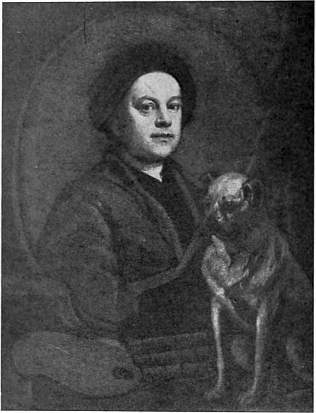 |
| HOGARTH. PORTRAIT OF HIMSELF. |
What marks the greatness of Hogarth is his freedom from foreign and ancient influences. The eighteenth century came in as an academic age in art. Turning away from life, it spent itself in allegory and the imitation of typical figures that had been inherited from the Renaissance and petrified into academic work. Gods, in whom no one any longer believed, hovered, at least in paint, over a race which was without enthusiasm. Then came Hogarth, and his quick vision discovered the new way. He looked out upon the life surrounding him, with its manifold idiosyncrasies, and felt himself with pride to be the son of a new age, in which rigid, conventional forms were everywhere penetrated by the modern ideas of free thought, the rights of man, conformity to nature in morals and manners. This world which confronted him he depicted truly as it was, in all its beauty and its ugliness. With him was the origin of modern art. Before his paintings and engravings pale idealism disappeared. It was he who resolved and set out to bring into the world a new and independent observation of life. He was a painter who, with as little aid from foreign influences as from those of the past, went his own way and kept to it, and devoted his art, unblemished by the pallor of a borrowed ideal of beauty, soberly and exclusively to the realities of surrounding life.
“It seemed to me unlikely,” writes he, “that by copying old compositions I could acquire facility for those new designs which were my first and greatest ambitions.” Works of old Italian masters, artistic contemplations, which 13 went back to Raphael and the Caracci, were ignored and ridiculed by him. His rude strength of painting, directed to the living truth, was a protest against all that idealism which was the heritage of the Renaissance, and had grown quite bombastic under the hands of its imitators. Nature, he writes, is simple, plain, and true in all her works; and with this principle he has founded a strong English school on the solid foundation of truth to nature.
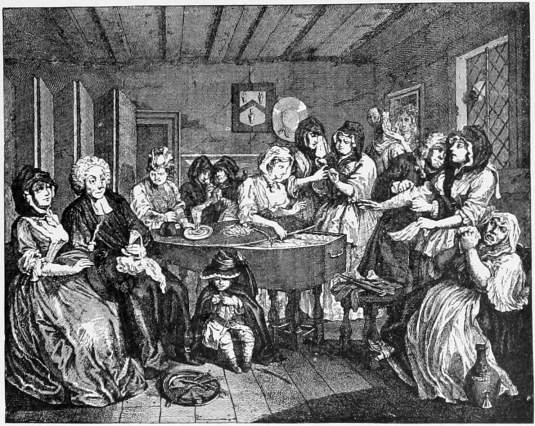 |
| HOGARTH. THE HARLOT’S PROGRESS, PLATE VI. |
An Englishman by birth, character, and disposition, he depicted his fellow-countrymen; he made his sketches in the midst of the hubbub of the street. His world is London, the world-city, “old merry England,” which, in contrast with the Puritanism of to-day, still lived through its golden age of riot. In such a world—a world existing to this day, only more decently berouged—moved Hogarth; in the company of wine-bibbers, in gambling hells, in rooms of poets, in cellars of highwaymen, in the death-chambers of fallen maidens. “The Harlot’s Progress,” which he produced in a series of pictures, brought him his first success. He then published further series of similar careers over crooked courses—“The Rake’s Progress,” “Marriage à la Mode.” He painted the rabble of London, their society and their morals; those who went in cotton and rags and those in satin and silk. In his writings he censures the old painters plainly because in their historical style they had quite passed over the middle classes. And he went with great knowledge to these new subjects. In the National Gallery, which possesses the originals of “Marriage à la Mode,” one is astounded at the technical qualities of Hogarth’s painting. Whoever has been misled by the engraved reproductions, and looks for bad, distorted drawing, may here learn to know him as a painter in the fullest sense of the word. There is no sign left of the defective caricature which disfigures the engravings; there is a severe, unadorned manifestation of realism, of an art that has from the outset rooted itself in modern life. Under the manners and graces of the age Hogarth stands a “self-made” 14 man, a healthy Anglo-Saxon personality, full of sturdy independence and impeccable common sense. He attracts by a sharpness of observation, a penetration into idiosyncrasies of character, a grip upon the most trivial changes in men’s emotions and play of features, the like of which is to be found in hardly one of his predecessors.
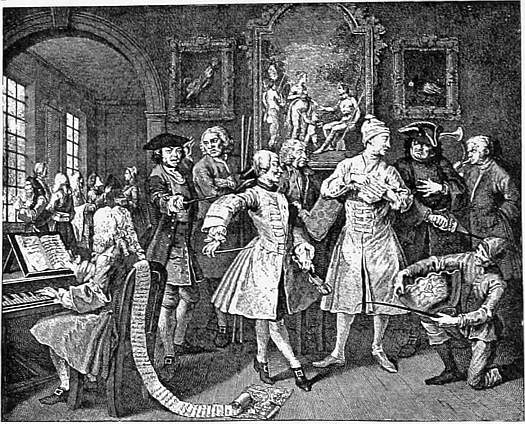 |
| HOGARTH. THE RAKE’S PROGRESS, PLATE II. |
Against these qualities it must be understood that an equal number of defects is to be set off. The inartistic part of him was that he followed the æsthetic theories of the age, and looked upon art as merely a means to ends alien to itself. With him painting was an instrument to disseminate the inventions of his poetic-satiric humour; it was a form of speech to him. He is not unjustly called on that account a comedian of the pencil, the Molière of painting. We look at other pictures, but his we read. The commentaries on them are in some respects the rendering back of the pictures into their proper element. Lessing called the drama his pulpit; with Hogarth his art was a pulpit. He wanted, like Hamlet, to “hold the mirror up to nature, to show virtue her own feature, scorn her own image, and the very age and body of the time his form and pressure.” Pictures beneath his hands became moral sermons.
In the six pictures in “The Harlot’s Progress,” with which he started in 1733, and which to-day, since the originals have perished, can be considered only in the copper engravings after them, all these attributes are recognisable. Mary Hackabout comes innocent from the country to the town with the intention of seeking a situation as a servant-girl. She speedily falls a victim to temptation, becomes the mistress of a Jewish banker, whom she soon loses by her infidelity, descends to be a thief, and comes to the work-house. Released from there, she becomes the companion of a highwayman, until she ends her pitiful life in a disorderly house, leaving behind her a poor crippled boy, who, at his mother’s funeral, is playing with a top. The conclusion of the paintings shows how the other women bid farewell to the corpse, 15 and buoy themselves up for their coming pleasures by drinking from the spirit bottle, which stands on the coffin, while the priest, who is come to give the blessing, announces his visit for the evening.
The second series, which is to be seen to-day in the Soane Museum, describes in eight tableaux the somewhat similar life of a young man, the “Rake.” As an Oxford student he has promised marriage to a pretty but poor girl, when suddenly the death of a wealthy uncle throws him into the vortex of London life. He wishes to buy himself freedom from his sweetheart, but she disdainfully refuses the money and supports herself and her child honestly with the labour of her hands. The seducer, winning fame in the world of women and sport, rapidly paces the road to ruin; yet he repairs his finances once again by a marriage with a rich and one-eyed old lady. Once more on his feet, he flings himself into games of chance, and comes to the sponging-house, whither his better half follows him. It is the last straw when a play which he has offered to a manager is refused, and he can no longer buy himself a pint of ale; there remains only the final fall into the misery of frenzy, and in the last picture we find him amongst the lunatics bound in chains as a madman. Only his student love, Sarah Young, of Oxford, whom he had treated so scurvily, cannot forget him, and, with tears, seeks him out again in the madhouse.
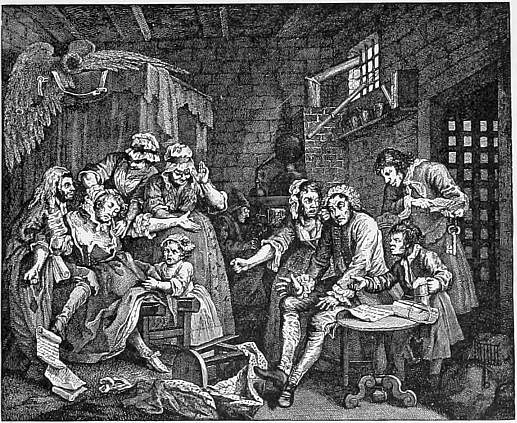 |
| HOGARTH. THE RAKE’S PROGRESS, PLATE VII. |
The third and most famous series was completed many years after the “Rake”—in 1745. Hogarth has admittedly taken particular pains with the six oil paintings of “Marriage à la Mode,” which have been placed in the National Gallery; and these painted novels reveal in strength and beauty of execution the high-water mark of his work as a painter. The whole is quieter, simpler, less overloaded with ingenious accessories. The impoverished lord has married his son, who is already worn out with excesses, to the strong and healthy daughter of a city alderman. A girl is born; then they go their separate ways. The husband 16 surprises the wife with a lover, and is stabbed by him; the unfaithful wife, moved by this, begs her dying husband for forgiveness. As a young widow, deprived of her woman’s honour, she goes back to the bourgeois, Philistine ennui of her father’s house, and when she learns of her lover’s condemnation she escapes from the burden of her misery by means of poison. The father is sufficiently provident to take the wedding ring off her finger before the body is cold, lest it should be stolen from the corpse. In the last sequence Hogarth passed over completely to the moral sermon and the study of crime. The series “Industry and Idleness,” in 1747, was comprised in twelve sheets, which he produced only in rough engravings, as he wished exclusively to influence the masses. Two apprentices enter a cloth-weaving business at the same time, of whom one rises, through his zeal for the interests of the business, to a marriage with his master’s beautiful daughter, to the rank of alderman, and finally to be Lord Mayor of London. The idle apprentice grows, on the down grade, from a gambler into a vagabond. He is transported, comes back again, and ends on the scaffold. The two comrades meet for the last time when the honest man announces his death-warrant to the knave.
 | |
| HOGARTH. | THE RAKE’S PROGRESS, PLATE VIII. |
Garrick, as we can see from his epitaph on Hogarth, has not unjustly characterised his art, in these words—
| “Farewell, great painter of mankind! Who reached the noblest point of art, Whose pictured morals charm the mind, And through the eye correct the heart.” |
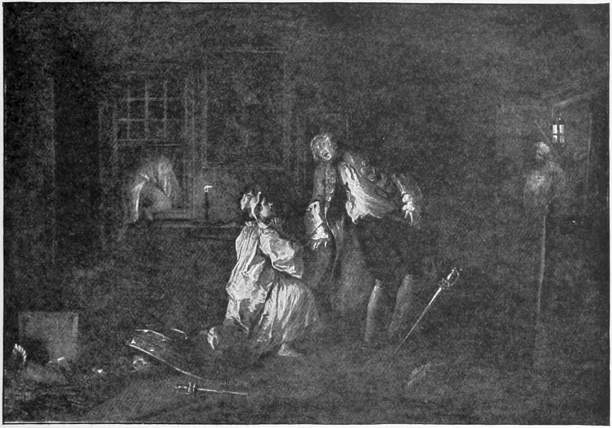 | |
| HOGARTH. | MARRIAGE À LA MODE, PLATE V. |
Hogarth painted stirring and humorous scenes, full of effective morality, with which he sought to cheer, terrify, and improve humanity. His five-act tragedies end always with the triumph of Virtue and the punishment of Vice. As one of his contemporaries said, he exercised the art of “hanging in colours.” The twelve plates of the parallel biographies of “Industry and Idleness” he employed as an illustrated weekly sermon for the benefit of the working classes, and he was able to observe with satisfaction that they had an actual influence on the conduct of the people, as instanced in the diminution of gin shops. Yet for all that, in the elevation of public morality, the highest aim of art is not, as Garrick asserted, fulfilled. Who has ever seen such a painter? Would he be a painter? It is exactly by this moralising with the brush that Hogarth stands in such abrupt opposition to his predecessors, the Dutch. They were painters, nothing but painters, and in their painting reckoned on eyes which could appreciate their pictorial subtilty. Man was for them a patch of colour; the real delight of their eyes was the rich light that came mellowed through the shadows, and played upon the ruffed garments and the clumsy forms. With Hogarth, in the place of the idea of colour, the anecdote is brought in. He saw the world not so much with the eyes of the painter, as with those of the physician, the criminologist, the pastor. The familiar element, that serene and comfortable observation of an everyday occurrence upon which Dutch art was based, has altogether disappeared in his pictures. He did not paint because something pictorial urged him, but saw in men the actors of the parts which he had in his mind. This departure from the purely 18 picturesque is in part explained by the predominance of literature in England at that time. In a country where the tragedy of familiar life as well as the domestic novel had arisen there was imminent peril that a young school of painting working without traditions should branch off also on to those lines. Hogarth desired to give painting a new manner; he seized upon what was epic or dramatic, and painted the pictorial counter parts to Smollett’s and Richardson’s novels. In the age of enlightenment the painter makes way for the writer. With this idea he himself wrote: “I have endeavoured to treat my subjects as a dramatic writer; my picture is my stage, my men and women my players, who, by means of certain actions and gestures, are to exhibit a dumb show.”
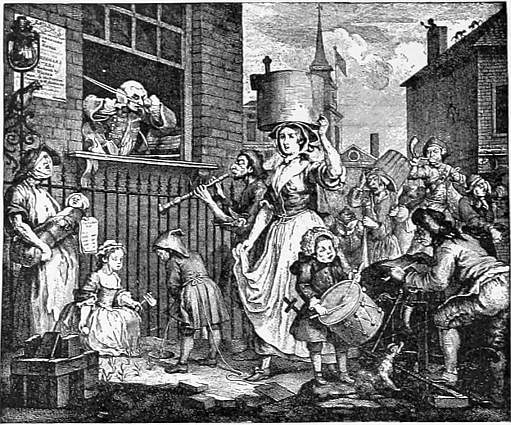 |
| HOGARTH. THE ENRAGED MUSICIAN. |
Moreover, to explain the growth of this sort of literary hybrid, one is forced to consider the changed conditions under which painting was introduced into England at large. Art, which hitherto had shone forth her enchantment upon the few, was conducted from the first in free England along the broad road of popularity, and given over to a public which had to be educated to art by degrees; and this admission of the mass of the people to the enjoyment of art, in a proportion hitherto unheard of, must inevitably have a retrogressive effect upon painting itself. Instead of the earlier amateur of really distinguished culture, there stood “the People.”
But just as in the Middle Ages works of art were seen to be a sort of picture-writing for the people—picturis eruditur populus, said Gregory the Great,—so now the new patrons could hardly require other than those works of art in which a story was pictorially told. These could be understood even by the man whose understanding was otherwise wholly closed to matters of art; and hence it came about that almost all the genre painters—for very nearly a century—followed with more or less intelligence in the footsteps of Hogarth. To treat him, as is frequently done, because of this popularisation of art, because of this transformation of the picture into the picture 19 story, as a pattern instance of tastelessness, would lead to very dangerous consequences, and should be the less employed because Hogarth’s pictures are, at least, comparatively well painted, whereas many of his successors could escape the deluge only in the Noah’s Ark of their talent for narration. What Hogarth could do when he put off the schoolmaster, he has shown moreover in his portraits. There he is an entirely great painter. His pictures have none of that Van Dyck elegance, which had become the mode in England before him; they are robust, crude, Anglo-Saxon, strongly and broadly painted withal, sketches, in the best sense of the word. His “Shrimp Girl,” in the National Gallery, for instance, is a masterpiece to which the nineteenth century can hardly produce a rival.
In the history of painting it is notorious that the latter half of the last century belongs especially to portraiture, and here the English occupy the first rank. Neither Hogarth nor Reynolds nor Gainsborough was a genius like Titian, Velasquez, or even Frans Hals. Their art is not to be compared with that of the greatest of all portrait painters, but they surpassed all the painters of the eighteenth century; they were not only the greatest in England since Van Dyck, but the first portrait painters in Europe at the time.
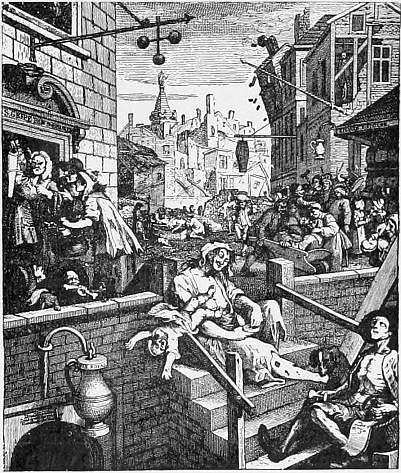 |
| HOGARTH. GIN LANE. |
Reynolds and Gainsborough lived almost at the same period. The former, born in 1723, died in 1792; the latter, born in 1727, died in 1788. They had as models men and women of the same society. They went the same road, side by side. Many celebrities strayed from one studio to the other, and were painted by Reynolds as well as by Gainsborough. These are just the pictures which show us so distinctly how widely the two, who were usually mentioned in the same breath, differed from each other in spite of having grown up on the same soil. Even their outward man displays this dissimilarity.
Reynolds appears in his “Portrait of Himself” in the Uffizzi Gallery at Florence, in the red mantle of the President of the Academy, the official cap on his head, while the hand resting on the table holds a copy of his Discourses; close by is a bust of Michael Angelo. The complexion is that of a man who 20 sits much within doors. A pair of spectacles with large, round glasses leads one to conclude that he injured his eyesight early with much reading. Gainsborough, with his refined Roman nose, the haughty, curved sensuous lips, and the expression of his face which speaks at once of innocence and refinement, gives an impression far more than Reynolds of the child of nature and the gentleman. His cheeks are fresh and rather ruddy; a depth of soul lies within the large blue eyes, that are somewhat melancholy, yet have such a free outlook upon life.
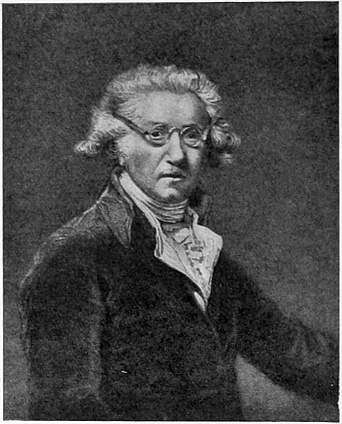 |
| REYNOLDS. PORTRAIT OF HIMSELF. |
Joshua Reynolds’ father was a clergyman, a most learned man, who kept a Latin school. He gave the boy, it is recorded, that most uncommon Christian name, for the remarkable reason that he hoped thereby to draw the attention of a great personage, who bore the same name, towards his young namesake. His son was to become a physician. But books on other subjects which he read at his desk at school made a greater impression on the boy. In the well known Treatise on Painting, by Richardson, he discovered his vocation. From the perusal of this book he developed a taste for things artistic, studied the works on perspective of Pater Pozzo, read everything he could find on art, and copied as a preliminary all that fell into his hands in the way of woodcuts and copper engravings. One of the earliest drawings which remain from his childhood represents the interior of a library. At the age of nineteen he came to London to a well-known master, Hudson, the favourite painter with the gentry of the day, who required £120 with a pupil. He was already convinced that only in London could he find the means to attain fame, and even as early as 1744 he took a fine establishment and kept open house in order to attract attention. He was soon in a position to complete his artistic education by means of residence in Italy. In 1746 he had painted the portrait of a Captain Keppel, who shortly afterwards was appointed Commodore of the Mediterranean squadron, and invited the young painter to go for a cruise in his ship. They sailed in 1749, and Reynolds was able to spend three years in Italy.
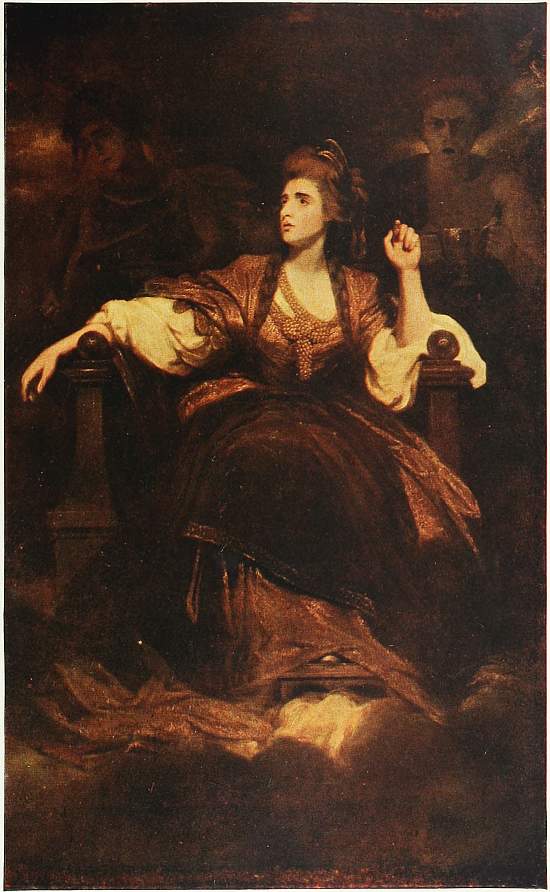 | |
| Cassell & Co. | |
| REYNOLDS | MRS SIDDONS |
His first impression was one of bitter disappointment. Where was that rich colouring in the Italian classics which he had been led to expect from English mezzotints? Everything struck him as lifeless, pale, insipid. Whereupon 21 he affected the opinion that there was no more to be seen in Rome. Raphael, in particular, appeared to him to be a mediocre painter, whom only a remarkable chance had brought to such a pitch of fame. Surrounded by the great masterpieces of the Cinquecento, he employed himself in drawing caricatures, and made a sort of travesty of the School of Athens, in which he drew caricatures of the English colony in Rome at that time, in the attitudes of figures in the pictures of Raphael. But he very speedily changed his opinion, and began to follow the paths of the great dead. He went indefatigably through the galleries of Rome, from Rubens to Titian, from Correggio to Guido and Raphael. He studied so hard in the Vatican, that he took a chill in the cold rooms, which left him all his life a little deaf. That sojourn at Rome was to Reynolds what, a hundred years later, his visit to Spain was to Lenbach.
He had already at Hudson’s acquired great facility as a copyist, and of Guercino, in particular, he had made numerous copies. During this Italian tour, however, he became the greatest connoisseur of old masters that the eighteenth century possessed.
It is related that the Chevalier Van Loo, when he was in England in 1763, vaunted himself one day, in Reynolds’ presence, upon his unfailing discrimination in telling a copy from an original. Whereupon Reynolds showed him one of his own studies of a head, after Rembrandt. The Chevalier judged it to be, indisputably, a masterpiece by the great Dutchman.
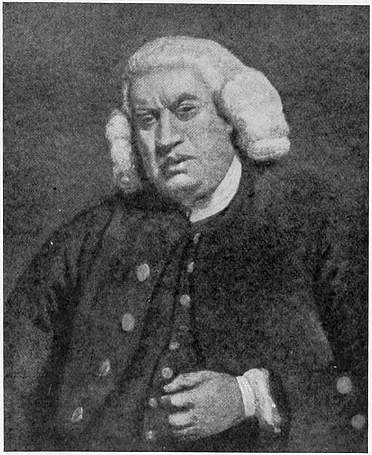 |
| REYNOLDS. DR. JOHNSON |
He left Rome in April 1752, and made a further visit to Naples, to the cities of Tuscany, and to Venice. The careless notes of travel that he made on this journey show the clear insight which he had attained into the Italian schools. They all deal with questions of technique, on effects of light and shadow, on the mystery of chiaroscuro. For Titian, in particular, he had an extravagant devotion,—he would ruin himself, he said, if he might only possess one of the great works of Titian.
When he returned to England in 1752, at the age of thirty, his talent was fully developed, and the connoisseurs were unanimous in hailing him as a new Van Dyck. With the portrait of Miss 22 Gunning, afterwards the Duchess of Hamilton, he appeared in 1753 as a power in English art. As early as 1755, when Hogarth was compelled to give up portrait painting for lack of patrons, one hundred and twenty-five persons sat for Reynolds, and after that about one hundred and fifty people were painted by him annually; and this brought him in a yearly income of about £16,000.
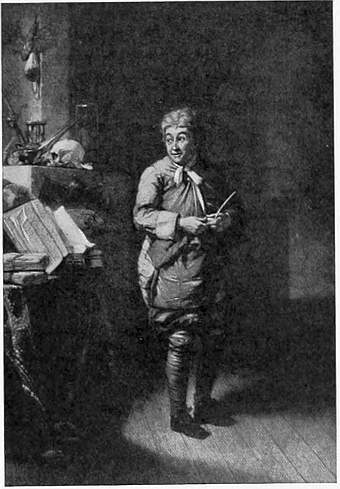 |
| REYNOLDS. GARRICK AS ABEL DRUGGER. |
At first he took up his quarters in St. Martin’s Lane, which was then the most fashionable place of residence for artists; but in 1760 he bought a house, No. 47 Leicester Square, the most select quarter of London, and furnished it with the most palatial splendour. The studio, which he built for himself, was as large as a ballroom, and furnished with a quite modern luxury. The large corridor that led to it had a gallery of pictures by old masters. It was the age of the great literary and dramatic revival in England. Garrick stood at the zenith of his popularity, Burke had already made himself a name, Johnson had produced his Dictionary, Richardson had reached the summit of his fame, Smollett had written Peregrine Pickle, Gray had attracted notice by his verse. All these and others who set the vogue in literature and the drama, the principal figures in politics, the leaders of fashion, lounged in that luxurious studio and gossiped with Reynolds of the theatre, both before and behind the scenes, of the doings in Parliament and the scandal of the Court, of literature and of art. At the time when Goldsmith was putting the finishing touches to his Travels he was a guest of the house. Gibbon, the historian, and Sterne, whose Sentimental Journey was just then the talk of the town, spent their vacant hours with him; and Burke as well, while he discussed with him his treatise on the Sublime and the Beautiful. All these claimed a niche in Reynolds’ portrait gallery, where all the talents were met together. The whole English nobility also flocked to him. For forty years onwards from 1752 it was considered the proper thing to be painted by him. His pictures were multiplied immediately at the hands of the engravers. In the complete catalogue of Reynolds’ works, Hamilton counts, so far back as 1820, no fewer than 675 plates, engraved after Reynolds by more than a hundred artists, and amongst these the mezzotints of Samuel 23 Cousins are by far the finest. Only an incredible industry, enabling him for a long succession of years to paint almost without intermission with a facility and regularity like that of Rubens, rendered it possible for Reynolds to complete, exclusive of portraits, quite a number of religious and mythological pictures, of which he himself was especially proud. He painted with great speed and dexterity, rose very early, breakfasted at nine o’clock, was in his studio punctually at ten; and there till eleven he worked on pictures which had been commenced. On the stroke of eleven the first sitter arrived, who was succeeded by another an hour later. Thus he painted till four o’clock, when he made his toilette, and thenceforward belonged to society, for in spite of his scholarly temperament one can by no means consider Reynolds as a solitary eccentric. Although he remained a bachelor after Angelica Kauffmann had declined his hand, his house was a central gathering-point for noble London. He gave balls to which the whole of “Society” was invited, and drove in a magnificent carriage, with coachmen in blue and silver liveries. The Literary Club was founded at his instigation, where with Johnson, Burke, Goldsmith, Gibbon, and Garrick he shared in conversation both profound and brilliant. He was made a baronet, and when the Royal Academy was founded in 1768, became its first president. The dinners of the Academy, which he organised at the distribution of prizes, play a part in the history of English cookery. Reynolds had promised that on each of these reunions he would speak on some question of art. In this manner originated, during his twenty-three years of office, those fifteen discourses upon painting which show the highest result of his literary energy. They were not his maiden essays. As far back as 1758 Johnson had invited him to publish an article upon Art in a journal which he had founded, The Idler. In 1781 he made a journey through Holland and Flanders, upon which, anticipating Fromentin, he wrote an exceedingly fine book. In his Discourses so high a degree of literary talent was displayed that they were at one time said to be the work of Johnson or Burke.
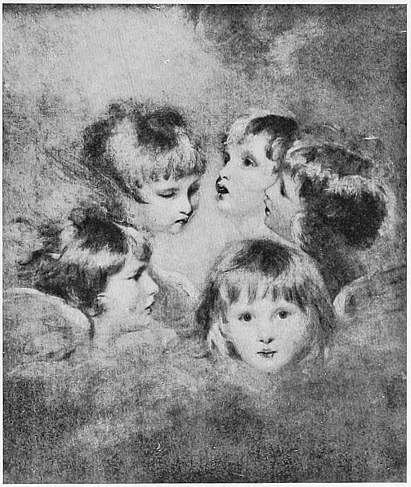 |
 | ||
| REYNOLDS. | HEADS OF ANGELS. | REYNOLDS. | SAMUEL RICHARDSON. |
They are æsthetic treatises and essays in the history of art, of an enduring value. Originating from a vast insight, and expressed in a precise style, they treat of the laws of classic art, the variation in styles, the causes of the finest bloom in art. Certainly eclecticism is preached too. The modern artist, it is declared, can only stand on the shoulders of his forebears. The great Italians must be his models, and of these the greatest is Michael Angelo. His last essay closes with these words: “I reflect, not without vanity, that these discourses bear testimony of my admiration of that truly divine man, and I should desire that the last words which I should pronounce in this Academy, and from this place, might be the name of Michael Angelo.”
When he died, his friend Edmund Burke wrote in the funeral oration which he dedicated to him: “Sir Joshua Reynolds was, on many accounts, one of the most memorable men of his time. He was the first Englishman who added the praise of the elegant arts to the other glories of his country. In taste, in grace, in facility, in happy invention, and in the richness and harmony of colouring, he was equal to the greatest masters of the renowned ages.... In full affluence of foreign and domestic fame, admired by the expert in art and by the learned in science, courted by the great, caressed by sovereign powers and celebrated by distinguished poets, ... the loss of no man of his time can be felt with more sincere, general, and unmixed sorrow.” He was buried with great pomp in St. Paul’s Cathedral. The pictures left unfinished at his death fetched at auction £37,000; the whole fortune which he left is estimated at £80,000.
The biography of Thomas Gainsborough reads quite differently.
The traveller who rides from London to Birmingham passes through some of the fairest scenery in the island. He finds himself in the heart of fresh and tender English nature. Small rivulets flow through the gently undulating country. Wide meadows clothe the soft hollows in the valleys with abundant green. In grassy enclosures deer and roes are feeding; they push forwards inquisitively as the train passes. Fragrant linden trees rise dreamily in the suave, park-like landscape, through which the Stour winds 25 along like a riband of silver. On the bank of this enchanting stream Thomas Gainsborough, the son of a simple clothier, was born. Reynolds’ vocation had been brought about through the perusal of a book. In the scenery and the woods that were in the neighbourhood of his home, Gainsborough, who was so alive to all the beauty of nature, received the decisive impression of his life. Here he roamed as a boy, while he neglected his school lessons. “Tom will be hung some day,” reflected his schoolmaster; “Tom will be a genius,” thought his parents. He sketched the parks and castles of the neighbourhood. In his later life he used to say that there was no picturesque old tree trunk, no meadow or woodland glade or stream within a four-mile radius of Sudbury, that he did not retain a recollection of from his childish years. Like Constable, when he was an old man, he still thought with gratitude of his home, of all that beauty upon which he had looked, and which had made him a painter. Here, in the green woods and fresh pastures of his birthplace, he trained himself. At the age of ten he was a painter.
 |
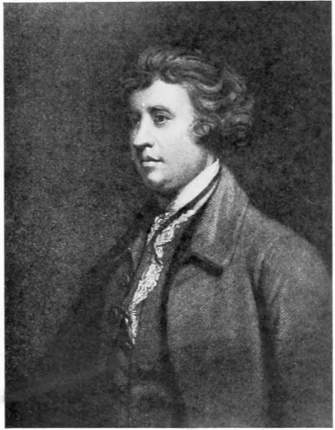 | ||
| REYNOLDS. | MISS REYNOLDS. | REYNOLDS. | EDMUND BURKE. |
A sojourn of four years in London seems to have added little to his ability. Elegant in his manners, lively in his conversation, a born gentleman, he might have become completely the man of fashion. But he was far too diffident, with his naïve simplicity, to force himself amongst the stars of the world of art in London, far too distinguished and retiring to join in the race after the favour of the public, and so at the age of eighteen he returned to his native place with the unencouraging prospect of playing the part of a simple painter in the provinces. First and last, the woods remained his chief delight. One morning, as he was painting there, he looked up from his easel and saw a young and beautiful girl in a light summer dress, peeping coquettishly from behind the trunk of a tree. She blushed, he spoke to her shyly. Soon afterwards Margaret Burr became his wife, and the whole history of his life with her remains a charming idyll, like the spring morning on which he made her acquaintance. Married at the age of nineteen, he installed himself at Ipswich, his wife’s native place, and there he spent fifteen years in great happiness, firm in the conviction that he would end his days there. There 26 he painted his first portraits, which, from 1761, were forwarded by a carrier’s cart to London for exhibition in the Royal Academy. From Ipswich he went to Bath, the fashionable watering-place, where he painted the visitors who came in the summer for the cure. Finally, in the end his portraits met with approval in London. That gave him courage in 1764 to proceed thither himself; and there he took very modest rooms. On his arrival he was as yet very little known; he came from the provinces, which he had till then never left, at a time when Reynolds stood at the pinnacle of his fame, and had visited Italy and Spain. Yet he gradually won a reputation. Franklin was one of the first to sit to him. Soon he became the favourite painter of the king and the royal family. George III was painted eight times by him, Pitt seven times, Garrick five. Lord Chancellor Camden, Sir William Blackstone, Johnson, Laurence Sterne, Richardson, Burke, Sheridan, Mrs. Graham, Lady Montagu, Mrs. Siddons, Lady Vernon, Lady Maynard, and the names of many other celebrities and beauties are bound up with his. His life-work, excluding sketches, consists of no more than three hundred pictures, of which two hundred and twenty are portraits—a very small number in comparison with the four thousand paintings of Joshua Reynolds. Thomas Gainsborough painted irregularly. Even when he was in his studio he might be seen standing for hours gazing out of his window dreamily at the grass. In other features of his life too he was equally different from Reynolds: unaccountably, he was one moment a brilliant, animated companion, the next plunged in melancholy. He dreamed much, while Reynolds painted and wrote. In the evenings he usually sat at home with his dear little wife, completed no treatises or discourses on his art, but made sketches or sometimes music. Reynolds was a scholar-painter, Gainsborough a painter-musician. It was said of him that he painted portraits for money and landscapes for amusement, but that he made music because he needs must. He collected musical instruments as Reynolds did a library. Even in his pictures he gives his people, for preference, violins in their hands. To the Musical Club which he had founded in Ipswich he remained faithful all his life, and in that neighbourhood, or in Richmond or Hampstead, he spent the summer every year. Here amidst that green nature it was also his wish to be buried. 27 His funeral was a very quiet one. In the peaceful graveyard at Kew, Thomas Gainsborough sleeps tranquilly under the shady willows, far from the noise and tumult of the great city. Sir Joshua said at his grave: “Should England ever become so fruitful in talent that we can venture to speak of an English school, then will Gainsborough’s name be handed down to posterity as one of the first.” Yes, one might say to-day, as the first of all.
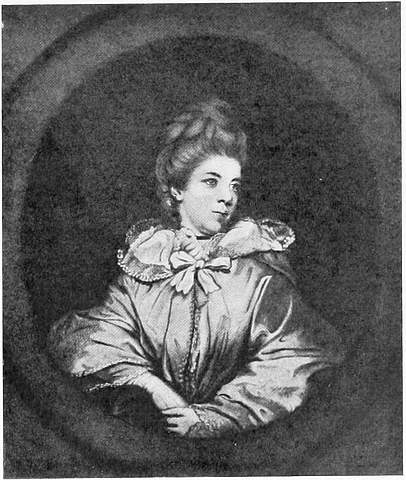 |
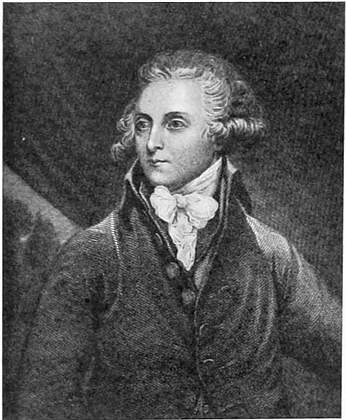 | ||
| REYNOLDS. | MRS. ABINGTON. | REYNOLDS. | EDMUND MALONE. |
Joshua Reynolds is certainly a great painter, and deserves the high veneration in which his compatriots hold him. It is not without a certain awe that, in the Diploma Gallery of the Royal Academy, one can look upon the armchair that he used during his sittings, upon which all who were famous in eighteenth-century England have sat. Reynolds is one of the greatest English portrait painters, and, resembling most the classical masters, showed in the highest degree the qualities we admire in them. His colouring is of an amazing softness, depth, and strength; his chiaroscuro is warm and vaporous. There are portraits by him which, in the subtlety of their tone, resemble the best of Rembrandt’s; others, whose noble colouring approaches the chef-d’œuvres of Van Dyck. Master of the whole mechanism of the human body, he possessed in the highest degree the rare art of setting persons surely and unconstrainedly on their feet. His portraits are pictures; one needs no whit to be acquainted with the persons they represent; they satisfy as works of art in themselves, and as psychological studies by a man who had the capacity of sounding the depths of the human heart. The complete catalogue of all those who sat for Sir Joshua during the space of half a century forms an uninterrupted commentary on the contemporary history of England.
There we see the skilful portrait of Sterne, with his look of witty mockery; the marvellous Bohemian, Oliver Goldsmith, who even then had the manuscript of his Vicar of Wakefield in his pocket; Johnson, who, in one, sits at his writing-table, on which stands an ink-pot and a volume of his English Dictionary, and in another is peering into a book with his short-sighted eyes screwed 28 up tightly, and his whole posture awkward and unwieldy. Garrick, who went from one studio to the other, appears also more than once in Reynolds’ portrait gallery. Amongst his portraits of military dignitaries, that of General Lord Heathfield, the famous defender of Gibraltar, whom he painted in full uniform, is one of the most noticeable. Strong as a rock he stands there, with the key of the fortress in his hand. What a contrast between these figures and those of the contemporary French portraits! There, those friendly and smiling ministers, those gallant and dainty ecclesiastics, those scented, graceful marquises, who move with such elegant ease about the parquet floor, and from whose faces a uniform refinement has erased all the roughness of individuality; here, expressive, thoughtful heads, characters hardened in the school of life, many of the faces coarse and bloated, the glance telling of cold resolution, the attitude full of self-reliant dignity and gnarled, plebeian pride. The same bourgeois element predominates in the pictures of the ladies. Van Dyck’s noble, eminently intellectual figures always wore the glamour of the Renaissance. In the background an artistically arranged curtain, a column, or the view of the quiet avenues of some broad park. From Reynolds we get strong active women in their everyday clothes, and with thoughtful countenances: good mothers, surrounded by their children, whom they kiss and enfold in a tender embrace. The idea of half-symbolical representation has vanished, and in its place is introduced the idea of home and the family. The pictures of children by this childless old bachelor were an artistic revelation to the existing generation, and are the delight of the world of to-day. In other portraits of ladies, that noticeable characteristic of the English nation, their predilection for domestic animals and for sport, finds an expression. The beautiful Duchess of Devonshire he painted as she gently restrained with her finger her little daughter’s caresses, which would fain have disordered her coiffure; a whole gallery of noble ladies he represented feeding their poultry or petting their lap-dogs; Lady Spencer in her riding-habit, her whip in her hand, her horse reined in, her cheeks flushed from her gallop. Nelly O’Brien looks an actress, a woman who turned men’s heads, and she does it still to-day in Reynolds’ picture. There lurks something enigmatic, perplexing in the smile of this sphinx—only Monna Lisa 29 had such a smile, but Nelly’s eyes are deeper, more desirous. One feels that in the three centuries since Monna Lisa love has taken on a new and subtler nuance. The portrait of Mrs. Siddons is the most famous of the pictures of actresses which Reynolds painted, and Mrs. Siddons, of all the women of that time, is the one whose portrait occupied the painters most. She was the daughter of Roger Kemble, the actor, and sister of that pretty actress, Mrs. Twiss, whose portrait by Reynolds (in 1784) we also have, and of the famous John Philip Kemble, who figures so often in the portrait gallery of Lawrence, as Hamlet, Cato, Coriolanus, Richard III, etc. Born to the boards, as it were, she had, when still a child, joined her parents on their Thespian pilgrimages, and had had many engagements in the provinces, at Birmingham, Manchester, and Bath, before she was recruited by the playwright Sheridan for the Drury Lane company in London. She made her début there on 10th October 1782, and was hailed forthwith as the greatest actress of her time. Lady Macbeth was her great part; in that she was painted both by Romney and Lawrence. Reynolds painted her as the Tragic Muse. A diadem encircles her hair, she sits upon a throne, the throne rests upon clouds. Behind her stand two allegorical beings, Crime and Remorse, two quite unfortunate figures. But the principal figure is truly great, in its noble, regal attitude, and quite unconstrained in its dramatic pose. Reynolds had the composition in his mind many weeks before Mrs. Siddons sat for him in the autumn of 1783. “Take your seat upon the throne for which you were born, and suggest to me the idea of the Tragic Muse.” With these words he conducted her to the pedestal. “I made a few steps,” the actress relates, “and then took at once the attitude in which the Tragic Muse has remained.” When the picture was finished, says Sir Joshua, gallant as ever: “I cannot lose this opportunity of sending my name to posterity on the hem of your garment.” And he, who hardly ever signed his pictures, wrote in large characters his name and the date on the gold-embroidered border of the dress. The original picture has been in the possession of the Grosvenor family since 1822; a second copy is in the gallery at Dulwich.
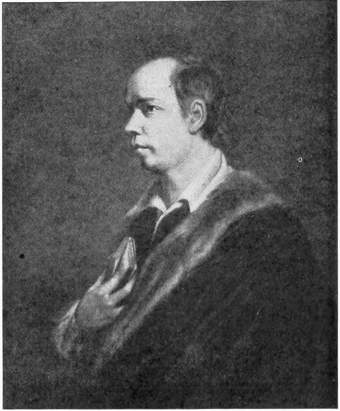 |
 | ||
| REYNOLDS. | OLIVER GOLDSMITH. | REYNOLDS. | LADY COCKBURN AND HER DAUGHTERS. |
Reynolds loved to depict his sitters in mythological or historical settings. Thus he painted Mrs. Hartley, her son as a nymph and the youthful Bacchus, the three 30 Misses Montgomery as the Three Graces crowning a term of Hymen, a little girl sitting on the grass as the “Age of Innocence,” Lady Spencer as a gipsy telling her brother’s fortune, Mrs. Sheridan as St. Cecilia. The five “Heads of Angels,” as they are called, in the National Gallery, are five different studies of the lovely child-head of little Isabella Gordon. Garrick, in one of his pictures, is set between the allegorical figures of Tragedy and Comedy. Reynolds himself was frankly proud of these portraits in the mood of history. He was, as he said, in general only a portrait painter because the world required it; that which he aspired after was the great manner of historical painting. Nevertheless, pictures, such as the “Little Hercules with the Serpent,” “Cupid unfastening the Girdle of Venus,” “The Death of Dido,” “The Forbearance of Scipio,” “The Childhood of the Prophet Samuel,” or “The Adoration of the Shepherds,” do not cause us to deplore too bitterly that he rarely found time for such mythological and historical pictures. His putti are derived from Correggio; in the arrangement of drapery he resembles Guido; in his “Venus” he is a coarser Titian. Reynolds’ own manner in these pictures is merely the eclectic accumulation of the peculiarities of the old masters—he brought no new element into historical painting.
And herein lies his principal weakness. Hogarth declared: “There is only one school, that of nature.” Reynolds: “There is only one doorway to the school of nature, and of that the old masters hold the key.” The great men of old were for him the object of constant and conscious thought. He has endeavoured in his writings to propound a sort of general foundation of painting, has adopted the principles of the best painters in every land, was indefatigable in exploring the secrets of the old masterpieces, and has therefore won the praise of having set the English school, which had hitherto possessed no perfected tradition of painting, technically on firm feet. He was the founder of a scientific technique of painting derived from the ancients,—the Lenbach of the eighteenth century. Upon the mixture of colours, the gradations of light and shade, technically and æsthetically, no artist has pondered more 31 than he, who knew the great Netherlanders, Rubens, Van Dyck, and Rembrandt, as well as, or better than, his particular favourites, the Italians. He made experiments all his life long to discover the stone of the wise Venetians; but he met with the same experience as Lenbach. And these experiments in the direction of the colour effects of the old masters were the bane of his pictures’ durability. It was well said by Walpole: “If Sir Joshua is content with his own blemished pictures, then he is happier than their possessors, or posterity. According to my view, he ought to be paid in annual instalments, and only so long as his works last.” And Haydon opined that “Reynolds sought by tricks to obtain results which the old masters attained by the simplest means.” He endeavoured by means of asphaltum to give his pictures the artistic tones of the galleries, with the result that, to-day, the majority have lost every sign of freshness.
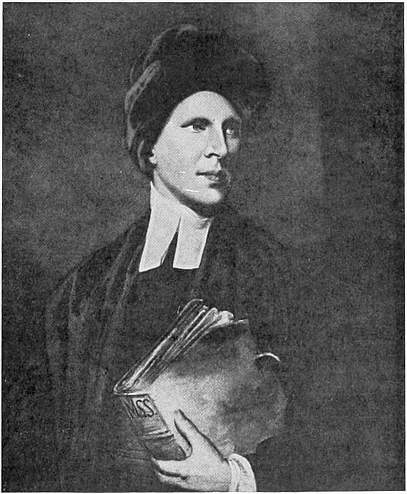 |
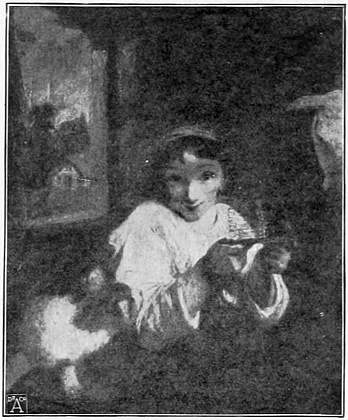 | ||
| REYNOLDS. | BISHOP PERCY. | REYNOLDS. | THE GIRL WITH THE MOUSETRAP. |
With regard to the pose also, and similar conceptions, one can never quite get away from the thought of Van Dyck and other old masters. Reynolds’ chief endeavour, not only as regards colouring, but also in other respects, was to resemble the ancients, and this has brought into his pictures something imitative and laboured. He dearly loved the Romans and Venetians; we believe to-day that he loved almost too dearly the Bolognese. And just that fine, artistic education which he received in Italy and Holland, and the scientific method in which he practised his art, did harm to Reynolds, and brought into his pictures too much reminiscence, too many alien touches. He has in most cases understood it—how to bring into uniformity the numerous borrowings of his palette, all that he had taken from Leonardo, Correggio, Velasquez, and Rembrandt. Yet he has never quite forgotten the old masters and looked only at his model, for the sake of the very daintiest lady or the freshest English boy. For his children he thought of Correggio’s “Cherubim,” for his schoolboys of Murillo, for the portrait of Mrs. Hartley of Leonardo da Vinci, for that of Mrs. Sheridan of Raphael. There lacked in him that spontaneity which denotes the great master. By his 32 erudition in art, Sir Joshua elevated himself on the shoulders of all who had preceded him. He obtained thereby the piquant effects in his portraits, but it was at the price of the penalty that from many of his works it is rather a rancid odour of oil and varnish which exhales than the breath of life.
Gainsborough can certainly not be compared with Reynolds in the mass of his work. He was master neither of his powers of industry nor of his smooth and brilliant methods of painting that were always sure of their effect. In many of his pictures he gives the impression of a self-taught man, who sought to help himself to the best of his power. Just as little has he the psychological acuteness of Reynolds. A portrait painter puts no more into a head than he has in his own; thus the acute thinker, Reynolds, was able to put a great deal into his heads, whilst Gainsborough, the dreamer, was often enough quite helpless when he confronted a conspicuously manly character. In his whole temperament a painter of landscape, before his model too he sat as before a landscape, with eyes that perceived but did not analyse. What, with Reynolds, was sought out and understood, was felt by Gainsborough; and therefore the former is always good and correct, while Gainsborough is unequal and often faulty, but in his best pictures has a charm to which those of the President of the Academy never attained. Gainsborough, too, at his death murmured the name of an old master. “We are all going to Heaven, and Van Dyck is of the company.” But what distinguishes him from Reynolds, and gives him a character of greater originality, is just his naïve independence of the ancients, which resulted partly from the different nature of his education in art. Reynolds had lived for two years in Rome and explored all the principal cities of Italy, had visited Flanders and Holland, learnt to wonder at Rembrandt, and developed an enthusiasm for chiaroscuro. Gainsborough in his rural seclusion had been able neither by travel on the Continent to study the great masters of the past, nor to assimilate the traditions of the studio. He contented himself with the beauties which he saw in his native country, studied them in their touching simplicity, without troubling himself about academic rules. He lived in London until his death, without once leaving England; and that gives to his pictures a distinct nuance. The one studied pictures and books, the other only the “book 33 of nature.” His portraits never aim at any external effect, nor are they raised into the historical; they seek to give no other impression than that of a quite subjective truth to nature, both in arrangement and in colouring. Nothing intruded between his model and himself, no “sombre old master” obscured his canvas. His execution is more personal, his colour fresher and more transparent. The very personages seem with him to be more elegant, more gracious, more modern than with Reynolds, in whose work, through their kinship to the Renaissance, they received a suggestion of style, classical and ancient.
In his pictures the Englishman is clearly revealed, an Englishman of that delicacy and noble refinement which is present to a unique degree in the works of English painters of the present day.
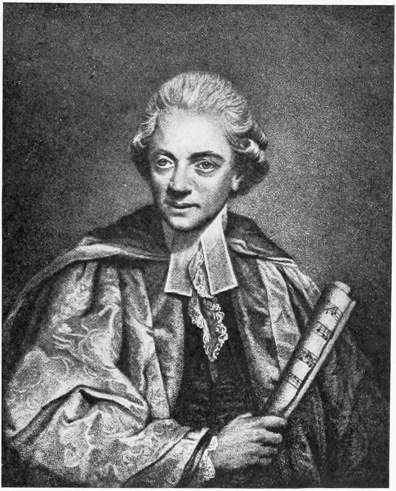 |
| REYNOLDS. DR. BURNEY. |
The passage from Hogarth to Gainsborough marks a chapter in the history of English culture. Hogarth is the embodiment of John Bull; you can hear him growl, like some savage bull-dog. That brutal, indecorous robustness of England’s aggressive youth becomes, in Gainsborough’s hands, agreeable, refined, gentle, and seductive. Reynolds, with his robustness as of the old masters, might be best compared with Tintoretto; Gainsborough, in his quite modern and fantastic elegance, is a more tender, subtle, and mysterious spirit, poet and magician at once, like Watteau. There one listened to the full, swelling chords of the organ; here to the soft, dulcet, silvery notes of the violin. Reynolds loved warm, brown and red tones; Gainsborough essayed for the first time, in a series of his happiest creations, that scale of colour, coldly green and blue, in which to-day the majority of English pictures are still painted. Everything with him is soft and clear; the tone of those blue or light yellow silks, which he loved especially, is that of the most transparent enamel; the background fades away into dreamy vapour, the figures are surrounded with an atmosphere of seduction. What a masterpiece he has created in the “Blue Boy,” his most popular and most individual picture. One can describe every piece of the clothing, 34 but it is impossible to reproduce the harmony of the painting, the rich, pure blue of the costume, which stands out against a lustrous, brown background of landscape. How the stately youth stands, noble from head to foot, in the brown and green autumn landscape, with its canopy of sky! Master Bootall was by far the most elegant portrait painted in England since Van Dyck, and withal of a nervosity quite new. See that youthful pride in the gaze, that mobile sensibility in the pose!
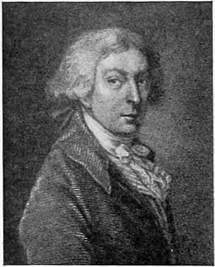 |
| THOMAS GAINSBOROUGH. |
Have men grown different, then, or does the painter see further? One finds in Van Dyck no such expressively nervous physiognomy. The suggestion of melancholy, the deep reverie, the noble, aristocratic haughtiness,—Gainsborough was the first to discover that, and give it its full expression. And the same man who painted the noble elegance of this youthful grand seigneur depicted also peasant children coming fresh from the green fields and woodlands of their village homes. In Sir Joshua’s children there was often something borrowed from Correggio; the children of Gainsborough breathe a rustic charm, an untamed savagery; they are the very offshoots of nature, who disport themselves as freely as the wild things in the woods. But his women in particular are creatures altogether adorable. While Reynolds, the historical painter, liked to promote his into heroines, those of Gainsborough, with their pure, transparent skins, their sweet glances (in which there lies so admirable a mixture of languishing fragility, innocence, and coquetry), are the true Englishwomen of the eighteenth century. His “Mrs. Siddons” is not in theatrical costume, but in a simple walking-dress; no Tragic Muse, but the passionate, loving woman who once, a romantic, impulsive miss, escaped from a convent at the risk of her life, to join a handsome young actor of her father’s troupe who had entirely fascinated her. What a charming grace in the pose, what fine taste in the arrangement, what wonderful purity of colouring! With the exception of Watteau, I know of no older master who could have painted such moist, dreamy, sensuous, tender eyes. The marvellous “Mrs. Graham,” in the National Gallery of Scotland, is, from the purely pictorial standpoint, perhaps the greatest of all his works. Yet how beautiful is the double portrait of that young married couple, the Halletts, who, tenderly holding hands, pass along a deserted path in some secluded garden; or that pale, languishing “Mrs. Parsons,” with her enchanting smile, and that mysterious language of the eyes. Gainsborough was no keen observer, but he was a susceptible, sensitive spirit who intercepted the soul itself, the play of the nerves, the slightest suggestion of spiritual commotion. There moves through the majority of his portraits a pathetic tenderness, a breath of dreamy melancholy, that the persons 35 themselves hardly possessed, but which he transfused into them out of himself. Melancholy is the veil through which he saw things, as Reynolds saw them through the medium of erudition. Reynolds was all will and intelligence, Gainsborough all soul and temperament; and nothing can show the difference between them better than the fact that Reynolds, who had formed his style on early models, when he had no sitters painted historical pictures; whilst 36 Gainsborough in like circumstances painted landscapes. Herein he was a pioneer, whilst Reynolds was an issue of the past.
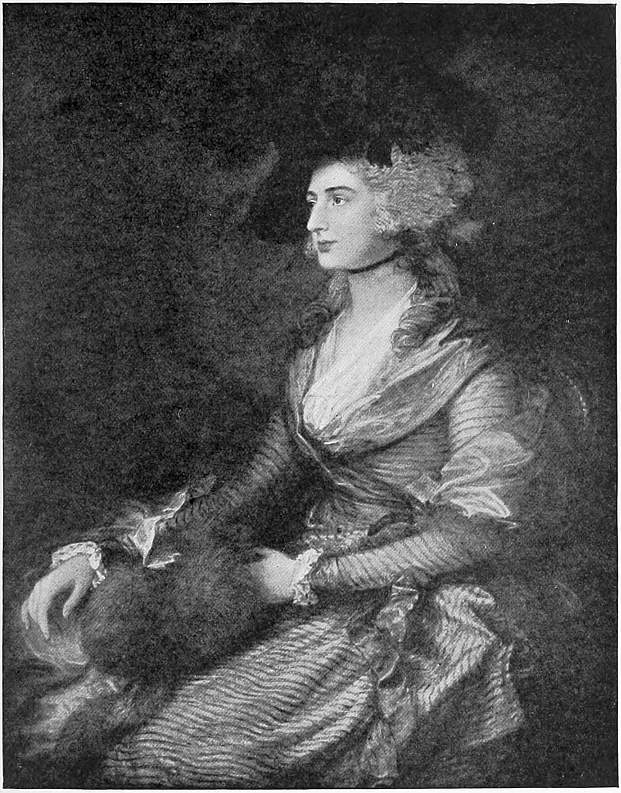 | |
| Cassell & Co. | |
| GAINSBOROUGH. | MRS. SIDDONS. |
 | |
| Cassell & Co. | |
| GAINSBOROUGH. | WOOD SCENE, VILLAGE OF CORNARD, SUFFOLK. |
In the domain of landscape painting, too, the new germs of naturalism, which had ventured above ground on all sides in the fifteenth century, had been again stunted in the Great Renaissance. The theory had been promulgated in the sixteenth century—in accordance with the idealistic methods of the age—that it behoved the painter to improve upon nature just as much as upon the human body. With the lofty style of the great figure painters, and their artfully pondered composition, there corresponded a school of landscape which was likewise conceived of, in the first degree, as an honourable, architectural framing for a mythological episode. England too possessed, in Richard Wilson, a believer in this doctrine, which became so widely promulgated in the seventeenth century through the influence of Claude Lorraine. The home of his soul was Italy. He scraped together a small sum of money by portrait painting, borrowed the rest, and felt himself in his element for the first time when he had reached Venice. Here, at the instance of Zucarrelli, he became a painter of landscapes, and was aided in his endeavours by Joseph 37 Vernet in Rome. He was on the way to become a painter in great request, and in many of his pictures he shows a most delicate notion of well-balanced and gracious composition in the manner of Claude. But his success was of no long duration. Wilson, like so many other of his contemporaries, had the fixed idea that the Creator had only made nature to serve as a framework for the “Grief of Niobe” and as a vehicle for classical architecture. The interpolated stage scenery of trees and the classic temples of this English Claude, contain nothing which had not been already painted better by the Frenchman. When the king, in order to assist him, asked him on one occasion to represent Kew Gardens in a picture, he composed an entirely imaginary landscape and illuminated it with the sun of Tivoli. The king sent him back the picture, mordant epigrams appeared in the journals, and Reynolds scoffed at him in his Discourses. After that Wilson spent his days in the alehouse, until he got delirium, and died half starved at the age of seventy.
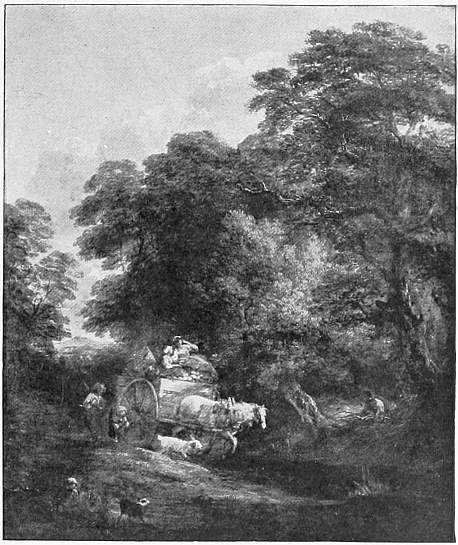 |
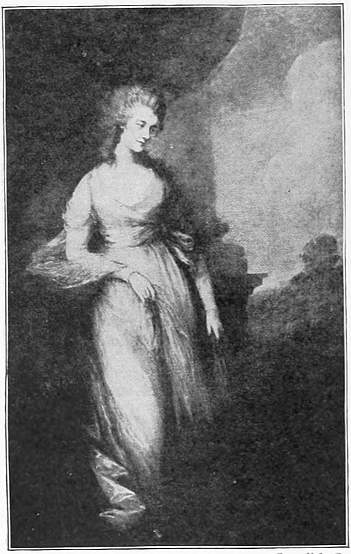 | ||
| Cassell & Co. | Cassell & Co. | ||
| GAINSBOROUGH. | THE MARKET CART. | GAINSBOROUGH. | THE DUCHESS OF DEVONSHIRE. |
The patriotic English were too much bound up with their own soil to acquire a taste for the exotic, ideal scenery of Wilson. There existed in them that patriotism, that feeling for home, which had turned the Dutch of the seventeenth century into landscape painters. In this province also they were destined to step in, as the inheritors of the Dutch, to bring the germ of intimate landscape to its full fruition. Lovely and luxuriant valleys with their soft grass, sweet woodlands with their vari-coloured foliage, golden, swaying cornfields and picturesque little cottages, with that indescribable softness of atmosphere, must of themselves direct the eye of the writer and the painter to all these beauties. It was an Englishman who in the eighteenth century wrote the most memorable 38 book upon the charms of nature. James Thomson, in his Seasons, is the first great nature painter amongst the poets. Taine finds the whole of Rousseau anticipated in him. “Thirty years before Rousseau, Thomson had forestalled all the sentiments of Rousseau, almost in the same style.” He has not only, like Rousseau, a profound feeling for the great wild aspects of nature, for the forms of clouds, effects of light and contrasts of colour, but he delights also in the smell of the dairy, in small birds, in the woodland shadows, and the light on the meadows,—in all things sequestered and idyllic.
| “Nature! great parent! whose unceasing hand Rolls round the Seasons of the changeful year, How mighty, how majestic are thy works! With what a pleasing dread they swell the soul That sees astonished and astonished sings.” |
 | |
| Cassell & Co. | |
| GAINSBOROUGH. | THE SISTERS. |
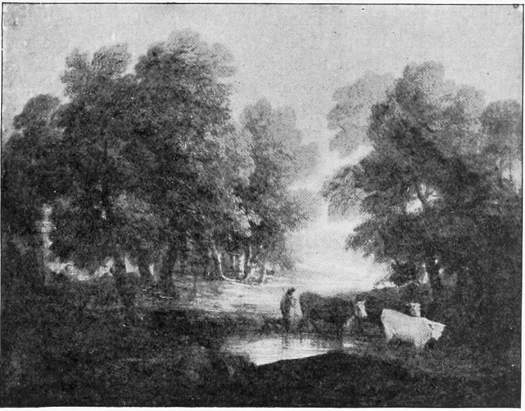 |
| Cassell & Co. |
| GAINSBOROUGH. THE WATERING PLACE. |
It was a remarkable chance which ordained that Thomas Gainsborough, the first man who as a painter depicted the gracious charms of the country of his birth, the comeliness of its expanses of deep green lush meadows, the strength of the lofty, wide-spreading trees, as seen with the eyes of a lover, should be born in the spring of the same year in which Thomson’s Spring appeared. That he knew and admired Thomson is proved by his dedication to him of that delightful “Musidora” in the National Gallery, a lovely woman bathing her feet in some shady forest pool. It is said that he only sent half a dozen landscapes to the Academy during the eighteen years that he exhibited there. On the other hand, they hung in his house in Pall Mall in long rows on the walls of his studio. After his death his widow held a sale, at which fifty-six landscapes were sold. Gainsborough must be accounted one of the moderns, so naïve and intimate is the impression which his pictures produce. He, who passed his whole youth in the idyllic loveliness of the woods, was fitted to be the delineator of that mellow English nature. He understood the murmur of the brooks and the sighing of the winds. Like his own life, so regular and peaceful, gently 39 swaying as though to the friendly elements, are the trees in his pictures, with their peaceful tranquillity; no storm disturbs the calm of a Gainsborough picture. His was a contented, harmonious spirit, like Corot’s. His landscapes know no tempestuous grandeur; they are a playground for children, a place for shepherds to rest. “The calm of mid day, the haze of twilight, the dew and the pearls of morning,” said Constable, “are what we find in the pictures of this good, kindly, happy man.... As we look at them the tears spring to our eyes, and we know not whence they come. The solitary shepherd with his flock, the peasant returning from the wood with his bundle of faggots, whispering woods and open dales, sweet little peasant children with their pitchers in springtime,—that is what he loved to paint and what he painted, with as much sought-out refinement as with tender truth to nature.” His landscapes are like windows opening on the country, not compositions, but pieces taken straight out of that fruitful English nature. Every year he used to return to his green pastures, and paint very early, when the sun rose. Before him rose a cluster of trees, all round the farm the flocks were grazing, thousands of busy bees flew buzzing from flower to flower; goats, with their kids, were feeding in the meadows, wild doves cooed, and the birds in the wood sang their praises to the Creator. Thus do the landscapes of Gainsborough affect us. They are soft and tender as some sweet melody in their discreet intimacy, without colorist effects, as wonderfully harmonious as nature herself. A thatched cot, that peeps timidly from between the great trees, a silvery dale shut in by weeping willows, a bridge leading to some lush, green meadow,—those are Gainsborough’s materials. The famous “Cottage Door” is now at Grosvenor House. A young peasant woman, with her youngest child in her arms, is standing by the door of a country cottage, before which her other children are playing, some half naked; deep 40 contentment is all around, huge old oaks spread their sheltering branches over the roof on both sides; golden rays of sunshine dance across the meadow. Only Frederick Walker has, in later days, painted such peasant women and such children, at once so tender and so natural. Of the four pictures in the National Gallery, “The Wood Scene,” “The Watering Place,” “Market Carts,” and “Peasant Children,” “The Watering Place” is the most celebrated. In the foreground a quiet pasture with cows, close by the herdsman, a Suffolk labourer; in the background a noble old Norman castle, perhaps Hedingham Castle, near Sudbury. It is through pictures like these that England has become the native-land of intimate landscape—paysage intime.
As figure painters, as well as landscape painters, the English in the eighteenth century laid a course of their own, and it was not long before the other nations followed them.

CHAPTER II
THE HISTORICAL POSITION OF ART ON THE CONTINENT
Goethe compared the history of knowledge with a great fugue: the parts of the nations first come to light, little by little; and this analogy, already once made by Hettner, holds true in a very high degree of the history of art during the eighteenth century. The three great nations of culture—the German, the English, and the French—take up their parts in turn, and through all there sounds one common, equal, dominant note. England was in the vanguard of that great period of struggle known as the age of enlightenment. Since the middle of the eighteenth century English influences had begun to fertilise the Continent. The truth and naturalness of English ideas were introduced as models, and England became in her whole culture the schoolmistress of the Continent. In every region war was declared against the pedantry brought over from the past, while new conditions were aimed at. Obviously it was not so easy for other nations to take their stand on the basis of modern society. England had accomplished her revolution in the seventeenth century; France was only preparing herself for hers. For all other nations, too, the eighteenth century was a transition period, in which the old and the new civilisation of culture were parting—an age of prodigious controversy, full of Sturm und Drang. Men did homage to every kind of extravagance, and went into ecstasies over virtue. The sarcasm of scoffers went hand in hand with the deepest sentimental feeling for nature; superstition flourished by the side of enlightenment and learning; in the salons of the aristocracy courtly abbés file past with the greatest thinkers, glowing with a holy zeal for the rights of man. And, in the midst of all this contradiction, there exists that simple, virtuous middle class which is preparing to make the ascent which will lead it to power.
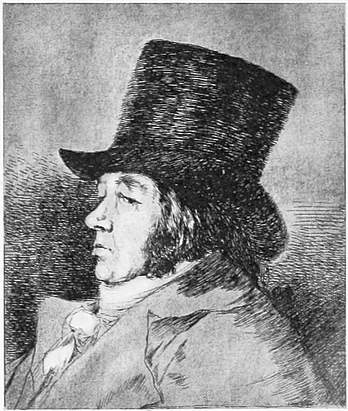 |
| PORTRAIT OF GOYA. BY HIMSELF. |
| From: “Los Capriccios.” |
One may imagine oneself in a salon of the ancien régime, in which wit is lord, and laughter and merriment reign. Into that salon enters abruptly a rough plebeian, with none of the fine tact of that company, yet a great, aristocratic spirit, a man who despised such a society and would make the world anew. Such is one’s impression of the effect produced at the time by the appearance of Jean Jacques Rousseau. Voltaire was the first on the Continent to break through social barriers, but none the less he coined his heart for gold in society. Rousseau signifies a great advance: he gave up his place, laid aside rapier, silk stockings, and perruque, and clothed himself after the manner 42 of a common man in order to earn his bread as a copier of music. He is, as Weigandt has called him, the first man of the bourgeois century, the first pioneer of the new age. Against the traditions bequeathed by the past, which in the course of time had become over-refined and corrupt, he set up the natural conditions demanded by reason. His fight against inequalities of rank is, as it were, a foretaste of the revolution. “What hellish monsters are these prejudices. I know no dishonourable inferiority other than that of character or education. A man who is trained to an honourable mind is the equal of the world; there is no rank in which he would not be in his place. It is better to look down upon nobility than upon virtue, and the wife of a charcoal-burner is worthy of more respect than the mistress of a prince.” Those were words in which the coming revolution was presaged.
The Nouvelle Heloise appeared in 1761. Thirteen years later followed Goethe’s Werther, that history of a young Titan whose zeal for liberty felt all the partition walls of Society to be prison walls, and who rose against everything that was ceremonial, against all the subordinations of the social hierarchy, against all trivial and rigid rules of prudent everyday life. Werther abhorred rules in every sphere. “One can say much in favour of rules, about as much as one can say in praise of bourgeois society.” He scoffed at the Philistines, who daily went along the same measured way. He saw in “Society,” having hitherto moved in the simple world of the bourgeois, “the most sacred and the most pitiful emotions wholly without clothing.” And this Society outraged him, and sent him with contumely from its midst. “Working folk carried him to the grave, and no minister of religion followed him.”
Soon afterwards young Schiller came upon the scene with his first works, which were a declaration of war against all the foundations of human society, those manifestoes of revolution which, were they new writings to-day, no Court Theatre would dare to produce. The fierce, rampant lion, with the inscription “In Tyrannos,” which was displayed on the title-page of the second edition of the Robbers, was an intimate symbol of the deep revolutionary spirit that inspired the whole age. “I grew disgusted with this ink-stained 43 age, when I read in my Plutarch of great men. Fie, fie upon the flaccid, castrated century, that has no other use than to chew over again the deeds of the past. Let me imagine an army of fellows like you, and I see a republic arising in Germany, in comparison with which those of Rome and Sparta would be convents of nuns.” In a loud voice Ficsco proclaims itself on the very title-page to be a “republican” tragedy. Intrigue and Love even aims full at the rottenness and corruption of the actual time. It can be traced—and Brandes has done it in his Haupströmungen—how in the literature of the age, the life of sensibility and idealism prevailing in the previous century gradually dwindles, and in its stead quite modern progressive views—religious, political, and social—surge up in an ever-increasing wave. The authors were the bold inciters to the battle. They were all leaders in the battle for liberty against fossilised tradition,—some in the field of poetry only, others in the whole sphere of intellectual life. These are they who gave the signal for the war-cry of the Revolution—Liberty, Equality, Fraternity; who rent asunder the old society, inaugurated the age of citizenship, and were at the same time the first to lose, as quite modern spirits, their faith in another world.
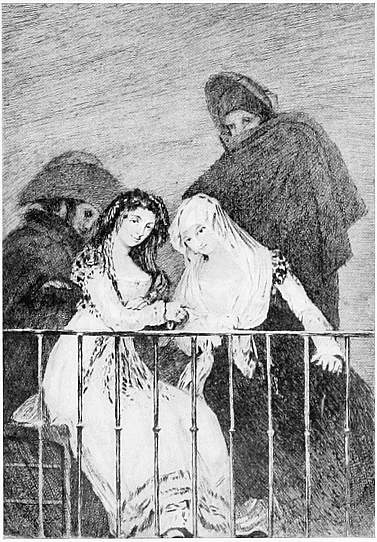 |
| GOYA. THE MAJAS ON THE BALCONY. |
A wonderful chance ordained that, in the province of art, the most powerful figure of that storm and tumult, the one artist of the age of the race of Prometheus, to which belonged the young Goethe and the young Schiller, should be born in the most mediæval country in Europe, on Spanish soil. Against an art that was more catholic than catholicism, courtly and mystical, there came by far the greatest reaction in Goya. From Roelas, Collantes, and Murillo to him there is hardly any transition.
Francisco Goya preached Nihilism in the home of belief. He denied everything, believed nothing, doubted of everything, even of that peace and liberty which he hoped to be at hand. That old Spanish art of religion and dogma was changed under his hands to an art of negation and sarcasm. His attitude is not that of an insolent and impetuous youth, who puts out his 44 tongue at the Academy and strikes with audacious hand at the academicians’ high powdered perruques; it is the attitude of the modern spirit, which begins by doubting all things which have been honoured hitherto. His Church pictures are devoid of religious feeling, and his etchings replete with sneers at everything which was previously esteemed as authority. He scoffs at the clerical classes and the religious orders, laughs at the priestly raiment which covered the passions of humanity. Spanish art, which began in a blind piety, becomes in Goya revolutionary, free, modern.
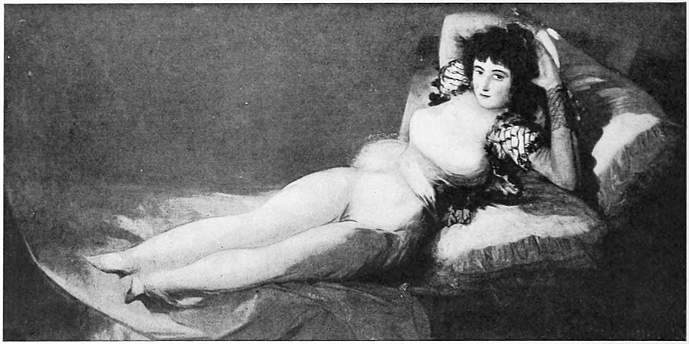 | |
| Laurent, photo. | |
| GOYA. | THE MAJA CLOTHED. |
Goya is, in his whole nature, a modern man, a restless, feverish soul; nervous as a décadent; temperament to his finger-tips. His style in portraiture, his art of composition, his whole method,—all speak to our artists to-day in a language easily understood, and on many of them the influence of Goya is unmistakable. He is one of the most fascinating figures of the beginning of the century. As audacious as he was clever, as versatile as he was fantastic, a keen observer as well as a strong creative spirit, he fascinates and astonishes in his pictures, just as in his wonderful etchings, by a remarkable mixture of the bizarre and the original. His pictures, whether they be violent or eccentric, tender or hard, gloomy or joyous, nearly always move and palpitate with life itself, and they will always keep their attraction. There is no one of Goya’s pictures, not even the flimsiest sketch, at which one can look coldly.
He was born in a village in the province of Aragon, the son of a small landed proprietor, in 1746. At the age of fourteen, having already painted frescoes in the church of his native-place, he went to Saragossa as an apprentice; and there he showed himself to be vivacious and passionate, and soon became the champion among his comrades in all their pastimes and brawls. Restless, and always thinking of adventure, he refused every 45 regular kind of education, disarranged everything in his master’s studio, worked when he could, drew his sword when he had a mind to, nourished in his head dark thoughts on liberty, came and went and loved, dallied with his knife, snapped his fingers at the Inquisition, which was after him, and fled from Madrid,—such was he at twenty, and such he remained all his life.
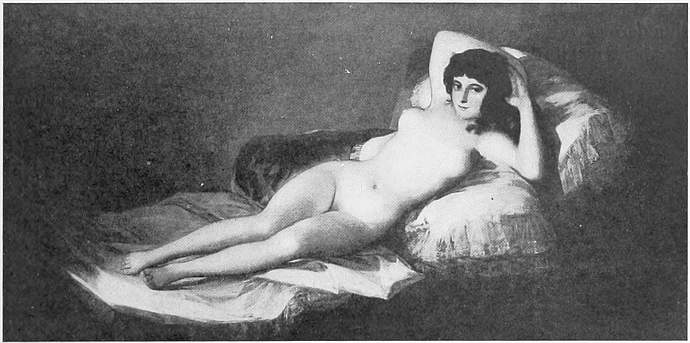 | |
| Laurent, photo. | |
| GOYA. | THE MAJA NUDE. |
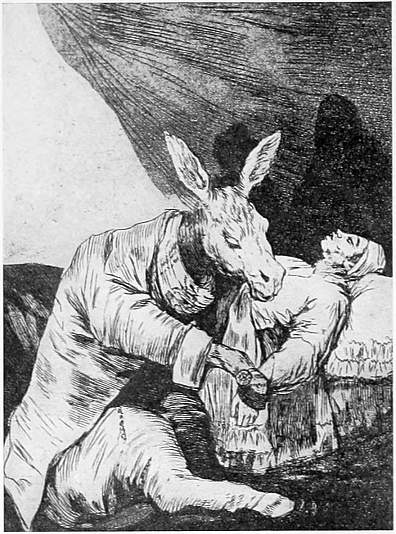 |
| GOYA. DE QUE MAL MORIRA. |
| From “Los Capriccios.” |
Italy, whither he fled on account of a duel, did not alter him. There were new love quarrels. He fought, stabbed a rival, was wounded himself, amused himself extremely, studied little, observed, admired, but neither painted nor copied anything. It was thanks to this indolence that the great past did not take him prisoner. He did not know much, but for what he knew he could thank himself. He loved the old painters, but platonically; their works did not lead him astray. In this lies the explanation of his qualities and his faults: that marvellous mixture of seductive grace and visible weakness, of subtlety and brutality, of refinement and ignorance. He merits equally sympathy and blame, is as genial as he is unequal. But one would not wish him to be otherwise: if there had been more order and proportion in his works his good qualities would have been lost. He would have suffered in spontaneity, vivacity, originality, and quietly taken his anchorage in the sleepy haven of mediocrity. As he is, he is wholly the child of his country: from head to foot a Spaniard of the eighteenth century, a son of that downfallen Spain that was dying from loss of blood. For hundreds of years a black cloud, extinguishing all joy, had hung over Spanish life, a cloud out of which, only here and there in dismal lightning flashes, there emerged obscure figures of sombre despots, sick ascetics, and silent martyrs. All mundane inclinations were suppressed, all sensuous desires prohibited. Men spent their nights with their eyes fixed upon the gory histories and passionate 46 exhortations of the Old Testament, hearing in imagination the menacing, thunderous voice of a dreadful God, until at last in their own hearts the fanatical inspiration of the prophetic seer awoke anew, and their feverish forms were torn asunder by ecstatic visions and religious hallucinations. When Goya began his career the sinister country of the Inquisition had grown frivolous. A breath of revolution was passing over men’s minds. An intoxicating odour of mundane voluptuousness penetrated everywhere, even into the convents themselves; the figures of the French Rococo Olympus had brought confusion into the Christian paradise. Spain no longer believed; it laughed at the Inquisition, trembled no more when it was threatened with the pains of Hell. It had grown frivolous, wanton, epicurean, full of grace and laughter. The rosy-red and blue shepherds of the Trianon had made an entry into the sombre Court of Aranjuez. Literature, taste, and art were infected by French influences, Parisian sparks of wit, lightning esprit, and Parisian immorality; and the same rumbling earthquake which wrecked the throne of France was soon to shatter that of Spain. In Goya’s works there is a refulgence of all this. But, like every great artist, he is not only the expression of his epoch, but also its leader; he almost anticipates the age which shall succeed it. Like a figure of Janus, on the border-line between two centuries, standing in a manner between two worlds, he was the last of the old masters and the first of the moderns—even in that special sense in which we employ the word to-day.
Through a commission to design cartoons for the Spanish manufactories of tapestry, he was brought into contact with the Court. Member of the Academy of San Fernando in 1780, Pintor del Rey, with an income of 12,500 francs in 1786, he became soon afterwards the Director of the Madrid Academy—the drollest Director of an Academy that man can imagine! Goya, the peasant youth, with his bull neck and matador-like strength, lived at the Spanish 47 Court in the midst of the enervated scions of a dissolute aristocracy, who, with their sickly and anæmic features, indolent and impotent, skulked through life, young men prematurely old. Naturally he was the idol of the women, hated by the courtiers on account of his caustic wit, a terror to all husbands because of his perpetual intrigues, and at the same time feared as the best swordsman in Madrid, who drew his rapier with the indifference with which we light a cigarette.
It is only as the outcome of such a personality that his works are to be understood.
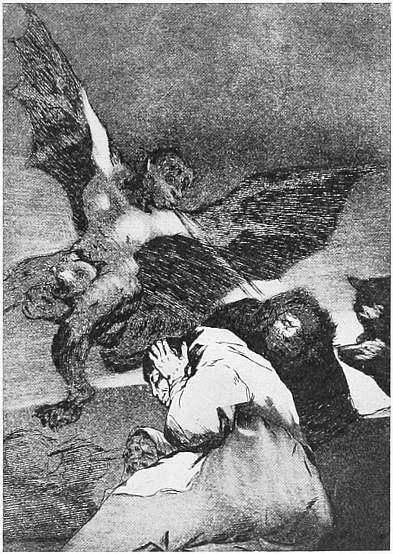 |
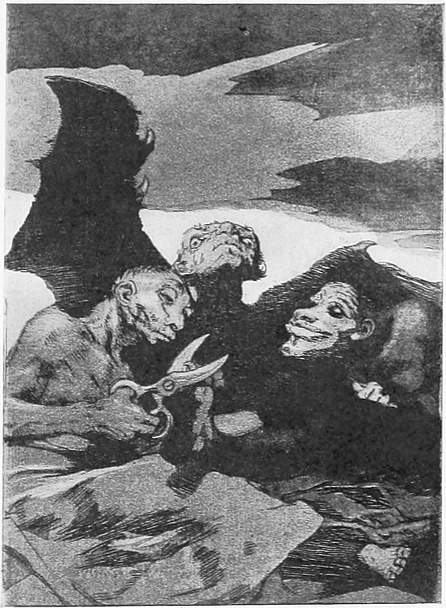 | ||
| From “Los Capriccios.” | From “Los Capriccios.” | ||
| GOYA. | SOPLONES. | GOYA. | SE REPULEN. |
Goya was far too great a sceptic to put a religious sentiment into matters in which he no longer believed; his talent was far too modern for the religious abstraction to be able to seize him. His “Christ on the Cross,” therefore, in the Museo del Prado, is simply tedious, a bad academical study. His frescoes in San Antonio de la Florida, at Madrid, exhibit a pretty, decorative motive—considerable movement, grace, and spirit. But amongst them are angels who sit there most irreverently, and, with a laugh of challenge, throw out their legs à la Tiepolo. The chief picture represents St. Antony of Padua raising a man from the dead. But all that interested him in it were the lookers-on. On a balustrade all around he has brought in the lovely, dainty faces of numerous ladies of the court, his bonnes amies, who lean their elbows on the balcony and coquette with the people down below. Their plump, round, white hands play meaningly with their fans; a thick cluster of ringlets waves over their bared shoulders; their sensual eyes languish with a seductive fire; a faint smile plays round their voluptuous lips. Several seem only just to have left their beds, and their vari-coloured, gleaming silks are crumpled. One is just arranging her coiffure, which has come undone and falls over her rosy bosom; another, with a languishing unconsciousness and a careless attitude, is opening her sleeve, 48 whose soft, deep folds expose a snow-white arm. There is much chic in this Church picture. One very immodest angel is supposed to be the portrait of the Duchess of Alba, who was famed for her numerous intrigues.
In his portraits, too, he is unequal. He became the fashionable painter at the court. The politicians, poets, scholars, great ladies, actresses, all the famous folk of his epoch, sat to him. He daubed more than two hundred portraits; but they were good only when the subject amused him. His portraits of the Royal Family have something vicious and plebeian. He is too little in earnest, too little of an official, to paint court pictures. One might imagine that he with difficulty restrained himself from laughing at the pompous futility which stood before him. It irritated him to be obliged to paint these great lords and ladies in poses so ceremonial, instead of making them, like the angels of San Antonio, throw up their legs and skip over parapets. The Queen, Marie Louise, is frankly grotesque; and the family of Charles IV look like the family of a shopkeeper who have won the big prize in a lottery, and been photographed in their Sunday clothes. But, ah! when something gives him pleasure! In the Exhibition of Portraits at Paris, in 1885, there was the portrait of a young man, dressed in gray, which excelled Gainsborough for grace. With what a noble nonchalance this young elegant stands there, reminding one, in attitude and costume, of the incroyables of Charles Vernet. With what equanimity does he look out on life, in his satisfaction at the good fit of his clothes. The wonderful harmony of the grey tones was rendered with all Gainsborough’s delicacy. The same man who in those pictures of ceremony let himself go in a manner so brusque and frenzied, here revelled, a very Proteus in his chameleon-like qualities, in soft and mellow and seductive tones. One might say that he has thought here of Prudhon and Greuze, and joined their study to the cult of Velasquez.
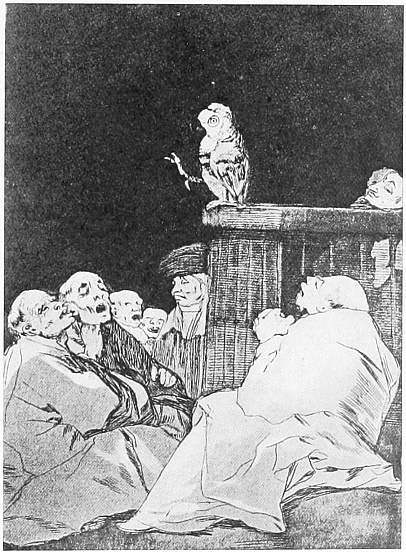 |
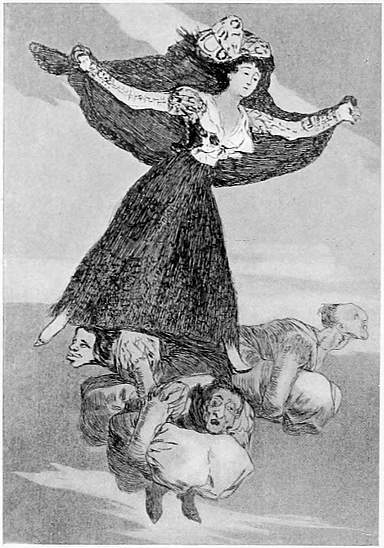 | ||
| From “Los Capriccios.” | From “Los Capriccios.” | ||
| GOYA. | QUE PICO DE ORO! | GOYA. | VOLAVERUNT. |
Still more charming was he in his pictures of young girls, when he was himself fascinated by the attractions of his subjects. The infantile Donna Maria Josefa (at the Prado) and the twelve-year-old Queen Isabella of Sicily (at Seville) are admirable pictures. In them the candour and grace of budding youth, the whole poetry of young maidenhood, have won life and expression from the enamoured tenderness of an artist hand. Seduced by beauty, he renounced all irony, thought only of those big, wide-opened eyes of velvet, those rosy young lips; of that warm carnation and the elegant slimness of that soft young neck that rose in delicate contour from the shoulders. Or again, that marvellous double portrait of La Maja in the Academy of San Fernando: a young girl painted once clothed and once nude, both pictures in exactly the same pose, and both flooded with the same extraordinary sensuous charm. This is not the uncertain, sarcastic painter of those State pictures. It is an attentive observer, who depicts with sensitive devotion the harmonious lines of the irradiating, young, human body so worthy of celebration. The transparent stuff that covers the body of “La Maja clothed” reveals all that it hides; in the other picture the unveiled nudity sings the high pæan of the flesh. The drawing is sure, the modelling of a marvellous tenderness. The heaving bosom, the slender limbs, the tantalising eyes—every part of that nervous body, with its ivory whiteness, stretched out on the milk-white couch made for love, breathes of pleasure and voluptuousness.
In pictures of this kind Goya is wholly one of us. Grown independent of every traditional rule, he abandoned himself entirely to his own impressions, and produced enduring works, vibrating with life, because he was himself fascinated with nature. He showed here an idea of modernity that almost makes him seem a contemporary of our own—that zeal for the pictorial, for colour and light, which attracts us so much to-day. Very characteristic also of the changed aspect 50 of the age are his designs for the famous tapestry in Santa Barbara, with which he made his début at Madrid. They are very crude in decoration. Two or three neat young girls, with big, black, moist eyes, here and there pleasing details—a couple of men carrying a wounded companion—are unable to gloss over the heaviness of the composition and colour. But it was of great consequence that Goya should have had courage for so bold a step as to make use of character scenes in decorative painting at a time when everywhere else, without exception, fêtes champêtres predominated.
In his oil paintings he went much further in this direction. In that impetuous manner peculiar to him he endeavoured to get a firm grip on the pictorial side of Spanish life, at home and in the streets, wherever he found it. The most fearful subjects—such as the two great slaughter scenes in the French invasion, painted with such breadth and fierceness—alternate with incidents of the liveliest character. Everything is jotted down, under the immediate influence of what has been observed, by rapid methods, and on this account produces an effect of sketches taken with complete directness from nature. In those careless pictures, swept with large strokes of the brush, there rises before us the mad drama of public holiday in the streets and in the circus: processions, bull-fights, brigands, the victims of the plague, assassinations, scenes of gallantry, national types—all observed with the acuteness of a Menzel. The Majas on the balcony in the Montpensier Gallery, the “Breakfast on the Grass,” the “Flower Girl,” the “Reaper,” the “Return from Market,” the “Cart attacked by Brigands,” are the most piquant, vividly coloured of these pictures. The “Romeria de San Isidoro” is full of such a sparkling, stirring life as the most modern of the impressionists alone have learned again to paint. A few dashes of colour, a few well-placed, bold strokes of the brush, and at once one sees the procession move, the groups passing each other by just as, in the marvellous sketches of the 51 funeral of Sardina, in the Academy of San Fernando, one can see the young couples revolve madly in the dance, and the lances of the bull-fighters redden the sand of the arena.
The superabundance of such phantasy could not, of course, be achieved by the tardy brush. He required a quicker medium, that would permit him to express everything. Therefore he executed his numerous etchings, by which he was rendered famous, before people had learnt to appreciate him as a painter: the “Capriccios,” the “Malheurs de la Guerre,” the “Bull-fights,” the “Captives”—those marvellous and fantastic pages in which he expressed everything that his feverish, satirical soul had accumulated for contempt, and hatred, and anger, and scorn. The etcher’s needle was the poisoned dagger with which he attacked all that he wished to attack: tyranny, superstition, intrigue, adultery, honour that is sold and beauty that lets itself be bought, the arrogance of the great and the degrading servility of the little. He made an awful and jovial hecatomb of all the vices and the scandals of the age. Whomsoever he pilloried was laid bare in all respects; physically and morally, no single trait of him was forgotten. And he did it so wittily that he compelled even the offended person to laugh. Neither Charles IV himself, nor the Court, nor the Inquisition, which bled most beneath his thrusts, dared to complain.
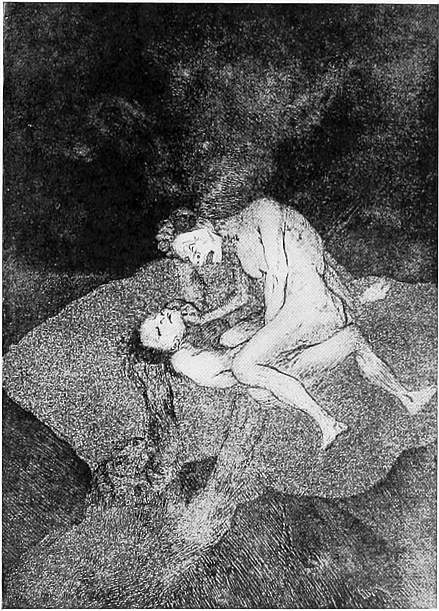 |
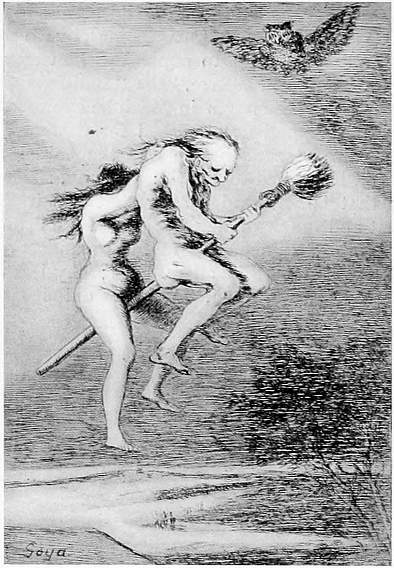 | ||
| From “Los Capriccios.” | From “Los Capriccios.” | ||
| GOYA. | QUIEN LO CREYERA! | GOYA. | LINDA MAESTRA! |
In his “Capriccios” Goya stands revealed as a figure without even a forerunner in the history of art. Satirical representations of popular superstitions, bitter, mordant attacks on the aristocracy, the government, and all social conditions, unprecedented assaults on the crown, on religion and its doctrines, inexorable satires upon the Inquisition and the monastic orders, make up this most remarkable book. It had hardly appeared in 1796 before the Inquisition seized it. Goya parried this stroke, however, by dedicating the plates to the king.
A painter and a colorist, 52 in this book he displays his genius as an etcher. The outlines are drawn with light and genial strokes only; then comes the aquatinta, the colouring which overspreads the background, and gives localisation, depth, and light. A few scratches of the needle, a black spot, a light produced by a spot of white ingeniously left blank—that sufficed to give life and character to his figures.
The “Misères de la Guerre” are intrinsically more serious. All the scenes of terror that occurred in Spain as a sequel to the French invasion and the glory of Napoleon here utter their cry of lamentation. A few plates amongst them are worthy of comparison with the finest of Rembrandt’s,—the sole classic for whom Goya cherished a veneration. All the undertakings which followed these—the “Bull-fights,” the “Proverbs,” the “Captives,” the fantastic landscapes—tell of a long study of the great Dutch master. Especially celebrated were the seventeen new plates which he added to the “Malheurs de la Guerre” in 1814, at the time of the restoration of Ferdinand VII. They are the political and philosophical testament of the old liberal, the keen free-thinker, the last and utmost fight for all that he loved against all that he hated. With sacred wrath and biting irony he waged war against the intrigues and hypocrisy of the obscurantists who throttle progress and suppress freedom of thought. With passionate wrath he rushed upon kings, priests, and dignitaries. It seems incredible that the plate entitled “Nada”—a dead man, who comes out of his grave and writes with his corpse-fingers the word “Nada” (nothing)—that this plate can be the work of a Spaniard of the eighteenth century. Everywhere there is the same hatred of tyranny, of social injustice, of human stupidity, the same incredulous effort after a dimly conceived ideal of truth and liberty.
It is neither the amiable fairyland of Callot nor the bourgeois pessimism 53 of Hogarth. Goya is more inexorable and acute; his phantasy, borne on larger wings, takes a higher flight. He sees direful figures in his dreams, his laugh is bitter, his anger rancorous. He is a revolutionist, an agitator, a sceptic, a nihilist. His chronique scandaleuse grows into the epos of the age. One understands why such a man should no longer feel secure in Spain, and, towards the close of his life, go into exile in France.
There, too, in the home of the revolution, art, ever since the beginning of the century, had freed herself more from the tradition of the Renaissance, and betaken herself to the new way, which the Dutch, and soon afterwards the English, had laid down in the seventeenth century.
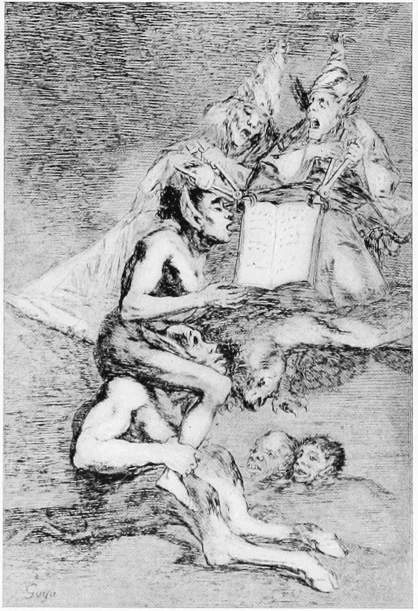 |
| From “Los Capriccios.” |
| GOYA. DEVOTA PROFESION. |
All that had been produced in Paris, up to the close of the seventeenth century, had had its birthplace in the Italy of Leo X. The light of the Italian Renaissance had suffused France ever since the appearance of Rosso and Primaticcio. Rome had been the cradle of Simon Vouet and Nicolas Poussin. France endeavoured, in rich decoration and masterly swing of lines, to overtop the Italians, whose formulæ were studied partly in Rome and partly in the Palace of Fontainebleau, that Rome in petto. Those religious pictures of Lebrun, arranged in panels, appeared with their theatrically elegant attitudes and their flowing drapery, with their slim, oscillating limbs and their florid gestures. All Olympus, all the saints and the heroes, were set to work to do honour to the great king. Was it necessary to glorify his acts, then it was done by portraying him as Cyrus or Alexander. The people of the seventeenth century did not exist for painters. Lebrun and Mignard, as inheritors of Roman culture, hovered over life without seeing it. Their ideals were a hundred and fifty years old, ingenious variations on the sixteenth-century pattern.
Then came the death of the Grand Monarque, and with him the tradition of the Renaissance went also to its grave. The old 54 age was outworn, and the new began to supersede it. The world was weary of the majestic, the stiff, and the pompous, whose glamour had blinded it for sixty years. The sun-king was dead, and the sun of the Italian Renaissance had set. French society breathed once more. The ostentation of the court had become an onerous ceremony, the monarchical principle an unendurable constraint. The nightmare that had oppressed it, the ennui that had come from Versailles, disappeared. Air and light and mirth penetrated the salons. People shook off the heavy yoke of majesty from their shoulders, abandoned their heroic, ostentatious palaces, and bought themselves petites maisons in the Bois. They had suffered, they wished to be glad; they had been bored, they wished to be amused. Enough of pater-nosters and stately etiquette! they wished to live. Away with the antique temples and goddesses of Poussin! away with those devoted martyrs who mortified themselves and killed the flesh! Away with the semblance of the heroic, with pomp and glamour, with the service of God and the service of lords! Here’s to the service of the ladies. Here’s to the thatched roofs of farmhouses; the woods in whose thickets one can lose one’s way and exchange a kiss; rosy flesh and little turned-up noses; everything which gave a thrill of voluptuousness after the unapproachable, icy-cold nobility of the past. Long live Love!
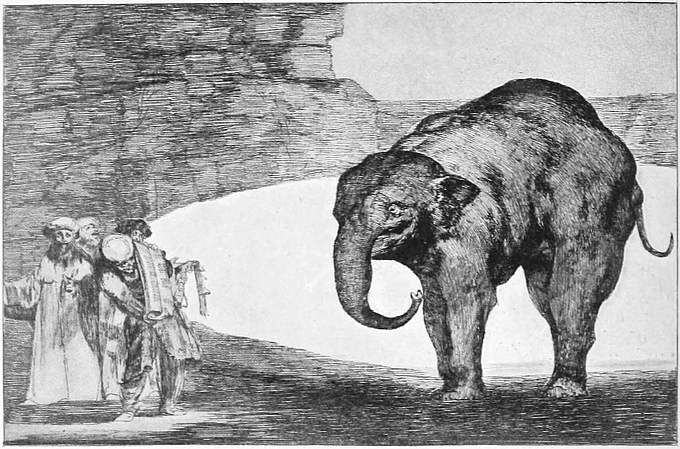 | |
| “L’Art.” | |
| GOYA. | OTRES LEYES POR EL PUEBLO. |
So thought France when Louis XIV was dead, and the man was already grown up in the Low Countries who was chosen to give a shape 55 to these dreams, to abolish the ascendency of gods and kings and heroes, and to show the upper classes their own image reflected in the mirror of art.
Antoine Watteau, who guided the stream of French art into this new channel—of the Netherlands—was by birth and training a Fleming. His birthplace, Valenciennes, although French territory since the Peace of Nymeguen, resembled in its whole character a Flemish town. In the church here he first saw any of Rubens’ pictures. Here, through Gérin, he became instructed in Flemish traditions. Rubens and Teniers are the two masters from whom his own art sprang. During the years when the war of the Spanish Succession had changed the French frontier provinces into a huge military camp, he painted soldiers and camp scenes, such as the “March” in the collection of Edmund Rothschild, where a party of recruits are straggling along a high plain in a fierce storm. Later came pictures of country life in the manner of Teniers, like the “Retour de Guinguette,” engraved by Chedel, a landscape in which on the right a party of rustics are carousing at a table in front of a farmyard, while on the other side half-drunken men and women are going home. Louis XIV had made before the pictures of Teniers his well-known mot: “Otez moi ces magots.” Now, through Watteau, the magot makes its entrance into French art. Thus in his chief picture in this manner, “La Vraie Gaieté,” the figures are unmistakably after Teniers. The men are short and sturdy, entirely Flemish. Only the costumes have changed with the mode. But the women are not in the least Flemish. The clean caps and tidy kerchiefs, the freshly ironed aprons, and neat little feet that trip so lightly and quickly along the street that no dirt seems to soil them, give these peasant girls a certain desirability in which it is not hard to discover the transition to French grace. The elegant motions and fine heads point to that Watteau who was to become soon afterwards the unsurpassable delineator of feminine coquetry.
Gillot and Rubens led him into the new road. The Teniers-like character of his figures disappeared, they became gracious and noble. In place of the magot came elegant French society. Gillot was the first in Paris to break with the pompous Louis XIV style, and to begin the representation of the cheerful life of comedians, to replace the dwellers in Olympus by characters of the French and Italian stage. Rubens had been the first in his “Garden of Love,” of the Dresden and Madrid Galleries, to invite to the embarkation for the Island of Cythera. Watteau acquired something from everyone he studied, and yet resembles none. After having hitherto sought his personages on the highways and in camps, he was now to become the painter of fêtes galantes, the painter of “Society.” For in his shepherds and shepherdesses there lives the elegance of France. The gods of the Renaissance, in whom no one any longer believed, glided into the costumes of Harlequin and Pierrette. In lieu of the great and the pathetic there came the small, the gay, the graceful, the dainty. The architectural symmetry of composition disappeared, and the stiff stage-scenery character of landscape vanished. 56 The grave formality of geometrical construction is changed into freedom and joyousness, just as the rhetorical, exact, measured periods of Boileau were relaxed, under the hands of Voltaire, into sentences unconstrained, buoyant, and crisp. Watteau’s art betokened the triumph of naturalism over the mannerism into which the French art of the seventeenth century, based on the Italian Renaissance, had dwindled. As it is said in an old poem—
| “Parée à la Françoise, un jour Dame Nature Eut le desir coquet de voir sa portraiture. Que fit la bonne mère? Elle enfanta Watteau.” |
Watteau became for French art what, a hundred years before, Rubens had been for Flemish—the deliverer. He delivered them from the oppressive yoke of the Italian tradition. In his world, where there were no longer any naked goddesses, but where the corset was opened only just wide enough to reveal a rosy bosom, there was nothing more left of the past. It is no longer antique beauty, no longer the plastic cold of the “Venus di Milo,” no longer the marble perfection of Raphael’s “Galatea.” Into those tender, feminine hands, into those lace sleeves, out of which snow-white arms come languishingly forth, into those slender waists, and teasing, dimpled chins, something of coquetry, of sensibility, something subtle and spiritual, has entered, that seems to transcend physical beauty. His young men are tall and supple, his women entirely indescribable, with their air of quiet roguishness and their exquisite coiffures. Quite modern is that distinguished sense for costume which made him a leader of fashion. Mysterious landscapes, that exhale peace and happiness all around! Rightly has Edmond de Goncourt called him a lyric poet, the great poet of the eighteenth century.
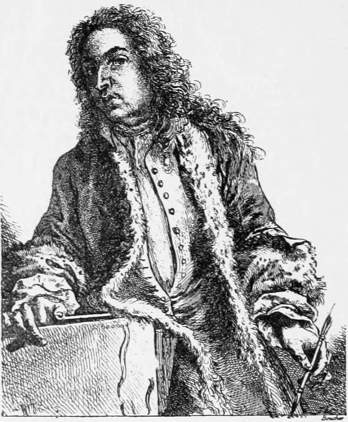 |
| ANTOINE WATTEAU. |
In this way the development proceeded. The pompous representation which portrait painting had practised hitherto was gone. People would no longer be masters of the ceremonies, but human beings. New forms of technique were discovered, such as pastel painting. No other material was capable of rendering the peculiar fragrance of this fugitive flower nature, the graceful appearance of this rococo style, of these ladies with the touch of powder in their hair, and their moist, dreamy eyes, as Maurice Latour, Rosalba Carriera, and later the Swiss, Liotard, painted them. Of those who endeavoured, 57 on the model of Watteau’s style, to depict the life of the fashionable world, none approached the delicacy of that national genius. Lancret and Pater followed him, but more roughly, more soberly, more drily. Lancret in his whole conception, compared with Watteau, is a homely, often a somewhat cumbrous journeyman; Pater, an artist of greater elegance, has the fickleness of the virtuoso. Both in conviction and in art they lacked that poetic, glorifying breath which pervades Watteau’s creations. In Watteau one believes that these gracious beings, these tall and nervous cavaliers, these amiable coquettes and comely women, actually represent originals in noble society; whereas in the works of his disciples it often happens that the paid model, selected from a lower circle of society, appears to us to be not congruous with the elegance of her wardrobe. These dancers, huntsmen, and noble maidens are not wholly what they should represent. But how delicious they are, these French gossips, so long as one is mindful not to think of Watteau! What grace is theirs too! What innate tact! With what a pleasant adroitness do they understand how to rivet our attention, and to keep far, far away from the tedium in which their classical ancestors, with their natural heaviness, waded! Instinctively and without effort they rejected the 58 rhythmically balanced composition and correct nobility of form of the classics, and found a characteristic expression for unconstrained gestures, pleasing movements, and refined elegance.
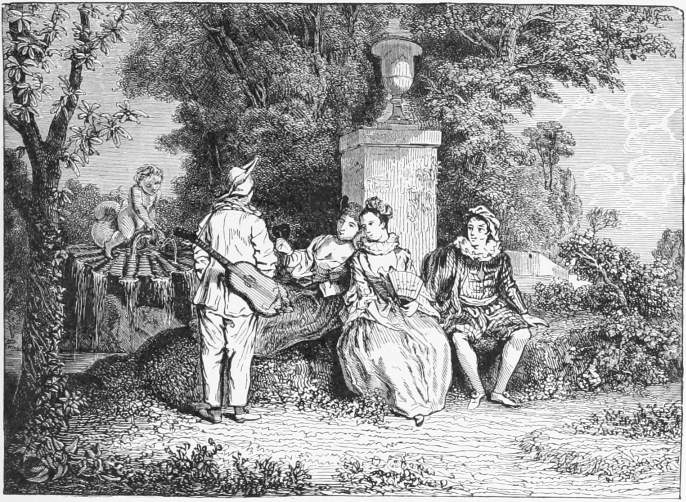 | |
| WATTEAU. | LA PARTIE CARRÉE. |
 |
| GREUZE. “L’Art.” |
Even the decorative painters abandoned more and more the much-worn paths of the Italians. François Lemoine gave them, by Rubens’ aid, the transition to a manner peculiarly French, elegant, sensuous, charming. His pupil, François Boucher, followed him. Like the sons of the seventeenth century, he made exhaustive use of mythological subjects and was often a superficial artist, and in his later works he became entirely a mannerist; but he was not so at the beginning. It was a great advance for France when Boucher gave his pupils the advice to abstain from imitation of the great Italian masters, and not to grow “as cold as ice.” And what a great naturalist he is in his numerous drawings and etchings, and in those marvellous groups of chubby children who are playing and tumbling about on clouds, or playing musical instruments shooting arrows, or sporting with flowers! “It is not every one who has the stuff to make a Boucher” even his great antagonist David has said of him.
In Fragonard, again, there was summed up all the joy of life and the frivolity, the lustrous, luxurious talent, the charming amiability and nimble sureness, of French art in the eighteenth century. Fragonard has painted everything. His great decorations are careless inspirations, sparkling with spirit and life. With him pastoral scenes alternate with episodes of everyday life—children, guitar players, women reading. Fragonard is a piquant, ingenious painter. Perhaps hardly any other painter has so much kissing in his pictures. His etching, “L’armoire,” of 1778, is well known. In that he already stood on the sure ground of popular life. The old rustic, who is armed with a formidable cudgel, is beating open, with the assistance of his wife, the doors of a great clothes cupboard, in which a handsome young fellow has hidden himself; close by is a pretty farm girl, weeping in confusion into her apron; in the background the curious and amazed little sisters are looking on.
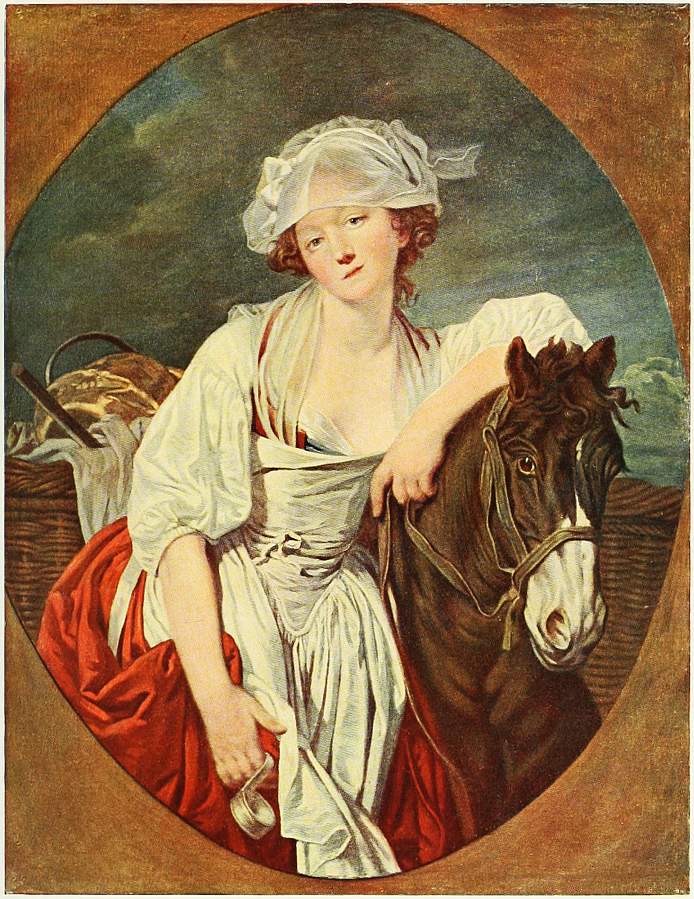 | |
| GREUZE. | THE MILKMAID. |
J. F. de Troy had, at the same time, abandoned himself to a more frolicsome manner, had played upon painting in pictures such as “The Proposal of Marriage” and “The Garter” with something of that frivolity which later came into fashion through Baudouin. That, however, was only for a very short time. Life was beginning to be in earnest—that is rather the impression one receives much earlier, from turning over the engravings of those years. Amongst the elders of the actual rococo age, contentment and gaiety still rule. As the heirs of an old civilisation, the aristocracy understood, with a refined and unique understanding, how to turn life 59 into a feast. Silk trains rustle over the parquet, silk shoes trip, eyes gleam, diamonds flash, white bosoms heave. Tall cavaliers advance to their sprightly partners, gossip and smiles fly around, Knights of Malta and abbés hang over the chairs and pay their court. Yes, this autumn of the old French culture was of a marvellous beauty for the fortunate, and those fortunate ones knew, as no other generation has ever done, how to enjoy life with serenity, in a fairy glamour of rooms gleaming with Venetian chandeliers, where rosy Cupidons laughed down bewitchingly from their light, gold moulded panels. Under Louis XVI the French salon acquired another aspect. Its walls, its whole architecture, were more sombre. The Cupidons still sported on the ceiling, but they were forgotten, like ghosts of the past; their shafts were already impotent. The vivacious, dancing couples have disappeared. Festivity has been banished from the big rooms: here and there is seen an earnest conversational party; gentlemen playing cards or ladies reading philosophical books. Social and political interests have sprung up with which people of education prefer to occupy themselves. Numerous works on commerce and constitutional methods have appeared during the last fifty years. In place of scandal there crop up arguments, for and against the Parliament, for and against the Jesuits. Enlightenment had won its victory. Henceforth development is no longer compatible with sensuous delight. It is still the same society as before, but without pleasure. One almost breathes the air of 1789. Gaming is only a struggle against ennui; the foreheads of women are furrowed with reading. Society has grown serious and sombre, as it were, with a presentiment of what is to come, as though destiny might thus be set aside. The writings of Diderot afford the clearest instance of this changed spirit of the age, and art too must become virtuous, and work for the amelioration of the world. Thus Diderot upheld the sentimental and emotional subject against the fêtes galantes of the rococo painter. Boucher derived his inspiration from the slough of prostitution; only a moral upheaval could tend to a high style. With Boucher the idea of honour, of innocence, has become something strange; the new age requires virtue, bonnes mœurs. But where are the virtues to be found? Naturally, there alone, where Rousseau had discovered them. Rousseau taught that man by nature was good, that he was noble, conscious of his moral obligations, self-sacrificing and uncorrupted when he came from 60 the hands of his Maker, and that it was civilisation which first corrupted him. It followed that the most civilised are the most corrupt, and virtues are to be met with, if anywhere, amongst the lower orders, who are the least affected by culture. Not beneath an embroidered waistcoat, only beneath a woollen smock, can a noble heart beat. The happy ignorance of the young Savoyard, eating his cheese or his oranges in a church porch, lies nearer to the original perfection of mankind than the most subtle erudition of the most ingenious of the encyclopædists. Amongst nature’s noblemen one must seek for the secret of virtue, which has been lost by the aristocracy in the stream of civilisation. Thus beneath the ægis of Rousseau’s philosophy the Third Estate makes its entry into French salons. From the man of the people society wanted to learn how to become once more simple, unassuming, and virtuous; and it was a gruesome irony of fate that this “man of the people” should reveal himself later, when the guillotine stood in the Place de la Concorde, as by no means so lamblike, modest, and self-sacrificing as that noble society had imagined him.
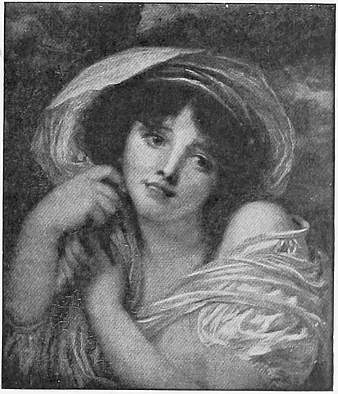 |
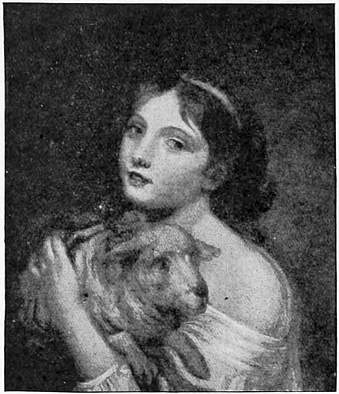 | ||
| Cassell & Co. | Cassell & Co. | ||
| GREUZE. | HEAD OF A GIRL. | GREUZE. | GIRL CARRYING A LAMB. |
Greuze represented this phase of French art when the riotous carnival of rococo had come to an end, and the Ash Wednesday of rule and fasting and penitence had ensued. It was considered that the aim of art must be to instruct and elevate, not merely to amuse; it should set an example to raise and inspire the good, to serve as a warning for the bad. “Rendre la vertu aimable, le vice odieux, le ridicule saillant, voilà le projet de tout honnête homme qui prend la plume, le pinceau ou le ciseau.” In these words Diderot formulated his programme. It was his wish that the corrupt man, when he went to an exhibition, should feel pricks of conscience at the pictures and read in them his own condemnation. “Si ses pas le conduisent au Salon, qu’il craigne d’arrêter ses regards sur la toile.” Educational effects, “moral stories told in pictures,” that is the keynote of Diderot’s demands upon the painter, and of the accomplishment of Greuze in answer to this claim. He is the French Hogarth, whether he paints in sombre colours the misery that the drunkard brings upon his family, and the horrors of poverty, or depicts in brighter tones the love of children for their parents and the works of charity; and with him too, as with the Englishman, his title was chosen with a didactic after-thought to heighten the effect 61 of his picture. Thus such scenes as these occurred: “The Father’s Curse,” “The Consolation of Age,” “The Son’s Correction,” “The Ungrateful Son,” “The Beloved Mother,” “The Spoilt Child,” “The Lame Man tended by his Relations,” and “The Results of Good Education.” He had this, too, in common with Hogarth: he liked to develop his moral stories in long series, which invariably ended with the triumph of virtue and the punishment of vice. The didactic story of Bazile et Thibaut attempted to relate in twenty-six chapters the influence of a good education on the formation of a whole life; and, just as in Hogarth’s story of the two apprentices, here too, at the conclusion, the well-educated Thibaut pronounces sentence of death over his old friend Bazile, the badly educated, and now condemned murderer. The fact that in other things the two moral apostles differ greatly from each other is accounted for by the difference in the national characteristics of those to whom they variously appealed.
Hogarth scourged the vices of the Third Estate in order to raise them to morality. Rape, bloodshed, debauchery, disorderliness, gluttony, and drunkenness—that was the channel through which in England at that day the furious flood of the uncontrolled spirit of the populace poured itself, foaming and raging with fearful natural force. Hogarth swung over these human animals the stout cudgel of morality in the manner of a sturdy policeman and Puritan bourgeois. With such people a delicate forbearance would have been misplaced. At the foot of every prison-scene he inscribed the name of the vice that he had pilloried there, and subjoined the predicted damnation from Holy Writ. He reveals it in its hideousness, he steeps it in its filth, traces it to its retribution, so that even the most vitiated conscience must recognise it and the most hardened abhor it.
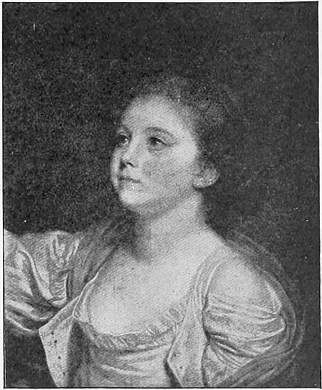 |
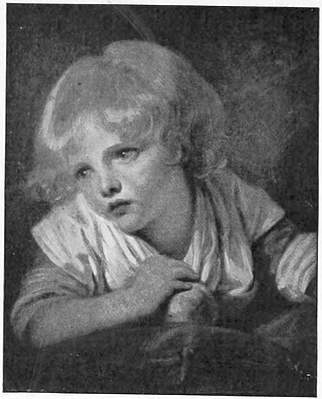 | ||
| Cassell & Co. | Cassell & Co. | ||
| GREUZE. | GIRL LOOKING UP. | GREUZE. | GIRL WITH AN APPLE. |
Greuze employs the Third Estate as a mirror of virtue, sets forth its noble qualities as an edification to an aristocracy that has grown vicious. Less primitive and, for that very reason, less original than Hogarth, he never forgets that he lives in the most refined social period in history. He does not strangle his culprits to provide terrifying examples, but nearly always leaves a corner open for repentance. He knew that he dared not exact too much from the nerves of his noble public; he merely wished to stir them to a soft vibration. He did not paint for drunken English people, but for those perfumed marquises who, later on, bowed with so 62 courtly an elegance before the guillotine; for those sensitive ladies in whom virtue now excited the same sensual delight that vice had done before. They welcomed in him the high priest of a sort of orgie of virtue, to whose festivals they had grown reconciled. The century which in its first half had danced as light-heartedly as any other the can-can of life, becomes, in its second half, sad of soul, enthusiastic over the reward of justice, the punishment of transgressors, over honour and the naïveté of innocence. Time after time do his contemporaries praise precisely that sense of virtue in the art of Greuze. So that in France, as in England, the burden of interest was laid no longer upon the art, but upon an accessory circumstance. For since, in the hands of Greuze, the picture had been turned into an argument, in France, as in England, art ceased to be an end—it became only a means. He made painting a didactic poem, the more melodramatic the better, and was driven thereby on the same sandbank upon which Hogarth, and all genre painters who would be more than painters, have made shipwreck. In order to bring out his story with the utmost possible distinctness, he was too frequently compelled unduly to accentuate his point. The effect became affected, the pathos theatrical. His picture of the “Father’s Curse” in the Louvre, with the infuriated old man, the son hurrying wildly away, and the weeping sisters, resembles the last act of a melodrama. “The Country Wedding,” where the father-in-law has given the young bridegroom the purse with the dowry, and now pathetically observes, “Take it, and be happy,” might just as well have been entitled “The Father’s Last Blessing.” In the picture in which a noble dame takes her daughter to the bedside of two poor persons who are ill, to accustom her in early life to works of charity, the personages in the picture, arranged exactly as if upon a stage, must have been themselves uncommonly moved by the touching and praiseworthy action. Greuze was the father of genre painting in France—that barbaric, story-telling art which replaced tableaux vivants based upon the literary idea by the Dutchmen’s picturesque and well-observed selections from nature. Beyond that, however, it must not be forgotten that he, like Hogarth, psychologically opposed to the earlier art, showed practical progress in many of his works. There were few in French art before him who depicted the emotions of the soul with such refinement 63 as Greuze in his “Reading of the Bible.” In proportion to the understanding and character of the individual is the impression of the listener reflected on his countenance. That was something new in comparison with the laughing gods of Boucher. And that Greuze was also capable of the most highly pictorial magic when he could once bring himself to lay aside the moral teacher is proved by his rosy, inspired heads of young girls. He never grew weary of painting these pretty children in every situation and attitude at that seductive age which hides the charming feet beneath the first long gown. Blonde or brunette, with a blue ribbon in the hair, a little cluster of flowers in the bodice, they gaze out upon life with their big, brown child eyes, full of curiosity and misgiving. A light gauze covers the soft lines of the neck, the shoulders are as yet hardly rounded, the pouting lips are fresh as the morning dew, and only the two rosy, budding breasts, that fight lustily against their imprisonment, and seem, like Sterne’s starling, to cry, “I cannot get out,” betray that the woman is already awake in the child. Greuze’s name will always be associated with these girl types, just as that of Leonardo is with the dreamy, smiling sphinx-like head of Mona Lisa. In them he has given an unsurpassable expression to the ideal of innocence at the end of the eighteenth century, and provided in them a new thrill of beauty for his contemporaries. And a blasé society which had indulged in every licence bathed itself with passionate delight in the unknown mystery of this surging flood. Yes, after the stimulating champagne of rococo, people had even come to delight in simple black bread. And so, out of bourgeoisie itself, a school of painting was developed as fresh and healthy as this.
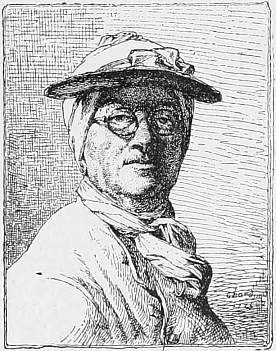 |
| ”Gaz. des Beaux Arts.” |
| CHARDIN. PORTRAIT OF HIMSELF |
Chardin, the carpenter’s son, is at the head of this domestic art in the eighteenth century. After Greuze, the painter of refined taste, he seems, a comfortable, healthy, bourgeois master in whom the Dutchman of the best period once more appears upon earth.
After the king had, up to the close of the seventeenth century, been the centre round which everything turned, the solitary personality which dared to appear independent, and upon which the rest of the world formed itself; after the circles round the court had next freed themselves, and gained the right to enjoy life and art for themselves, there still remained a third step to surmount. “Society” abdicates in favour of a free and healthy bourgeoisie.
A surgeon’s sign was the first work which brought the young man, who had received no systematic education, into notice. The surgeon is in his shop attending to a man 64 who has been wounded in a duel, grouped around are curious bystanders, while the commissary of police investigates the case with a grave countenance. It is the first picture of the Parisian life of the people. And Chardin, with his middle-class origin, remained the advocate of middle-class domestic life. He is the Watteau of the Third Estate. Greuze owes his success, in the first place, to the ingenious manner in which he made himself the spokesman of the moral tendency of his age. It interested contemporary society to be told that it is beautiful to see married folk live together in happiness; that young mothers do a good action in nursing their children, when it is possible, themselves; that man should repent of his sins; and that he who honours his father and mother lives long in the land. Nowadays we thank him for these wise counsels, but say, at the same time, that we could have done without them. We no longer see the necessity of illustrating the ten commandments, and notice now all the more the mannerisms, the rhetorical strokes of advocacy which the painter must employ in order to plead successfully. Chardin’s effect is as fresh to-day as it was a hundred years ago, because he was a sheer artist, who did not seek to tell a story, but only to represent,—a realist of the finest stamp, belonging in his exquisite sense of colour values to the illustrious family of the Terburgs. His pictures have no “purpose.” The washerwoman, the woman scraping carrots, the housewife at her manifold tasks—that is Chardin’s world; the atmosphere in which these figures move, the shimmering light that floats in the half-dark kitchen, the wealth of sun-rays that play upon the white tablecloths and brown-panelled walls—those are his fields of study. Chardin lived in an old studio, high up near the roof, a quiet, dark room that was usually full of vegetables which he used for his “still life.” There was something picturesque about the dusty walls where the moist green of vegetables mingled so harmoniously with the time-worn, sombre brown of the wainscoting, and the white table-cloth was flooded with the silvery green which poured in from a little skylight. In this peaceful and harmoniously toned chamber were laid those small domestic scenes, which he so loved to paint, and which were called by the French, in contrast to the Fétes Galantes, “Amusements de la Vie Privée.” The clock ticks, the lamp burns, water is boiling on the homely tiled stove. There is an effect in every one of his pictures, as though he had lived them himself, as if they were reminiscences of something dear to him and familiar. In contrast to Greuze he shunned all critical moments, and depicted only the quiet life of custom, everyday life as it befell in a constant, regular routine. There are no hasty movements with him, no catastrophes nor complications; he has a preference for “still life” in the world of men, just as in nature. He is par excellence the painter of Intimität (intimate life); which is not the same as a genre painter. Painters who in the manner of genre have depicted domestic scenes in rooms are to be found in every school; but how few have known how to depict the poetry of the family life with such truth, with such 65 an absence of affectation and insipidity! With Chardin art and life are interfused.
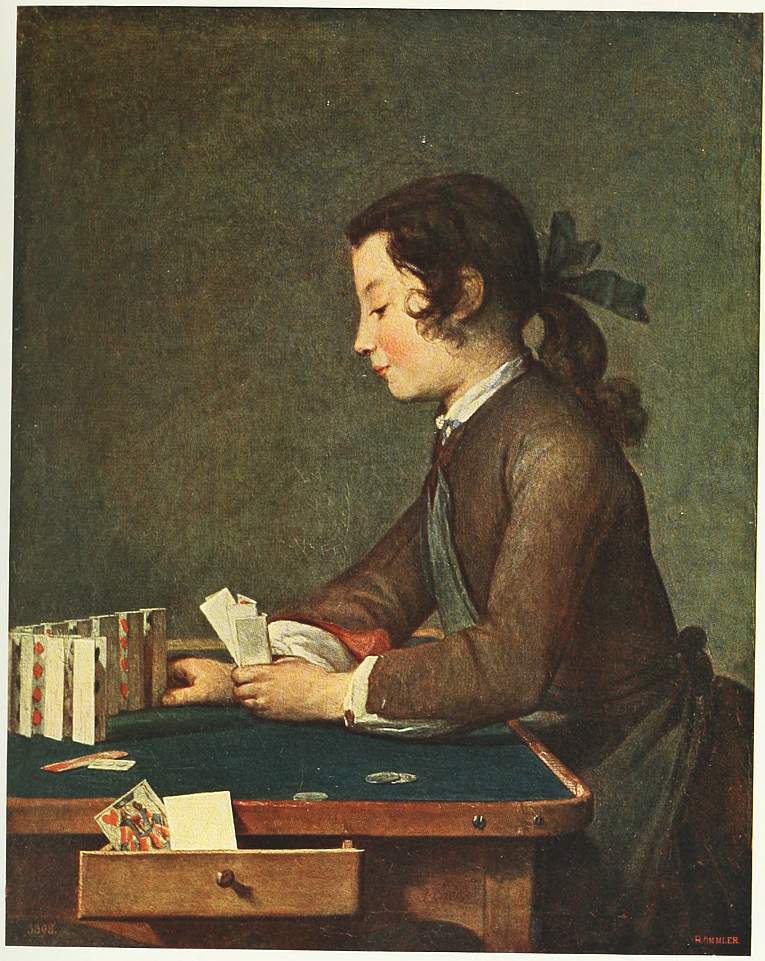 | |
| J. B. S. CHARDIN. | THE HOUSE OF CARDS. |
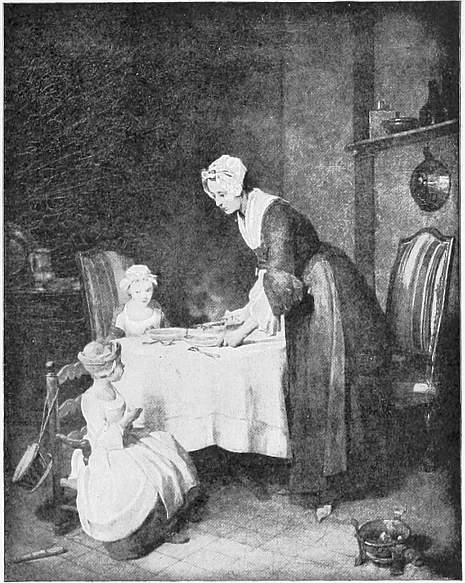 |
 | ||
| CHARDIN. | GRACE BEFORE MEAT. | DANIEL CHODOWIECKI. | |
No Dutchman, however, had penetrated into the nursery. Chardin, in surprising the child-world at their games, in their joys and sorrows, has opened out to art a new province. And with what affectionate devotion has he not absorbed himself in the spirit of the little people! I know of no one before him who has painted the unconscious spiritual life of the child with such discreet tenderness: the little hands that grasp at something, the lips that a mother would like to kiss, the dreamy wide-open young eyes. In this Chardin is a master. It is not only obvious expressions of joy and sorrow, but those refined shades, so difficult to seize, of observation, thoughtfulness, consideration, calm reflection, quaintness, obstinacy or sulking, which he analyses in the eyes of the child. There is the little girl playing with her doll, and lavishing on her all the love and care of a tender mother. There is an elderly, half-grown-up little lady teaching her younger brother the mysteries of the alphabet. Then come the games and the tasks. They build card-houses, blow bubbles, or are wholly engrossed in their drawing-books and home-lessons. How attentive the little girl is whose mother has just given her her first embroidery materials. How charmingly embarrassed is the small boy whom she hears his lesson. And what trouble she takes in the morning, that her darling shall be clean and tidy when he goes to school. In one picture the cap on the little girl’s head is crooked, and her mother is putting it straight, whilst the child with a pretty pride is peeping curiously in the glass. Again, there is the boy just saying good-bye. He is neat and 66 well combed; his playthings, too, have been nicely tidied up, and his books are under his arm. His mother takes his three-cornered hat off again in order to brush it properly. When school is over, you see them sitting at dinner. The table is laid with a snow-white cloth, and the cook is just bringing in a steaming dish. It is touching to see how prettily the small boy clasps his hands and says his grace. And when they are again off to afternoon school the mother sits alone. She looks charming in her simple house-dress, with the loose sleeves, her clean white apron and kerchief, her striped petticoat and coquettish cap. Soon she takes her embroidery on her lap and stoops forward to take a ball of wool out of her basket. Next she sits before the fire in a cosy corner against a folding screen. A half-opened book rests in her hand, a tea-cup stands close by, a homely atmosphere of the living room hovers round her. Then, like a true housewife, she takes up her house-keeping book, or goes into the kitchen to help the cook, while she scrapes carrots or scrubs the cooking utensils or brings in the meat from the larder. It is all rendered with such truth and simplicity that one acquires an affection for Chardin, who with his art got to the root of family life and bestowed upon it the subtlest gifts of observation and generous comprehension, while none the less his domesticity never became commonplace.
His contemporary, Étienne Jeurat, painted scenes at country fairs, and Jean Baptiste le Prince pictures of guardrooms and similar subjects. In Holland Cornelis Troost went on parallel lines with him. He depicted the life of his age and of his nation—comic scenes, banquets, weddings, and the like—in pastels or water colours, and that without seeking inspiration from any of the Dutch classics, but with a vivid, intelligent comprehension. Even Italian art ended in two “genre painters,” the Venetians Rotari and Pietro Longhi, who have bequeathed to us such charming little pictures of the life of that age—fortune-tellers, dancing-masters, tailors, apothecaries, little boys and girls at play or at their tasks.
 | |
| Cassell & Co. | |
| CHODOWIECKI. | THE FAMILY PICTURE. |
Germany presented no such great manifestation as Chardin, although there too the tendency was the same. There too, after the devastation of the Thirty Years’ War, a moral, active bourgeoisie had at last sprung up that was prepared to take up the line which had been already laid down by the English. Lessing was the first in this magnificent struggle for evolution. He wrote, in his Miss Sarah Sampson, the first German tragedy without the support of great mythical or historical heroes, and without the stiff ponderousness of the Alexandrine. He declared, like Moore, that helmets and diadems do not make tragic heroes; he even in his Minna set vividly before the eyes of his contemporaries something in the immediate present, the Seven Years’ War. And just as Lessing liberated the German drama from the jurisdiction of Boileau, so art began to mutiny against the classicism which had come in through the medium of France, and which had been inherited from the age when it was the pride of German courts to be small copies of Versailles.
“How exceedingly abhorrent to me are our berouged puppet painters,” cries the young Goethe, in his essay on German style and art, “I could not sufficiently protest; they have caught the eyes of the women with theatrical poses, false complexions, and gaudy costumes; the wood engravings of manly old Albrecht Dürer, at whom tyros scoff, are more welcome to me.... Only where intimacy and simplicity exist is all artistic vigour to be found, and woe to the artist who leaves his hut to squander himself in academic halls of state.”
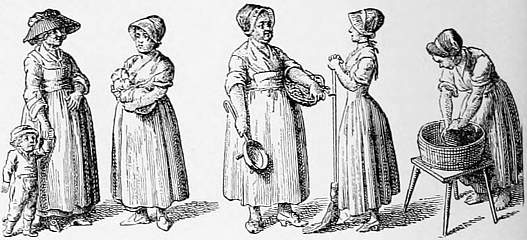 |
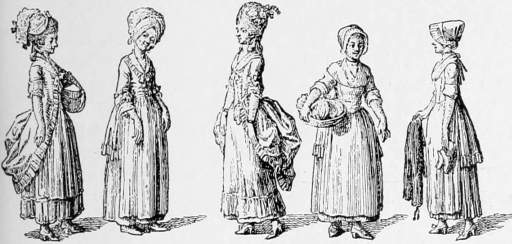 | ||
| CHODOWIECKI. | ALL SORTS AND CONDITIONS OF WOMEN. | Cassell & Co. | |
Daniel Chodowiecki, with all his commonplaceness, is a genuine expression of this phase of German art. He in Germany, Hogarth in England, and Chardin in France, are products of the same tendency of the age. After Lessing had produced in Minna the first domestic German tragedy, Chodowiecki, following the road of Hogarth and Chardin, was able to become the painter of the German middle class. He is not a master of such penetrating strength as they were, but he is no less an artist of notable merit. He is certainly no genius—in fact almost a handicraftsman, sober and philistine, but, like Hogarth, a self-made man who in his whole artistic and personal outlook was rooted in the soil of his city and of his age. Berlin society of that day was the basis of his art, the daily life of house and street his domain. He began by illustrating poems and depicting scenes out of the Seven Years’ War and the History of Charles the Great, and went on from that to the pleasant, homely life of the small 69 bourgeoisie. Himself of the middle classes, he chiefly worked for them, and with his sensitive and dexterous graving tool he kept the liveliest and most exhaustive chronicle of the German bourgeoisie of that age. At times almost too reasonable and prosaic, a genuine Nicolai, he has in other plates an enchanting freshness, and—which should not be forgotten—is more of an artist than Hogarth, since he is neither moralist nor satirist. His object, without any moral after-thought, was the true and kindly observation of life as displayed in the world around him. He took the wholly naïve delight of the genuine artist in turning everything he saw into a picture. These chronicles of his have some, it may be but a particle, of the spirit of Dürer. Simultaneously, the young Tischbein delved into the past of the nation, the age of Conradin and the Hohenstaufen, with the intention of finding there the simplicity which the academic pictures had come to lack; and, later on, he painted in Hamburg extremely realistic historical pictures of his own period, such as that which is to be found in the Oldenburg Gallery: “Entry of General Benigsen into Hamburg, 1814.” He did good work too as a portrait painter. In his best picture, “Goethe amongst the Ruins of Rome,” the head of the poet is energetic and full of strength, the colouring of an excellent clear grey.
In portrait painting in general, the revolution is reflected with especial clearness. The artificial manner that had been copied from the seventeenth century, the age of long perukes, gives way, slowly but surely, to an ever-growing naturalness, simplicity, and originality. At that time, while the spirit of Louis XIV still hovered over everything, the passion of the individual to be king in his own sphere had penetrated into the family. The honest citizen, therefore, would not let himself be painted as such, but only as a prince,—he, himself, in gala dress, with a pompous air, as stately as though he were giving an audience to the spectator, his wife in silk and gold and lace; she has a great mantle of state worn loose over her shoulders and hips, and looks down with an assumption of grandeur on her grandchild, who is half respectful and half inclined to make fun. The frame is as rich as the costume, and probably bears a crown. We are with difficulty persuaded that these are pictures of simple citizens, that the man, apart from the hours during which he sat to the painter, is an industrious tradesman, and the wife, glancing out so haughtily, most probably darned his stockings. Their portraits seem to form part of an ancestral gallery.
This age of princely state was followed by that of fraternity. In place of berouged and postured portraits with allegorical accessories, there appeared simple, unpretentious likenesses of human beings in their work-a-day clothes; in place of stiff attitudes, genre motives with the easy naturalness of everyday life.
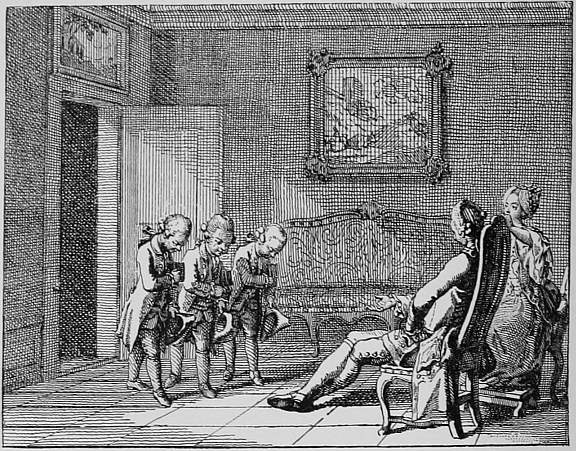 | |
| Cassell & Co. | |
| CHODOWIECKI. | THE MORNING COMPLIMENT. |
In Berlin, ever since 1709, Antoine Pesne had been for half a century the centre of artistic life, and in his works the revolution may be traced. Something familiar and intimate takes the place of that stately pomp. The princes, hitherto, had liked to be represented in mediæval armour or antique equipment; Pesne painted them in the costume of the time. And in his portraits of his friends and his family circle he has been still more unconstrained. There is the charming picture of 1718, in the New Palace at Potsdam, which shows the painter himself with his wife and his two children; the portrait of Schmidt the engraver, in the Berlin Museum; and the beautiful picture of 1754 in the collection of Colonel Von Berke, at Schemnitz, which depicts him again at the age of seventy-one with his two daughters. Pesne is revealed in these characteristic portraits, as well as in his character pictures in the Dresden Gallery (“The Girl with the Pigeons,” 1728, “The Cook with the Turkey-hen,” 1712), as a thoroughly sane and strong realist, of a kind which became almost extinct in Berlin a hundred years later.
In the next generation, in the Sturm-und-Drang period, Anton Graff, the Swiss, took the lead with his simple, domestic, honest, real portraits. 71 It was a happy disposition of fate that Graff’s activity just corresponded with the great period of the awakening of intellectual life in Germany, that Lessing and Schiller, Bodmer and Gessner, Wieland and Herder, Bürger and Gellert, Christian Gottfried Körner and Lippert, Moses Mendelssohn and Sulzer, and a long succession of other poets and scholars of the eighteenth and the beginning of the nineteenth century, found in him a portrait painter whose quick and agile hand left us their features in the truest and most authentic manner. What and how robust his art is, how clear and plastic the execution of the heads, how adroit and infallible the technique!
Besides Graff, there worked in Dresden Christian Leberecht Vogel, likewise a most independent, picturesque, and sensitive artist, who, if only for his pictures of children, deserves a place of honour in the history of art in the eighteenth century. In the portrait of his two boys, in the Dresden Gallery, the naïveté of child-life is observed with such tenderness and rendered with such vigour as only Reynolds understood. The boys are sitting close together on the ground. One, in a brown frock, is holding a book on his knees, which the other, in a red frock, with a whip in his hand, is looking at. The thoughtful expression of the little ones is quite charming; the execution broad and strong, the colour treatment delightful and tender.
In Munich lived the excellent Johann Edlinger, the most industrious of these sturdy masters, who were so modest and yet so capable.
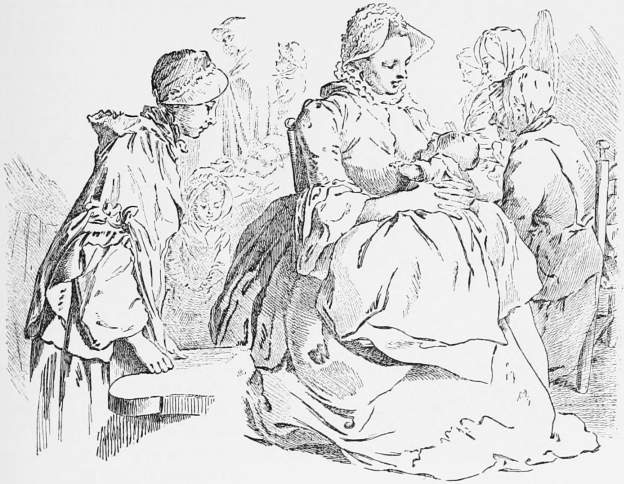 | |
| Cassell & Co. | |
| CHODOWIECKI. | THE ARTIST’S NURSERY. |
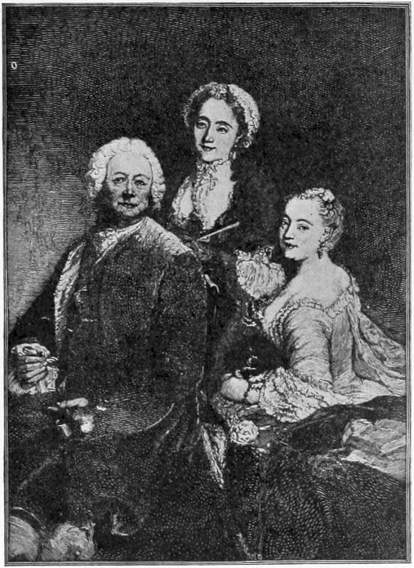 |
| Gaz. des Beaux Arts. |
| ANTOINE PESNE. PORTRAIT OF HIMSELF AND DAUGHTERS. |
In the domain of landscape the Continent produced no one who could be compared with Gainsborough; but here, too, the English influence made itself felt. It can be traced how the same feeling for nature which had given birth to Thomson’s Seasons and Gainsborough’s landscapes, afterwards found expression in France and Germany, and dissipated the prevailing taste in gardens. The seventeenth century—with the exception of the Dutch—had set nature in order with the garden shears. As Lebrun in his historical compositions endeavoured to outdo the Italians, so Lenôtre’s garden style exemplified the perfection and exaggeration of the gardens of the Italian Renaissance, which themselves again were laid out on the plan of the old Roman gardens from existing descriptions. A garden reminded one more of state apartments, which one could only walk through with measured steps, quietly and respectfully, than of nature, where one is, and dares to be, human. Corresponding to this formally planned, correctly measured style of garden there was a school of landscape which improved nature on “artistic” principles, and, by the arrangement of bits of nature, produced a world peculiarly full of style. Landscapes were nicely laid-out parks, which, like the figure pictures, made for an abstract beauty of mass and lines, and which, by means of accessories, such as classical ruins, would turn one’s thought to the ancient world. Nature must not, as Batteux taught, be the instructor of the artist, but the artist must select the parts and build up his picture. Out of many leaves he takes only the most perfectly developed, puts only such perfect leaves on one tree, and so obtains a perfect tree. Let the essential of his production be nature choisie, a selection of objects that “are capable of producing agreeable impressions”; his aim “le beau vrai qui est représenté comme s’il existait réellement et avec toutes les perfections qu’il peut recevoir.” The 73 eighteenth century went back from this “noble,” improved nature, step by step to the divine beauty of unimproved nature; just as those masters untouched by the Romans, Dürer and Altdorfer, Titian and Rubens, Brouwer and Velasquez, had painted her. The great Watteau, too, was here for the most part in advance of his age, in that, instead of the stiffly designed stage scenery of Poussin, he gave Elysian landscapes,—abodes of love, that now glisten in the sunshine of the young morning, now are suffused with golden light and the misty shadows of the evening twilight. The rose in her young bud is odorous, the nightingale sings, the doves coo, the light boughs whisper to the soft west wind, bright silver rivulets ripple, the wind sighs through the tall branches. Watteau knew nature and loved her, and rendered her in her transparent beauty with the intoxicated eyes of a lover. The spirit of nature, not of humanity, dominates in his pictures. It is only because nature is so lovely that man is so happy.
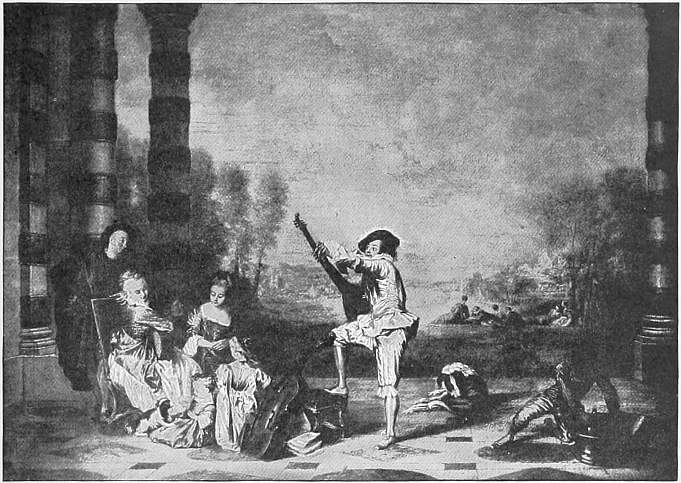 | |
| Cassell & Co. | Photo, Mansell. |
| WATTEAU. | THE MUSIC PARTY. |
But still more modern is the effect, when instead of painting Elysian landscapes with happy inhabitants, he drew mere bits of rural nature, poor solitary regions in the neighbourhood of big towns, where bricklayers are working on the scaffolding of some house, or peasants are riding with their horses over some stony byway. Out of a number of spirited drawings, this 74 side of his perception in landscape is especially notable in the picture in the New Palace at Potsdam, in the left background of which a small stream flows past a farmhouse, whilst in front a peasant is laboriously dragging a two-wheeled cart over the rough ground.
 | |
| Cassell & Co. | Photo, Mansell. |
| WATTEAU. | THE RETURN FROM THE CHASE. |
It is interesting to observe, at that time, after Watteau and his English predecessors, the widespread growth of this new feeling for nature. Thomson was followed by Rousseau, who, on his lonely wanderings, looked with moved eyes at “the gold of the corn crop, the purple of the heather, the majesty of the trees, and the wonderful variety of flowers and grasses.” He delighted in the blossoming of spring, the copses and rivulets, the song of birds, shady woods, and the landscapes of autumn, where the reapers and vine-dressers were working. He is the author of that lively feeling for nature that henceforth was aroused through the whole of Europe. A breath of pure mountain air, a wholesome draught of fresh water from Lake Leman, were brought suddenly into the sultry atmosphere of salons, and filled people’s hearts with a new and charming sensation when Rousseau’s works appeared. It was over with all efforts of “stylists” as soon as Rousseau declared that everything was good just as it came out of the lap of the universal mother, nature.
 | |
| WATTEAU. | FÊTE CHAMPÈTRE. |
Goethe, the pupil of Rousseau, presages, in his whole conception of nature, something of the manifestation of the school of Fontainebleau. He had something of Daubigny when, as Werther, he lies on the bank of the stream 75 and looks down thoughtfully at the worms and small insects. He makes one think of Dupré or Corot when he says: “As nature declines upon autumn, within me and around me it grows autumn”; or, “I could not now draw so much as a stroke, and I have never been a greater painter than at the present moment”; or, “Never have I been happier, nor has my perception of nature, down to the pebble or the grass beneath me, been fuller and more intimate. Yet,—I know not how I can express myself, everything swims and oscillates before my soul, so that I can seize no outline. A great, shadowy whole waves before my soul, my perception grows indistinct before it, even as my eyes do.”
 | |
| GESSNER. | LANDSCAPE (ETCHING). |
 |
| GESSNER. LANDSCAPE (ETCHING). |
Thus were the French gardens delivered by the English. Just as figure painting renounced lofty, architectural, formal composition, so those bisected and upholstered gardens were supplanted by irregular and, as it were, accidental bits of nature. People took no more trouble, in Rousseau’s phrase, “to dishonour nature by seeking to beautify her,” but laid out gardens in harmony with Goethe’s remark in Werther: “A feeling heart, not a scientific art of gardening, suggested the plan.” Close to Versailles, near the box-tree patterns of Lenôtre, lay the Petit Trianon, with its pond, its brook, and its dairy, where the unfortunate Marie Antoinette used to dream. And if painting still loitered on its preliminary return to nature, that only implied that the great artists—they only came in 1830!—were not yet born. Great artists can only raise themselves on the shoulders of their predecessors, whose value lies in their utility. The French landscapes of the eighteenth century, seen in the light of historical development, are of no importance; but, nevertheless, 76 they gave a considerable stimulus in that they sought to animate the style of Poussin with a closer perception of nature. Hubert Robert is certainly strongly decorative, but he has a light touch; one cannot take him at his word, but he is intelligent, and has sometimes grey and green tones that are soft and beautiful. Joseph Vernet painted coast scenery, views of harbours, storms at sea, likewise with decorative, superficial effects of light; he let flashes of lightning streak black clouds, sun-rays dance over lightly ruffled waves, silver moonshine play mysteriously upon the water, and caused conflagrations to break out and red flames to shoot up to heaven. He is somewhat inane and motley in his colouring. But he had ceased to see in the parts of nature nothing but materials for the construction of nicely fitting scenery. He no longer attempted to speak to the reason by means of lines, but to touch the soul through humour, and he employed in his scenery not only buildings and ruins, gods and ancient shepherds, but also modern groups of every kind.
In Switzerland, the charming etchings and water-colours of Solomon Gessner must be especially mentioned. Ludwig Richter, indeed, pointed them out as the eighteenth century works which, after the engravings of Chodowiecki, he loved the best. Gessner venerated Claude, and had an enthusiasm for Poussin, but his pictures have no traces of the lofty style of the heroic school of landscape. He sketched his native meadows, trees, and brooks; he loved all that was small and secluded and cosy, arbours and hedges, quiet little gardens and idyllic nooks. He approached everything with a very childlike and faithful observation of nature. A second Swiss, Ludwig Hess, dedicated a similar subtile sense of nature and loving zeal as much to his native Switzerland as to the Roman Campagna.
 | |
| L’Art. | |
| GUARDI. | VENICE. |
The German Philip Hackert has been prejudiced rather than profited by the monument which Goethe erected to him. As Goethe’s enthusiasm was not in due proportion with Hackert’s importance, he ceased later to attract attention, though this he did not merit, as he was always a vigorous and healthy landscape painter. He did not see nature with the tender sensibility of the Swiss. He looked at a landscape somewhat insipidly, as Chodowiecki at his models. But his drawing is sober, the atmosphere of his pictures clear and fresh; he cannot be tedious in his composition. In Dresden there lived Johann Alexander Thiele, who roamed through Thüringen and Mecklenburg as a landscape painter. Even in Italy landscapes 77 were the most independent performances which the eighteenth century had brought forth there. There worked in Rome the Netherlander, Vanvitelli, who depicted in graceful water-colours Roman and Neapolitan street life; and Giovanni Paolo Pannini, the peintre des fêtes publiques, in whose pictures groups of richly coloured figures moved through splendid palaces. Venice was the home of the Canaletti. In Antonio Canale’s town pictures of Venice, Rome, and London there is at once so subtle an atmospheric movement, the water is so clear, the air so transparent, that even if they represent mere streets and buildings, they yet leave an impression of landscape achieved in a broad, pictorial method. Bernardo Canaletto produces an effect by the fine, cool, damp light of his northern studies even simpler and more intimate, while by his discovery that sunshine does not—as it was hitherto believed—gild but silver the object it falls on, he became one of the fathers of realistic landscape. The most ingenious, however, of the school of Canale, not to say one of the cleverest landscape painters of the century, was Francesco Guardi. Antonio Canale was a great artist, and shows it never better than in his distinguished etchings, but as a painter he interests the collector more than the connoisseur. There his qualities are too often petrified into an excessive formality; he shows something too much of the camera obscura. Guardi is ingenious and startling. Where you have accuracy in Canale, in him you find spirit. Canale shows us the real Venice, Guardi shows it as we have dreamed it to be. He 78 has not Canale’s knowledge of perspective and architecture, but he fascinates us. He is a musician and a poet whose palette resounds with the purest harmonies. In his pictures the whole seductive legend of the fallen Queen of the Adriatic abides. Garlanded gondolas glide peaceful and fairy-like, majestic as vessels in some distant wonderland, over the clear, green water of the canals, beneath the high, marble palaces, which mirror their columns and balconies, their arches and their loggias in the stream. Foreign ambassadors pass in great state through the Piazza di San Marco; all that proud, Venetian nobility greets them; and thick throngs of people in their Sunday attire move to and fro beneath the Hall of the Procuration. Gay bands of musicians row along the Piazzetta and the Riva. A moist breeze sweeps over the water; the sunshine, now subdued and mellow, now dancing coquettishly, plays upon the water or on the houses. Francesco Guardi, the magician of Venice, is an animated, exquisite, always ingenious improvisatore, strong as few others are in the direct transference of his personal impression to canvas. Every stroke of his brush takes effect,—in each one of his pictures one sees the nervous exaltation of the hand; and that gives him a power of attraction which, compared with Canale, is like that of the clay model, in which the hand of the sculptor is still perceptible, compared with the cold, marble statue.
Even Spain, which, except for the colossal figure of Velasquez, had so far produced no painters of landscape—even Spain, after the middle of the century, turned into this road. Don Pedro Rodriguez de Miranda painted his broad, clear, and vigorously observed highland studies; Don Mariano Ramon Sanchez his small views of towns and harbours.
And, as in England, hand in hand with that came paintings of animals.
In France, François Canova was working, the painter of huge battle scenes and small pictures of animals; Jean Louis de Marne, who was famous for his cattle, market scenes, village pictures, and the like; and the great Jean Baptiste Oudry, who painted with breadth and freedom animals alive and dead, wild and tame, still-life of every kind. In Augsburg lived Johann Elias Riedinger, whose field of activity embraced the entire animal world, dogs and horses, stags and roes, wild boars, chamois, bears, lions, tigers, elephants, and the hippopotamus—which he depicted with fine observation, both in their proud solitude and at strife with men.
If we cast one more glance back to the road which art had travelled since the commencement of the century, we can have no doubt as to the end which was proportionately aimed at in all countries. Until quite recently a courtly, aristocratic art had shed its light upon the whole of Europe. In the seventeenth century the Dutch alone had maintained their isolation. They who entered fresh into art, and had to break with no tradition, gave at that time the first expression to the new spirit, in that they resolutely recalled art from its courtly surroundings to the humbler dwellings of the middle classes. They painted what Dürer and the “little masters” had only graved upon wood 79 blocks and copper plates. Still, they wished to paint these things less for their own sakes than because so intimate a light was shed upon them. Through elements of light they contrived to cast over everyday moments a sort of fairy inspiration. Watteau and his successors made a further advance in the conquest of the visible world, in that they desired to paint their age, for its own sake, in all its grace; and by the middle of the century we find this new, intimate, familiar art, independent of ancient tradition, triumphing all along the line. “Sublime” painting is more and more forsaken. Art becomes more and more indigenous to her world and age. Aristocratic Watteau is succeeded by Hogarth, Greuze, Chardin, and Chodowiecki, who treat the Third Estate no longer in the Dutch chiaroscuro, but in all its heavy reality as a valid object of art. Instead of that lofty, majestic, vainglorious painting of mere representations, which was the outcome of Cinquecento, and which at the expiration of the seventeenth century had sunk, through abstraction, into something uniform, trivial, and tedious, there appeared on all sides an art which was simple and sincere, which plunged into the life of every day, observed man in his relations with nature, with his fellows, with his faithful animals, and with his household goods—an art which created the variety of its representations out of its own experience. So with landscape, the most modern branch of art; it reached in the schools of all nations a greater significance—at least, in extent—than it had ever possessed in the history of art. And this development proceeded without its being established that any one country had direct influence on any other. The ideas hung in the atmosphere; they were the ideas of the century. It is as though the departing age would hold a mirror before us—a magic mirror—which foretells the future; as though it would point out that nineteenth century art, advancing further along this road, should be domestic-human, and that it should find in landscape its most appropriate expression.
It was not given to painting to proceed straight forward in this course, for through favour, partly of the changed current of literature, partly of the revolution, the flame of reactionary classicism shot up brightly once more before it expired.

CHAPTER III
THE CLASSICAL REACTION IN GERMANY
A hundred years ago there lived a man of the name of Asmus Carstens; and he was the pioneer and founder of the new German art. That has become since Fernow a standing maxim in manuals of the history of art. Dilettantism, however, is not an element, but an end. It is on this account, therefore, that later times will see in Carstens, not a pioneer, but only one of the close followers of that tendency of which the founders were the brothers Caracci, and the offshoots Lebrun, Lairesse, and Van der Werff. It is, at all events, historically clear that Hogarth and Gainsborough, Watteau, Greuze, Chardin, and Goya were the men to whom the future belonged. Their art survived the overthrow of the Classicalism represented by Mengs and Carstens, which, through external circumstances, once more got the upper hand for a short time, and it became the foundation on which, after the disappearance of this tendency inherited from the past, the moderns built further. The former represented progress, because they moved forwards; Carstens and David, reaction, because they looked backwards—backwards to an age which had long ago been buried.
There is always danger to a living art in the contact with any great art of the past. Only those who are themselves highly gifted may hope to emulate the great ones of the earlier centuries; lesser geniuses perish in the attempt. Painters like Leonardo and Raphael, like Titian and Poussin, taking the Greeks as their masters, produced immortal works, and Goethe and Schiller proved to us that the Hellenic spirit is still alive and active in our midst. But would anyone dare to mention Mengs and Carstens in the same breath with these giants?
The close of the eighteenth century was a period of antiquarian revival. The ruins of Pæstum had been brought to light, Greek vases and Roman monuments had become known to the public by the works of Hamilton and Piranesi. In 1762 Stuart and Revett published their splendid work on the Antiquities of Athens. To a German, however, was to fall the honour of becoming the hero of the archæological period. The History of Ancient Art, by Johann Joachim Winckelmann, appeared in 1764, and this writer devoted his literary energies to the hymning of the glories of the re-discovered treasures of antiquity. In the realm of pictorial art he may also be looked upon as the chosen of fate. Already, nine years before the appearance of his History of 81 Art, he had given, at the age of thirty-eight, his first writing to the world, Thoughts upon the Imitation of Greek Works, in which the reformation motive is epitomised in this sentence: “The sole means for us to become—ay, if possible, inimitably great—is the imitation of the ancients.”
From Winckelmann the stone kept on rolling. “In Greek sculpture the painter can attain to the most sublime conception of beauty, and learn what he must lend to nature in order to give dignity and propriety to his imitation,” writes Solomon Gessner in 1759. In 1762 Hagedorn of Dresden deplored, in his Treatise on Painting, that “Terburg and Metsu never showed us fair Andromache amongst her industrious women, instead of Dutch sempstresses.” In 1766 Lessing wrote his Laocoön, and, like Winckelmann, saw in the sculpture of the Greeks the ideal to be imitated. From this point forward he despised landscape and genre painting, and especially everything which illustrates intimate emotions and actions, and would confine the composition of pictures to an arrangement of two or three “ideal figures which please by physical beauty.” Soon afterwards, with almost astonishing partiality, Goethe intervened in a notable manner on behalf of Classicism with the most flagrant contradiction of the ideas of his youth. “Nature alone,” he had said in Werther, “makes the great artist”; and in his essay upon German Method and Art he aimed this sentence at Winckelmann and his followers: “You yourselves, admirable beings, to whom it was given to enjoy the highest beauty, you are hurtful to genius; it will be raised up and borne along on no strange wings, were they even the wings of the dawn.” In the same essay occurs the beautiful passage: “If art is produced out of an inward, single, independent conception, untroubled by, unconscious indeed, of, all that is extraneous, then whether she be born of rough wildness or of cultivated sensibility, she is complete and living.” Soon afterwards he wrote again these great words: “Rembrandt appears to me in his biblical subjects as a true saint who saw God present everywhere, at every step, in the chamber and in the fields, and did not need the surrounding pomp of temples and sacrifices to feel drawn towards Him,”—an observation made at a time when the academic and erudite writer on art was still for years to perceive in the biblical pictures of the great Dutchman only a crude conception of form. In another passage, upon the frescoes of Mantegna, in the Church of the Anchorite, at Padua, there occur the following sentences, showing the deepest historical perception: “How sharp and sure a modernity stands out in these pictures! From this modernity, which is quite real, and not merely seeming, with factitious effects, speaking only to the imaginative faculty, but solid, detailed, and conscientiously circumscribed, and which at the same time has something austere and industrious and painstaking—from this issued subsequent painters such as Titian; and now the liveliness of their genius, the energy of their nature, enlightened by the spirit of their predecessors, built up through their strength, was able to soar ever higher and higher, to rise from earth and create divine but real figures.” But, alas! later on he did not draw the conclusion which followed quite logically from 82 these observations for the judgment of contemporary German art. He came back from Italy as a disciple and follower of Winckelmann’s writings on art. “Art has once for all, like the works of Homer, been written in Greek, and he deceives himself who believes that it is German.”
Something pagan entered into his soul, a breath from the calm of Olympus. He derided his earlier Gothic inclinations, contemptuous of all that was opposed to Greek notions of form, mild and indulgent to all that bore at least the outward semblance of the antique. He preferred a cold ideal manner to what was natural, and held Greek art the absolutely valid model. From it should be derived a fixed canon, a table of accepted laws, to be the standard for the artist of our own days, and of every age. The Prize Essays, which he published with Heinrich Meyer in the Propyläen, and later in the Jena Literary Journal, required the treatment of subjects exclusively from the Hellenic legendary cycles, “whereby the artist should become accustomed to come out from his own age and surroundings”; the composition of pictures was to correspond strictly with the style of the antique frieze.
Amongst his contemporaries voices were not wanting to point out how fatal this programme was. Notably, Wilhelm Heinse, in 1776, wrote this golden sentence: “Art can only direct itself to the people with whom it lives. Every one works for the people amongst whom fate has thrown him, and seeks to plumb its heart. Every country has its own distinctive art, just as it has its own climate, its scenery, its own taste, and its own drink.”
Similarly, Klopstock opposed Winckelmann’s theories in these lines—
| “Nachahmen soll ich nicht und dennoch nennet, Dein ewig Lob nur immer Griechenland. Wem Genius in seinem Busen brennet, Der ahm’ den Griechen nach!—der Griech’ erfand.” |
Again, in the German Republic of Letters, in the chapter “On High Treason”: “It is high treason for any one to maintain that the Greeks cannot be surpassed.” In a letter to Goethe, in the year 1800, Schiller wrote: “The antique was a manifestation of its age which can never return, and to force the individual production of an individual age after the pattern of one quite heterogeneous, is to kill that art which can only have a dynamic origin and effect.” Madame de Staël, in her book on Germany, says: “If nowadays the fine arts should be confined to the simplicity of the ancients, we should not then be able to attain to the original strength which distinguished them, while we should lose that intimate, composite feeling for life which is especially found in us. Simplicity in art would easily turn with the moderns into coldness and affectation, whereas with the ancients it was full of life.” In 1797 Counsellor Hirth published in Schiller’s Horæ his well-known treatise on Beauty in Art, which, in opposition to the inanimate type of beauty of Winckelmann, upheld the characteristic as the first principle in art. Most remarkable, however, is the breadth of historical outlook which was peculiar to Herder, and the stern actuality with which in his Plastik, and in the Vierten 83 Kritischen Wäldchen, he turned against “those pitiful critics, those wretched and narrow rules of art, that bitter-sweet prattle of universal beauty, through which the younger generation is being ruined, which is nauseating to the master, and which, nevertheless, the rabble of connoisseurs takes in its mouth as words of wisdom.... Shadows and sunrise, lightning and thunder, the brook and the flame the sculptor cannot model; but is that therefore to be a reason why it should not be done by the painter? What other law has painting, what other power and function, than to depict the great scheme of nature with all her manifestations, in their great and beautiful aspect? And with what magic it does this! They are not clever who despise landscape painting, the fragments of nature of the great harmony of creation, who depreciate it or entirely forbid it to the sincere artist. Is a painter not to be a painter? Is he to turn statues with his brush, and fiddle with his colours, just as it may please their antique taste? To represent the scheme of creation seems vulgar to them; just as though heaven and earth were not better than an old statue.... Doubtless Greek sculpture stands in the sea of time like a lighthouse, but it should be only a friend and not a commander. Painting is a scheme of magic, as vast as the world and as history, and certainly not every figure in it can or ought to be a statue. In a picture no single figure is everything; and if they are all equally beautiful, no one then is beautiful any longer. They become a dull monotony of long-limbed Greek figures with straight noses, who all stand there and parade and take as little part in the action as possible. Now, when this misrepresentation of beauty cries scorn at the same time upon the whole conception, upon history, upon character, upon action, and this openly attacks that as a lie, there comes a discord, something insupportable, into painting, which certainly the antique pedant is unaware of, but which is felt all the more by the true friend of the antique. And finally, our own actual age, the most fruitful subjects of history, the liveliest characters, all feeling of a simple truth and precision, will be antiquarianised away. Posterity will stand and gape at such fantasies in practice and theory, and will not know what we were, in what age we lived, nor what brought us to this wretched folly, to the wish to live in another age, in another nation and climate, and thereby to abandon, or vitiate deplorably, the whole order of nature and history.”
These sentences, however, stood in isolation, or else they came too late. Immediately after it had been heralded by the literary movement, after the archæologists had verbally announced its aim, formulated its principles and laws, German art turned into the new paths. “It happened for the first time in the history of art,” wrote Goethe, “that important talents took pleasure in disciplining themselves by the past, and so founding a new epoch in art.”
| “Des Deutschen Künstler’s Vaterland, Ist Griechenland, ist Griechenland” |
was sung in the academies. And this violent grasping after the ideal of a 84 foreign race brought a bitter revenge, since not one of the artists who now appeared had the genius to create anything new out of the old.
 |
| Photo Union, Munich. |
| MENGS. PORTRAIT OF HIMSELF. |
The disciples of Winckelmann had not been, like Goethe and Schiller, vigorous naturalists until the spirit of ancient times had looked upon them, and they were consequently still less able to resist her glance. They entered upon the new road not with that generative impulse of the creative mind, whose superabundance did not know what course it should take, what stream it should find. They adopted the forms, as they had been provided by the greater ages, without any doubt as to their absolute excellence, or the least attempt at any happy innovation. And if they “have better understood” the Greeks than their predecessors in Italy and France were able to do, then one is never less like an original nature than when one imitates them faithfully. Winckelmann’s road to inimitability led not only to a more hollow and lifeless Classicism than there ever had been, to a more cheerless and unpleasant art than any which the school of Bologna had produced. It tended, above all, since the thinking people had thought out the classic idea—which the other nations had not—to the sacrifice of all pictorial technique, of the whole knowledge which the age had up till then possessed. There is a legend in the history of the Church, that at the time of the donation of Constantine a voice was heard from Heaven: “This day has poison entered into the body of the Church.” To the German art of our century this poison was the writings of Winckelmann.
First of all it was Anton Rafael Mengs, whose originally strong and great talent was distorted by the counsels of the learned. As in the works of the Caracci, those only are to-day of any interest which reveal themselves least as eclectics and most as children of the seventeenth century, so with Mengs—he is only enjoyable now where he did not try to be antique, but sympathised without too much reflection on the traditions of his age. He is particularly so in his fine pastel portraits in the Dresden Gallery, which are wholly influenced by the taste for rococo, and are its last expiring manifestation. They are a testimony that it was not without some justice that the Apelles of Dresden 85 was called by his contemporaries the most remarkable German painter of the eighteenth century. Rosalba Carriera and Liotard seem weak and insipid beside him; Reynolds only at his best had that characteristic clearness, that plastic energy of modelling, and that life-like colouring. There is nothing insipid or affected, nothing of that simpering affability that his successors brought into vogue. And when we remember that they proceeded from a youth of sixteen, the strength and simplicity of intuition seem incredible. In his later portraits, too, painted in oil, the better ones are directly classic; very noble in their clear, subtile, grey tone, strikingly alive, and, withal, of an extraordinary independence which shows no leaning upon any other master whatever. Mengs belongs to those portrait painters who look into the souls of their sitters, and he ranks, in works like his portrait of himself, in the Munich Gallery, amongst the best portrait painters of the eighteenth century.
 | |
| MENGS. | MOUNT PARNASSUS. |
In his huge ecclesiastical paintings he is the son of that period which had just commenced to be touched by the pallor of thought, and groped eclectically now in this direction and now in that. “First of all must the weeds be rooted up,” wrote Zanotti in his Directions to a Young Man upon Painting. “And then we must go back again to Cimabue and Giotto, and again, a few years later, to Buonarotti and Sanzio, and their noble successors whose footsteps are no longer sought or followed by any one. But when such a happy resurrection will take place, God knows!” The old Ismael Mengs believed that that was his concern; he chose Antonio da Allegri and Rafael Sanzio as sponsors for his son. Anton Rafael should become the eclectic reformer of art, and as he was probably the first painter who, by the express permission of the Elector of Saxony, was allowed to visit the hitherto inaccessible Dresden Gallery, this wish was easy of accomplishment.
 |
| ANGELICA KAUFFMANN. Cassell & Co. |
He was quick in freeing himself from the immediate tradition of the age, and in harmony with the teaching of the Caracci, in returning to the so-called “higher” models of painting. When one runs across such of his pictures in some gallery—notably his altar pieces—they strike one as the works of some good master of the seventeenth century whose name one cannot, for the moment, recollect. His famous “Holy Night,” in which he wished to enter into rivalry with Correggio, has something of a Maratti about it, only the heads are more vacant and insipid.
It is that unfortunate “Parnassus” in the Villa Albani which first marks the collapse of this great talent. When, upon the advice of his friend Winckelmann, he turned from the study of Raphael and Correggio to that of the antique, Mengs forfeited not only the remnant of all that was essentially natural, but even all the picturesque qualities which had hitherto distinguished him. After painting had so long taken sculpture in tow, now sculpture seemed anxious to be revenged on it, and there was a manifestation of those prettily painted figures in plaster which for some score years afterwards paraded in every German picture.
For Winckelmann’s mistake, as Herder had already pointed out with great justice, consisted not only in this, that he set up for imitation a departed ideal for the consciousness of his contemporaries, but notably in that he obtruded principles upon modern painting which might be valid in ancient sculpture. Since the antique ideal was solely a plastic one, and neither the Greek Prussian nor, later, Meister Ephraim was clear as to the difference between sculpture and painting, they practically recommended the painter to work after plastic models.
The fact that Lessing, in discussing the limits of painting in his Laocoön, took a work of sculpture as his starting-point, proves that to him the laws and conditions of both arts were valued as the same. They denounced the confusion of the art of painting with poetry, and instead advocated the confounding of painting with sculpture, which was no less hazardous.
 | |
| ANGELICA KAUFFMANN. | PORTRAIT OF A LADY AS A VESTAL. |
In this manner there came an alien element into Mengs’ hitherto quite pictorial apprehension; a vain and exclusively reproductive ideality deprived his figures of the last remnant of truth to nature which he had formerly understood how to give them. It is difficult to believe that Winckelmann’s paroxysm of friendship should have burst out, upon the completion of the “Parnassus,” into this pæan: “During the whole of the new age a more beautiful work has not appeared in painting; even Raphael would have bowed his head.” 87 The whole is nothing more than a mélange of plagiarism and banal reminiscences, without soul or perception, without freshness or individuality; a mere plastic warehouse, and not even a painted antique group, but a daubed compilation of solitary statues, colder and more lifeless than any Baltoni ever painted. There was an audacious, strong aim, genial strength and an overwhelming flow of fantasy in the contemporary works of the great décorateur Tiepolo; here there is a mere work of intellect which with philological aid builds up the composition entirely of borrowed materials. The only thing which even still points in this work to the good old times is a more solid study of form and colour than all that which originated in Germany during the next fifty years. The figures are painted with a strength and bloom which are still quite worthy of the rococo.
The “good Angelica” is the second representative of this phase of transition. She, too, at the persuasion of her friend Winckelmann, clothed herself as an ancient Vestal, but her true woman’s nature left in her classical raiment still a neat fashion of rococo. Through her intercourse with Winckelmann she became somewhat of a “blue-stocking,” and studied the historians of antiquity in order to find there subjects like Cornelia, the mother of the Gracchi, Agrippina with the urn of Germanicus, Phryne, and the like. Still more there were the tender legends of the ancients, out of whose store she satisfied her patrons: Adonis at the chase, Psyche, Ariadne abandoned by Theseus or found by Bacchus, the death of Alcestis, Hero and Leander. In these she is soft to the point of sentimentality, and pleasant to the point of nausea. Goethe says of her with justice: “The forms and traits of the figures have little variety, the expression of the passions no force, the heroes look like gentle boys, or girls in disguise.” But he also says of her: “The lightness, grace in form, colour, conception, and treatment is the one ruling quality of the numerous works of our fair artist. No living painter has surpassed her either in grace of representation or in the taste and capacity with which she handles her brush.” And this decision, too, can still be endorsed. Angelica knew how to impart to those clear lines and forms demanded by Winckelmann a grace now coquettish, now sentimental, but always extremely lovable. She has struck soft and—notably in her portraits of women—very tender colour chords.
She and Mengs were the last who still possessed considerable technical knowledge. Almost everything which has survived of the tradition of craftsmanship in Germany in the nineteenth century is traceable to Mengs’ influence, and that fact so offended his successors that they no longer counted him as one of them, but put him contemptuously aside as a “mannerist painter by recipe.” “Such technical knowledge,” wrote Goethe, “hinders that complete abstraction and elevation over the real, which is asked of identical representations in sculpture, which merely furnish forms in their highest purity and beauty.” “Colouring, light and shadows, do not give such value to a painting as noble contour alone,” wrote Winckelmann, 88 and these sentences became the starting-point of the next generation. Winckelmann’s error when he recommended the imitation of Greek sculpture to the modern painter consisted still further in this, that he confused “noble simplicity and quiet grandeur” with lack of colour and coldness. Herder had written well: “In distinction to the compact harmony of form in sculpture, painting has her harmonious unity in colour and light. I do not know why many theorists should have spoken so contemptuously of what is called chiaroscuro, the grouping of light and shade; it is the instrument of genius with every scholar and master, the eye with which he sees, the flashing, spiritual sea with which he sprinkles everything, and on which, indeed, every outline also depends. This divine, spiritual sea of light, this fairyland of adjusted light and shade, is the business of painting: why should we fight against nature, and not allow every art to do what it alone can do and do best?”
 |
| Photographic Union, Munich. |
| CARSTENS. PORTRAIT OF HIMSELF. |
His words died away. The philosophic tendency of the century, which sought to penetrate into the “soul” of things, and to recreate things from the throne of the universe of the abstract, tried its hand also upon painting. By abstracting from the manifestation of colour, and touching upon form and line, it came to believe that in these plastic elements it had discovered the Essential of which it was in search.
Once on the road to execute statues in paint, the question ensued, Ought we to paint our statues? And as that age, following in Winckelmann’s track, understood no word of the significance which the specific, picturesque principles had for the Greeks, it was only logical that they should endeavour to reconcile the idea of immaculate whiteness with that of classical beauty, to see pure beauty in absence of colour, and in consequence to accentuate the question, Ought we to paint our pictures? To painters the most suspicious element in a painting became the paint! There is nothing more urgent for them to do than to deprive themselves ascetically of all coloristic means of expression. Painting is shown to be an essential form of corruption—“The brush is become 89 the ruin of our art,” wrote Cornelius—and there commences the era of a cartoon style hitherto unprecedented, which is to be carried on by the most highly endowed in the most earnest fashion. While during the rococo the sense of colour had reached, through a piquant arrangement of the most tender and variegated tones, its highest point of refinement, there followed now as a reaction an absolute lack of colour. The ideal is seen in an abstract beauty of line, colour as a secondary matter and a vain show. It was of as much value as a vari-coloured dress, which nature could put on or off, without being less nature thereby. Amongst painters there was talk of nothing but outlines. This line style, whose world is not the wall or the canvas, but white paper, can do with a proportionately meagre study of nature. Why, therefore, when the ideal was so easy of attainment, drudge in the academy, where, moreover, since the introduction of Mengs’ Classicism, universal desolation of the spirit and doctrinaire pedantry reigned? As Mengs had broken with the taste of the rococo, so the younger generation broke with its technique, whilst they left the academy in open dissatisfaction, and threw off in contempt the whole paraphernalia of technical traditions.
Carstens plays the momentous rôle in German art as the first who trod this path. He has more individuality than Mengs; antiquarianising with him is not exclusively an external derivation and a cold imitation: he lives in the antique; the world of the Greek poets is his spiritual home, and their profound thoughts find in him a subtle interpreter. But he has, at the same time, the melancholy fame of being the first of the frivolous to renounce the national inheritance, the knowledge bequeathed by the rococo age, and so definitely to cut the chain which should otherwise have connected German art of the nineteenth century with that of the eighteenth.
Through the Investigations of Beauty in Painting, by Daniel Webb, which was founded on Winckelmann’s Thoughts on Imitation, the seed of Hellenism was already sown in the youth’s soul. He heard talk of the dwarf intelligences of the age; how the studios of inferior artists were full of gaping visitors, whilst the halls of the Vatican stood deserted. “Learn the taste for beauty in the antique,” the cooper’s apprentice learns from Webb’s works. “Let us meditate upon the style of the painter’s art in the ‘Laocoön,’ with regard to the fighter. Notice the sublimity in the divine character of Apollo. Let us stand hushed before the exquisite beauty of the Venus di Medici. These are the extreme incentives of the art of drawing.... The Belvedere Apollo and the daughter of Niobe offer us an ideal of nobility and beauty. Raphael’s drawing never reached to such a height of perfection as we find in the statues of the Greeks.... Whither do you carry me, gods and demigods and heroes who live in marble? I follow your call, and, Imagination! thy eternal laws. I go into the Villa Medici and breathe there the purest air. I stretch myself on a flowery plot, the shadow of the orange trees covers me;—there, unmolested, I gaze at a group full of the highest feminine beauty. Niobe, my beloved, beautiful mother of beautiful children, thou fairest among women, 90 how I love thee!” So dreamed Asmus Jacob in the wine-cellar at Eckernförde, or in his solitary chamber by the dim light of his lamp, as he had been seized with giddiness before all the great and marvellous revelations of art which this book had afforded him. In his enraptured fantasy he painted the hour nearer and nearer when he should attain to a sight of the works which were described. Could he have looked into the future, what a picture would have come before his eyes! Would he have recognised himself in the broken-down man, with the pale countenance, the grief-marked expression, and the decrepit figure, who in Rome gazed spellbound at the Colossus of Monte Cavallo?
 | |
| CARSTENS. | SCYLLA AND CHARYBDIS. |
Our Holsteiner was two-and-twenty years old when he discarded the cooper’s apron and entered the Copenhagen Academy, being then too old for any regular training. His head was so full of “inventions” that “it could not enter his mind to begin from the beginning.” “Drawing from the life did not satisfy me; the fellow, too, who sat as my model, although he was for the rest well built, seemed to me, in contrast with the antique from which I had attained a higher ideal of beauty, so petty and imperfect that I thought I could easily learn to draw a better figure if I only confined myself to that. I resolved not to visit the academy, in spite of the other artists impressing upon 91 me the importance and utility of academic study.” He stayed daily, instead, for hours together before the casts in the antique room, and “a holy feeling of adoration, almost compelling me to tears, pervaded me. There I never drew at all after an antique. When I attempted it, it was as though all my emotion was chilled by it. I thought that I should learn more if I gazed at them with great studiousness.”
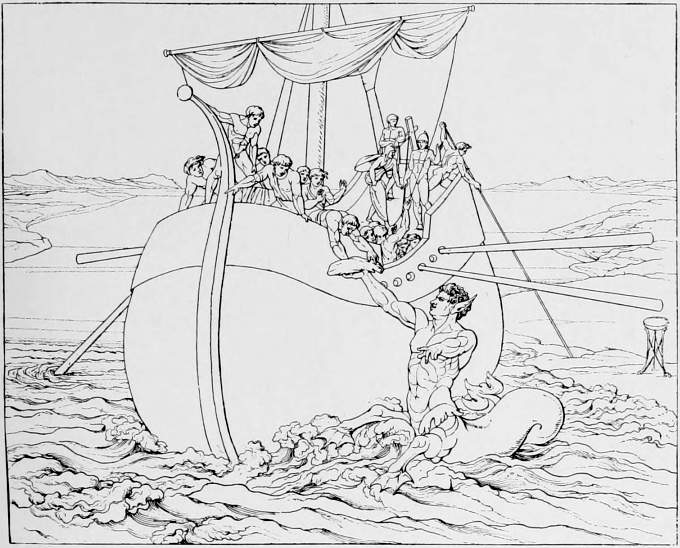 | |
| CARSTENS. | ARGO LEAVING THE TRITON’S MERE. |
Thus he reached, as Fernow says, the method whereby he “did not tread the ordinary way of imitation, gradually progressing to a special invention, but began at once with invention.” There he was the true child of his age. At a period whose creative power found its highest expression in philosophy and poetry, the painter strove for the reputation only of being the poet of his pictures. And Carstens encountered the old tragedians and philosophic writers with a fine, poetic understanding. “The Greek Heroes with Cheiron,” “Helen at the Skæan Gate,” “Ajax,” “Phœnix and Odysseus in the Tent of Achilles,” “Priam and Achilles,” “The Fates,” “Night with her Children,” “Sleep and Death,” “The passage of Megapenthes,” “Homer before the People,” “The Golden Age”—all these prints have really something of the noble simplicity and quiet harmony of Greek art.
 | |
| CARSTENS. | CHILDREN OF THE NIGHT. |
It can be understood, then, that such subjects should be in the highest degree interesting to an archæologist. When Carstens, in April 1795, was organising the famous exhibition of his collected works in Rome, Fernow published in Wieland’s Deutscher Merkur a discourse in which he celebrated him as the creator of a new epoch. From the very first, however, an equally resolute opposition was excited in artistic circles. The painter Müller, nicknamed “The Devil’s Miller,” who at that time wandered about Rome as a cicerone, proves that Winckelmann’s principles, even at the threshold of the century, by no means met with universal acceptance. The Writing of Herr Müller, Painter in Rome, upon the Exhibition of Herr Professor Carstens, with the motto Amicus Plato, Amicus Socrates, magis amica veritas, was published in 1797 in Schiller’s Horæ. Carstens imitated; he worked rather by reminiscence and understanding than by fantasy. Isolated figures do not bring their individuality to an expression. Then he pointed out the models, discussed the lack of colour, and proved numerous sins of the draughtsman against nature in detail. The artist must ever seek to find characteristic expression; composition comes in the second degree. Technique, even if the previous age has been an epoch of fabrication, must always stand in the foreground; it is not only from the artist, but from the connoisseur, that knowledge is demanded, and in consequence of this exhibition Carstens is recommended to forbear from his fantastical geniality, observe nature, and achieve a picture exactly, since it is only from nature that the ideal springs, and consequently 93 nothing can be great and beautiful in the representation which is not right and true. In almost similar words, later on, Koch, in his Thoughts on Painting, and with him the majority of artists, has censured Carstens. And posterity cannot but allow them to be in the right as against the archæologists.
 | |
| CARSTENS. | PRIAM AND ACHILLES. |
Admirable in Carstens is the zeal with which he defended his ideal, the sacred fire which burned within him and sustained him, even during those years when his sickly frame was weakened by consumption. Art was, as he wrote, his element, his religion, his beatitude, his existence. And it is already something great to wear oneself out alone for the sake of an ideal. Carstens was a sublime dreamer. It will not be forgotten of him that, in an age when abundant mediocrity and manufacture were all-prevailing, he once more pointed, unfaltering in his noble and pure intention, to the sublimity of artistic creation. The history of art, however, has not to deal with hearts, but to judge logically by results; and it would not be doing justice to the old masters, nor to those earnest rococo painters who sat at their easels with less noble intentions, but with so much greater knowledge of their craft, if one were to proclaim Carstens, in consideration of the self-sacrifice and renunciation which he showed in the fight for his ideal, as a martyr and a genius, a pioneer of German art. He was not a genius, as he thought himself, and announced so proudly to Heinitz, the Minister; for that he possessed too little originality. It is not imagination, but reminiscence, which created his works. The outlines of his plates are done with fine sentiment, but sentiment 94 taken from the Greeks, and he required no genius to recognise in his recollection and his hand a transcript of Greek forms. What pleases us in Carstens is in substance not Carstens, but an echo of what we like in the Greek statues and vases, in Michael Angelo and other old masters.
 | |
| GENELLI. | THE EMBASSY TO ACHILLES. |
He was not a martyr, because in his struggles he met with assistance and encouragement such as were granted to no old master, and if, in spite of that, he never rose above the cares of life, that is only a proof of the limitations and partiality of his art. He had lost all decorative facility; still more was the inheritance of oil painting first naturally mislaid by him, and by draughtsmanship alone not even Dürer nor Rembrandt could have lived.
This deficiency in technique must even debar him from claiming any higher signification than that of a clever dilettante. He is not an artist who does not in the midst of his exaltation think to put himself in possession of the means which can turn the lispings of genius into a fully intelligible language. Carstens’ plates seduce by a certain wavy treatment of the lines, but no one of them can sustain critical appreciation. It is inconsistent to work in the beautiful and not to become free of ugliness, to move in the great, in the sublime, and at the same time to fall from one defect of form to another, from coarse uncouthness into the most elementary sins against drawing and proportion. Carstens was a draughtsman who could not draw, and, with this limitation of his genius, by no manner of means a founder of German art. One cannot call him a mannerist, because with him art and individuality 95 corresponded; but, nevertheless, like Mengs and Lairesse, he gave art at second-hand, and only differs from them in that with him commences that complete abandonment of the idea of colour which after him disfigured German art. For the future it was quite indifferent that Thorwaldsen took suggestions from Carstens, and Genelli trod in his footprints as a draughtsman.
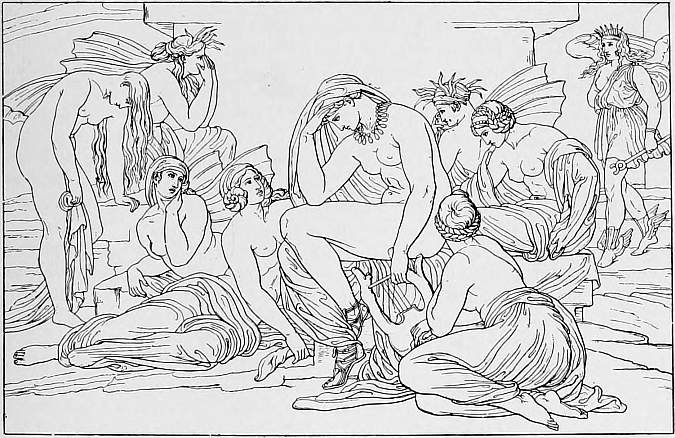 | |
| GENELLI. | THETIS LAMENTING THE FATE OF HECTOR. |
Bonaventura Genelli, if one takes for once the standpoint of the painters of his time, who desired to be the “poets” of their works, is certainly a not unremarkable poet. In him, who was born in the year of Carstens’ death, the spirit of the little Holsteiner was raised to life, and the figure which he assumed in this new incarnation actually made an impression like a picture out of beauty-illuminated days of Hellas. The muscular, thick-set figure of a youthful Hercules, with a broad chest and sturdy neck, a head of short brown curly hair, full lips fringed by the compact beard of a Sophocles, the short Greek nose, grave eyes glancing out from beneath the strong brows—such was Genelli, a Hellene left stranded in Germany, the last Centaur, as Heyse has depicted him in his novel—“an antediluvian, mythological enigma on four sound legs sprung upon our godless world.” Thus he sat, as he himself writes, in Rome, “in his dirty chamber, bare except for a chair or two, rickety or quite broken down, and on the wall a pair of hawks nailed up, whose pinions served as models for his winged figures.” Thus he sat later in his little house in the Sendlingergasse at Munich, and lived in his world of imagination. Perhaps, had he been the child of a more fortunate period in art, he might have become a strong and memorable painter; as a 96 successor of Carstens he has left behind him a legacy of two suites of copper prints—the two tragedies of the “Profligate” and the “Witch.” He existed, moreover, only in contour; he never rose above harmoniously outlined silhouette. It was only to this point that his talent would sustain him. The more he wished to produce shadow, water-colour, or even oil, the more tedious and pale and vague did he become. And even in his drawing he shares with Carstens the desolate generalisation of form, the eternal euphony which so soon becomes wearisome and monotonous. To beauty of line everything is offered up. The blank characterlessness of the faces is even more noticeable with him than with Carstens, who had, after all, in his youth drawn excellent portraits in crayons, and on this account was able to give even to his Greeks more individual traits and a certain variety of expression. With Genelli the heads are treated as no more than parts of the body, and as they gave no opportunity for flowing lines, they have not even the same graciousness as the limbs. His women fared worst, for whilst he could be his own model for his men, he created the ewig Weibliche out of his inner consciousness. In men and women the eyes, in particular, are merely animal.
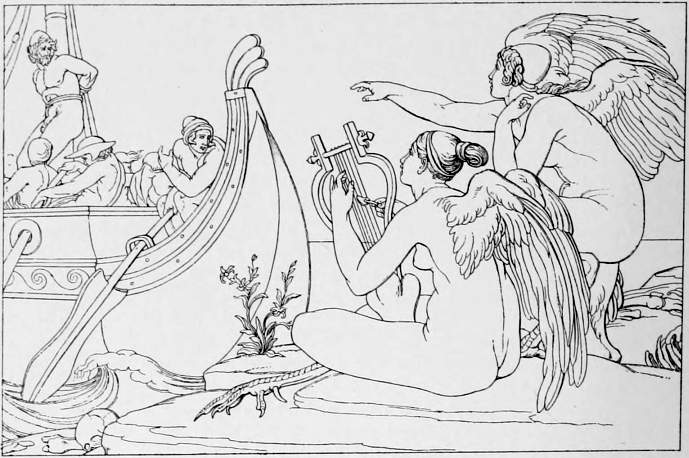 | |
| GENELLI. | ODYSSEUS AND THE SIRENS. |
Carstens’ influence on German art has been then entirely a negative one. It was not on such a foundation that a German art could arise. He prepared no ground for his successors on which they could build further; but through his abandonment of the whole capital which, since Stephen Lochner, had been handed down at compound interest from one generation of painters to another, 97 he rather cut away the ground from under their feet. “For very easily can art go astray, but it is a difficult and lengthy process for her to recover herself.”
The art which was born in that humble studio in Rome to the sickly, neurotic man, the “famous draughtsman,” needed later, in order to become technically healthy again, an impulse replete with life from abroad.
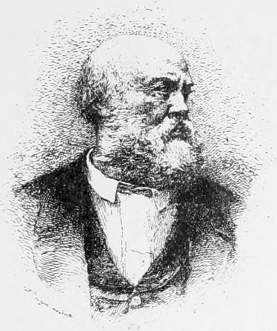 |
| Seemann, Leipzig. |
| BONAVENTURA GENELLI. |

CHAPTER IV
THE CLASSICAL REACTION IN FRANCE
In France also modern art began with a stream of antiquarianism which flowed from the same archæological source. De Brosses published a history of the Roman Republic, and wrote on Herculaneum. Leroy produced his Ruines des plus anciens monuments de la Grèce in 1758. Shortly afterwards the Recueils d’Antiquité of Caylus and Hamilton were published. The former undertook his great journeys, and presented the Academy of Inscriptions with a succession of archæological treatises. He is perhaps the first since Batteux and Coypel who again makes of the modern painter a positive demand for a quiet beauty of lines after the “manière simple et noble du bel antique.” The architects begin to take counsel of Vitruvius, and to work after some model borrowed from the antique. Soufflot rebuilt the Pantheon, and produced the Temple of Pæstum.
Even in 1763 Grimm could write: “For some years past we have been making keen inquiry for antique ornaments and forms. The predilection for them has become so universal that now everything is to be done à la Grecque. The interior and exterior decorations of houses, furniture, dress material, and goldsmiths’ work all bear alike the stamp of the Greeks. The fashion passes from architecture to millinery: our ladies have their hair dressed à la Grecque, our fine gentlemen would think themselves dishonoured if they did not hold in their hands une boîte à la Grecque.” Even Diderot’s preference for the ethical and emotional, as Greuze had painted it—and as Diderot himself had dramatised it—veered round at the commencement of the sixties into an enthusiasm for the antique. After 1761 he carried on in the salons a war of extermination against poor old Boucher, and lectured him in a menacing voice upon the “great and severe taste of antiquity.” He twitted him with possessing neither reality nor taste, and produced in proof the fact that, in the whole catalogue of Boucher’s figures, not four could be found which could be employed in relief, or even as statues. The new taste demanded pure and simple lines, the beauty of sculpture; it went back to the antique. When a French translation of Winckelmann appeared in 1765 he spoke out, on the occasion of a review of the book, clearly and plainly: “Il me semble qu’il faudrait étudier l’antique pour apprendre à voir la nature.” In the same vein Watelet pronounced on Boucher: “Jamais artiste n’a plus ouvertement témoigné son mépris pour la vraie beauté telle qu’elle a été sentie et exprimée par les statuaires 99 de l’ancienne Grèce.” Thus the change in the artistic outlook was heralded long before the curtain went up upon the events of 1789.
Madame Vigée-Lebrun, the French Angelica Kauffmann, possessed of a tender, soft, sympathetic talent, is perhaps the truest representative of this gracious, entirely French transition style, over which like a breath, but only like a breath, hovers the antique. She has in her portraits, in an especially refined manner, fixed that age when noble ladies desired to forget the Marquise and Duchess, to exhibit only the wife and mother, and believed that by unconstraint of attitude in their simple white robe, the scarf thrown modestly over the shoulders, they had effected a return to antique simplicity. Boucher, moved to the depths of his consciousness by Diderot, resolved to paint a picture taken from ancient history. Greuze painted “Severus and Caracalla,” Fragonard “Chœreas and Callirhöe.” Hubert Robert grew more and more archæological, and played in his landscapes with ancient remains and classical ruins. Vien became enthusiastic over antique gems, and thought he must draw the conclusion, from the noble calm of these figures, that the amiable coquetry and capricious garments of rococo were without nobility. His plan was “to study the antique—Raphael, the Caracci, Domenichino, Michael Angelo, and, in one word, all those masters whose works convey the character of truth and grandeur.”
But what gave far other significance to the French classicism of the ensuing period was that great event in the world’s history, of which France became the theatre at the close of the eighteenth century. In the secluded gardens of Versailles, where the goat-footed Pan embraced the tall, white nymphs by an artificial water-fall, the noble lords and ladies, clad as Pierrots and Columbines, overheard in the midst of their whispered flirtations the menacing earthquake which was announced in thunder from Paris. Soon they beheld the earth crack and burst asunder, as that time came when the air was filled with the smoke of powder, when the first notes of the Marseillaise rang out, and in the Place de la Concorde, where to-day the loveliest fountains in the world are playing, blood ran from a dozen guillotines. That “après nous le deluge” of the Marquise de Pompadour had become a dire, prophetic truth, and in that flood of blood and horrors the artistic ideal of the eighteenth century was also washed away. The Revolution gave the death-blow to rococo. At one stroke it overthrew the most pleasant of all French periods, the truest presentiment of French grace and esprit, the noble and amiable art of Louis XV, which the melancholy, life-emitting Watteau, Boucher, and Fragonard cause to hover before us as in the clouds of a dream. Classicism, however, attained through it a new and stronger basis, a certain connection with modern life, since it was transposed by it from the Museum of Antiquity into the middle of the Place de la Concorde beneath the guillotine.
What the age of the Revolution demanded of art was at all events not a “noble style,” as Vien had required of it, but rather in the first place a Spartan virtue. Various philosophical writers had drawn a parallel between the organisation of the old and the modern state; they had exerted themselves 100 to show that the old Republics were models of an almost absolute perfection, which the modern should, in so far as it was possible, imitate. They had contrasted the moral conditions of Sparta and the Roman Republic with the moral constitution of contemporary, monarchical France. They had quoted on every opportunity the acts of virtue, renunciation, courage, and patriotic sacrifice of the great men of antiquity; they had used these deeds as a means of proving their thesis, and their ideas aroused deep echoes in men’s hearts.
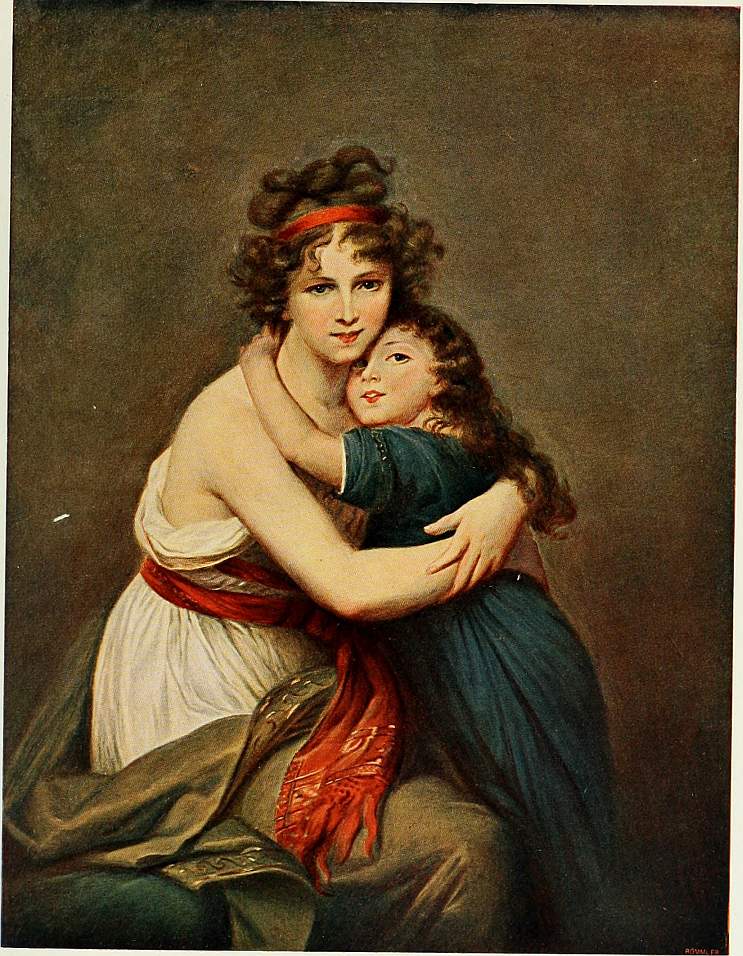 | |
| ELISABETH VIGÉE-LEBRUN. | PORTRAIT OF THE PAINTER WITH HER DAUGHTER. |
The sentiment of Rome had entered into the people as a thing of flesh and blood even before the catastrophe had ensued. “We were more prepared,” wrote Nodier, “for the particular tone of the language of the Revolution than people would have believed, and it cost us little pains to pass from the studies of our gymnases to the strife of the forum. In the schools we had prize compositions set of this kind: Who stands higher, the elder Brutus who judged his children, or the younger Brutus who judged his father? And so Livy and Tacitus have done more to overthrow the monarchical system than Voltaire and Rousseau.” It was evident then that France, so soon as she had freed herself from her kings, so soon as she had spoken the word “Republic,” must take the Roman Republic as her pattern. People lived in an atmosphere of antiquity; the great citizens of Rome and Athens were ranged with the French National Convention; Scævola, Scipio, Cato, Cincinnatus, were the idols of the populace. The speakers in the council cited the ancients in preference; Madame Vigée-Lebrun gave soupers à la Grecque. “Everything was ordered according to the Voyage d’Anacharsis—garments, viands, amusements, and the table, all were Athenian. Madame Lebrun herself was Aspasia; M. l’Abbé Barthélémy, in a Greek dress with a laurel wreath on his head, recited a poem; M. de Cabierès played the golden lyre as Memnon, and young boys waited at table as slaves. The table itself was set entirely with Greek utensils, and all the viands were actually those of ancient Greece.” Children were given Greek and Roman names. People called themselves “Romans.” “Mais, je l’aimais, Romains!” cried Coulon at the death of Mirabeau. Paris is Rome. In the theatre the bust of Brutus is set opposite that of Voltaire, and the actor says: “O buste réveré de Brutus, d’un grand homme, transporté dans Paris tu n’as point quitté Rome.” And as with the bust of Brutus in the theatre, that of Mucius Scævola appears in the cafés, which Parisian journalists, still full of remembrances of ancient history studied in the gymnasium, liken to the Lyceum and the Porch. In every case ancient Rome is set up as the exemplar. The Parisian collection of engravings on copper possesses a reproduction of the guillotine, with the inscription: A similar machine was used for the execution of the Roman, Titus Manlius. A valet committed suicide, and quoted the illustrious example of Seneca. Had it been possible, people would have gladly thrown themselves back eighteen hundred years into the past, with all its grandeur, its simplicity, and its ruthlessness. Political and social forms did not suffice; even the implements and costume of the ancients were again brought into honour. Furniture put on antiquarian shapes; the 101 walls were decorated à la Grecque. The lively frivolity of rococo, with its freaks and fancies, was no longer adapted to the boudoir of the age of revolution, now transformed into the political council-room. Twists and curves were no longer permitted: everything had to be straightforward, logical, ungenerous, inexorable. Men went clad wretchedly, with red Phrygian caps and no breeches. Women and girls cast aside their ordinary attire and put on straight, falling drapery, discarded their heeled shoes and bound sandals round their feet, shook the powder from their locks and tied their hair in a Greek knot. “Dressed in white raiment without adornment, but decked in the virtue of simplicity,” they appeared in the cabinet of the president, in order to surrender their jewels for the salvation of their country, like those Roman matrons in the time of Camillus.
And, in co-operation with the building up of this new world, painting also advanced. It was only when it assisted to arouse civic virtue, it was said at a sitting of the jury at the Salon of 1793, that painting could possess a right to exist in the new state, and as the handmaid of this patriotism might fulfil an even higher mission than it had done in ancient Greece and Rome. “The Greeks and Romans were indeed only slaves, but we French are by nature free, philosophers in character, virtuous in our every perception, and artists through our taste.” In proportion as the French Republic transcended the old free states, so too must French art take the lead of the antique. “All that stimulated art in Greece, the gymnastic exercises, the public games, the national festivals, is also accessible to the French, who possess above all that which the Greeks lacked, the feeling for true liberty. To depict the history of a free people is indeed quite another mission for the true genius than to embody scenes out of mythology.”
Through this fresh nuance, which classicism thus acquired, the ground was cut from under the feet of those who devoted themselves to the study of the antique as conceived by Diderot. The new moral age would have no traffic with those artists in whom the last smile of the eighteenth century was personified. Their pictures, full of grace and caprice, fell into the same disrepute into which everything of yesterday had come, and it was only with a bitter smile that they followed the course of events. The younger Moreau, that animated master of rococo, became academically cold and tedious when he designed his book on the French costume of the Revolution. The good Fragonard, who was only fifty-nine in 1789, and lived till 1806, saw himself hooted in spite of his “Chœreas.” He, the true representative of frivolous tenderness, of fair and roseate hues, had lost every right to exist in the new world, and ended his life by a sad death when, after the Reign of Terror, there was no longer a place for fêtes galantes. A delightful portrait of himself, which he painted in the first period of the Revolution, shows us an old man, clothed entirely in black, softly melancholy, standing in a formal, dusky-brown salon. On the table on which his arm rests lies a guitar, at his feet a portfolio of engravings; but he neither plays the guitar nor looks at the prints. In the 102 shadows of the falling evening he reminds himself forlornly of past days, and his bald forehead, where so many rose-coloured dreams have passed, is overcast with gloomy shadows.
Greuze, too, outlived himself. It was no use for him to pretend more and more to the utmost virtue, and to paint an “Ariadne at Naxos.” He died in misery and oblivion in 1805. The demands which this new classicism made were able to be satisfied by no one any longer, not even by Vien. However loudly he might proclaim himself a student of the Greeks, he, nevertheless, remained a very timid and lukewarm revolutionary. An old man, cold and peaceful and stolid, moderate in everything, he had neither the energy nor the audacity of the reformer. He had been the Court painter of Louis XVI, a most monarchically disposed and loyal man, and was a suspect on this ground alone to those who were in power in 1789. His pictures, too, describe no more than the end of a world. Greuze, Fragonard, and Vien, in spite of their assumed seriousness, survived only as gallant phantoms in the new age, by the side of those men of more rugged countenance who inaugurated the nineteenth century.
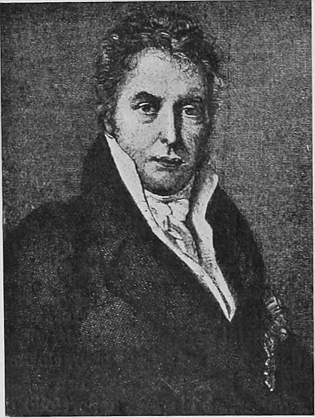 |
| JACQUES LOUIS DAVID. L’Art. |
Jacques Louis David first satisfied the new requirements, and in so doing lent to French classicism, if only for a few years, a certain touch of far greater vivacity. He it was who carried through, in all its consequence, that reformation in taste which Vien had sought in externals, in costume, furniture and decoration; who inspired the gems painted by Vien with republican pathos, and became in this way the great herald of that age which read Plutarch and made Paris into a modern Sparta. David, Prix de Rome after three successive failures, still came from that “corrupt epoch” against which Republican prudery was so excited. At the age of twenty-six he had already painted Soffits, in the manner of his kinsman “Boucher, to say it with respect.” But the journey to Rome converted Saul into Paul. In 1775 Vien, on his appointment as director of the Roman Academy, had taken him to Italy as his best pupil, and hardly dreamt at that time that this young man would strike out on such an entirely new path from his Roman studies. He did not wait for the Revolution to be converted; when the hour struck he was ready. Thus his first pictures were in a manner the prelude to the Revolution. In them he had already quite consciously entered upon the road along which 103 he was to go later. His “Oath of the Horatii” and his “Brutus,” both painted in Rome in 1784, proclaimed his programme. The little, rosy loves, the doves of Venus, and all the charming frivolity and gallantry of rococo, received their final dismissal, and rough men walked in their stead. He broke his staff over all that he had previously venerated, and declared loudly that he had sinned when in his youth he had believed in the flowery palette of rococo, and completed in tender tones those ceiling frescoes which Fragonard had commenced in the house of Mdlle. Guimard. Capricious frivolities had to make way for a manlier art, matter “that was worthy to rivet the gaze of a free nation upon itself.” Already, long before the taking of the Bastille, the painting of young David was valued by the rising generation as the artistic embodiment of their political ideas, imbibed while they were still at school. When the “Horatii” was completed it was not only old Pompeo Battoni who exclaimed, when he saw the picture in David’s Roman studio, “Tu ed io soli siamo pittori, pel rimanente si puo gettarlo nel fiume.” In Paris his success was universal; all the critics were unanimous in praise; David was the man after the heart of the age, for his picture was the first which spoke clearly and perceptibly of the pathos of the revolution which stood at the threshold. People saw in it an “example of patriotism which knew no obstacles,” since not even love for their sister, who was betrothed to the enemy, prevailed upon the Horatii to refrain from combat with the Curiati. His next picture, “Brutus” as he received 104 the lictors, when they bring him the bodies of his sons who have been implicated in a monarchical conspiracy, was greeted as allegorical of the incorruptible justice of republicanism. The populace saw in it the “glorification of the chastisement of all traitors to liberty,” and acclaimed David because he “had founded the sinewy style which should characterise the heroic deeds of the revolutionaries, children of liberty, equality, and fraternity.” And one understands—when one also adds the influence of Napoleon—this reaction of military simplicity against the effeminacy of rococo.
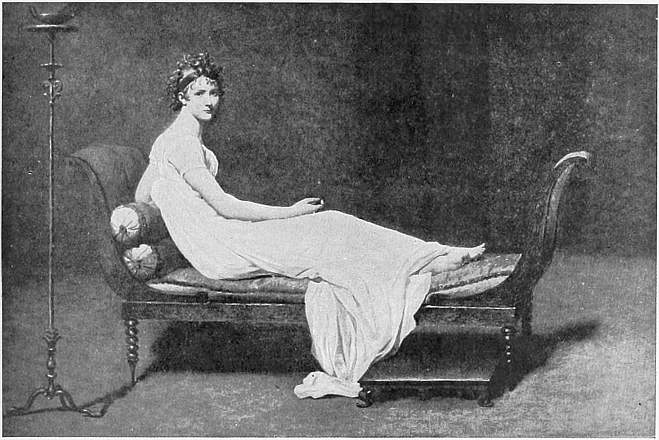 | |
| DAVID. | MADAME RÉCAMIER. |
David, at the outbreak of the Revolution, no longer a young man, but forty years old, was the terrible painter of the age, its despotic dictator. As a deputy in the Convention he not only ruled over painting, but also imposed his taste upon sculpture, ivory work, goldsmiths’ work, and decoration. He designed the new costumes for the deputies and ministers. As organiser of public fêtes, he brought to life again the whole of republican Rome. He was one of those rare artists who are the men of their hour. To a new plebeian race, to whose feverishly excited patriotism the soft, luxurious, aristocratically reprehensible art of rococo must seem as a mockery of all the rights of men, he showed, for the first time, the man, the hero who died for an idea or for his country; and he gave this man huge and elastic muscles, like those of a gladiator who struggles in the arena. He was a second Hercules, cleansing the Augæan stables; with his own strong shoulders he thrust back the petulant band of painters who had tarried too long in the island of Cythera. He applied art to the heroism of the day, gave it the martial attitude of patriotism, inspired it with the spirit of Robespierre, St. Just, and Danton. The more obtrusively his heroes paraded their patriotism, the more people saw in them a picture of the French nation, as true as a transposition could hope to be. This strained rhetorical pathos dwelt in the mind of the age. Talma moved the people to enthusiasm when he played the “Horatii” of Corneille in the classic cothurnus. When David painted, the state declamations of the orators still rang in his ears. Robespierre is said to have spoken from the tribune slowly, rhythmically, artistically: a Bossuet in his rostrum, a Boileau in his chair, while the volcano quivered beneath his very feet: his philippics were carefully divided into three sections, like academic discourses: his patriotism resolved itself into tirades with correctly composed periods. In David’s pictures we have an exact correspondence with all this: the rigid classicality of his composition, figures grouped as though on parade; his cold pathos, the counterpart to that of the orators’ fine sentiments set forth in fine phrases.
The great distinction between the beginning of modern art in Germany and in France is that in France the new style was not only called forth by the influence of a scientific programme from outside, but stood in conjunction with a great transformation in culture, and that it was compelled at first to concern itself not only with imitation and philological retrospect, 105 but with the free expression of the characteristically modern spirit. German art had no new pronouncement to make through the medium of the antique; it followed, on the other hand, the programme of an artistically barren scholar who forgot that archæology is not art, recommended imitation as the path to perfection, and perpetually reminded the artists who followed him how widely they deviated from the correct lines of the model. “Afterwards they rebuke it, and say it is not antique and consequently not good art,” as Albrecht Dürer had complained of such people. In the earnest sentiment, the exalted Roman spirit, the declaiming over rugged, masculine virtues, freedom and patriotism, that found expression in David’s first pictures, there lived something of the Catonian spirit of the Terror; and that still gives them historical value. His enthusiasm was not, first and foremost, for antique art, but for the ideas of country, duty, freedom, progress. The words antiquity and democracy were of like meaning to him.
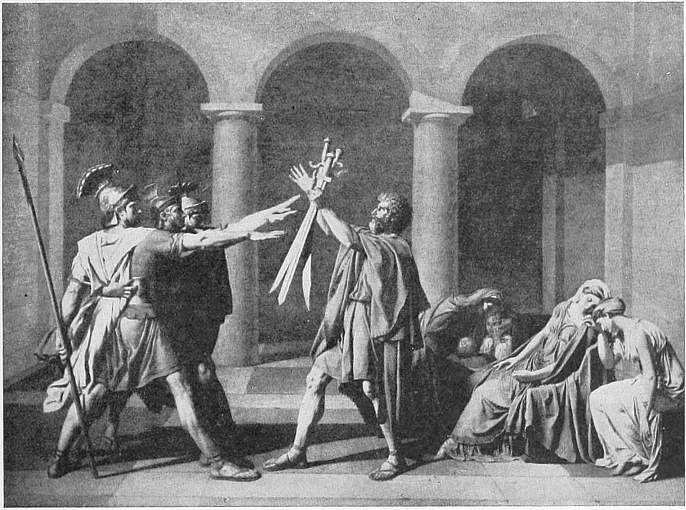 | |
| DAVID. | THE OATH OF THE HORATII. |
And how thoroughly this man was permeated with the spirit of his age is shown still more when he discarded the cothurnus, boldly attacked the present, and gave himself up entirely to the delineation of what came under his direct observation in his own life and experience. There he became not only a rhetorician, a revolutionary agitator, but a really great painter. Lepelletier on his 106 death-bed, the assassinated Marat, and the dead Barre, are works of a mighty naturalist. Lepelletier, one of the many deputies who had voted for the death of Louis XVI, was treacherously assassinated in Paris, on 20th January 1793, by a valet of the king’s. The body was publicly exhibited; David painted it, and on 29th March presented the picture to the Convention. As the portrait of the “first Martyr of Liberty,” it was hung in the Convention chamber. On 13th July 1793 Marat, the man-of-terror, fell a victim to the knife of Charlotte Corday. David was presiding at the Jacobin Club when the news was brought him, and he embraced the citizen who had arrested the girl. Deputations of the people appeared in the Convention to express their grief for the heavy loss. Suddenly a voice was heard to cry: “Où es tu, David? Tu as transmis à la posterité l’image de Lepelletier mourant pour la patrie, il te reste encore un tableau à faire.” Silence succeeded in the Assembly. Then David started up: “Je le ferai.” On 11th October he informed the Convention that his “Marat” was finished. “The people asked for their murdered man back again, longed to look once more on the features of their truest friend. They cried to me: ‘David, take up your brush, avenge Marat, so that the enemy may blanch when they perceive the distorted countenance of the man who became the victim of his love for freedom.’ I heard the voice of the people, and obeyed.” Thus David spoke in the Assembly when he presented the Republic with the picture of the murdered man—one of the most thrilling representations of that awful age. The body is lying in the bath. Only the naked upper part of the body, and the head, with a dirty cloth tied round it, and fallen back upon the right shoulder, are visible; one hand, resting back on the side of the bath, still holds a paper in a convulsive grip; the other hangs down limp and dead to the ground. Over this head, with the half-closed eyelids, and the mouth distorted from the death-throes, Caravaggio would have rejoiced, there is such keen naturalism in every stroke of the brush. Like Géricault, in later times, David was then a regular visitor at the Morgue, attended at executions, and took an interest in the convulsive muscular movements of the guillotined. And the colour, too, like the drawing, is of a naturalistic strength to which he never again attained. The light falls slantingly on the corpse from above and throws the head, shoulder, and one arm into strong relief, while all the rest is left in obscurity. In this awful still-life of uncompromising reality and tragical grandeur he has created a work in the midst of an age of storm which will survive all storms and all changes of taste.
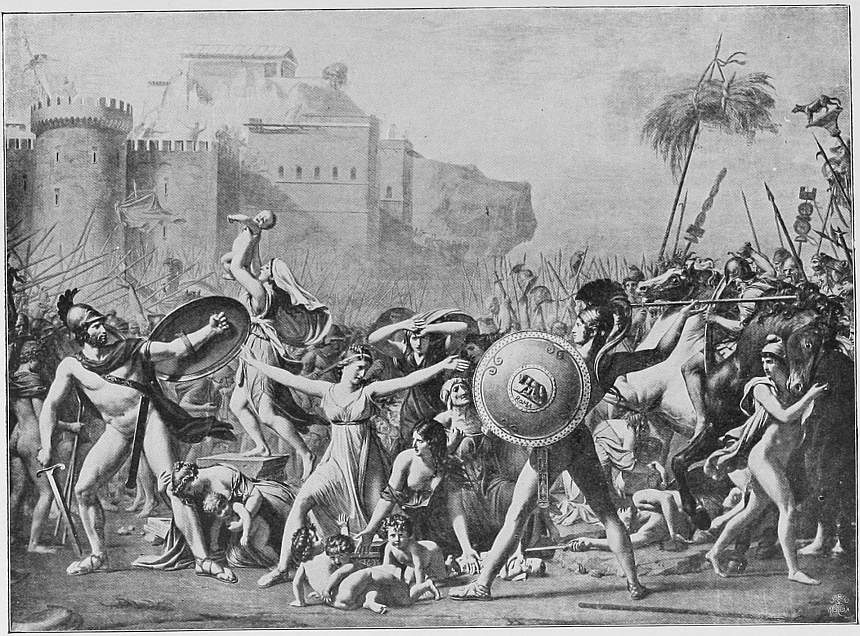 | |
| Seemann, Leipzig. | |
| DAVID. | THE RAPE OF THE SABINES. |
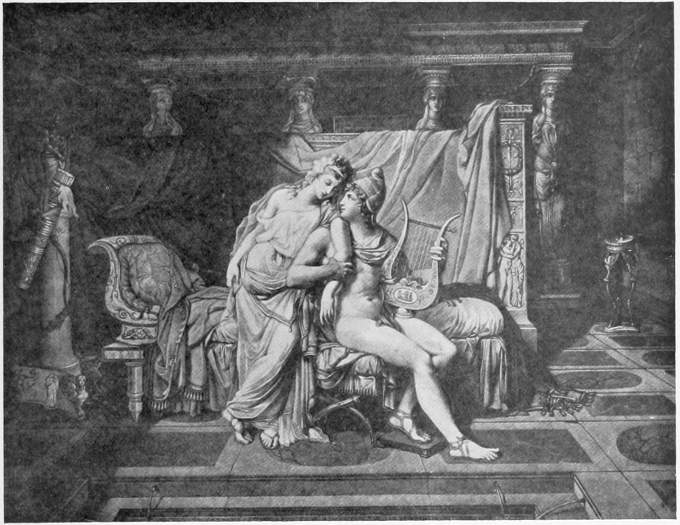 | |
| DAVID. | HELEN AND PARIS. |
His portraits have no less strikingly survived the fiery ordeal of time. In them, too, he is neither rhetorical nor cold, but full of fire and the freshness of youth. Face to face with his model, he forgot the Greeks and Romans, saw life alone, was rejuvenated in the youth-giving fount of nature, and painted—almost alone of the painters of his generation—the truth. Here his effect, when otherwise he was lacking in all naïveté, is actually naïve and intimate. The best painters have never treated flesh better. He had an aversion to palette tones, and sought after nature with unexampled attention. The fine pearl-grey of his colouring is as delicate as it is distinguished; in his portraits, especially, the relief-tones of blue and light rose seem almost to anticipate the delicate, toned-down tints of modern Impressionism. Himself an ardent Revolutionist, he was, as it were, created to be the portrayer of those men of an austerity like Cato’s, and those women with their free, masculine, proud gaze; that valiant generation that felt within itself a desire to begin civilisation again and found religion anew. The portrait of Lavoisier and his wife reminds one in its refinement of Madame Vigée-Lebrun. The chemist is sitting by a table covered with instruments; his wife, in an elegant light gown, bends attentively over him. The picture dates from 1788, and it still looks like some good work of the age of Louis XVI. Again, how intimate is the effect of the marvellous portrait of Michael Gérard and his family. The good man, in his shirt-sleeves, seems to feel really at home; a small boy is leaning against his knee, a girl is playing on the clavicorde. There is not the slightest suggestion of pose or a conventional type of beauty in this stout old gentleman sitting so comfortably in his bourgeois négligé, and with honest eyes gazing out so inquisitively round him. In a few other pictures the spiritual life of women is portrayed with remarkable tenderness. One of the earliest 110 is the exceptionally fine portrait of his mother-in-law, Madame Pécoult, in 1783; then, in 1790, the portrait of the Marquise d’Orvilliers, with that expression of dreamy languor which plays round the eyes of the beautiful woman. The Louvre possesses, in the portrait of Madame Récamier, perhaps the most charming and attractive woman’s portrait that David ever painted. The beautiful Juliette lies stretched on a divan of antique pattern. She wears a white dress, her soft rosy feet are bare. The arrangement of the room coquettes primly with that simplicity which was paraded at the time. Apart from the divan, there is only a huge bronze candelabra to be seen. Then there is Barere’s portrait. He stands on the tribune, and delivers the speech which is to cost Louis XVI his life. The face is small and insignificant, the gaze cold and harsh, and on the mouth there is a shadow of bitter hate and narrow fanaticism. But the triumph of these portraits of men is that of Bonaparte. David was one of the first of the men of the Revolution to come beneath the spell of the Little Corporal. One day, while he was working in his studio at the Louvre, a pupil rushed in breathlessly: “General Bonaparte is outside the door!” Napoleon entered in a dark-blue coat “that made his lean yellow face look leaner and yellower than ever.” David dismissed his pupils, and drew, in a sitting of barely two hours, the stern head of the Corsican. Thus he passed into the service of Napoleon.
This man, who viewed himself only as the coping-stone of the Republic—after the example of Augustus when he transformed the Roman Republic into the Empire—was unwilling to show any opposition to the republican tastes. The first painter of the Republic was appointed to be the Imperial Court painter. What he had been under Robespierre he was under Napoleon: the dictator of his age, who maintained a supremacy over the whole of art similar to that which Lebrun held beneath Louis XIV. The “Marat” was the great work of his revolutionary, the “Coronation” of his monarchical period,—that colossal picture which, completed between 1806 and 1807, has handed down to posterity a true representation of the ceremonial pageants that took place in Notre Dame on 2nd December 1804. The moment selected is when Napoleon places the crown, which is carried on a velvet cushion by the Duc de Berg, upon the head of the Empress, who kneels before him in a white robe and a crimson mantle. The picture contains portraits of all the personages present at the ceremony, amongst them being David himself, as he stands on a platform and sketches at a small table. The whole composition of this picture and the grouping of the figures is full of stately gravity. Real energy and patience must have been required to paint this immense picture, though it shows not the least sign of fatigue. With the exception of Menzel’s “Coronation of William I,” I know of no historical picture of the century of as high an artistic value, with the like noble sublimity of colour, with so tender, quivering a light. There are certain portions of the “Coronation” in which the white robes, the deep-red velvet of the mantles, and gold embroideries affect us like a symphony in colours. When the picture was completed Napoleon 111 visited David’s studio, accompanied by the Empress, his ministers, and his staff. The Court drew up, and the Emperor moved up and down in front of the picture, hat in hand, for more than half an hour, examining it in all its details. Finally, with one of those dramatic effects of which he was so fond, he lightly raised his hat: “C’est bien, très bien; David, je vous salue.”
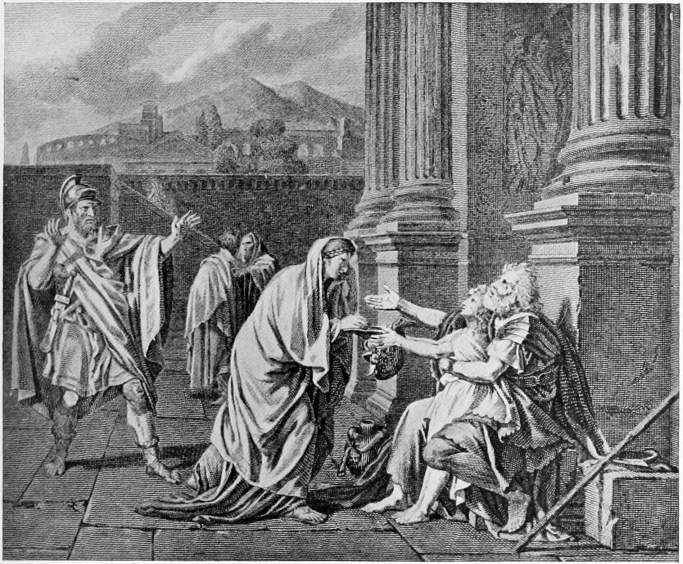 | |
| DAVID. | BELISARIUS ASKING ALMS. |
David had now still better opportunities than at an earlier period of proving his great capacity as a portrait painter. His portraits of the Emperor, of the Pope, of Cardinal Caprara, and of Murat symbolise the brutal greatness of an age which worshipped strength. Even at the close of his life, when the Restoration had exiled him from France, there resulted in Brussels graceful and tenderly observed portraits, such as that of the daughter of Joseph Bonaparte, which will perpetuate his name. One, in the Praet Collection at Brussels—three women of indescribable ugliness—marks the pinnacle of his pictorial strength and keen naturalism. They are the “Three Fates” of 1810, and he has painted them with the true artist’s delight, and with a massiveness like that of Frans Hals.
When these works were brought together at the Paris Exhibition of 1889, 112 universal astonishment prevailed when it was discovered what a great painter this Louis David was. He appeared in these pictures as an artist who stood completely within his age, who shared its passions and was permeated by its greatness; he even appeared as a charmeur who handled the phenomena of colour and light as few others have done. It is true, David showed himself in this favourable light at the exhibition only because the entirely archæological side of his talent was not represented. For at the bottom of his heart he too was an archæologist. Many of his works, such as “The Death of Socrates,” “Brutus,” “The Oath in the Tennis Court,” and “The Rape of the Sabines,” are specimens of a barren theory.
Against all the caprice of the eighteenth century, with its charming, alluring grace, he opposed a strict, inexorable system, as he believed he saw it in the antique. Simplicity, however, beneath his hands became dryness, nobility formal. He saw in painting a sort of abstract geometry for which there existed hard-and-fast forms. There was something mathematical in his effort after dry correctness and erudite accuracy. The infinite variety of life with its eternal changes was hidden from his sight. The beautiful, he taught with Winckelmann, does not exist in a single individual; it is only possible to create a type of it by comparison and through composition. The human being of art ought always to be a copy of that perfect being, primitive man, whom the Roman sculptors had still before their eyes, but who had deteriorated in the course of ages. Thus in France, too, the sensuous art of painting was converted into an abstract science of æsthetics. The classic ideal weighed upon French art and prescribed for all alike the same “heroic style,” the same elevation, the same marble coldness and monotony of colour. Jean-Baptiste Regnault, and François André Vincent, whose studios were most frequented after David’s, worshipped the same gods. After David’s departure, Guérin, in particular, endeavoured to bequeath to the students those genuinely academic rules which his pupil, Delacroix, has summed up in these words: “In order to make an ideal head of a negro, our teachers make him resemble as far as possible the profile of Antinous, and then say, ‘We have done our utmost; if he is, nevertheless, not beautiful, we must altogether abstain from this freak of nature, with his squat nose and thick lips, so unendurable to the eyes.’” When he had to paint his “Insurrection in Cairo,” therefore, Egyptians as well as Arabs must first be supplied with heads of Antinous and transformed from modern soldiers into ancient warriors, Romans of the time of Romulus, before they could enter into the kingdom of art. Everything was sacrificed to line,—an inflexible, inexorable, correct, and icy line, the conventional, ideal line,—not the true line which follows from observation of the infinite variety of nature.
Nevertheless, even in works constructed as these were by rule and line, we cannot fail to be impressed by the technical ability displayed by the artist.
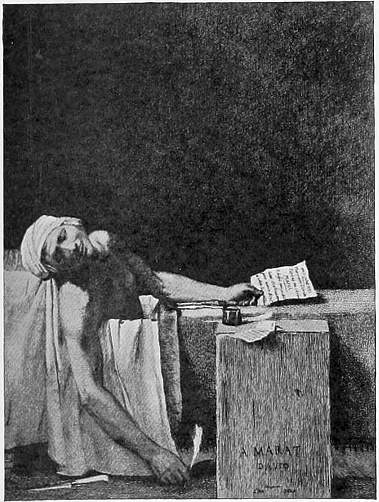 |
| Baschet. |
| DAVID. THE DEATH OF MARAT. |
France, who in her outward relations has generally had a feverish longing for change, has been in literary and artistic respects, as a rule, exceedingly 113 conservative, has upheld authority, supported an academy, and prized limitations and proportion above everything. They had upset the monarchy, murdered the hated aristocrats, built up the republic, done away with Christianity before they ever thought of touching the three unities of the drama. Voltaire, who had a reverence for nothing in heaven or earth, respected the received treatment of the Alexandrine verse. And David, the great painter of the Revolution, who cast the pictures of Boucher out of the Louvre, and whose pupils used to shoot bread-crumbs at Watteau’s masterpiece, the “Voyage à Cythère,” yet conveyed with him into the new age, as an inheritance from rococo, its prodigious knowledge. The good old traditions of the technique of French painting were little shaken by him and his school. The Academy described by Quatremère as the “eternal nursery garden of incurable prejudices,” was indeed overthrown, but David became immediately the head of a new one. This age of absorption in politics developed an art to correspond, more disciplined than ever, girt round by an iron cuirass; and this art, notwithstanding multifarious phases, at no time lost its touch, technically, with the acquisitions of former epochs, but evolved itself in its various directions from one centre, distracted from its path by nothing brought into it from outside. Géricault, Delacroix, Courbet, and Manet, widely as they differ from one another, are links in one chain of evolution. Art comes from knowledge. This maxim, which David held in honour, has remained to the present day a dominant force in French art, and by virtue of this knowledge, which David received from the old masters and guarded as a sacred trust, France became in the nineteenth century the chief school of technique for all other nations. From the French the other nations learned their grammar and syntax; through them they acquired a wider horizon and a deeper insight into the great mystery of nature.
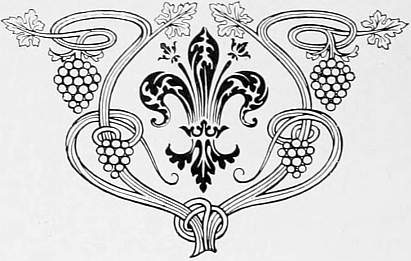
BOOK II
THE ESCAPE INTO THE PAST

CHAPTER V
THE NAZARENES
Herein lies the great difference between France and Germany. Although following along new lines, the art of France did not thereby suffer as regards the quality of its execution; in spite of all Classicism it remained the disciplined art of the schools. These favourable preliminaries were lacking in Germany. It was not allotted to German painting to grow up in naïve contentment with the technical inheritance of its forefathers, but, on the contrary, at the entrance of its new career it broke so completely with its predecessor—the art of the eighteenth century—that it could no longer adopt even its technical traditions. It arose out of the negation of earlier art, an absolute negation such as the world had never seen before. It began with a self-made man who had never acquired the charter of craftsmanship, who never learnt to paint. In France, revolutionary pictures inspired with intense pathos, and frankly naturalistic portraits of masterly technique; with Carstens, outlines showing refined feeling, but faulty very generally in execution, sketches drawn roughly with the pencil, crayon, or red chalk.
It had taken many generations of painters, whose lives had been spent in careful devotion to the work, to collect the technical capital which Carstens so carelessly flung to the winds.
The next step along this way was taken by the Nazarenes.
Just as it was inevitable that cold and lifeless Classicism should follow the brightness and animation of rococo, so it was necessary, according to the law of extremes which alternate in every evolution of culture, that, next to the antique, should come its exact opposite, the Gothic or Middle Ages. The antique was so monotonous that people longed for variety of colour again; it was so cold and statuesque that they longed for something soulful, so Greek and pagan and severe that they hankered again after something Christian, would believe again like children.
Even in the young days of the old pagan, Goethe, religion formed the favourite topic of the beaux esprits, and in the same year, 1797, that Carstens died, this cult of the emotional life found, for the first time, expression in literature. In every library one finds a dainty, finely printed book in small octavo, without the author’s name, with the title Herzensergiessungen eines Kunstliebenden Klosterbruders, and with a sort of head of Raphael as a frontispiece, 118 in which, with his prominent eyes, full lips, and long neck, he looks like some intellectual, Christ-inspired, consumptive enthusiast. It is the pale, gentle face of Wackenroder.
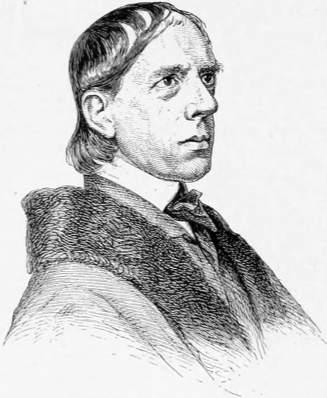 |
| FREDERICK OVERBECK. |
First Winckelmann, then Wackenroder. In the very personalities of these two the whole opposition between Classicism and the Nazarenes is reflected. A student barely twenty years old, a mild, modest, contemplative soul, who had attached himself from early youth with womanly devotion to his more energetic friend Tieck, and written letters to him that read like a young girl’s effusions to her sweetheart, he entered the Erlanger University with his friend at the Easter of 1793. They saw Nuremberg. More than once they made pilgrimages to the old fashioned town, the treasury of German art; and the spirit of the past powerfully inspired them. Whilst for Lessing and Winckelmann “Gothic” art only meant barbarian art, the wonders of Nuremberg were now observed with fresh eyes. In a sort of intoxication of art the friends wandered through churches, stood by the graves of Albrecht Dürer and Peter Vischer, and a vanished world rose before them. The spires and turrets behind falling walls and ramparts, the old, stately, patrician houses, which jutted out their oriel windows, as it were with curiosity, into the crooked streets, were peopled to their imagination with picturesque figures in bonnet and hose from that great time when Nuremberg was “the living, swarming school of native art,” when “an exuberant, artistic spirit” governed within its walls, when Master Hans Sachs and Adam Kraft and Peter Vischer and Albrecht Dürer and Willibald Pirkheymer were alive. Shortly after that they came to Dresden, and devoted themselves in the gallery there to an enthusiastic cult of the Madonna. The Herzensergiessungen eines Kunstliebenden Klosterbruders, which appeared a year before Wackenroder’s death in his twenty-sixth year, was the result of these wanderings and studies. In this tender production of a visionary youth the spirit of Romantic art found expression.
Winckelmann was an archæologist; Wackenroder, an enthusiast of the Middle Ages; on the one side knowledge only, on the other all feeling; for the one, paganism, for the other, Christ. For it is from the first a leading principle of the “Klosterbruder,” that “the finest stream of life only issues from the streams of art and religion when they flow in company.” He valued the older 119 painters “because they had made painting the true handmaid of religion”; art was to him an object of devotion. Picture galleries, he says, ought to be temples; he would liken the enjoyment of works of art to prayer; let it be a holy feast day to him if he go with a serious and composed mind to their observance; indeed, reverence for art and reverence for God were so closely interwoven that he was fain to kneel down before art, and offer it the homage of an “eternal and boundless love.” This devotion to art, of which he himself was full, he found nowhere in his times. The age of enlightenment was to him an undevout and inartistic age. Only in his wanderings through the uneven streets of Nuremberg did the deepest yearning of his soul seem satisfied. He applied himself to mediæval, and especially to German art. His standpoint is the same which the young Goethe had adopted when he intervened with Herder for “German style and art,” and dedicated his pamphlet on German architecture to the shade of Erwin von Steinbach. He is reluctant that one should condemn the Middle Ages because they did not build such temples as the Greeks, any more than that one should condemn the Indians because they spoke their language and not our own. “It is not only beneath Italian skies, under majestic domes and Corinthian columns, that true art thrives, it lives too under pointed arches, intricately decorated buildings, and Gothic spires.”
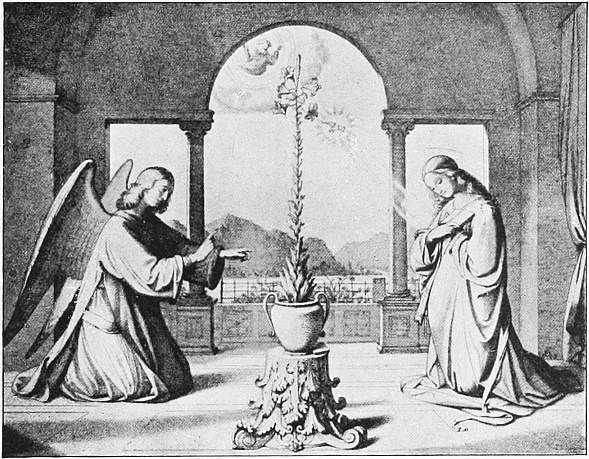 | |
| OVERBECK. | THE ANNUNCIATION. |
It was all said so simply and heartily that soon the whole world began 120 to be “Wackenroderite.” The ingenious and enthusiastic youth was succeeded by theoretic reasoners. Tieck, who published his Phantasies upon Art in 1799, after Wackenroder’s death, and amplified it with his own explanations, was no longer a genuine but a counterfeit “Klosterbruder.” He first played with Catholicism, and uttered the momentous sentence: “The best of the later masters up to the most recent times have had no other aim than to imitate some one of the primitive or typical artists, or even several together; nor have they easily become great by any other method than by having successfully imitated somebody.” His Sternbald is still more haunted by the spirit of monastic devotion.
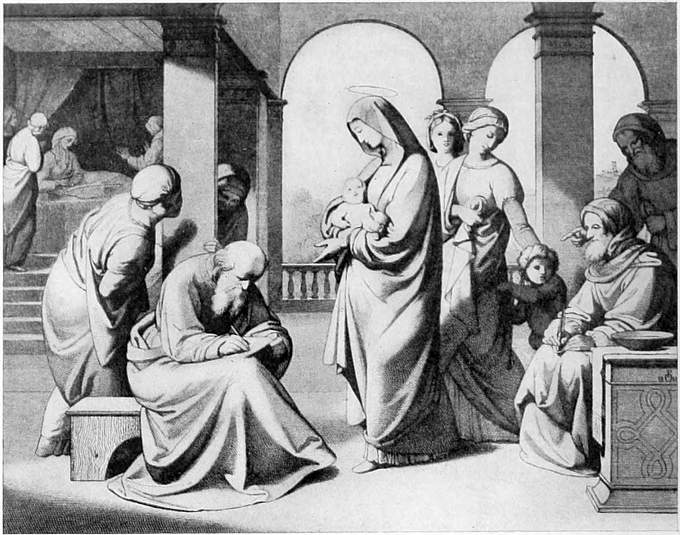 | |
| OVERBECK. | THE NAMING OF ST. JOHN. |
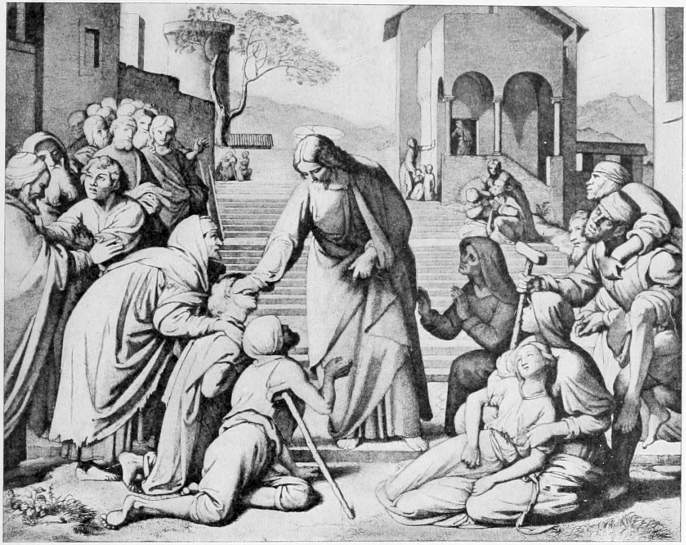 | |
| OVERBECK. | CHRIST HEALING THE SICK. |
The particular starting-point was in this case too, as it had been before for Winckelmann, the Dresden Gallery, where, at the turn of the century, Augustus William and Frederick Schlegel, the two “Gotter-buben,” held their cultured rendezvous. “The Schlegels had taken possession of the gallery,” wrote Dora Stock, “and with Schelling and Gries spent almost every morning there. It was a joy to see them writing and teaching there. Sometimes they talked to me about art. I felt myself often quite paltry, I was so far from any wisdom. Fichte, too, they initiated into their secrets. You would 121 have laughed if you could have seen them drag him about and assail him with their convictions.” The journal Europa, founded by Frederick Schlegel in 1803, became the rallying-point of the new movement, and his articles published therein contained the germs of all the efforts and errors of the young school. In his discourse on Raphael he compares the pre-Raphaelite period with that succeeding it, and considers the proposition that “indubitably the corruption of art was originally brought about by the newer school which was marked by Raphael, Titian, Correggio, Giulio Romano, and Michael Angelo” so unquestionable that he does not find it in the least necessary to prove it. He casually puts forward as an obiter dictum dropped in amongst a series of quite opposed notions the idea that every art ought to have a national foundation, and that any imitation of a foreign form of art is deleterious. The result follows that it is to be deplored “that an evil genius has alienated artists from the circle of ideas and the subjects of the old painters. Culture can only attach itself to what has been constituted. How natural it would be, then, if painters were to go on in the old way, and cast themselves anew into the ideas and disposition of the old painters.” The artist should follow the painters prior to Raphael, “especially the oldest,” should strive to 122 “copy carefully their truth and simplicity long enough for it to become second nature to his eye”; or he may “select the style of the old German school as a pattern.”
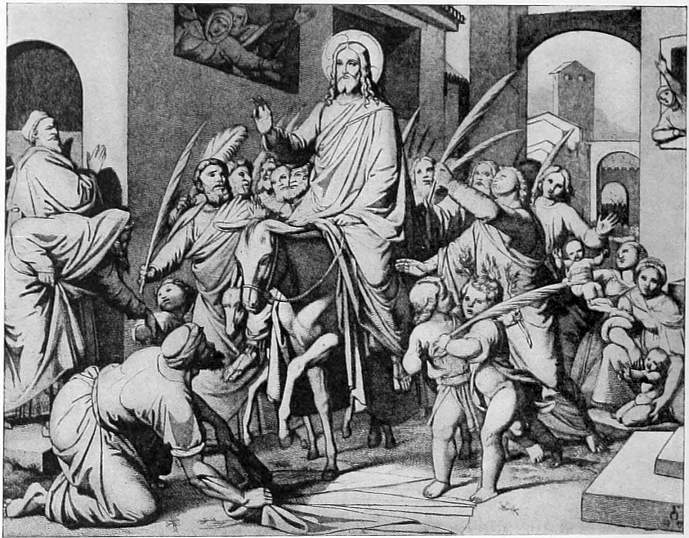 | |
| OVERBECK. | CHRIST’S ENTRY INTO JERUSALEM. |
 | |
| OVERBECK. | THE RESURRECTION. |
The latter counsel originated from the discovery in 1804 of the Cologne Cathedral picture, referred to by Schlegel in his Europa. Through the secularisation of the monasteries, attention was again directed to the old ecclesiastical pictures which people had hitherto passed by unnoticed. From the monasteries, churches, guild halls, and castles which the French had plundered, countless masses of paintings of every sort were extricated. A great deal perished; nearly all, however, that had hitherto been kept as heirlooms, and for the most part almost inaccessible, now became movable, attainable property. The brothers Boisserée began their celebrated collection, which is to be seen to-day in the Munich Pinakothek. While hitherto one had, at the most, known of Dürer, now one touched upon an age which lay behind the Reformation, an age in which Catholicism was flourishing, in which “not great artists but nameless monks represented art,” and it was soon all fire and ardour over the sweetness, naïveté, and faith of these pictures. Fernow had still pronounced generally 123 against the capacity of the “Catholic religion, with its Jewish-Christian mythology and martyrology,” to satisfy the demands of a pure taste in art. Carstens had written down for himself the sentence from Webb’s work: “The art of the ancients was rich in august and captivating figures: their gods had grace, majesty, and beauty. How much meaner is the lot of the moderns! Their art is subservient to the priests. Their characters are taken from the lowest spheres of life—men of humble descent and uncouth manners. Even their Divine Master is in painting nowhere to be seen according to a great idea; His long, smooth hair, His Jewish beard and sickly appearance would deprive the most exalted beings of any semblance of dignity. Meekness and humility, His characteristic traits, are virtues edifying in the extreme but in no way picturesque. This lack of dignity in the subject renders it intelligible why we look so coldly at these works in the churches and galleries. The genius of painting expends its strength in vain on Crucifixions, Holy Families, Last Suppers, and the like.” Not five years had elapsed after Carstens’ death when, according to an impression of Dorothea Veit, “Christianity was once more the order of the day.” William Schlegel’s poem, The Church’s Alliance with the Arts, from which, later, Overbeck borrowed 124 the thought for his picture, can be looked upon, as Goethe already wrote, as the true profession of faith of the young school. Where previously Augustus William had described in his sonnets the Io, Leda, and Cleopatra of the Dresden Gallery, it was now the Madonna who received the homage of the gallant poet. By Frederick, Christianity was recommended to the artist as a formal model and a source of æsthetic enjoyment,—as it was, at the same time, by Chateaubriand as prédilection d’artiste.
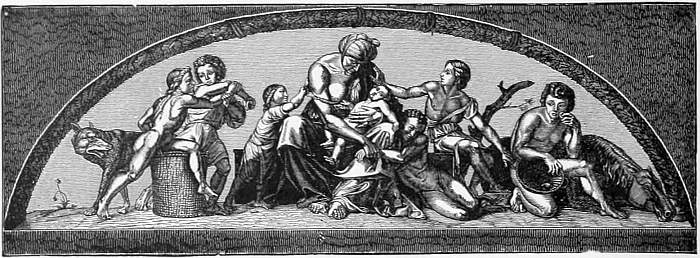 | |
| Seemann, Leipzig. | |
| OVERBECK. | THE SEVEN LEAN YEARS. |
Even more profound did the tendency become during the War of Independence, which at the same time gave the death blow to Classicism. Distress taught how to pray. In those years of humiliation the young generation abandoned the classic ideal for ever, and Schenkendorf cried imperiously: “We would see no more pagan pictures on any German walls.” French “frivolity” was contrasted with German seriousness, German Christianity with the free-thought of the French; there was a return from the cold philosophy of enlightenment to the vigorous feeling of mediæval faith.
Frederick Schlegel, the author of Lucinde, who had written as lately as 1799:—
| “Mein einzig Religion ist die, Dass ich liebe ein schönes Knie, Volle Brust und schlanke Hüften, Dazu Blumen mit süssen Düften,” |
was converted to Catholicism. Schelling wrote his Philosophy of Revelation; Görres, the editor of the Rothen Blut, ended as the author of the Christian Mystic.
Here set in the period of the Nazarenes. What Schlegel had said was to become true, that the German artist has either no character at all or he must have the character of the mediæval masters, true-hearted and thoughtful, innocent withal, and somewhat maladroit. In architecture the Hellenic school is succeeded by the Gothic, painting passes from the reverence of the Greek statues to that of old Italian pictures.
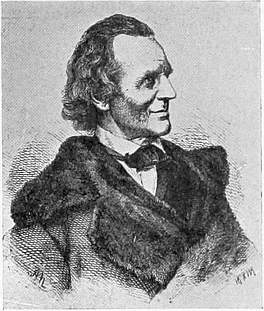 |
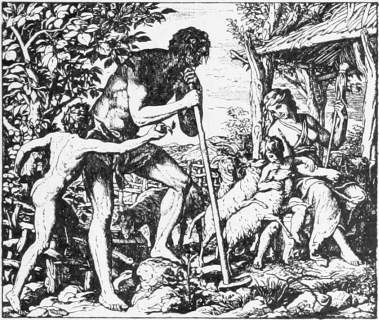 | ||
| Seemann, Leipzig. | Wigand, Leipzig. | ||
| JULIUS SCHNORR VON CAROLSFELD. | SCHNORR. | ADAM AND EVE AFTER THE FALL. | |
Rome remained for the Nazarenes, too, the centre of influence, only they no longer made pilgrimages, like the Classicists, to ancient but to Christian Rome. Overbeck of Lübeck came in 1810 with Pforr of Frankfort and Vogel of Zürich; the Düsseldorfer, Cornelius, followed in 1811, Schadow and Veit of Berlin in 1815, Schnorr von Carolsfeld of Leipzig in 1818, the Viennese Führich and Steinle in 1827 and 1828. In all of them there lived the perception that in such a serious age men should be of high moral endeavour, and art the expression of the religious capacity of their lives.
There still stands to-day, on a secluded hillock of the Monte Pincio a small church, whose façade is adorned with the statues of St. Isidore, the patron of husbandmen, and of St. Patrick, apostle of Ireland. A court with weather-beaten cloisters and an old well separates the church from the monastery which lies behind it, where the cells of the monks, Irish and Italian Franciscans, are placed. Above, on the terrace of the house, one has a charming view of Rome and the Campagna, of Monte Cavo and the heights of Tusculum. Below stretch the gardens of the Capucin Convent, and farther back the grounds and avenues of the Villa Ludovisi. On the first floor is a large hall, the walls of which have been decorated by the hand of some old monk with frescoes, and which, formerly a refectory, is used to-day as a theological lecture-room. This was the room where Overbeck and his friends in the first period after their arrival stood for one another as models. Lethière, the director of the French Academy, had obtained permission for them to install themselves in the deserted rooms of the monastery of San Isidoro, which had been spared by Napoleon, for which they paid the small sum of three scudi monthly.
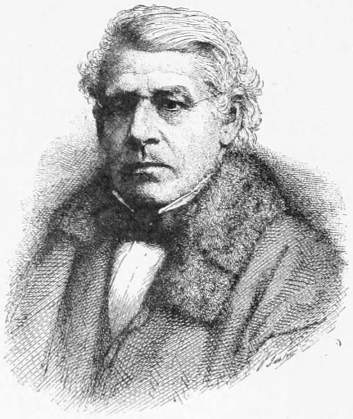 |
| JOSEPH FÜHRICH. Graphische Kunst. |
“We led a truly monastic life,” relates Overbeck; “held ourselves aloof from all, and lived only for art. In the morning we marketed together; at midday we took it in turns 126 to cook our dinner, which was composed of nothing but a soup and a pudding, or some tasty vegetable, and was seasoned only by earnest conversation on art.” Overbeck, as a good housekeeper, kept accounts; the principal items of the daily outlay occurred for polenta and risotto, oranges and lemons; every now and then oil, too, was noted down. The afternoons were dedicated to the study of the creations of art in Rome. With “beating hearts and holy awe” they passed over the threshold of the Stanze. In the chapel of San Lorenzo they became “familiar with the seraphic Fiesole, whose frescoes transcend everything in purity of conception.” They shunned the paganism of St. Peter’s, and marvelled with all the more intimate devotion at the old Christian monuments. The churches of San Lorenzo and San Clemente, the cloisters of St. John Lateran and St. Paul’s-without-the-Walls, made an ineffaceable impression upon the young men. At the twilight hour they wandered up on to Monte Cavo. “And of evenings we drew studies of drapery—glorious folds!—from Pforr’s big Venetian mantle, in which we took turns to pose for one another.” Their whole hearts, however, first swelled when they undertook a journey to Tuscany. In Orvieto, Luca Signorelli awaited them, whose frescoes especially impressed Cornelius mightily. At Sienna they found teachers who were still more sympathetic to them, Duccio and Simone Martino, those masters of a tender, intimate spirit and a charming sweetness of expression. In the Campo Santo at Pisa they turned their attention to Fiesole’s pupil, Gozzoli. Those became their great teachers in art. “Just as ardent Christians wander to the grave of the princes of the apostles in order to confirm their faith and quicken their zeal, so should zealous young artists derive strength and illumination from the silent and yet so eloquent speech of the sublime geniuses of art. An artist of real worth will find in the masterpieces of painting at Rome everything necessary for him in order to reach the right path. But, to be sure, a well-made plait of hair does not certainly constitute one a Raphael, because Raphael, too, arranged his hair with feeling. Study alone leads to nothing. If since Raphael’s age, as one can almost declare, there has been no painter, that is the fault of nothing else than of the fact that art has been vanquished by workmanship. 127 One learnt at the academies to paint excellent drapery, to draw a correct figure, learnt perspective, architecture—in short, everything, and yet no painter was produced. There is one want in all recent painting—heart, soul, sentiment. Let the young painter then watch, before everything, over his sentiments: let him allow neither an impure word on his lips nor an impure thought in his mind. But how can he guard himself from that? By religion, by study of the Bible, the one and only study which made Raphael. This view now certainly contradicts the accustomed principles that everything must be systematically learnt; mere learning produces certainly an instructed but also a cold artist. On that ground it is not good either to study anatomy from dead bodies, because one dwarfs thereby certain fine sensibilities, or to work from female models, for the same reason. Let the painter be inspired by his subject as those of old were, and the result will be the same. Like those old painters, let every artist remind himself that the truest use of art is that which leads it heavenwards, its one function that of having a moral effect upon men.” “How pure and holy,” cries Cornelius to Xeller, as late as 1858, “was the end at which we aimed! Unknown, without encouragement, without aid, except that of our loving Father in heaven.”
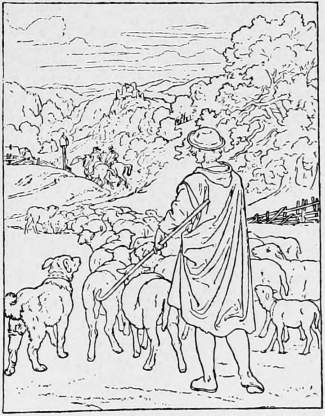 |
| FÜHRICH. FROM THE “LEGEND OF ST. GWENDOLIN.” |
It is obvious that between the ascetics of the monastery and the Classicists direct friction must ensue. To them the “ever repeated and pale reflexions of Greek sculpture” said nothing, while the Classicists scoffed at the religionists, for whom the sarcastic brawler, Reinhart, invented the nickname of “Nazarenes,” which has since become a watchword. The opposition was historically immortalised when Bunsen, the Prussian envoy, invited the whole colony to the christening of his little daughter, and Niebuhr touched glasses with Thorwaldsen “to the health of old Jupiter.” Only Cornelius joined in; the others started and looked upon the young Düsseldorfer as a heretic.
This positive Christian standpoint, which allowed art to be esteemed only as a religious service, pictures only as a means of ecclesiastical edification, irritated also the old man of Weimar at the first start. The effort of the Nazarenes to make piety the foundation of true artistic activity was to him a continual subject of contempt. 128 Religion no more bestows talent for the arts than it gives taste. He spoke with irony of the “valiant artists and ingenious friends of art who had resort to the honourable, naïve, yet somewhat coarse taste” of the fourteenth and fifteenth-century masters. He constantly employed of them the expression “star-gazing.” He had already mockingly remarked of Wackenroder’s Herzensergiessungen what an unwarrantable conclusion it was, that because a few monks were artists, all artists should therefore be monks. He called the life of the Nazarenes “a sort of masquerade which stood in opposition to the actual day,” and wrote in the pages of Art and Antiquity that manifesto, the New German Religious-Patriotic Art, or History of the New Pietistic False Art since the Eighties, which so deeply wounded the young enthusiasts. “The doctrine was that the artist needed piety above everything to equal the work of the best. What an attractive doctrine! How eagerly we should accept it! For in order to become religious one need learn nothing.” The whole movement reached nothing beyond a slavish imitation of Giotto and his immediate followers. Of course, it was inconsistent of Goethe to reproach contemporary art for imitating that of the Middle Ages, and to praise the latter only when it imitated the antique. Speaking as a man of Mengs’ school, and merely proposing Hellenic art as a canon instead of early Italian, he had, after all, no right to be angry if Frederick Schlegel opposed classical models with mediæval. Otherwise, however, even to-day little can be added to Goethe’s animadversions.
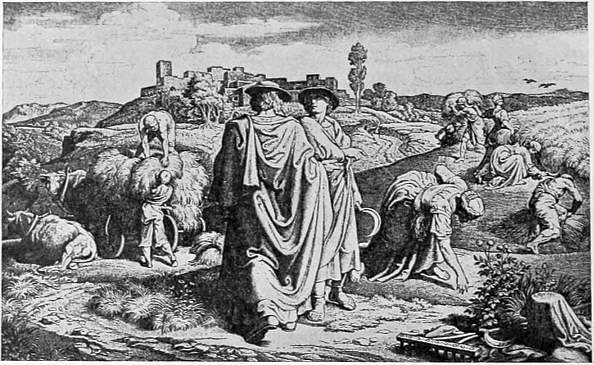 | |
| FÜHRICH. | RUTH AND BOAZ. |
As with Carstens, so with the Nazarenes, we are warned by the idealistic 129 tendency which inspired the young enthusiasts. There are but few painters with whom life and art have been in such complete agreement as with the gentle, mild, and modest Overbeck, the “Apostle John,” as he got to be called, that young man, that serene soul who looked upon art simply as a harp of David for the praise of the Lord, to whom the “hope that through his works one soul had been strengthened in faith and piety was of far more value than any fame,” and who ended at last in a sort of religious mania. With the Nazarenes, too, as with the Classicists, it was pure exaltation which drove them to free themselves from the trammels of the school, in order to get back from dead fabrications to creations of art, which, proceeding out of the living spirit, once more had a soul. Even the much-despised conversion of the Protestants among them to the Catholic Church arose out of the deep conviction that they also, as well as their art, must be united in religion.
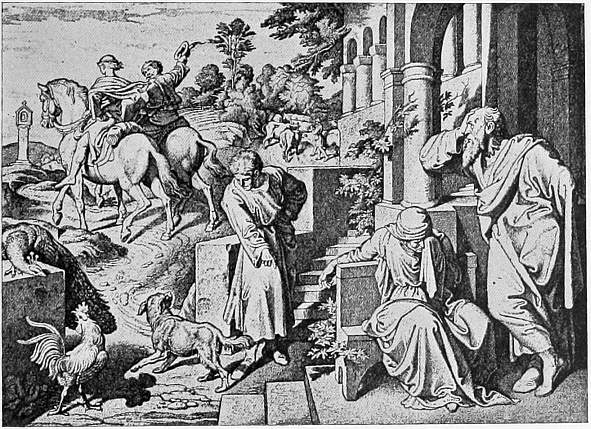 | |
| FÜHRICH. | THE DEPARTURE OF THE PRODIGAL SON. |
In a certain sense they even show an advance in art. They found between themselves and the great painters of the eighteenth century a gulf that could no longer be spanned. After Carstens had thrown overboard every colouristic acquisition, it was indeed something that the Nazarenes no longer saw the highest aim of painting in black and white design, but turned, though with timidity and hesitation, to the study of the Italian Quattrocento with its joyous delight in colour, and so became 130 the first real painters after the cartoon period. Only that was as yet simply an advance for the nineteenth century, and not especially for the history of art. This was as little enriched with new forms and discoveries by the Nazarenes as by the Classicists. The former, too, were imitators, and only changed masters when they fled from the antique to the Middle Ages, and copied the old Italians in lieu of the Greeks. The Classicists had imitated with a certain cold erudition; the Nazarenes out of the depths of their emotion. As the former used Greeks, so did they use the fourteenth-century painters, as patterns of calligraphy from which they made their copies, cut their stencils after the Italian form, and, like Mengs, were able to reproduce in their works only a very weak reflection of those departed spirits. As eclectics they would stand on the same rung with the academics of Bologna, except that the ideal of the latter school was a combination from Leonardo, Raphael, Michael Angelo, Correggio, and Titian, and that it possessed an incomparably greater facility in technique.
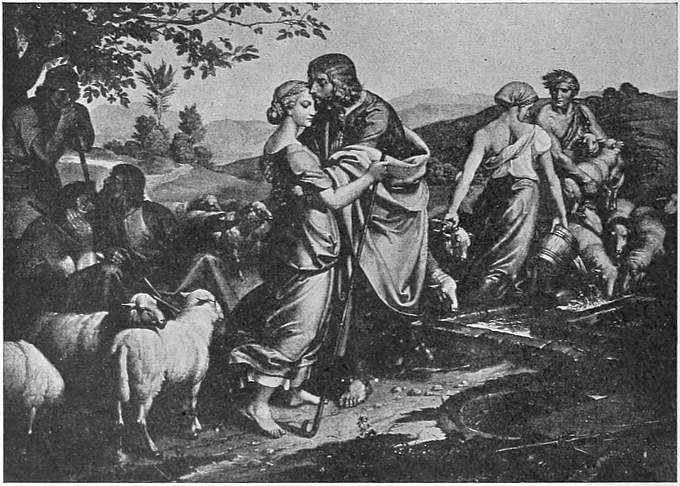 | |
| FÜHRICH. | JACOB AND RACHEL. |
The Nazarenes abandoned on principle the employment of the model, from fear lest it might entice them away from the ideal representation of the character to be depicted. They sought in a dilettante manner to supply the control over the material which alone makes the artist, by 131 enthusiasm for the material. Only Cornelius dared to draw from the female form. Overbeck refused to do so, from modesty. The Virgin Mary was to him the highest ideal of womanhood, the paler, the more virtuous, the more akin to the Lamb of God; and he would have deemed it a sacrilege to have depicted her as purely womanly. They therefore only occasionally sat to one another for studies of drapery, and, for the rest, “in order not to be naturalistic,” painted their pictures from imagination in the seclusion of their cells. As the Catholicism of Schlegel was an anæmic system, so the painters, too, deprived their figures of blood and being in order to leave them only the abstract beauty of line. They are beings who are exalted above everything, even above correctness of drawing, and who must expire of a lack of blood in their veins. The command, “Seek ye therefore first the kingdom of God, and His righteousness, and all these things shall be added unto you,” was carried out by the Nazarenes only too well.
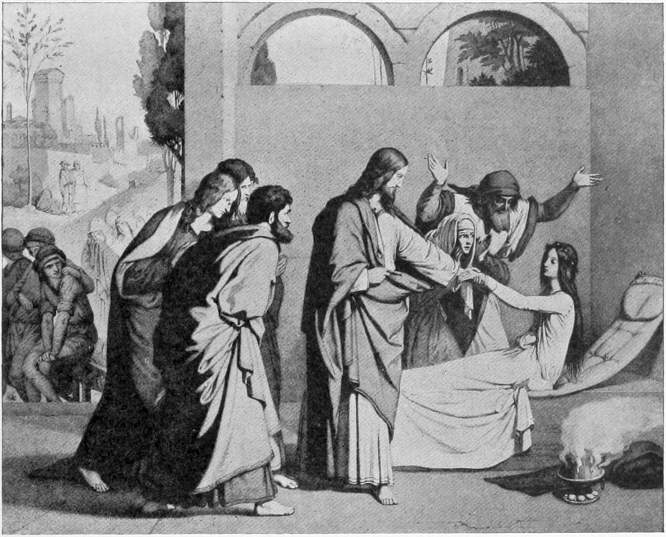 | |
| STEINLE. | THE RAISING OF JAIRUS’ DAUGHTER. |
They have created only two works which will survive, and which possess an historical significance as pre-eminent, works of the whole movement in common—the frescoes of the Casa Bartholdi and of the Villa Massini.
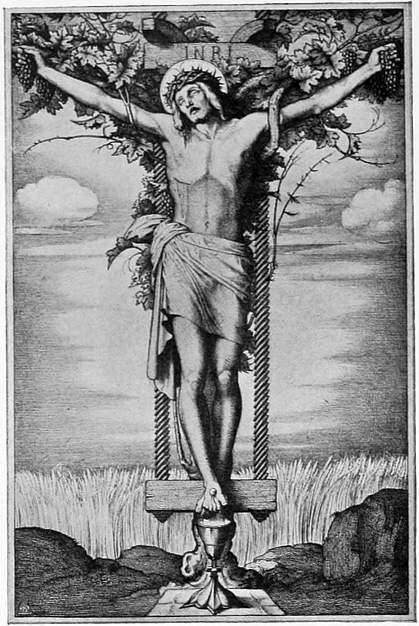 |
| Steinle. “I HAVE TRODDEN THE WINEPRESS ALONE: AND OF THE PEOPLE THERE WAS NONE WITH ME.” |
When the intelligence of the Battle of Waterloo had penetrated even into the silent cells of the monks, they believed that art too should participate in this universal elevation, and become a factor again in the development of the German nation. It must not be used, wrote Cornelius in his famous letter to Görres, as a mere plaything, or to tickle the senses, not merely for the delectation and pomp of high and rich Maecenases, but for the ennoblement and glorification of public life. The means of this artistic elevation, and at the same time a new means of popular culture, was to be the introduction of fresco painting.
And thus the Brothers of San Isidoro re-discovered what had, as a matter of fact, always been quietly practiced by the “rustics painters,” but since Mengs’ time had no longer been employed by the “art painters,” and had been forgotten for half a century. The Prussian consul at Rome, Bartholdy, gave them the commission. An old mason, who had last arranged wall-plastering under Mengs, was recruited as technical adviser; Carl Eggers, of Neustrelitz, zealously made chemical researches; and it is said to have been Veit who, at Cornelius’ request (“Now, Philip, you make the first attempt!”), was the first to paint the portrait of a head in fresco, whilst his companions looked on with amazement and delight. Then the others set to work, “and painted away at it in the name of God.” “Yes, believe me, my friend, it is a desperate matter to paint over a whole room in a manner which one has never before practised oneself nor seen practised by others. Every day we tell each other that we are fine bunglers, and give each other a regular dressing down. You can have no conception how strange it feels at first when one is 133 confronted by damp plaster and lime. And nevertheless we construct daily fresh castles in the air for painting churches, monasteries, and palaces in Germany.”
The frescoes represent, in six mural paintings and two lunettes, the history of Joseph in Egypt, from his sale to his recognition by his brethren. The two latter are the work of Cornelius and Overbeck, the others of Veit and Schadow. The work was prolonged through many years, interrupted by manifold difficulties, and when one stands to-day before the transferred pictures in the Berlin National Gallery one cannot refrain from admiring them.
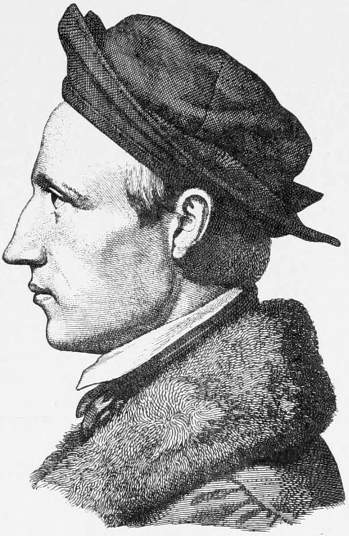 |
| EDWARD STEINLE. |
There lives within them an unpretentiousness and sincerity of sentiment, and, in spite of all deficiencies and lack of independence, somewhat of that lofty inspiration which raises the pictures of really earnest artists, even if they are faulty, far above any fabricated productions. An association of young men, which, unconcerned about success and material profit, contended only for ideal products, found here for the first time an opportunity to display what it wanted. In the interpretation of Pharaoh’s dream and in the recognition by the brethren, Cornelius, in formal language, full of character, and without any phrases and posture, displayed all that he had derived from the great Italians in nobility of grouping and fine arrangement of lines. Overbeck reaches the same height in his allegory of the seven lean kine. But it is not only as youthful works of artists, who, if they belonged to a period of decadence, yet were, withal, the greatest representatives of a period of German art, that these pictures are worthy of high esteem; they are essentially the best that these masters have created. Cornelius, notably, shows a study, a care for execution, indeed even a harmony of colouring, that stands in surprising opposition to his later negligence. From the conception that the artistic performance is determined in the invention, and the design, but that the pictorial execution is an indifferent, mechanical accessory which could be supplied even by other people, he was at that time still free.
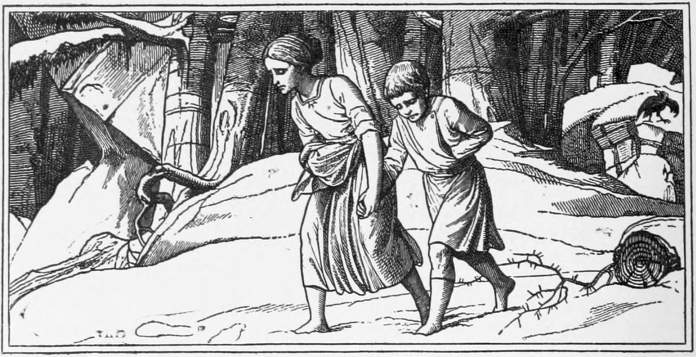 | |
| STEINLE. | BOOK ILLUSTRATION. |
When the pictures had been unveiled in 1819 a festival of German artists was held in Rome. Rückert, Bunsen, the Humboldts, the Herzes were there; Cornelius, Veit, and Overbeck had arranged the transparencies. “The centre of all,” writes the Danish romantic Atterbom, was the Crown Prince Ludwig of Bavaria, “the idol of every German artist, whose ruling passion is for the fine arts and fair ladies. Everything was in old German masques, the ladies in wide ruffs. The Crown Prince was in the utmost good humour, and treated the artists as his equals. A toast was drunk to German unity. The scene struck me like a beautiful dream out of the Middle Ages.” German unity at a Roman fancy ball! The German nation a beautiful dream out of the Middle Ages! The Crown Prince Ludwig, when he took Cornelius and Schnorr out of the Roman circle, at least created a fatherland for German art, and later on the others also found at home a suitable sphere of activity.
Philip Veit, who went to Frankfort in 1830 as Director of the Staedel Institute, was the first to settle down, and for all his energy could only for a very short time make that city into a seat of the Christian tendency in art. Of his pictures there, the fresco painted for the Staedel Institute, “The Introduction of Christianity into Germany by St. Boniface,” is by far the most important. The apostle has hewn down the oak of Thor, and from where it once stood there flows forth the new spring of Christianity. The old Germans shrink back timorously, but the youths listen to the preacher, and follow his direction to the figure of religion which approaches with the palm of peace. In the background a church rises, and in the distance, by a limpid river, a flourishing town, in contrast to the sombre, primeval forest to which the Germans who reject religion are flying.
“The two Marys at the Sepulchre,” in the Berlin National Gallery, and the “Assumption,” in the Frankfort Cathedral, date from a later period. It was of no avail to him that he mingled with his Nazarenism a certain air of the world, which found expression in a less ascetic language of form and a somewhat stronger sense of colour. In 1841 he had already a feeling that the restless, struggling age had passed him by. He abandoned his post and went to meet oblivion as Director of the Gallery at Mayence.
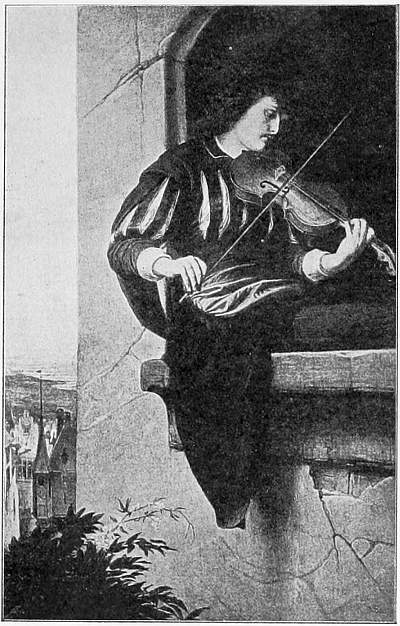 |
| Munich, Albert. |
| STEINLE. THE VIOLIN PLAYER. |
Overbeck, the only one who could not tear himself from Rome, remained, till his death in 1869, the “Young German Raphael,” as his father had called him in a letter from Lübeck in 1811: a devout, religious poet, pure of soul and of fine culture, as one-coloured and one-sided as he was mild and tender. At the outset he knew, at least, how to extract from the old masters a certain naïve piety without positive character, whereas later he lost himself more and more in the arid formalism of dead dogmas. What was in his power to give he has given in pictures such as the “Entry of Christ into Jerusalem” and the “Weeping over the Body of Christ”—both in the Marienkirche at Lübeck, in the “Miracle of Roses,” in Santa Maria Degli Angeli at Assisi, in the “Christ on the Mount of Olives” in the Hospital at Hamburg, and the “Betrothal of Mary” in the Berlin National Gallery—pictures which expressed nothing that would not have been expressed better at the end of the fifteenth century. His “Holy Family with St. John and the Lamb,” of 1825, in the Munich Pinakothek, is in composition and type a complete imitation of the Florentine Raphael; his “Lamentation of Christ” in the Lübeck Marienkirche is 136 reminiscent of Perugino; his “Burial” would never have existed but for Raphael’s picture in the Borghese Gallery. His sentiment coincided exactly in devotion and godliness with that of Fra Angelico or of the old masters of Cologne, and when he devoted himself to programme-painting he lost all intelligibility. In the “Triumph of Religion in the Arts,” which he completed in 1846 for the Staedel Institute, and in which he wished to embody the favourite ideas of Romanticism, that art and religion must flow together in one stream, he has copied the upper part from the “Disputa,” the lower part from the “School of Athens,” and worked up both into a tedious and scholastically elaborated whole. It is only through a series of unpretentious sketches which he prepared for engravings, lithographs, and woodcuts that his name has still a certain lustre. Plates such as the “Rest in the Flight,” the “Preaching of St. John,” or the series “Forty Illustrations to the Gospel,” the “Passion,” the “Seven Sacraments,” may be contemplated even to-day, since in them at least no tastelessness of colour stands in the way. These plates, too, like his pictures, are less observed than felt—felt, however, with an innocence and cheerfulness of heart often quite childlike.
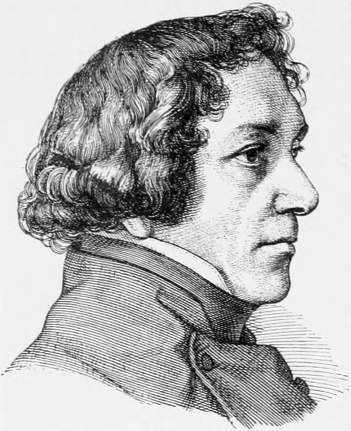 |
| PHILIP VEIT. |
It shows above all much self-understanding that all these masters in their later years restricted themselves exclusively to design, which better expressed their character. In compositions and sketches of this kind, which were only drawn, and were thus untrammelled by the fruitless struggle with the difficulties of the technique of painting and a complete lack of the notion of colour, they moved more freely and lightly. In their frescoes and oil-paintings, partly through insufficient technique, partly through their all too servile imitation of foreign ideals, they went astray. As draughtsmen, they had more courage to be themselves, and while in the completer paintings many a fine trait, many an intimate reflection of the soul was lost, or through the obduracy of the material did not attain a right expression, here their spiritual and emotional qualities can be better valued.
Joseph Führich, one of the most staunchly convinced champions of these reactionary tendencies, has become, entirely owing to his extensive 137 activity as a draughtsman, somewhat more familiar to our modern knowledge than most of his contemporaries. He had begun as a draughtsman. As a student of the Prague Academy he was an enthusiast for Schlegel, Novalis, and Tieck; and even before his journey to Rome he had etched fifteen plates for Tieck’s Genoveva. It was Dürer who exercised the deciding influence upon his further development. He had been led to him through Wackenroder, and had copied his “Marienleben” in 1821. “Here I saw,” he says in his Autobiography, “a form before me which stood in trenchant opposition to that of the Classicists, who are anxious to palm off as beauty their smoothness and pomposity borrowed from the misunderstood antique, and their affected delicacy as grace. In contrast with that absence of character which prevailing academic art mistakes for beauty I saw here a keen and mighty characterisation which dominated the figures through and through, making them, as it were, into old acquaintances.” The strong and godly German middle age took then in Führich’s heart the same place which the Italian Quattrocento had filled in Overbeck’s range of thought. And this old-German tendency was only temporarily interrupted by his sojourn in Rome. After he came to Rome in 1826 he became a Nazarene, and was accustomed there to look back at the tendencies of his youth as an error; and both at Prague, where he returned in 1829, after collaborating at the frescoes in the Villa Massini, and at Vienna, where from 1841 he held the post of professor in the Academy, he found rich opportunity for putting into practice his ecclesiastical and orthodox views of art.
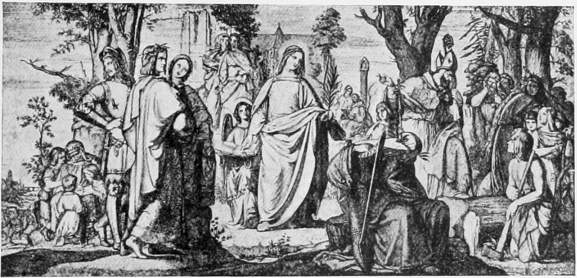 | |
| VEIT. | THE ARTS INTRODUCED INTO GERMANY BY CHRISTIANITY. |
His frescoes in the Johannis-und-Altleschenfelder Church in Vienna are, perhaps, more harmonious in colour, but no more independent in form, than the works of the others. In his old age he returned once more to the impressions of his youth, and so found himself again.
As a boy, in his little native village of Kratzau, in Bohemia, he had tended the cows in summer time and had acquired a certain sincere knowledge of nature and shepherd-life. He had to thank Dürer for his preference for the idyllic and patriarchal family scenes in Sacred History, and these tendencies found pleasing expression in pictures like “Jacob and Rachel,” or “The Passage of Mary across the Mountains.” No matter that the figures in “Jacob and Rachel” are taken out of the early pictures of Pinturicchio and Raphael, they are still interwoven, with their background of landscape, into an idyll of great naïveté and charm. More especially, however, did the qualities which he owed to Dürer acquire value—a sturdy characterisation, a naïve art in telling the story, and a great wealth of fresh traits, straight from nature—in the serial compositions of his old age. There is no sentimental vagueness, nothing academical. Führich had a keen eye for what was intimate, familiar; a tender sense of the individualities of landscape in woodland and meadow, of the charm of everyday life as well as of the animal world; and though an idealist, he knew how to assimilate ingeniously what he had observed with a certain realistic fulness. The old story of Boaz and Ruth grew beneath his hands into a delicious idyll of country life. From the story of the Prodigal Son he has extracted with sensitiveness the purely human kernel, and as late as the winter of 1870-71, at the age of seventy-one, he illustrated the legend of St. Gwendolen, in which he depicted with tender reverence the escape of a human soul, withdrawn from the world and resigned to God’s will, into Nature and her peace.
Edward Steinle, who went from Rome to Vienna in 1833, and settled in Frankfort in 1838, is called, not very appropriately, by his biographer, Constantine Wuzbach, “a Madonna painter of our time.” His name deserves to come down to posterity rather for what he created outside the essential characteristics of his art. In his frescoes in the minster at Aachen, in the choir of the cathedrals of Strasburg and Cologne, he stood firm on the standpoint of the Nazarenes; which is as much as to say they contained nothing novel in the history of art. In his fairy pictures, however, imagination broke through the narrow confines of dogma, and entwined itself in creative enjoyment round the vague figures of fable. His “Loreley,” in the Schack Gallery, as she looks down, a Medusa-like destroyer, from the tall cliff; his watchman who looks dreamily into space over the houses of the old town; his violin player on his tower who plays, forgetful of the world,—these have something musical, poetical, that freshness of sentiment and unsought naïveté which as an inheritance of his Viennese home was also peculiar in such a high degree to Schwind.
The Romantic aspiration is revealed in Steinle, even, in a certain “yearning after colour.” There lives in his works a refined feeling for colour that, especially 139 in his water-colours, rarely forsakes him. Take, for instance, the fresh, tinted pen-drawings, engraved by Schaffer, in which he displayed with the naïveté of Memlinc the life of St. Euphrosyne; the five aquarelles of Grimm’s “Snow-White and Rose-Red”; or his illustrations to Brentano’s poems, such as the Chronicle of the Wandering Student, and the Fairy Tale of the Rhine and Radlauf the Miller, in which he developed a delight in the world and an idea of landscape that in the ascetic Nazarene excite astonishment.
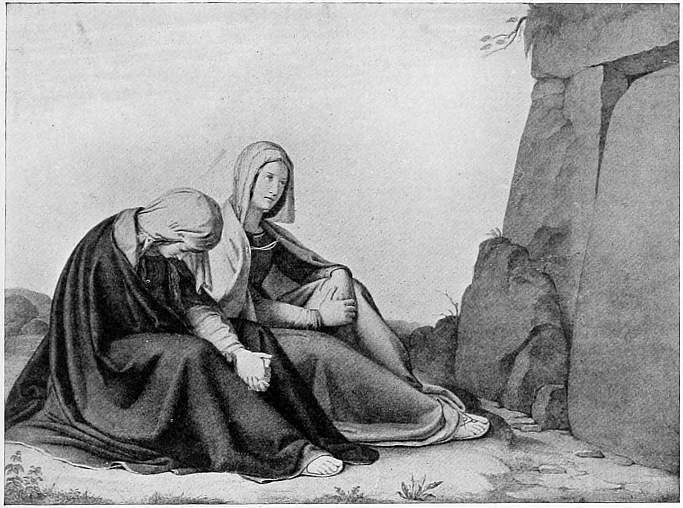 | |
| VEIT. | THE TWO MARYS AT THE SEPULCHRE. |
Julius Schnorr von Carolsfeld went, after the completion of the Ariosto Room of the Villa Massini, first to Vienna, then in 1827 to Munich, in order to paint the Nibelungen in the halls of the royal residence of that time, and in the imperial halls of the state palace the history of Charlemagne, Frederick Barbarossa, and Rudolf of Hapsburg. He also, however, created his best work at the close of his life in Dresden,—the forcible woodcuts of his Picture Bible, which narrated the world’s sacred history in strong and vigorous strokes.
Strangest to the present-day taste have become the drawings of Cornelius. His plates to Goethe’s Faust have, indeed, a certain austere strength of 140 conception, which he learnt from Dürer; but also faults of drawing, exaggerations, crudities, and errors in perspective, which he did not find in Dürer.
In his second work, the Nibelungen cycle, an intentional old-German angularity, with an unintentional modern clumsiness, has effected a mésalliance even less attractive.
 | |
| OVERBECK. | PORTRAIT OF HIMSELF AND CORNELIUS. |

CHAPTER VI
THE ART OF MUNICH UNDER KING LUDWIG I
More than seventeen hundred years ago there reigned a Roman emperor who loved art passionately. He looked upon it from an intellectual altitude which few have reached, and he valued it as the monumental consummation of Græco-Roman culture. Standing upon a plane of intellectual elevation, himself gifted with artistic intuition, he knew of no higher enjoyment for a ruler than the cultivation of the architectural and other forms of art. It was he who opened up to the energy of artists a field such as has never been offered to them before or since. He spent upon his works sums incalculable, so that his people grew restless under their emperor’s mania for building. His villa at Tivoli, which attained to the extent of a town, was in itself a copy of everything that he most loved and admired in the world. It united nearly all the renowned buildings of Athens in one masterly reproduction. And then with architecture came the other arts. The most magnificent collections of sculpture were formed, for none had better opportunities of acquiring the antique masterpieces of the Greek towns. Numberless frescoes, scenes from those cities and regions which had most impressed him on his travels, adorned the walls.
And yet subsequent generations have viewed with unconcern this halcyon period in the history of art. Though his contemporaries fancied that the splendour of the Greek sun was still radiating over them, it was but a borrowed lustre, which never went beyond the reproduction or copying of classic examples. Whatever Greek temples the emperor might build and decorate, he failed to summon into being a Phidias or a Polygnotes to revive for him the forms of the antique. The names of the artists who worked for him are forgotten. They had no originality; they copied the types of the Grecian and Egyptian periods, and their art was but a repetition of old ideals, without character of age or place. The fifteen colossal columns of his Olympieion that are still standing impress one as foreign to Athens, and would seem more in place at Baalbeck or Palmyra than in this city of the Muses. Epictetus would have smiled at the emperor diverting himself with an album of the wonders of the world, as a piece of sentimentality. The age of Hadrian produced thousands of buildings, statues, and pictures, but no original works.
Will a different judgment be pronounced in the lapse of time upon the artistic creations of King Ludwig I? Ludwig also—his biography reads 142 like that of Hadrian—was an enthusiastic admirer of art. After the Peace of Vienna, when the political aspirations of Germany had been frustrated, he alone among the numerous German princes of the old alliance fostered homeless art, and thus fulfilled a noble mission. The king’s splendid enthusiasm for the ideal significance of art, which he hoped would lead the German people, then seeking to work out its individuality, from out of its Philistine narrow-mindedness to nobler and greater things—this enthusiasm will redound to his enduring honour. Schiller’s idea of educating humanity by æsthetic means had in him grown into a living and powerful sentiment.
All that it was possible to accomplish in the cause of art, on the basis of existing development, his endeavours have fully realised. In the course of twenty-three years he spent more than £3,000,000 from his privy purse, and made Munich what it is, the principal art centre of Germany; changed it from a Bœotia into an Athens; founded its art collections, and erected the buildings which give the town its character. Then he offered those new walls to the painter Cornelius, and commanded him to cover them. “You are my field-marshal, do you provide generals of division.” In 1814 Cornelius had written to Bartholdy: “The most powerful and unfailing means to restore German art and bring it into harmony with this great period and the spirit of the nation would be a revival of fresco-painting as it existed in Italy from the days of the great Giotto to those of the divine Raphael.” And through this royal command the dream was realised beyond all expectation. No such lively artistic animation had been witnessed since the great periods of Italian art; an animation which does not cut the worst figure in German history in those sad times of political stagnation and reaction. But that there was a living soul of art in those days posterity will no more acknowledge than it does in the case of the age of Hadrian.
| “Wie bei Bartholdy als Kind, so in Massimis Villa als Jüngling Teutshes Fresco wir sehn, aber in München als Mann,” |
sang King Ludwig. Now, after two generations, it can be seen that fresco-painting at Munich from 1820 to 1840 produced less original conceptions of the German art of the nineteenth than weak reflections of the Italian art of the sixteenth century.
Various favourable circumstances combined at that time to cause Cornelius to be specially looked upon by his contemporaries as an incomparable master. Since Tiepoli, German monumental art had remained dormant. The frescoes at Munich were the first attempts made to revive it. And it seemed as though with Cornelius, German art had at once risen to the dizzy heights to which Italian art had been led by Michael Angelo. The lookers-on believed in Buonarotti’s resurrection. As in the Sistine “Last Judgment,” the movement of his heroic figures appeared plastic and pathetic, and his types, not excepting the women, gave that impression of the terrible, which none but Signorelli and Michael Angelo had attained before him. His advent, it was said, might almost make one believe in a kind of metempsychosis; as though the spirit of 143 the great Florentine master, that giant of the Renaissance, had been restored to humanity. At that very period the Italian art of the Cinquecento enjoyed the exclusive favour of the German scholars. It alone was worthy of imitation; in it the æsthetic philosophers sought for rules and laws to govern the development of art. And as they thought that all the qualities of this artistic method were to be found in the works of Cornelius, it was only logical to arrive at the conclusion which the Crown Prince Ludwig summed up in the following words: “There has been no painter like Cornelius since the Cinquecento.”
 |
| PETER CORNELIUS. |
At the same time the intellectual character of his work harmonised with the wishes of a period in which the leaders of German thought tried to forget the dreary dulness of life by plunging into the most profound speculations. “What does it matter,” writes Hallman, “if we lack all joyous, independent national feeling? What though we do not even try to resuscitate this feeling with wars and battles? We strive after something higher! The world is beginning to respect German intellect and learning. We believe that in this we are in advance of other nations, and we seek a mode of expression, we want to give a form to that lofty thought through our art, in order that we may bequeath to posterity an image of our fortunate condition.... Therefore it is a remarkable sign of the times that painting strives to make the weighty output of intellectual thought a common treasure of all who are neither able nor disposed to follow speculation to its dizzy heights, nor erudition to its lowest depths; that painters try to transform the results of those investigations into fresh and ever lively conceptions—the element of art.”
To accomplish this none was better fitted than Cornelius. What a weight of thought and learning his works display!
In the Pinakothek, Cornelius’ main idea was to paint the life and work of Nature as illuminated by the figures of the Greek gods. For the series of paintings in the Hall of the Gods, Hesiod’s Theogony offered a basis upon which to demonstrate the idea of the triumph of the creative mind in heaven and upon earth. In the second room, human passion, power, and tyranny were illustrated in scenes of Greek heroic life from the Iliad. The frescoes in the 144 Ludwigskirche were to follow the Christian apocalypse as a concatenation, and to depict it in symbolic treatment from the Creation to the Last Judgment. The frescoes for the Campo Santo at Berlin were meant to represent “the universal and most exalted fortunes of humanity, the manifestation of divine grace towards the sins of mankind, the redemption from sin, perdition, and death, the triumph of life and eternity.” Each of these paintings is a treatise. Each fresco bears a definite relation to the other; deep philosophic speculations weave their threads from one to the other. Or else the painter revels in a suite of compositions which trace a network of intellectual combinations from one picture to the other. As he himself expressed it, he delivered his diploma lecture through his paintings.
And this painted erudition harmonised with the requirements of those times of dominating intellectual tendencies. The scholars saw in Cornelius the poet, the doctor-in-philosophy; held that the principal value of the work of art lay in its intellectual contents, and felt that their loftiest mission was to express these contents still more correctly than the painter himself. The idea, they said, was the alpha and omega of the painter’s art, and must be accepted at its full value, even when represented in the most shadowy external form.
These opinions have now vanished entirely. A more extended intercourse with the old masters and with the art of other countries has gradually cured the Germans too of that mental hypertrophy from which they suffered in their view of art—a complaint whose characteristic symptom was the entire lack of sensuousness, of that sensibility to beauty of form and external charm which always has been and always must be the predominating mood of a society in which art is to flourish. They have gradually reached the point at which one interests one’s self in a picture for the sake of the painting of it, looks first at the picture, and only then asks what the painter’s idea may have been, or what the spectator is to gather from it. No poem will find favour which offers acceptable thoughts in badly worded, halting, unmelodious verse; nor do the loftiest thoughts in themselves suffice to make a work of art. Profundity of thought is a thing that has little to do with pure art; and the subject alone, however world-stirring the ideas in it may be, never makes a thing artistic. We have learnt to find the most intense enjoyment in the mere contemplation of Titian’s “Earthly and Heavenly Love,” although we may not yet know what this picture is really meant to convey. And we know none the less that what renders Raphael’s “School of Athens” immortal is not its catalogue of ideas, which has been drawn up by an anonymous pedant, but the master’s artistic power, the intensity with which he expresses what was barely showing bud in the material, the self-reliant strength and sureness with which the form and colour have succeeded in outlining and creating every figure and every movement in the picture.
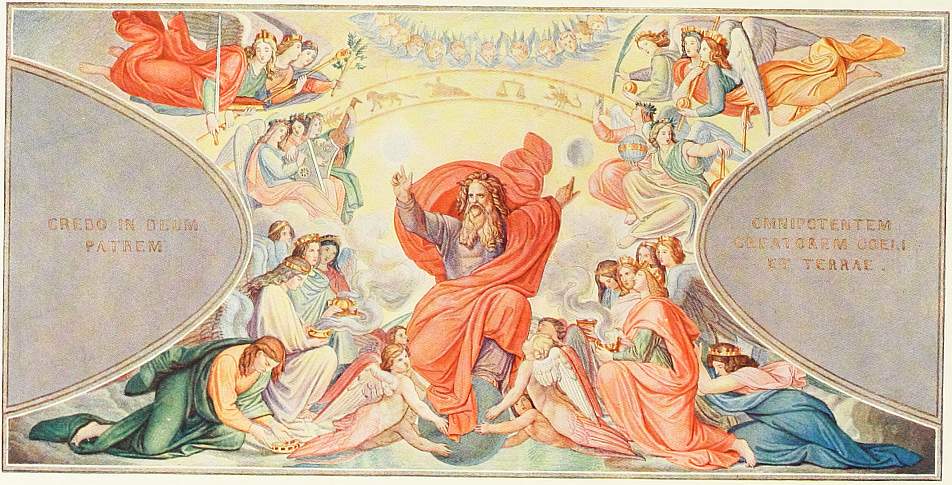 | |
| PETER CORNELIUS | ‘LET THERE BE LIGHT’ |
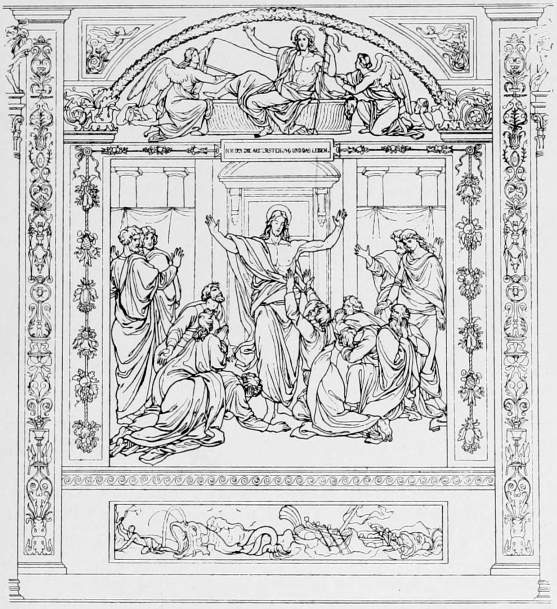 | |
| CORNELIUS. | FROM THE FRESCOES IN THE FRIEDHOFSHALLE, BERLIN. |
No less has the comparative study of art gradually refined people’s sensibility to originality. We are no longer compelled to place an artist on the 145 same level with a master of ancient art because of the outer resemblance of their work. We have progressed so far as to respect in art none but original genius, and to look upon imitation as a testimonium paupertatis though Praxiteles or Michael Angelo be the model. In this we find the explanation of the low esteem in which some of the old masters are now held. The contemporaries of Mabuse and Marten Heemskerk thought that in these painters they had found again the great primeval, Titanic nature of Michael Angelo, his vast motives and majestic forms. To-day we say of them, and with justice, that they produced nothing better than caricatures of Michael Angelo, that they expressed themselves in shallow phrases, that their religious pictures are cold and inflated, and that their mythological presentations with naked figures impress us as bombastic and repellent. Houbraken, in his biography of Gérard de Lairesse, wrote: “A whole book could be filled with the description of his innumerable pictures and panels, ceilings and frescoes.” To-day we dismiss this unattractive mannerist in a few lines. What his contemporaries 146 described as his Michaelangelesque and majestic fierceness appears to us, looking back, as a mere pale imitation.
 | |
| CORNELIUS. | MARGUERITE IN PRISON. |
Measure Cornelius by the same rule, and the result is no less melancholy. Merciless history paused for a moment to consider whether it ever saw his equal, and then passed on to the order of the day, as it did with his predecessors. To us he is no longer the original genius that he was to his contemporaries, but an imitator. The retrospective history of art marks a new epoch with him, Heinrich Hess, and Schnorr: the advance from the paths of the early Italians, trodden by the Nazarenes, to this link with the golden age of the Cinquecento. The works of Cornelius are mighty shadows cast into our days by the gigantic figures of Michael Angelo. But only shadows! There is no blood in them. A direct line leads from Michael Angelo to Millet; but I doubt whether the master would delight in Cornelius, who has only used him as a gradus ad Parnassum. The works of Cornelius are the products of a civilised yet artistically poor period. The idealism of Michael Angelo had raised itself upon the naturalistic shoulders of Donatello and Ghirlandaio; this new Cornelian idealism sprang into being full-grown from reminiscences, and was therefore from the outset without backbone. It is the fruit of a decadence, not the mature product of a full-blown art, which has taken centuries to grow and ripen. In Michael Angelo the aspirations of Italian art, from Giotto onward, attained their zenith. Cornelius, standing solitary in an inartistic period that had lost every tradition and all technical 147 method, believed in the possibility of rising to the same level by making the forms borrowed from Michael Angelo convey scraps of modern knowledge. In doing this he could not but confirm the experience, thus described by Goethe in his Theory of Colour: “Even the most perfect models are delusive, by causing us to pass over necessary decrees of culture, and thus generally carrying us beyond the goal into a domain of boundless error.”
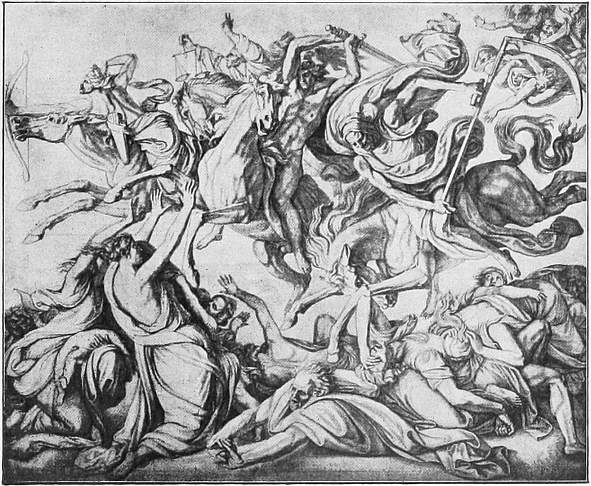 | |
| CORNELIUS. | THE APOCALYPTIC HOST. |
At the same time that Heinrich Hess was carrying on his calligraphic exercises after Raphael and Andrea del Sarto in the Basilika at Munich, Cornelius was making his schoolboy sketches after Michael Angelo. What is great in his master is empty pose in him; what is furia in the former is a laboured imitation in the latter. While the terrific Florentine Master found within himself the expression of his superhuman figures, his learned follower copies attitudes, gestures, groups—familiar to anyone who has been to Italy and passed a few hours in the Sistine Chapel. One seems to hear the old Florentine’s great voice toned down through the telephone, and irritating us with false pathos at moments when pathos is quite superfluous. All the faces are distorted with grimaces, heads of hair are puffed up as though with serpents, garments fly about; people shout instead of speaking, open their mouths wide as though they were giving the word of command to an army, stretch out their arms as though they would embrace the world. A mother bearing a child in her 148 arms squeezes it to death. A cook roasting a leg of mutton bastes it with a Herculean gesture, and a butler emptying a leather bottle has the air of a river-god meditating a flood. In order that his human beings may look vigorous and heroic, he makes them walk in seven-league boots, dislocate their limbs, expand the gigantic measurement of the body far beyond the human. Every head shows a different colouring: one red as sealing-wax, another rose-pink, a third caput mortuum. Added to this, the academic drapery arrangements, those florid garments with their rolling, writhing folds, for which there is no real justification, and which have no use but that of ornament. “Ah,” says Goethe, in one of his letters, “how true it is that nothing is remarkable but what is natural: nothing grand but what is natural: nothing beautiful, nothing, etc., etc., but what is natural.” Michael Angelo is not at all easy to understand; and Cornelius’ study of him resulted in the very same mannerism into which the Dutchmen had fallen three hundred years earlier,—the only difference being that he surpassed them in erudition. But although this quality would no doubt have greatly helped him had he written books, we cannot take it into account in discussing his artistic merits, any more than we can judge Gérard de Lairesse by his literary achievements. Nay, more, as he had elected to confine himself to painting, his erudition became a curse to him, bringing him to disregard beauty of form in a manner as yet unknown in the history of art. Not only was he filled with ardour for the loftier thoughts, without allowing any other forms for their presentation but those which were mere reminiscences of former art periods—he did not even give himself leisure thoroughly to assimilate the forms borrowed from Michael Angelo, and to animate them with fresh life. Hence the fact that, as an artist, he remains greatly below the level of the Dutch copyists, in whose work there is at least no faulty drawing and tasteless colouring to be found. He asked for walls, not as panels to paint on, but as tablets on which to inscribe his thoughts; felt exclusively as a poet, a man of learning, brooding ideas. Engrossed in developing these ideas, he valued form and colour no more than an author would the embellishing of his manuscript with flowing letters and an artistic arrangement of inks. It is only by this means that we can explain the unjustifiable carelessness with which he surrendered his cartoons to his pupils, and allowed them a free hand in the carrying them out, or account for the evanescent colouring in the Glyptothek and in the Ludwigskirche,—a colouring which was even at that time far below the general level, and which could only be excused in the case of a self-trained and quite untutored school.
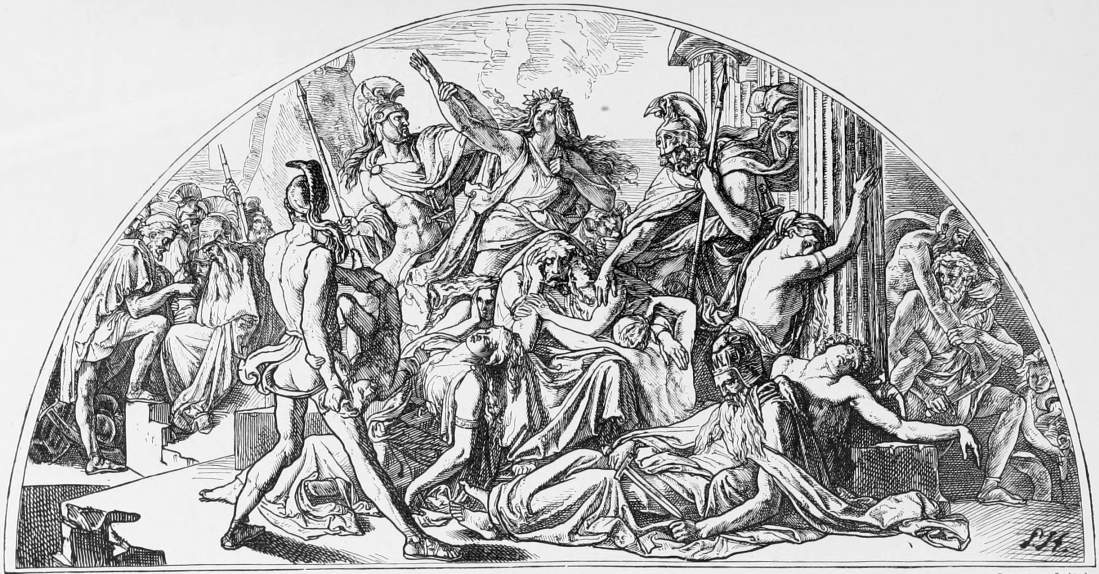 | |
| Seemann, Leipzig. | |
| CORNELIUS. | THE FALL OF TROY. |
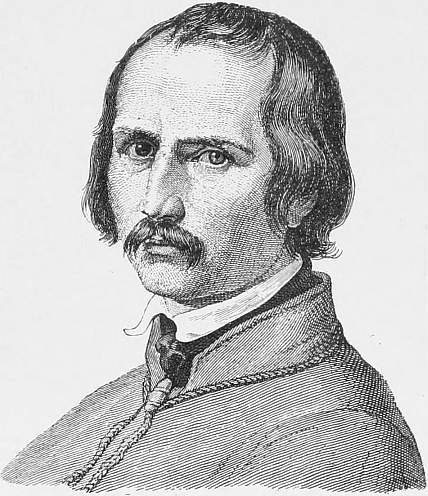 |
| WILHELM KAULBACH. |
A man of this kind, who had nothing to teach that was worth the learning, and who excelled only in intellectual qualities which could not be imparted to others, must needs prove the most dangerous academy-principal Germany has had since she first boasted an academy. So much the more as his pupils readily submitted to the personal fascination of this earnest little man with his black clothes, his pompous appearance, his flashing eagle eye, which made one believe that, Dante-like, he had looked upon heaven and hell. “As there are men born to command an army, so Cornelius was born to be the head of a school of painting,” said King Ludwig. We can scarcely help smiling at Schwind’s account of the trembling awe with which, upon his arrival from Vienna, he presented himself to the master. The red-haired stripling, in his outgrown clothes, timidly strolling round the rooms of the Glyptothek suddenly sees Cornelius himself, high on a scaffolding, in all his glory, in an effulgence such as surrounds the head of Phœbus Apollo. Accustomed to seeing young artists stoop before him, now stammering, now paling, now blushing, the demi-god descends to the level of the unknown mortal. “He is quite a little man, in a blue shirt, with a red belt. He looks very stern and distinguished, and his black, gleaming eyes impress you. He descended from his throne, changed his blue smock for an elegant frockcoat, drank a glass of water with an easy manner, and made my flesh thrill with a short explanation of what had been painted and what was still to be done, tucked a few writing books under his arm, and went upon his business to the academy.”
The reformation of the academy, instigated by him at Munich, demonstrated the one-sidedness of his point of view. He turned it into a school for fresco-painting. “A professorship in genre and landscape painting appears to me superfluous,” he wrote to the king in 1825; “true art knows no subdivision.” But as he himself had only partially mastered fresco painting, he did not even succeed in establishing a school of fresco painters. It was only one of designers of cartoons.
“Read the great poets: Homer, Shakespeare, Goethe; do not forget to include the Bible. The brush has become the ruin of our art. It has led from Nature to Mannerism.” By means of this teaching Cornelius infused all his own defects into his academy, which for that reason was doomed from 152 the outset to an early decease. A war of extermination, often leading to the most burlesque scenes, was declared by the Cornelians against the Langerians, who were despised because they had retained a few of the technical acquirements of the peruke period. When Cornelius’s attention was drawn to the fact that in one of his cartoons he had given a Greek hero six fingers he answered with indifference: “Ay, and if he had had seven, how would it affect the general idea?”
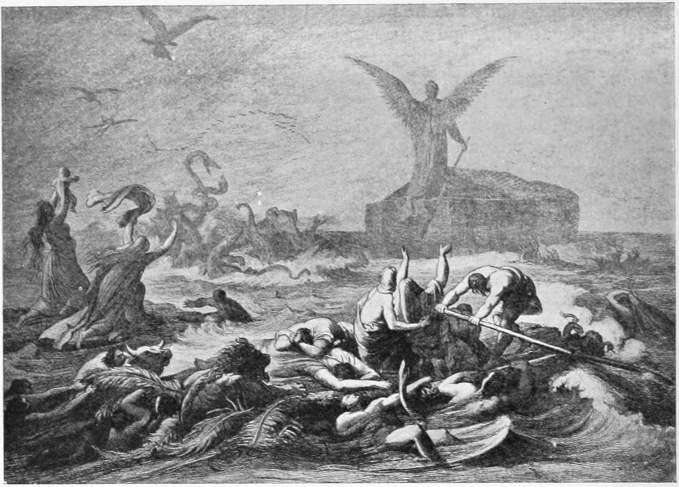 | |
| KAULBACH. | THE DELUGE. |
It was only natural, therefore, that his pupils should feel above using a model. It is said that at the time when they were turning Munich into an Athens, and the painters were covering the city walls with frescoes, Munich possessed but one model, and the poor fellow died of starvation. And then, how they hated colours! They were so difficult to manage! Who, pray, wanted to learn fresco painting by hard labour, and swallow the chalk-dust? It was much easier to copy their lord and master, whose name was on their lips, but not a spark of whose genius was in their heads, with every sort of mannerism. “When nature once produces a new birth she does so with a lavish hand. Talents, talents enough for centuries!” In these words Cornelius himself did honour to his pupils—to Carl Herrmann, Strähuber, Hermann Anschütz, Hiltensperger, and Lindenschmit the elder, the mention of whose names evokes a painful memory of the arcades in the palace garden at Munich.
What survives of Cornelius is only the man, the individual. Posterity will doubtless always honour him for the unflinching energy with which he upheld his ideal from youth to failing age; for his courage in propounding and defending what seemed right to him; for refraining from putting on velvet gloves with the multitude, but frankly showing them his nails. This high-mindedness of Cornelius, and his lofty conception of the aims of art, must always command our respect. All his works are the product of a serene, great, and noble soul. His is a physiognomy with a proud, vigorous profile, which expresses an intellectual tendency, and can never be forgotten. He was a man—as a painter, a curse to German art, but a self-conscious, aristocratic mind. As he himself said: “Art has its high-priests and also its hedge-priests”; and when at the end of his life he made his profession: “Never, under any circumstance of my life, have I lost my pious reverence for the divinity of art; never have I sinned against it,” we none of us refuse to accept his word.
 |
| KAULBACH. PRINCE ARTHUR AND HUBERT. |
This unfailing earnestness which suffuses Cornelius’s work raises him high above Wilhelm Kaulbach, and secures for him lasting fame, when that of Kaulbach shall have been buried with the last of the “cultured” patrons for whom he worked, and by whom he was placed on a pedestal. Look at both of them from a purely artistic point of view, comparing them with the old masters, and both of them sink equally into insignificance. But if we come to accept the problem of art criticism as a matter of psychology rather than of æsthetics, if we search for the relations between the work of art and the soul of its author, we cannot but look upon Kaulbach as by far the inferior. Cornelius endeavoured to raise the masses to his level, paid for his idealism with unpopularity, and was never understood. Kaulbach, the humble servant of the public, changed the Spartan iron of the art of Cornelius for the base coin of the art unions; to tickle the multitude, he clothed voluptuous 154 sensuality in the stately garment of the earnest Muse, and was hailed with jubilation throughout his life. But the valise with which alone, according to the fairy-tale, one can enter upon the journey to immortality, was still lighter in his case. Idealistic painting, as professed by Cornelius, had skimmed all the cream from religious and mythological subjects; so Kaulbach tried to give something more actual in its stead. He found this in the philosophy of history, in the images of epochs in the history of the world which were then so much in vogue, and handed his public, eager for knowledge, a printed programme upon which he had catalogued the gigantic thoughts and even weightier references which the picture was said to contain. As the masses were awed by the severity of the Cornelian conception of forms, he softened it down with superficial calligraphic elegance: what was sturdy and angular in the former was by him changed into a coquettish effeminacy. This he effected by daubing his pictures, which were in no way colour conceptions, with insipid combinations of colour, and replaced with oleographs Cornelius’s illuminated monumental woodcuts. By these concessions to the picturesque he drove the axe into the tree which the designers of cartoons had planted. The part he plays is that of a man of compromise between Cornelius and Piloty; his frescoes are too sugary; his oil-paintings too faulty. It was he who buried the era of cartoons, although the obsequies were conducted with all pomp.
A spiritual battle, an aerial battle, the “Battle of the Huns,” is the first of his works. Beneath, a real historical event; above, the same reproduced in the spiritual world. The battle is over; the field is hidden beneath the corpses of the slain; but the spirits continue the combat in mid-air, and strive to turn the occasion to account for a display of nudity. Next came the “Destruction of Jerusalem,” crammed with ingenious references, and elucidated with long, printed commentaries. This programme-painting played its trump card on the staircase of the Berlin Museum, where a space of 240 feet by 28 feet is occupied by “the intellectual manifestations of the historical Weltgeist”; “the total evolution of culture with every people of every period in its principal historical phases”; those incidents “which, in the evolution of universal history, mark the important knots with which the closely entwined threads of the national dramas of the universe are bound together.” The “Battle of the Huns,” the “Destruction of Jerusalem,” were included in the series; and to them were added the “Tower of Babel,” the “Rise of Greece,” the “Crusades,” and the “Reformation.” The whole of Hegel’s philosophy was reproduced on the walls. But as the pictures are not new through any novelty or greatness of their conception, we need certainly not enter into the “astounding profundity” of their philosophy. The eye is struck with mere compositions, built up according to certain formulas, and tableaux vivants, put together with more or less cleverness, theatrical in effect and crude in colour.
Of his other large pictures, the “Naval Battle at Salamis” caused a special stir through its sinking harem. In his “Nero” he contrasted the orgies of 155 the Romans of the decadence with the enthusiasm for death of the early Christians. Again, in his great cartoon in charcoal of “Peter Arbue,” he inflated to monumental dimensions a drawing suitable for a comic paper.
Kaulbach is not an artist to be taken seriously. Woltmann, who made the same observation twenty years ago, tried at least to vindicate the illustrator, and expressed his regret that a man who had the stuff in him of a German Hogarth should unfortunately have been caught in the toils of the Cornelian school. But this comparison does little justice to Hogarth. There is nothing in the illustrations of Kaulbach which many other artists could not have improved upon. In his “Reynard the Fox” he adapted, for the benefit of the German public, Grandville’s Scènes de la Vie privée et publique des Animaux, published in 1842. His illustrations for éditions de luxe (“The Women of Goethe,” etc.) marked the first steps of the road which ended in Thuman. And Thuman stands higher than Kaulbach. The faint, unaccented drawing, the oval “beauty” of heads, declamatory and expressionless, the academic touch are common to both of them. But only with Kaulbach do we find the penetrating perfume of the demi-monde, the voluptuous, satirical laughter which is not even stilled before Goethe, the pandering sensuality which cannot touch the purest and tenderest figures in German poetry without using them as a pretext to fling nudities to the public like bones to a dog. In his “Dance of Death” suite, Kaulbach turned into frivolity what Rethel had before expressed solemnly and earnestly. Like the two augurs, who could not meet without laughing, so at last the satirical designer began to laugh at his own monumental pictures. After completing in his series of mural paintings at the Berlin Museum his “Apotheosis of the Evolution of Human Culture,” he explained in his friezes that the whole was, after all, nothing but a dustbin and a lumber-room. When he was commissioned to depict a suite of paintings for the upper walls of the new Pinakothek at Munich, the artistic life of that town, as glorified by King Ludwig—a suite which the weather has since been kind enough to render almost invisible—he fulfilled his task by mocking at what he should have glorified.
| “All die Meister Kunstbahnbrecher, wie die Herren selbst sich nennen, Wahrlich Widderköpfe sind sie, Mauern damit einzurennen. Mit dem Loche in der Mauer ist’s noch lange nicht geschehen, Da muss erst der Held erscheinen, siegreich dadurch einzugehen. Gegen jenes Ungeheuer ziehen sie zu Feld mit Phrasen, Wie die sieben Schwaben einstmals ritterlich bekämpft den Hasen. Voran zieht der edle Ritter Schnorr, der Künste Don Quixote, Seine Rosinante setzt er, statt des Pegasus in Trotte; Heiliger Hess, sein Sancho Pansa, Du nicht liebst das offene Streiten, Und du lässt dich sachte, sachte, ’rab von Deinem Esel gleiten. Was ist denn so grosses Neues in der Neuen Kunst geschehen? Nichts, als was sie nicht der aften, längst vergangnen abgesehen. Wände ich auch Lorbeerkränze all um diese Alltagsfratzen, Würden sie sie doch nur zieren zu bedecken hohle Glatzen.” |
This is the commentary written by Kaulbach himself; and Théophile Gautier called the suite un carnaval au soleil. “The king in his youth spent millions in order to elevate art,” says Schwind; “and now in his old age he pays another thousand pounds in order to be laughed at for it.” Heine’s loud, scornful laughter resounds over the grave of romantic literature; and so the “monumental period of German art” ends in self-derision.
Moreover, as the mural paintings of the new Pinakothek, like the frescoes in the Arcades and most of the other monumental products of the period, are falling into ruin, and only show traces of their past beauty in a few faint spots of colour not yet entirely effaced, it is quite clear that it was an inherent fallacy of Cornelius to expect a renovation of national German art from fresco painting. The Venetians of the sixteenth century well knew why they did not take up fresco painting. Monumental painting, as aimed at by Cornelius, must remain an imported plant that cannot possibly thrive in a northern climate; and oil-painting, since the Van Eycks the medium and basis of art-culture among the Teutonic races, took its revenge upon his one-sidedness and his Michaelangelesque disdain, in the fact that at Munich it had to be learnt again right from the beginning.
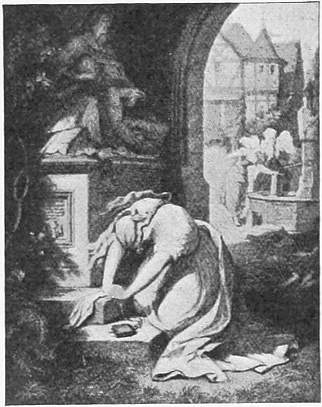 | |
| KAULBACH. | MARGUERITE. |

CHAPTER VII
THE DÜSSELDORFERS
On the Rhine there existed a school of painting instead of a school of drawing, a fact which at that time placed Düsseldorf next in importance to Munich. Wilhelm Schadow, its first director, was lacking in any personal distinction as an artist, but he had received from his great father a tendency towards perfection of technique, which brought him and his school into direct opposition with the purely philosophical painters of the severe Cornelian tradition, and which has even in our days been able to exercise an authoritative influence. In Rome he was the only one of the Nazarenes amenable to the French influence, while the others nervously held aloof from the members of the French Academy. And this formal bent of his talent later gave him the qualifications of a sound teacher. Immediately upon his arrival at Düsseldorf, in November 1826, he was escorted by a stately throng of students: Carl Friedrich Lessing, Julius Hübner, Theodor Hildebrandt, Carl Sohn, H. Mücke, and Christian Koehler, who were afterwards joined by Eduard Bendemann, Ernest Deger, and others. These became the mainstay of the celebrated Old Düsseldorf School, which was soon supported by the jubilant enthusiasm of its contemporaries. At the Berlin exhibitions the new school of painting passed from one triumph to the other. Young men fresh from school suddenly made names that were honoured throughout Germany, by reason of the remarkable manner in which their works succeeded in expressing the sentimental romanticism of the time.
The Wars of Liberty of 1813, which had caused a gust of joyous enthusiasm to penetrate even into the peaceful seclusion of the Nazarenes, were not, like the wars of 1870, the outcome of careful calculation, but the result of a sudden burst of ardour, and the disillusion had now followed upon the enthusiasm. In 1810, with the French bayonets gleaming outside the windows, and the French kettledrums drowning the sound of his voice, Fichte delivered at the Berlin University his famous speeches which sounded the réveillé for Germany. At the same time Kleist wrote his Hermannschlacht: Napoleon was to be treated as Hermann had treated Varus. “Was blasen die Trompeten, Husaren heraus,” pealed through the air; the song of “Got, der Eisen wachsen liess” rose heavenwards in brazen accords. And not long after, the same lions who had beaten the Corsican at Leipzig, and had with Arndt conceived the idea of a great, united fatherland, had once 158 more become the same easy-going people, drinking their beer and smoking their pipes in their little duodecimo principalities as of old. Those dreary times, which saw no prospect of relief in their own days, must needs nourish a devotion to the past. That haughty antiquity, which had been possessed of the ideal to which the present had not been able to attain, became the object of a fanatical adoration. Men lost themselves in the old storehouses of faded German reminiscences, and fled for inspiration to the times of a consolidated German Empire. This return to the ruins of the past was a protest against the grey, colourless present. The patriotic frenzy of the poets of freedom changed into enthusiasm for the vanished glories of mediæval Germany. They remembered with longing and yearning the days when the robber-knights ruled town and country from their strongholds. Schenkendorff sang hymns inspired by the old cathedrals, rummaged with holy horror among the skeletons of knights and heroes in the chapel, and wrote a poem in memory of the thousandth anniversary of the death of Charlemagne; Arndt, the bard of the wars of freedom, violently attacked the “industrialism” of the time, declaiming against steam and machinery; Zacharias Werner composed his poem, “Das Feldgeschrei sei: alte Zeit wird neu.”
This revival of romanticism opened up a wide field to science and poetry. The apotheosis of the old imperial times was made manifest amid fairy-like glamour. Poetry grasped the pilgrim’s staff, or rode with beauteous dames on milk-white palfreys through forest and glade. Enchanted genii, elves, fairies, and goblins were encountered on the road. Nowhere is there so sweet a scent of blossoms, so innocent a sound of children’s merriment, as in Tieck’s delightful and dainty fairy-tales, or in the works of Clemens Brentano, those precious stories of Father Rhine, of the water-nymphs and the crystal castles at the bottom of the green current, pictures full of charming wilfulness, dreamily winsome, like summer evenings on the Rhine. Uhland sang, as once had sung the knightly poets with the golden harps—
| “Von Gottesminne, von kühner Helden Muth, Von lindem liebesinne, von süsser Maiengluth.” |
To this day we seem to peep between the weather-beaten castles, standing on their grey rocks along the Rhine Valley, into the realm of romance as into an enigma propounded by mountain and dale. Rhine and romance!
No spot in Germany was better fitted to become the cradle of a romantic art than Düsseldorf, the peaceful town on the legend-haunted banks of the green river. In the fifteenth century, in addition to the school of Florence, where flowed a rich current of political and human life, where great buildings, monuments, and frescoes kept architects and sculptors and painters uniformly busied, there existed in the remote Umbrian valleys, in the land of miracles and visions, that school of painting in oils which saw its only eternal ideal in the deep eyes and soft aspect of the Madonna, and made the visionary aspirations of the soul, emotions, and sentiment the exclusive subject of 159 their pictures. In the same manner, in the nineteenth century, we find in contrast with the Munich school, with its numerous architectural products, its massive statuary, and the epic-dramatic fresco painting of Cornelius—“wedding the German to the Greek, and Faust to Helen”—that lyrico-sentimental Düsseldorf school of painting which embraced Madonnas and prophets, knights and robbers, gipsies and monks, water-nymphs and nuns with the same languishing tenderness. In matter and technique it completes the art of Cornelius and the Nazarenes; that of the Munich master by its encouragement of oil-painting; that of the Nazarenes by the stress which it lays upon the more worldly side of mediæval life, upon chivalry, and in a less degree upon that other pillar of mediævalism the Church. The Nazarenes are archæological and ascetic; the Düsseldorf school is insipid in a modern way, feeble, colourless, and sentimental.
Count Raczynski and Friedrich von Uechtritz have given us interesting descriptions of life at Düsseldorf at that time, and their story reads like a chapter of Tacitus’ Germania. “Grand dieu! Bons et affectueux allemands!” exclaimed a Parisian critic of the Count’s book in sad emotion, and held up this virtuous German life, as an example worthy of imitation, to his compatriots, the decadents of fashionable artistic Paris, fallen into modern luxury. Undisturbed by the hum of a big city, and without any communication with its surroundings, the Düsseldorf colony of artists lived its life of seclusion. The painters saw none but painters. They herded together in the studios, and the sole recreation in the intervals of their work was a visit to another studio. The whole of the day was devoted to painting; when the picture was complete it went to the art union; and the hours of tediousness were overcome with the assistance of a little intrigue. Hildebrandt possessed the nucleus of a collection of beetles. Lessing, the hunter, collected pipes and antlers, and only felt himself at home in the little room which he occupied with Sohn when it assumed the appearance of a gamekeeper’s cottage. Convinced that politics were the ruin of character, they allowed no questions of the day to interfere with the calmness of their artistic life. Few of them ever read a newspaper. In the year of revolution, 1830, their sole interest in the events around them was concentrated in the fear that a war might disturb their idyllic life. The end of the day’s work saw them in summer-time bent on a pilgrimage to the Stockkämpchen, to refresh themselves with a cup of buttermilk, to play at bowls, or to enjoy a race among the cabbage patches of the garden. In winter they made a point of meeting at seven o’clock every Saturday night at the inn for a literary reading. Each taking his part they recited the dramas of Tieck, of Calderon, and Lopez; or Uechtritz read extracts from German history, the Crusades, the period of the emperors, the riots of the Hussites. Every Sunday night there met at Schadow’s a very distinguished intellectual circle, consisting of Judge Immermann (the reformer of the stage at Düsseldorf), Felix Mendelssohn the composer, Kortum, author of the Jobsiade, and Assessor 160 von Uechtritz, with their ladies. But the great gala-days were the theatrical performances which took place twice a week. Under the leadership of Immermann the theatre had become the place whence the young painters gathered their liveliest suggestions. Some of them went even so far as to take part in amateur performances, conducted by Immermann, and given in Schadow’s house, under the auspices of the whole of the distinguished society. And thus the pictures of this school were not conceived under the influence of life, but of the theatre. The Düsseldorf artists were youths whose productions were not rooted in life, but in reading and culture; youths who always moved in good society, and who had passed through the great ordeals of life, but only on “the boards representing the universe.”
Theodor Hildebrandt became the Shakespeare of Düsseldorf. The translation of the works of the English poet by Schlegel had been published some time earlier, and Immermann, in Düsseldorf, had been the first to offer Shakespeare a home on the German stage. The performances of his tragedies were regarded as red-letter days. During the three years of Immermann’s leadership (1834-37), Hamlet, Macbeth, King John, King Lear, The Merchant of Venice, Romeo and Juliet, Othello, and Julius Cæsar were performed on fifteen occasions in all.1 To give the titles of these plays is at once to characterise the subject-matter of Hildebrandt’s paintings. He very often had a hand in the staging of the plays, and is said to have shown a remarkable histrionic talent in the performances at Schadow’s. He rarely went to other poets for his inspiration, as in his “Pictures from Faust” and his “Beware of the Water Nymph,” where he honoured Goethe, and in his “Brigands,” where he may have been inspired by one of the many variations on Rinaldo Rinaldini that flooded the market at the time, or perhaps also by Byron, whose influence was very marked on the Düsseldorf school.
Goethe’s Frauengestalten, more especially the Leonoras, were reproduced in oils by old father Sohn. Eduard Steinbruck painted Genevièves, Red Riding Hoods, Elves, and Undines, after Tieck and Fouqué; H. Stilke’s “Pictures from the Crusades” introduced Walter Scott to the German public. Uhland’s first ballads had brought into fashion the damsels who from the ramparts of their castles wave a sad farewell to the lonely shepherds; the ancestral tombs, in which the last knight of his race takes his everlasting rest; the lists, where melancholy heroes stab themselves. His Love-song of the Shepherd to the Shepherdess—
| “Und halt ich dich in den Armen Auf freien Bergeshöhn, Wir sehn in die weiten Lande Und werden doch nicht gesehn,” |
gave Bendemann the motive for his picture of the same name. Young Lessing had to thank Uhland for the subject of his first success, “The Sorrowing 161 Royal Pair,” which at one bound made his name one of the most honoured in German art.
| “Wohl sah ich die Eltern beide Ohne der Kronen Licht Im schwarzen Trauerkleide, Die Jungfrau sah ich nicht.” |
After Bürger he painted a Leonora—of course in so-called mediæval costume, in order “to avoid the unpicturesque attire in fashion during the Seven Years’ War”; and at the same time as Hildebrandt, “A Mourning Brigand,” who, in the full light of the evening sun, sits brooding on a rock over the depravity of the world. That all of them were frantically enthusiastic for the Hohenstaufens is due to the publication of Von Rainer’s History in 1823, which took a greater hold of the public than did Schiller’s History of the Thirty Years’ War, and inspired numerous dramas.
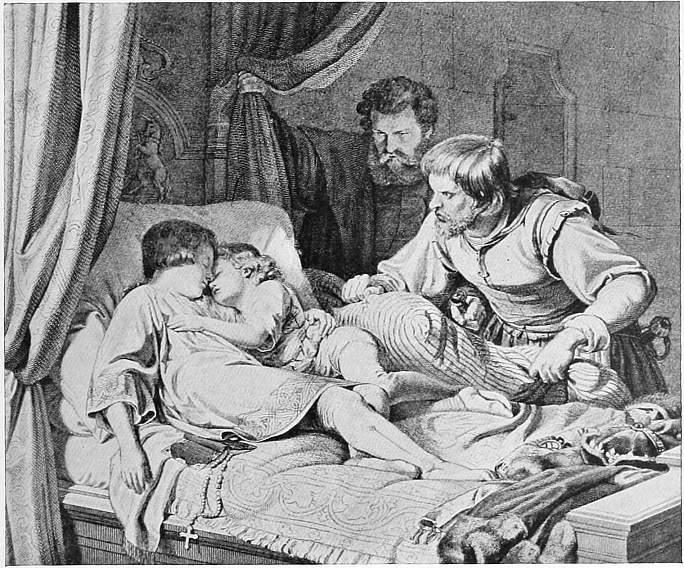 | |
| HILDEBRANDT. | THE SONS OF EDWARD. |
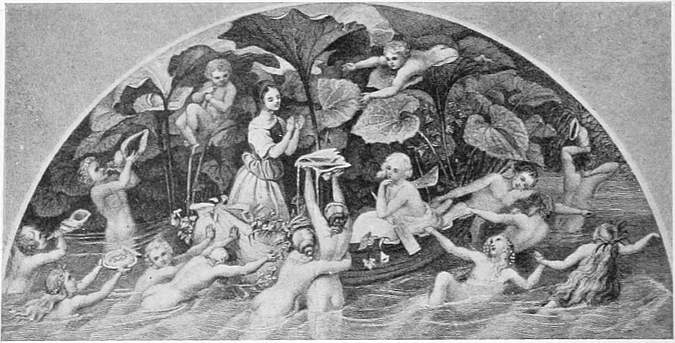 | |
| STEINBRUCK. | ELVES. |
Even the idyllic and touching scenes from the Old Testament and the Hebrew elegies are easily traced back to theatrical inspirations. With the 162 exception of the frescoes of the Casa Bartholdy, the subjects of which were selected with an eye to the religious belief of their purchaser, the Nazarenes found all the subject-matter they wanted in the New Testament. The Passion of Our Lord was unable to inspire the Düsseldorf school. As compared to the few Christian paintings by W. Schadow, and the dreamy Madonnas of Deger, Ittenbach, and little Perugino Mintrop, we find a far greater number of scenes from the Old Testament, which at the time gave birth to numerous dramas. Hübner, always inclined to idyllic and melancholy scenes, painted Ruth and Boaz, his first great picture, which established his reputation. After Klingemann had utilised the whole life of Moses by turning it into a theatrically effective sequence, Christian Koehler scored a success with his “Moses hidden in the Bulrushes” and his “Finding of Moses,” and then, incited by Raupach’s “Semiramis,” abandoned his biblical heroines for Oriental ones. Theodor Hildebrandt took Tieck’s “Judith” as an inspiration for his picture of this Jewish heroine. Kehren’s “Joseph reveals Himself to his Brethren” was begun after the opera Joseph in Egypt had been performed at Düsseldorf. Bendemann, in 1832, played his trump card with his “Lament of the Jews,” now in the Cologne Museum, after Byron had made his propaganda, suggested by the sad lives of the children of Israel, and Friedrich von Uechtritz had caused his drama, The Babylonians in Jerusalem, to be performed, ending as it does with the sending of the Jews into captivity in Babylon—
| “Wein’ über die die weinen fern in Babel, Ihr Tempel brach, ihr Land ward, ach! zur Fabel! Wein’! es erstart der heil ’gen Harfe Ton, Im Haus Jehovas haust der Spötter Hohn.” |
And his oil-paintings of a later date, “Jeremiah on the Ruins of Jerusalem” (1834), now in the German Emperor’s collection, and the “Sending of the 163 Jews into Captivity in Babylon” (1872), in the Berlin National Gallery, were variations on the same theme.
The productions of the Düsseldorf school were thus in perfect harmony with the programme issued by Püttmann in his book. Pictorial representations may be taken from two ranges, History or Poetry; the painter may choose an historical fact as a subject for representation, or reproduce in visible form the rhythmically shaped fancy of a stranger. History shows him figures full of expression, and even a less powerful artist will find it possible to make a true copy of them. If the painter works from poems his representations are sure to meet with approval, as they render the beautiful and the attractive in visible shape. “But the greatest success lies in store for those works which depict in harmony with the mood of the times historical or poetical performances which express human suffering in its various stages, from homely and everyday griefs to the silent sorrow of irretrievable catastrophe.”
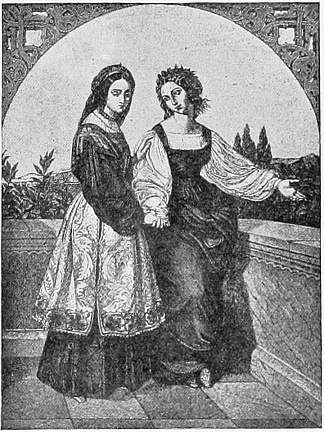 |
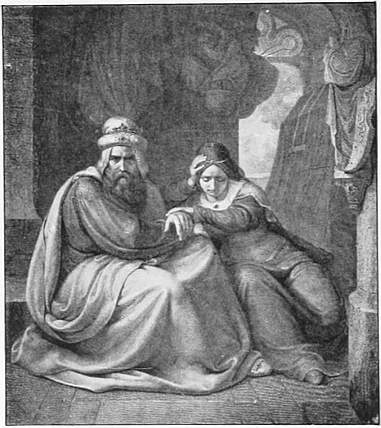 | ||
| SOHN. | THE TWO LEONORAS. | LESSING. | THE SORROWING ROYAL PAIR. |
Thus the scale of sorrow from sad melancholy to painful suffering became the speciality of the Düsseldorf school. At the foot of the scale we find the pictures which “represent the common, yet keen sorrow of parents at the death or the sad future of their children.” Lessing’s “Royal Pair” mourn the death of their daughter; Hagar grieves because she is forced to abandon her son Ishmael in the desert; Genoveva, because the roe is so long in coming to the rescue. The mortal grief of love is represented by Lessing’s “Leonora”; grief of love at separation by Sohn’s and Hildebrandt’s pictures of “Romeo and Juliet.” Even the murderers of the “Sons of Edward” mourn at their crime when they see the children—
| “Girdling one another Within their innocent alabaster arms: Their lips were four red roses on a stalk, Which in their summer beauty kissed each other.” |
Job grieves at the downfall of his house; Hübner’s “Ruth,” because her weeping mother-in-law entreats her to depart; Stilke’s “Pilgrim in the Desert,” because his horse has died of thirst; Plüddeman’s “Columbus,” because he knows himself to be unworthy of the grace of God which enabled him to discover America; Kiederich’s “Charles V”, because he has retired 164 too early to his monastery, and is plagued by the ticking of his watch. The Hohenstaufens, of course, appealed more to the pity of the public: the misfortunes of the beautiful Enzin, of Manfred and Conrad, gave birth to a sentiment of profoundest sadness. Even brigands mourn at the depravity of the world. The age had come to despise its own Philistine situation so deeply that it looked up to the brigands, the adversaries of civil order, as to representatives of justice. All depravity, it was said, originated with the public functionaries, and to the noble brigands was allotted the task of revolutionising existing things. Their ally in this was to be the poacher. At a time when a revision of the game-laws was the sole timid wish the people ventured to lay before its princes, it was only logical that the poacher should be looked upon as the victim of injustice, as the rescuer of the small man from the claws of feudal despotism. The numerous pictures that glorify him, as he falls weltering in his blood beneath the guns of the gamekeepers, make pendants to Raupach’s “Smugglers,” and to the rest of the highly esteemed literature which turned the life of the poacher into sentimental dramas or novels.
Fortunately we, in our days, find great difficulty in entering into the spirit which gave birth to these productions. A world lies between it and the present, just as between the Germany of to-day and the Germany of 1830. Men of the younger generation, who were still at school when Bismarck spoke his word of blood and iron, can hardly understand how this modern, realistic Germany can have been, two generations ago, a sentimental Germany. Now the significance of the Düsseldorf school in the history of civilisation lies in the fact that they are the real representatives of that age of sentimentality. A generation that melted away in tearful dreamings must needs enthusiastically recognise its own flesh and blood in those knights and damsels, squires and pages, monks and nuns, who, infinitely amorous or infinitely religious, were all infinitely sentimental; and things that now only evoke a smile or a shrug must needs have moved them to tears. Look where you will, you meet the same world. It hung on the walls, it displayed itself in engravings, lithographs, and coloured prints; if one lay down for a siesta, one found a 165 lovelorn knight and damsel or a praying nun stitched on the cushion; if one put one’s foot on a carpet, one trod upon noble hunting-dames on horseback, falcon on wrist; one carried them in one’s pockets on cigar-cases and handkerchiefs; the traveller and the cheap tripper took them abroad on their knapsacks.
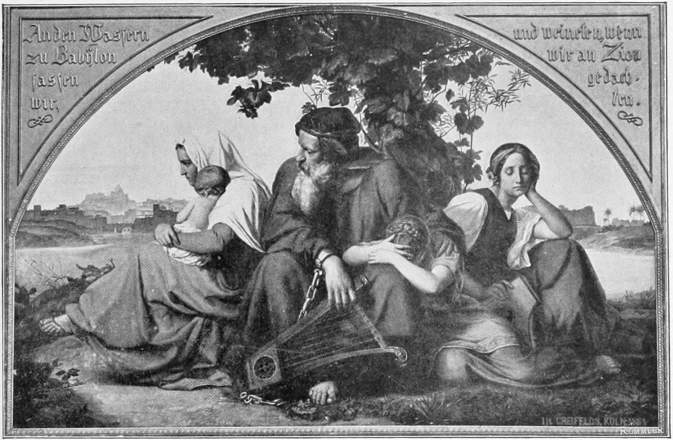 | |
| Seemann, Leipzig. | |
| BENDEMANN. | THE LAMENT OF THE JEWS. |
Technically, the pictures of this school were not without their merits. “The greatness of Michael Angelo” may not have been Bendemann’s, and Sohn’s carnations are far removed from “the melting colouring of Titian.” But as opposed to the one-sidedness to which fresco painting at Munich was given up, the encouragement of oil-painting at Düsseldorf must be looked upon as praiseworthy. These painters were the first in Germany to try again to learn how to paint in oils. The extreme artistic clumsiness that had reigned under Cornelius was followed by a period in which, under Schadow, earnest studies and serious work were devoted to an effort again to master a technical medium. Their friendly emulation led to surprising progress, which assured to the Düsseldorf school a technical superiority over all the other German schools of the period.
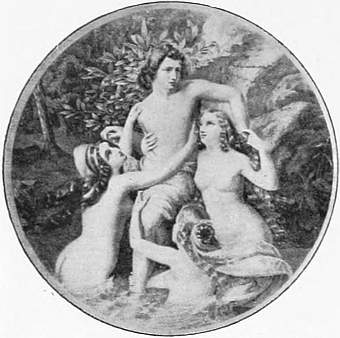 |
| SOHN. THE RAPE OF HYLAS. |
If, nevertheless, their pictures have not maintained their position as vital works of art, it is due to the fact that they were produced under the pressure of that mechanical idealism which makes all their productions so utterly unattractive to us. The ideal “line of beauty” has turned the figures into bloodless shadows and washed-out theatrical forms. As philosophy 166 was to Cornelius, so to the Düsseldorfers was poetry their Noah’s Ark. The interest aroused by the poet was their ally; the breath of the wind that set their boat afloat; the general poetical tendency made up for the deficiency in artistic interest. Had it not been for the support of the poets, their sugary, insipid figures would have from the beginning been unable to hold their own. For after having been retouched by “Idealism,” nothing vital remained in those romantic kings, fantastic knights, Jews, and stage princesses; nothing particular and characteristic in their generalisation, nothing generally human. With them a king is always an heroic prince in black harness, a woolly beard, and a scarlet cloak. A queen is represented as proud and dark, or tender and fair-haired. In the much-beloved “couples” from poems, characterisation goes no further than general contrasts: the brunette in red attire with white sleeves; the tender blonde with the complementary garment of pale violet; the one with luxurious embonpoint, the other languidly slender—men brown, women white, youths rosy. Knights wear silvery helmets with or without plumes; now with open, now with shut visor; sometimes they sit on poetic palfreys, now of slender, now of sturdy build. The only impressions they are subject to may be interpreted with the assistance of the plaster bust: honour, fidelity, love. And as sentiment and heroism are national virtues of the Germans, they are bound to show sentimental expression whilst killing their adversaries. Even the brigands are generalised lay figures. The Düsseldorf ideal of beauty aimed at a certain tender, vaguely graceful swing of outline that anxiously avoided all manly and strong, energetic and characteristic expression, all that could remind one of nature. They rejected Leonardo da Vinci’s advice, to tug at the nipple of Mother Nature, but looked upon her merely as their aunt; and for this, despised Nature took her revenge by making their figures shapeless and phantom-like. And as their “dread of painted stupidities” did not once bring them to make bold mistakes, we can neither praise nor censure their pictures, cannot enjoy them or take offence at them, but look at them sine ira et studio, with a lukewarm feeling of utter indifference.
1 As is still the case in most of the German theatres, the programme changed every night. Two or three consecutive performances of one play remain a rarity.

CHAPTER VIII
THE LEGACY OF GERMAN ROMANTICISM
It was reserved for two younger men to reach the aim that hovered in the far distance before Cornelius and the Düsseldorfians. And, by one of fortune’s remarkable freaks, the greatest German monumental painter of the nineteenth century came from the Düsseldorf, the greatest Romanticist from the Munich school.
Alfred Rethel was twenty-four years old when he received the commission to paint the frescoes in the Kaisersaal at Aachen, and had previously worked in the Düsseldorf Academy, and then with Veit at Frankfort. But the pictures are suggestive neither of his Düsseldorfian nor of his Nazarene training. The deeds of Charlemagne, the ancestor of the German Imperial dynasties, are nobly, and, at the same time, vigorously embodied in them. Rethel had studied the harsh strength of his Albrecht Dürer, but only as a kindred spirit studies his kin. Neither Cornelius nor Schnorr has depicted the old German heroic might and the vanished imperial grandeur, the great past, the iron Middle Ages, with such notable traits. How plain in his heroic greatness stands the mighty conqueror of the Saxons by the overthrown pagan idols; how simply and majestically does he march into conquered Pavia. What an inexorable and irresistible warrior he seems, as he rages amongst the Moors who flock round the cars of their idols; and with what grave phantom dignity does he gaze in death upon the young Emperor Otto, who has forced his way into his vault, and kneels trembling before the lifeless frame of his great forefather. There is no vestige of pose, nothing superfluous; everywhere simplicity, compression, lucidity. Only what is necessary is inscribed here, in the lapidary style. No meaningless phrase interrupts his narrative; the inner meaning is never sacrificed to any external beauty of line; his forms like his thoughts are severe and precise. He draws with a sure hand in crisp lines, like a writer who aims at the utmost brevity and so lays especial emphasis on his sentences and words. The self-revelation in these pictures is admirable—the illuminating clearness with which they tell what they have to say without the aid of any commentator, the directness with which they present in an artistic aspect the substance to be given. And with this substance the painting corresponds.
It is to be deplored that Rethel himself could carry out in colour only four of his designs, and that the completion of the rest was entrusted to the painter 168 Kehren, who spoilt by his effort after charm of colour the collective impression of the series. The pictures painted by Rethel himself are, in the simplicity of their colouring, in remarkable accordance with the powerful style of his drawing. Rethel’s painting has something stern and grey, bare and sombre. He belongs to the stylists whose implement is rather charcoal than the brush; but he had, although no colourist, a free command of colour, and never committed any fault of taste, but with a remarkably sure instinct used colour in the mass, simply, but yet with significant effect. He might have been the man to create a monumental German art. A tragic destiny! Heinrich von Kleist, the greatest German poet of the post-classical age, who was chosen for so high a vocation, the creation of a new dramatic style, shot himself; and the giant, Alfred Rethel, was to end in madness. Barely forty years old was he when he walked by the warder’s side in the courtyard at Düsseldorf, picking up flint-stones, a poor, simple madman. Only two series of designs ensure, apart from the frescoes at Aix, the immortality of his name: “Hannibal’s Passage over the Alps,” and the “Dance of Death.” As a draughtsman, just as a painter of frescoes, he is the same Titan, sounds the same stern, manly note.
Here the heroic hosts of the Carthaginians stand anxious, yet resolved, at the foot of the grim Alpine pass; steep, beetling cliffs, precipice, ice and snow, tower before them. Now the climb begins, and the struggle with the fierce, barbaric folk of the mountains, who swing themselves on leaping-pole like wild animals over the gaping crevices in the ice. Yonder are men, horses, an elephant, hurled into the abyss; some have spitted themselves on jagged branches of trees in their fall, others twine themselves together in horrible coils; at last the most advanced have reached the heights, and the heroic figure of the commander points out proudly to them, as they breathe once more, the plains of Italy.
Over his second work there broods the shadow of that mental darkness which was to surround him. When, in the year 1848, the political storm burst over the soil of Europe, Rethel’s fantasy reaped a rich harvest. He drew his “Dance of Death,” represented Death the Leveller, who drives poor fools behind the barricades. The ghostly and spectral, that horror of death that breaks in upon us in the midst of life, had been the propensity of German art since Dürer and Holbein. Like them, Rethel loved the world of the diabolical, and similarly chose for his embodiment of it the sturdy, simple contours of the old German wood engravings. Death as the hero of revolution makes a commencement. There he rides as the town-executioner, a cigar between his lips, his scythe in his hand. He sits shambling in the saddle, his smock and tall boots dangle on his bony figure. Dressed like a charlatan, he excites the people before the tavern against the rulers, that he may earn his harvest at the barricade. He himself stands firm and proud, like a general on the field of battle, the flag in his hand, and the bullets of the soldiers whistling harmlessly through his bony ribs. But the artisans who follow him are 169 not invulnerable as he is; the grape-shot sweeps them down off the barricade. The contest is over; triumphant, with a wreath of bay round his skull, mocking venom in his glance, Death rides with his banner unfurled across the barricade, where the dying writhe in their gaunt death-struggle, and children bewail their fallen fathers. The plate, “Death as the Assassin,” takes up the story of the outbreak of cholera at a masked ball in Paris. In terrified haste the dancers and musicians leave the hall. Only one mummy-like spectre, the Cholera himself, a shape of horror, keeps his ground, as though turned to stone, and holds the triumphant scourge like a sceptre in his bony hand. Death, in a domino, with two bones for a fiddle, plays a call to the dance; and beneath the awful sounds of his tune the people, stretched on the ground, in sick convulsions, grinning with distorted features, behind their jesters’ masks, twist and turn.
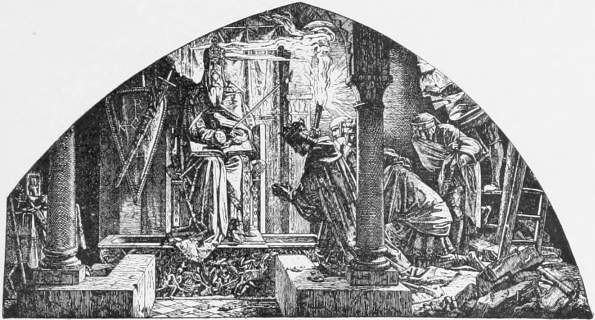 | |
| RETHEL. | THE EMPEROR OTTO AT THE TOMB OF CHARLEMAGNE. |
There is something of Th. A. Hofmann’s wild fantasy of the ague-fit in this picture,—something morbid, satanic, that suggests Félicien Rops; yet, at the same time, something so pithy and virile, and in form so compressed, well-balanced, and correct, that it brings the old Germans, too, to our recollection. And the reconciliation with which the series ends is pathetic. In the high steeple, lit by the rays of the setting sun, the grey old bellringer, his worn hands clasped in prayer, has fallen quietly asleep in his armchair. A calm peace rests upon his good, old, devout countenance. The thin hands, with their marks and furrows, tell a long tale of hard work, sorrow, and longing for rest. And the weary veteran has made a pilgrimage for the health of his poor soul, as prove the pilgrim’s hat and staff by the wall; and now Death has really come, the well-known presence indeed, but this time with no grin of mockery, rather in profound pity. In his ingenious manner of giving an expression of mockery, cold indifference, or compassion to the 170 head of the skeleton, Rethel stands on a level with Holbein. To the old ringer, Death, who before had grinned so diabolically, is a gentle and trusted friend. Quietly and pensively he performs the task that the old man has done so often when he attended the departure of some pilgrim of earth with the solemn notes of his bell. Rethel himself had still to drag through many years in an obscure night of the spirit before for him, too, Death, as the friend, rang the knell.
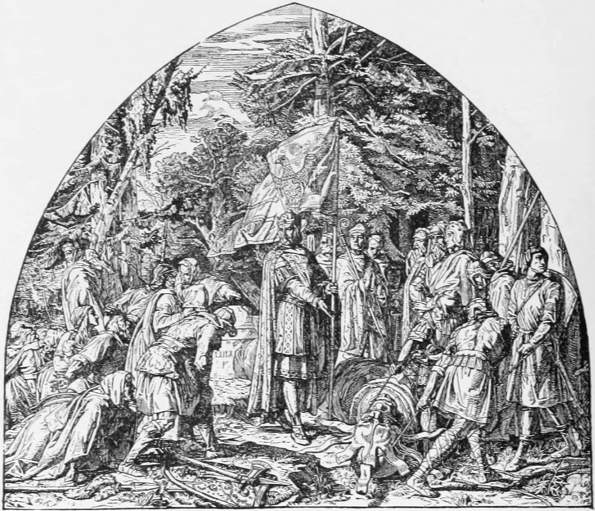 | |
| RETHEL. | THE DESTRUCTION OF THE PAGAN IDOLS. |
And now for him who was the most admirable of them all, Lady Adventure’s true knight.
“Master Schwind, you are a genius and a Romanticist.” This stereotyped compliment was paid by King Ludwig to the painter on each occasion that, without buying anything of him, he visited his studio. And with equal regularity Schwind, when he had sat down again at his easel, after the royal visit, to smoke his pipe, is said to have muttered something extremely disloyal. In this trait the whole Schwind is already revealed,—free from all ambition, every inch an artist.
W. H. Riehl has described a series of such episodes, which one must know in order to understand Schwind, that highly gifted child of nature, who separates himself from the group of philosophical, “meditative” artists of his 171 age, both as an individual and as an audacious, original genius of effervescent wit.
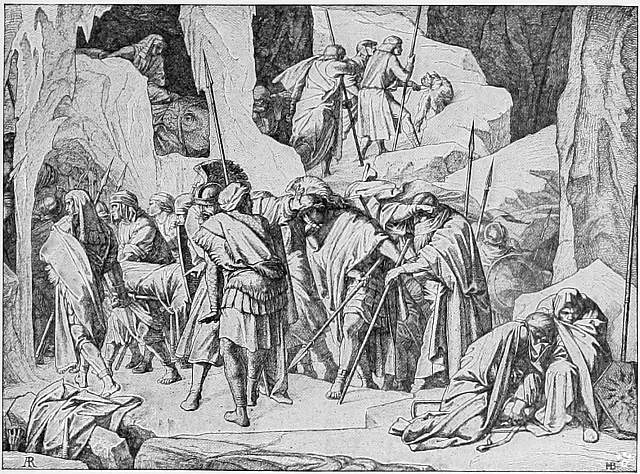 | |
| Seemann, Leipzig. | |
| RETHEL. | HANNIBAL’S PASSAGE OVER THE ALPS. |
When an æsthetic once hailed him as “the creator of an original, German kind of ideal, romantic art,” Schwind repeated very slowly, weighing each word: “’An original, German kind of ideal, romantic art.’ My dear sir, to me there are only two kinds of pictures, the sold and the unsold; and to me the sold are always the best. Those are my entire æsthetics.” Or a noble amateur comes to him with the request that he would take him just for a few days into his school, and instruct him especially in his masterly art of drawing in pencil. Whereupon Schwind: “It does not require a day for that, my dear Baron; I can tell you in three minutes how I do it, I can give you all the desired information at once. Here lies my paper,—kindly remark it, I buy it of Bullinger, 6 Residenz Strasse; these are my pencils, A. W. Faber’s, I get them from Andreas Kaut, 10 Kaufinger Strasse; from the same firm I have this indiarubber too, but I very seldom use it, so that I use this penknife all the more, to sharpen the pencils; it’s from Tresch, 10 Dienersgasse, and very good value. Now, I have all these things lying together on the table, and a few thoughts in my head as well; then I sit down here and begin to draw. And now you know all that I can tell you.” Again he asks “to be decorated with an order,” because he “is ashamed to mix in such a naked 172 condition with his bestarred confrères,” and after the bestowal of the desired decoration he says: “I wore it only once, at the last New Year’s levée, but I vowed at the same time that six horses should not drag me there again. Before, there was at any rate a beautiful queen there, and then the court ladies laughed at one; but amongst men only, the stupidity of it is not to be endured.” When he grumbles over commissions which have been given to others, and adds good-temperedly, “Indeed, I’m an envious fellow”; when he paints the most delicate pictures and then growls, “What am I to do with the things, if nobody buys them?” when he indulges in outbursts of wrath, and a minute later has forgotten again the abusive words which the others spitefully bring up against him years afterwards,—then here, too, his happy humour forces its way everywhere, that divine naïveté which forms the soul of his and of all true art.
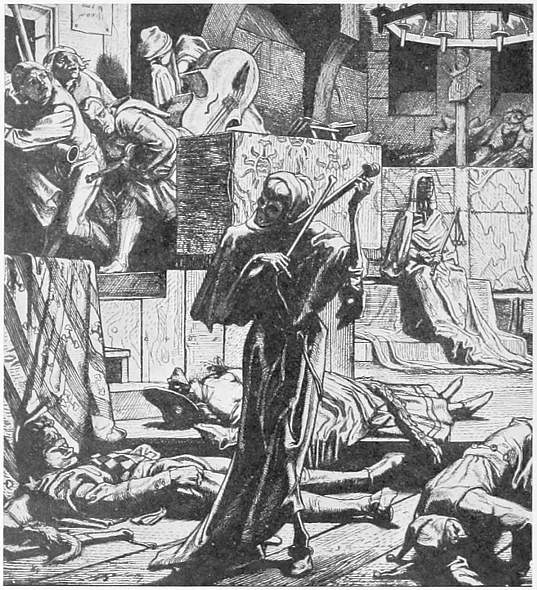 | |
| RETHEL. | DEATH AT THE MASKED BALL. |
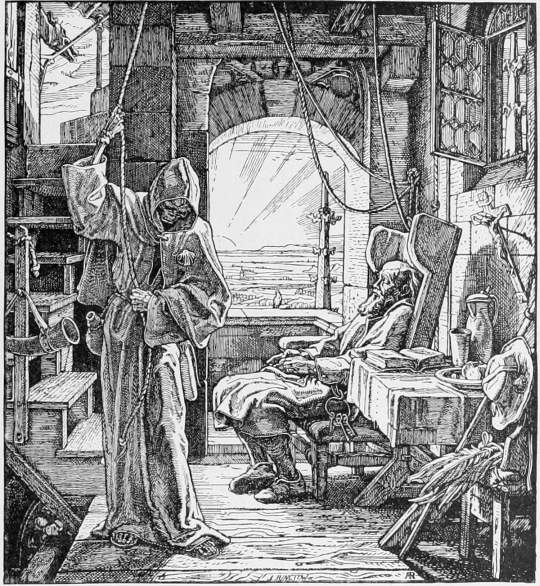 | |
| Seemann, Leipzig. | |
| RETHEL. | DEATH THE FRIEND OF MAN. |
Schwind remains a personality by himself—the last of the Romanticists, and one of the most amiable manifestations in German art. He was free from 173 the malady of that sham Romanticism which sought the salvation of art in the resurrection of the Middle Ages, misunderstood, and grasped sentimentally, and as it were by stencil. He was spiritually permeated by that which had given Romanticism the capacity to exist: the sense of that forgotten and imperishable world of beauty which it has again discovered. The others sought for the “blue flower,” Schwind found it; resuscitated in all its faëry beauty that “fair night of enchantment which holds the mind captive.” He incorporated the romantic idea in painting as Weber did in music, and his works, like the Freischütz, will live for ever. Many a man listened to him holding forth upon water-nymphs, gnomes, and tricksy kobolds, as of beings of whose existence he appeared to have no doubt whatever. On one occasion, while out walking near Eisenach in the Annathal, a friend laughingly observed to him that the landscape really looked as if gnomes had made the pathway and had had their dwellings there. “Don’t you believe it was so? I believe it,” answered Schwind in all seriousness. He lived in the world of legend and 174 fairy-tale. If ever a fairy stood beside the cradle of a mortal man, assuredly there was one standing by Schwind’s; and all his life long he believed in her and raved about her. Born in the land where Neidhart of Neuenthal had sung and the Parson of the Kahlenberg had dwelt, to his eyes Germany was overshadowed with ancient Teutonic oaks: for him, elves hovered about watersprings and streams, their white robes trailing behind them through the dewy grass; a race of gnomes held their habitation on the mountain heights, and water-nymphs bathed in every pool. In him part of the Middle Ages came back to life, not in livid, corpse-like pallor, but fanned by the revivifying breath of the present day.
For that is what is noteworthy about Schwind; he is a Romanticist, yet at the same time a genuine, modern child of Vienna. There are three things in each of which Vienna stands supreme: hers are the fairest women, the sweetest songs, and the most beautiful waltzes. The atmosphere of Vienna sends forth a soft and sensual breath which encircles us as though with women’s arms; songs and dances slumber in the air, waiting only for a call to be awakened. Vienna is a place for enjoyment rather than for work, for pensive dreaming rather than for sober wakefulness of mind. Moritz Schwind was a child of this city of beautiful women, songs, and dances, as may be observed in the feminine nature of his art, in its melody and rhythm: in music, indeed, it had its source. In song-singing, bell-ringing Vienna it was difficult for him to guess in what direction his talents lay; but all his life long he kept an open eye for the charms of beautiful womanhood. No artist of that time has created lovelier forms of women, beings with so great a charm of maidenly freshness and modest grace. Instead of the goddesses, heroines, and nun-like female saints, whose appearance dated from the Italy of the Cinquecento, Schwind depicted modern feminine charm. The group of ladies in “Ritter Kurt” is, even to the movement of their gloved fingers, graceful in the modern sense. He was a painter of love—a breath of Walter von der Vogelweide’s ideal perfection of womanhood pervades his pictures.
| “Durchsüsset und geblümet sind die reinen Frauen, Es ward nie nichts so Wonnigliches anzuschauen, In Lüften, auf Erden, noch in allen grünen Auen.” |
Schwind, too, painted frescoes, and in them he is very unequal. All his life long he complained of the lack of important commissions; it was fortunate for him that he did not get more of them. Such a painter as he can execute no orders but his own,—just as good poems do not come to order. A long list of wall paintings—the Tieck room and the figure-frieze in the Habsburg Hall of the new palace at Munich, the frescoes in the Kunsthall and in the Hall of Assembly of the Upper House at Karlsruhe, those in the Castle of Hohenschwangau, even the theatre pieces in the loggia and in the foyer of the Vienna Opera House—could be easily struck out of Schwind’s work, without detriment to his reputation. Only when the subject permitted him to strike a simple note of fairy music was he charming even in his wall-paintings, and therefore 175 those which depict scenes from the life of St. Elizabeth in the Wartburg are rightly the most celebrated. Like Rethel in the field of the heroic, so Schwind in that of romantic legend reached the goal which the former kept before his eyes, for the revivifying of the time when there was an enthusiasm for fresco painting. His paintings are poor in colour, motley, magic-lantern views in the style of the heraldically treated figures seen in the frescoes and stained glass of the Romanesque and early Gothic Middle Ages, and yet in every line as delightful as the man himself. Nowhere do we find glaring contrasts, nowhere any violent agitation in the expression of the faces. It is by the avoidance of all landscape accessories, and by a hardly noticeable change in the simple plant-ornamentation in the background, that the events represented are made to lose touch with actual reality. In the first picture, bright-hued birds flit here and there among the rose-branches forming the decorative work; in that which treats of St. Elizabeth’s expulsion, the Wartburg rises in the background, while little singing angels are perched upon the boughs of the bare winter-stripped trees that overlook the miserable cell in which St. Elizabeth dies. A touch of the true-heartedness of the ancient Teuton, a breath of peacefulness, permeates Schwind’s Wartburg pictures like the waft of an angel’s wings.
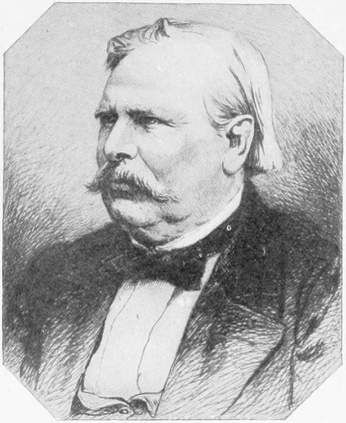 |
| MORITZ SCHWIND. Graphische Künste. |
Schwind, like Rethel, is numbered among the few artists of that period who were able to preserve their absolute simplicity against the great painters of Italy. “I went into the Sistine Chapel,” he says of his journey to Rome, “gazed upon Michael Angelo’s work, and sauntered back home to work at my ‘Ritter Kurt.’ I take the greatest possible pleasure in my present picture, although the subject is absolutely crazy. I love to paint trees and rocks and old walls, and I have put plenty of them into it, besides a fellow on horseback and in full armour. What does it matter? One must work according to one’s natural capacity. Even at the time when I was studying at Munich I came to the conclusion that that of which the mind of itself takes hold, and that which takes hold of it, is the one only right thing for every man who has a vocation. Art consists of this unconscious taking hold and being taken hold of. Deus in nobis. And therefore the young artist will do well to be careful in visiting the museums. You go 176 to the galleries where the works of the great masters are to be seen. There you see, all at once and all together in confusion, works of every school and of every era. It is extremely likely that you are overwhelmed by the mass, and beauties of every kind, belonging to tendencies and epochs altogether diverse, shake the ground under your budding vocation, and like fifty various climates influencing a single plant, arrest a growth which is possible only in one, and that a favourable one. The imitation of the Italians in especial can as a rule have only the effect of estranging us from our own individuality, a fact which was once again fully borne in upon me when I saw Overbeck’s new altar-piece in the Cathedral of Cologne. It may sound severe and uncalled-for from me, but every man who has forgotten his mother-tongue is tottering on his feet. The imitation of foreigners is the dangerous blind alley into which our art has betaken itself. When I exhibited ‘Ritter Kurt’ people said, ‘It is Old German,’ and forthwith it stood condemned, as if that were a disgrace, and as if one should not rather have saluted the fact with joy, as the right thing for us Germans. The art of painting which I follow is the German, and glass-painting must be taken as its foundation.”
 |
 | ||
| SCHWIND. | FROM THE WARTBURG FRESCOES. | SCHWIND. | FROM THE WARTBURG FRESCOES. |
In Schwind one might imagine an old German master of the race of Albrecht Altdorfer come to life again. In the small, simple pictures of landscape and fairy-tale, which Count Schack has collected in his private gallery for the quiet and devout enjoyment of thousands, he has given us his best work as a painter.
Yet even his pictures have the failings of his time. Compared with Dürer, he seems like a gifted amateur; there are manifold empty, dead spaces to be observed among his figures; their action is at times misconceived and puppet-like; and his sense of colour was always limited. One may be permitted to look forward to some master, at the head of a coming epoch in art, who shall combine with Schwind’s German fairy imagination the sensuous, dashing colour-elf that possessed Bœcklin. There might a school of art 177 arise, to follow for the future the path which Franz Stuck has struck out. As to technique, Schwind was a child of the cartoon era; as regards tenderness of feeling, he is a modern. It is difficult to persuade a non-German of Schwind’s greatness, in presence of the pictures; but when they are reduced to black-and-white they appeal to every one. The heliogravure enables one to imagine what the original does not show; it incites the soul to further poetic creation, it announces what Schwind would be were he alive to-day. An elfland kingdom of enchantment, full of genuine poetry and beauty, opens out before us; a fairy garden, where the “blue flower” pours forth the whole of its sense-benumbing perfume. Count von Gleichen; the boy’s miraculous horn; the mountain spirit Rübezahl, wandering along through the wild mountain forest; the hermits; the elves’ dance; the erlking; the knight and the water nymph,—they are flooded with all the enchantment of Romanticism, they possess deep feeling without mawkishness, the old-German note of fairy legend and Hans Memlinc’s childlike simplicity, yet at the same time the life of the present day, full of feeling and rich in delicate shades. How strong and brave are the men; how tender, noble, and charming the women! What a modest, maidenly art it is! just as its master was an innocent, harmless, and joyous being.
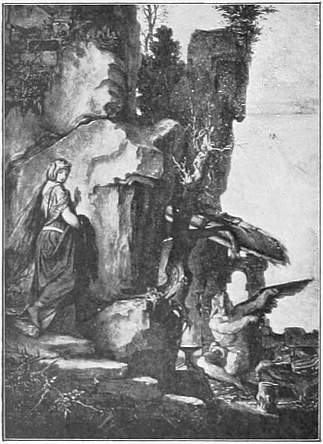 |
| SCHWIND. WIELAND THE SMITH. |
His works, in comparison with those of his contemporaries, who were devising systems by means of which art should be brought back to the classical, bear the stamp of naïve creations in which no hypocrisy, no decorative nothingness finds expression. As against the erudite treatises of the Cornelius school, they preached for the first time the doctrine, that in works of art what is important is not the quantity of learning displayed therein, but the quality of the feeling exhibited. With all their inequalities, all their incorrectness, all their weak points, they are inspired, sung, dreamed, and not put together in cold blood according to recipes: in them is the pulsation of a human heart, a tender human heart full of delicate feeling. This it is which constitutes his magical attraction to-day, which makes him the firm bond 178 of connection between the moderns. He was no imitator, no soulless calligraphist performing laborious school exercises after the manner of the old masters; he spoke the language of his time.
He was one of the first who at that time laid aside the prejudice against modern costume, and in his “Symphony” turned to artistic account, in one fantastic whole, even Franz Lachner’s frockcoat and Fräulein Hetzenecker’s modern society toilette. “If you may paint a man hidden in an iron stove—what is called a knight in armour—you may still more permissibly paint a man in a frockcoat. In general, one can paint what one will, provided always that one wills what one can.” And it was only by means of this present-day temper that Romanticism could find so full-toned an expression in his works. Only because he was truly a citizen of the present day and felt its blood beating in his veins, could he feel the congenial elements of the past. To him the old-time legends were no antiquarian, erudite, pedantic lumber; they were a part of himself, and he interpreted them in more childlike simplicity of manner and with more delicate feeling than any artist of former times, because he observed them with the eye of the present age, with an eye made keen with longing. Just as in his “Wedding Journey” he raised all reality into the poetry of purest romance, so is his Romanticism saturated with a sense of reality charged with memories of home. Out of his fairy-tale pictures is breathed a charming fragrance of the long-vanished days of earth’s first springtide, and yet for that very reason a breath of the most modern Décadence. He is distinguished from Marées and Burne-Jones, from Puvis de Chavannes and Gustave Moreau, by a very unmodern attribute—he is bursting with health. He is still naïvely childlike, free from that elegiac melancholy, that temper of weary resignation, which the end of the nineteenth century first brought into the world.
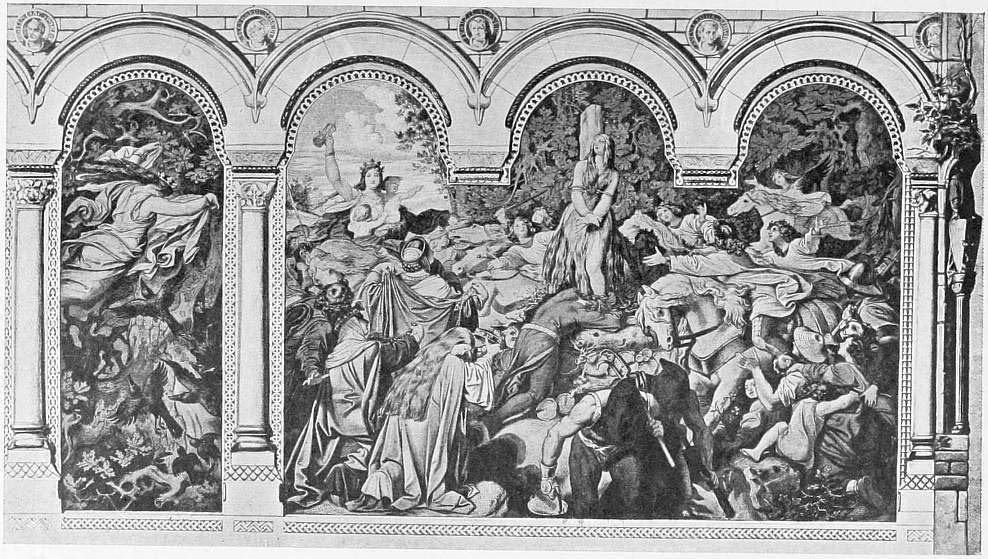 | |
| Neft, Helio. | |
| SCHWIND. | FROM THE STORY OF THE SEVEN RAVENS. |
Yet Schwind was one of the first to feel and give expression to that modern sense of longing desire which turns back from a nervous, colourless age, from the prosiness of everyday life, towards a vanished Saturnian era, when man still lived at peace and undisturbed in happy union with nature. For even this proclaims him our contemporary, that the temper of his pictures develops itself from the landscape. A landscape painter through and through—almost in Bœcklin’s sense, who transformed the temper of Nature into the contemplation of living beings—he spoke of the rest and peace of German forests, of that hour of summer’s night when no wind blows, no leaflet moves, when to the solitary wanderer in the woods the mists rising from the meadows are transformed into white veils of the elves, and the gold-rimmed waves of the sea into the yellow hair of mermaids frolicking in the moonlight to the magic notes of their golden harps. He felt and loved his landscapes rather than studied them, yet they are saturated with an entirely modern sentiment for Nature. No German, at that time, had caught and understood the interweaving of the forest boughs 182 with such intimate familiarity. The fresh sunshine of the morning breaks through the light green of the young beeches, and leaps from bough to bough, transforming the glittering dewdrops into diamonds, and the beetle, creeping comfortably over the soft moss, into gold and precious stones. “Da gehet leise nach seiner Weise der liebe Herrgott durch den Wald” (“The dear God holy, He passeth slowly, as His wont is, through the wood”). With a few boldly drawn lines and light colours we are transported into the midst of the forest world, and all around us opening buds and verdurous green, sweet scents, and the murmur of leaves. “When one has set one’s love and joy on a beautiful tree so fully,” he said to Ludwig Richter, “one depicts all one’s love and joy with it, and then the tree looks quite different from an ass’s fine daub of what he thinks it should be.”
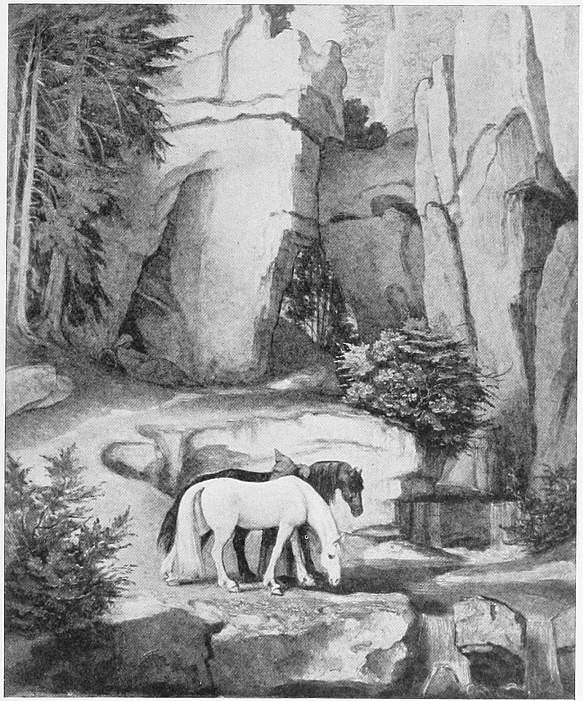 | |
| Albert, Helio. | |
| SCHWIND. | A HERMIT LEADING HORSES TO A POOL. |
Only so intimate a connection with Nature could enable Schwind to imagine landscapes, which in their virginal old-world mood form at once the echo of the figures and of their actions. These green meadows and flower-besprent hills, these gloomy wooded slopes, these smooth valleys through which glittering waters glide murmuring along, are fit and suitable dwelling-places for the delicate fabulous beings of the flower-entwined old fairy legends. Schwind lived with Nature. He gave the name of Tanneck (Fir-tree Corner) to the little country house which he built for himself on the Starnberger See, and the fresh scent of pinewood, the rustling sound of German forests, pour forth from his pictures. Like young Siegfried, he understood the language of birds, and went eavesdropping to hear what the pine trees whispered to one another.
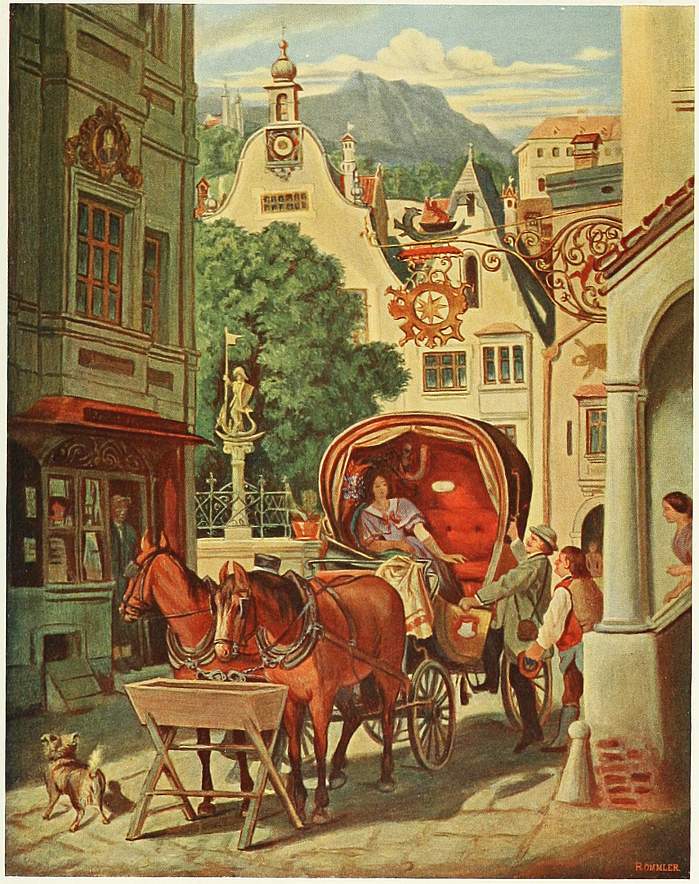 | |
| SCHWIND. | THE WEDDING JOURNEY. |
Still freer, more spontaneous, and lighter than in his oil paintings was his touch in his water-colours, in which the colour is only breathed over the forms like a delicate vapour; and quite especially in his illustrations—so far as the word may be employed with respect to him, for he never illustrated, he gave shape to his own thoughts, and that only which moved his innermost being he brought fully formed before one’s eye. The Bilderbogen and the Fliegende Blätter of Munich obtained from him witty and humorous inventions, such as “The Almond Tree,” “Puss in Boots,” “The Peasant and the Donkey,” “Herr Winter,” and “The Acrobat Games.” His fairest legacy consists of three cyclic works: “Cinderella,” “The Seven Ravens,” and “The Beautiful Melusina”; wherein he glorified with praise the beauty and fidelity of women, and their capacity for self-sacrifice. “Cinderella,” which appeared in 1855, at the Munich Exhibition, is a fairy-tale, than which poet has seldom, indeed, narrated a chaster, tenderer, or more fragrant. In 1858 followed the touching story of the good sister who releases her brothers by dint of unspeakable suffering and endurance, to-day the priceless pearl among the gems of the Weimar collection. For twenty years, as he said, the work had been in his thoughts. So far back as in 1844 he wrote to Genelli: “I believe that it will give something which may please people who have a sense for love and faithfulness, and for a touch of the power of enchantment.” When an acquaintance of his gazed upon it with dismay, and ingenuously asked for whom the 183 thing was intended, and whither it was to go, Schwind turned his penetrating, flashing little eyes upon him, and then said: “Do you know, I painted that for myself; it is the dream of my life; no one shall buy it; some day I shall give it to a friend.” It is an imperishable work, full of grace, modesty, and charm.
Schwind takes the story up at the fateful moment when the lonely maiden, who is determined to release her enchanted brothers by assiduous spinning and constant silence, is discovered by a hunting party. There, amid the enchantment of the forest solitude, she sits in the hollow of a tree and spins away at the seven shirts, to free her seven brothers. Thus the king’s son catches sight of her. The fire of love kindles in his eyes. In one long kiss the maiden gives herself to him. The wedding takes place, and like another St. Elizabeth she is seen standing, soon afterwards, distributing alms to starving beggars. Yet, meanwhile, she has fallen under suspicion owing to her continuous silence; even her husband becomes distrustful, because in the quiet of night he has observed that she is not resting by his side, but is quietly up and spinning. And the catastrophe comes when the silent queen gives birth to twins, who, to the horror of all around, fly off in the form of ravens. Tranquil and affectionate, the young mother awaits her fate. Then follow the sentence of the Vehm-tribunal, the pathetic parting from her husband, the preparation for death. There is only one hour more to pass by before the seven years are over and the spellbound brothers set free. The good fairy appears in the air, hour-glass in hand, and brings solace to the hard-pressed heroine. The beggars, too, whose benefactress she had been, bring help, and hold the gate of the dungeon in force. So the time runs out, the spell is broken, and the brothers hasten, on milk-white horses, to save their sister from the stake. In Schwind’s marvellous drawings the story passes quickly on, stroke by stroke, deeply moving and soul-stirring in its dramatic force.
The “Beautiful Melusina” was the kiss of the water-nymph, with which Romanticism led her faithful knight to his death, only to disappear together with him out of German art. “The winter has dealt me a sore blow; I shall never be able to do anything more.” Carl Maria von Weber and Uhland had already gone before; Schwind was lying on his sick-bed when the German victories created a German fatherland. He learned, however, all the long series of glorious tidings that came from the field of war, saw the tumultuous joy and the dazzling sea of fire which surged through Munich in January 1871, and heard the joyful news that Germany was at last united. Then he had a glass of champagne poured out for him, and drank it to the new empire and the future of the nation.
In the middle of a wood of lofty beeches in Bernrieder Park, on the Starnberger See, there stands a small rotunda, within is a prattling fountain, right round the walls runs a frieze, depicting the legend of the “Beautiful Melusina.” It is Schwind’s monument. With him German Romanticism perished; reality itself had now become so marvellous. When, in 1850, 184 Hübner had to paint a figure of Germania for a page in King Ludwig’s album, he depicted a queenly woman, prone on the ground, with her face in the dust, amidst a desolate landscape and under a cloudy sky. The crown has fallen from her head and a skull lies by her side, while on the frame are inscribed these words from the Book of Lamentations: “Mine eye runneth down with rivers of water for the destruction of the daughter of my people; the crown of our head is fallen.” When Schwind died, Germany had re-arisen. In the very year of his death, Lenbach painted his first Bismarck pictures: in Bismarck was embodied that power by means of which the dream of a nation was fulfilled.
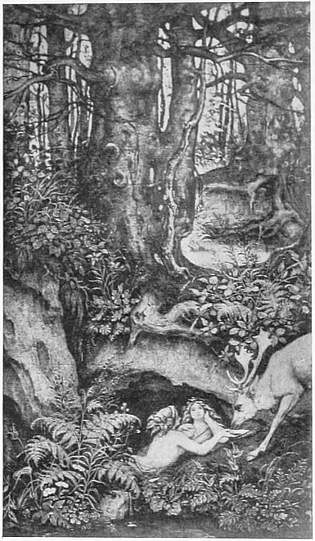 |
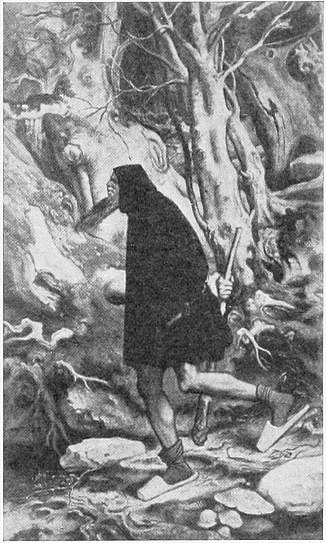 | ||
| Albert, Helio. | |||
| SCHWIND. | NYMPHS AND STAG. | SCHWIND. | RUBEZAHL. |
Thus Schwind’s works are not only the sign of a completed period in German history, but also at the same time both the climax and the conclusion of an art-epoch. Schwind had lived through the entire revolution which German painting had at that time undergone. At his death the sound of the hunting horns of Romanticism had died away. He had lived long enough to have the opportunity of criticising neatly, as follows, the dry, unpoetical school of historical painting then making its appearance, as if introduced by gaudily costumed models, a school which made its first hit with Lessing’s “Ezzelino”: “I will explain the picture to you. Ezzelino is seated in his dungeon, and two monks are attempting to convert him. One of them recognises that all pains are thrown away upon the old sinner, and takes himself off, regretfully desisting from all further endeavour; the other still has hopes, and continues his exhortations. But Ezzelino only keeps his angry gaze fixed before him, muttering, ‘Leave me alone! Don’t you see that I am—posing as a model!’” He had had occasion to write to his friend Bauernfeld: “I have seen so many schools of so-called painting in my time that it is an absolute horror to me”; he had asked Piloty: “What calamity are you preparing for us now?” and had thought it his duty to address to one of the younger painters the question: “Are we then an academy of the Fine or of the Ugly Arts?” “A man like me, with his ideas, walks like a ghost amid the battle of the virtuosi, in which the whole life of art has gone astray,” he used 185 sadly to say. His last wonderful works stand alone in a time which was dazzled by the flash of arms characterising the Franco-Belgian school of art. It was not till much later that Hans Thoma took up the threads which connect the work of Schwind with the present epoch. When he died he was a solitary, isolated man taking leave of a generation in which he had no part. The period of historical painting which followed him produced no single work distinguished by Schwind’s sense of fragrant legendary poetry. The charming forest fairy who had appeared to him showed herself to no other; like the betrayed Melusina, she had returned to rest again, solitary, in her fountain home. Fantasy, tender soul that she is, had taken wings, whither none can tell. “That is why nobody has a single idea,” as Schwind said in his drastic way. The Muse of Schwind, the last Romanticist, was a chaste, pensive, soulful maiden; while that of Piloty, the first colourist, was a noisy, bloodthirsty Megæra. Yet one can have no doubt as to the necessity of this evolutionary change.
Schwind himself is among the masters “who have been, and are, and shall be.” He was different from all that was arising around him; he embodied the spirit of the future, and exercises over the art of the present day so great an influence that where two or three painters are gathered together in the name of the beautiful, he has his place in the midst of them, and is present, invisible, at every exhibition. But he exercises this influence only spiritually. Young artists study him as if he were a primitive master. Enraptured, they find in him all those qualities for which there is to-day so ardent a longing—innocent purity and touching simplicity, a mystic, romantic submersion in waves of old-time feeling and a charming youthful fervour. They do not study him in order to paint like him.
“Our heads are full of poetry, but we cannot give it expression,” are the words with which Cornelius himself characterised this period. Germany had original geniuses indeed, but no fully matured school to compare with the French; as yet the Germans did not know how to paint. Up to this time the course of painting in Germany had been a bold but imprudent flight through 186 the air; in its Kaulbach-like cloud-heights it had melted away to a shadow, only to fall again, somewhat roughly, to the ground. It died of an incurable disease—idealism. The painters of that time, one and all, had never become real artists; strictly speaking, they had always remained amateurs. He alone is a great artist in whom the will and the performance, the substance and the form, are in complete accordance. Painters who never knew exactly what is meant by painting, artists whose most noticeable characteristic was that they had no art-capacity, were only possible in the first half of the nineteenth century in Germany, where for that very reason they were admired and praised.
What now began was a necessary making good what had been so long neglected. For craftsmanship is the necessary presupposition of all art, which can no longer suffer any one to be called a master who has not learnt his business. In the atmosphere of incense which surrounded Cornelius in Munich, the dogma that salvation was to be found in German art alone, and that the German nation was the chosen people of art, had reached a height of self-adoration which came near to megalomania. In the proud enthusiasm of those times, great in their aims as in their errors, the Germans had as false an opinion as possible of the art of foreign countries.
In the very years when the first railways were ousting the old mail-coaches the mutual interchange of endeavour and ability between the various nations was slower and scantier than ever before. How German artists had wandered abroad in the fifteenth and sixteenth centuries, in that great age when Dürer crossed the Alps on Pirkheymer’s pony, and when Holbein obtained from Erasmus letters of introduction for England! With what joy Dürer, in his letters and in his journal, gives an account of the recognition accorded him in artistic circles in Italy and the Dutch cities! Nearly all the German painters had, in the course of their long wanderings, made acquaintance with either the Netherlands or Italy. They knew exactly what was going on in the world around them. Dürer and Raphael used to send drawings to each other, “so as to know each other’s handwriting.” It was only in the first half of the nineteenth century that the Germans, once proud in the consciousness of possessing the finest comprehension of, and the greatest receptivity for, foreign intellectual wares, lived apart in timid isolation. Into the suburban still-life of the German schools of art not a sound made its way of what was taking place elsewhere. Only thus was it possible for the Germans to imagine that among all modern nations they alone had a vocation for Art. No one had the least idea that in England, the land of machines and beefsteaks, there were men who painted; and people went so far as to proclaim piety, morality, thoroughness, accurate draughtsmanship, and diligent execution the monopoly of German art; and superficiality, frivolity, and “empty straining after effect” the ineradicable national failing of that of France.
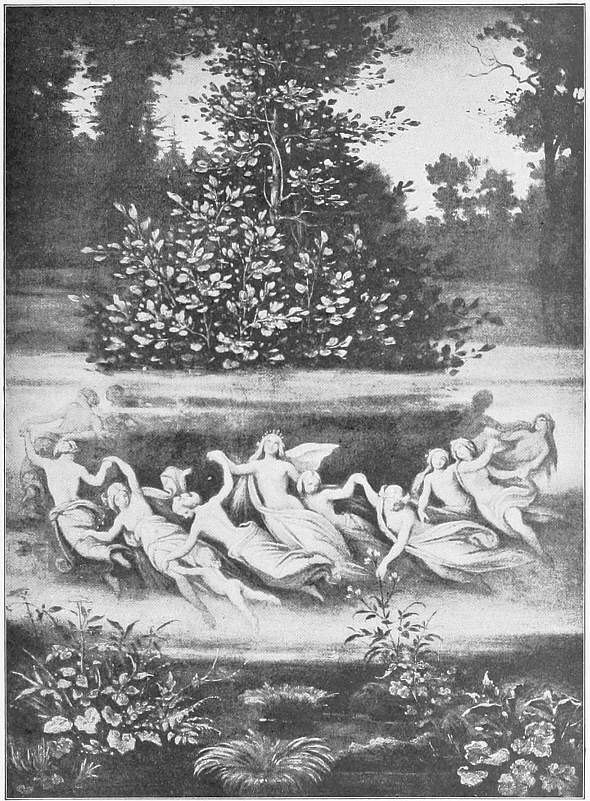 | |
| SCHWIND. | THE FAIRIES’ SONG. |
With some such ideas in their heads the majority of the German painters, in the autumn of 1843, found themselves confronted by Gallait’s “Abdication of Charles V” and Bièfve’s “Agreement of the Dutch Nobility”; two Belgian 187 pictures which at that time were going the round of the exhibitions in all the larger towns of Germany. And it was not long before the belief in the old gods, which had for thirty years held sway in the city of King Ludwig, was completely undermined by the younger generation. “Even for the great gods, day comes to an end. Night of annihilation, descend with the dusk!” Diogenes expelled from his philosophic tub could not have felt more uncomfortable 188 than the German painters in presence of the Belgian pictures. As till then the incapacity to paint had been belauded as one of the strongest possible proofs of the higher artistic nature and of genuine greatness, so now it was perceived that nevertheless, on the banks of the Scheldt and of the Seine, a much greater school of painting was in full bloom, and producing splendid fruit.
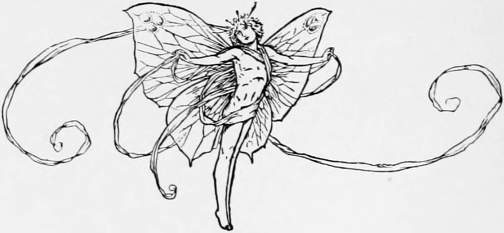

CHAPTER IX
THE FORERUNNERS OF ROMANTICISM IN FRANCE
In France the first decade of the century gave no premonition of the powerful development which was shortly to take place in French art. A legion of characterless pupils issuing from David’s studio wearied the world with their aimless works, and hurled their thunderbolts against all rising talent. The austere catalogue of the Salon was a pell-mell of Belisarii, Télémaques, Phædras, Electras, Brutuses, Psyches, and Endymions. Girodet and Guérin wearied themselves in putting on canvas the chief scenes in the classical tragedies at that time so frequently performed—Pygmalion and Galatea, the Death of Agamemnon, and the like—and painted portraits between times; Girodet’s dry and poor, Guérin’s solemnly vacant. The universal note was that of tedium.
François Gérard alone, the “King of Painters and Painter of Kings,” survives, at least in his portraits. Like David he is redeemed only by his portrait painting, and his successes in that direction eclipse even Mme. Vigée-Lebrun, the amiable, gifted, and graceful painter of Marie Antoinette’s days. At the outbreak of the Revolution she had left France. Everywhere extolled and welcomed with open arms, she painted Mme. de Staël in Switzerland, and at Naples Lady Hamilton, the famous beauty of the time of the Directory. But when, in 1810, she returned to Paris, she had been forgotten. The day on which Marie Antoinette picked up her brush for her, as Charles V had done for Titian, was to remain the happiest in her life. She belonged to the Ancien Régime, and although her death did not take place till 1842, at the age of eighty-seven, her work was already over in 1792. In her old age she busied herself in writing memoirs of the splendour of her youthful days, from the famous mythological dinner in the Rue de Cléry, where her husband appeared in the character of Pindar and recited his translation of Anacreon’s odes, to the triumphs which accompanied her journey round Europe.
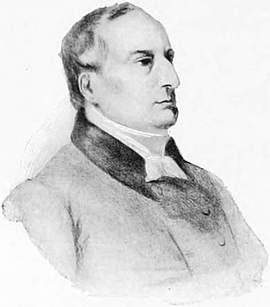 |
| FRANÇOIS GÉRARD. L’Art. |
Gérard took the place which she had left vacant at her departure, and filled it well, especially in his youth. When, in the Exhibition of Portrait Painting held at Paris in 1885, there appeared the likeness of Mlle. Brongniart, from the collection of Baron Pichon, painted by Gérard in 1795, at the age of twenty-five, there was general astonishment at the familiar and intimate grasp of character it displayed. The portrait of this young girl standing in her white dress, so tranquil and without pose, has in the firmness of its 190 draughtsmanship the austere charm and dignity of a Bronzino. And later none could give to the aristocracy of Europe a nobler or more natural bearing than did Gérard, who became their tried and trusted depicter: yet in his last days he descended into theatrical exaggeration. Endowed as he was with all the captivating qualities of a cultured man of the world, he had from the beginning avoided as the plague the revolutionary politics in which David was for some time engaged, and when at the instance of the elder master he was appointed a member of the Revolutionary Tribunal, he alleged illness in order to be absent from its sessions. He was a man of the salons, the born painter of the great world, his house the centre of a distinguished circle of society. Not a celebrity, not an emperor or king, but wished to be painted by Gérard. And just as he had been the chosen portrait painter of the Bonaparte family, so after the Restoration he was still the official favourite of the Court. Josephine took the fashionable painter under her high protection, Napoleon’s marshals defiled before him, and the aristocracy which returned with Louis XVIII vied with one another for his favour.
Gérard’s three hundred portraits are a continuous catalogue of all those who in the first quarter of the century played any part in France upon the political, military, or literary stage. A man of supple talent and fine tastes, he completely satisfied the desires of a society which, after the storm of the Revolution, opened its salons again and re-established its former hierarchy of rank. The portrait with rich background of upholstery, and the depicting of public ceremonies, were reintroduced by him into the field of art. The people whom he painted are no longer “citizens,” as with David, but princes, generals, princesses; and their surroundings allow of no doubt as to whether they are to be addressed as Sir, as Your Serene Highness, or as Your Excellency. No one knew how to flatter in so tactful a manner, particularly in portraits of ladies. It was to him, therefore, that Mme. Récamier had recourse when she was dissatisfied with David’s likeness of her. Gérard’s, which she destined for Prince Augustus of Prussia, one of her admirers, gave the “fair Juliette” the fullest satisfaction. In the former she was represented reposing on a couch, austere and without charm, like a tragic muse. Here she sits in a pleasant, lazy attitude upon a chair, in a transparent robe which fully displays her form; about her lips plays a half-melancholy, half-coquettish smile, and she, the great actress who had turned so many men’s heads, gazes with gentle child-eyes as innocently upon the world as though she believed the story about babies and the stork.
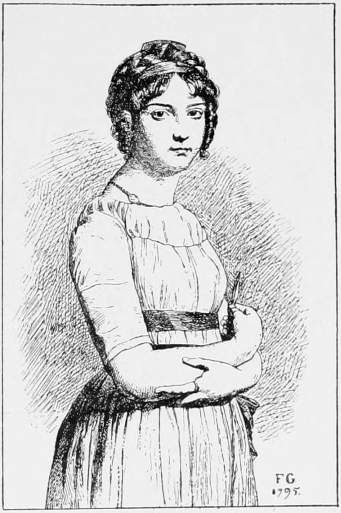 |
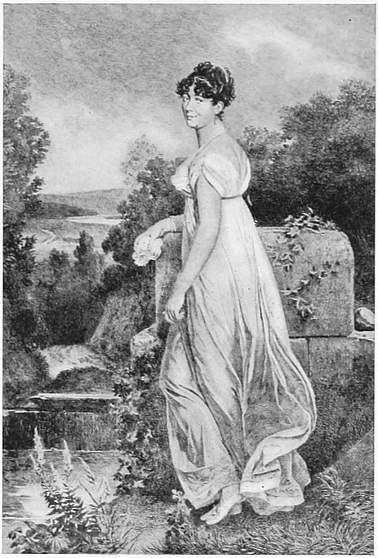 | ||
| Gaz. des Beaux-Arts. | Gaz. des Beaux-Arts. | ||
| GÉRARD. | MADAME VISCONTI. | GÉRARD. | MLLE. BRONGNIART. |
The background, too, that colonnade “leading nowhither,” is characteristic of the change in the manner of regarding things. The older schools of painting had, in the case of portraits, managed the treatment of the background in two different ways. The old Dutch and Germans—Jan van Eyck and Holbein—aimed at showing a man, not only portrayed with the subtlest fidelity to truth, but also in the surroundings in which he was usually or by preference to be found. The Italians renounced all representation of such scenes, and gave only a quiet, neutral tone to the background. Gorgeous decorative scenery was introduced by the court painter Van Dyck, and since the second half of the seventeenth century had continually risen in popular favour. Mignard, Lebrun, and Rigaud had brought into fashion, for portraits of princely personages, that stately pillared architecture, with broad velvet curtains swelling and descending in ample folds, which at that time was so remarkably in keeping with the whole cut of the costumes, with the enormous full-bodied wigs and the theatrical attitudinising of that epoch. For the likenesses of generals and warlike princes the favourite background was one which represented, by means of a number of small figures, entire battles, marches, sieges, and so forth. Both these methods, and, together with them, that of an ideal, lightly indicated park landscape, were put an end to by the Revolution, under the influence of which all extravagant pomp, not only in life, but even in portrait painting, was replaced by an ascetic sobriety. Gérard, the Court painter of the Bourbons, who on their return had “learnt nothing and forgotten nothing,” reintroduced the gorgeous pillar decoration, which still remained the authoritative style under Stieler and Winterhalter, and has only in the bourgeois era of to-day given way to the simple, neutral-toned background of the Italians.
David, by the way, never forgave Mme. Récamier for having preferred his pupil to himself. When, in 1805, after the completion of Gérard’s likeness of her, she approached David on the subject of finishing his, he answered drily: “Madame, artists have their caprices as well as women; now it is I who will not.”
As an historical painter Gérard was an imitator of the mannerist Girodet. 192 Paintings such as “Daphnis and Chloe,” or the famous “Psyche” receiving Cupid’s first kiss (1798), made indeed a great sensation among the ladies, who for some time afterwards painted their faces white, to resemble the gentle Psyche; but from the artistic point of view they do not rise above the ordinary level of the Classical school. As an historical painter he took much the same course as David; he began as a Revolutionist in 1795 with the usual “Belisarius,” and ended as a Royalist with a “Coronation of Charles X.”
The more stiff and sober the antique style of David became, the sooner a counter-current was likely to arise, and the change of taste showed itself first in the circumstance that, from 1810 on, a master came more and more to the front who, already old, had hitherto lived in obscurity, almost despised by his contemporaries. This was the amiable, sympathetic, charming, sweet, and great Prudhon, the lineal descendant of Correggio, a solitary painter, the gracefulness of whose art was at first unappreciated, but who, as the orthodox academicians began to be more and more tedious, exercised a correspondingly greater influence over the younger generation. He is the one refreshing oasis in the desert wilderness of the Classical school.
What a difference between him and David! When the elegant grace of Watteau fled from the French school, and the new Spartans dreamed of founding a Greek art, David was the hero of this buskined theatrical school of painting. He painted “The Horatii” and “Brutus,” and thought to bring ancient Rome back to life by copying the shapes of old Roman chairs and old Roman swords. That was the antique style of his first period. Later, having made the discovery that, compared with the Greeks, the Romans were semi-barbarians, he abandoned the Roman style, and thought to make a great stride forwards by copying Greek statues and carefully transferring them to his pictures. This “pure Grecian character” is represented in his “Rape of the Sabines.” Later again, he turned to the more ancient Greeks, and the result 193 was the most academic of his pictures, his “Leonidas.” A mixture of dryness and declamatory pathos; diligence without imagination; able draughtsmanship and an absolute incapacity of drawing anything whatever without a model; careful arrangement without the slightest trace of that gift of the inner vision whereby the whole is brought complete and finished before the eye,—these exhaust the list of David’s qualities. By means of casting and copying he thought to come near to that art of the antique whose soul he dreamed of embracing, when he held but its skeleton in his hands.
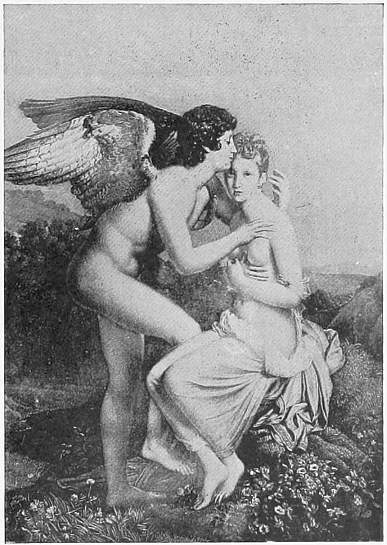 |
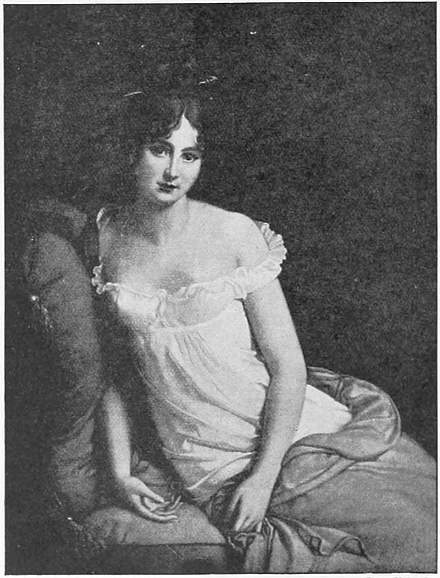 | ||
| Gaz. des Beaux-Arts. | Cassell & Co. | ||
| GÉRARD. | CUPID AND PSYCHE. | GÉRARD. | MADAME RÉCAMIER [DETAIL]. |
And meanwhile, away from the broad high-road, and almost unnoticed, was living that painter whom David contemptuously called “the Boucher of his time.” He it was who truly cherished the gods of Greece in his heart, under whose brush the dead statues began to breathe and to feel the blood flowing in their veins, as in the old days when the Renaissance dug them out of the ground. His appearance on the stage indicates the first protest against the rigid system pursued by the painter of the Horatii and of Brutus. Prudhon also believed in the antique, but he saw therein a grace which no Classicist had ever seen; he also contrasted the simplicity of the Grecian profile with the capricious, wrinkled forms of the rococo style; he too had spent his youth in Italy, but had not thought it criminal to study Leonardo and Correggio; he did not bind himself either to cold sculpture or to the delicate morbidezza of the Lombards as the only means of grace. He remained a Frenchman heart and soul, in that he inherited from Watteau’s age its womanly softness and elegance. In a cold, ascetic age he still believed in tenderness, gaiety, and laughter—he who as a man had but little reason to take delight in life.
Prudhon was ten years younger than David, and was born at Cluny, the tenth child of a poor stone cutter. He grew up in miserable circumstances, cherished only by a mother who devoted the whole of her love to this her youngest born, and to whom the child, a delicate pliant creature, clung with girl-like tenderness. His 194 parents used often to send him out with the other poor children of the little town to gather faggots for the winter in the wood belonging to the neighbouring Benedictine monastery. There the handsome, sprightly boy with the large melancholy eyes attracted the notice of the priest, Père Besson, who made him a chorister and gave him some instruction. Here, in the old abbey of Cluny, surrounded by venerable statues carved in wood, by old pictures of saints and artistic miniatures, he recognised his vocation. An inner voice told him that he was to be a painter. And now his Latin exercise books began to fill with drawings, and he carved little images with his penknife out of wood, soap, or whatever came to his hand. He squeezed out the juice of flowers, made brushes of horsehair, and began to paint. He was inconsolable on finding that he could not hit off the colouring of the old church pictures. It was a revelation to him when one of the monks said to him one day: “My boy, you will never manage it so: these pictures are painted in oils”; and he straightway invented oil painting for himself. With the help of the instruction which he now received at Dijon from an able painter, Devosge, he made rapid progress.
Nevertheless a generation was yet to pass before he was really to become a painter. His marriage, on 17th February 1778, with the daughter of the notary of Cluny, became the torment of his life. A linen-weaver and three of his father-in-law’s clerks were present at the wedding. His wife was quarrelsome, their income small, and their family rapidly increasing. He betook himself to Paris to seek his fortune, with a letter of introduction to the engraver Wille. “Take pity on this youngster, who has been married for the last three years, and who, were he to come under some low fellow’s influence, might easily fall into the most terrible abyss”; so ran the letter, 195 which a certain Baron Joursanvault had given him. He hired himself a room in the house of M. Fauconnier, the head of a firm engaged in the lace trade, who lived in the Rue du Bac with his wife and a pretty sister. The latter, Marie, was eighteen years of age, and, like Werther’s Lotte, was always surrounded by her brother’s children, whom she looked after like a little housewife. Prudhon, himself young, sensitive, and handsome, loved and was loved, and made her presents of small flattering portraits and pretty allegorical drawings, in which Cupid was represented scratching the initials M. F. (Marie Fauconnier) on the wall with his arrow. That he was married and several times a father she never knew, till one day Madame Prudhon arrived with the children. “And you never told me!” was her only word of reproach.
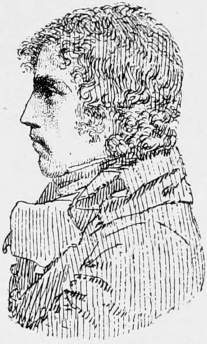 |
| Gaz. des Beaux-Arts. |
| PIERRE PAUL PRUDHON. PORTRAIT OF HIMSELF. |
Prudhon himself now went to Italy—a journey accompanied by serious difficulties. At Dijon he had competed for the Prix de Rome, and had been so simple as to make a sketch for one of his rivals. He owed it to the latter’s honesty that the scholarship nevertheless fell to himself. He started on his journey; but when he reached Marseilles, and was ready to embark, the vessel was unable to weigh anchor for several weeks, owing to stormy weather. And even on the voyage it became necessary to disembark again, so that months had elapsed before he arrived in Rome, penniless, and having embraced, according to classical custom, the land he had come to conquer; for he had fallen out of the carriage on the way. Fortunately his dearly bought sojourn in Italy did him no harm. He had indeed intended to draw only from the antique and after Raphael; but after the lapse of a very few weeks he found his ideal in Leonardo. Him he calls “his Master and Hero, the inimitable father and prince of all painters, in artistic power far surpassing Raphael!”
In a small sketch-book, half torn up, dating from this time, and still in existence, we have already the whole Prudhon. It contains copies of ancient statues, made laboriously and without pleasure in the work; then comes Correggio’s disarmed “Cupid,” a delicious little sketch, and with the same pencil that drew it he has written down the names of the pictures he purposes painting later on: “Love,” “Frivolity,” “Cupid and Psyche.” It is as it were the secret confession of his fantasy, a preliminary announcement of his future works. Here and there are found sketches hastily dashed off of beautiful female forms in the graceful attitude which had excited his admiration in the women of the “Aldobrandini Wedding.” But, above all, the young artist observed all that was around him. He lived in unceasing intercourse with the beautiful, and his soul was nurtured by the spirit of the works which surrounded him. He accumulated pictures, not in his sketch-book, 196 but in himself; so much so that, when he was afterwards interrogated as to his Italian studies, his only answer was: “I did nothing but study life and admire the works of the masters.” He avoided association even with scholars who had taken the Prix de Rome. The elegant and graceful sculptor Canova was the only one with whom he permitted himself any intercourse.
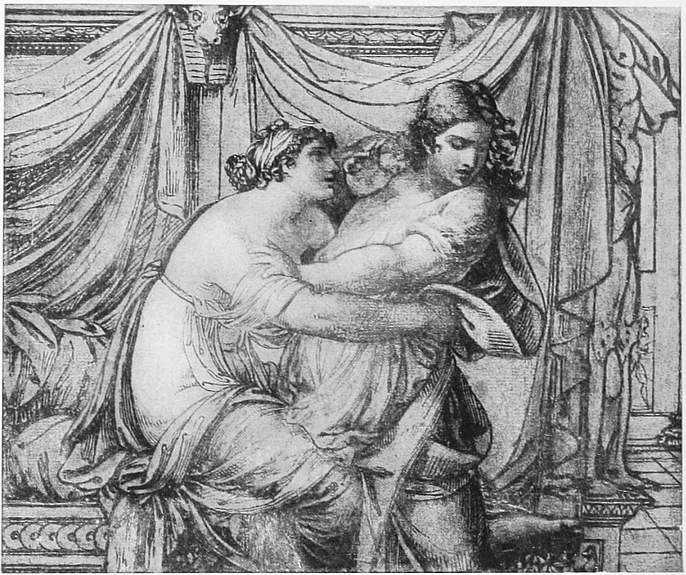 | |
| Gaz. des Beaux-Arts. | |
| PRUDHON. | JOSEPH AND POTIPHAR’S WIFE. |
When his scholarship had run its course, at the end of November 1789, he found himself again in Paris, and the struggle against poverty began once more. Even while in Italy he had sent all his savings to his wife, who had straightway squandered them in drink with her brother, a sergeant in a cavalry regiment. At Paris he had to act as parlour-maid and nursery-maid. The faces of two more women rise up in his life like fleeting stars, and both of them died before his eyes. The first was the mysterious stranger who appeared one day in his studio and commissioned him to paint her portrait. She was young, scarcely twenty years of age, with great blue eyes, but her face was weary and wan as though from long sleepless nights. “Your portrait?” asked Prudhon, “with features so troubled and sad?” He set to 197 work, silent and indifferent; but with every stroke of his brush he felt himself more mystically attracted to this young girl, evidently as unhappy and as persecuted by fate as himself. She promised to return on the morrow; but neither on that day nor on the next did she appear. One afternoon he was wandering dreamily along the street, thinking of the unknown fair one, when his eye almost mechanically caught sight of the guillotine, and he recognised in the unhappy victim at that very moment ending her days the mysterious visitor of his studio.
To keep the wolf from the door, Prudhon was obliged for some years to draw vignettes on letter-sheets for the Government offices, business cards for tradesmen, and even little pictures for bonbonnières. For this the representatives of high art held him in contempt. Greuze alone treated him amicably, and even he held out no hopes for his future. “You have a family and you have talent, young man; that is enough in these days to bring about one’s death by starvation. Look at my cuffs.” Then the old man would show him his torn shirt-sleeves—for even he could no longer find means of getting on in the new order of things. To his anxieties about the necessities of life were added dissensions with his wife. He became the prey of a continual melancholy; he was never seen to smile. Even when a separation had been effected his tormentor persecuted him still, until she was relegated to a madhouse. But now a change comes over the scene with the entrance of Constance Mayer.
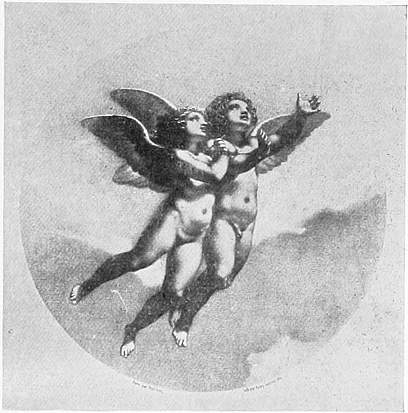 |
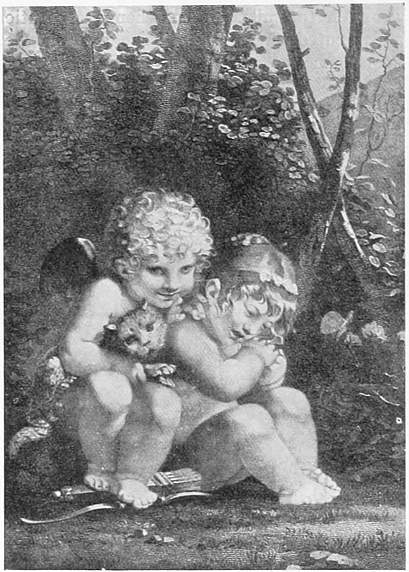 | ||
| PRUDHON. | STUDY DIRECTS THE FLIGHT OF GENIUS. | PRUDHON. | LE COUP DE PATTE DU CHAT. |
This amiable young painter, his pupil, was the star that lighted up his old age. She was ugly. With her brown complexion, her broad flat nose, and her large mouth, she had at first sight the appearance of a mulatto. Yet to this large mouth belonged voluptuous lips ever ready to be kissed; above this broad nose there were two eyes shining like black diamonds, which by their changeful expression made this irregular, gamin’s face appear positively beautiful. She was seventeen years his junior, and he has painted her as often as Rembrandt painted his Saskia. He has immortalised the dainty upturned nose of his little gipsy, as he called her, in pictures, sketches, pastels, 198 all of which have the same piquant charm, the same elegant grace, the same joyous and merry expression. In her he had found his type, as his namesake Rubens did in Hélène Fourment. Constance Mayer became the muse of his delicate, graceful work. And she too died before his eyes, having cut her throat with a razor.
The master and the pupil loved each other. As sentimental as she was passionate, as gay as she was piquant, nervous and witty, she possessed every quality that was likely to captivate him, as she chattered to him in her lively and original way, and flattered his pride as an artist. This love seemed to promise him rest and a bright ending for his days. He entered into it with the passion of a young man in love for the first time. Mlle. Mayer, after her father’s death, was dependent on no one. Her studio in the Sorbonne was separated from her master’s only by a blind wall. She was with him the entire day, worked at his side, was his housekeeper, and saw to the education of his daughter, to whom she was at once a mother and an elder sister; and Prudhon transferred to her all the tender love which as a child he had cherished for his mother. In his gratitude he wished to share his genius with his friend, and to make her famous like himself. It is pathetic to note in Mlle. Mayer’s studies with what patience and devotion he instructed her, how he strove to animate her with his own spirit, and to give her something of his own immortality. Even his own work was influenced by the new happiness. To the period of his connection with Constance belong his masterpieces, “Justice and Vengeance,” “The Rape of Psyche,” “Venus and Adonis,” and “The Swinging Zephyr.”
 | |
| PRUDHON. | CUPID AND PSYCHE. |
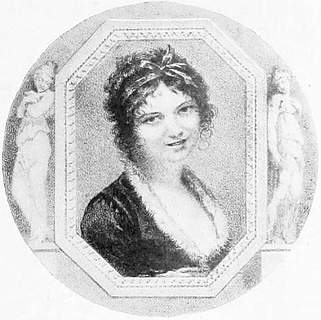 |
| CONSTANCE MAYER. |
These brought him at last even outward success. In 1808 the Emperor gave him the Cross of the Legion of Honour for his picture of “Justice and Vengeance,” and he became, if not the official, at least the familiar painter of the Court. The fine portrait of the Empress Josephine belongs to this period. When the new Empress Marie Louise wished to learn the art of painting, Prudhon, in 1811, became her drawing master; and when on the birth of the King of Rome the city of Paris presented to the Emperor the furniture for a room, he was commissioned to provide the artistic decoration. Criticism began to bow its head when his name was mentioned; and the younger generation of painters soon discovered in him, once so contemptuously reviled, the founder of a new religion, the want of which had long been felt. He began to make money. Constance Mayer seemed to bring him luck: her death affected him all the more deeply.
By nature nervous and highly strung, jealous and keenly conscious of her equivocal position, she could not make up her mind, when the painters were ordered to move their studios from the Sorbonne, either to leave Prudhon or openly to live with him. On the morning of 26th March 1821 she left her model, the little Sophie, alone, after giving her a ring. Soon afterwards a heavy fall was heard, and she was found lying on the ground in a pool of blood. Prudhon lingered on for two years more, two long years spent as it were in exile. Solitary, tortured by remorse of conscience, and with continual thoughts of suicide, he lived on only for his recollections of her, in tender converse with the memorials she had left, insensible to the renown which began gradually to gather round his name. The completion of the “Unfortunate Family,” which Constance had left unfinished on her easel, was his last tête-à-tête with her, his last farewell. He left his studio only to visit her grave in Père-Lachaise, or to wander alone along the outer boulevards. An “Ascension of the Virgin” and a “Christ on the Cross” were the last works of the once joyous painter of ancient mythology: the Mater Dolorosa and the Crucified—symbols of his own torments. Death at length took compassion upon him. On the 16th of February 1823 France lost Prudhon.
His art was the pure expression of his spiritual life. His life was swayed by women, and something feminine breathes through all his pictures. In them there speaks a man full of soul, originally of a joyous nature, who has gone through experiences which prevented him ever being joyous again. He has inherited from the rococo style its graces and its little Cupids, but has also already tasted of all the melancholy of the new age. With his smiles there is mingled a secret sadness. He has learnt that life is not an unending banquet and a perpetual pleasure; he has seen how tragic a morrow follows 202 upon the voyage to the Isle of Cythera. The bloom has faded from his pale cheeks, his brow is furrowed—he has seen the guillotine. He, the last rococo painter and the first Romanticist, would have been truly the man to effect the transition from the eighteenth to the nineteenth century by a path more natural than that followed by David.
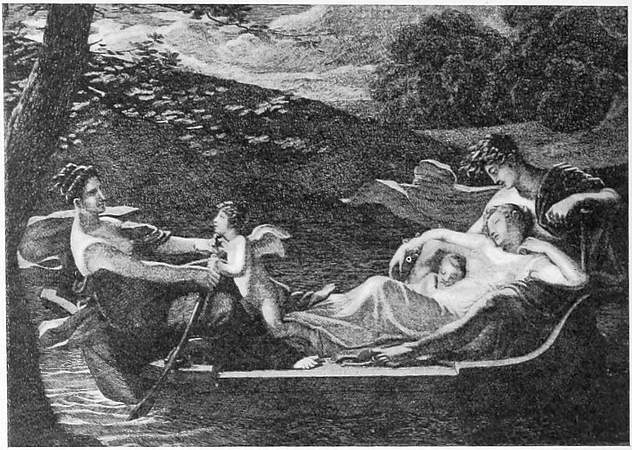 | |
| Gaz. des Beaux-Arts. | |
| CONSTANCE MAYER. | THE DREAM OF HAPPINESS. |
Even his fugitive sketches, thrown off in the days of his poverty, have a quite peculiar charm and a thoroughly individual sentiment. There are vignettes of his for letter-sheets, done for the Government offices, which in a few pencil touches contain more manly elegance and poetry than do David’s most pretentious compositions with all their borrowed Classicism. Prudhon was the only painter who at that time produced anything of conspicuous merit in the art of ornament. Even drawings such as “Minerva uniting Law and Liberty,” which from their titles would lead one to expect nothing more than frozen allegories, are imbued, not with David’s coldness, but with Correggio’s charm. French grace and elegance are united, without constraint, to the beauty of line found in ancient cameos. He it was who first felt again the living poetry of that old mythology, which had become a mere collection of dry names. He is commissioned to draw a card of invitation for a ball, and he sends a tender hymn on music and dancing. In extravagant profusion he scatters forth, no matter where, poetic invention and grace such as David in his most strenuous efforts sought for in vain. It was during this time that 203 Prudhon became the admirable draughtsman to whom the French school have awarded a place among their greatest masters. These drawings and illustrations were the necessary preparation for the great works which brought him to the front at the beginning of the century.
Even his first picture, painted in 1799—to-day half-destroyed—“Wisdom bringing Truth upon the earth, at whose approach Darkness vanishes,” must, to judge from early descriptions, have been marked by a seductive and delicate grace. And the celebrated work of 1808, “Justice and Vengeance pursuing Crime,” belongs certainly, so far as colouring is concerned, rather to the Romantic than to the Classical era. For during the latter, one faculty especially had been lost, and that was the art of painting flesh. Prudhon, by deep study of Leonardo and Correggio, masters at that time completely out of fashion, won back this capacity for the French school. In wild and desolate scenery, above which the moon, emerging from behind heavy clouds, shines with a ghostly light upon the bare rocks, the murderer is leaving the body of his victim. He strides forth with hasty steps, purse and dagger in hand, glancing back with a shudder at the naked corpse of a young man which has fallen upon a ledge of rock, lying there stiff and with outstretched arms. Above, like shapes in the clouds, the avenging goddesses are already sweeping downwards upon him. Justice pursues the fugitive with threatening, wrathful glance; while Vengeance, lighting the way with her torch, stretches out her hand to grasp the guilty one. In that epoch this picture stands alone for the imposing characterisation of the persons, for its powerful pictorial execution, and the stern and grandiose landscape which serves as setting to the awful scene.
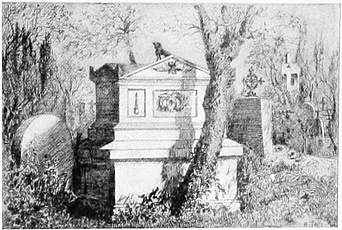 |
| THE TOMB OF PRUDHON AND CONSTANCE MAYER AT PÈRE-LACHAISE. |
In general, Prudhon was not a tragic painter; his preference was for the more joyous, light and dreamy, delicately veiled myths of the ancients. His misfortunes taught him to flee from reality, and on the wings of Art he saved himself, in the realm of legendary love and visionary happiness. So we see Psyche borne aloft by Zephyr through the twilight to the nuptial abode of Eros. A soft light falls upon her snowy body; her head has fallen upon her shoulder, and one arm, bent backwards, enframes her face. Silent like a cloud, the group moves onward—a sweet-scented apparition from fairyland. Now, enraptured genii visit the slumbering Fair One in forest-shadows, under the shimmering moon; now she is stealing secretly down to bathe in a tranquil lake, and gazes with astonishment upon her own likeness in the gloomy mirror. Here Venus, drawing deep breaths of secret bliss, is seated, full 204 of longing love, by the side of Adonis. Who else, at that time, could draw nude figures of such faultless beauty, so slender and pure, with lines so supple and yet so firm, and enveloped in so full and soft a light? Or again, he paints Zephyr swinging roguishly by the side of a stream. A gentle breeze plays through his locks, and the cool darkness of the wood breathes through all things round.
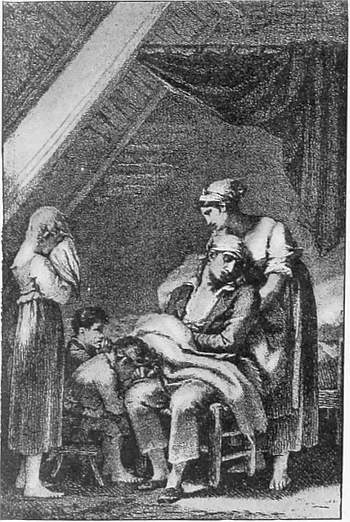 |
| Gaz. des Beaux-Arts. |
| PRUDHON. THE UNFORTUNATE FAMILY. |
Prudhon’s work is never a laborious patchwork of fragments of antique forms picked up here and there, never the insipid product of the reason working in accordance with recipes long handed down; it is thoroughly intuitive. Never keeping too closely to his model, he gave to his creations the movement and the divine breath of life. In his hands with dreamlike fidelity the Antique rose up again renewed, new in the sense of his own completely modern sentiment, and in that of those great masters of the Renaissance who had wakened it to life three hundred years before. For Prudhon, as is shown by his landscape backgrounds, is altogether Jean Jacques Rousseau’s contemporary, the child of that epoch in which Nature revealed itself anew; and, as is proved by his figures, he is a congenial spirit to Antonio da Allegri and Vinci. In fresh recollection of Correggio, he loves a soft exuberance of flesh and a delicate semi-obscurity; in enthusiastic reverence for Leonardo, those heads of women, with deep, sensuously veiled eyes, and that mysterious delicate smile playing dreamily round the wanton mouth. Only, the enchanting sweetness of the Florentine and the delicious ecstasy of the Lombard are toned down by a gentle melancholy which is entirely modern. The Psyche borne up to heaven by Zephyr changes in the end, when purified and refined, into the soul itself, which, in the form of the Madonna, ascends into heaven, transfigured with longing desire; and Venus, the goddess of love, is transformed into Love immortal, “Who, stretched upon the Cross, yet reacheth out His hand to thee.”
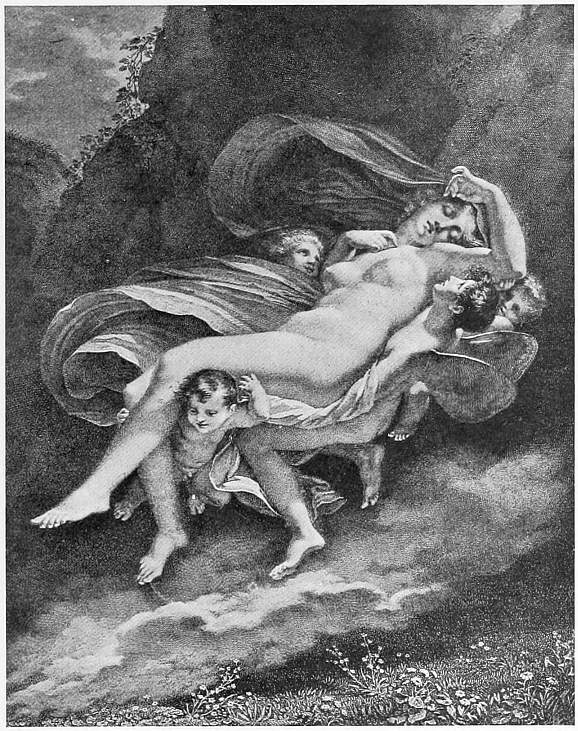 | |
| PRUDHON. | THE RAPE OF PSYCHE. |
This man, with his soft tenderness and fine feeling for the eternal feminine, was as though fashioned by Nature to be the painter of women of his time. If David was the chief depicter of male faces bearing a strong impress of character, 205 delicate, refined, womanly natures found their best interpreter in Prudhon. His heads of women charm one by the mysterious language of their eyes, by their familiar smile, and by their dreamy melancholy. No one knew better how to catch the fleeting expression in its most delicate shades, how to grasp the very mood of the moment. How piquant is his smiling Antoinette Leroux with her dress à la Charlotte Corday, her coquettish extravagant hat, and all the amusing “chic” of her toilette! Madame Copia, the wife of the engraver, with her delicately veiled eyes, has become in Prudhon’s hands the very essence of a beautiful soul. A languishing weariness, a remarkable 206 mingling of Creole grace and gentle melancholy, breathes over the portrait of the Empress Josephine. She is represented seated on a grassy bank in a dignified yet negligent attitude, her head slightly bent, her gaze wandering afar with a look of uncertain inquiry, as though she had some faint presentiment of her coming misfortune; and the dreamy twilight-shadows of a mysterious landscape are gathering around her.
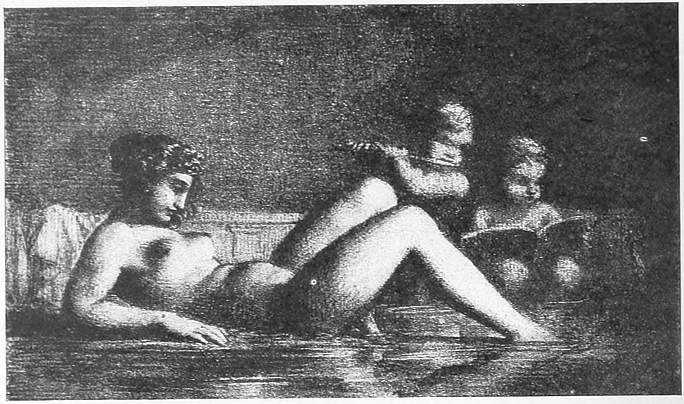 | |
| PRUDHON. | LE MIDI. |
Coming after a period of colour asceticism, Prudhon was the first to show a fine feeling for colour. Even during the revolutionary era he protested in the name of the graceful against David’s formal stiffness. He sought to demonstrate that human beings do not in truth differ very widely to-day from those in whom Leonardo and Correggio delighted, that they are fashioned out of delicate flesh and blood, not out of marble and stone. Standing beside David, he appealed to the art of colour. But as with André Chénier, a spirit congenial to his, it was long before he attained success. His modesty and his rustic character could effect nothing against the dictatorial power of David, on whom had been showered every dignity that Art could offer. People continued to ridicule poor Prudhon, who worked only after his own fantasy, who had fashioned for himself in chiaroscuro a poetic language of his own, till the question was raised again from another side, and this time by a young man who came directly out of David’s studio.
Antoine Jean Gros was one of David’s pupils, and stood out among his fellows as the one most submissively devoted to his master; yet it was he who, without wishing it or knowing of it, was preparing the way for the overthrow of David’s school. He was born 17th March 1771, at Paris, where 207 his father was a miniature painter. His vocation was determined in the studio of Mme. Vigée-Lebrun, who was a friend of his parents. In the Salon of 1785, which contained David’s “Andromache beside the Body of Hector,” he chose his instructor. He was then the handsome youth of fifteen represented in his portrait of himself at Versailles, with delicate features, full of feeling, on which lies an amiable, gentle cast of sentimentality. Two large, dark-brown eyes look out upon the world astonished and inquiring, dark hair surrounds the quiet, fresh face, and over it is cocked a broad-brimmed felt hat. In this picture we see a fine-strung, sensitive nature, a soul which would be plunged by bitter experiences into depths of despair, in proportion as success would raise it to heights of ecstasy. In 1792 he competed unsuccessfully for the Prix de Rome, and this failure was the making of him.
 | |
| PRUDHON. | LA NUIT. |
He went to Italy on his own account, and was an eye-witness of the war which Napoleon was there waging. There he beheld scenes in which archæology had no part. For when Augereau’s foot-soldiers carried the bridge of Arcola by assault, they had little thought of imitating an antique bas-relief. Gros observed armies on the march, and saw their triumphant entry into festally decorated cities. He learnt his lesson on the field of battle, and on his return placed on record what he had himself gone through. In Italy he caught the poetry of modern life, and at the same time was enabled as a painter to supplement David’s lectures with the teaching of another surpassing master. It was in Genoa that he became acquainted with Rubens. As Prudhon’s originality consisted in the fact that he was the first of that period again to stand dreaming before Leonardo and Correggio, so did 208 Gros’ lie in this, that he studied Rubens at a time when the Antwerp master was also completely out of fashion. His instinct as a painter had at the very commencement guided him to Rubens’ “St. Ignatius,” which in his letters he described as a “sublime and magnificent work.” When he was subsequently appointed a member of the Commission charged with the transference of works of art to Paris, he had abundant opportunities of admiring critically the works of the sixteenth and seventeenth century masters. The two impressions thus received had a decisive effect upon his life. Gros became the great colourist of the Classical school, the singer of the Napoleonic epos. Compared with David’s marmoreal Græco-Romans, Gros’ figures seem to belong to another world; his pictures speak, both in purport and in technique, a language which must more than once have astonished his master.
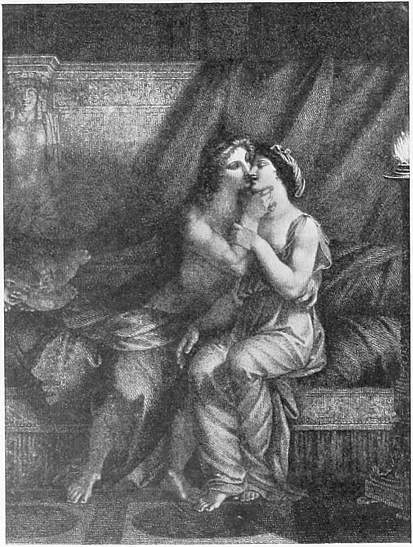 |
| PRUDHON. L’ENJOUIR. |
He was fortunate enough to be presented to Josephine Beauharnais, and through her to Bonaparte, in the Casa Serbelloni at Milan; and Gros, whose earnest desire it was to paint the great commander, was appointed a lieutenant on his staff. He had occasion, in the three days’ battle of Arcola, to admire the Dictator’s impetuous heroism; and he made a sketch of the General storming the bridge of Arcola at the head of his troops, ensign in hand. It pleased Napoleon, who saw in it something of the dæmonic power of the future conqueror of the world; and when the picture was exhibited in Paris in 1801 it met there also with the most striking success. The greater warmth of colour, the broader sweep of the brush, and the life-like movement of the figures seemed, in comparison with David’s monotonous manner, to be far-reaching innovations.
With his “Napoleon on the Bridge of Arcola” Gros had found his peculiar talent. What his teacher had accomplished as painter to the Convention, Gros carried to a conclusion in that span of time during which Napoleon lived in the minds of his people as a 209 hero. He too made an occasional excursion into the domain of Greek mythology, but he did not feel at home there. His field was that living history which the generals and soldiers of France were making. He won for contemporary military life its citizenship in art. David, wishing to remain true to “history” and to “style,” had depicted contemporary events with reluctance. What Gérard and Girodet had produced was interesting as a protest on the part of reality against classical convention, but on the whole it was unsatisfying and wearisome. Gros, the famous painter of the “Plague of Jaffa” and of the “Battle of Eylau,” was the first to attain to high renown in this field.
 | |
| PRUDHON. | MARGUERITE. |
These are two powerful and genuine pictures, two pre-eminent works which will endure. Gros stands far above David and all his rivals in his power of 210 perception. The elder painter is now out of date, while Gros remains ever fresh, because he painted under the impulse given by real events, and not under the ban of empty theories. A realist through and through, he did not shrink from representing the horrible, which antique art preferred to avoid. In an epoch when Rome and Greece were the only sources of inspiration he had the courage to paint a hospital, with its sick, its dying, and its dead. When in the Egypto-Syrian campaign the plague broke out after the storming of Jaffa, Napoleon, accompanied by a few of his officers, undertook, on 7th March 1799, to visit the victims of the pestilence. This act deserved to be celebrated in a commemorative picture. Gros took it in hand, and represented Napoleon, in the character of consoler, amid the agonising torments of the dying; deviating from historical accuracy only so far as to transfer the scene from the wretched wards of the lazaretto to the courtyard of a pillared mosque. In the shadows of the airy halls sick and wounded men twist and writhe, stare before them in despair, rear themselves up half-naked in mortal pain, or turn to gaze upon the Commander-in-Chief, a splendid apparition full of youthful power, who is tranquilly feeling the plague boils of one of their comrades. Here and there Orientals move in picturesque costumes, distributing the food which negro lads are bringing in. And beyond, over the battlements of the Moorish arcades, one sees the town with its fortifications, its flat roofs and slender minarets, over which flutter the victorious banners of the French. On one side lies the distant, glittering blue sea, and over all stretches the clear, glowing southern sky.
Like a new gospel, like the first gust of wind preceding the storm of Romanticism, this picture standing in the Louvre, surrounded by its stiff Classical contemporaries, excites a sensation of pleasure.
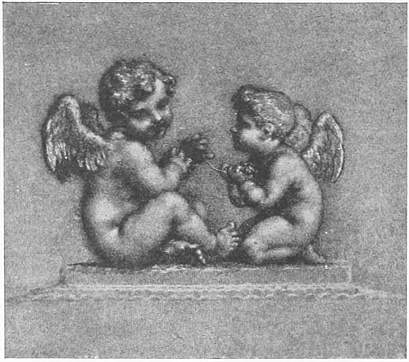 |
| PRUDHON. LES PETITS DÉVIDEURS. |
Gros’ heroes know, as David’s do, that they are important, and show it perhaps too much, but at least they act. The painter felt what he was painting, and an impulse of human love, an heroic and yet human life, permeates the picture. Moreover, Gros did not content himself with the scanty palette and the miserable cartoon-draughtsmanship of his contemporaries. This treatment of the nude, these despairing heads of dying men, show none of the stony lifelessness of the Classical 211 school; this Moorish courtyard has no resemblance to the tragedy peristyle so habitually employed up to that time; this Bonaparte laying his hand upon the dying man’s sores is no Greek or Roman hero. The sick men whose feverish eyes gaze upon him as on the star of hope, the negroes going up and down with viands, are no mere supernumeraries; the sea lying in sunshine beyond, full of bustling sails, and the harbour gaily decked with many-coloured flags, point in their joyous splendour of colouring to the dawn of a new era. The young artists were not mistaken when, in the Salon of 1804, they fastened a sprig of laurel to the frame of the picture. The State bought it for sixteen thousand francs. A banquet at which Vien and David presided was given in honour of the painter. Girodet read a poem, of which the conclusion ran as follows—
| “Et toi, sage Vien, toi, David, maître illustre, Jouissez de vos succès; dans son sixième lustre, Votre élève, déjà de toutes parts cité, Auprès de vous vivra dans la postérité.” |
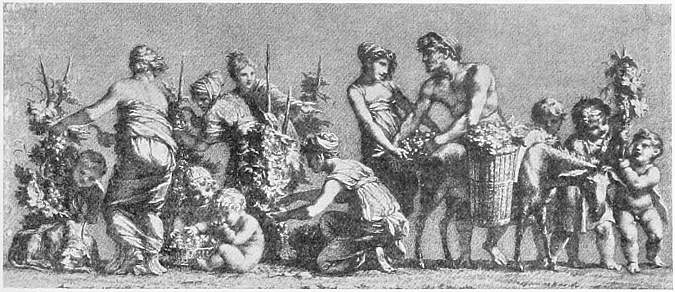 | |
| PRUDHON. | THE VINTAGE. |
In his “Battle of Eylau,” exhibited in 1808, Gros has given us a companion picture to the “Plague of Jaffa”: in one a visit to a hospital, in the other the inspection of a field of battle after the fight is over. The dismal grey hue of winter rests upon the white sheet of snow stretching desolately away to the horizon, only interrupted here and there by hillocks beneath which annihilated regiments sleep their last sleep. In the foreground lie dead bodies heaped together, and moaning wounded men; and in the midst of this horror of mangled limbs and corrupting flesh he, the Conqueror, the Master, the Emperor, comes to a halt, pale, his eyes turned towards the cities burning on the horizon, in his grey overcoat and small cocked hat, at the head of his staff, indifferent, inexorable, merciless as Fate. “Ah! si les rois pouvaient contempler ce spectacle, ils scraient moins avides de conquêtes.” The classical posturing which still lingered, a disturbing element, in the Plague picture, has been put aside 212 completely. The conventional horse from the frieze of the Parthenon, which David alone knew, has given way to the accurately observed animal, and the colouring too, in its sad harmony, has fully recovered its ancient right of giving character to the picture. It was, beyond all controversy, the chief work in the Salon of 1808, rich in remarkable pictures; neither Gérard’s “Battle of Austerlitz,” nor Girodet’s “Atala,” nor David’s Coronation piece endangered Gros’ right to the first place.
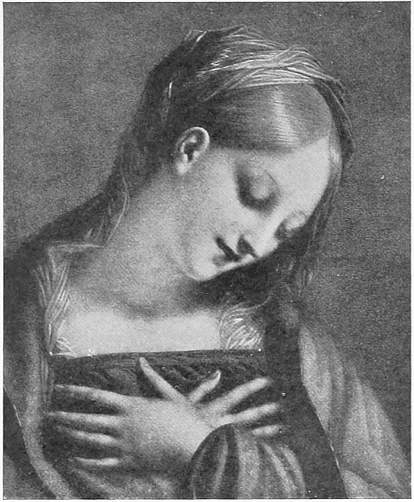 |
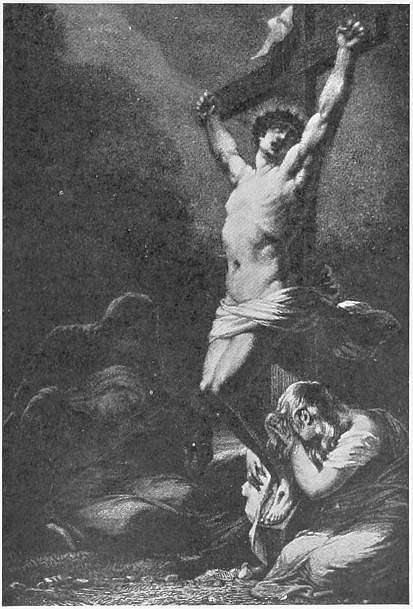 | ||
| PRUDHON. | THE VIRGIN. | PRUDHON. | CHRIST CRUCIFIED. |
“Napoleon before the Pyramids,” at the moment when he cries, “Soldiers, from the summit of those monuments forty centuries contemplate your actions,” constitutes, in 1810, the coping-stone of the cycle. Gros alone at that time understood the epic grandeur of war. He became, also, the portrait painter of the great men from whom its events proceeded. His picture of General Masséna, with its meditative, slily tenacious expression, is the genuine portrait of a warrior; and how well is heroic, simple daring depicted in the likeness of General Lasalle, without the commonplace device of a mantle puffed out by the wind! His portrait of General Fournier Sarlovèse, at Versailles, has a freshness of colouring, the secret of which no one else possessed in those days except the two Englishmen, Lawrence and Raeburn. Gros was far in advance of his age. A painter of movement rather than of psychological analysis, he brought out character by means of general effect, and gave the essentials in a masterly way. His portraits, just as much as his historical pictures, have a stormy exposition. In David all is calculation; in Gros, fire. Almost alone among his contemporaries, he had studied Rubens, and like him gave colour the place due to it. At times there is in his pictures a natural flesh-colour and an animation which make this warm-hearted man, who has not been sufficiently appreciated, a genuine forerunner of the moderns. Surrounded as he was by orthodox Classicists, he cried in a loud voice what Prudhon had already ventured to say 213 more timidly: “Man is not a statue—not made of marble, but of flesh and bone.”
But as with Prudhon, so with Gros. This man, of exaggerated nervousness, was lacking in that capacity for persistence which belongs to a strong will conscious of its aim; he lacked confidence in himself and in the initiative he had taken. So long as the great figure of Napoleon kept his head above water he was an artist; but when his hero was taken from him he sank. The Empire had made Gros great, its fall killed him. The incubus of David’s antique manner began once more to press upon him, and when David after his banishment (in 1816) committed to him the management of his studio in Paris, Gros undertook the office with pious eagerness, on nothing more anxiously intent than as a teacher once more to impose the fetters of the antique upon that Art which he had set free by his own works. “It is not I who am speaking to you,” he would say to the pupils, “but David, David, always David.” The latter had blamed him for having taken the trouble to paint the battles of the Empire, “worthless occasional pieces,” instead of venturing upon those of Alexander the Great, and thus producing genuine “historical works.” “Posterity requires of you good pictures out of ancient history. Who, she will cry, was better fitted to paint Themistocles? Quick, my friend! turn to your Plutarch.” To depict contemporary life, which lies open before our eyes, was, he held, merely the business of minor artists, unworthy the brush of an “historical painter.” And Gros, who reverenced his master, was so weak as to listen to his advice: he believed in him rather than in his own genius, in the strength of others rather than his own. He searched his Plutarch, and painted nothing more without a previous side-glance towards Brussels; introduced allegory into his “Battle of the Pyramids”; 214 composed in homage to David a “Death of Sappho”; and painted the cupola of the Pantheon with stiff frescoes; while between times, when he looked Nature in the face, he was now and then producing veritable masterpieces.
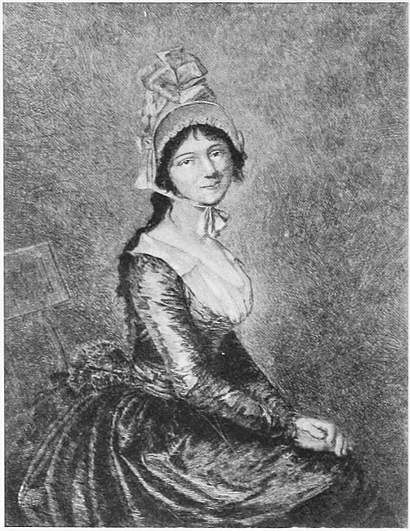 |
| Gaz. des Beaux-Arts. |
| PRUDHON. MADAME COPIA. |
His “Flight of Louis XVIII” in the Museum at Versailles, shows him once more at his former height. It is “one of the finest of modern works,” as Delacroix called it in 1848, in an essay contributed to the Revue des Deux Mondes; at once familiar and serious. Napoleon had left Elba, marched on Paris, and had reached Fontainebleau, when, in the night of the 19th-20th March 1815, Louis XVIII determined to evacuate the Tuileries with all speed. Accompanied by a few faithful followers and by the officers of his personal service, he abandons his palace and takes leave of the National Guards. There is something pathetic in this sexagenarian with his erudite Bourbon profile, immortalised in the large five-franc pieces of his reign, with his protruding stomach and small thick legs, looking like a dropsical patient going to hospital. His bearing is most unkingly. Gros has boldly depicted the scene, even to the pathological appearance of the king, just as he saw it, forgetting all that he knew of antique art. He had himself seen the staircase, the murmuring crowd, the lackeys hurrying by, lantern in hand, at their wits’ end, and the fat, gouty king, who in his terror has forgotten all kingly dignity.
That was an historical picture, and yet as he painted it he reproached himself anew for having forsaken the “real art of historical painting.” At the funeral of Girodet in 1824 the members of the Institute talked of their “irreparable loss,” and of the necessity of finding a new leader for the school who should avert with a strong hand that destruction which hot-headed young men threatened to bring upon it. “You, Gros,” observed one of them, “should be the man for the place.” And Gros answered, in absolute despair; “Why, 215 I have not only no authority as leader of a school, but, over and above that, I have to accuse myself of giving the first bad example of defection from real art.” The more he thought of David, the more he turned his back upon the world of real life. With his large and wearisome picture of “Hercules causing Diomedes to be devoured by his own Horses” (1835) he sealed his own fate. Conventionality had conquered nature.
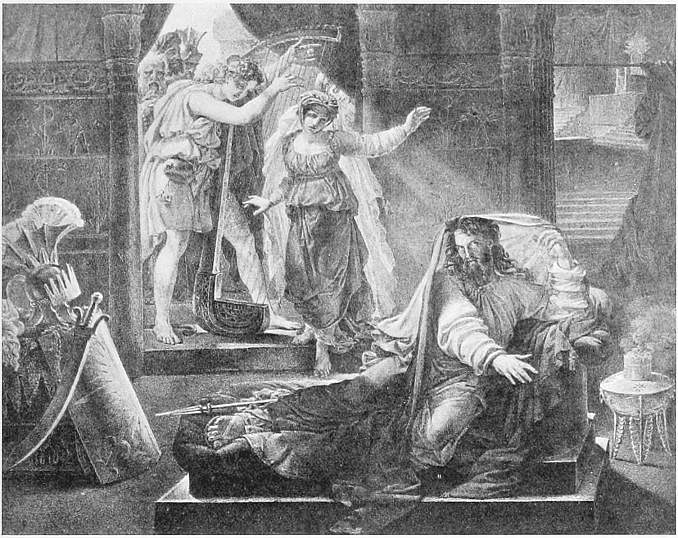 | |
| GROS. | SAUL. |
The painters overwhelmed him with ridicule, and a shrill shout of derision rose from all the critics. Already, for some time past, a few writers had risen to protest against the Classical school. They spoke with fiery eloquence of the rights of humanity, the benefits of liberty, the independence of thought, the true principles of the Revolution, and found numerous readers. They fought against rigid laws in the intellectual as well as the social sphere; they pointed out that there were other worlds besides that of antiquity, and that even the latter was not peopled exclusively by cold statues; they delighted in describing the great and beautiful scenes of Nature, and opened out once more a new and broad horizon to art and poetry. The Spring was awakening; Gros felt that he had outlived himself. Arming himself against the voices of the new era with the fatal heroism of the deaf, he became the martyr of 216 Classicism in French art. He was a Classic by education, a Romantic by temperament; a man who took his greatest pride in giving the lie as a teacher to the work he had accomplished as an artist, and this discordance was his ruin.
On the 25th of June 1835, being sixty-four years of age, he took up his hat and stick, left his house without a word to any one, and laid himself face-downwards in a tributary of the Seine near Meudon. It was a shallow place, scarce three feet deep, which a child could easily have waded through. It was not till next day, when he had been dead for twenty-four hours, that he was discovered by two sailors walking home along the bank. One of them struck his foot against a black silk hat. In it there was a white cravat marked with the initial G., carefully folded, and upon it a short note to his wife. On a torn visiting-card could still be read the name, Baron Gros. A little farther on they saw the corpse, and as they were afraid to touch a drowned man, they drew lots with straws to decide which of them should pull him out. “I feel it within me, it is a misfortune for me to be alone. One begins to be disgusted with one’s self, and then all is over,” he had once in his youth written to his mother with gloomy foreboding. Such was the end of a master every fibre of whose being was in revolt against Classicism, and who had so great a love for colour, truth, and life.
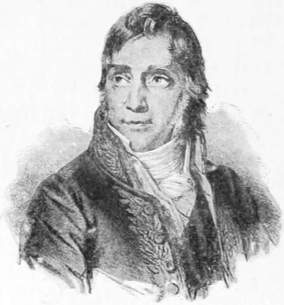 |
| L’Art. |
| ANTOINE JEAN, BARON GROS. |
More important events were yet to take place before the signal of deliverance could be expected. It was the young men who had grown up amid the desolate associations of the Restoration who were to lead to victory the new movement of which Prudhon and Gros had been the forerunners. The dictatorship over art of that Classical school which had been taken over from the seventeenth century was limited to a single generation—from the birththroes of the Revolution to the fall of the Napoleonic Empire. For although many of David’s pupils survived until the middle of the century, yet they were merely academic big-wigs, who, compared with the young men of genius who were storming their positions, represent that mediocrity which had indeed attained to external honours, but had remained stationary, fast bound to antiquated rules. The future belonged to the young, to a youth which from the standpoint of our own days seems even younger than youth commonly is, richer, fresher, more glowing and fiery—the Generation of 1830, the “vaillants de dix-huit cent trente,” as Théophile Gautier called them in one of his poems.
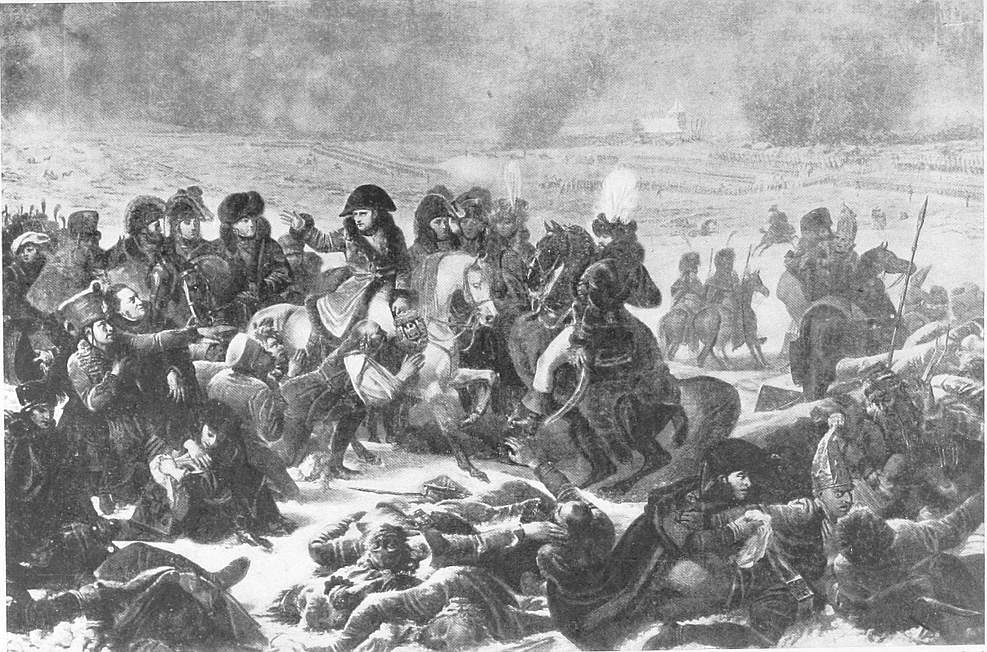 | |
| Photo, Levi. | |
| GROS. | THE BATTLE OF EYLAU. |

CHAPTER X
THE GENERATION OF 1830
During the years which elapsed between 1820 and 1848 France produced a great and admirable school of art. After the convulsions of the Revolution and the wars of the Empire, that generation had arisen, daring and eager for action, which de Musset describes in his Confessions d’un Enfan du Siècle. And these young men, born between the thunders of one battle and another, who had grown up in the midst of greatness and glory, had to experience, as they ripened into manhood, the ignominy of Charles X’s reign, the period of clerical reaction. They saw monasteries re-erected, laws of mediæval severity made against blasphemy and the desecration of churches and saints’ days, and the doctrine of the divine origin of the monarchy proclaimed anew. “And when young men spoke of glory,” says de Musset, “the answer was, ‘Become priests!’ And when they spoke of honour, the answer was, ‘Become priests!’ And when they spoke of hope, of love, of strength and life, ever the same answer, ‘Become priests!’” The only result of this pressure was to intensify all the more the impulse towards freedom. The political and intellectual reaction could only have the effect of impelling the poetic and artistic emotions of young and unquiet spirits into opposition, on principle, to all that was established, into a fiery contempt for public opinion, into the apotheosis of unrestrained passion and unfettered genius. The French Romanticists were anti-Philistines who regarded the word “bourgeois” as an insult. For them Art was the one supreme consideration; it was to them a light and a flame, and its beauty and daring the only things worth living for. For those who put forward such demands as these, the “eunuchism of the Classical”—an expression of George Sand’s—could never suffice. They dreamed of an art of painting which should find its expression in blood, purple, light, movement, and boldness; they held in sovereign contempt the correct, pedantic, colourless tendency of their elders. An inner flame should glow through and liberate the forms, absorb the lines and contours, and mould the picture into a symphony of colour. What was desired and sought for, in poetry and in music, in plastic art and in painting, was colour and passion: colour so energetic, that drawing was, as it were, consumed by it; passion so vehement, that lyrical poetry and the drama were in danger of becoming feverish and convulsive. A movement which reminds one of the Renaissance took possession of all minds. It was as 220 though there were something intoxicating in the very air that one breathed. On a political background of grey upon grey, consisting of the cowls of the Jesuits of the Restoration, there arose a flaming, refulgent, blustering literature and art, scintillating with sparks and bright hues, full of the adoration of passion and of fervid colour. Romanticism is Protestantism in literature and art—such is Vitet’s definition of the movement.
Literature, which, adapting itself to the politics of the government, had begun in Chateaubriand with an enthusiastic fervour for Catholicism, Monarchy, and Mediævalism, had in the twenties become revolutionary; and the description of its battles is one of the most glowing chapters in George Brandes’ classic work. There was a revolt against the pseudo-antique, against the stiff handling of the Alexandrine metre, against the yoke of tradition. Then arose that mighty race of Romantic poets who proclaimed with Byronic fire the gospel of nature and passion. De Musset, the famous child of the century, the idol of the young generation, the poet with the burning heart, who rushed through life with such eagerness and haste that at the age of forty he broke down altogether, worn out like a man of seventy, deliberately wrote bad rhymes in his first poems, for the purpose of thoroughly infuriating the Classicists. So, too, he wrote his dramas, in which love is glorified as a serious and terrible power with which one may not trifle, as the fire with which one must not play, as the electric spark that kills. So George Sand, the female Titan of Romanticism, published her novels, with their subversive tendencies and their sparkling animation of narrative. Between these two rises the keen bronze-like profile of Prosper Mérimée, who prefers to describe the life of gypsies and robbers, and to depict the most violent and desperate characters in history. Finally, Victor Hugo, the great chieftain of the Romantic school, the Paganini of literature, unrivalled in imposing grandeur, in masterly treatment of language, and in petty vanity, found submissive multitudes to listen to him when he rose in fierce and fiery insurrection against the rigid laws of the bloodless Classical style, and substituted for the actionless and ill-contrived declamatory tragedies of his time his own romantic dramas, breathing passion and full of diversified movement.
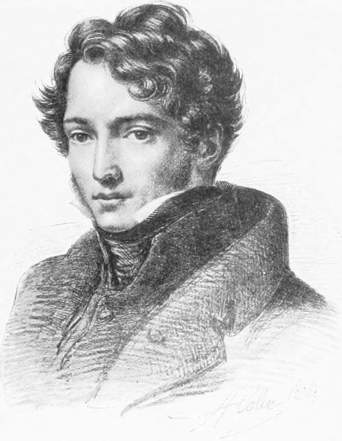 |
| THÉODORE GÉRICAULT. |
The conflict was deadly. The young generation hailed with applause the new Messiah of letters, and grew intoxicated with the harmony of Hugo’s phrases, which sounded so much fuller and fierier than the measured speech of Corneille and Racine. The Théâtre Français, recently benumbed as with the quiet of the grave, became all at once a tumultuous battlefield. There they sat, when Hugo’s Cromwell and Hernani were produced on the stage, correct, well dressed, gloved, close shaven, with their neat ties and shirt collars, the representatives of the old generation, whose blameless conduct had raised them to office and place. And in contrast to them, in the pit were crowded together the young men, the “Jeune France,” as Théophile Gautier described them, one with his waving hair like a lion’s mane, another with his Rubens hat and Spanish mantle, another in his vest of bright red satin. Their common 221 uniform was the red waistcoat introduced by Théophile Gautier—not the red chosen for their symbol by the men of the Revolution, but the scarlet-red which represented the hatred felt by these enthusiastic young men for all that was grey and dull, and their preference for all that is luminous and magnificently coloured in life. They held that the contemplation of a beautiful piece of red cloth was an artistic pleasure. A similar change took place at the same time in ladies’ toilettes. As the Revolution had in ladies’ costumes rejected all colour in favour of the Grecian white, so now dresses once more assumed vivid, and especially deep red hues; deep red ribbons adorned the hat and encircled the waist.
Deep red—that was the colour of the Romantic school; the flourishing of trumpets and the blare of brass its note. Flashes of passion and ferocity, rivers of sulphur, showers of fire, glowing deserts, decaying corpses in horrible phosphorescence, seas at night-time in which ships are sinking, landscapes over which roaring War shakes his brand, and where maddened nations fall furiously upon one another—such are the subjects, resonant with shout of battle and song of victory, which held sway over French Romanticism. At the very time when at Düsseldorf the young artists of Germany were painting with the milk of pious feeling their lachrymose, susceptible, sentimental pictures, utterly tame and respectable; when the Nazarene school were holding their post-mortem on the livid corpse of old Italian art, and seeking to galvanise it, and with it the Christian piety of the Middle Ages, into life again; at that very time there arose in France a young generation boiling over with fervour, who had for their rallying cry Nature and Truth, but demanded at the same time, and before all else, contrast, pictorial antithesis, and passion at once lofty and of tiger-like ferocity. In those very years, when in Germany, the cartoon style of Carstens having died away, progress was limited to a timid and unsuccessful pursuit of that revelry of colour which marked the Quattrocentisti, the French took at once, as with the seven-leagued boots of the fairy-tale, the great stride onward towards the Flemings.
Through Napoleon, France had grown richer, not only in glory, but in art treasures, gathered together from all countries into Paris, as trophies of 222 the victorious general. The abundant collections thus accumulated brought to bear upon that generation the quickening influence of the best that had been done in the art of painting. Nowhere could one study either the Venetian colourists or Rubens to greater advantage than in the Louvre, and it was by virtue of this unrestrained intercourse with the masters who represent the most perfect blossom of colouring that the Byronic spirits of 1830 succeeded in giving full expression to the glowing full-coloured life of things which hovered before their heated imagination. It is unnecessary to say that this was accompanied by a great widening of the range of subjects treated. The Romantic school showed that there were other heroes in history and poetry besides the Greeks and Romans. They painted everything, if only it possessed colour and character, flame, passion, and exotic perfume. Romanticism was the protest of painting against the plastic in art, the protest of liberty against the academic teaching of the Classical school, the revolution of movement against stiffness.
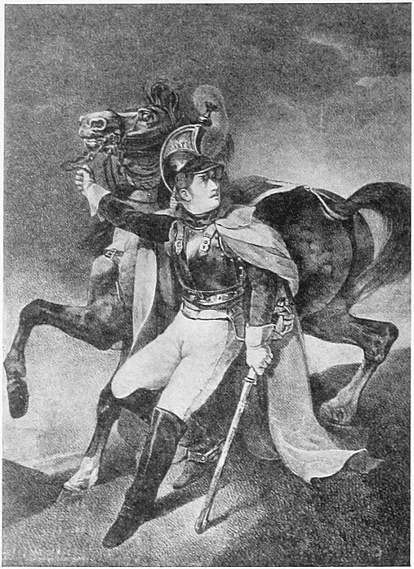 |
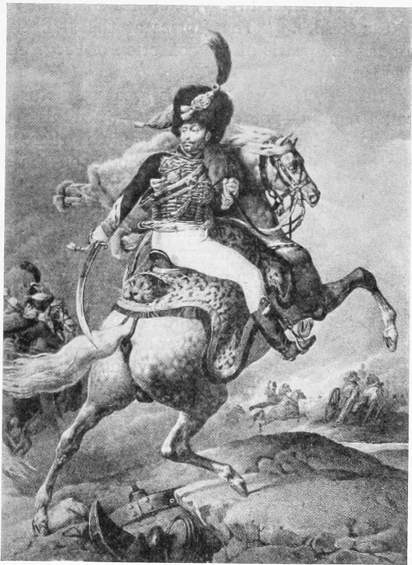 | ||
| GÉRICAULT. | THE WOUNDED CUIRASSIER. | GÉRICAULT. | CHASSEUR. |
It was in the studio of Guérin, the tame and timid Classicist, that the young assailants grew up, “the daubers of 1830,” who called the Apollo Belvidere a shabby yellow turnip, and who spoke of Racine and Raphael as of street arabs. They were tired of copying profiles of Antinous. The contemplation of a picture by Girodet was wearisome to them. It was Théodore Géricault, a hot, hasty passionate nature, of Beethoven-like unruliness and of heaven-storming boldness, who spoke the word of deliverance.
He was a Norman, sturdily built and serious in manner. Even while he was studying in Guérin’s studio he had already grasped some of the ideas which Gros had in his mind, and, although not his pupil, Géricault may be said to have continued his work, or at least would have been able to do so had he lived longer. Like him, he had from his youth up contemplated, full of 223 wonder, the rolling sea and the thunder-laden skies; like him, he had a predilection for fine horses; and, being of a somewhat melancholy disposition, he preferred to treat of the darker aspects of life. His aspiration was to paint the surging sea, proud steeds rushing past at a gallop, suffering and striving humanity, great deeds, pathos and frenzy in every form. His first works were splendid horsemen, whose every muscle twitches with nervous movement. During his short stay in Charles Vernet’s studio he had already taken an interest in cavalry, and begun the studies of such subjects, which he continued to the day of his death. Afterwards, while he was working under Guérin and before his visit to Italy in 1817, he often went to the Louvre, copied pictures and studied Rubens, to the great annoyance of his teacher, who with horror beheld him entering upon so perilous a path.
Here again he followed in the steps of Gros, whose portrait of General Fournier Sarlovése was hung in the Salon of 1812 close by Géricault’s “Mounted Officer.” This picture, a portrait of M. Dieudonné, an officer in the Chasseurs d’Afrique, crossing the battlefield sword in hand on a rearing horse, was the first work exhibited by Géricault, then twenty-one years of age. It was an event. Gros found himself supported, if not surpassed, by a beginner who had his own enthusiasm for colour and movement, for profiles broadly and boldly delineated. In 1814 followed the “Wounded Cuirassier,” staggering across the field of battle and dragging his horse behind him. These were no longer warriors seated on classical steeds foaming with rage, but real soldiers in whom there was nothing of the Greek statue. Then Géricault went to Italy, but in this case also it was not to pursue archæological studies in the museums, but to see the race of the barberi during carnival. To this time belong those studies of horses, for the possession of which collectors vie 224 with one another to-day, sketches made in the open air, out in the street or in the stables. “The Horses at the Manger” and “Horses fighting” were among the pearls of the collection of French drawings in the Paris Exhibition of 1889.
In 1819 he completed his greatest picture, that which most people alone call to mind—not quite fairly—when his name is mentioned—“The Raft of the Medusa.” What a tragedy is there represented! For twelve days the unfortunate wretches have been on the deep, starving, in utter despair and ready to lift their hands against each other. They were a hundred and fifty, now they are but fifteen. One old man holds upon his knees the corpse of his son; another tears his hair out, left alone in life after seeing all his dear ones perish. In the foreground lie dead bodies which the waves have not yet swept away. But far away in the distance a sail appears. One points it out to another: yes, it is a sail! A mariner and a negro mount upon an empty barrel and wave their handkerchiefs in the air. Will they be seen? The anxiety is terrible. And ever higher and higher the grey waves roll on.
 | |
| Seemann, Leipzig. | |
| GÉRICAULT. | THE RAFT OF THE MEDUSA. |
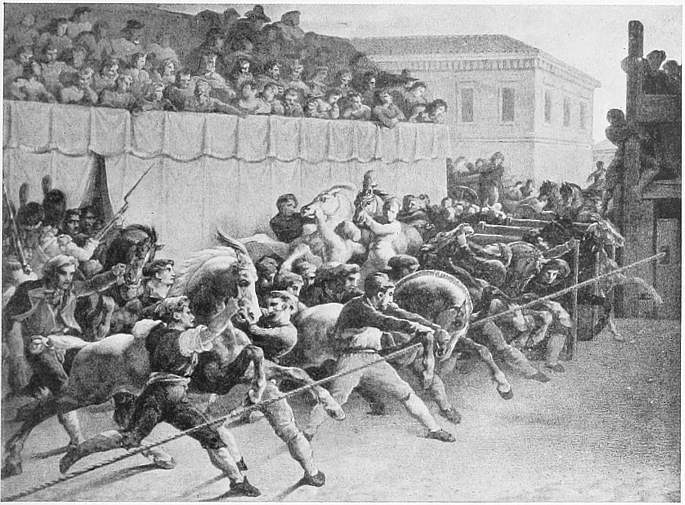 | |
| GÉRICAULT. | THE START. |
How must such a scene have impressed a generation which for long years had seen nothing in the Salon but dry mythology and painted statues! Géricault was the first to free himself from the tyranny of the plaster-of-Paris bust, and once again to put passion and truth to nature in the place of cold marble. 225 Just as he commissioned the ship’s carpenter who had constructed the raft and was one of the saved to make him a model of it, so also he moved into a studio close to the hospital, for the purpose of studying the sick and dying, of sketching dead bodies and single limbs. It must be admitted that one would wish for a yet firmer grasp of the subject. In form, Géricault still belongs to the school of David. A good deal of Classicism shows itself in the fact that he thought it necessary to depict the majority of the figures naked, in order to avoid “unpictorial” costumes. There is still something academic in the figures, which do not seem to be sufficiently weakened by privation, disease, and the struggle with death; but what man can free himself at one stroke from the influence of his time and environment? Even in the colouring there lingers some touch of the Classical school. It offends no one, a fact to be insisted on in comparing him with the Nazarenes; but as yet it plays no part in expressing the meaning of the picture. From the distance, indeed, whence the rescuing ship is drawing near, a bright light shines forth upon a scene otherwise depicted in dull brown. Save for this, the intention of the picture is not expressed by means of colour, and it even shows some retrogression as compared with Géricault’s earlier works. He had begun with Rubens, yet these studies in colouring did not last. In the “Wounded Cuirassier” of 1814 dark tones took the place of the former cheerfulness, and 226 so in the “Raft of the Medusa” he imagined the tragedy could be represented only in sombre hues. He spread over the whole scene a monotonous unpleasant brown shade, and in his endeavour to lay all weight upon human emotion he went so far as almost to suppress the sea, which nevertheless played the chief part in the drama, and whose deep blue would have afforded a splendid contrast. Discoveries are not to be made all at once, but only when their hour is come.
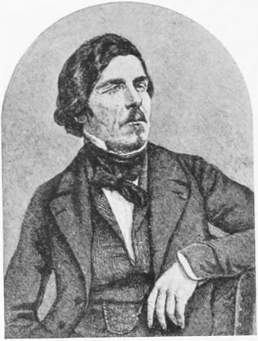 |
| Seemann, Leipzig. |
| EUGÈNE DELACROIX. |
The next step in French art was to be that of reinstating the significance of colour in the full rights conquered for it by Titian, so that it should no longer be merely a tasteful tinting of the figures, but should become truly that which gives its temper to the picture. It was not reserved for Géricault to effect this. A trip to London, which he made in 1820, in company with his friend Charlet, was the last event of his life. There the sportsman awoke in him once more, and he painted the “Race for the Derby at Epsom.” Soon after his return he was thrown from his horse while riding, but lingered on for two years longer, suffering from a spinal complaint. With a few more years in which to develop he should have been one of the great masters of France, but he died when scarcely in his thirty-second year.
Yet he lived long enough to observe, in the Salon of 1822, the début of one of his comrades from Guérin’s studio. A greater than himself, to whom with dying voice he had given a few words of advice, arose as the intellectual heir of the young painter so prematurely carried off, and carried to its issue the struggle which he had begun. It was on 26th April 1799, at midday, that the first genuine painter’s eye of the century saw the light, at Charenton Saint-Maurice. Géricault had made a beginning, but it was the impetuous, powerful genius of Eugène Delacroix which entered in and completed his work. What Gros had dimly perceived, but had not dared to express, what Géricault had barely had time with a courageous hand to point out, a hand too soon stiffened in death—the modern poetry of colour, of fever, and of quivering emotion—it was reserved for Delacroix to write.
“That child will grow up to be a famous man; his life will be extremely laborious, but also extremely agitated, and always exposed to opposition.” Thus had a madman prophesied of the boy one day when he and his nurse were taking a walk near the lunatic asylum at Charenton. And he was right.
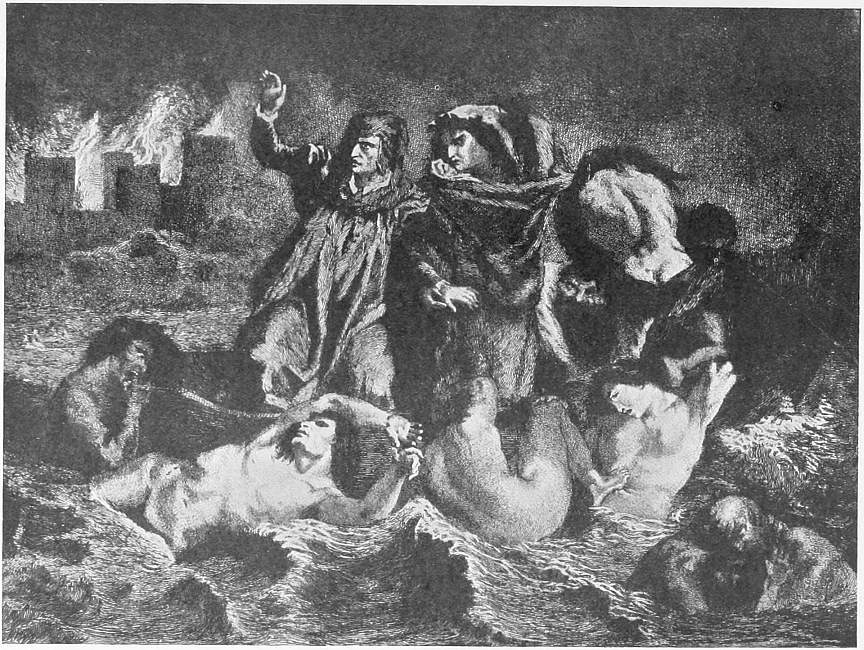 | |
| L’Art. | |
| DELACROIX. | DANTE’S BARK. |
Delacroix was another of the pupils who had grown up in Guérin’s studio, but he became the latter’s antipode. Even in his student years he took counsel, not of the antique, but of Rubens and Veronese; and when Géricault was painting his “Raft of the Medusa,” Delacroix belonged to the little band of enthusiastic admirers which gathered round the young master. He served as model for the half-submerged man to the left in the foreground of that picture. After busying himself at first almost entirely with caricatures, and studies of horses, and with Madonnas in the Classical style, he exhibited in 1822 his “Dante’s Bark,” in a pictorial sense the first characteristic picture of the century. One is inclined even to-day to repeat David’s exclamation when he caught sight of the work, the first great epoch-making life-utterance of the revolutionary Romanticists: “D’où vient-il? Je ne connais pas cette touche-la.” There were thoughts in it which had not been conceived and expressed in the same manner since the time of Tintoretto. Dante and Virgil, ferried by Phlegyas over Acheron, are passing among the souls of the damned, who grasp hold of the boat with the energy of despair. A theme taken from a mediæval author; an antique figure, that of Virgil, but seen through the prism of modern poetry. While the Florentine, stiff with horror, gazes upon the swimming figures which cling to the boat with teeth and nails, Virgil, tranquil and serious, turns on them a face which the emotions of life can no longer affect.
The work obtained a decisive success. A carpenter in Delacroix’s house had made for the young painter an inartistic frame of four boards. When he went to the exhibition and looked for his picture in the side-rooms he could not find it. The frame had fallen to pieces during removal, but the picture had been hung in an honourable place in the Louvre, in a rich frame ordered for it by Baron Gros. “You must learn drawing, my young friend, and then you will become a second Rubens,” was the salute which this remarkable man, whose theory ever gave the lie to his practice, gave the young master. Naturally Delacroix would not now have been admitted into the school of David, or would have been placed there in the lowest rank—with Rubens and a few other immortals, who drew no better than he did. He was absolutely opposed to all the exact, regular, well-balanced, colourless traditions which held sway in David’s school with their pedantic erudition and bourgeois discretion. The principle of the Classicists was the Greek type of beauty, and the translation of sculpture into painting. In Delacroix’s picture there was no longer anything of that sort. Géricault had already broken away from the academic stencilling of form, and had substituted natural expression, life, and emotion for conventional types; Delacroix now set aside the sullen colouring of the Classical school, and its painted statues made way for the colour-symphonies of the Venetians.
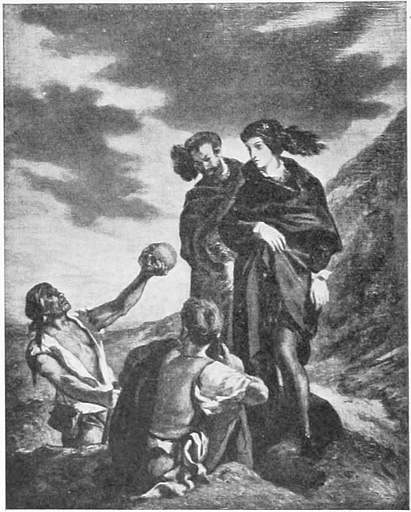 |
| Baschet. |
| DELACROIX. HAMLET AND THE GRAVE-DIGGERS. |
These reforming qualities found in his second work, a few years later, a much fuller expression than in the “Dante’s Bark.” At that time the Greeks, that heroic nation, struggling and dying for its religion and independence, had excited everywhere the deepest sympathy and enthusiasm. Delacroix was the very man to be inspired by such a theme. From the agitation 230 caused by the martyrdom of Greece, and from his taste for Byron’s poetry, resulted in 1824 the celebrated “Massacre of Chios,” on which he was already employed in 1821, before the completion of his “Dante’s Bark,” and in which his power of expression as well as of colour was carried much further than in the earlier picture. In the “Dante’s Bark” there were still, both in form and colour, reminiscences of the great Florentine masters; as, for instance, in the female figure in the foreground, which is almost an exact reproduction of Michael Angelo’s “Night.” The event depicted was comparatively quiet and tranquil, and the well-balanced composition would have done honour to the most rigorous follower of David. The only novelty lay in the treatment of colour, and in the substitution of the individual and characteristic for the typical and ideal. But undoubtedly it was now possible not only to produce in colour more powerful chords, but also in expression to strike notes more dramatic, for the academic plaster-of-Paris heads of the David school had depicted human emotion only in icy immobility. Delacroix had put all these possibilities into the new picture. The pyramidal configuration has resolved itself into an unconstrained grouping of figures. Here we have for the first time the artistic spirit intoxicated with colour, the “Orlando Furioso of colourists,” the pupil of Rubens, Delacroix. An entire world of deep feeling and of painfully passionate poetry, an entire world of tones, which the master under whose eyes he painted his “Dante” could not have conceived, lies enclosed within the frame of this picture. The figures, sitting, kneeling, partly reclining, with their half-starved bodies and their gloomy, brooding, hopeless faces; the desperate struggle between the conquerors and their victims in the far distance; the contrast between this scene of horror and the luminous splendour of the atmosphere, and the wealth of colour in the whole, made and still make this fine painting one of the most impressive pictures in the Louvre. It is a work which flames in glow of colour more than any that had appeared in 231 France since the days of Rubens. The English had been his teachers. “It is here only that colour and effect are understood and felt,” Géricault had previously written from London. Delacroix’s work had already been sent off to the Salon when Constable’s first pictures were just arriving there, and the impression which they made upon him was so powerful that, at the very last moment, and in the Louvre itself, he gave his picture a brighter and more luminous colouring.
 | |
| L’Art. | |
| DELACROIX. | TASSO IN THE MAD-HOUSE. |
And indeed it was not till now that the Classicists perceived how great an opponent had arisen against them. Not only did the aged Gros call the “Massacre of Chios” “le massacre de la peinture,” but all the critics talked about barbarism, and prophesied that on this path French painting would hasten to its destruction. The prize of the Salon was awarded, not to the “Massacre,” but to Sigalon’s “Locusta,” an unimportant work of compromise, though very clever and well studied in draughtsmanship. It was said that Delacroix’s picture was lacking in symmetrical arrangement, that he showed too great a contempt for the beautiful, that indeed he appeared systematically to prefer the ugly—that is to say, he was blamed for the very 232 qualities wherein lay his importance as a reformer. Accustomed as they had been for many years to an art in which intellect, correctness, and moderation held sway, not one of the critics was in a position to perceive all at once the value of this fiery spirit. Delécluze, the indefatigable defender of the sacred dogmas of the Classical school, characterised “dramatic expression and composition marked by action” as the reef whereon the grand style of painting must inevitably be wrecked. The modern schools of art, he taught as late as 1824, exist, flourish, and have their being only by the utilisation of what we can learn from the Greeks. Even acknowledging the progress in colour which the work showed, it nevertheless belonged, he said, to an inferior genus, and all its excellences in colouring could not outweigh the ugliness of its form.
Therewith began the battles of the Romantic school, and all the daring of Théophile Gautier, Thiers, Victor Hugo, Sainte-Beuve, Baudelaire, Bürger-Thoré, Gustave Planche, Paul Mantz, and others had to be called upon in order to storm the heights held by the batteries of the Classical critics. Count Forbin gave proof of no less courage when he bought the picture, torn to shreds as it was by hostile criticism, for the State, at the price of six thousand francs. This enabled Delacroix to visit England. He spent the time from spring to autumn of 1825 in London, where he consorted amicably with all the artists of the day. And he took an interest not only in English art, but also in literature and the drama. His preference for Shakespeare, Byron, and Walter Scott, who were already his favourite poets, found new sustenance. An English opera made him acquainted with Goethe’s Faust; and henceforth these poets entered into the foreground of his works. A picture of “Tasso” (the poet in a cell of the madhouse, through the window of which two grinning lunatics look in upon him) in 1826, the “Execution of the Doge Marino Faliero” and the “Death of Sardanapalus,” both after Byron, in 1827, and “Faust in his Study” in 1828, followed the “Massacre”—all of them obviously the works of a painter who loved bright, glowing colour, had studied Rubens and had recently returned from England. In 1828 was published, in seventeen plates, his cycle of illustrations to Faust, to accompany a translation of the poem into French; and this was followed by a number of lithographs on Shakespearian subjects.
And here we may notice a singular exchange of parts. When the word “Romantic” was first heard in Germany it had originally much the same sense as “Roman.” The German Romanticists were moved to enthusiasm by Roman Catholicism and Roman church painting. But when Romanticism reached France, the word came to mean exactly the opposite: a preference for the German and English spirit as compared with the Greek and Latin, and an enthusiasm for the great Anglo-Saxon and German poets, Shakespeare and Goethe, in whom, contrasting with Racine’s correctness, were to be found unrestrained genius and glowing passion. This influence of poetry over art may easily become dangerous, if painters sponge, so to speak, upon the poet, as the Düsseldorf school did, and make use of his work only for the purpose 233 of enabling works, in themselves valueless, to keep their heads, artistically speaking, above water, by means of their extrinsic poetical interest. But Delacroix had no need of any such support. He was not the poets’ pupil, but their brother. He did not study them in order to illustrate their works, but was imbued with their spirit and possessed by their souls. He lived with them; he did not borrow his subjects from them, but rather made use of them to express in his own powerful language the strongest emotions of the human heart. Nor did he ever forget that painting must, before all, be painting. Endowed as he was with a poet’s soul, he conceived things as a painter, not laboriously translating passages from the poets, but simply thinking in colour. What the musician hears, what the poet imagines, he saw. The scenes of which he read appeared at once before his eyes as sketches, in great masses of colour. For him, composition, action, and colour ever united together into one inseparable whole.
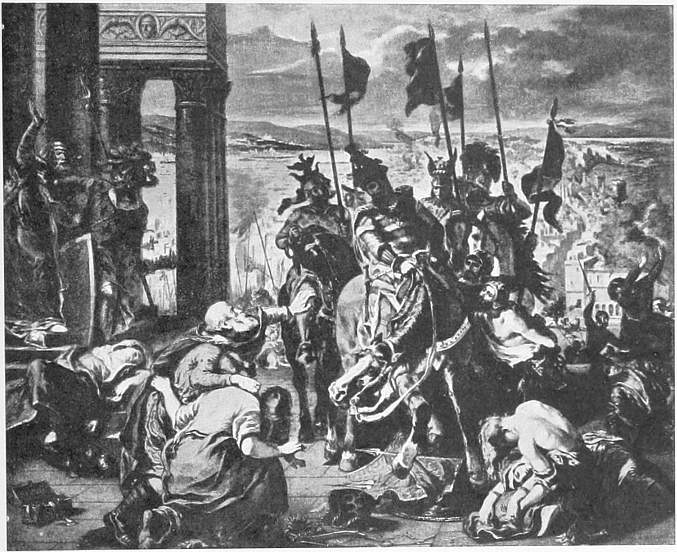 | |
| DELACROIX. | ENTRY OF THE CRUSADERS INTO CONSTANTINOPLE. |
The journey to Morocco, which he made in the spring of 1832, in company with an embassy sent by Louis Philippe to the Emperor Muley Abderrahman, is noteworthy for a further progress in his ability as a colourist and a new broadening of his range of subjects. When 234 he returned to the port of Toulon, on 5th July 1832, he had seen Algiers and Spain, and had assimilated an abundance of sunshine and colour. It is in his Oriental pictures that his painting first reaches its zenith, just as Victor Hugo’s mastery over language was at its highest point in his Orientales. Goethe, in his West-östliches Divan, celebrated what is quiet and contemplative in the Oriental view of life. Obermann sang of the land of legend, of buried treasures, of Aladdin and the wonderful lamp; but for Byron (who was practically the first to introduce into Europe the perfume and colour of the East), for Hugo, and for Delacroix, it was the distant, bright-hued, barbaric land of the rising sun, the land of sanguinary warfare and overthrow, the home of light and colour. Here it was that the French Romanticists found the world that realised their dreams of colour. The East became for them what Rome had been for the Classical school. From the feeble and misty sun of Paris, and from the grey skies of the Boulevard des Italiens, they turned to Africa.
His enthusiasm for this newly discovered world resounds, full and clear, in Delacroix’s letters. “Were I to leave the land in which I have found them,” he wrote, during his stay in Morocco, of the men whom he saw about him there, “they would seem to me like trees torn up by the roots. I should forget the impressions I have received, and should be able only in an incomplete and frigid manner to reproduce the sublime and fascinating life which fills the streets here, and attracts one by the beauty of its appearance. Think, my friend, what it means to a painter to see lying in the sunshine, wandering about the streets and offering shoes for sale, men who have the appearance of ancient consuls, of the reincarnated spirits of Cato and Brutus, who lack not even that proud, discontented look which those lords of the world must have had. They possess nothing save a blanket in which they walk, sleep, and are buried, and yet they look as dignified as Cicero in his curule chair. What truth, what nobility in these figures! There is nothing more beautiful in the antique. And all in white, as with Roman senators or at the Greek Panathenæa.”
His palette was thus further enriched in lucid tints, the contrasts he formerly delighted in became less sharp and glaring, the gloomy background hitherto preferred was superseded by a bright serenity and a golden lustre. The colour-effect of his “Algerian Women” has been not unaptly compared to the impression produced by a glance into an open jewel casket. In his “Convulsionaries of Tangier” he has depicted with wild, demoniac energy the religious frenzy of a Turkish sect. Green, blue, red, and violet hues unite to produce an effect as of a sounding flourish of trumpets, recalling the music of the janizaries. The “Entry of the Crusaders into Constantinople” resembles an old delicately tinted carpet, full of powerful, tranquil harmony. Even in his old age he wrote: “The aspect of that country will be for ever before my eyes; the types of that vigorous race will move in my memory as long as I live; in them I truly found the antique beauty again.”
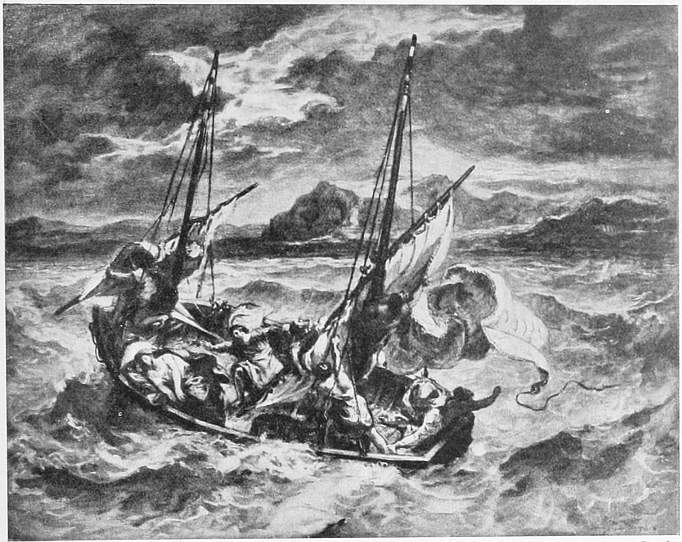 | |
| Baschet. | |
| DELACROIX. | JESUS ON LAKE GENNESARET. |
The contemplation of such scenes induced Delacroix to undertake the representation of antique subjects, which he had hitherto avoided, not because he disliked the antique, but because of the aversion he felt for David’s treatment of it. During his sojourn in Africa he had come to the conclusion that the painting of scenes from ancient history should not be based upon the imitation of statues and bas-reliefs, as with David and his pupils; but that it should be imbued with the movement and passion of modern life, since the ancient Greeks were men of flesh and blood like ourselves. Therefore it is that he snatches the marble mask from the faces of David’s puppets. Flemish blood begins to move in the Greek statues, Flemish passion to break through their inflexible rhythm. Paintings such as the “Justice of Trajan” of 1840 represent the antique in a thoroughly personal and modern paraphrase, just as Shakespeare or Byron had seen it. The mad “Medea” is, from the point of view of colour, certainly the chief work of this group.
It was of course impossible that a man so highly endowed with emotional pathos should pass untouched the tragedy of the life of Christ and the sufferings of the Christian martyrs. By the Revolution religious themes had been absolutely excluded from representation, and up to this time the young 236 innovators of the Restoration period had also felt an aversion for them. Their ideas were as little attuned to Catholic as to academic tradition. Delacroix was the first to treat once more of biblical subjects, so far as they are imbued with dramatic and passionate movement. Like Rubens, he regarded the lives of the saints, the story of the Gospels, and the tragedy on Golgotha as a poetical narrative like any other. His Mary, like that of the Flemish painters, is a sorrowing woman, the embodiment of unending grief.
Alongside of these easel pictures he produced, during a period of more than twenty-five years, a long list of monumental and decorative works; and they too were the most inventive, the boldest, and the most original which monumental painting produced during this epoch, not in France only, but in Europe. In this sphere also, where, under the pressure of old traditions and conventional types, it is so difficult to avoid plagiarism, Delacroix maintained his individuality. In 1835, at the suggestion of his friend Thiers, he was commissioned to paint the interior of the Chamber of Deputies in the Palais Bourbon—the most important commission which had fallen to the lot of any French artist since Gros painted the cupola of the Pantheon. Not long afterwards he decorated with verve and enthusiasm the ceiling of the Louvre, choosing for his subject the “Triumph of Apollo.” In the Library of the Luxembourg he had recourse to the Divina Commedia, and treated in a masterly manner the theme so familiar and sympathetic to him. In his works there is something of the joyous and sportive energy of Rubens’ allegorical pictures, but not the least trace of imitation. He understood decorative painting in the sense of the great old masters, Giulio Romano and Veronese, not as wall didactics and lectures on archæology; he knew that descriptive prose has nothing whatever to do with the walls of a building, but that the sole aim of such paintings is to fill the house with their solemn grandeur, to make the whole building resound as it were with sacred organ music. Between 1853 and 1861 came also the wall paintings in the Church of Saint Sulpice, and one would almost think that Delacroix finished them in feverish excitement, to show for the last time how enormous a store of passion and power still lay in the soul of a sexagenarian. Shortly after their completion, on 13th August 1863, he died, who was, in the words of Silvestre, “the painter of the genuine race, who had the sun in his head and a thunderstorm in his heart, who in the course of forty years sounded the entire gamut of human emotion, and whose grandiose and awe-inspiring brush passed from saints to warriors, from warriors to lovers, from lovers to tigers, from tigers to flowers.”
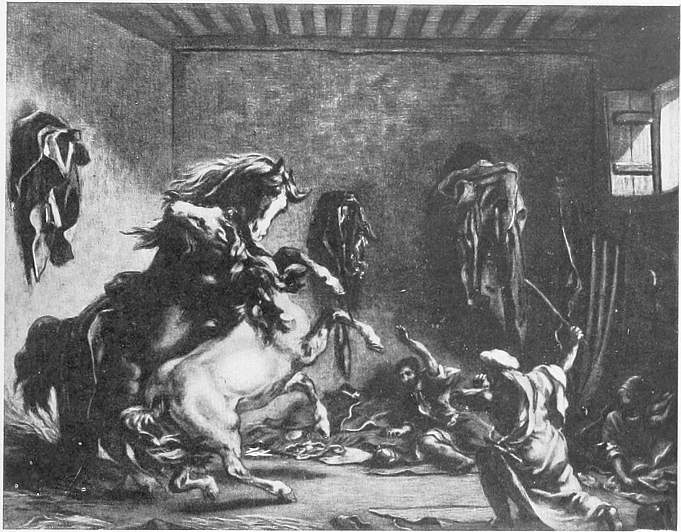 | |
| Baschet. | |
| DELACROIX. | HORSES FIGHTING IN A STABLE. |
In these words Delacroix is very aptly characterised. His range of subjects included everything: decorative, historical, and religious painting, landscape, flowers, animals, sea pieces, classical antiquity and the Middle Ages, the scorching heat of the south and the mists of the north. He left no branch of the art of painting untouched; nothing escaped his lion’s claws. But there is one bond uniting all: to all the figures for which he won the citizenship of art he gave passion and movement. His predominant quality is a passion 237 for the terrible, a kind of insatiability for wild and violent action. His over-excited imagination heaps pain, horror, and pathos one upon another. The critics called him “the tattooed savage who paints with a drunken broom.” There is nothing pretty or lovable about his art; it is a wild art. He depicted passion wherever he found it, in the shape of wild animals, stormy seas, or battling warriors; and he sought it in every sphere, in nature no less than in poetry and the Bible. Hardly any painter—not even Rubens—has depicted with equal power the passions and movements of animals: lions in which he is own brother to Barye; fighting horses, in which he stands side by side with Géricault. No other artist painted waves more grand, wind-beaten, foaming, dashing, towering on high. Looking at them, one divines all the horrors concealed beneath the roar of the blue surface, horrors which were as yet so insufficiently suggested in Géricault’s “Raft of the Medusa.” In his historical pictures there reigns now terror and despair, as in the “Massacre of Chios”; now gloomy horror, as in the “Medea”; now feverish movement, as in the “Death of the Bishop of Liège.” He passes from Dante to Shakespeare, from Goethe to Byron, but only to borrow from them their most moving dramatic situations—Hamlet at Yorick’s grave, his fight with 238 Laertes, Macbeth and the Witches, Lady Macbeth, Gretchen, Angelica, the Prisoner of Chillon, the Giaour, and the Pasha. All time is his domain, all countries are open to him; he hurries through the broad fields of imagination, a lordly reaper of all harvests.
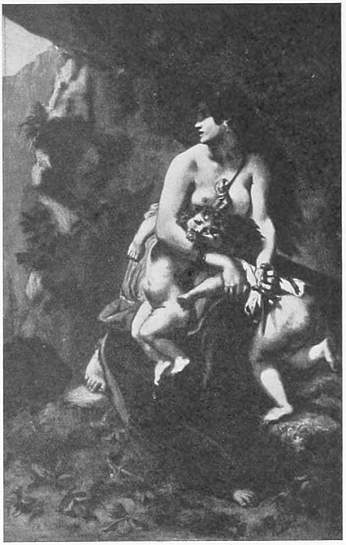 |
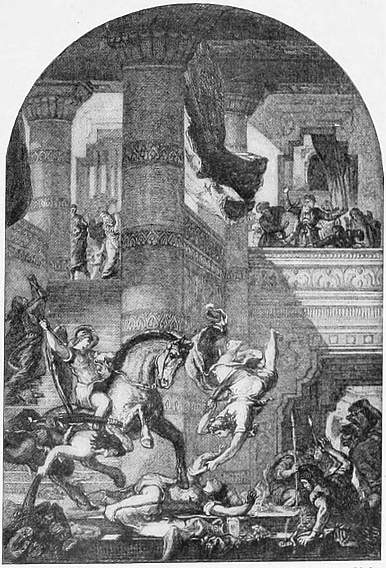 | ||
| Baschet. | L’Art. | ||
| DELACROIX. | MEDEA. | DELACROIX. | THE EXPULSION OF HELIODORUS. |
And at the same time, in all his great human tragedies, he compels the elements to obey him as if they were his slaves. The passions of men set heaven and earth in motion. The agonising cries of victims find in his paintings an echo in the sullen shadows and the leaden, heavy clouds of the sky. The gloomy shores which Dante’s boat is approaching are as desolate as the spirits who wander through the night. But where splendour and glory reign, as in the “Entry of the Crusaders into Constantinople,” the air, too, glistens and shines as though saturated with dust of gold. In his pictures a human soul which was great and full of meaning, and which possessed such combustibility that it took fire of itself, expressed itself recklessly, with the volcanic strength of an elemental power.
This proud self-reliance explains also how it was that this painter of unruly genius was, as a man, very far from being a revolutionist. For Delacroix the outer world had no existence; that world alone existed which was within him. After his picture of “The Barricades” in 1831 he avoided all political allusions, painted, read, and led a tranquil, measured, uniform life. In society polite and reserved, of aristocratic coldness, gentlemanly in appearance, and well-bred; in his speech curt, mordant, emphatic, and occasionally witty, he could nevertheless show himself, when he chose, an amiable, original talker, full of piquant ideas. Moreover, he was a great writer and critic, whose essays in the Revue des Deux Mondes have the perfect classic stamp. Nevertheless, he was always displeased when any one put him forward as the chief of official Romanticism, and saluted him as the Victor Hugo of painting. Surrounded as he was by young assailants of tradition who would allow no merit to anything old, he found pleasure in acknowledging his admiration for Racine, whom he knew by heart, and whom, when need was, he defended against the younger generation. He was too diplomatic to stir up against 239 himself unnecessarily the hatred of those whom the long-haired Samsons of Romanticism called Philistines.
So far as in him lay, his quiet and methodical life should suffer no interruption. Worshipper though he was of light and colour, he was almost always shut up in his gloomy studio, and it was only when he found himself brush in hand that the reserved man became the passionate, vibrating painter. Then the memories with which his study of the poets had stored his mind grew in his fantasy into grand pictures glowing with life. By these visions he was excited, set on fire, and filled with enthusiasm. His studio was open but to few, for the intrusion of visitors chilled his inspiration, and he found it difficult to recover the proper frame of mind. Not till evening did he take his first meal, for he thought he could work with greater intensity when hungry. During a period of forty years he lived in his various studios, quiet and solitary, inventing, drawing, and painting without intermission, his door always bolted, so that when it suited him he could give out that he was ill of a fever. Every morning before work he drew an arm, a hand, or a piece of drapery after Rubens. He had formed the habit of taking Rubens to himself when other people were drinking their coffee.
Indeed, when one speaks of Delacroix, the name of Rubens rises almost involuntarily to one’s lips; and yet there is a profound difference between him and the great Flemish master. Rubens has the same passion, the same ever-active fancy; yet all his pictures rest in triumphant repose, while every one of Delacroix’s seems to resound as with a cry of battle. Looking at Rubens’ works you feel that he was a happy, healthy man; but by the time you have seen half a score of Delacroix’s it is borne in upon you that the life of the artist was one of strife and suffering. Rubens was the very essence of strength, Delacroix was a sick man; the former full of fleshly joyous sensuality, the latter consumed by a feverish internal fire.
His portrait of himself in the Louvre, with its pale forehead, its large dark-rimmed eyes, its lean, hollow face, its parchment-like skin stretched tightly over the bones, explains his pictures better than any critical appreciation. Delacroix was one of the âmes maladives, the spirits sick unto death, to whom Baudelaire addresses himself in his Fleurs du Mal. Delicate from his youth up, thoroughly nervous by nature, he prolonged his sickly existence throughout his life by sheer energy of will. Even in his childhood he passed through serious illnesses, and later on he suffered in turn from his stomach, throat, chest, and kidneys. Like Goethe in his old age, he felt well only when the temperature was high. He was short in stature. A leonine head, with a lion’s mane, surmounted a body that seemed almost stunted. With his eyes flashing like carbuncles, and his disordered prickly moustache, his was the fascinating ugliness of genius.
It was only by the strictest dieting in his quiet retreat at Champrosay that he prolonged his life for the last few years. In his youth he hovered like a butterfly from flower to flower; when grown old and hypochondriacal he withdrew into solitary retirement, work was the only medicine for diseased conditions of all kinds, to which he found himself daily more and more a victim. Only thus could this sickly man, doomed from his very birth, come to produce no less than two thousand pictures—a number all the more astonishing as Delacroix, even when his health permitted him to work at his easel, by no means possessed Rubens’ sovereign facility of production. The fever of work alternated, in his case, with the extremest exhaustion. There was something morbid, nervous, over-excited in all he did. “Even work,” he writes, “is merely a temporary narcotic, a distraction; and every distraction, as Pascal has said in other words, is only a method which man has invented to conceal from himself the abyss of his suffering and misery. In sleepless nights, in illness, and in certain moments of solitude, when the end of all things discloses itself in its utter nakedness, a man endowed with imagination must possess a certain amount of courage, not to meet the phantom half-way, not to rush to embrace the skeleton.”
The feverish disposition which he brought with him into the world was heightened by the acrimonious feuds in which, as a painter, he was forced to engage, and which left great bitterness behind them in his mind. His life and his art were in accord, in as much as both were battles. It is not easy to live when one is always ill; not easy to meet with recognition when one proclaims the exact opposite of that which for a generation past all the world has held to be true. And Delacroix took not a single step to meet his opponents half-way. He did not trouble himself for a single moment to please the public; and therefore the public did not come to him. Controversies such as that which took place over the “Massacre of Chios” continued decade after decade, and the exhibition of each of his pictures was the signal for a battle. “No work of his,” writes Thoré, “but called forth deafening howls, curses, and furious controversy. Insults were heaped upon 241 the artist, coarser and more opprobrious than one would be justified in applying to a sharper.” At Charenton, where he was born, is the Bedlam of France. Hence the epithet continually hurled at him by the critics, who called him the runaway from Charenton.
Until the year 1847 his pictures could without difficulty be excluded from the Salon. He irritated people by his violence, by the abruptness of his compositions, by his arrangement of figures with a view to pathos at the expense of plastic elegance; he displeased by the incompleteness of his works, which were regarded as sketches, not finished paintings. When Louis Philippe ordered a picture from his brush, it was on the express condition that it should be as little a Delacroix as possible. There was general ill-humour among the academicians when, at Thiers’ suggestion, he was commissioned to decorate the Palais Bourbon. And Delacroix, ambitious and sensitive as he was, was deeply hurt by every mortification of this kind, and affected by every gust of criticism as by a change of wind. Continually denounced in the newspapers, attacked, wounded, delivered over to the wild beasts, as he called it, he never had a moment of rest—he who, with his irritable temperament and fragile health, needed rest more than any man. It was not until almost all his works were brought together in the Universal Exhibition of 1885 that it became evident how great an artist this Delacroix was, whom his country for forty years had not understood, and to whom the Institute had closed its doors to the last. Yet he was no sooner dead than all with one voice proclaimed him a genius; his smallest drawing is to-day worth its weight in gold, while during his lifetime he seldom got more than two thousand francs for his largest paintings. His sketches, great works in small frames, have for the most part found their way to America. The sale of the pictures he left behind him produced three hundred and sixty thousand francs.
Delacroix, therefore, was victorious, but not as Rubens was; and his ceiling of the Louvre, with the “Triumph of Apollo,” one of his most remarkable works, strikes one almost as an allegory of his own life. What especially attracted and inspired the artist in this painting were the spasms and convulsions of the misshapen monsters which the god expels from the earth—the serpent twisting itself in movements of pain and fury, raising its head on high, hissing rage, and vomiting venom and blood. The god himself, who in the midst of a sea of light ascends into heaven in a golden chariot drawn by radiant steeds, shows in his sturdy limbs and attitude ready for defence, and in his wrathful face, no trace of the proud majesty and joyous splendour which Greece connected with the name of Apollo. He is a mortal who has fought and conquered, not a god who triumphs in tranquil power. He is Delacroix, not Rubens; a Titan, not an Olympian god.
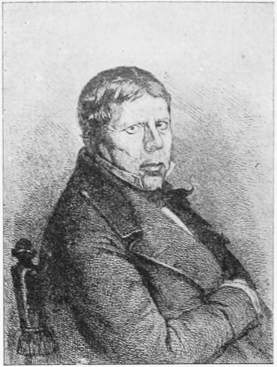 |
| L’Art. |
| J. A. D. INGRES. |
The artistic power in Delacroix could in no wise submit to the confinement imposed by the French spirit of his time. It was not possible for a single man, though endowed with the most splendid courage, to overthrow 242 in a moment all the traditions of French art. Any one who knows the French must feel that David’s Latin style could not so suddenly disappear out of their art, that it was not possible at a blow to banish all that had hitherto held sway and to replace it by its opposite. Ever since Poussin they had sought in Roman antiquity the formulæ of their art. The predilection which the Parisians have even to-day for the representation of Racine’s and Corneille’s tragedies, the admiration which even the most extreme Naturalists bestow upon Poussin and Lesueur, prove abundantly how deep Classicism is rooted in the flesh and blood of the French people. Brandes has remarked, very acutely, that, strictly speaking, even Romanticism was on French soil in many respects a Classical phenomenon, a product of French Classical rhetoric. “They never saw the dances of the elves, never heard the delicate harmony of their roundelays.” In Victor Hugo, the great opponent of Corneille, Corneille himself was re-embodied. He too is a draughtsman, constructs his poems like architectural works, chisels the form, polishes the verse, and confines his colouring within powerfully conceived Michelangelesque outlines.
Once the first eager impulse of the Romantic school had subsided, these old Classical tendencies showed themselves anew and with all the greater vehemence. Even Hugo’s dramas, with their predilection for all that is exuberant and monstrous, with their overflowing lyricism and sonorous pathos, became in the long run wearisome. He, who had hitherto been the idol of the young generation, was now called the Pater Bombasticus of the literature of the world.
Classicism found its poet and its muse. An unknown but very worthy young man, not endowed with wealth of imagination, but imbued with the most honourable intentions, came to Paris from the provincial town where he had grown to manhood, with a manuscript in his pocket. And François Ronsard’s Lucrèce, a tragedy from the antique, in its style sober and severe, reminding one of Racine, was represented amid thunders of applause, shortly after Hugo had been hissed off the stage. Enthusiastic admirers saw in it a glorious return to the great tragic drama of France, an emanation from the spirit of Corneille, and praised its clear, measured, and at once “classic and familiar” language. Together with its poet, the Classical reaction found its actress. In 1838 a young untrained child made her début at the Théâtre Français—a Jewish girl who had sung in the streets to the accompaniment 243 of her harp. Rachel appeared upon the boards, and restored its former power of attraction to the old Classical repertoire, to the very tragedies which the Romantic school had banished from the theatre amid mockery and derision. The Cid, Mérope, Chimène, and Phèdre recovered their place upon the stage.
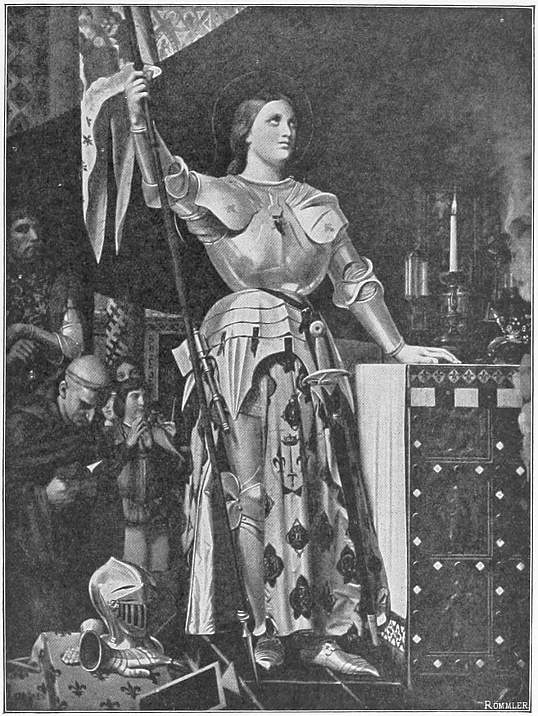 | |
| Seemann, Leipzig. | |
| INGRES. | THE MAID OF ORLEANS AT RHEIMS. |
Painting took the same course. In opposition to the young painters who had burst into the arena with their gay-coloured uniforms, their gilded helmets and waving banners, Ingres came forth in the great tournament of Romanticism in the character of the Black Knight. An old gentleman, a 244 man who in all his being belonged to the generation that was passing away, who was fifty years of age at the time of the Revolution of July, stations himself suddenly as the angel of the flaming sword, or, in the phrase of his opponents, as the gendarme of Classicism, at the gates of the Academy, barring them against every suspicious-looking person. And the young men, eccentric, eager for action as they were, who had recently fought with so much fury, had to retreat before him. Golden sunshine and glow of colour were once more tabooed, and their representative heroes, Veronese, Rubens, and Delacroix, regarded as flickering Will o’ the Wisps, whom every aspiring beginner should avoid as serpents and firebrands. One day when Ingres was taking his pupils through the Louvre he said, on entering the Rubens gallery: “Saluez, messieurs, mais ne regardez pas.” The acrimony of the strife was so great that it extended even to the personal relations of the rival chiefs, and Ingres was attacked by convulsive spasms whenever he heard the name of the painter of the “Massacre of Chios.” When in 1855 he had had a separate room prepared for his own pictures in the Universal Exhibition of that year, and observed Delacroix in the distance, just before the opening ceremony, he asked the attendant: “Has not somebody been here?—there is a smell of brimstone.” “Now the wolf is in the sheepfold” was his observation when Delacroix was elected to the Institute. He regarded him as the “hangman,” as the Robespierre of painting. “I used to love that young man, but he has sold himself to the evil one” (Rubens), said he, in righteous indignation, to his pupils.
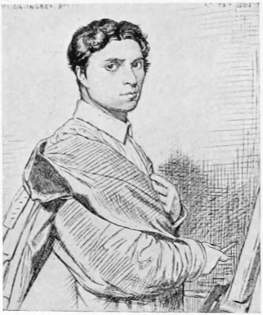 |
| INGRES. PORTRAIT OF HIMSELF AS A YOUTH. |
“This famous thing, the Beautiful,” Delacroix had once written, “must be—every one says so—the final aim of art. But if it be the only aim, what then are we to make of men like Rubens, Rembrandt, and, in general, all the artistic natures of the North, who preferred other qualities belonging to their art? Is the sense of the beautiful that impression which is made upon us by a picture by Velasquez, an etching by Rembrandt, or a scene out of Shakespeare? Or again, is the beautiful revealed to us by the contemplation of the straight noses and correctly disposed draperies of Girodet, Gérard, and others of David’s pupils? A satyr is beautiful, a faun is beautiful. The antique bust of Socrates is full of character, notwithstanding its flattened nose, swollen lips, and small eyes. In Paul Veronese’s ‘Marriage at Cana’ I see men of various features and of every temperament, and I find them to be living beings, full of passion. Are they beautiful? Perhaps. But in any case there is no recipe by means of which one can attain to what is called the ideally beautiful. Style depends 245 absolutely and solely upon the free and original expression of each master’s peculiar qualities. Wherever a painter sets himself to follow a conventional mode of expression he will become affected and will lose his own peculiar impress; but where, on the contrary, he frankly abandons himself to the impulse of his own originality, he will ever, whether his name be Raphael, Michael Angelo, Rubens, or Rembrandt, be sure master of his soul and of his art.”
As compared with the principles thus laid down, Ingres represents the revulsion towards that formalism which had borne sway over the greater part of the history of French art. “Painting is nothing more than drawing,” said Poussin. “Had God intended to place colour at the same height as form,” wrote Charles Blanc, “He would not have failed to furnish His masterpiece, Man, with all the hues of the humming-bird.” Once more, instead of the glowing colour of the Romantic school, absorbing the form into itself, the firm stroke of the outline was set forth; instead of its pathos, breathing forth passionate emotion, men returned to study the chill tranquillity of stone. Once more dramatic composition and mastery over movement were held in abhorrence, as incompatible with that pursuit of plastic beauty which was the highest goal of art. The only point in question was, how to avoid the one-sidedness of Classicism. David, as a child of the Revolution, had naturally been limited to Ancient Rome; but now that the legitimate monarchy had been re-established there was no reason why one should not revere, not only pagan, but also Christian Rome, and in Raphael and Michael Angelo the maturest blossom of the latter. Thus the Classical school was enriched by Ingres with features of greater vivacity. He entered into a direct relationship with the great Italian masters, while David had none save with the rigid Roman antique. By him the Classical severity of David was relaxed, the refractory sharpness of the outlines relieved by a treatment of form which had the effect of making every figure appear to be worked in metal.
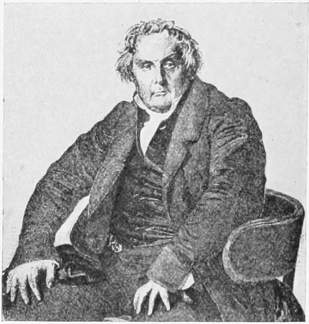 |
| INGRES. BERTIN THE ELDER. |
| (By permission of M. Jules Bapst, the owner of the picture.) |
Ingres was born in 1781, under the Ancien Régime. As a young man he lived through the triumphs of the Empire and the Classical school, and it was only natural that he should become David’s pupil. In 1796 he entered his studio, and studied there with such assiduity that he never noticed what was taking place in that of Gros. When he went to Italy he studied there the masters whom his own teacher had arrogantly despised. He learned from the Cinquecento how to draw and model 246 more accurately, more firmly, and at the same time with a more intimate grasp of the subject than was usual in the school of David. This innovation made him a progressive Classicist, and gave him, during the early years of the Restoration, almost the appearance of an assailant and revolutionary. Himself the incarnation of the academic spirit, he had to resign himself to see his first works rejected by the Salon, a fact which did not deter him from continuing to work obstinately at his easel. “Je compte sur ma vieillesse; elle me vengea.” And this revenge was granted him in the fullest measure.
When one has seen the outward appearance of a man, one knows his character, his spirit, and his genius. Ingres’ portrait of himself contains the analysis of his art. He was quite a small man, of a swarthy complexion, with features sharp and as if cast in bronze. His thick black hair stood up stubbornly on end, so that he had to grease it carefully every day. Under hair of this kind there is almost always an obstinate brain. The jaws projected, as is the case with men endowed with a strong will. The eyes were large and piercing, with that bold eagle-glance which fills parents with fond hopes, but does not touch the hearts of young women. When he appeared to be excited, it was only the excitement of work expressing itself in him. This little man, in his large cloak, seemed to say when he stood at his easel, pencil in hand: “I shall be a great painter, for I am determined to be one.” He kept his word. Strength of will, hard work, study, obstinacy, patience—these are the elements of which Ingres’ talent is compounded. “Vouloir, c’est pouvoir,” was his motto. One would think Buffon had had him in mind in that passage in which he defines genius as patience. The trinity-in-unity of his qualities consisted of correctness, balance, exactness; qualities which go to make rather a great architect or mathematician than an interesting painter.
Ingres’ range of subjects was unusually wide. Pictures on themes taken from antiquity (“Œdipus and the Sphinx” and “Virgil reading the Æneid”); costume pictures (“Henry IV and his Children” and the “Entry of Charles V into Paris”); religious paintings (Madonnas, “Christ giving the Keys to St. Peter,” and “St. Symphorian”); nude female figures (the “Odalisque,” the “Liberation of Angelica,” and “The Source”); allegories (“The Apotheosis of Homer” and “The Apotheosis of Napoleon”); pictures of public functions (“Bonaparte as First Consul” and “Napoleon on the Throne”); and even a painting taken from the life (“Pius VII in the Sistine Chapel”), are included in the list. Yet, notwithstanding his astonishing diversity of themes, there is hardly an artist more one-sided in his principles. Ingres thought exclusively of purely plastic art: beauty of form and harmony of line alone attracted him; he was insensible to the charm of colour. His standpoint was the Institute of Rome; the Italian Cinquecento the exclusive object of his worship. He carried this study as far as plagiarism, and as director of the Roman Academy made free with the intellectual property of the Cinquecento masters, as if they had lived only on his account.
When Delacroix was painting the “Expulsion of Heliodorus” in Saint 247 Sulpice, he put forth the whole strength of his creative genius to avoid all reminiscence of Raphael’s fresco. Ingres’ power of invention consisted in discovering, with a weird certainty, whether the subject of which he wished to treat had already been painted by an Italian or other Classical master. The picture “Jupiter and Thetis,” of 1811, is put together after a design on a Greek vase, and represents in its studied archaism the Æginetan period of his art. The “Vow of Louis XIII,” of 1824, was his confession of faith as regards the Cinquecento. The motive was taken from the Madonna di Foligno, the curtains from the Madonna di San Sisto, the floating angels from the Madonna del Baldacchino, and the candlesticks as well as the little angels with the inscribed tablet are from the same source. It is all beautiful, of course, for it is all Raphael; only, it would have been more rational if Ingres had lived in the time of Raphael instead of in the nineteenth century. One would take the picture to have been painted under Raphael’s eyes, and it bears to his works the same relation as Raphael’s earlier pictures do to Perugino’s. The “Christ giving the Keys to St. Peter” is also put together out of elements derived from the school of Urbino. In his “St. Symphorian,” which was belauded as the ne plus ultra of style, he turned by way of variety to the imitation of Michael Angelo: the action is violent, the muscles swollen. The “Apotheosis of Homer” is an admirable lecture in archæology, a sitting of the great academy of genius, in which the poses are so fine and the heads so full of marble idealism that in comparison with it Raphael’s “School of Athens” has the effect of the wildest naturalism.
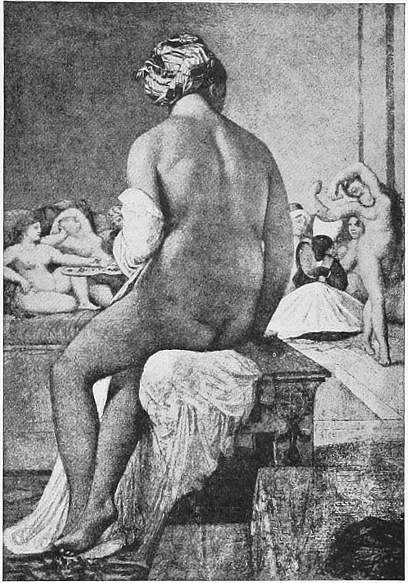 |
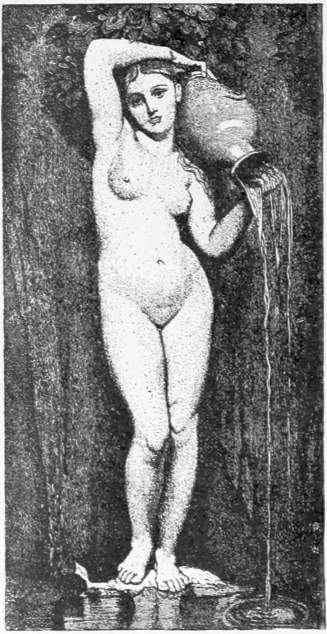 | ||
| Gaz. des Beaux-Arts. | Gaz. des Beaux-Arts. | ||
| INGRES. | STUDY FOR THE ODALISQUE IN THE LOUVRE. | INGRES. | THE SOURCE. |
Thus Father Ingres stands forth as a cold, stiff, academic painter, as a doctrinaire who has not progressed much further than the much-reviled David. He represents, as Th. Rousseau said, only to a moderate degree the good old 248 art which we have lost. In the words of Diaz: “Let him be shut up with me in a tower, without engravings, and I wager that his canvas will remain untouched, whilst I shall succeed in producing a picture.” He possessed an arid ability which leaves one cold in presence of even his most important works. How lifeless is the effect produced by his paintings of nude single figures, his “Odalisque” and his “Freeing of Andromeda,” which brought him especial fame! Ingres could not paint flesh, and in this respect he is indicative of an enormous retrogression as compared with Prudhon. The striving after sculpturesque beauty, and, in connection therewith, the repression of all individuality, became in him almost a religion.
One finds it difficult to-day to account for the fame which once belonged to his picture of “The Source,” the nude figure of a standing girl pouring water out of an urn that rests on her left shoulder and is steadied by her right arm raised over her head. The picture undoubtedly exhibits qualities of draughtsmanship which in recent days Ingres alone possessed in so high a degree. But when, in pursuit of his Classical conception, he had eliminated every touch of nature, he proceeded to destroy the rest of the impression by the cold violet tones which are not only condemned by colourists, but which even Raphael would have considered false and ugly. Here, as in all his female figures, he attains to a certain grace, but it is an animal, expressionless grace. Skilful as he was in delineating the muscles of the human body, he was yet absolutely incapable of painting heads expressive of feeling or emotion. He depicted the form in itself, the abstract, typical, absolute form. He was dominated only by a love for the beauté suprême, so that when he was in presence of nature he could not refrain from purifying and generalising. Everywhere we see beautiful lines, bodies modelled with admirable skill, but we never enter into any closer relationship with his figures. They do not live our life or breathe our atmosphere; they have not our thoughts: they are foreign to all that is human. Jean Auguste Dominique Ingres, Member of the Institute, Senator, etc., the stylist held in honour as a superior being, the high-priest of pure form and outline, will in all times command the esteem, and in some respects the admiration, of the student of the history of art; the enthusiasm, never.
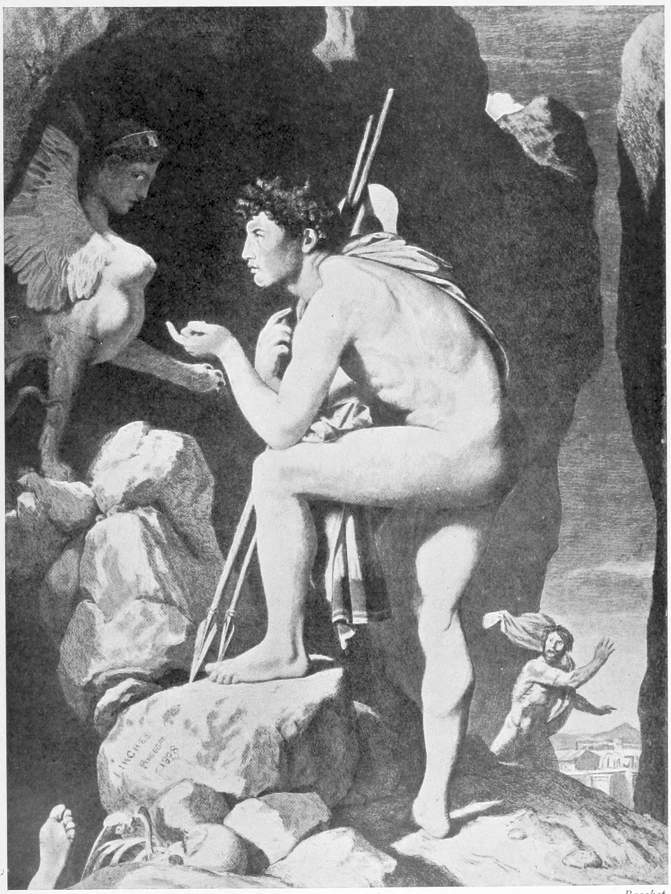 | |
| Baschet. | |
| INGRES. | ŒDIPUS AND THE SPHINX. |
 |
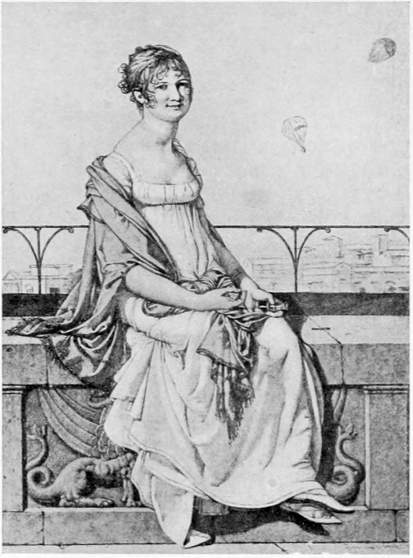 | ||
| Gaz. des Beaux-Arts. | Gaz. des Beaux-Arts. | ||
| INGRES. | PAGANINI. | INGRES. | MLLE. DE MONTGOLFIER. |
And yet, notwithstanding all this, I am an enthusiastic admirer of Ingres. Indeed, it has happened to me, in the collection of engravings at the Louvre, to catch myself saying: “Ingres! great, beloved Master! I have much to ask your pardon; for you were one of the greatest and most refined spirits to whom the century has given birth.” For I doubt whether any one down to the present time has rightly understood the mysterious figure of Ingres, the man who in his youth was enraptured by “l’esprit, la grâce, l’originalité de Vataux et la délicieuse couleur de ses tableaux,” and who, at a later time, not because of failing powers but deliberately and of set purpose, adopted a calmer system of colour tones; of this Classicist par excellence, who is counted among the greatest artists, in the familiar and graceful style, in the history of art.
Ingres is one of the rare masters whom even their opponents are forced to admire. In the stern, sculpturesque modelling of his naked figures he displays remarkable power. His painting, also, has a curiously intimate appeal, due to its cool, metallic harmonies of colour—light blue, rose, and pale yellow in particular.
But above all Ingres commands attention by his portraits. From his first residence at Rome, that is, from the beginning of the century, he painted portraits which imprint themselves on the memory like medals struck in metallic sharpness in the style of Mantegna. Here too he is unequal, at times cold and commonplace, but usually quite admirable. In these paintings, cast as it were in bronze, there is something that comes from the fresh original source of all art; they have that vein of realism by which the vigorous idealism of Raphael is distinguished from the conventional idealism of a professor of historical painting. Here one finds real treasures, creations of remarkable vital power, and in admirable taste. They show that Ingres, apparently so systematic, had a profound love for living nature, and they ensure the immortality 252 of his name. His historical pictures are works which compel our esteem, but his portraits are splendid creations which can truly stand comparison with the great old masters.
So far back as 1806 there appeared in the Salon his likeness of Napoleon I, with his bloodless, corpse-like face, enchased with such art that Delécluze called it a Gothic medal. The Emperor is seated like a wax figure upon the throne, surrounded by the attributes of majesty—stiff, motionless as a Byzantine idol. It was followed in 1807 by the portrait of Mme. Devauçay, which even to-day impresses the beholder most pleasingly, notwithstanding the pedantic style in which it is painted. One feels in it fire and youthfulness, the enthusiasm and ardour of a new convert, who has for the first time discovered in nature beauties other than those he had learnt to see in the Academy. Moreover, he possessed a very distinguished and personal taste in drawing. The face is of exquisite grace, the eyes tenderly seductive and delicately veiled. Ingres is already announced as he was afterwards to be.
In Holbein’s portraits the whole German community of his time has been handed down to us; in Van Dyck’s, the aristocracy of England under Charles I. So also Ingres has depicted for us, with all its failings and all its virtues, the middle-class hierarchy of Louis Philippe’s reign, which felt itself to be the first estate, the summit of the nation, felt sure of the morrow, was proud of itself, of its intelligence and energy, which pursued with correctness its moral course of life, revered order and hated all excess—including that of the colourist. The same spirit animated this splendid bourgeois of art. His “Bertin the Elder” is justly his most celebrated, enduring work; not the mere painted petrifaction of a newspaper potentate, but one of those portraits which bring a whole epoch home to the mind. It tells of the triumph of the bourgeoisie under the Monarchy of July more fully and clearly than does Louis Blanc’s Histoire de Dix Ans. 253 In the best of humours, with the four-square solidity of a knowledge of his own worth, which is full of character, this modern newspaper demi-god sits on his chair as on a throne, the throne of the Journal des Débats, like a bourgeois Jupiter Tonans, with his hands on his knees.
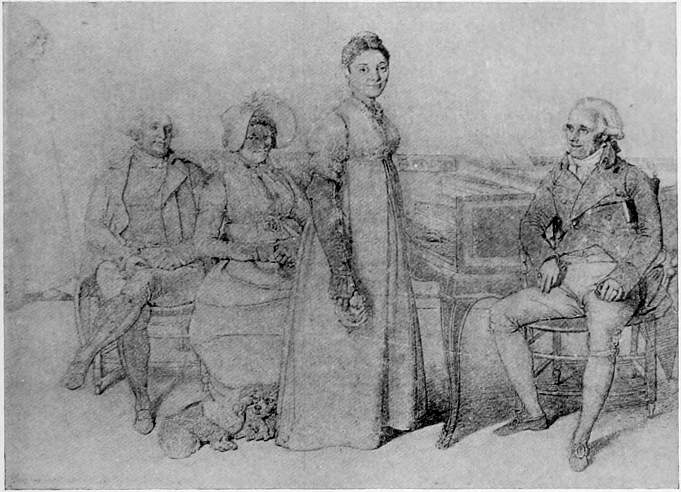 | |
| Baschet. | |
| INGRES. | THE FORESTIER FAMILY. |
But however highly one must estimate the importance of such a work, Ingres is nevertheless at his highest, not in his painted likenesses, but in his portrait drawings. In the former the hard colouring is still, at times, offensive. Almost always the flesh looks like wood, the dress like metal, blue robes like steel. His drawings, from which this defect is absent, are to be admired without criticism. Ingres lived in his youth, at Rome, as a drawer of portraits. For eight scudi he did the bust, for twelve the whole figure, raging inwardly the while at being kept from “great art” by such journey-work. There is a story told of him, that when one day an Englishman knocked at his door and asked, “Does the draughtsman who makes the small portraits live here?” he shut the door in his face, with the words: “No; he who lives here is a painter.” To-day these small masterpieces of which he was ashamed sell for their weight in gold. In the Paris Exhibition of 1889 there was Mme. Chauvin with her Chinese eyes; Mme. Besnard on the terrace of the Pincio with her broad hat and her elegant sunshade; Mrs. Henting with her innocent smile of an “honnête femme”; Mrs. Cavendish, an affected young blonde, 254 with her overladen travelling dress and her crazy coiffure. Strange, that a man like Ingres should rave so about new fashions and pretty toilettes!
In these pieces an artistic eye which was now inexorable, now tender and full of fancy, has looked on nature, and, in flowing pencil-strokes, has caught with spirit and with the certain touch of direct feeling the real fulness of life in what he saw. These drawings, especially the portrait of Paganini and “The Forestier Family,” show that Father Ingres possessed not only a highly cultivated intelligence and an iron strength of will, not only the genius of industry, but also a heart, a genuine, warm, and fine-feeling heart; that he was in his innermost being by no means the cold academician, the stiff doctrinaire he appears in his large pictures, and which he became by his opposition to the Romantic school. Here we have an enchanter such as the Primitives were and the Impressionists are, like Massys and Manet, like Dürer and Degas, like all who have looked Nature in the face. And while these drawings, at once occasional and austere, place him as a draughtsman on a level with the greatest masters in the history of art, they also show him, the reactionary, to be at the same time a man of progress, the connecting link between the great art of the first half and the familiar art which rules over the second half of the nineteenth century.

CHAPTER XI
JUSTE-MILIEU
As is usually the case, the heroes were succeeded by a generation less heroic and more practical. In this, art was in keeping with the deliberate and tranquil course of the state itself, which had fallen back again into the old groove, and with the homely, Philistine character assumed in the course of years by the citizen monarchy of the tricolour. The bourgeoisie which had effected the Revolution of 1830 was soon appalled at its own temerity. Even in literature it inclined towards a temperate and lukewarm mediocrity. It was astonished to find itself admiring Casimir Delavigne. It found in Auber and Scribe its ideal of music and comedy, as in Guizot, Duchâtel, Thiers, and Odilon Barrot its ideal of politics. The intellectual exaltation which had gone before and followed after the Revolution of July had calmed down, and that which was to rise out of the Revolution of February was as yet latent. The same elder generation which had looked upon Napoleon Bonaparte’s stony Cæsarian eye, when, like a god of war, unapproachable in his power he rode by at the head of his staff, now saw the Roi Citoyen, the long-exiled ex-school-master, homely and fond of law and order, as every day at the same hour he passed alone on foot and in plain clothes through the streets of Paris, the famous umbrella in his hand, rewarding each “Vive le Roi!” with a friendly smile and a grateful hand-shake. The umbrella became the symbol of this deedless monarchy, and the word “Juste-milieu,” which Louis Philippe had once employed to indicate the course to be followed, became the nickname of all that was weak and without energy, lustreless and undignified, in the age. The golden mean was triumphant in politics, literature, and painting.
The artists who gave this period its peculiar stamp constitute, as compared with the heaven-assaulting generation of 1830, only, as it were, a collateral female branch of that elder male line of good painting. To reconcile opposite tendencies, to avoid harshness, in short, to bring about an artistic compromise between Ingres and Delacroix, was the end towards which their efforts were chiefly directed.
Jean Gigoux, a remarkable artist, has the merit of having given the most effective support which Delacroix received in his battle against the beauté suprême of the Classical school. When, in the Universal Exhibition of 1889 at Paris, his picture of “The Last Moments of Leonardo da Vinci,” painted in 1835, emerged from the seclusion of a provincial museum, its healthy 256 fidelity to nature was the cause of general astonishment. The personages indeed wear costly costumes, and are surrounded by wealth and magnificence, but they themselves are common, ugly human beings. Here there is no trace of idealism, not even in the sense of Géricault, who, notwithstanding his love of truth, remained faithful to the heroic type. The faces are, with religious devotion, painted exactly after nature by a man who evidently loved the youthful works of Guercino and had zealously studied Dürer. At the same time was exhibited the portrait of the Polish “General Dwernicki,” painted in 1833, whom also Gigoux depicts as a man, not as a hero. War has made him not lean but fat, and in Gigoux’s picture his red nose and prominent stomach are reproduced with cruel fidelity to nature. It is a declaration of war against every kind of idealism. Even in his religious paintings in Saint Germain l’Auxerrois he held fast to this principle, and this circumstance gives him a place to himself, apart from all the productions of his contemporaries. In a period which, with the solitary exception of Delacroix, was still absolutely devoted to the doctrine Exagérer la beauté, his works are of a healthy, soul-refreshing ugliness.
A portion of Delacroix’s charm in colour descended to Eugène Isabey. He is certainly not a great artist, but a delightful, sympathetic individuality, a painter who affords one pleasure even at this day. Amid the group of Classicists of his time he has the effect of a beautiful patch of colour, of a palette on which shades of tender blue, mauve, lilac, brilliant green, silver-grey, red faded by sunshine, and opalescent mother-of-pearl combine in subtle harmony. His pretty, picturesquely costumed ladies are grouped together in luminous gardens, sheltered by delicate half-shadows, or ascend and descend the castle stairs, letting their long trains sweep behind them, and toying gracefully with fan or sunshade; while gallant cavaliers do them homage, and with bent head whisper sweet nothings in their ears. The slender greyhound plays a special part in these aristocratic comedies; its straight lines give a counterpoise to the soft flowing costumes of his figures. Isabey is altogether in his element when he has to portray a ceremony requiring rich attire. Then he binds together, as it were, a bouquet sparkling with colour, shot with the hues of ample damask folds and heavy gold-embroidered silk. Now his colouring is chic, capricious, and coquettish, now it is that of the most delicate faded Gobelin tapestry. If he has to paint a sea-view, he rumples the waves about like a ball-dress and pranks the ships up in bridal attire. His very storms have a festal appearance, like the anger of a beautiful woman. One must not look for life in his pictures; they are to the truth much what Gounod’s Faust is to Goethe’s. Watteau is his spiritual ancestor; but he is not so full of life and wit as the painter of the gallant world of the eighteenth century. He does not depict his contemporaries, but the life of a vanished age; yet he has the same predilection for scenes of high life, and a studied, mannered gracefulness which is often charming and always pleasant to the eye. He shares with Delacroix the latter’s broad style, freedom from constraint, and delight in colour. But where 257 Delacroix is rough and violent, Isabey is caressing and insinuating: they are not brothers, but distant cousins. And, like Delacroix, he had no imitators; he went on his bright and delightful path in solitude, and remained without companions in the little gilded house, lit up with fantastic lanterns, which he assigned to be the coquettish home of charming beings of both sexes.
 |
| L’Art. |
| ARY SCHEFFER. |
A curious position, half-way between the Romantic and the Classical schools, was occupied by Ary Scheffer, who was, a generation ago, the favourite of the greater part of the aristocracy of Europe, but is now known, to the German public at least, only because he is said to have painted “with snuff and green soap”—a phrase of Heine’s, which, however, gives a very false impression of him. A German-Dutchman by birth, a Classicist by training, Scheffer in his youth came also in contact with the leading spirits of the Romantic school; and these various influences, of race, education, and intercourse, are clearly reflected in the faces of his figures. His forms are thoroughly classic and generalised; only the expression of the face is ideal, while the eye is romantic, and, Scheffer’s German blood making itself felt—sentimental. It was precisely this mid-way position which his contemporaries found so much to their liking. They called his painting a great art full of style, uniting the sentiment of ideal beauty with a captivating power of expression. But history cares but little for these men of compromise, and regards this indecision as the chief defect of his genius. Scheffer’s draughtsmanship is dry and hard, his colouring without tenderness or charm. These failings are ill-assorted with the attitudes and physiognomy of his figures, which have always an affectation of weakness, exhaustion, and moral suffering. He is a sentimental Classicist, and his subjects the antithesis of the Græco-Roman ideal to which he does homage in his technique. His “Suliote Women” was already, in sentiment, form, and colour, only a subdued and weakened reminiscence of the “Massacre of Chios.” At a later time he entirely forsook historical subjects (such as “Gaston de Foix” and others), and attached himself with enthusiasm to the Gospels and to the works of the poets, especially of one poet. When he had recourse to the Bible as a source of inspiration, he selected tender episodes, the sadness of which he transmuted into tearfulness. So also, when he represented scenes from Faust or Wilhelm Meister, he gave to Goethe’s animated and impassioned characters something melancholy, suffering, and contemplative. Heine said of his “Gretchen”: “You are no doubt Wolfgang Goethe’s Gretchen, but you have read all Friedrich Schiller.” Even before her fall, before 258 she is in love, Marguerite is pensive and sad like a fallen angel. Mignon, Francesca da Rimini, and St. Monica were also favourite figures for his delicate and contemplative spirit. He alone in French art inclines a little, in his tearful sentimentality, to the Romantic school of Düsseldorf.
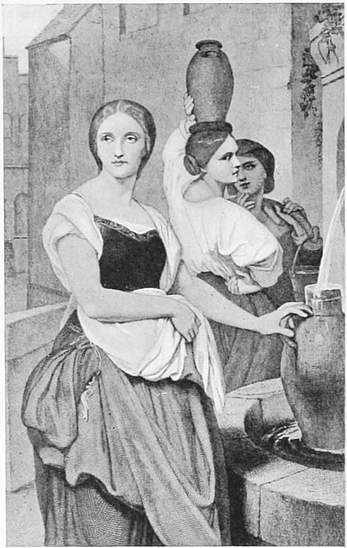 |
 | ||
| Gaz. des Beaux-Arts. | Gaz. des Beaux-Arts. | ||
| ARY SCHEFFER. | MARGUERITE AT THE WELL. | CHASSERIAU. | APOLLO AND DAPHNE. |
Hippolyte Flandrin was the French counterpart of the German Nazarenes. He is an example of how Ingres’ teaching resulted in stiff conventionality. Ingres was a dangerous master to follow. His pupils formed round him a small, faithful, and submissive band, swore like those of Cornelius by the master’s doctrines, and for that very reason never attained to any distinctive character of their own. None of them possessed Ingres’ many-sided talent. His empire, like that of Alexander the Great, was divided among his successors, each of whom governed his own little realm with greater or less ability. Hippolyte Flandrin devoted himself to religious painting, which in his hands for the first time regained a greater importance in French art; but he followed much more slavishly than Ingres in the paths of the Italian masters of the fourteenth and fifteenth centuries. This painter, worthy of respect, full of conviction, learned and of sterling worth, but colourless and cold, who decorated the churches of St. Vincent de Paul and St. Germain des Prés, has enriched the history of art by no new gift. An indefatigable worker, but endowed with little intellectual power, he went no further than to follow out strictly the rules which Ingres taught his pupils and had himself acquired from the old masters. After Flandrin, as winner of the Prix de Rome in 1831, had become intimately acquainted with the art treasures of Italy, he seldom met with any difficulty. His cartoons are flowingly and correctly executed with a firm hand, like the fair copy of a school essay. Of draughtsmanship he knew all that is to be learned; he remembered much, arranged his reminiscences, and thought little for himself. He was a miniature copy of his master, at once more poorly endowed and more fanatical, a purely mathematical genius; his art is a cold geometrical knowledge, the adaptation of anatomical studies to conventional forms, an arrangement of groups and draperies in strict accordance 259 with celebrated exemplars. Had not the primitive Italian masters, the painters of the ancient Christian catacombs, the saintly Fra Angelico, and the mosaic artists of Ravenna done their work long before him, Flandrin’s paintings would never have seen the light, any more than those of the Nazarene school. In both cases one can assign almost every face and figure to its original in the pictures of the Italian masters. Only a certain blond, tender, slightly melancholy, modern face of a Christian maiden is Flandrin’s peculiar property. He transferred these same ascetic and pure principles to portrait painting, and thereby acquired for himself a large practice as the painter of the femme honnête. These women conversed with him and blushed in his presence; in his pictures we find grace and delicacy, eyes sparkling or meek, tenderness and mocking laughter, all translated into a nun-like, unapproachable appearance, which under the Second Empire gained the greater approbation among ladies, since it was seldom found in real life.
Alongside of this Overbeck, endowed with greater artistic powers than his German congener, there stands as the French Cornelius Paul Chenavard, a man who revolved in his fertile brain philosophical conceptions deeper almost than those of the German master. He dreamed of broad, symbolical, decorative pieces, embracing all time and all space, wherein all the cosmogonies of the universe should be united. Like Cornelius, he wished to be a Michael Angelo, but he succeeded no better than the German. He spent fifteen years in the churches and museums of Italy, pencil in hand, accumulating a vast collection of studies, from which his great painted history of the world was to be built up. But when he went back to Paris his materials from the old masters had grown upon him to such an extent that he never recovered his individuality. For four years he worked with feverish diligence, and completed eighteen cartoons, each six 260 metres in height and four in breadth, intended for the walls of the Pantheon. So far as colour is concerned, they have attained no greater success than the Campo Santo frescoes of Cornelius. Chenavard could draw much better than the German, but was not much better as a painter; the works of both have a literary rather than an artistic value.
Brief and brilliant was the career of Théodore Chassériau, who shot across the heavens of art like a gleaming meteor, first as a devotee of form, in Ingres’ sense of the word, and afterwards, like Delacroix, as an enthusiastic lover of sunshine and the clear light of Africa. Born in 1819 at St. Domingo, he followed his teacher Ingres in 1834 to the Villa Medici; but even in his first picture, the “Susanna” of 1839, now in the Louvre, he proved himself by no means an orthodox pupil. “He has not the least understanding for the ideas or the changes which have entered into art in our time, and knows absolutely nothing of the poets of recent days. He will live on as a reminiscence and a reproduction of certain ages in the art of the past, without having created anything to hand down to the future. My wishes and my ideas do not in the least correspond with his.” In these words Chassériau has himself pointed out what it was that distinguished him from Ingres. Unfortunately he produced but little. Personally a very elegant, blasé gentleman, he plunged on his return from Italy into the whirlpool of Parisian life. He was remarkably ugly; but his black, piercing eyes made him the idol of the ladies, and he hurried through life with such haste that he broke down altogether at the age of thirty-six. Beyond various decorative paintings for the church of Saint Méry and for the Salle des Comptes in the Palais d’Orsay, only a few Eastern pictures, and, best and most characteristic, a couple of lithographs, remain to represent his work. In these delicate mythological compositions a chord is struck which found no echo until, a generation later, it was heard again in the work of the French New Idealists and the English Pre-Raphaelites: there speaks in them a Romantic Hellenism, a something dreamily mystic, which makes him a remarkable link between Delacroix and the most refined spirit in the modern school, Gustave Moreau. It was purely an act of gratitude in Moreau when he affixed the dedication “To Théodore Chassériau” to his fine picture of “The Young Man and Death.”
Léon Benouville will be remembered only for his picture of the “Death of St. Francis,” in the Louvre, a good piece of work in the manner of the Quattrocento. Léon Cogniet deserves to be mentioned because in the fifties he brought together in his studio so many foreign pupils, especially Germans. He enjoyed above all others the reputation of being able to initiate beginners both quickly and with certainty into the peculiar mysteries of craftsmanship. All that a master can teach, and that can be learned from his example, was to be obtained from this kind and fatherly instructor. Even after he had long given up painting, his grateful pupils used to meet together yearly at a banquet given in the patriarch’s honour. As an artist he belongs to the list of the great men who have paid for overpraise in their lifetime by oblivion after their death. 261 His “Massacre of the Innocents” of 1824—a woman who, mad with terror, thinks to hide herself and her child from the assassins of Bethlehem under an open stairway—could give pleasure only in a time which hailed with enthusiasm Ary Scheffer’s heads resembling plaster busts full of expression. Occasionally, too, he painted landscapes—the chimerical, vague creations of a man who had lived but little in the open air. His finest picture, “Tintoretto Painting his Dead Daughter by Lamplight,” of 1843, the engravings of which once enraptured France and Germany, has to-day a somewhat insipid effect, and shows whither his genius was leading him—in technique a coarser Schalcken, in sentiment a weaker Delaroche.
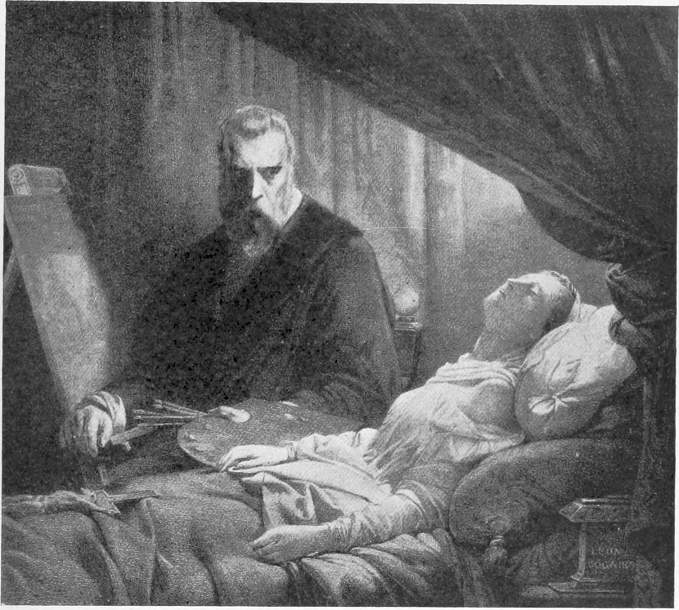 | |
| COGNIET. | TINTORETTO PAINTING HIS DEAD DAUGHTER. |
Delaroche was the Titian of Louis Philippe’s age, the spoiled child of the Juste-milieu, one of the most insignificant and at the same time one of the most famous painters of the century; and in this double capacity is an interesting proof that in art the “Vox populi” is seldom the “Vox Dei.” What a difference between him and the great spirits of the Romantic school! They 262 were enthusiastic poets; their predilection for Mediævalism was concerned only with its æsthetic charm, with the twilight shadows of its picturesque churches, the sounding presage of its bells, the motley processions of that world gleaming bright with uninterrupted colour. And what further allured their imaginative powers was the unruly character of certain epochs, the destructive war of wild factions, and the blazing, consuming power of passion. The historical motive, as such, was with them only a pretext for launching forth into flashing orgies of colour, according to the example, which they followed merely in externals, of the Venetian and Flemish masters. They knew, as genuine painters, that only in the pigment on their palette slumbers that power of exciting emotion by means of which the art of painting touches the chords of men’s souls. Enthusiasts of colour and of passion, they raved about the poets merely because the latter more readily enabled them, by means of the fierce vehemence of the awakened powers of nature, to invest with form the feverish, agitated, and terrible dreams of their fantasy. So it was that Delacroix told of conflagration, of battle and warfare, of murder and pillage, of the bitterness and pains of love. At the same time, no doubt, he studied the vari-coloured costumes of past ages—his drawings show as much—but he made use of them simply as a storehouse of bright hues, as a lexicon by means of which he might embody his visions of colour. To manufacture historical vignettes and play the part of a teacher of history would have been in his eyes a thing to be held in contempt as the work of subservient illustrators. Yet perhaps it was by taking this very course that far greater successes were to be attained, so far as the verdict of the multitude is considered.
The decade following upon 1820 was a season of brilliant blossom for the art of writing history in France. By his History of the English Revolution, in 1826, Guizot won for himself a place in the foremost rank of French authors. He began in 1829 his famous lectures at the Sorbonne, and commenced in 1832 the publication of his Sources of French History. Even before him, Augustin Thierry had written in 1825 his History of the Conquest of England by the Normans, followed by Stories from the Merovingian Times, and was now engaged in the preparation of his great work, the History of the Origin and Progress of the Third Estate. Not unworthy to be compared with these writers, and soon to stand beside them, were two young men working in collaboration—Mignet and Thiers—who came to the front in 1823-24 with their History of the Revolution. At the impulse thus given, historical societies and unions had arisen in every province of France, and were developing an ever-increasing activity.
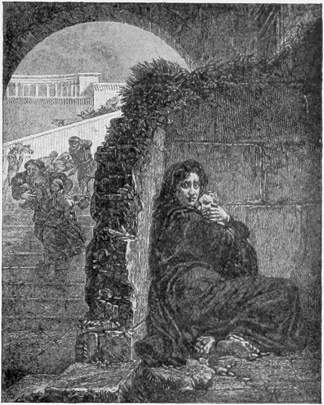 |
| COGNIET. THE MASSACRE OF THE INNOCENTS. |
What learning had begun, poetry carried further. A number of writers, young and old, began to consider what poetic use might be made of the materials which these investigations had brought to light, and few years had passed before the number of historical romances and dramas was hardly to be computed. Vitet, the elder Dumas, and de Vigny put historical tragedy in the place of classical, and the modern novel of George Sand, Balzac, and Beyle was ousted by the historical romance. During the same years was completed 263 the process by which grand opera forsook fantastic for historical subjects, such as Auber’s Muette de Portici and Rossini’s Guillaume Tell.
Art also sought to turn to account the new materials furnished by historical science, and æsthetic minds hastened to enumerate the advantages which were to be expected of it. On the one hand—and this was nothing new—the artist, whose curse it was to be born in an inactive and colourless age, would find here all that he sought, for history offered him the contemplation of a magnificent life, full of movement. On the other hand—and this was the chief point—painting might also fulfil an important mission on behalf of culture, if by virtue of its more easily understood method it could supplement the science of history, and by recalling the great memories of the past keep alive that patriotism which in unfavourable conjunctures is so frequently found wanting. Guizot recommended French history, “the history of chivalry,” to painters, as the first and most important source of inspiration. “We want historians in the art of painting,” wrote Vitet; and his cry was not unheard.
While the Romanticists had seen in the old costumes nothing more than elements out of which a dashing colour-symphony could be obtained, troubling themselves little about the meaning or the narrative import of their pictures, their successors went over, bag and baggage, into the camp of the historians. In the place of pure painting, there arose an art laden with scientific documents, which busied itself in reconstructing former times with antiquarian exactness. While the former had produced nought but genuinely artistic colour-improvisations, so now a didactic aim, together with historical accuracy, became the main consideration. The painter was commissioned as a chronicler, an official of the state, to console citizens for the lamentable present by an appeal to the glorious past. He became a professor of history, a theatrical costumier who rummaged records, chose masks, cut out dresses, arranged scenic backgrounds, for no other purpose than to depict correctly and legibly on the canvas an historical event. And Mme. Tout le Monde found in these pictures exactly what she required. On the one hand, the didactic aim of historical painting, with its long explanations in the catalogues, answered precisely to the needs of the educated middle classes. Under the picture there was always a pretty card on which was printed this or that quotation from some historical writer. One read the description, and then satisfied 264 one’s self that the corresponding picture was really there and that it was in keeping with the description. One recalled to mind the lessons in history one had learned at school, and was pleased to be reminded in so pleasant a fashion that before the nineteenth century people did not wear trousers and frock-coats, but knitted hose and mantles. On the other hand, there still survived enough of the Romantic unruliness to allow one to be shocked in a decorous and moderate manner, and with the help of the catalogue a picture might be permitted to make one’s flesh creep in an agreeable way.
 |
| L’Art. |
| PAUL DELAROCHE. |
|
“Paul Delaroche à la funèbre mine S’entour avec plaisir de cadavres et d’os Jane Grey, Mazarin, héros et héroine Chez lui tout meurt ... excepté ces tableaux.” |
For the average painter of mediocre ability historical exercises of this sort must also have been very alluring, inasmuch as they made no demand upon specially artistic qualities—upon any peculiar aptitude of the fancy, eye, or palette. The historian must indeed possess the power of combination, but much more that of sober investigation; too much imagination or too great a sense of humour would be dangerous to him. So also the historical painter required neither fancy, sentiment, nor power of perception; a certain capacity for compiling facts was all that was necessary. It was enough to ferret out of some popular book on history the story of a murder, and to possess a work upon costumes. By such means, men of a certain ability could easily manage, with the help of the studio technique founded by the Romantic school, to put together the most imposing show-pieces. And even the critics allowed themselves frequently to be so far misled as to give to those models who were decked out in the finest costumes, and labelled with the names of the most celebrated personages, precedence over their more modest companions. Consequently it happened that in the time of the citizen monarchy a great number of painters entirely devoid of talent, whose only merit was that they attached to this or that chapter of universal history pictures showing some laboured animation, became in the twinkling of an eye leaders of the schools.
Eugène Devéria was the first and most important painter deliberately to enter upon this course. When his picture of the “Birth of Henry IV” was exhibited in the Salon of 1827 his appearance was welcomed as that of a new Veronese, and his work joyfully saluted as the first historical picture in which the local colour of the epoch represented was accurately observed. Henceforth Devéria dressed always in the style of Rubens, and his house became the headquarters of the Romantic school. He was perhaps the only member of this group in whom some breath of Delacroix’s spirit survived, but unfortunately he never found again either the Venetian tone or the male accent of his youth, and though he painted many more pictures he never contributed a second notable work to art.
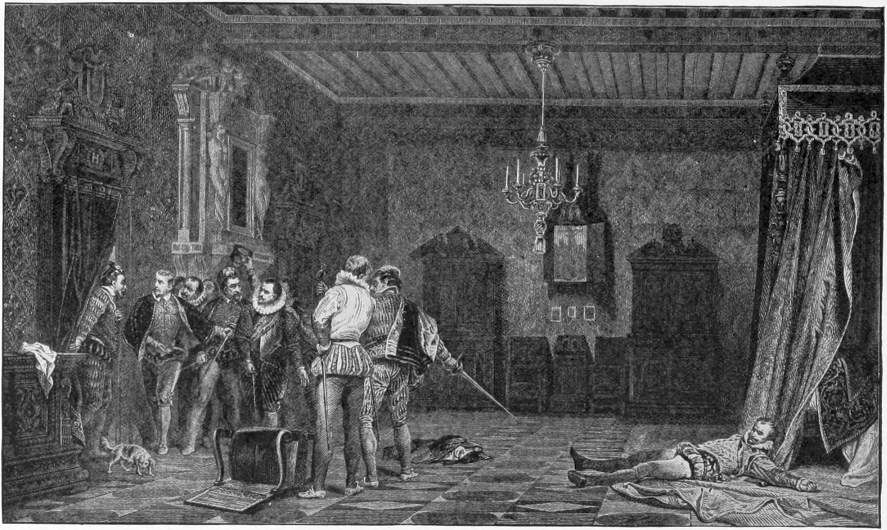 | |
| Cassell & Co. | |
| DELAROCHE. | THE ASSASSINATION OF THE DUKE OF GUISE. |
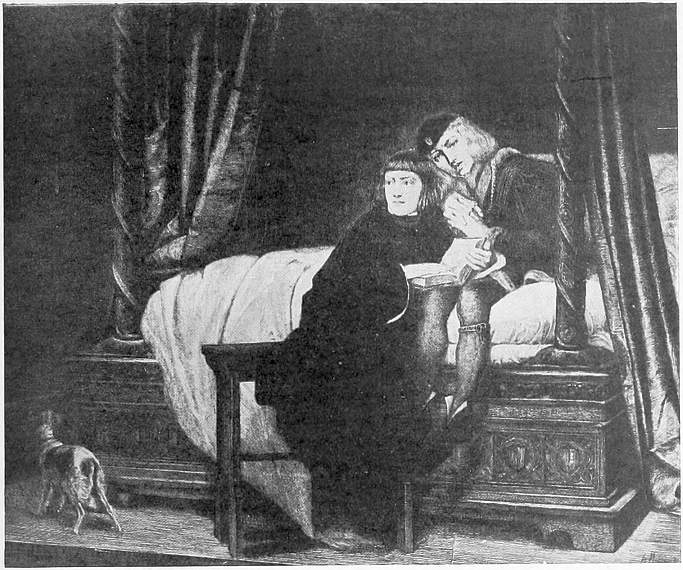 | |
| L’Art. | |
| DELAROCHE. | THE PRINCES IN THE TOWER. |
Shortly afterwards Camille Roqueplan began to alter his manner. Up to that time he had been exclusively a painter who, like Watteau and Terborg, listened with a voluptuous shudder to the piquant rustle of silk, velvet, and satin dresses; now he devoted himself to depicting with perspicuity various scenes from history, renounced his airy and radiant fantasies, and became, in his “Scene from the Massacre of St. Bartholomew,” nothing but a tedious schoolmaster.
Nicolaus Robert Fleury, the painter of “Charles V in the Monastery of St. Just,” of the “Massacre of St. Bartholomew,” of the “Religious Conference at Poissy,” and of other historical anecdotes, carefully conceived and laboriously executed, devoted himself, like Lessing, to the propagation of noble ideas. His pictures were manifestoes against religious fanaticism, and philanthropic discussions concerning the trials and persecutions of the freethinkers. In order to give them the stamp of historical verisimilitude, he buried himself 268 with the zeal of an archivist in the study of the period to be represented; often directly transferred into his pictures figures from Diepenbeeck or Theodor van Thulden; and having the faculty of seizing in old paintings those tones of colour which belong rather to the epoch than the master, he succeeded in giving his works a certain documentary and archaic character for which, on his first appearance, he obtained ample credit.
Louis Boulanger, after his “Mazeppa” of 1827, was a famous painter. But the highest success was that attained by Paul Delaroche, inasmuch as he understood better than any other, not only how to cater for the cultured public by the didactic nature and historical accuracy of his pictures, but also how to touch the heart by means of a lachrymose sentimentality.
Paul Delaroche belongs, by the date of his birth, to the eighteenth century. Being one of Gros’ pupils, he had never borne the yoke of the Classical school in its fullest weight, and therefore had never had occasion to revolt against it. When the Romanticists came to the front, he had gone or rather been dragged along with them, for to his circumspect nature Romanticism was an abomination, and his cool and deliberative spirit felt itself much more at home in the society of the Classicists. The works of the historians opened to him a welcome outlet by which to avoid a rupture with either party, and Delaroche found his vocation. He assumed the rôle of a peacemaker between the quarrelling brothers, placed himself as mediator between Montagues and Capulets, and thus became—like Casimir Delavigne in literature—the head of that “School of Common Sense” on whose banner glittered in golden letters Louis Philippe’s motto of the Juste-milieu. Ingres was cold, reserved, and colourless; Delaroche aspired to an agreeable, sparkling, highly seasoned, bituminous art of painting. Delacroix was genial and sketchy; Delaroche inscribed carefulness and exactness on his banner. The former had given offence by his boldness; Delaroche won the conservatives over to himself by his well-bred bearing and moderate attitude. People thought Delacroix too wild and poetical; Delaroche took care to give them only a touch of the eagerness of Romanticism, and set himself to reduce the passionate vehemence of Delacroix to rational, Philistine limits, and to soften down his native unruliness into sentimental pathos. This position which he assumed as a mediator made him the man of his age. The life of Delacroix was a long struggle. But for the commissions entrusted to him by the state he might have died of starvation, for his sales to dealers and lovers of art brought him scarcely five hundred francs a year. His studio held many pictures, leaning mournfully against each other in corners. Delaroche, on the other hand, was overwhelmed with praise and commissions. The representatives of eclecticism in philosophy and of the Juste-milieu in politics found themselves compelled to praise an artist who was neither revolutionary nor reactionist, neither Romantic nor Classical, who had bound himself over neither to draughtsmanship nor to colouring, but united both elements in vulgar moderation.
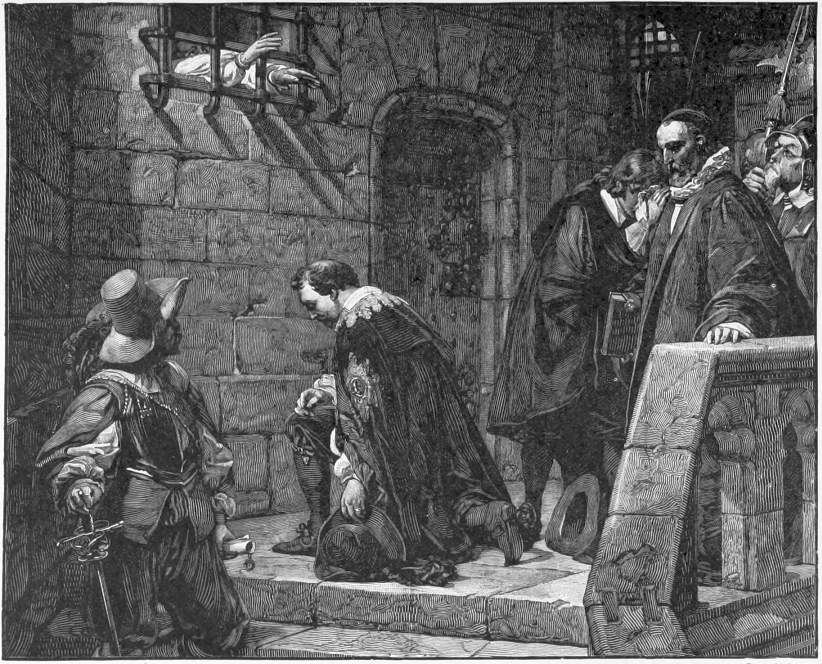 | |
| Cassell & Co. | |
| DELAROCHE. | STRAFFORD ON HIS WAY TO EXECUTION. |
 |
| L’Art. |
| THOMAS COUTURE. |
Already in his first notable works, in 1831, “The Princes in the Tower” and “Oliver Cromwell,” he has fully assumed his lukewarm manner. He might have represented the murder of the princes, but fearing that the public would not stand it, he preferred merely to suggest the approaching death of the weeping and terrified children by placing in front of the bed a small dog, which is looking uneasily towards the door, where the red light of torches indicates the approach of the assassins,—a Düsseldorf picture with improved technique. It is just the same with his melodramatic and lachrymose “Cromwell.” It would be hardly possible to represent one of the greatest figures in universal history in a more paltry manner, and to this day it is not quite certain whether the picture was intended to be serious or humorous. The great statesman in whom was embodied the political and ecclesiastical revolution of England must have been extremely busy on the day of Charles I’s funeral, and have had better things to do than stealthily to open the coffin and contemplate, with a mixture of childish curiosity and sentimental pity, the corpse of the king whom he had fought and conquered. Eugène Delacroix had treated this subject in a sketch, in which Cromwell, at the funeral of Charles, gazes in quiet contempt upon the weak monarch who had not known how to keep either his crown or his head. As a work of art this little water-colour is worth ten times as much as Delaroche’s great, long-meditated, carefully executed painting. From the very beginning he had no sense for the passionate or dramatic. From the first day, had the tailor who prepared costumes struck work, his artistic greatness would have fallen away to nothing; from the commencement he produced nothing but large, clumsily conceived illustrations for historical novels. Planché pointed out long ago that all the costumes are glaringly new, that all the victims look as if they had got themselves up for a masked ball, that this sort of painting is much too clean and pretty to give the argument the appearance of probability. Théophile Gautier, who had proclaimed the powerful originality of Delacroix, fumed with rage against these “saliva-polished representations, this art for the half-educated, disguised in false, Philistine realism, this art of historical illustration for the familiar use of the bourgeois.” To rank timorous, half-hearted talent higher than reckless and awe-inspiring genius—this was in Gautier’s eyes the sin against the Holy Ghost, and he sprang like a tiger upon the popularity of talents such as these. He could, as he himself said, have swallowed Delaroche, skin, hair, and all, without remorse; meanwhile, the public raised him upon the shield as its declared favourite.
He won the intellectual middle class over to himself with a rush, as he industriously went on rummaging in manuals of French and English history for 272 royal murders and battle-deaths of kings. With his “Richelieu,” “Mazarin,” and “Strafford,” but especially with his “Execution of Lady Jane Grey” and “Murder of the Duke of Guise in the Castle of Blois,” he made hits such as no other French artist of his time could put to his account. Just then, in his youthful work, The States-General at Blois, Ludovic Vitet had put the murder of the Duke of Guise upon the stage. Nothing could be better-timed than to transform this operatic scene into colour. The historians of civilisation admired the historical accuracy of the courtiers’ dress, all the upholstery of the room, the lofty mantelpiece, the carved wardrobes, the praying-stool with the altar-piece over it, the canopy-bed with its curtains of red silk embroidered with lilies and the king’s initials in gold. Playgoers compared the scene with that which they had witnessed on the stage in Vitet’s piece, and the comparison was not unfavourable to the painter. For Delaroche, in order to be as far as possible in keeping with the stage representation, was accustomed to commission Jollivet, the chief mechanician of the Opera House, to prepare for him small models of rooms, in which he then arranged his lay-figures.
That is the further great difference between Delaroche and Delacroix, between the vagrant painter of history and the artist. The latter had the gift of the inner vision, and only painted things which had intellectually laid hold upon him and had assumed firm shape in his imagination. It was while the organ was playing the Dies iræ that he saw his “Pietà” in a vision—that mighty work which in power of expression almost approaches Rembrandt. “Is not Tasso’s life most interesting?” he writes. “You weep for him, swaying restlessly from side to side on your chair, when you read the story of his life; your eyes assume a threatening aspect, and you grind your teeth with rage.” Such passionate emotion was wholly unknown to Delaroche; he painted deeds of murder with the wildness of Mieris. Delacroix everywhere grasps what is essential, and gives to every scene its poetical or religious character. A couple of lines are for him sufficient means wherewith to produce a deep impression. In presence of his pictures one does not think of costumes; one sees everywhere passion overflowing with love and anger, and is intoxicated with the harmony of sentiment and colour. Delaroche, like Thierry, had merely a predilection for the historical anecdote which, dramatically pointed, keeps the beholder in suspense, or else, simply narrated, amuses him. The colour and spirit of events had no power over his imagination; he merely apprehended them with a cool understanding, and put them laboriously together in keeping with it. Delacroix sought counsel from nature; but in the moment of creation, in front of the canvas, he could not bear direct contact with it. “The influence of the model,” he wrote, “lowers the painter’s tone; a stupid fellow makes you stupid.” Delaroche draped his models as was required, made them posture and pull faces, and while he was painting, laboriously screwed them up to the pathos demanded by the situation. Such a method of procedure must necessarily become theatrical.
Just as in his historical pictures he endeavoured to transform Delacroix’s 273 passion into operatic scenes, so he perfected his position as a man of compromise by imitating the academic style in his “Hemicycle.” Here it was Ingres’ laurels which robbed him of his sleep. The fame which this picture has acquired is mainly due to Henriquel Dupont’s fine engraving. It does not attain to any kind of solemn or serious effect. One might imagine one’s self in some entirely prosaic waiting-room, where all the great men of every age have agreed to meet together for no matter what ceremonial purpose; one sees there a carefully chosen collection of costumes of all epochs, with well-studied but expressionless portraits of the leaders of civilisation. Here also Delaroche has not risen above respectable mediocrity, and his characteristics remain, as ever, thoroughly middle-class.
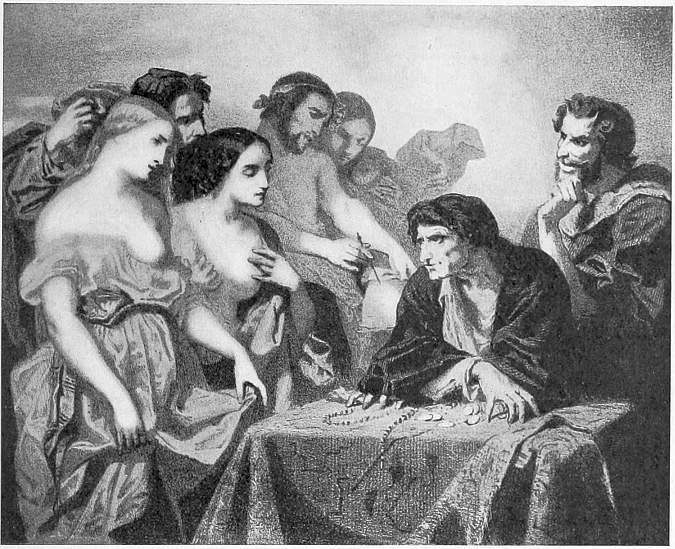 | |
| COUTURE. | THE LOVE OF GOLD. |
His likeness of Napoleon is perhaps that which shows most clearly how paltry a soul this painter possessed. It is not Devastation in human shape, not the man in whom his officers saw the “God of War” and of whom Mme. de Staël said, “There is nothing human left in him.” The intellect of that Corsican, with his great thoughts striding as in seven-leagued boots, thoughts each of which would give any single German writer material for the rest of his life, was hidden to the inquisitive glance of a painter who had never seen in 274 the whole of human history anything more than a series of petty episodes. And one who is not able to paint a good portrait is not justified in intruding into other regions of art.
For similar reasons the religious paintings with which he busied himself in his last days have likewise enriched art with no new element. They are a Philistine remodelling of the Biblical drama, in the same style as his historical pictures. In the end he appears himself to have become conscious how little laborious compilations of this kind have in common with art, and since with the best will in the world he could produce nothing better than he had painted in the thirties, he lost all pleasure in his vocation and abandoned himself to gloom and pessimism, from which death set him free in 1856.
Thomas Couture, who after Delaroche was most in vogue as a teacher in the fifties, was of greater importance as an artist, and in his “Romans of the Decadence” produced a work which, from the point of view of the Juste-milieu, is worthy of consideration even to-day. He was a remarkable man. His parents, shoemakers at Senlis, seem to have regarded the thick-headed, slowly developing boy as a kind of idiot, and are said to have treated him with no excessive gentleness. He was sent away from school because he could not understand the simplest things, and studied without success in the studios of Gros and Delaroche. And yet, after he had made his début in the Salon of 1843 with the “Troubadour,” a fine picture in the style of Devéria, his “Orgie Romaine” of 1847 made him at one stroke the most celebrated painter in France. Pupils thronged to him from every quarter of the globe, and he left a deep and enduring impression upon every one of them. A very short, corpulent, broad-shouldered, thick-set, proletarian figure, with thick disorderly hair, a blouse, a short pipe, and a gruff manner, he used to stride through the lines of his pupils, who regarded him with wonder on account of his ability as a teacher and his remarkable powers.
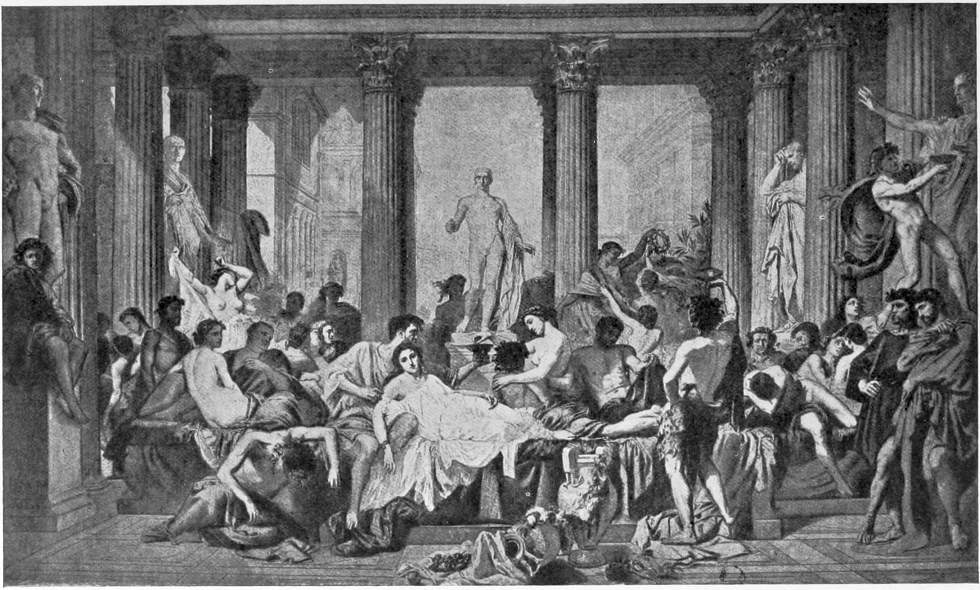 | |
| Baschet. | |
| COUTURE. | THE ROMANS OF THE DECADENCE. |
Yet, when a few years had elapsed, no one heard of him again. After his “Love of Gold” and a couple of portraits, he felt that he was unfruitful, and gave up the battle. “The Falconer,” an excellent picture, with charming qualities of colour, was the last work to give any proof of Couture’s technical mastery. He fell out with Napoleon, who wished to employ him; made many enemies by his writings, especially among the followers of Delacroix, whom he criticised beyond measure; and finally, embittered, and abandoning all artistic work, he buried himself in his country place at Villers de Bel, near Paris. Thither Americans and Englishmen used to come to order pictures of him, and were much astonished to hear that the old gardener’s assistant, as they took him to be, sitting on the grass and mending shoes or old kettles, was Couture. The news of his death in 1879 caused general astonishment; it was as if one long buried had come to life again. It had meanwhile become evident that even his “Romans of the Decadence” was only a work of compromise, the whole novelty of which consisted in forcing the results attained by the Romantic school in colouring into that bed of Procrustes, the formulæ of idealism. The work is undoubtedly very noble in colouring, but what would not Delacroix have made of such a theme! or Rubens, indeed, whose Flemish “Kermesse” hangs not far from it in the Louvre. Couture’s figures have only “absolute beauty,” nothing individual; far less do they exhibit the unnerved sensuality of Romans of the decline engaged in their orgies. They are merely posing, and find their classical postures wearisome. They are not revelling, they do not love; they are only busied in filling up the space so as to produce an agreeable effect, and in disposing themselves in picturesque groups. Even the faces have been vulgarised by idealism: everything is as noble as it is without character. There is something of the hermaphrodite in Couture’s work. His art was male in its subjects, female in its results. His “Decadence” was the work of a decadent, a decadent of Classicism.
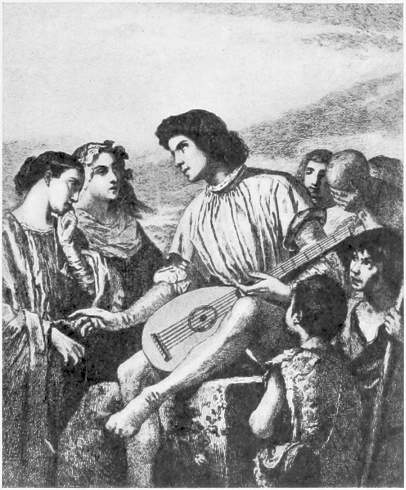 | |
| Gaz. des Beaux-Arts. | |
| COUTURE. | THE TROUBADOUR. |
| (By permission of M. Charles Sedelmeyer, the owner of the picture.) | |

CHAPTER XII
THE POST-ROMANTIC GENERATION
Four years after Couture painted his “Roman Orgy,” Napoleon III ascended the throne, and the Parisian orgy began. It was a remarkable spectacle that the capital offered in those days—a spectacle of fairy-like, flashing and sparkling splendour. Even to-day, when Republican Paris endeavours as much as possible to obliterate every memory of the Empire, Napoleon’s spirit lives in the external appearance of the city and hovers over every conspicuous point. Augustus might say that he had found his capital a city of plaster and lime, and left it one of stone and bronze; Napoleon has the right to maintain that he raised palaces where there had been barracks.
Notwithstanding all the imprecations uttered against his rule, the most thorough-going Republicans reluctantly concede to him the possession of one good quality: he knew how to bring prosperity to the shop; “il faisait marcher le commerce.” One hears it said that the beautiful city on the Seine is but the shadow of what it then was. “Le niveau a baissé!” says the Parisian, when he calls to mind the gorgeous days of the Empire. The extravagant elegance, the magnificent luxury, which used to roll in superb carriages along the Boulevards and the Champs Elysées towards the Bois de Boulogne, and exhibited itself in the evening in the boxes of the theatres; the lustre which emanated from the Court, and the concourse of all the nabobs of the world,—all this must in those days have given to Parisian life a sparkling splendour, a something stupefying and intoxicating, an alacrity of enjoyment which had no parallel elsewhere. To the respectable, pedantic bourgeoisie which ruled under Louis Philippe had succeeded a new generation of men of the world, which drank to the lees all the refined pleasures that a modern great city has to offer. The gentlefolk of the Empire understood the art of living better, cultivated and exhausted it after a more inventive fashion, than any generation that had gone before. In the Tuileries sat the man of the Second of December, the connoisseur and promoter of all refined tastes. In his person the age was embodied, that age depicted by Zola in La Curée, in the passage where he describes the halls, illumined as if by enchantment, of the imperial palace. There, all the splendour of over-civilisation glitters and gleams, with its bright eyes and sparkling jewels, with its breath of intoxicating perfumes floating from naked shoulders and arms and half-veiled voluptuous bosoms; while the green, sphinx-like eye of Napoleon III rests indifferently on the alabaster sea of 279 white shoulders bowing before him, as he reviews all that he has possessed and all that he can yet enjoy. Dumas’ Dame aux Camélias, Diane de Lys and Le Demi-monde, Barrière’s Filles de Marbre, Augier’s Mariage d’Olympe, give the impress of the period upon literature, and the single phrase “The Lady of the Camelias” conjures up a world of forms and of scenery. La Nouvelle Babylone is the title of the fine book in which Joseph Pelletan depicted the mysterious Paris of those years, the great city which cherished in its bosom the lowest and highest extremes of a refined world of pleasure, and was at the same time an inexhaustible fountain of arduous work.
One would have imagined that these new conditions of Imperial France would have left their impress, in some way or other, upon the art of painting also; just as in the works of Rembrandt, Frans Hals, Jan Steen, Terborg, Ostade, Pieter de Hooch, and Van der Meer of Delft the entire seventeenth century is reflected, clearly and with animation, treated with charming familiarity or else with grandiose effect, in its spirit, its manner of feeling, its habits and costumes. What a domain painting would have had; from the official festivals and the bustle of public life down to the complete delineation of the family home! Literature had entered into this course a quarter of a century before, and had shown the path—a path leading to new worlds. But in French art French society is not reflected. Not a single painter has left us a picture of this splendid Paris, dancing on a volcano and yet so amiably delightful. Classicism and historical painting still held the field, as if turned to stone, and show, in essentials, hardly any modification.
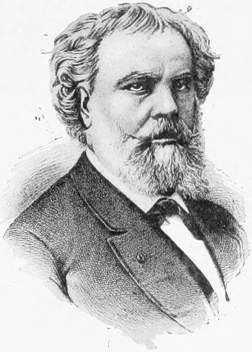 |
| Gaz. des Beaux-Arts. |
| ALEXANDRE CABANEL. |
So far back as in 1833, Charles Lenormant wrote of the school of David: “Even the great painter Ingres was not able to rejuvenate a school which was breaking up from old age, or to restore their full resonance to the slackened and worn-out chords; his only office was to give the old synagogue honourable burial. Take away this last scion of the Classical school, and the curtain may fall—the farce is ended.” He might have said the same thing forty years later, for with Cabanel and Bouguereau Classicism has limped on, almost unchanged, to our own days. Its art was a correct, conventional picture-stencilling, which might just as well have flourished a generation earlier. Classicism—which in David was hard and Spartan, in Ingres cold and correct—has become pretty in Cabanel and Bouguereau, and is completely dissolved in the scent of roses and violets. Only a certain perfume of the demi-monde brings the persons who appear as Venus, as 280 naiads, as Aurora or Diana, into complete accord with the epoch which produced them. For Ingres the female body itself was the exclusive canon of beautiful form; now the swelling limbs begin to stretch themselves voluptuously forth. Ingres still treats the human eye as it was treated in ancient sculpture, as something animal, soulless, and dead; now it begins to twinkle provocatively. A modern refined taste plays round the classical scheme.
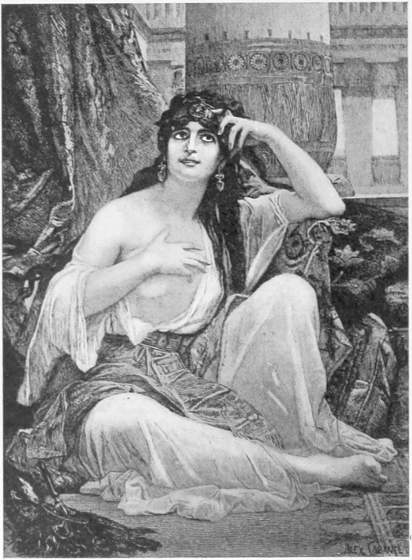 | |
| Gaz. des Beaux-Arts. | |
| CABANEL. | THE SHULAMITE. |
 | |
| BOUGUEREAU. | BROTHERLY LOVE. |
Alexandre Cabanel, the incarnation of the academician, was, under Napoleon III, the head of the École des Beaux Arts. He was a fortunate man. Born at Montpellier, the city of professors, nourished from his earliest youth on academic milk, winner of the Grand Prix de Rome in 1845, awarded the first medal at the Universal Exhibition of 1855, he went on his way, laden with orders and offices, amid the tumultuous applause of the public. Among the artists of the nineteenth century none attained in so high a degree all those honours which lie open to a painter in our days. Yet, as an artist, he remained all his life on the plane of the school of Ingres. Even his “Death of Moses,” the first picture which he sent from Rome to the Salon, was entirely pieced together out of Raphael and Michael Angelo. After that he laid himself out to provide England and America with those women, more or less fully attired, who bore sometimes biblical, sometimes literary names: Delilah, the Shulamite woman, Jephthah’s daughter, Ruth, Tamar, Flora, Echo, Psyche, Hero, Lucretia, Cleopatra, Penelope, Phædra, Desdemona, Fiammetta, Francesca da Rimini, Pia dei Tolomei—an endless procession. But the only variety in this poetical seraglio lay in the inscriptions on the labels; the way in which the figures were represented was always the same. His works are pictures blamelessly drawn, moderately well painted, which leave one cold and untouched at heart. They possess that unusual polish and that dexterity of exposition which, like good manners in society, create a favourable impression, but are insufficient in themselves to make a man a pleasant companion. Nowhere is there anything that takes hold upon the soul, nowhere any touch to prove that the artist has felt anything in his painting, or force the beholder to feel for himself. The unvarying faces of his figures, with their eternal dark-rimmed eyes, resemble not living human beings but painted plaster casts. One would take his “Cleopatra,” apathetically observing the operation of the poison, to be stuffed, like the panther at her feet. One seeks in vain for a figure that is sincere or interesting, for a face alluring in its truth to nature. His “Venus” of 1862 made him the favourite painter of the Tuileries, and the insipid, rosy tints of that picture became more and more feeble in the course of years, until his works resembled wearisome cartoons, coloured by no matter what process. He was Picot’s pupil, it is true, but in reality Ingres was his grandfather, a grandfather far, far greater than himself, whose portraits alone show the entire littleness of Cabanel. All his life long Ingres was in his portraits a fresh, animated, and admirable realist. Cabanel indeed also painted in his earliest days likenesses of ladies which were full of serious grace, uniting a powerful fidelity to nature with considerable elegance. But his success was fatal to him. Moreover, as a portrait-painter, he became the depicter of society, and society 284 ruined him. In order to please his distinguished customers, he devoted himself far more than is good for portrait-painting to smooth rosy flesh, large glassy eyes, and dainty fine hands, and over-idealised his sitters till they lost every appearance of life.
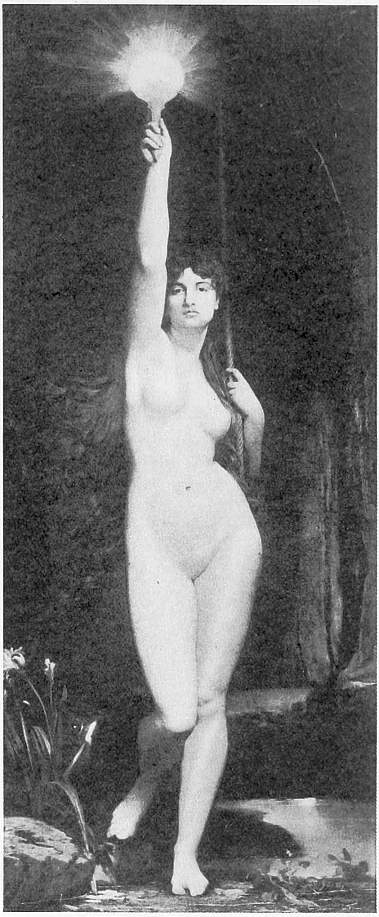 | |
| LEFÉBURE. | TRUTH. |
| (By permission of Messrs. Goupil, the owners of the copyright.) | |
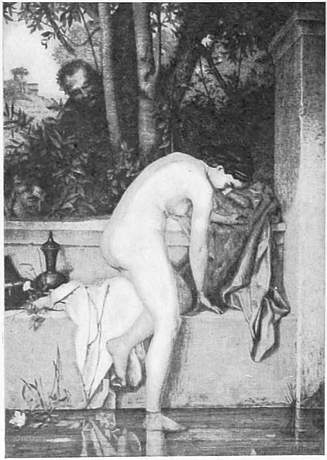 |
| L’Art. |
| HENNER. SUSANNA AND THE ELDERS. |
William Bouguereau, who industriously learnt all that can be assimilated by a man destitute of artistic feeling but possessing a cultured taste, reveals even more clearly, in his feeble mawkishness, the fatal decline of the old schools of convention. He has been compared to Octave Feuillet, who also never extricated himself from the scented atmosphere of distinguished society; but the comparison is unjust to Feuillet. Bouguereau is in his Madonna-painting a perfumed Ary Scheffer, in his Venus-pictures a greater Hamon; and in his perfectly finished and faultless stencilling style of beauty he became from year to year more and more insupportable. His art is a kind of painting on porcelain on a large scale, and he gives to his Madonnas and his nymphs the same smooth rosy tints, the same unreal universalised forms, until at last they become a juste-milieu between Raphael’s “Galatea” and the wax models one sees in hairdressers’ shops. Only in one sense can his religious painting be called modern; it is an elegant lie, like the whole of the Second Empire.
Close by Bouguereau’s “Venus” in the Luxembourg hangs the well-known colossal figure of a beautiful nude woman with unnaturally over-developed thighs, which by the shining mirror in its uplifted right hand proclaims itself to be “Truth.” Jules Lefébure, the painter of this picture, is also completely a slave to tradition; he came from Cogniet’s studio, and won the Prix de Rome in 1861. But he at least possesses more taste, elegance, and character; his painting of the nude is more distinguished, truer, and more powerful. He is in the broader sense of the word a worshipper of nature, and was so in his youth especially. His “Sleeping Girl” of 1865 and his “Femme couchée” of 1868 are smooth and honest studies from the nude, of delicate, sure draughtsmanship, and have therefore not become antiquated even to-day. Unfortunately he did not find this masculine accent again, when at a later time he grouped ideal figures together to make pictures of them. His “Diana surprised” of 1879 was a very clever composition of well-ordered lines, possessing even fine details, especially one or two charming heads, but as a 285 whole it is lifeless and uninteresting. Like Bouguereau, he lacks power, and, notwithstanding his distinction and his capacity for arrangement, he is not painter enough to be truthfully entitled a “painter of the nude.”
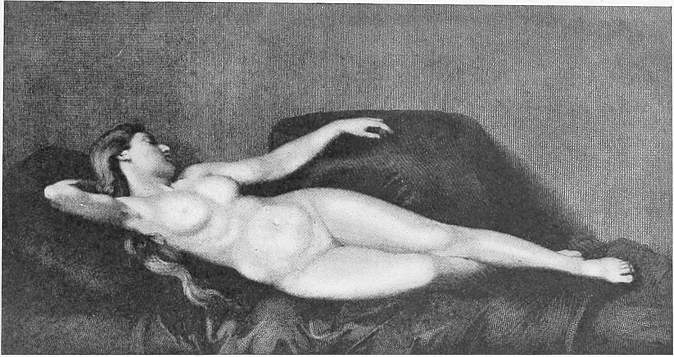 | |
| Gaz. des Beaux-Arts. | |
| HENNER. | THE SLEEPER. |
 |
| PAUL BAUDRY. |
In general, French art, however willingly it took to this sphere during the period we are considering, is rich indeed in well-drawn documents, but poor in works which, considered as painting, can bear the most distant comparison with Fragonard and Boucher. The Revolution had put an end to the joyous flesh-painting of French art. At the close of the eighteenth and the beginning of the nineteenth century the painter of tender and life-like flesh-colour was not the reformer David, but the despised Prudhon. The former found his ideal in statues, and turned flesh to stone. The latter, a direct descendant of Correggio, gave expression to life with a tender mellowness. Ingres was again, like David, a very mediocre flesh-painter, and the Romanticists entered this sphere but seldom. Delacroix indeed has in his “Massacre” a couple of excellent touches, but they are isolated phenomena in his work. After 1850 the approved system was to give nude female figures the appearance of being made of terra-cotta, biscuit, or ivory. The forgotten art of painting velvety, soft flesh, and of making it vibrate in light, had to be learned over again, and to this meritorious task Henner devoted himself—the modern Correggio from Alsace, who stands to Cabanel in the same relation as Prudhon to David. Even Henner in his later days has become very much a mannerist, and has done some very bad work. To-day he prefers a heavy, pasty, buttery style of painting, with faces which look as if they had been pickled in oil, and have an unreal expression; his contrasts of light and shade, once so delicate, have become raw and forced. Yet beside Cabanel he still appears the true poet of female flesh-painting, the dreamy graceful depicter of refined sensuality. 286 Prudhon’s delicate ideal and his language of vibrating tenderness are revived in Henner. His “Nymph resting” in the Luxembourg has the same soft morbidezza, the same delightful mystery, in which Prudhon before him had enveloped the sweetness of smiling faces and the beauty of female forms. He too chose the Lombards as his guides. After winning the Prix de Rome in 1858, he sent to the Salon of 1865 a “Susanna,” which already shows his ability as a flesh-painter and his relationship to Correggio. And a Lombard he has remained all his life. One could with difficulty find a more delicate and smooth study of the nude than his “Biblis” of 1867.
Since that time another tendency highly characteristic of Henner has shown itself in his work. In his endeavour to render the tint and tender softness of flesh as delicately as possible, he sought at the same time for light which should intensify the clear tone of the nude body. These he found in that time of evening, which one might call Henner’s hour, when the landscape, overshadowed by the twilight, gradually loses colour, and only a small blue space in the sky or a silent forest-lake still for a moment preserves the reflection of vanishing daylight. In this tranquil harmony of nature after sunset, the white pallor of the human body seems to have absorbed all the daylight and to be giving it forth again, while the surrounding landscape is already merging into colourless shadow. This is Henner’s “second manner,” and he raised it into a system. Every year since then there has appeared in the Salon one of those pale nymphs, standing out so mistily against the dark green of an evening landscape, or one of those Virgilian eclogues, in which the gloaming rests caressingly upon nude white bodies. And by this method of painting flesh and of throwing light upon it, Henner has won for himself an important place in modern art.
Paul Baudry, the powerful decorator of the Grand Opera House at Paris, marks the close of this tendency. In his work the endeavours of all those talented artists who sought to found a new school of “ideal painting” upon the basis of the study of the Italian Classicists came to a crowning height; and at the same time Baudry took a further step onward, in that he vivified the classical scheme with a yet more marked cast of “modernity.”
His first picture, on the murder of Marat, was feeble. What David had 287 executed smoothly and forcibly in his dead “Marat,” Baudry spoiled in his “Charlotte Corday.” The bath, the night-table with the inkstand on it, the map on the wall, and all the fittings of the room, are painted with the greatest finish, but the young heroine in her petrified idealism has no more life in her than there is in the furniture.
His “Pearl and Wave,” which is hung in the Luxembourg close to Cabanel’s and Bouguereau’s “Birth of Venus,” gave proof of progress. A deep-blue wave, towering on high and crowned with foam, has washed a charming woman ashore like a costly pearl. She seems to have just awakened out of slumber, and her roguish, moistly gleaming eyes are smiling. Saucily she leans forward her fair-haired head under her bended arms, and stretches out in easy motion her youthfully slender yet fully proportioned body. Bouguereau’s and even Cabanel’s female beauties are waxen and spoiled by retouching, but Baudry’s Cypris is a living being, and preserves some of the individual charm of the model.
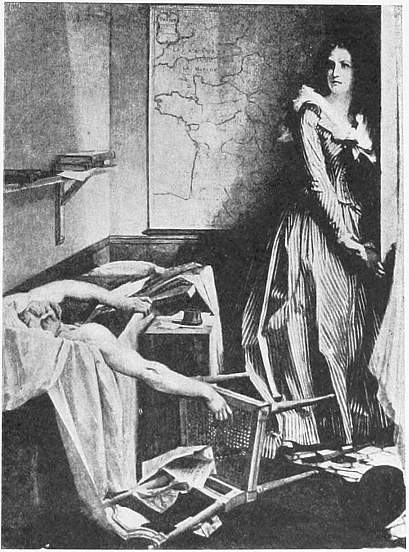 |
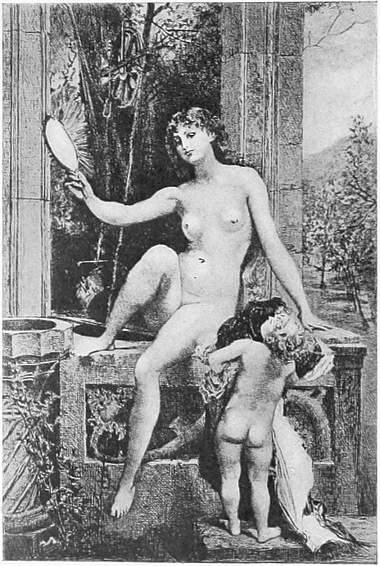 | ||
| Baschet. | Gaz. des Beaux-Arts. | ||
| BAUDRY. | CHARLOTTE CORDAY. | BAUDRY. | TRUTH. |
It is this breath of realism which gives their attractiveness to Baudry’s pictures in the Paris Opera House. He cannot indeed be ranked as a truly great master of decorative painting, as the Fragonard of the nineteenth century; he was too eclectic. The five years, from 1851 to 1856, which as winner of the Prix de Rome he spent in the Villa Medici, were the happiest of his life. He saw in the Italian galleries neither Holbein nor Velasquez, neither Rembrandt nor Botticelli nor Caravaggio. He saw nothing and revered nothing save the pure tradition of the Cinquecento, which was to him the Alpha and Omega of art. He dreamed of great decorative works which should place him on an equality with those old masters. It was therefore joyful news to him when, at the suggestion of his old comrade Charles Garnier, he was commissioned to adorn the Opera House. Baudry was then thirty-five years old, 288 in possession of his full powers, and yet he thought it necessary to go back to Italy to interrogate the masters of the Renaissance anew. For a full year he worked ten hours daily in the Sistine Chapel. As soon as he knew Michael Angelo by heart, he betook himself to England to copy Raphael’s cartoons, and then in 1870 for the third time to Italy, before he felt himself capable of covering the five hundred square metres of canvas. The task took him four years, and when it was exhibited at the Palais des Beaux-Arts in 1874, prior to being placed in its final resting-place, there was general astonishment at a single man’s power to produce so much and such great work.
To-day his praise cannot be sounded so high. The place to which he aspired, by the side of the great masters of the Renaissance, will not fall to Baudry’s lot; he is hardly to be reckoned even among the great French masters of the nineteenth century. To rise even so far he lacked the first and most essential gift—originality. He was a model pupil in his youth, and a pupil he remained all his life. He always saw nature through the medium of art, and never had the courage to take a fresh breath and plunge into its fountain of youth. Between him and reality there was ever the prism of the old pictures that he loved; brush in hand, he devoted himself, turn by turn, and with equal enthusiasm, to Michael Angelo, Titian, Correggio, Bronzino, and even Ingres. As soon as he returned from Italy for the first time, as holder of the Prix de Rome, he exhibited several pictures which were altogether Titian in colouring, altogether Raphael in style. Each of them, even the most important, calls some other painting to one’s mind. His “Fortune and the Child” is a variation upon Titian’s “Divine and Earthly Love”; his “Death of a Vestal Virgin” a reminiscence of the “Death of Peter Martyr”; his “Warrior” in the Opera House is the painted double of Rude’s “Marseillaise.” How many gestures, attitudes, and figures could, by a close analysis, be shown to be borrowed in turn from Veronese, Andrea del Sarto, Correggio, or Raphael! His 289 works are a synthesis of the favourite forms of the Cinquecento; they are the testament of the Cinquecento masters. He was a Parisian Primaticcio, a posthumous member of the old school of Fontainebleau. In him was embodied the last smile of the Renaissance, the results of which he assimilated and reduced to formulæ. He lacked creative imagination, and his pictures are wanting in individual character. The nervous movement and sinewy stretchings of his young men’s bodies would never have been painted but for Donatello’s “David.” Of his women, the powerful and muscular are descended from Michael Angelo’s “Eve,” the more slender and elegant come down from Rosso. His palette, with its blue and white tints, is bright and flowery, but it is no less artificial than his composition.
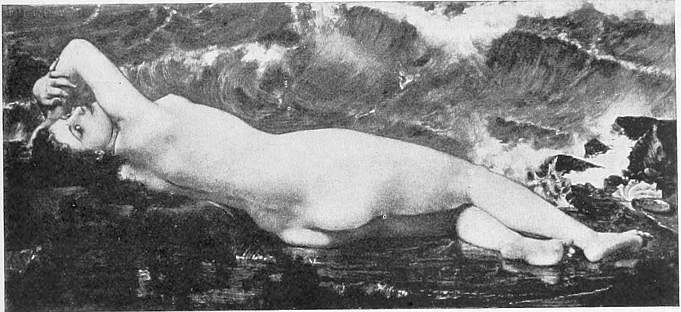 | |
| Baschet. | |
| BAUDRY. | THE PEARL AND THE WAVE. |
| (By permission of Mr. W. H. Stewart, the owner of the picture.) | |
Nevertheless, it would be unjust to speak of Baudry’s work as merely faded Classicism, or as Michael Angelo and water. He was not merely a pupil of the Italians; he contributed something Parisian of his own, something pretty, mannered, refined, graceful, seductive, and smiling, and felt himself independent enough to give to his conventional figures this sprightly addition of genuinely modern nervosity. The birth-certificates of his young men were drawn up in Florence, those of his young women in Rome, three hundred and fifty years ago; yet there is in the latter something of the Parisienne, in the former something of the modern dandies who know the fevered life of the Boulevards. In his delightful art there is French wit, there is a touch of the piquant, of the feminine, of the ambiguous, which almost amounts to indecency. One can still recognise the charming model in the figures of his dancers and Muses; you can see that Music’s or Poetry’s waist was laced up in a close-fitting corset before she sat for the picture. One may meet these women at any moment, trailing their dresses along the sidewalks of the Boulevards, or riding negligently in their carriages back from the Bois de 290 Boulogne. And still more modern than the wasp-like form of the body is the character of the face and the smile on the lips. Thus Baudry has given a new shade to the manner in which one can obtain inspiration from the old masters. To all that he borrowed he added a personal and charming note. He possesses an elegance and grace which are neither Correggio’s, nor Raphael’s, nor Veronese’s, but French and Parisian. His Muses and Cupids, his “Comedy” and his “Judgment of Paris,” are documents of the French spirit in the nineteenth century, and—together with a few small and fine portraits on a green or blue background à la Clouet, among which that of his friend About takes the first rank—they will always assure him an important place in the history of French art.
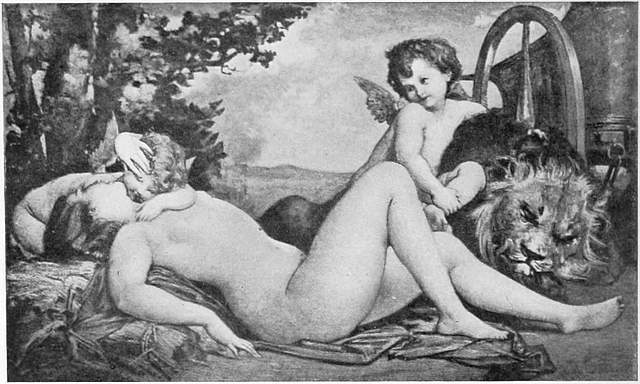 | |
| Gaz. des Beaux-Arts. | |
| BAUDRY. | CYBELE. |
| (By permission of the Marquise Arconati-Visconti, the owner of the picture.) | |
 |
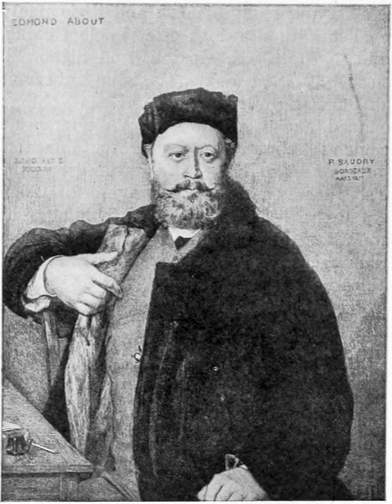 | ||
| Gaz. des Beaux-Arts. | |||
| BAUDRY. | LEDA. | BAUDRY. | EDMOND ABOUT. |
Another artist who worked with Baudry at the decoration of the Grand Opera House was Élie Delaunay, who painted in a hall leading out of the foyer three large pictures on the myths of Apollo, Orpheus, and Amphion, and was at that time less appreciated than he deserved. Delaunay was born in the same year as Baudry, and, like him, was a Breton. In their genius also they are very similar. He shared in Baudry’s admiration of the masters of the Renaissance, but his worship was less for the Cinquecento than the fourteenth century. It was in Flandrin’s studio that he prepared himself for his entry into the École des Beaux Arts. His first picture, in 1849, “Christ healing a Leper,” was, with respect to its Roman manner of conceiving form and its bronze-like firm draughtsmanship, still entirely in the style of Ingres. It was not till he went to Italy in 1856, as winner of the Prix de Rome, that he turned from the works of the Roman school to those of the early Renaissance masters, 291 to whom he was attracted by their rigorous study of form and their manly severity. His sketch books were filled with drawings after Paolo Uccello, Filippo Lippi, Pollajualo, Ghirlandajo, Botticelli, Gozzoli, and Signorelli. It was just at this time that French sculpture was making its significant revolt against the antique and in favour of Donatello, Verrocchio, and Della Robbia; that the Prix de Florence was founded, and that Paul Dubois’ “Florentine Singer” appeared. Delaunay became as a pupil of the Quattrocento masters one of the greatest draughtsmen of the century, a healthy Naturalist in the sense in which the Primitives were so, with a concise and firm power of design which only Ingres amongst modern French painters shares with him. The bodies of his nude male figures are strained in nerve and muscle like those of Donatello; they have the essential elegance and powerful rhythm of Dubois’ statues. Even the two pictures which he sent from Italy to the Salon, “The Nymph Hesperia fleeing from the Pursuit of Æsacus,” and the “Lesson on the Flute” in the Museum at Nantes, were works of great taste and sincerity, studied with respectful and patient devotion to nature, without striving after sentimental effect and without conventional reminiscences. When in 1861 he returned from Rome, he completed the frescoes in the church of St. Nicholas in Nantes, which, in their strict severity, remind one of Signorelli’s Cycle at Orvieto. In 1865 appeared in the Salon his “Plague at Rome,” which afterwards passed into the Luxembourg, and which is not devoid of tragic accent. In that collection hangs also his “Diana” of 1872, a proud nude figure drawn with firm and manly lines, and full of grave dignity, after the manner of Feuerbach. At the same time as his “Diana” he exhibited his portrait of a Mlle. Lechat, seated like one of Botticelli’s Madonnas in front of a trellis of roses—in the style of the old masters, and yet modern, naturalistic, and in excellent taste. Thenceforth he took his place among the first portrait painters of his time. There is an inexorable love of truth, a something bronze-like and stony in his pictures, finished as they are with the firm impress of medals. Instances of this may be found in his fine portrait of Mme. 292 Toulmouche, whom he has represented in a white summer costume, with black gloves, seated in the midst of cheerful landscape; and also in several male heads drawn with that firmness of modelling which Bronzino in his best days alone possessed. After the completion of the Opera paintings he finished, in 1876, twelve decorative pictures for the great hall of the Council of State in the Palais Royal. His last works, which remained unfinished, were designs for the Pantheon—scenes from the life of St. Geneviève—in which he followed in the footsteps of the great fresco colourists of Upper Italy, Gaudenzio Ferrari and Pordenone. Élie Delaunay was no original genius, and as a pupil of the painters of the Quattrocento has not enriched the history of art in any way, but he stands forth, in a time which cared for nothing but external effect, as a very loyal, serious, and honest artist, whose works all bear the stamp of a healthy, manly spirit.
Though in the works of these masters the Classicism of Ingres passes away, in part enfeebled and in part imbued with modern elements and vivified by a more direct study of nature, yet on the whole Paul Delaroche dominates this period also. Historical painting takes the highest places in the Salon, and shows itself altered only in this respect, that, instead of Delaroche’s tameness of style, we have sensational subjects, arguments which revel in scenes of horror and display of corpses. Literature had already entered upon this path. Even Mérimée in his last novel, Lokis, was clearly the forerunner of that tendency in taste which Taine characterised by the words, “Depuis dix ans une nuance de brutalité complète l’élégance.” Flaubert himself, in his Salambo, was to some extent carried away by the stream. Consider, for instance, the descriptions of Gisko crawling, a maimed, shapeless stump, out of the ditch into Matho’s tent, and of how his head is sawn off; of the tortures inflicted by the Carthaginian people upon the captured Matho; or of how the mercenaries are starved to death in the rocky valley where they were imprisoned. Vying with this tendency of literature, painting attained in its chosen themes an 293 over-excitation which reached the limits of the possible. While Delaroche had only in a very timid manner led the way to the tragedies of history, the younger artists hunted up all the most horrible deeds of blood to be found in the great Book of Martyrs of the story of man, and elaborated them on gigantic canvases. It would be quite impossible to draw up a catalogue of all the murders at that time perpetrated by French art. They might be arranged under various headings, as biblical, historical, political murders; murders in connection with robbery, and murders arising out of revenge; with subdivisions corresponding to the means employed, as poison, the dagger, the halter, broadsword and rapier, the bowstring, strangling, burning, etc. This was the time when, on account of this dominance of the “Genre féroce,” the public used to call the Salon the Morgue.
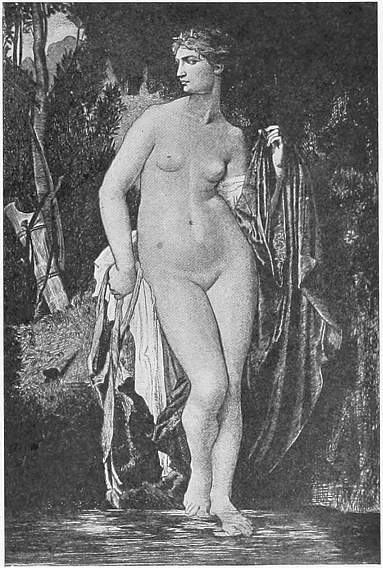 |
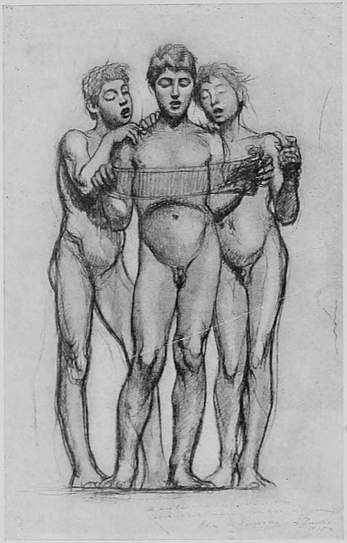 | ||
| Gaz. des Beaux-Arts. | Gaz. des Beaux-Arts. | ||
| DELAUNAY. | DIANA. | DELAUNAY. | BOYS SINGING. |
Toudouze painted the “Fall of Sodom” with a dozen copper-coloured Abyssinians, larger than life, rolling on the ground in convulsions, while Lot’s wife, dying and half-consumed by fire, gnashes her teeth as she raises the corpse of her child over her head. In a picture of George Becker’s were represented the corpses of King Saul’s sons, delivered over by David to the Gibeonites, hanging alongside of each other in a dark forest scene on a cross-shaped framework, like butcher’s meat from the shambles. Their mother stands beneath the scaffold, swinging a knotted club to protect the corpses from an antediluvian vulture. In a painting by Bréhan, Cyaxares, King of the Medes, gives a banquet, and by way of dessert has his guests the Scythian leaders massacred by his mercenaries. In one by Matthieu, Heliogabalus has hit upon a yet happier idea, for at the conclusion of the meal he sets half-starved lions and tigers upon his guests. Aimé Morot depicted in a large picture “The Wives of the Ambrones” in the battle of Aquæ Sextiæ. They are hurling themselves like a horde of furies upon the Roman horsemen who are attacking the camp. Half-naked, or entirely so, with their hair flowing behind them, they throw themselves 294 upon the Romans, catch hold of the swords by the blade, tear their eyes out, and are trampled beneath the horses’ hoofs. Especially popular were the voluptuous and cruel wild beasts from the menagerie of the Cæsars. Nero in particular suited the atmosphere of the period; his ghost haunted the novel, the stage, sculpture, and painting, and there seemed to be a general agreement to immortalise him and the morally monstrous personality of Locusta. In a picture by Sylvestre he is represented with florid cheeks, glowing with fat, and gloating over the mortal agony of a slave lying on the ground, upon whom Locusta has tested the poison intended for Britannicus. Aublet varied the same theme by making a negro lad the victim, while several corpses of negroes lying in the background suggest that the Emperor was not quite satisfied with Locusta’s first experiments. Round Nero, the more entirely to fill his magnificent Golden House, the charming shades of his congenial comrades in crime weave their flitting dances. Pelez depicted the strangling of the Emperor Commodus by the gladiator to whom the Empress had entrusted the task, and painted with tender interest the marks caused by suffusion of blood which the athlete’s hand had left upon the unhappy prince’s neck. A very familiar figure is that of Seneca, with distorted features, uttering his last words of wisdom while the blood pours from his opened veins. After the madness of the Cæsars comes the atrocious history of the Merovingian kings. Luminais, the painter of Gauls and barbarians, represented in his large picture “Les Énervés de Jumièges” the sons of King Clovis II, who, after the muscles of their knees have been destroyed by fire, are set helplessly adrift in a boat on the Seine. Then followed torture scenes from the time of the Inquisition, and saints burning at the stake. The conception which this post-Romantic generation had of the East was of cruelty and voluptuousness mixed, a thing pieced together out of white bodies, purple streams of blood, and brown backgrounds. Here, the favourite Sultana contemplates the severed head of her rival, which stares at her out of its glassy eyes; there, eunuchs are making ready to strangle a woman condemned to death. In works such as these the 295 genius, powerful in composition, of Benjamin Constant, celebrates its triumphs.
 |
| Gaz. des Beaux-Arts. |
| DELAUNAY. MADAME TOULMOUCHE. |
Yet, notwithstanding all the means of allurement furnished by such themes, these paintings almost invariably fail to produce the anticipated effect. Not that it is the brutality of the subjects that makes them unpleasant. Art in all times has busied itself with the horrible. How voluptuously does Dante depict the horrors of Hell! What imagination was ever peopled with figures more dreadful than those conceived by Shakespeare? Cruelty and death have a poetry of their own: why should Art prudishly abstain from depicting them? Only, if the result is to be a good picture, the subject must be in strict congruity with the talent employed upon it, and in the majority of these works this conformity is lacking. The subjects alone had become more savage and brutal. In the manner of treatment there is none of the wild effect which the Neapolitans of the seventeenth century gave to their scenes of martyrdom. Spirits truly wild, like Delacroix and Caravaggio, are not to be met with every day. The painters who launched out upon these bloodthirsty themes took absolutely no inward “enjoyment in tragical subjects,” but simply painted them as if after precepts learned at school. And as they were also deficient in that knowledge of nature which is acquired only by direct study of life, not one of them was in a position to give to his historical scenes that naturalistic weight which alone gives to such themes a character of convincing probability. True, these pictures compel respect on account of their unusual ability. These naked bodies, twisting themselves in the most varying postures of pain, give proof by their correct draughtsmanship of the most painstaking anatomical studies, yet after all they are nothing more than inverted Laocoöns. The Classical spirit haunts them still, and a discordant effect is produced when subjects so full of wild passion are tranquilly depicted according to cold conventional rules. Over all these figures and scenes, even the most horrible, lies the veil of a Classical embellishment, which deprives them altogether of that directness which lays hold on the imagination. The pictures are good 296 studies of costume, and make an admirable impression by their resplendent glow of colour; they are show-pieces, brilliant stage effects, as happily conceived as any of Sardou’s. But the recipe for their production is still that of the school of Delaroche: avoidance of all extremes, generalised forms, careful composition, crude lukewarmness, or the affectation of daring. Scarce one of these painters has given to his wild subject an equal wildness of treatment; not one has raised himself from the paltry level of Delaroche to the artistic height of Delacroix.
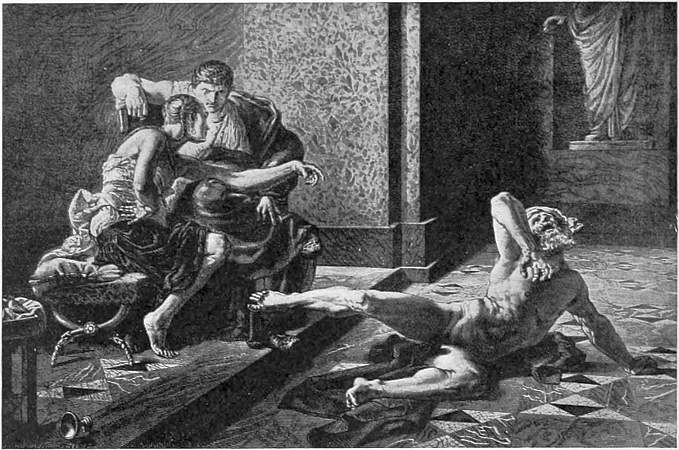 | |
| L’Art. | |
| SYLVESTRE. | LOCUSTA TESTING IN NERO’S PRESENCE POISON PREPARED FOR BRITANNICUS. |
Laurens alone, surnamed by his comrades “the Benedictine,” because his predilection was for forgotten themes from ecclesiastical history, constitutes in a certain sense an exception to the rule. He too belongs to the group of historical painters whose theory is that a picture should represent an historical fact with absolute accuracy. But he is more masculine than Delaroche. His personages are truer to nature, or, if one will, less banal; the general effect is warmer and fuller of life; he has a greater power of attracting attention. There is nothing great in his work, but there is no cold pedantry: the art of combination is more adroit, so that one is less aware of calculation, and may sometimes observe a grim earnestness. He really loves the terrible, while the others merely made use of it for the manufacture of what are nothing more than tableaux. To the Inquisition especially he was indebted for notable successes, and at times he was able to depict its dark scenes of horror in a very subtle manner. When he heaps up, in front of a church, corpses to 297 which the priests have refused burial; when he disinters popes in order to place them in the dock before their accusers; when he opens coffins to reveal the decomposed features of some erstwhile beauty, he sets even blunted nerves on the stretch; and as he has therein attained the goal he had proposed to himself, his art is not without its justification.
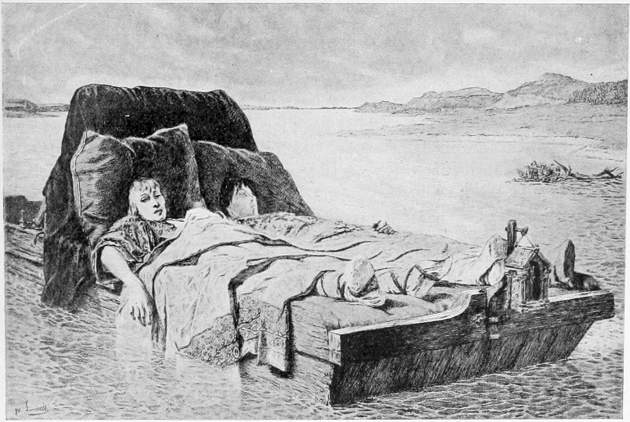 | |
| L’Art. | |
| LUMINAIS. | LES ÉNERVÉS DE JUMIÈGES. |
Among the younger generation, Rochegrosse, an artist of daring genius, appeared for a while to have taken to such themes by free choice, and not solely through the traditions of the studio. One seemed to observe in his works a truly emotional temperament flaming behind the trammels of conventionality, and was almost inclined to rank him among the spirits of storm and stress who trace their descent from Delacroix. After his first picture, in which “Vitellius” is represented dragged through the streets of Rome and ill treated by the populace, he achieved success with a scene taken from the destruction of Troy. Here “Andromache,” raging with impotent anguish, is struggling against a number of Greeks who have snatched her child from her arms to throw it down from the ramparts. This brutal strife is depicted with the highest naturalistic power. Neither the heroine nor the warriors belong to the ideal figures of the style of compromise. Andromache is of a fulness of form almost approaching corpulence, and the Greeks remind one of Indians on the warpath. Mangled corpses complete the picture, and on the bare wall to the left, over the stairs, hang dead bodies abandoned to corruption and the birds of prey. In his third picture he took for his theme the horrors of the barbarous and ferocious 298 Peasants’ War in the fourteenth century, as Mérimée had described them in his book entitled La Jacquerie; and his work is all the more effective as there lurks in the subject a certain grim modern touch which reminds one of the Social Democracy, of the insurrection of the Commune, of something which might happen even to-day. The insurgents break into the hall, where the ladies of the castle have taken refuge with their children. One alone stands erect, the grandmother in her nun-like widow’s dress, and stretches her arms behind her with a gesture of energy, as if to shield the younger ones at her back. The foremost intruder ironically takes off his cap. Another lifts up on his pike the fair-haired, bleeding head of the lord of the castle; a third has similarly transfixed his reeking heart. Others are pressing in from without, breaking the window panes with their weapons, which are yet dripping with blood. Beneath frightful figures are seen, the most horrible that of a woman standing on the window-sill, her hands propped upon her knees, gazing with insane laughter upon the mortal terror of the aristocratic ladies.
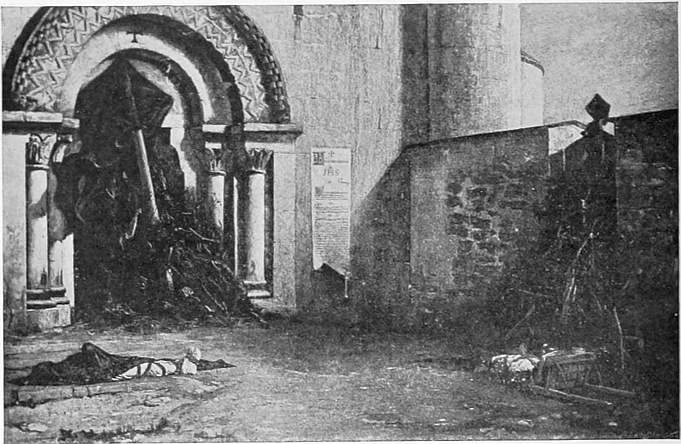 | |
| Baschet. | |
| LAURENS. | THE INTERDICT. |
In his subsequent pictures Rochegrosse did not go so far afield. His “Murder of Julius Cæsar” was a work of art in white upon white, full of crude imagination, with white walls, white reflections of light, white togas, and dark red blotches of blood. His grass-eating “Nebuchadnezzar” proved that from the sublime to the ridiculous there is often only a step. Between times he painted archæological trifles for ladies of literary culture, such as the “Battle of the Sparrows” of 1890; but in his great “Fall of Babylon” he has proved once 299 more what he can do. No doubt it is not a fine work: it is a mere decorative piece, but an astonishingly spirited performance. The scene is the palace of the Babylonian kings, the decorative construction of which the recovered monuments and the recent scientific investigations had rendered it possible to reproduce. Rochegrosse consulted with the zeal of an archæologist all the treasures of the Louvre and the British Museum,—Assyrian friezes, ornaments, and costumes,—and then set forth in these surroundings the famous banquet at which the Prophet Daniel explained the words “Mene, Tekel, Peres.” The day begins to break; in the distance the army of the Medes advancing to attack the palace has burst open the gate; Belshazzar leaves the table in terror, and takes to his weapons; the naked women, still intoxicated, stretch their limbs, or remain lazily indifferent lying on the ground; around is a dazzling confusion of mosaics, of polychrome architecture, of fantastic images of animals, of glittering tapestries shot with many hues and pleasing to the eye; of flowers, vases, fruits, pastry, and nude bodies of women. The grey light of morning strives to overcome that of the half-extinguished lamps, and rests with leaden weight upon the gigantic still-life below.
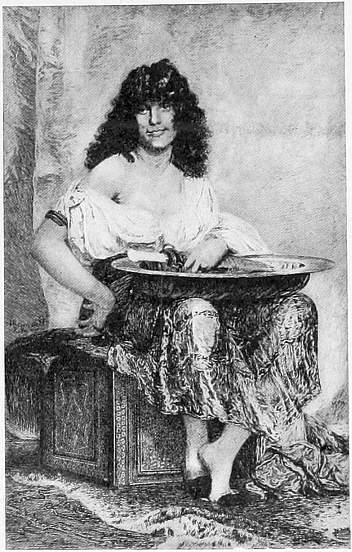 |
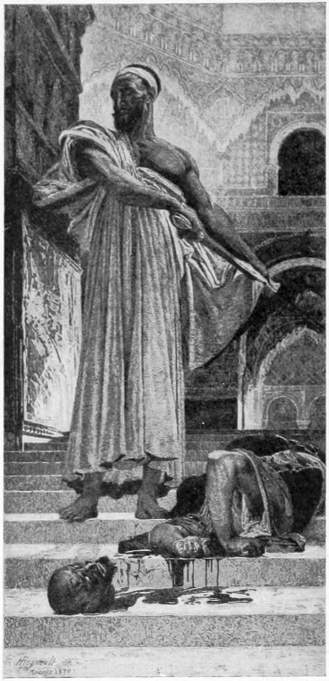 | ||
| Gaz. des Beaux-Arts. | L’Art. | ||
| REGNAULT. | SALOME. | REGNAULT. | THE MOORISH HEADSMAN. |
| (By permission of M. Georges Petit, the owner of the copyright.) | |||
If some portion of Delacroix’s wild genius appears to have descended upon Rochegrosse, yet was Henri Regnault, as a colourist, the greatest of Delacroix’s heirs—even allowing for the exaggerated renown which came to him in France, from the fact that he was the last to fall in the war of 1870. His portrait of “General Prim” of 1869, which, rejected by the sitter, came eventually to the Louvre, is somewhat reminiscent of Velasquez and Delacroix, but is nevertheless, with those of Géricault, amongst the finest equestrian portraits of the century. In his “Salome” he has depicted a black-haired girl with twitching feet, resting upon a stool after her dance, and contemplating with the cruelty of a tigress the platter which she holds ready for the head of John the Baptist, while her glowing red mouth with its dazzling teeth smiles like that of an innocent child. In her he has embodied with infernal subtlety the demon of 300 voluptuous wantonness, and has composed a symphony in yellow of seductive and dazzling charm. She is attired in transparent gold-inwoven robes, which have a caressing congruity with the resplendent texture of the background.
His “Moorish Headsman” is a symphony in red. In his pale rose-red garb the tall Moor stands in majestic dignity, wipes a few drops of blood from the blade of his sword, and glances with careless indifference—a type of the dreamy cruelty of Oriental fatalism—without anger and without pity, without hatred and without satisfaction, upon the severed head with its distorted eyes, which, rolling down a couple of steps, has stained the white marble with purple patches of blood. “I will cause the genuine Moors to rise again, at once rich and great, terrible and voluptuous,”—so the voice of Delacroix speaks out of this picture by Regnault. His paintings, like those of his master, have the effect of splendid Oriental costumes; they are shot with every hue, they lighten and glisten, they are inwoven with magnificent arabesques of gold and silver, with sparkling embroideries and precious stones. The “Orlando Furioso” of art lives once more in these fascinating harmonies, in the power, splendour, and lustre of the colouring. Just as Baudry at the close of the Classical period produced in his paintings for the Opera House the noblest work after the idealist formulæ, so Regnault in his “Salome” and his “Prim” has completed the last defiant works of the formulæ of Romanticism.
We have thought it advisable to follow this development of the art of painting down to its close, just as in treating of the older periods we have proceeded, not upon chronological principles, but upon those of historical style. Now that the old art has been followed to the grave, it will be all the easier, later on, to perceive clearly how the new arose slowly out of its invisible depths. And as France since 1830 has become the high school of art for other nations, those paths have at the same time been indicated along which the art of painting was proceeding during these years in other countries.
 | |
| HENRI REGNAULT. | GENERAL PRÍM. |

CHAPTER XIII
THE HISTORICAL SCHOOL OF PAINTING IN BELGIUM
Belgian art had gone through the same history as French art since David. When the French patriarch came to Brussels to pass the remainder of his days there in honour, he found the ground already well prepared. The Classicists had long since made their way into art, and the old Flemish tradition was dying out. Lens and Herreyns are the last colourists in the sense of the good old time, but they are associated with the good old time only through the qualities of their colouring. As a degenerate descendant of Van Dyck, Lens painted with a feeble brush sweet, insipid, sugary work for boudoirs and prie-dieu chairs; and had lost his feeling for nature to such a degree that he gave the aged the same flesh tint as children, and men the full breasts of hermaphrodites. Herreyns, appointed director of the Antwerp Academy in 1800, was more masculine; and although likewise conventional and wanting in individuality, he was none the less a painter of breadth and boldness. He was most enraptured with a model with a copper-coloured skin and knotted muscles, or with pretty and ruddy children, and fat nurses with swelling breasts. This bold worker embodied in his own person the art of a great epoch, but did nothing to renew it. These painters, indeed, only mixed for a new hash the crumbs fallen from the table at which giants had once sat. They looked backwards instead of around them, and lighted their modest little lamp at the sun of Rubens. France was the only country where art followed the great changes of culture in the age. Hence Flemish painting had been crossed with French elements long before David’s arrival. And Paris was for the artists of 1800 what Italy had been for those of 1600. They made their pilgrimage in troops to the studio of Suvée, who had originally come from Bruges, but had lived since 1771 on the Seine. There, and there only, recipes for the composition of great figure pictures were to be obtained. And thus art completed what the Empire had in a political sense begun. The artistic barriers fell as the geographical ones had done before, and the Belgian painters went back to Brussels, Antwerp, Ghent, and Bruges as men annexed by France.
David on his arrival needed only to shake the tree and the fruit fell ripe into his lap. He entered Flanders like a conqueror, and left the signs of ravage behind him on his triumphal progress. In Brussels a court gathered round him as round a banished king, and a gold medal was struck in memory of 302 his arrival. He took Flemish art in his powerful hands and crushed it. For, needless to say, he saw nothing but barbarism in the genius of Rubens, and inoculated Flemish artists with a genuine horror of their great prince of painters. He continued to teach in Brussels what he had preached in Paris, and became the father-in-law of a deadly tiresome Franco-Belgian school, to which belonged a succession of correct painters; men such as Duvivier, Ducq, Paelinck, Odevaere, and others. For the aboriginal, sturdy, energetic, and carnal Flemish art was prescribed the mathematical regularity of the antique canon. The old Flemish joyousness of colour passed into a consumptive cacophony. And then was repeated in Belgium the tragedy which Classicism had played in France. Everything became a pretext for draperies, stiff poses, sculptural groupings, and plaster heads. Phædra and Theseus, Hector and Andromache, Paris and Helen, were, as in Paris, the most popular subjects. And so great a confusion reigned, that a sculptor from whom a wolf was ordered included the history of Romulus and Remus gratuitously.
The only one whose works are still partially enjoyable is Navez. He was, like Ingres in France, the last prop of this art, chiselled, as it were, out of stone; and even after the fall of Classicism he remained in esteem, because, like Ingres, he knew how to steer a prudent course between David, the Italians, and a certain independent study of nature. A touch of realism was mingled with his mania for the Greeks; only to a limited extent did he correct “ugly” nature; he would have ventured to represent Socrates with his negro nose and Thersites with his hump, and, again, like Ingres he has left behind him enduring performances as a portrait painter. His correct, cold, and discreet talent grew warm at the touch of human personality, and his drawings, in particular, prove that he had warmth of feeling as an artist. As his biographer tells us, he seldom laid down the sketch-book in which he fixed his impressions as he talked. Every page was filled with sketches of a group, a figure, or a gesture seen in the street and rapidly dashed off, “as realistically as even Courbet could desire.” And these he transferred, when he painted in the “noble style.”
As Navez had importance as an artist, so had Matthias van Bree—Herreyns’ successor in the directorate of the Antwerp Academy—importance as a teacher. He worked in Belgium, like Gros in Paris, only in another way. While Gros as an artist was the forerunner of Romanticism, and as a teacher an orthodox Classicist, Van Bree is tedious as an artist, but as a teacher he fanned in the young generation a glowing love for old Flemish art. No one spoke of Rubens, Van Dyck, and the great art of the seventeenth century with so much warmth and understanding; and whilst with the charcoal in his hand he composed buckram cartoons, he dreamt of a youth who should arise to renew the old Flemish tradition.
Before long this young man had grown up. He had seen the artistic treasures of Antwerp and Paris. Here Rubens had delighted his eyes, and 303 there Paul Veronese. As he admired both in the Louvre, he heard behind him the voice of the young Romanticists who, like him, had an enthusiasm for colour and movement, and blasphemed the stiff, colourless old David. Gustav Wappers, also, had paid toll to Classicism, and painted in 1823 a “Regulus” after the well-known recipe. All the greater was the astonishment when, in 1830, he came forward with his “Burgomaster van der Werff”: “Burgomaster van der Werff of Leyden, at the siege of the town in 1576, offers his own body as food to the famished citizens.” The very subject could not fail to create enthusiasm in the great body of the people, excited as they were by ideas of liberty: the brilliant method of presentation did this no less. What the old Van Bree looked for, the return to the splendour of colour and sensuous fulness of life of the old masters, was achieved in this picture. In the same year, when Belgium had won her nationality and independence once more, a painter also ventured to break away from the French formulæ of Classicism, and to treat a national theme in the manner of those painters who in former centuries had been the glory of Flanders. Wappers was greeted as a national hero; his part it was to bring to an issue with the brush that good fight which others had fought with the musket and sabre. His picture was a sign of the delivery of Flemish art from the French house of bondage. Whilst older men were horrified, as the followers of the school of Delaroche were afterwards horrified at the “Stone-breakers” of Courbet, the younger generation looked up to Wappers as a Messiah. Everything in the Brussels Salon faded before the freshness of the new work; a springtide in painting seemed to be at hand, and the wintry rigidity of Classicism was warmed by a burst of sunshine, the old gods trembled and felt their Olympus quake. Gustav Wappers was held to be the leader of a new Renaissance. In him the great era of the seventeenth century was to be continued. The iridescence of silken stuffs, the whole colour and festal joyousness of the old masters, were found once more. As in France there rose the shout, “An Ingres, a Delacroix!” so there resounded in Belgium the battle-cry, “A Navez, a Wappers!” The picture was bought by King William II of Holland, and in 1832 Wappers was made Professor of the Antwerp Academy.
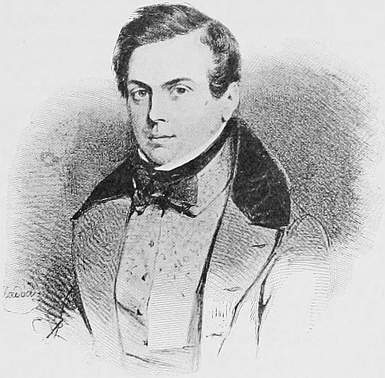 |
| Bruyllant, Brussels. |
| GUSTAV WAPPERS. |
The Exhibition of 1834 confirmed him in his new position as head of a school. This was 304 a genuine triumph, which he gained by his “Episode in the Belgian Revolution of 1830.” A scene out of the blood-stained days of the street fights in Brussels—that glorious final chapter of the struggle of the Belgian people for freedom from the French yoke—was nothing less than an event in which every one had recently taken part. At a period when so few realised how closely the great masters of the past were bound to their own time and imbibed from it their strength and nourishment, this new painter, in defiance of all theories, had drawn boldly from life. This picture was regarded as “a hymn of jubilation for what was attained and a threnody for the sacrifice it had cost.” And the neighbourhood of the church, where he had laid the action, stamped it almost as the votive picture of the Belgian people for its dead. On the right an artisan standing aloft upon a newly thrown up earthwork is reading to his attentive comrades the rejected proclamation of the Prince of Orange. On the left a reinforcement is coming up. In the foreground boys are tearing up the pavement or beating the drum; and here and there are enacted various tragical family scenes. Here a young wife with a child on her arm clings with all the strength of despair to her husband, who resists her and finally tears himself from her grasp and hurries to the barricade—the cry of love is drowned amid the clash of arms. There, supported on the knee of his grey-headed father, rests a handsome young fellow with closing eyes and the death-wound in his heart. It seems as though the Horatian dulce et decorum est might be said to wander over his features and to glorify them. For patriotism as well as for mere sentiment, here are noble scenes enough and to spare. Not only all Brussels, but all Belgium, made a pilgrimage to Wappers’ creation. Every mother beheld her lost son in the youth in the foreground whose life has been sacrificed; every artisan’s wife sought her husband, her brother, or her father amongst the figures of the fighting-men on the barricades. All the newspapers were full of praise, and a subscription was set on foot to strike a medal in commemoration of the picture. If, up to this time, Wappers had been merely praised as the renewer of Belgian art, he was now placed alongside of the greatest masters. Thiers induced him to exhibit in Paris the much discussed work, the fame of which had passed beyond the boundaries of Belgium. The “Episode” made a triumphal tour of all the great towns of Europe before it found its home in the Musée Moderne; and Wappers’ fame abroad increased yet more his celebrity in Flanders. Thanks to him, the neighbouring nations began to interest themselves in the Belgian school. All were united in admiration of “the mighty conception and the harmonious scheme of colour.” The German Morgenblatt published a study of him in 1836. Wappers counted as the leading painter of his country.
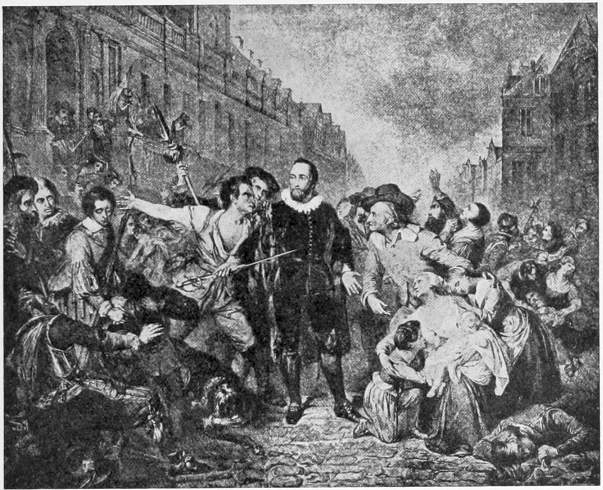 | |
| Bruyllant, Brussels. | |
| WAPPERS. | THE SACRIFICE OF BURGOMASTER VAN DER WERFF AT THE SIEGE OF LEYDEN. |
Yet the same year brought him his first rivals. His entry on the stage had given strength to a group of young painters belonging to the same courageous movement, and the Brussels Salon of 1836 concentrated their efforts. Nicaise de Keyzer made his appearance in heavy armour. As early as 1834 he had come forward with a great picture, a Crucifixion, in which he desired to compete 305 with Rubens, as it seemed, in the latter’s most special province. Yet the work merely testified to its author’s excellent memory: the majority of the heads, gestures, and draperies had been made use of in old pictures in precisely the same fashion. Consciously or not, he had copied fragments direct, and welded them together in a new composition. If, in spite of this, the name of de Keyzer already flew from mouth to mouth, he owed it to the nimbus of romance which irradiated his person. The story went that an Antwerp lady on one of her walks had seen a young man drawing in the sand, while his flock was at pasture not far off. She stepped up and offered him a pencil, and he, a new Cimabue, began forthwith to sketch a picture of the Madonna. The drawing was so beautiful (so the tale ran) that the lady would have held it a sin to allow the genius to end his days as a shepherd. He came to town, received instruction, and learned to paint. A little idyll illuminated by the amiability of a lady was quite enough to prepare a friendly reception for De Keyzer. And since he, like a tractable, modest young man, hearkened attentively to criticism, he satisfied all desires when, in 1836, he came forward with his “Battle of the Spurs at Courtrai, 1302.” In its quiet elegance the work answered to the peaceful mood which prevailed once more after the days of revolt and political insurrection. He was given special credit for clearness 306 of composition and antiquarian exactness. De Keyzer had chosen the moment when the Count of Artois was expiring on the knees of a Flemish soldier; another Fleming had his arm raised to protect his general from the approaching French. For the rest, there is a lull in the fight, though the battlefield in the background is indicated with the minuteness of an historian: none of those carnages of blood and smoke of which the world was grown once more weary, but a correct, well-disciplined battle, a skilful composition of fine gestures, helmets, cuirasses, and halberts. Even the Count’s spur, says Alvin, is drawn after the original, the only remaining spur out of seven hundred which lay scattered on the field after the day of Courtrai.
In the same year Henri Decaisne completed his “Belges Illustres.” The famous past was supposed to give its blessing to the great present. The artist, who in Paris had painted portraits with success, had been esteemed there by Lamartine, and celebrated by Alfred de Musset in a brilliant article in the Revue des Deux Mondes, now gratified a long cherished desire of the Belgian national pride when he united the heroes of the land in an ideal gathering.
Soon afterwards Gallait and Bièfve trod the stage of Belgian painting. In point of size their pictures surpassed all that that age, accustomed as it was to vast canvases, had yet witnessed. “The Abdication of Charles V” measured twenty feet; it was hung in the Salon Carré of the Louvre above Paul Veronese’s “Marriage at Cana.” An entire court of great ladies and gentlemen, clad in velvet and brocade, move in the gorgeous hall of state of a king’s castle. The solemn moment is represented when Charles V, erect and dominating the entire assembly, cedes the government of his possessions to Philip: and here is a mine of profound criticism of the philosophy of history. This old man, with one foot in the grave, whose forceful head still bears, like a Caryatid, the heavy burden of empire, embodies the splendour, fame, and might of bygone days. Faltering, he steps down from the throne, as though hesitating at the last moment whether he should appoint as his successor this son whom he both loves and fears; and, lifting to heaven his tired, sunken eyes, he commends unto God the future of the realm. Philip, the only one in the assembly entirely clothed in black, who receives the gift of dominion with an icy coldness, is transformed by the able exegesis of the critics into the satanic demon conjuring up the powers of hell. The picture even gives a glimpse into the future. For as he speaks Charles leans his left hand upon the shoulder of another young man, William of Orange. This indicates that soon the nation will wrest their independence from the double-tongued Jesuitical policy of Philip. To the left of this central group, robed in velvet and silk, stand the ladies around Margaret, the sister of the Emperor; she, in the garb of a nun, sits in her chair as in a prie-dieu. To the right, near the throne, are pages and priests, and amidst them Egmont and Horn, standing aloof and silent, look upon the scene. “The Abdication” had a grand success. It confirmed the hopes which had been set on Gallait ever since the completion of his “Tasso,” and it was proudly ranked amongst those works which did 307 special honour to the young nation. Wappers saw himself eclipsed, and Louis Gallait took the lead.
 | |
| WAPPERS. | THE DEATH OF COLUMBUS. |
Edouard de Bièfve’s “Treaty of the Nobles” formed the historical supplement to this work; after the triumph of the kingdom came the triumph of the people. The picture represents the signing of the defensive league, against the Inquisition and other breaches of privilege, which the nobility of the Netherlands entered into in 1566, in the Castle of Cuylenburg, near Brussels; it was hailed by the Berliner Staatszeitung as “a landmark in the chronicle of historical painting.”
This heroic era of Belgian painting was brought to a close in 1848 by Ernest Slingeneyer, who, as early as 1842, obtained a brilliant success with his “Sinking of the French Battleship Le Vengeur.” His “Battle of Lepanto” was the last great historical picture, and the entire vocabulary of admiration known to art criticism was showered upon it by the Brussels press.
Even a new period of religious painting seemed about to dawn. German art, up to that time little regarded in Belgium, had since the fifties been discussed with considerable detail in the journals, and such names as Overbeck, W. Schadow, Veit, Cornelius, and Kaulbach had speedily acquired a favourable 308 reputation. An exhibition of German cartoons instituted in Brussels in 1862 served—strangely enough—to sustain this high appreciation. The young nation believed that it could not afford to lag behind France and Germany, and commissioned two Antwerp painters, Guffens and Swerts, who had early made themselves familiar with the technique of fresco, to found a Belgian school of monumental painting. To this end they entered into a correspondence with the German artists, and, after long studies in Italy and Germany, adorned with frescoes the Church of Notre Dame in St. Nicolas in East Flanders, St. George’s Church in Antwerp, the town halls of Courtrai and Ypres, a few churches in England, and the Cathedral of Prague; and on these frescoes Herman Riegel, in 1883, published a book in two volumes.
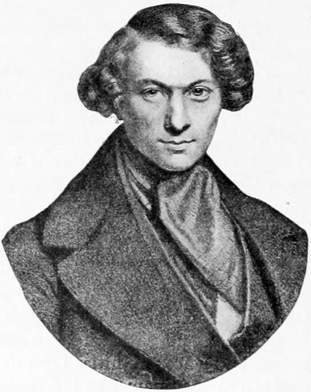 |
| Bruyllant, Brussels. |
| DE KEYZER. |
At the present day this religious fresco painting, which handed on the doctrine of the German Nazarenes—the doctrine that nothing remained to the nineteenth-century artist except to imitate the old Italians as well as he could—can no longer command such exhaustive disquisition. And not it alone: the whole “Belgian artistic revival of 1830” appears in a somewhat dubious light. After the disconsolate wilderness of Classicism this period marked an advance. Every Salon brought some new name to light. The State had contributed a big budget for art, and extended its protecting hand over the “great painting” which was the glory of the young nation. What could not be got into the Musée Moderne, founded in 1845, was divided amongst the churches and provincial museums. The number of painters and exhibitions increased very noticeably. Beside the great triennial exhibitions in Brussels, Antwerp, and Ghent, there were others in the smaller towns, such as Mons and Mechlin. The Belgian painters of 1830 appear, no doubt, as great men, when one considers to what a depth art had sunk before their advent. Wappers especially widened the horizon, by breaking the formula of Classicism and renewing the tradition of the brilliant colourists of the seventeenth century. De Bièfve, De Keyzer, Slingeneyer, severally contributed to the Belgian Renaissance. The old Flemish race knew itself once more in this fond quest of beautiful and radiant colouring. The historical painting had even a certain actual interest. Standing so near to the glorious September days when the country won its independence, the painters wished to draw a parallel between the glorious present and the great past, and to waken patriotic memories by the apotheosis of popular heroes. 309 And yet the Musée Moderne of Brussels is not one of those collections in which one willingly lingers. The works in the old museum, hard by, have remained fresh and living and in touch with us; those in the new gallery seem to be divided from us by centuries. For the mischief with pictures which do not remain for ever young is precisely this—they grow old so very soon. Posterity speaks the language of cold criticism; and those powers must be great which are even favoured with a verdict. The luxuriant wreaths of laurel which fall upon the living are no guarantee of enduring fame, while in the crowns awarded after death every leaf is numbered. In how few of these once lauded works there dwells the power to speak in an intelligible language to a generation which tests them, not for their patriotism, but for their intrinsic art. The Belgian school of 1830 has left behind it the trace of respectable industry, but a supreme work is what it has not brought forth.
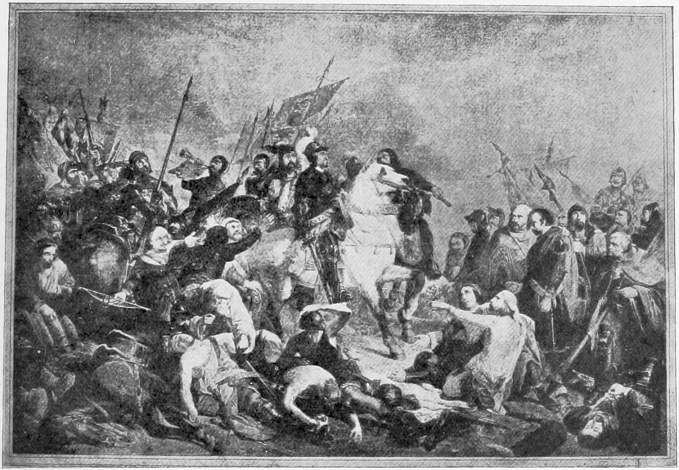 | |
| Bruyllant, Brussels. | |
| DE KEYZER. | THE BATTLE OF WOERINGEN. |
How hard it is to see anything epoch-making in Wappers’ “Van der Werff.” How theatrically the figures are posturing, how improbable is the composition, and what an unwholesome dose of sentimentality is to be found in that burgomaster, who is offering himself as a prey to the multitude! The heads are those of troubadours. And these jerkins brought fresh out of the wardrobe, these neatly ironed white ruffles, all this rich velvet and glittering pomp, how little it resembles the torn rags of a half-starved people after a nine months’ 310 siege! His revolutionary picture of 1834 is an unfortunate transposition into a sentimental key of the “Freedom on the Barricades” by Delacroix. Here also are play-actors rather than men and women of the people. This old man who is kissing the banner, the wife who winds her arms about her husband as Venus does about Tannhäuser, the pale girl who has fallen in a faint, the warrior who, with his eyes turned up to Heaven, is breaking his sword—these are figures out of a melodrama, not revolutionaries storming the barricades, nor famishing artisans fighting for their very existence. And the thin, spick-and-span colouring is in just as striking a contrast with the forceful action of the scene. An idyll could not be carried out with more prettiness of manner than is this picture which represents the rising of a people. The artisans are as white as alabaster. A light rouge rests upon the cheeks of the women, as when Boucher paints the faltering of virtue. And afterwards Wappers’ course went further and further down hill. Only in these two early works, in which he responded to a political movement by an artistic endeavour, does he seem, in a certain sense, individual and powerful. All the others are stereotyped productions which, having nothing to do with the Belgian national movement, have all the more to do with the Parisian École du bon sens. Even his “Christ in the Grave,” painted in 1833, and now in St. Michael’s Church at Louvain, with its artificial grace and pietistical sentimentality, might have been painted by Ary Scheffer. The pathetic scenes from English and French history of the sixteenth and seventeenth centuries which followed this merely reflect that painting of historical anecdote which was invented by Delaroche. Agnes Sorel and Charles VII, Abelard and Eloise, Charles I taking leave of his children, Anne Bullen’s parting from Elizabeth, Peter the Great presenting to his ministers the model of a Dutch ship, Columbus in prison, Boccaccio reading the Decameron to Joanna of Naples, the brothers De Witt before their execution, André Chénier in the prison of Saint-Lazare, Louis XVII at Simon the shoe-maker’s, the poet Camoens as a beggar, Charles I going to the scaffold—all are subjects treated by others before him in France, and neither in their conception nor their technique have they anything original. In the last-mentioned picture, exhibited in Antwerp in 1870, he attained the limit of sugary affectation: a young girl has sunk on her knees, and, with dreamily uplifted eyes, offers to the Stuart King who is going to his death—a rose! Wappers is merely a reflex of French Romanticism, although he cannot be brought into direct comparison with any Parisian master. The passion of Delacroix stirred him but little: nothing points to a relationship between him and that great spirit. One is rather reminded of Alfred Johannot, whom he resembles in his entire gamut of emotion as in his treatment and selection of subjects. In both may be found elegance of line, Byronic emphasis, histrionic gestures, and the same stage properties borrowed from the theatre; never the genuine movement of feeling, only empty and distorted grimaces.
Of the others who appeared with him the same may be said. All Belgian matadors of the forties and fifties came to grief, and are interesting in the 311 history of art only as symptomatic phenomena, as members of that school of Delaroche which encompassed the world. They abandoned the antique marble, the chlamys, and the leaden forms of the Classicists, to set in their place a motley picture of the Middle Ages, made up of cuirasses, mail-shirts, fleshings, and velvet and silken doublets. One convention followed the other, and pedantic dryness was replaced by melancholy sentimentalism. As skilled practitioners they understood the sleights of their art, but never rose to individual creation. Amongst many painters there was not a single artist.
As regards De Keyzer, it seems as if throughout his whole life he had wished to remain true to the memory of his benefactress: a simpering feminine trait runs with enervating sweetness through all his works, even through that “Battle of the Spurs” which founded his reputation. According to old writers, the athletic bodies of the Flemings were the terror of the French chivalry at Courtrai. De Keyzer has made of them mere plaster figures, and the pale, meagre colouring is in keeping with the languid conception. In the battles of Woeringen, of Senef, and Nieuwpoort, which followed on this picture, and were executed for the Belgian and Dutch Government, he succeeded still less in overcoming his affectation; and he first found the fitting province for his mild and correct talent when in later years he began to render little anecdotes of the Emperor Maximilian or Justus Lipsius out of the studio of Rubens or Memlinc. For these there was need of little but a certain superficial play of colour and an elegant painting of textures.
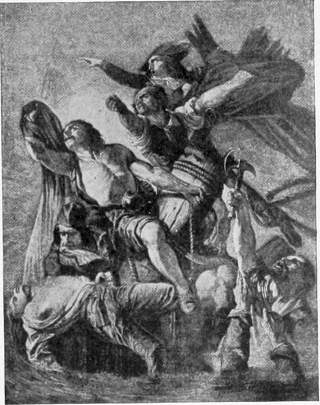 |
 | ||
| Bruyllant, Brussels. | Bruyllant, Brussels. | ||
| SLINGENEYER. | THE AVENGER. | LOUIS GALLAIT. | |
Ernest Slingeneyer is stronger and more masculine. Yet what an unrefreshing chaos of blue, red, saffron, and citron-yellow is that “Sea-fight at Lepanto”! Slingeneyer felt that the chiaroscuro with which Wappers saturated his “Episode” was not in keeping with this action under open sky. But rightly as he felt this, he had not the strength to solve the problem of open-air painting. What a barbaric effect these red, brown, and yellow bodies make in their motley theatrical pomp! How the composition of the picture savours of apotheosis! As for his later work, his thirteen gigantic pictures, “gloires de la Belgique,” in the great hall of the Brussels Academy, like De Keyzer’s mural paintings above the staircase of the Antwerp Museum, they would never have 312 been painted had they not had Delaroche’s hemicycle as their forerunner.
And Gallait’s “Abdication of Charles V”—one fails to understand how it was possible that so much able disquisition was suggested by this picture. How slight a smattering of the erudition of a stage manager is necessary for the representation of such a scene: the throne on one side; before it the lords and gentlemen in a semicircle, to the left front the ladies to make a fine effect for the eye, and in the background balconies with curious spectators, to widen out the spectacle. It is all pure theatre; an icy ceremony with prettily got up supernumeraries. All the heads have the discreditable appearance of family portraits painted after death, and then washed over with a faint conventional tinge of red. The whole thing is like a huge piece of still-life, which an adroit painter has put together out of a mixture of heads, gold, jewels, mantles, and perukes. Delaroche seems to have contributed the composition, Devéria the sumptuous costumery; and as for the colouring, Isabey, with his sunbeams shimmering in gold and silver, may not improbably have had something to do with that. What was spontaneous in Wappers is replaced in Gallait by cold calculation. Once and once only did this correct and frigid painter give evidence of a certain dramatic vein; it was when in 1851 he painted “The Brussels Guild of Marksmen paying the Last Honours to Egmont and Horn.” With a brutal audacity the decapitated heads are set to their bodies. Bloodless and livid, with clotted and tangled beards, they both really look as if they had been studied direct from nature. But the rest of the picture, the surrounding of theatrical attractions, parade costumes, and false pathos, is all the less in keeping with this study of death. How Zurbaran or Caravaggio would have treated the theme! They would have veiled the unessential figures in darkness, and irradiated the heads only with a trenchant light. What Gallait has made of it is the final tableau of an opera of costume. The two sergeants of Alva who are on guard, and the men who are showing their reverence, tread the stage like bad actors, scrupulously arrayed and making pathetic gestures. Their action has been studied from drawing-school copies; no genuine cry of passion ever breaks through. Heads, hands, and outlines have all a sickly idealism; a studious and sedulously polished manner of painting has ruined the intrinsic spirit of the work as a whole. Théophile Gautier was right when he wrote of Gallait: “Tout le talent 313 qu’on peut acquérir avec du travail, du goût, du jugememt, et de la volonté, M. Gallait le possède.” Gallait’s “Last Obsequies,” hung in that same Salon of 1850 which contained Courbet’s “Stone-breakers,” and the words of recognition accorded to it, were the last obsequies given to the parting genius of historical painting. A few years went by, and Gallait’s fame died away. After 1851 he painted fourteen other great historical pictures (“Egmont’s Last Moments,” “Johanna the Mad by the Corpse of her Husband,” “Alva at the Window during the Execution of the two Counts,” etc.), and, occasionally, sentimental genre pictures, such as “The Oblivion of Sorrow” in the Berlin National Gallery; in this a small boy is playing the fiddle for the consolation of his sister, who had sunk upon the high-road exhausted by hunger. He also painted many portraits. But nothing gave him a niche in the memory of his contemporaries. “The Pest at Tournai,” painted in 1882, was a work extremely creditable to his old age; it was nevertheless a picture which appeared to another generation merely as a phantom; and when, on 20th November 1887, the announcement of his death passed through the land, it came unexpectedly, like that of a person already believed to have been long dead.
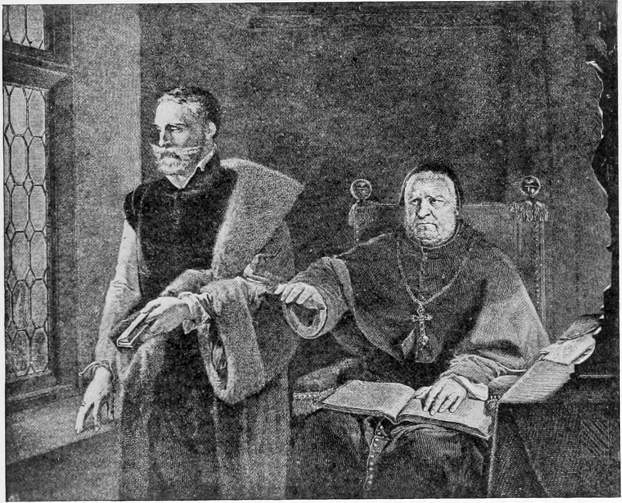 | |
| Bruyllant, Brussels. | |
| GALLAIT. | EGMONT’S LAST MOMENTS. |
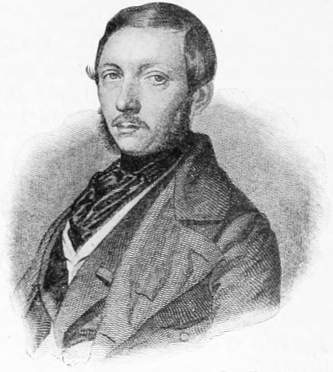 |
| Bruyllant, Brussels. |
| EDOUARD BIÈFVE. |
Finally, Edouard de Bièfve, who in 1842 shared Gallait’s triumph in Germany, 314 and was afterwards named in the same breath with him, is the man who marks the complete corruption of this tendency. If the sturdy Wappers, the emasculate De Keyzer, and the eclectic Gallait tricked out their pathetic heroes with noble heads like that of the Antinous, and offered their contemporaries an adroit theatrical art, a parade, and a hollow pathos, the incapable Bièfve never got beyond the painting of tableaux vivants laboriously presented. Terrible and of Shakespearian impressiveness is the scene in which the half-famished Ugolino hurls himself upon his son in an appalling ecstasy of frenzy, a curse against God and man upon his lips. Upon the canvas, six metres wide, which Bièfve in 1836 devoted to this theme, there is represented an old gentleman, who, though certainly a little pale, contrives to maintain in perfection the punctilious bearing of a cavalier, and in the midst of his fasting cure has picturesquely draped round his shoulders an ermine mantle, as if he had been asked out to dinner. Before him stands a young man, possessing that graceful outline beloved of Paul Delaroche. Devéria, Ary Scheffer, and Johannot were better painters of such monumental illustrations of the classics. As yet the shivering art of Belgium had learnt only to warm itself at the Parisian fireside. Even Bièfve’s “League of the Nobles of the Netherlands,” despite its national subject-matter, was no more than a lucky hit, which he owed to his long residence in Paris. And how tiresomely is the scene played out! One would wish to catch the mutterings of insurrection from these men who personify the Belgian people; but Bièfve’s picture is restful and dignified. Egmont and Horn, the lions of the occasion, are conducting themselves like honest citizens who are bored at a party. Seated in his chair, the handsome Egmont thinks merely of showing his fine profile to the ladies in the gallery, and Horn, who steps towards the table to make his signature, does it with the elegance of a lover inscribing verses in a young lady’s album. Three brothers with clasped hands swear the well-known oath to die together.
It is a little irony in the history of art that in 1842 these two same pictures set all Germany in tumult, and diverted the whole stream of painting into a new course. But how was it possible that the German painters stood before them as if struck by lightning? It must be remembered that for a whole generation Germany had seen nothing but coloured cartoons, and that the enthusiasm for Franco-Belgian art had been so prepared that the least touch was enough to set it in flames.
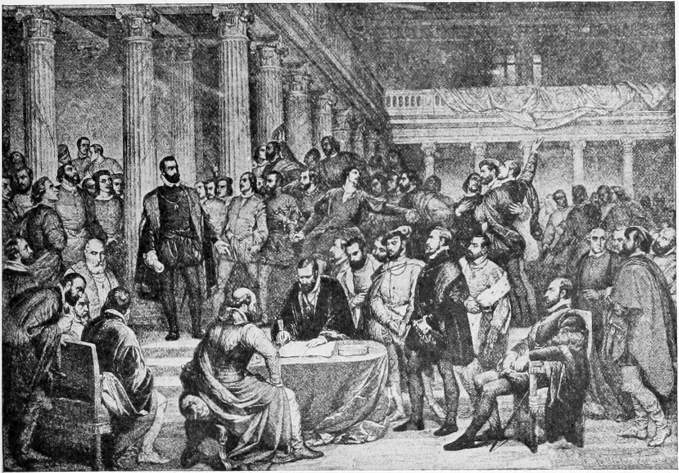 | |
| Bruyllant, Brussels. | |
| BIÈFVE. | THE LEAGUE OF THE NOBLES OF THE NETHERLANDS. |
Since the wars of liberation Germany had been very reserved in her attitude towards the French. Until the year 1842 original works of the French and Belgian school had never been hung in any German exhibition. But in spite of this, a high, even enthusiastic, appreciation of French and Belgian painting was being spread, especially amongst the younger generation. Even in engravings and lithographs after French pictures it was believed that qualities of colour were discoverable which were wanting in German painting. Heine and other authors, who had wandered to Paris, “the lofty tower of Freedom,” to escape from the depressing condition of German affairs, had done what in them lay for the dissemination of this cult. The rising generation of the forties had been driven by Heine’s notices of the Salon into an almost hostile attitude towards the dominant art schools of Germany, the schools of Düsseldorf and Munich. The stylists on the Isar and the sentimental elegiac painters on the Rhine met with the same antipathy from the younger generation. The appearance of the two Belgian historical pictures, which were really nothing more than offshoots of the great French school, gave nourishment of doubled strength to this tendency to seek salvation in Paris. The German painters were startled out of contentment with their beloved cartoons, and to many a man it seemed as if the scales had fallen from his eyes. They perceived what an admirable thing it is that a painter should be able to paint. What they could have learnt long before from any good old picture, and in their 316 turbulent enthusiasm for ideas had not learnt, was made suddenly clear to them by these new paintings. They came to the conclusion that it was impossible for God Almighty to have poured light and colour over the objective world with the intention that painters should transform it into a world of shadowless contours. They recognised that the style of cartoon work had led away from all painting, and that it was therefore necessary to do honour once more to the despised handiwork and technique of art, as the fundamental condition of its well-being. However much the æsthetic party might warn them not to renounce “the Reformation of painting, which had been begun and perfected forty years before,” and not “with modern technique to sink back into the pre-Cornelian, ornamental model painting,” the demand for colour, which had been so long neglected, asserted its rights more and more loudly. King Ludwig’s saying was repeated as though it were a new revelation: “The painter must be able to paint.” Colour was the battle-cry of the day, the battle-cry of youth, to whom the world belongs. In place of the ideal of contour came the ideal of hue and pigment. Cartoons, in the sense of the old cartoon school, no one would draw any longer. To paint pictures, finished pictures, was the tendency of the day. And since painting is to be learnt from the living only, and such as could paint lived in Germany no longer, they packed their trunks, and set out to learn from the “go-ahead neighbour.” As Rome had been hitherto, so was Paris now, the high school of German art. “To Paris!” and “Painting!” were the cries throughout all Germany.

CHAPTER XIV
THE REVOLUTION OF THE GERMAN COLOURISTS
From 1842 dates the pilgrimage of the German artists to Paris, Antwerp, and Brussels. In Delaroche, Cogniet, and Couture, in Wappers and Gallait, they believed they could discover the secrets of art which were hidden from German teachers. The history of art can scarcely offer another example of such a sudden overthrow of dogmas hitherto dominant by dogmas directly opposed to them. During the first half of the century the painters of Germany were pious men, humorous, witty, and intelligent men; they had a sharply cut profile, and so enchained the multitude by their human qualities that nobody remarked how little they understood of their craft, or that they were too superior to learn to draw correctly, held colour unchaste, and made virtues of all their failings. The next generation was condemned to learn painting during the whole of its natural life. The former were “problematic natures”: beings who united with a Titanic force of will an actual achievement which is hardly worth mentioning; who regarded the mere handicraft of art as beneath their dignity; who, in their revelations to mankind, were resolved to burden their spirit as little as possible with any sensuous expression of their genius, and, above all, meant not to degrade themselves by the manual labour of learning to paint, and thereby wasting their valuable time. The latter were not ashamed of painting. By devoting themselves with vehemence to the colouring and technique of oil-painting, they accomplished the necessary revolution against the abstract idealism of the school of Cornelius. In their opulence of ideas the draughtsmen of cartoons had made a notch in the history of art by casting the technical tradition overboard. To have reinstated this as far as they could, with the aid of the French, is the peculiar merit of the generation of 1850. “Règle générale: si vous rencontrez un bon peintre allemamd, vous pouvez le complimenter en français.” So runs the motto—not complimentary to Germany, but quite unassailable—which Edmond About prefixed to his notices on the Paris Universal Exhibition of 1855.
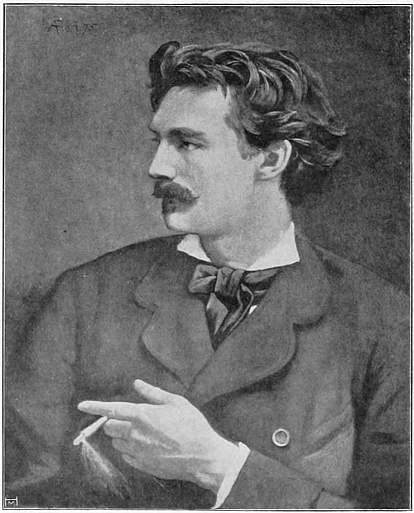 |
| Hanfstängl. |
| ANSELM FEUERBACH. PORTRAIT OF HIMSELF. |
Anselm Feuerbach was the first distinguished German artist who made the journey to Paris with a proper knowledge of the necessity of this step. In Germany he was the greatest representative of that Classicism of which the principal master in France was Ingres, and the continuator Thomas Couture. And he succeeded in accomplishing that which the German Classicists of the beginning of the century strove after in vain. Whilst they contented themselves 318 with suggestions and an indeterminate symbolisation of poetical ideas after the Greek writers, German Classicism achieved in Feuerbach’s “Symposium of Plato” a great, noble, and faultless work, which will live. He moved upon classic ground more naturally and freely and with more of the Hellenic spirit than even the French. For the classic genius was begotten in him, and not inoculated from without. In the Vermächtniss the son calls his father’s book the prophetic seal of his own original being. He inherited the classic spirit from the enthusiastic scholar, the subtile author of the Vatican Apollo, to whom the genius of Greece had so fully and completely revealed itself.
A remarkable nature: philologer and dreamer, German and Greek, one who rejoiced in beauty and in the life of the senses, and whose proud muse strayed through life solitary and with leaden weights upon her feet,—such was Anselm Feuerbach, and by that division of his being he was ruined. Equipped with a superior education, an appearance of singular nobility, and with proud family traditions, he emerged like a shining meteor in Düsseldorf, when he began his career at the age of sixteen, brilliant, precocious, and already a favourite amongst women. This was in 1845. He ran through all the schools in Germany, Belgium, and France. In regard to the living, he believed himself to be indebted to the French alone, and eagerly claimed the merit of having been the first to seek them out. But it was in Italy that he had passed through his novitiate as an artist. A glorious hour it must have been when Feuerbach, full-blooded and dedicated to the worship of beauty, entered Venice in 1855, in company with that cheerful and convivial poet Victor Scheffel. In the town of the lagoons, whither he had come on a commission from the Court of Karlsruhe to copy the Assumption of Titian, Feuerbach made the second determining step of his life. The third he made when his stipendium was withdrawn, and, full of youthful confidence in his luck and his good star, he undertook his journey to Rome.
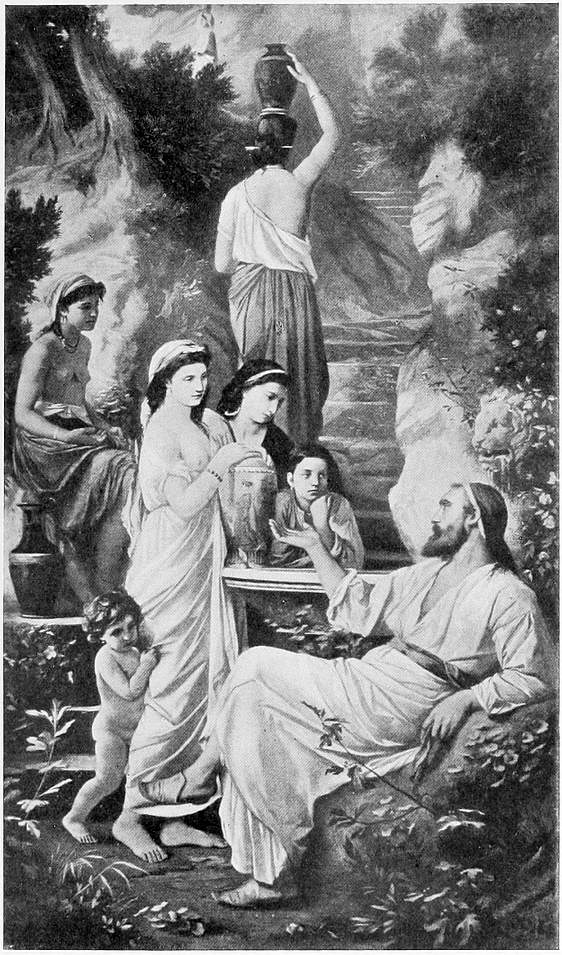 | |
| Albert, Munich. | |
| FEUERBACH. | HAFIZ AT THE WELL. |
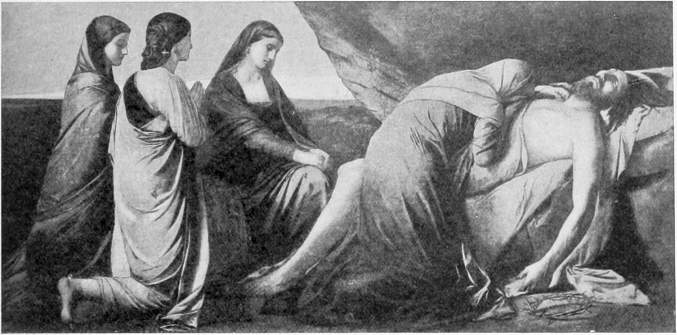 | |
| Albert, Munich. | |
| FEUERBACH. | PIETA. |
He was handsome, small, and refined, and rather pale and spare—of that delicacy which in highly bred families is found in the last heirs with whom the race dies out—and he had dark locks which clustered wildly round his head. The moulding of his features was feminine, and his complexion southern; his eyes, shadowed by long lashes, were brown, sometimes fiery, sometimes sad and earnest, and his glance was swift. He loved to sing Italian songs to the guitar in his fine, deep voice, and Boecklin and Reinhold Begas would join in.
The impressions he received in Italy were formative of his life. For he learnt to understand the divine simplicity and noble dignity of antique art better than Couture was capable of understanding them; and he achieved a simple amplitude to which the French Classicism had never risen.
From his first works, to which the Düsseldorf egg-shell is still sticking, down to the “Symposium of Plato”—what a route it is, and through what phases he passes. “Hafiz at the Well,” surrounded by voluptuous, half-naked girls, painted at Paris in 1852, was his first eminent achievement. In subject it is a late fruit from Daumer’s study of Hafiz: as a work of art it is one of the most genuine products of the school of Couture. No other German artist has surrendered himself so entirely to the French. With a large brush, never losing sight of the complete effect, Feuerbach has painted his canvas, almost for the sake of showing that he has assimilated everything that was to be learnt in Paris. The same influence preponderates in the “Death of Pietro Aretino,” done in 1854. But, side by side with the Parisian master, the later Venetians have an unmistakable share in this work. The capacity 322 to grasp things in a monumental largeness is already announced. Evidently Feuerbach has studied Paul Veronese, and realised how high he stands above the French painters. At the same time he has examined the other Venetians for their technique, and discovered something which has appealed to him in Bordone’s colouring. But “Dante walking with high-born Ladies of Ravenna,” finished at Rome in 1857, was the ripest fruit of his Venetian impressions. In sunny warmth of colour, fine golden tone, and quiet simplicity of pictorial treatment, no modern has come so near to Palma and Bordone. And in “Dante’s Death,” of 1858, there predominates a still greater depth and golden glow, a grave and devout beauty.
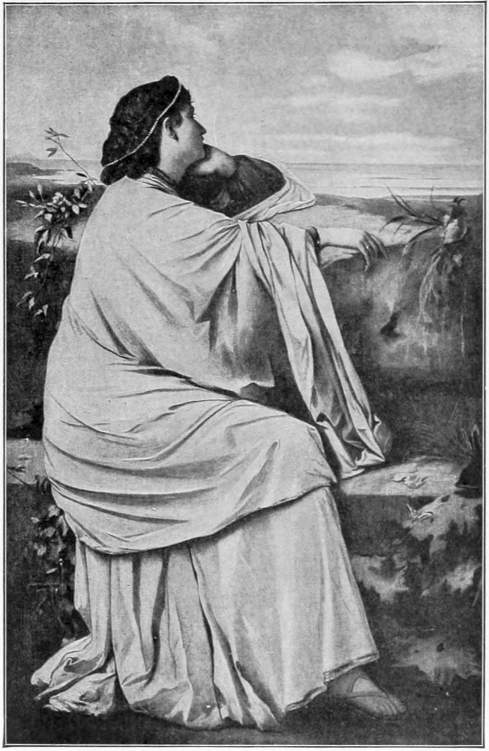 | |
| Seemann, Leipzig. | |
| FEUERBACH. | IPHIGENIA. |
In the following works, however, Feuerbach, with a conscious purpose, denies himself the quality to which the Dante pictures owe a principal part of their powerful effect: the mild glow, the sunny beaming of colour. He confines himself to a cool scheme of tone, reduced to grey, almost to the point of colourlessness; to a glimmer of leaden blue, a moonlight pallor. At the same time he has concentrated the whole life of his figures in their inward being, whilst every movement has been taken from their limbs. Even the expression of spiritual emotion in the eyes and features has been subdued in the extreme. The “Pietà,” both the “Iphigenias,” 323 and the “Symposium of Plato” are the world-renowned proofs of the height of classic inspiration which he touched in Italy. Measure, nobility, unsought and perfected loftiness characterise the “Pietà,” that mother of the Saviour who bows herself in silent agony over the body of her Divine Son, and those three kneeling women, whose silent grief is of such thrilling power, precisely because of its emotionlessness. For “Iphigenia” Feuerbach has given of his best. She is in both examples—the first of 1862, the second of 1871—a figure sublime beyond human measure, grand like the figure of the Greek tragedy. But the “Symposium of Plato” will always assert its high value as one of the finest pictorial creations of an imagination nourished on the great art of the ancients, and filled brimful with the splendour of the antique world. There is nothing in it superfluous, nothing accidental. The noblest simplicity of speech, a Greek rhythm in all gradations, the beautiful lines of bas-relief, decisive colour and stringent form—that is the groundwork of Feuerbach’s art. And through it there speaks a spirit preoccupied with greatness and heroism. Thus he created his “Medea” in the Munich Pinakothek, that picture of magnificent, sombre melancholy that affects one like a monologue from a Sophoclean tragedy. Thus he painted his “Battle of the Amazons,” one of the few “nude” pictures of the century which possesses the perfectly unconcerned and unsexual nudity of the antique. Italy had set him free from all the insincere and calculated methods which had deformed French art since Delaroche; it had set him free from all theatrical sentiment, by which he had accustomed himself to understand everything that was forced in costume, pigment, pose and movement, light and scenery. In the place of the ordinary treatment from the model, with its set gestures and grimaces, he gave an expression of form which was great, simple, and plastic. His study seems to have been an incessant exercise of the eye, to see and to hold fast to the essential, to the great lines of nature as of the human body.
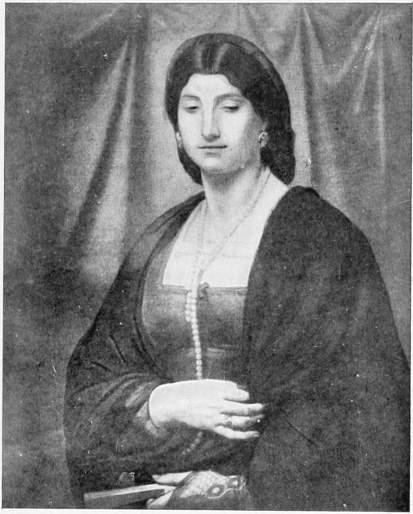 |
| Albert, Munich. |
| FEUERBACH. PORTRAIT OF A ROMAN LADY. |
In the full possession of these powers, which he acquired amid the elementary simplicity and heroic majesty of Roman landscape by constant intercourse with the great painters of the past, he determined in the summer of 1873 to accept an invitation from the Vienna Academy. His friends rejoiced. At last this worker, who had been abandoned in a foreign land, seemed to have found in his native country a place which offered him a new life. He was but little more than forty: yet all was so soon to be over. From Rome he came to the restless capital which had just lived through the birththroes of a new epoch; from the side of Michael Angelo to the side of Makart! The sketches for a series on the wars of the Titans, which he began after his arrival, promised the greatest things. They display a sureness and majesty which find no parallel in the German art of those years. But they were destined never to be completed.
Feeling himself, like Antæus, strong only on Roman soil, he lost his power in Vienna. Reserved, innately delicate, a mystical, ideal nature like that of Faust, and one which only with reluctance permitted to a stranger a glimpse of its inner being; in his life, as in his art, high-bred and simple, hating both as painter and as man everything overstrained or sentimental; in his judgment harsh, severe, and uncompromising, lonely and proud, he was but little adapted to make friends for himself. The indifference with which his study for the “Fall of the Titans” was received in the Vienna Exhibition wounded him mortally. Vienna, which is so much disposed to laughter, laughed. Criticism was rough and unfavourable. He left Vienna and went to Venice. The tragical fate of a party of voyagers, drowned as they were playing and singing together on a night journey to the Lido, gave him the motive for his last picture, “The Concert,” which was found unfinished after his death, and came into the possession of the Berlin National Gallery. On 4th January 1882 he died, alone in a Venetian hotel.
| “Hier ruht Anselm Feuerbach, Der im Leben manches malte, Fern vom Vaterlande, ach, Das ihn immer schlecht bezahlte.” |
So runs the epitaph which he made for himself. And posterity might alter it into—
| “Hier ruht ein deutscher Maler, Bekannt im deutschen Land; Nennt man die besten Namen, Wird auch der seine genannt.” |
However, one must not go too far. In familiar conversation Feuerbach once said of himself that when the history of art in the nineteenth century came to be written, mention would be made of him as of a meteor. So isolated, and so much out of connection with the artistic striving of his contemporaries, did he believe himself to be, that he held himself justified in saying: “Believe me, after fifty years my pictures will possess tongues, and 325 tell the world what I was and what I meant.” In truth, he owes his resurrection less to his pictures than to the Vermächtniss. A book has opened the eyes of Germany to Feuerbach’s greatness, and since that time the worship of Feuerbach has gone almost into extremes. Throughout his lifetime—like almost every great artist who has died before old age—he was handled by the Press without much comprehension. The critics blamed his grey tones, the connoisseurs complained of his unpatriotic subjects or missed the presence of anecdote. His admirers were the refined, quiet people who do not praise at the top of their voices. He never met with recognition, and that poisoned his life. It is generous of posterity to make up for the want of contemporary appreciation. But when he is set up as a pioneer, whose work pointed out the art of the future, the judgment becomes one which a later posterity will subscribe to only with hesitation.
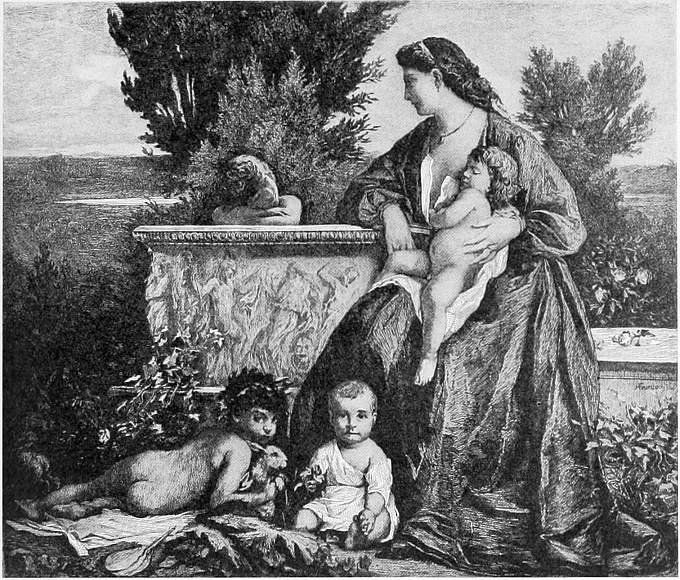 | |
| FEUERBACH. | MOTHER’S JOY. |
Feuerbach presents a problem for psychological rather than artistic analysis. Whoever has read the Vermächtniss feels the personal element in these works, sees in them the confessions of a proud, unsatisfied, and suffering 326 soul, and in their author no son of the Renaissance born out of due season, but a modern who has been agitated through and through by the décadent fever. In his book Feuerbach appears as one of the first who felt to his inmost fibre all the intellectual and spiritual contradictions which are bred by the nineteenth century, and who cherished them even with a sort of tenderness, as contributing to a high and more subtilised condition of soul. He was one of the first who, in the same way as Bourget and Verlaine, studied moral pathology under the microscope, and who, with a tired soul and worn-out feelings, sought for the last refinement of simplicity. And this weary resignations seems also to speak from his pictures. Not one of the old painters has this modern melancholy, this air of dejection which hovers over his works. Even the ladies round Dante are filled with that sadness which comes over youth on the evenings of sultry summer days, when it is struck by a presentiment of the transitoriness of earthly things. It is as if these figures would all some day or other vanish into the cloister, or, like Iphigenia, sit lonely upon the shore of a sea, whither no ship should ever come to release them. And it is certainly not by chance that Iphigenia had such a hold upon the artist; he repeatedly set himself to render her figure afresh, and, later, Medea steps beside her as the impersonation of the still more intense sense of desertion which filled the artist’s spirit. The woman of Colchis, who sits shivering on the shore of the sea, chilled through and through by the consciousness of her abandonment; the daughter of Agamemnon, who in spirit is seeking the land of the Greeks, with the boundless sea spreading wide and grey before her, like her own yearning,—both are images of the lonely Feuerbach, who, like Hölderlin, the Werther of Greece, flies to a dreamy Hellas as to a happy shore, to find peace for his sick spirit. His “Symposium of Plato” has not that exuberant sensuousness, that mixture of esprit and voluptuousness, of temperance and intemperance, which marks the Athenian life under Pericles; nor has it the Olympian blitheness with which Raphael would have executed the subject. A breath of monkish asceticism is over every joy, subduing it. These Greeks have tasted of the pains which Christianity brought into the world. Or take his “Judgment of Paris” in Hamburg. Nude women life-size, Loves, southern landscape, gay raiment, golden vessels, brilliant ornament, beauty—those are the elements of the picture; and how little have such words the power to render the impression! But Feuerbach’s three goddesses have an uneasiness, as if each one of them knew beforehand that she would not receive the apple; Paris is sitting just as cheerlessly there. And by borrowing his loves from Boucher, Feuerbach has shown the more sharply the opposition between the Hellenic legend which he interprets and the funereal mien with which he does it. The blitheness of the antique spirit is tempered by the sadness of the modern mind. He tells these old myths as never a Greek and never a master of the Renaissance would have told them. Olympus is filled with mist, with the colouring of the North, with the melancholy of a later and more neurotic age, the moods of 327 which are for that very reason more rich in nuances—an age which is at once graver and more disturbed by problems than was the old Hellas. Feuerbach’s pictures are octaves in the language of Tasso, but of a repining lyrical mood which Tasso would not have given them. The brightest sunshine laughed over the Greece of the Renaissance; over that of Feuerbach there rests a rainy, overcast November mood. Even works of his like the “Children on the Sea-shore” and the “Idyll” reveal a pained and suffering conception of nature, that tender and subdued spirit that Burne-Jones has; it is as if these blossoms of humanity were there to waste away in buds that never come to fruition, as if it were no longer possible to breathe into creation the true joyousness of youth. Even the five girls, making music out of doors, in the picture “In Spring,” look like young widows, putting the whole tenderness of their souls into elegiac complaints for their lost husbands.
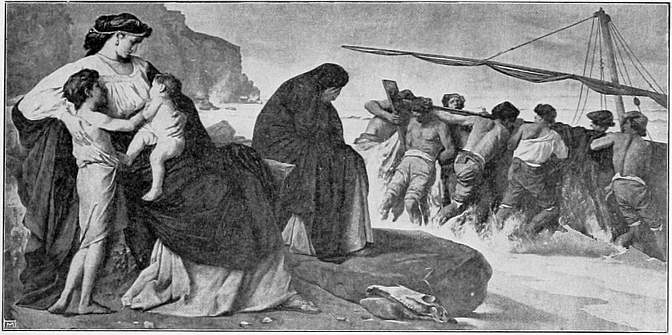 | |
| Hanfstängl. | |
| FEUERBACH. | MEDEA. |
To this resigned and mournful expression must be added the uncomfortable motionlessness of his figures. They do not speak, and do not laugh, and do not cry; they know no passions and sorrows which express themselves by the straining of the limbs. Everything bears the impress of sublime peace, of that same peace by which the works of Gustave Moreau, Puvis de Chavannes, and Burne-Jones are to be distinguished from the ecstatic and sentimental tirades of the Romanticists. In Feuerbach’s works this is the stamp of his own nature. The antique beauty becomes shrouded in a mysterious veil; and life is illuminated as by a mournful light, which rests over bygone worlds. What heart-rending keenness is often in the effect of the melancholy tinge of these subdued bluish tones! That colour is the genuine expression of the temperament reveals itself clearly enough in Feuerbach. When he began his career, his head full of ideals and his heart full of hopes, his pictures exulted in a Venetian splendour, in full and luxuriant golden harmonies; as “joy after 328 joy was shipwrecked in the stream of time” they became leaden, sullen, and corpse-like. As Frans Hals in his last days, when his fellow-creatures allowed him only the bare necessities of life, accorded to the figures in his pictures only so much colour as would give them the appearance of living human beings; as Rembrandt’s magical golden tone changed in the sad days of his bankruptcy into a sullen, monotonous brown, so a deep sadness broods over the pictures of Feuerbach,—something that savours of memory and remorse, the mournful atmosphere and dark mood of evening which the bat loves. Even as a colourist he has the melancholy lassitude of the end of the century.
That is what distinguishes him from his contemporaries. The other idealists of those years painted their pictures without hesitation and with the facility of a professor of calligraphy; they remembered, arranged their reminiscences, and rubbed their hands with self-complacency when they came near their model. They did not yet feel the throb of the nineteenth century, and impersonality was their note. Feuerbach, the neurotic brooder, was a personality. After a long mortification, the human spirit, the living, suffering, human spirit, celebrated its renaissance in his works. Under its influence the jejune painting of prettiness practised by others was changed to modern pessimism and sorrowful resignation. The more he gave way to these moods the more modern he became, the more he was Feuerbach and the further he departed from the works of art which were regarded by his contemporaries and himself as eternal exemplars. He has been reproached with oddities and strange eccentricities. The critics reminded him how far he departed from the lines of his models; indignantly they asked him why he, the pale, delicate, sick, neurotic, and overstrained man, the uncertain, faltering, and tortured spirit, did not paint like the blithe, improvising Raphael, like the jubilant and convivial Veronese, like the sensuous, exuberant Rubens. And Feuerbach himself becomes perplexed. Like Gros in France, he is conscious both of his strength and his weakness. He does not stand sovereign above the old painters, like Boecklin and those other idealists of the present. He runs through life in ever fresh astonishment at the novelty which is revealed to him in the works of earlier centuries. The nerves of this latter day vibrate, the blood of the nineteenth century throbs in him—yet he has the wish to imitate. The history of every one of his works is a fight, a desperate struggle, between the individuality of the artist, his own inward feeling, and the “absolute Beauty” which hovered beyond him cold and unpliable.
In his first drawings he begins boldly; one knows his hand and says: “Only Feuerbach can have done that.” And then one is able to trace, step by step, and from sketch to sketch, what pains he takes that the finished picture may be as little of a Feuerbach as possible. The personal and individual element in the drawings is lost, what is Feuerbachian in the composition, the personal contribution of the artist, is effaced, and finally there is produced in the picture the marvellous look of having been painted by a genuine old Venetian as a ghost. And Feuerbach felt the dissonance. He feels that he fully 329 expresses himself no more, and also that he does not reach the level of the old masters. He adds borrowed, conventional figure, like the Boucher Cupids in the “Judgment of Paris”—figures against which every fibre of his being revolts—just to arrive at an outward resemblance to the old pictures, an impression of exultation and joyousness and the spirit of the Renaissance. And when he stands opposite his work he seems to himself like a gravedigger in a harlequin’s jacket. He scrutinises himself in despair, and one day comes to feel that his power of production is exhausted. Splendid and unapproachable, from the walls of the galleries, the art of the classic masters stares him in the face; and he enters into a dramatic life-and-death struggle with it. He will not be Feuerbach, and cannot become a Classic. The curtain falls and the tragedy is over. Such destinies have been before in the world, no doubt; but in our time they have multiplied, and seem so much the sadder because they never come to the average man, but only to great and peculiarly gifted natures.
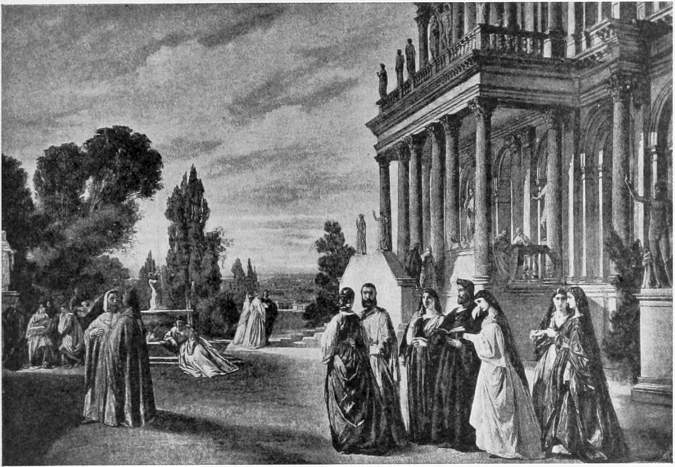 | |
| Albert, Munich. | |
| FEUERBACH. | DANTE WALKING WITH HIGH-BORN LADIES OF RAVENNA. |
These matters—a silent historical sermon—one reads, with the help of the Vermächtniss, out of Feuerbach’s works. There “his pictures possess tongues”; there comes out of them a sound like the cry of a human heart; the whole tragedy of his career becomes present—what he succeeded in doing and what remained unapproachable. Yet later generations, which will judge him no longer psychologically, but only as an artist, generations with which he no 330 longer stands in touch through his ethical greatness, will they also feel this in the presence of his finished pictures? To them will he be pioneer or imitator, forerunner or continuator? Will he take his place by Boecklin and Watts, or by Couture and Ingres? It is perhaps a happy chance that in the history of art one sometimes stumbles upon personalities that mock at all chemical analysis. Feuerbach, at any rate, is a great figure in the German art of these years. His is a high-bred, aristocratic art, free from any illustrative undertone, and from loud and motley colour. It is true that his figures also pose, but never clumsily or without expression, never theatrically. At a time when declamation was universal he did not declaim, at least he never did so with a forced pathos; and it is principally this which gives him a very high and special place amongst the German painters of the transitional period. He is always simple, grave, majestic. Everything that he does has style, and that makes him so peculiar in an art which is so often petty.
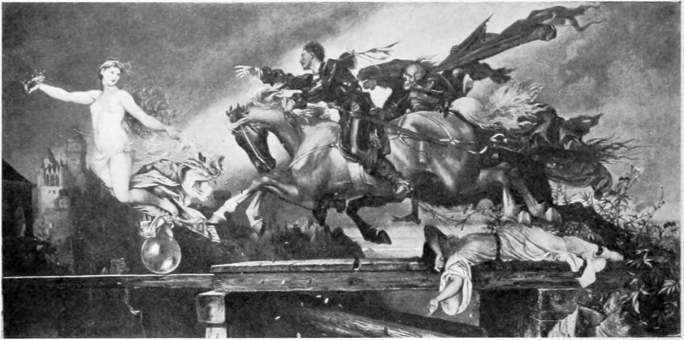 | |
| HENNEBERG. | THE RACE FOR FORTUNE. |
| (By permission of the Berlin Photographic Co., the owners of the copyright.) | |
But a different judgment is formed when one compares him with the French and the old masters. A meteor Feuerbach was not; for he stood on the ground of the Couture school, and raised himself later to yet greater simplicity, going back to purer sources, to the Venetians and the Romans. He is more austere and manly than Couture, but he is, as he stands in his finished pictures, a Roman of the Cinquecento, who has been in Venice; not an original genius of the nineteenth century, like Boecklin. Boecklin paints the antique figures in their eternal fulness and youth; but he is quite modern in sentiment and in his highly developed technique. Feuerbach in regard to technique stands now on French soil, now on Venetian or Roman; and in his sentiment he is an imitator of the Cinquecentists, or, if you will, a phenomenon of atavism. His writings and drawings show him concerned with the present, his paintings with the past. 331 The modern temperament, artistically restrained, breaks out no more, the nerves have no rôle, no human sound is forced from his figures. He learnt through the spectacles of the great old masters to look away from everything petty in life, but he never laid those spectacles down. This modern man, who was so neurotic as a writer, sought as a painter, for the sake of the ideal, to have no nerves at all. Before many of his pictures one wishes for a fire; they make an effect so cold that one shivers. The quality in them which calls for boundless admiration is his splendid artistic earnestness. There speaks out of them a sacred peace. Yet, when he is set up as a pioneer, it must never be forgotten that he is not self-sufficient as, shall we say, Millet, but has attained his majesty of conception only in the leading-strings of masterpieces of a great period, and precisely in the leading-strings of those masterpieces from the numbing influence of which modern art was forced to set itself free, before it could come to the consciousness of itself.
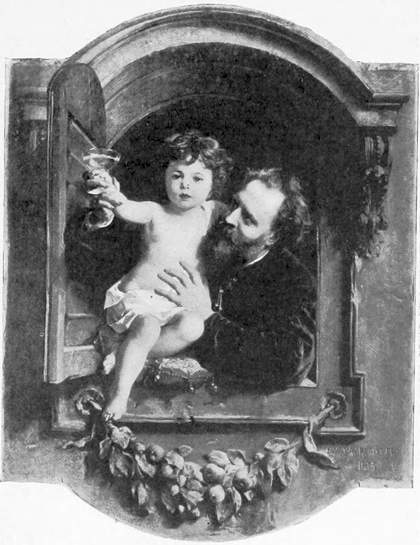 |
| GUSTAV RICHTER. PORTRAIT OF HIMSELF. |
Together with Feuerbach—and having, like him, previously received enlightenment as to colouring at the Antwerp Academy—Victor Müller, of Frankfort, had gone to Couture in 1849. He resided until 1858 on the banks of the Seine, and was especially influenced by Delacroix, and perhaps also a little affected by Courbet. At least his “Wood Nymph”—a voluptuous woman lying in a wood—which first made him known in Germany in 1863, seems but little removed from the healthy realism and exuberant vigour of the master of Ornans. Otherwise, like Delacroix, he has occupied himself almost exclusively with Shakespeare. “Hamlet at the Grave of Yorick,” “Ophelia,” “Romeo and Juliet,” “Hero and Leander,” were pictures of a deep, sonorous glow of colour; the characters in them were seized with great intellectual concentration, and the surrounding landscape filled with that sombre poetry of nature which in the hands of Delacroix so mystically heightens the 332 impression of human tragedies. Victor Müller was of a bold, uncompromising talent, full of southern glow and wild Romanticism; a powerful, forcible realist, who never sought the empty, sentimental, ideal beauty known to his age. In a period dominated almost from end to end by a jejune and rounded beauty, he gives pleasure by a healthy, refreshing “ugliness.” All the heads in his pictures were painted after nature with a religious devoutness; painted by a man who openly loved the youthful works of Riberas and Caravaggio. And just as surprising is the power of expression, the deep and earnest sentiment, which he attained in gestures and physiognomy. While Makart, in his balcony scene from Romeo and Juliet, never got away from a hollow, theatrical affectation, Müller’s picture glows throughout with a sensuous passion that saps the blood. A new Delacroix seemed to have been born; an extraordinary talent seemed to be rising above the horizon of our art, but Germany had to follow to the grave her greatest offshoot of Romanticism before he had spoken a decisive word, just as she lost Rethel, the greatest son of the cartoon era, in the flower of his age.
Of the others who made the pilgrimage to Paris with Feuerbach and Müller, not one has a similar importance as an artist. Their merit was that they made themselves comparatively able masters of technique, and taught the new gospel when they returned to Germany. To their superiority in technique and colour, given them by a sound French schooling, they owed their brilliant success in the fifties. They were, at the time, the best German painters, and great at a time when ability was novel and infrequent. As soon as it became customary and commonplace, there remained little to raise them above the average.
 |
| RICHTER. A GIPSY. |
That is true of the entire Berlin school of the fifties and sixties. The most independent of the many artists who journeyed from the Spree to the Seine is, probably, Rudolf Henneberg, who died young. His technique he owed to Couture, in whose studio he worked from 1851, and his subject-matter to the German classical authors. Born a Brunswicker, he felt himself specially attracted by his countryman Bürger, and became a Northern ballad painter with French technique. Movement, animation, wildness, and a certain romantic eeriness, proper to the Northern ballad—these are Henneberg’s prominent features, as they are Bürger’s. His pictures have a bold caprice and a peculiarly powerful and sombre poetry. The hunting party storm past irresistibly, like a whirlwind, in his “Wild Hunt,” the 333 illustration to Bürger’s ballad, which in 1856 won him the gold medal in Paris.
| “Und hinterher bei Knall and Klang Der Tross mit Hund und Ross und Mann.” |
A Düsseldorfian Romanticism, from the Wolf’s Glen, is united to Couture’s nobleness of colouring in his “Criminal from Lost Honour,” of 1860. And a part—even if only a small one—of the spirit which created Dürer’s “The Knight, Death, and the Devil” lives in his masterpiece “The Race for Fortune,” a picture breathed on by the spirit of sombre, mediæval Romanticism, which made his name the most honoured in the Exhibition of 1868.
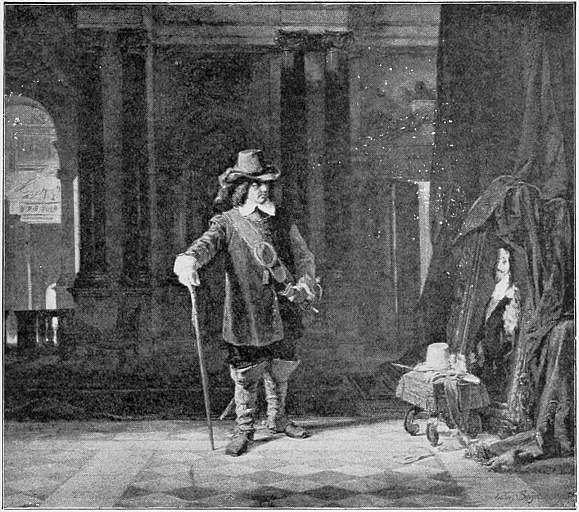 | |
| SCHRADER. | CROMWELL AT WHITEHALL. |
The negation of power, an almost feminine painter of no distinctive character, a new edition of Winterhalter, was Gustav Richter. His popularity is connected with the fisher-boys and odalisques, the reproduction of which every sempstress at one time used to wear on her brooch, while in printed colours they added splendour to all the bonbon and handkerchief boxes. The accomplished workmanship and sparkling treatment of material which he acquired in Paris made him in 1860, after Eduard Magnus had made his exit, the most famous painter of feminine beauty. A pleasure-loving man of the world, elegant in appearance, fame, honour, and distinction were 334 showered upon him, and he became the shining spoilt darling of society, the central point of an extensive and animated convivial intercourse. His works were carried out in a style which, at that time, had not been learnt in Berlin, and had an air of Court life which was held to be exceedingly fashionable. It was later that the banal emptiness and insipid taste of his toilette portraits first became obvious, and that their everlastingly sweet and doll-like smirk, and their kind and winning eyes, always the same, began to grow tiresome. In all his life-size chromolithographs there is a distinction of build and appearance, which in the originals was perhaps to have been desired, although the originals unquestionably looked like something that was more human and individual. In riper years, after the happiness of family life had been given him, he executed works which assure his name a certain endurance; this he did in some of his family portraits,—for instance, in those of his boys and his wife. To this last period belongs the ideal portrait of the Baroness Ziegler as Queen Louisa, which became such a popular picture in Prussia. But Richter’s “great” compositions, which once charmed the visitors at exhibitions, are now forgotten. In “Jairus’s Daughter”—admired in 1856 as a fine performance in colouring—what strikes one now that its colouring has long been surpassed is the inadequacy and theatricality of its characterisation, the outward show, and the banality of this handsome young man who performs his miracle with a declamatory pose. The “Building of the Pyramids,” painted for the Maximilianeum in Munich, with its swarming crowd of dark-coloured people, and the royal pair come to inspect with an endless train, is a gigantic ethnographical picture-sheet, which did not repay the expenditure of twelve long years of work.
In Paris Otto Knille learnt to approach huge canvas and wall spaces with fearlessness, and by executing the many monumental commissions which fell to his share in Prussia, he put this French talent to usury in a manner which was as blameless as it was uninteresting. Some good paintings by Julius Schrader, such as the historical pictures with which his fame is associated, have remained fresh for a longer period. The “Death of Leonardo da Vinci,” as well as the “Surrender of Calais to Edward III,” “Wallenstein and Seni at their Astrological Studies,” “The Dying Milton,” and “Charles I parting from his Children,” are only a collection of what the Parisian studios had transmitted to him. Delaroche and the illustrative and theatrical painting of history, having gone the rounds in Belgium, in the next decade demanded their sacrifice in Germany.
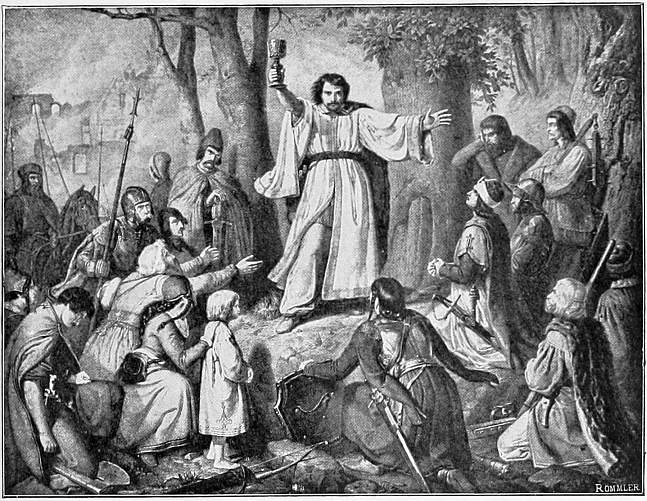 | |
| Seemann, Leipzig. | |
| LESSING. | THE HUSSITE SERMON. |
Here also similar political and literary conditions were prescribed. A backward people, uncontent with itself, pined for deeds and glory. Through the presentment of the great dramas of the past the spirit of the present was to be quickened, as a relaxed body by massage. Here also the knowledge of history levelled the ground for painting, as it did in France. While, in the imagination of the Romanticists, different ages melted dreamily into each other, and the Hohenstauffen period, because of its tender melancholy 335 character, gave the keynote for all German history, the scientific writing of history had, since the thirties, entered as a power into literature. Schlosser began his Universal-historische Uebersicht der Geschichte der alten Welt, which swelled to nine volumes, and represented with a completeness hitherto unapproached the civilisation of antiquity. His history of the eighteenth century was a still greater departure, for, after the example of Voltaire, he included manners, science, and literature in his account of political events. On the uncompromising subjectivity of Schlosser followed the scientific objectivity of Ranke, who, a master of the criticism of sources, delineated with delicate, silver-point portraits the Papacy after the Reformation, the French Court, the policy of the princes of the age of the Reformation, Cromwell, and the heroes of the rising power of Prussia. Luden, Giesebrecht, Leo, Hurter, Dahlmann, Gervinus, and many others began their great labours. German painting, like French, sought to take advantage of the results of these scientific investigations; and Schnaase was the first who, in the Kunstblatt in 1834, described historical painting as the pressing demand of the age, and the cultivation of the historical sense in such a disconsolate epoch as a “truly religious necessity.” Soon afterwards Vischer began to preach historical painting as a new gospel. History, he says, is the revelation of God. His 336 Being is revealed in it as much as in the sacred writings of religion. Historical painting is therefore the completion and full exemplification of those principles which, five centuries back, in Giotto, led to the movement of the new Christian painting. It is called forth by the development of all forms of life and knowledge, and is the last and highest step which sacred painting is able to reach: it is the final completion of sacred painting itself. “Who represents the Holy Ghost with more dignity? He who paints Him as a dove upon a sheaf of sunbeams, or he who places before me a great and lofty man, a Luther or a Huss in the flame of divine enthusiasm?”
Something of the sort had been in the mind of Strauss when he advocated the worship of genius as a substitute for religion. The infidel idealistic painting and satire had been followed by a religious art which evaporated in Nazareanism; pure history in boots and spurs was next preached as a religion. “We stand,” says Hotho in his history of German and Netherlandish painting, “with our knowledge, culture, and insight, on a summit from which we overlook the whole past. The Orient, Greece and Rome, the Middle Ages, the Reformation, and modern times, with their religion, literature, and art, their deeds and their life, spread like a universal panorama before us; and it is one that we must grasp with a universal feeling for the distinctiveness of every people, of every epoch, and of every character. In this fashion to bury one’s self in the past, to get at the most essential meaning of its life by knowledge, to awaken what is dead, and by art to renew what is vanished, and thus to elevate the present to the level of the still living, kindred Mnemosyne of the past, such is the vivifying work of our time; and to that work its best powers must be devoted.”
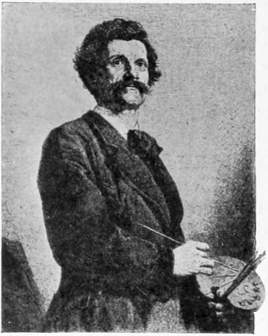 |
| CARL PILOTY. |
The first who worked with these principles in Germany was Lessing. He was a great landscape painter, and a clever and amiable man, whose house in Karlsruhe was for many years a meeting-place for the polite world, and every beginner, every young man of talent, visited it to seek protection. During the winter of 1832-33 Menzel’s Geschichte der Deutschen fell into his hands. In it he read the story of Huss and the Hussites, and with “The Hussite Sermon” he soon afterwards began the sequence of pictures which had as their theme the battle between Church and State, the struggle of the Popes with the Emperors, the conflict between binding tradition and free personal conviction—a sequence to be viewed in connection with the opposition between authority and freedom which had actually arisen through Strauss’ Life of Jesus. “Huss before the Council,” “Huss on his Way to the Stake,” “The Burning of the Papal Ban,” were found on their appearance exceedingly seasonable by the orthodox, Protestant side. For people were determined to see in them, at one time, the protests of a Protestant against the Catholic art tendencies of the Nazarenes, at another, biting epigrams on the Catholic and pietistic bias, ruling in Prussia under Friedrich Wilhelm IV. They are of historical interest in so far as Lessing, before the period of French influence, anticipated in them the path on which the German historical painting—whose centre through Piloty came to be Munich—moved in the following years.
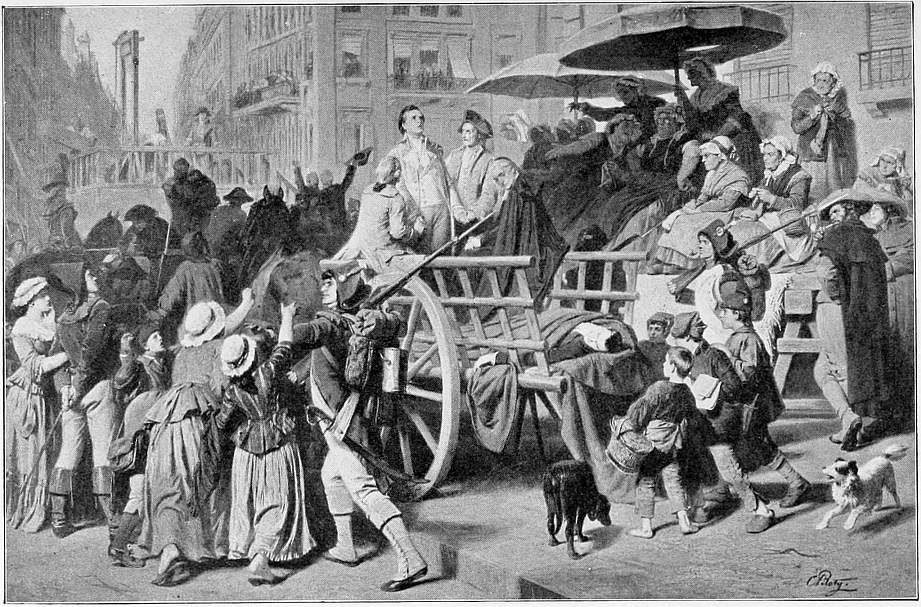 | |
| PILOTY. | GIRONDISTS ON THE ROAD TO THE GUILLOTINE. |
| (By permission of the Berlin Photographic Co., owners of the copyright.) | |
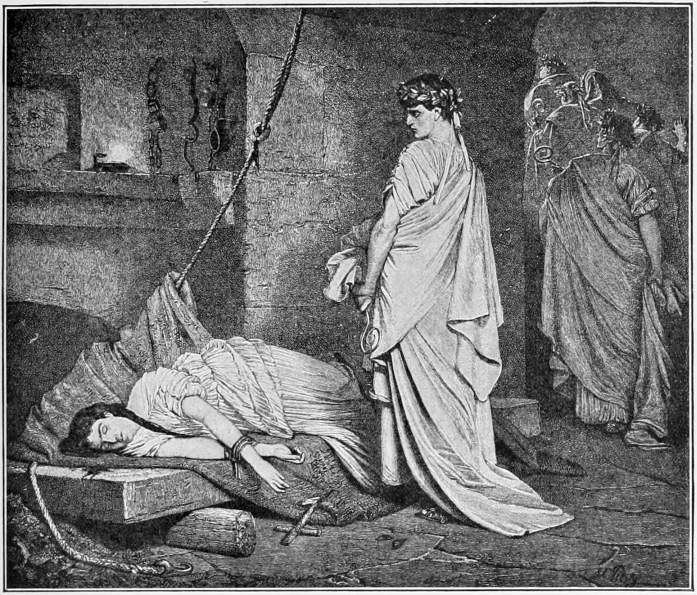 | |
| Seemann, Leipzig. | |
| PILOTY. | UNDER THE ARENA. |
Piloty’s glory is to have planted the banner of colour on the citadel of the idealistic cartoon drawers. True, it was only the discarded fleshings of Delaroche; but since he possessed, side by side with a solid ability, pedagogic capacities of the first rank, and thus brought to German art, in his own person, all the qualities which it had wanted during half a century, his appearance was none the less most important in its consequences. Even to-day, beside Kaulbach’s “Jerusalem” and Schnorr’s “Deluge” in the new Pinakothek, his “Seni” is indicative of the beginning of a new period. Before him the most 340 celebrated men of the Munich school made a boast of not being able to paint, and looked down upon the “colourers” with a contemptuous shrug; so here everything was attained which the young generation had admired in Gallait and Bièfve. This astounding revelation of colour was in 1855 praised in Germany as something unheard of and absolutely perfect. There was no more of the petty, motley, bodyless painting which had hitherto been dominant. The manner in which the grey of morning falls upon the murdered man in the eerie chamber, the way the clothes and the silken curtains glimmer, were things which enchanted artists, whilst the lay public philosophised with the thoughtful Seni over the greatness of heroes and the destiny of the world. At one bound Piloty took rank as the first German “painter”; he was the future, and he became the leader to whom young Munich looked up with wonder. Before him no one had known how to paint a head, a hand, or a boot in such a way. No one could do so much, and by virtue of this technical strength he founded such a school as Munich had never yet seen. The consequence of his advent was that the town could soon boast of many painters who thoroughly understood their business. What an academical professor can give his pupils (thorough groundwork in drawing and colour), that the young generation received from Piloty, who at his death might have said with more right than Cornelius: “We have left a better art than we found.” He who discovered and guided so many men of talent, left behind him when he died a well-drilled generation of painters; and far beyond the boundaries of Munich they assure him the honourable title of a preceptor of Germany. The Munich movement does not offer the example of passionate and embittered battles, like those which the Parisian Romanticists maintained against the Classicists of the school of David. The guard did not die, but surrendered, and retired into an otium cum dignitate. Without a contest the ground was left to the new generation, which was united by no bond of tradition with that which had just been driven from the field; it was left to an unphilosophic, unpoetic generation, whose only endeavour was to bind together the threads of technical art which had been torn by unalterable circumstances.
This revolution was accomplished with almost unnatural swiftness. In the lifetime of Cornelius himself the Franco-Belgian dogma of colour reached its end and summit in Makart, with whom colour is an elementary power, overflowing and levelling everything with the might of absolutism. In the same year that Cornelius died “The Pest in Florence” made its tour through the world. Already Schwind and Steinle, those two children of Vienna, had separated themselves from the thoughtful stringency of form and plastic clearness of their German comrades, by a certain coloured and lyrically musical element in their work. And now also it was an Austrian who again habituated the colour-blind eyes of the Germans to the splendour of pigment. Michael Angelo’s expression of form, as it had been imitated by Cornelius, was opposed by the colour-symphonies of the Venetians: drapery and jewels, brocade and velvet, and the voluptuous forms of women.
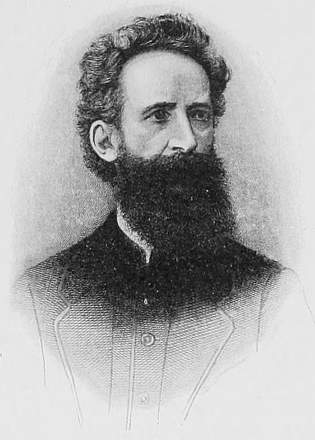 |
| HANS MAKART. |
Hans Makart was a genius most picturesque in his mode of life. Whether this life was enacted in his studio, fitted up like a ballroom, in the Ring-Strasse, converted into a stage, or upon his canvas, everything was transformed for him into decoration gleaming with colour. And through this delight in colour the most important impulses were given in the most diverse provinces of life. Against the dowdy lack of taste and the harsh gaiety of ladies’ fashions in that era he set his distinguished costume pictures, carried out in iridescent satin tones; and the enterprising modistes translated them into fact. The Makart hat, the Makart roses, the Makart bouquet—very old-fashioned, no doubt, at the present time—were disseminated over the world. Under the influence of Makart the whole province of the more artistic trades was regarded from a pictorial point of view. Oriental carpets, heavy silken stuffs, Japanese vases, weapons and inlaid furniture, became henceforth the principal elements of decoration. The fashionable world surrounded itself with brilliant colours; papers were supplemented by portières and Gobelins, ceilings were painted, and gay umbrellas stood in the fireplace. The bald, honest city-alderman style gave way, and a bright triumph of colour took its place. In the studio of the master were the finest blossoms of all epochs of art; richly ornamented German chests of the Renaissance stood near Chinese idols and Greek terra-cotta, Smyrna carpets and Gobelins, and old Italian and Netherlandish pictures were mingled with antique and mediæval weapons. And amid this rich still-life of splendid vessels, weapons, sculpture, and costly stuffs and costumes, which crowded all the walls and corners, there rose to the surface as further pieces of decoration a velvet coat, a pair of riding breeches, and a smart pair of Wallenstein boots. Their wearer was a little man with a black beard, two piercing dark eyes, and one of those splendid broad-browed heads which are universally accepted as the sign of genius.
Makart’s pictures are similar studies of still-life out of which human figures rise to the surface. One hears the rustle of silk and satin, and the crackle of costly robes of brocade; one sees velvet door-hangings droop in heavy folds, but the figures which have their being in the midst are merely bodies and not souls, flesh and no bones, colour and no drawing. Sometimes he draws 342 better and sometimes worse, but never well. And therefore he seems unspeakably small by the side of the old Venetians, who in such representation combined a highly developed knowledge of form with luxuriant brilliancy of colour. But even his colour, that flaunting, piquant, bituminous painting derived from Delaroche, which once threw all Germany into ecstasies, no longer awakes any cordial enthusiasm; and the fault is only partially due to the rapid decay, the sadly dilapidated appearance of his pictures. There is not much more remaining of them than of that shining festal procession which for a forenoon set the streets of Vienna in uproar. Tone and colouring have not become finer and more mellow with the years, as in old Gobelins, but ever more spotty and dead. And even if they had remained fresh, would they yet appeal to the present generation, so much more discriminating in their appreciation of colour?
Makart, so much lauded as a painter of flesh, was never really able to paint flesh at all. His feminine flesh tints are often bloodlessly white, and often tinged by an unpleasant, sugary rose hue. The fresh fragrance of life is not to be found in his figures, for they have been begotten, not by contact with nature, but by commerce with old pictures. He was often reproached with immorality by the prudish critics of earlier years; Heaven knows how stagnant and stereotyped this nudity seems in the present day, and how tame this sensuousness, even when one’s thoughts do not happen to have been raised to the great, carnal, and divine sensuousness of Rubens. Like Robert Hamerling, allied to him by his intoxication in colour, Makart had a great momentary success; but, like the former, the brilliancy of his work has swiftly paled, and it is now seen how poor and sickly was the theme hidden behind the lavish instrumentation. Because a correct and solid anatomy was wanting to his creations from their birth upwards, they can live no longer now that their blooming flesh is withered. In fact, Makart’s painting was a weakly and superficial art. He had a sense for nothing but what was external. It is said that in Chile there are huge and splendid façades on which are written Museo Nacional, Theatro Nacional, and there is nothing behind. And so for Makart the world was a house with a splendid façade glowing with colour, but without dwelling-rooms in which the sorrow and joy of humanity make their abode. His men do not think and do not live; they are only lay figures for splendid garments, or materially circumscribed spaces of rosy flesh colour; they make a stuffed, brainless, animal effect. All his women heave up their eyes in the same meaningless fashion, and have a vapid, doll-like trait about their white teeth, laid bare as if for the dentist. It makes no difference whether they are meant to be portraits or merely embody a feminine plastic lyricism. It was not wise of Makart to paint a portrait. He might drape his original after Palma Vecchio, after Rubens or Rembrandt, as Semiramis or a Japanese; his intellectual incapacity remained always the same; the poetry of the psychical nature evaporated from his art.
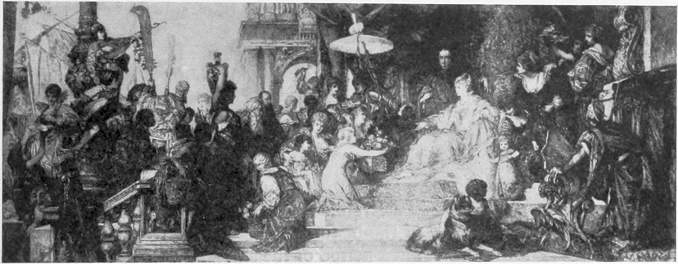 | |
| MAKART. | THE ESPOUSALS OF CATTERINA CORNARO. |
But all that cannot alter the fact that Makart takes a very high place 343 amongst his contemporaries, in that epoch dominated by the historical painting, and not yet arrived at an original conception of nature. Poussin said of Raphael: if you compare him with the moderns he is an eagle, but if you place him by the Greeks he is a sparrow. So when one thinks of Veronese or Rubens, one finds on Makart the feathers of a sparrow, but amongst his contemporaries in Germany he seems like an eagle. While all those from whom he derived, those Pilotys, Gallaits, and Delaroches, were no more than skilled historians in painting, Makart, though much tamer and smaller, has a relationship with Delacroix in his sovereign artistry. That joy in the purely pictorial which expressed itself in the festal procession in the Ring-Strasse and in the furnishing of his studio was, moreover, the ground-principle of his art. With the naïveté of the old masters he has boldly set himself above all historical truth; with absolute want of respect for books of history he has committed anachronisms at which any critic would be irritated. Revelling in splendid revelations of colour, all that he concerned himself about was that his costumed figures should render a fine harmony of hues. So exclusively was his eye organised for colour that every picture was first conceived by him on the palette as a luxuriant mass of colour, and he invented afterwards the theme which was proper for it. If Delaroche transformed painting into the flat, sober, and scientifically pedantic illustration of history, Makart gave it again a bright and splendid play of colour. The Nazarenes were philosophers and theosophers, the Romanticists revelled in lyrical sentiment. Kaulbach was a philosophic historical student of the Hegelian school, Piloty a prosaic and declamatory professor of history, Makart was the first German painter of the century. His personages weary themselves out in the enjoyment of their own dazzling outward personality. Free as the ancients with their gods and legends, he pours forth his Cupids, beautiful women, genii, Bacchantes, and historical figures, and at the same time draws into his kingdom of art all nature with its variety of plants, flowers, and fruits, all civilisation with its fulness of splendid vessels and jewels, of shining stuffs, emblems, weapons, 344 and masks. All that he created breathes the naïve, sensuous satisfaction of the genuine painter.
“The Pest in Florence” undoubtedly had its origin in Boccaccio’s description of the great epidemic which visited the town on the Arno; but the picture is a free fantasy of sensuous enjoyment and naked flesh, a colour symposium in which there really lives an atom of the flaming vital energy of Rubens.
Take “The Espousals of Catterina Cornaro,” that gay procession of representatives from Cyprus and Venice, of dignified men, of procurators of St. Mark, of women in foreign garb, of bright colour, who crowd round their young mistress, the queen of the feast, rejoicing amid the splendid architecture of the piazza. To the anger of the historian, he removes the scene from the fifteenth century to the blossoming period of the sixteenth, when the creations of Sansovino, Titian, and Veronese adorned the Queen of the Adriatic. “The Entry of Charles V into Antwerp” derived only its external impulse from Dürer’s Diary. The picture with the naked girls strewing flowers might almost as well represent the triumphal entry of Alexander into Babylon. In the magic land by the Nile it is not the history of civilisation and ethnography that attracts him, nor the monumental world of the pyramids and the temples of the gods, but the sensuous glow of southern nature and the still-life and artistic accessories out of which the beautiful serpent Cleopatra is seen to rise. Female bodies, animals, and fruits, set in the midst of rich, luxuriant landscapes, painted with oil and bitumen, such are the elements of which his pictures of the old world of legend—the hunt of the Amazons and of Diana—are composed.
With these capacities Makart was scenical painter par excellence. His Abundantia pictures in the Munich Pinakothek and the ceiling-pieces of the Palais Tumba in Vienna are among his best creations. There lives in them something of the Olympian blitheness of the ancients, of that easy joyousness which since Tiepolo seemed to have been buried in melancholy reflection and constrained brooding. They fulfil their purpose, as an invitation to the enjoyment of life, precisely because they carry no intrinsic thought to burden the sensuous display. Moreover, the unctuous and gorgeous colouring, with the animated contrasts of warm brown and light blue, mediated by the deep, glowing Makart red, corresponds to the mood they have been designed to awaken—one which called forth the joy of life, luxuriant, full-blooded, and foaming over. The great, fiery red flower, which sprouts out of the ground at the feet of the nymph in “Spring,” was the last thing touched by Makart’s brush, the last flare of the marvellous colour-demon by which he was possessed.
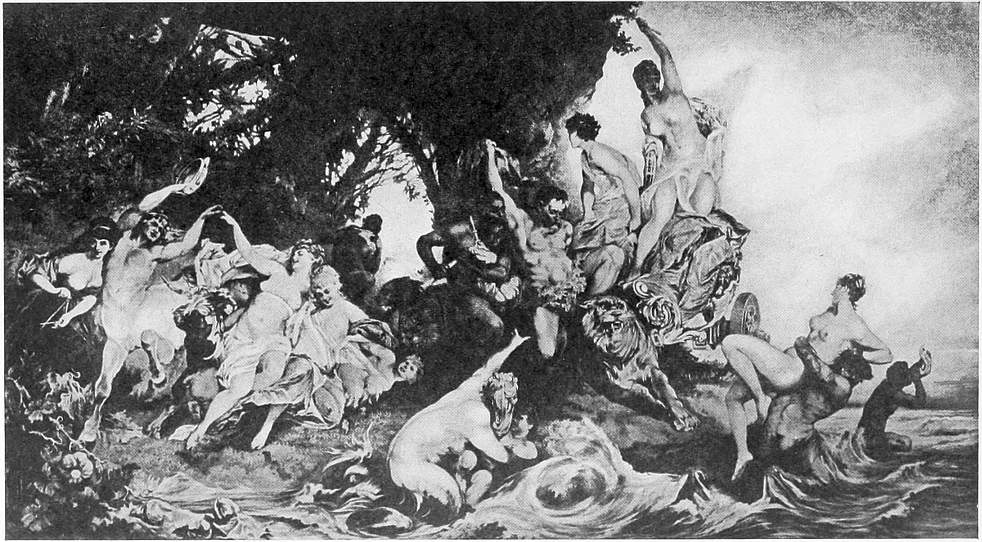 | |
| MAKART. | THE FEAST OF BACCHUS. |
347 Was possessed! For Makart’s whole artistic endeavour had something unconscious. One might say in a variant reading from Lessing: “If Makart had been born without a brain he would nevertheless have been a great painter.” It is as if one who lies buried in Antwerp had once more felt the instinct of production, and let himself down into the great head of the little Salzburger; and the head, being a somewhat imperfect medium, only stammered out the intentions of the sublime master. There is something remarkable in the career of this son of the poor servant, on whom fortune showered with full hands all it had to offer a child of the nineteenth century, and who in the midst of his splendour in Vienna remained always the same harmless child of nature that he had been in Munich, when, after receiving his first hundred florins, he drove in a cab the two steps from Oberpollinger to the Academy.
One must take him as he is—a product of nature. Makart was a scene painter, and that not in his scenical pictures only; but he was an inspired scene painter, of an enviable facility, who poured forth in play what others fabricate with pains. His merit it is to have announced to the Germans afresh, in an overwhelming style, that revelation of colour which had been forgotten since the Venetians and Rubens. He has not advanced the history of art, as such. What he gave had been given better before. But the history of German art in the nineteenth century has to honour in him the most perfect representative of the period in which colour-blindness was succeeded by exuberance of colour, and the cartoon style by the delight in painting.
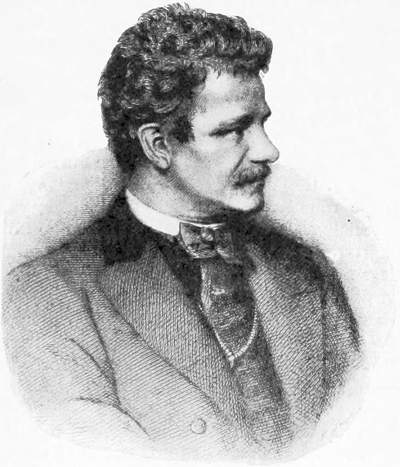 |
| GABRIEL MAX. |
| Graphische Kunst. |
Beside Makart, the child of nature, Gabriel Max’s seems a calculating, tormented, unhealthy talent. In the manner in which Makart did his work there lay a certain elementary, logical necessity; in Max there is a great deal of speculation and over-refinement. Makart’s home was the town on the lagoons. Max is by education and temperament a disciple of Piloty—that is to say, a painter of disasters; by birth he was a Bohemian. And that resulted in his case in a very interesting mixture. When he exhibited his first pictures it was as if one heard a refined music after the tom-tom of Piloty. In his “Martyr on the Cross,” which appeared in the spring of 1867 in the Munich Kunstverein, he first struck that bitter-sweet, half-torturing, half-ensnaring tone in which he afterwards continued to sound. It is dawn; a soft grey light rests, beaming mildly, over the lonely Campagna. Here stands a cross on which a girl-martyr has ended her struggles. A young Roman coming home from a 348 feast is so thrilled by the heavenly peace in the expression of the unhappy girl’s face that he lays a crown of roses at the foot of the cross, and becomes a convert to the faith for which she has suffered. The mysterious mortuary sentiment in the subject is strengthened by the almost ghostly pallor of the colouring. Everything was harmonised in white, except that one dark lock, falling across the pale forehead with great boldness, sounded like a shrill dissonance in the soft harmony, like a wild scream; it had come there apparently quite by chance, but was nevertheless calculated to a hair’s breadth. The terribly touching vision of the martyr aroused in every visitor to the Kunstverein a shudder of delight. It was even a fine variation, and one which invited pity, that the victim should not have been a hero, as in conventional catastrophes, but a soft and sweet girl, made for love and never for the cross. And it was the more absorbing, too, because it was impossible to say whether the young Roman was looking up to the beautiful woman with the desecrating sensuality of a décadent or with the fervid ecstasy of a convert. The same horrified fascination was wakened again and again in the presence of the later pictures of the painter. Almost every one contained a scene of martyrdom, in which the tormented and sinking heroine was a helpless child or a weak and defenceless woman. The passion for tragic subjects brought into full swing by the historical painters was directed in Max against the purest and tenderest, the most chaste and the most lovely. The type was always the same, with its Bohemian nose and one eye larger than the other, by which was attained a curiously visionary or hysterically enthusiastic expression. And the pictorial treatment corresponded to it: there was always a flesh-tint of poignant mortal pallor, a white clinging drapery, a black veil, a light grey background, all harmonised in one very delicate chord.
Goethe’s Gretchen made the beginning. In the Zwinger she lifted up her eyes in frightened anguish to the countenance of the Madonna. She sat in her cell, her face altered by madness and lit up with a wild laughter, and in a reverie passed her hand through Faust’s locks. Or as a phantom she wandered in the Walpurgis night, in her long, flowing shroud, with a blood-red stripe round her throat. This picture, exhibited with electric light, was especially effective. Max had brought into the earnest corpse-like eyes an expression that was terribly demoniacal, and had been attained to the same degree by no earlier illustrator of Faust. A raven, pecking at the lost ring, was her ghostly escort.
Max showed great invention in hitting upon such things. Bürger’s Pfarrertochter von Taubenhain gave him the material for his “Child-murderess”—a young girl who, by the bank of a lonely pool, overgrown with reeds, stabs her child to the heart with a needle, and in a sudden rush of maternal love presses a kiss on the stiff little body before committing it to the water. Here the sombre, disconsolate character of the landscape accorded finely with the action, and the pale body of the child made an exceedingly bright, pungent spot of colour on the dark-green rushes. “The Lion’s Bride” illustrated 349 Chamisso’s ballad of the jealous lion who killed his mistress before her wedding, because he would not give her over to another. Majestically he lies behind her, with one paw on the arm of the slain, and the other struck into her thigh. The stones of the floor are reddened with her blood. But far more frequently than blood Max employed the tints of corruption, the true nature morte. In its colour-values and subtle shades the dead human body, just at the point where corruption begins, was better suited to the painter’s pallid scale of colour than the light and brutally effective red of freshly poured-out blood. Among these paintings of mortification must be reckoned “Ahasuerus by the Body of a Child” and “The Anatomist”; the latter meditatively regards at the dissecting-table the corpse, covered with white linen, of a young girl who has committed suicide. In his “Raising of Jairus’s Daughter” the effect of mortification was most cleverly heightened by a small detail, which made an extraordinary impression: this was a fly on the naked arm of the girl, put there to remind the spectator of the unconsciousness of the body.
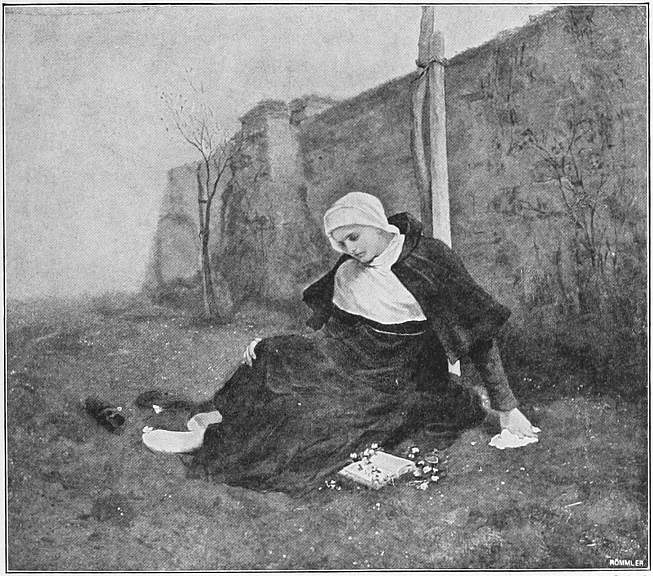 | |
| Seemann, Leipzig. | |
| MAX. | A NUN IN THE CLOISTER GARDEN. |
The secrets of death are always certain of their effect on the nerves; but 350 by means of the broken hearts of women, with annihilated hopes and agonised hysterical sufferings, he succeeded again in calling forth a bitter-sweet sympathy. “Mary Magdalene” and “The Maid of Orleans” were the masterpieces of this group. The underlying idea of the picture “Light” is that a blind young Christian girl, at the portal of the Roman catacombs, offers lamps to the entering Christians for the illumination of their dark way. The blind woman as the giver of light! Even in his youth, with cruel irony, he had had sung by a blind quartet the song, “Du hast die schönsten Augen.” A touch of Delaroche is in the other young martyr, who, between the bloodthirsty beasts of the Roman circus, looks up amazed to the rows of spectators, from the midst of which a young Roman has flung her a rose as a last greeting. In the next moment she will be lying on the earth torn to shreds by the beasts.
As he succeeded here in giving a presentiment of the horrible, so in another group of pictures Max attained a yet more demoniacal charm by the ghostly. He had early made himself familiar with Schopenhauer and Buddha and the Indian fakirs; the mystical and spiritualistic movement had just at that time been set going by the writings of Carl Du Prels. Justinus Kerner and the prophetess of Prevorst were the order of the day. Max became the painter of hypnotism and spiritualism. “The Spirit’s Greeting” made a special sensation: the young girl at the piano, in this picture, is interrupted in her playing by the touch of a materialised ghostly hand, which stretches towards her from a soft cloudy mist. The mixture of horror, joy, devotion, and ecstasy in the face of the young player was very effective. In order to render effects of the kind he made extensive studies from the hypnotised model, and in this way he sometimes reached an extraordinary intensity of expression. He took a decided position with regard to another question which at the time was very acute—vivisection. This he did in the picture of the man of science from whom an allegorical female figure, “The Genius of Pity,” takes away a little dog doomed to be dissected, showing by a pair of scales that the human heart has more weight than the human understanding.
All this goes to show that Max is the opposite of artless. He knows how to calculate an effect on the nerves with extreme subtlety, and most skilfully at times to give his pictures the attraction of the freshly printed newspaper. He appeals to compassion rather than imagination. He would set the heart beating violently. He triumphs generally by his subjects, and his effects are much purer in those few works in which he renounces the piquant adjunct of the demoniacal, the tragical, and the mystical, and becomes merely a painter. Amongst those works is to be reckoned that beautiful “Madonna” on the altar, painted in 1886, and so tenderly illustrating the verses of Heine—
| “Und wer eine Wachshand opfert, Dem heilt an der Hand die Wund, Und wer ein Wachsherz opfert, Dem wird das Herz gesund.” |
And so too does that charming “Spring Tale” of 1873, which breathes only 351 of gaiety, happiness, and peace; a young girl sits under the blossoming bushes, and listens enraptured to the warbling of a nightingale.
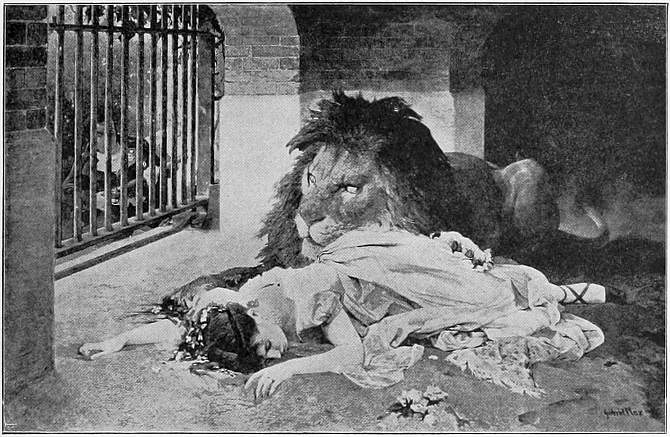 | |
| Hanfstängl. | |
| MAX. | THE LION’S BRIDE. |
Those pictures, the “mood” of which grows out of the landscape around—“The Nun in the Cloister Garden,” “Adagio,” “The Spring Tale,” and “Autumn Dance”—give Max a very high and peculiar place in the work of his period. He appears in them as a tender poet who expresses his emotions through a pictorial medium; as an adorer of nature of a soft melancholy and subtle delicacy, which are to be found in like manner only in the works of the Englishmen Frederick Walker, George Mason, and George H. Boughton. Nature sings a hymn to the soul of the painter, and through his figures it is breathed forth in low, vibrating cadences. A tender landscape of earliest spring gave the ground-tone to his charming picture “Adagio.” Young trees with trembling stems raise their slender crowns into the pale blue sky flecked with clouds. As yet the branches are almost naked; only here and there appears the embroidery of fresh yellowish green. And in this soft, tender nature which shyly reveals itself as with a slight shudder after its long winter sleep, there are seated two beings: a boy and his young mother—she looks almost a child—dreamily meditating. Their eyes look strangely into vacancy, as though their thoughts are wandering. Nature works on them, and a melancholy Warte nur balde runs through their souls. A spring landscape of blissful gaiety, where nightingales warble, butterflies sip at the flowers, and sunbeams play coquettishly round the budding rosebushes, is 352 the Setting of the “Spring Tale.” Everything laughs and rejoices, shines and scents the air in the early sunlight. Pearls of dew sparkle on the meadows, gnats hum and leaves murmur. She thinks of him. All the joy of a first love-dream sets her heart quivering with a delicious tremor. In her heart as in nature it is spring. Yet even as a landscape painter Max generally has that tender, suffering trait which runs through his creative work elsewhere. Twilight, autumn, pale sky and dead leaves have made the deepest impression on his spirit. Thin, half-stunted trees, in the leaves of which the evening wind is playing, grow upon an undulating, poverty-stricken soil. The landscape spreads around with a kind of lyrical melancholy: a region which gives no exuberant assurance of being beautiful, but which, in its poverty, attunes the mind to melancholy; a region, however, which knows not of storms and loneliness, but is the peaceful dwelling of quiet and resigned men. These beings belong to no age; their costume is not modern, but neither is it taken from any earlier period. They do not act and they tell no story; they dream their time away meditatively and gravely. Max has divested them of everything fleshly and vulgar, so that only a shadow of them remains, a soul that vibrates in exquisite, dying, elusive chords. “The Autumn Dance” is such an unearthly picture, and one of indefinable magic. Children and women are dancing, yet one feels them to be religious dreamers whom a melancholy world-weariness and a yearning after the mystical have drawn together to this secret and sequestered corner of the earth. The pale, transparent air, the tender tints of the dresses, delicate as fading flowers, the flesh tint giving the figures something ghostly and ethereal—it all strikes a note at once blythe and sentimental, happy and sad. “The Nun in the Cloister Garden” is in point of landscape one of his finest productions. In the cloister garden, despite the budding spring, there reigns a disconsolate dreariness. On the thin grass sits a young nun, who follows dreamily the gay fluttering of two butterflies, which flit around at her feet. A black dress, harshly and abruptly crossed by a white cape, envelops the youthfully delicate form. The dying sapling on which she is leaning bends helplessly against the stubborn paling to which it is fastened with iron clamps. The weather-stained wall stretches along in a dreary monotonous grey. An old sundial relentlessly indicates the slow dragging hours. But the deep blue heaven, in which a pair of larks poise exulting, looks in across the wall, from which a scrubby growth climbs shivering in the breeze.
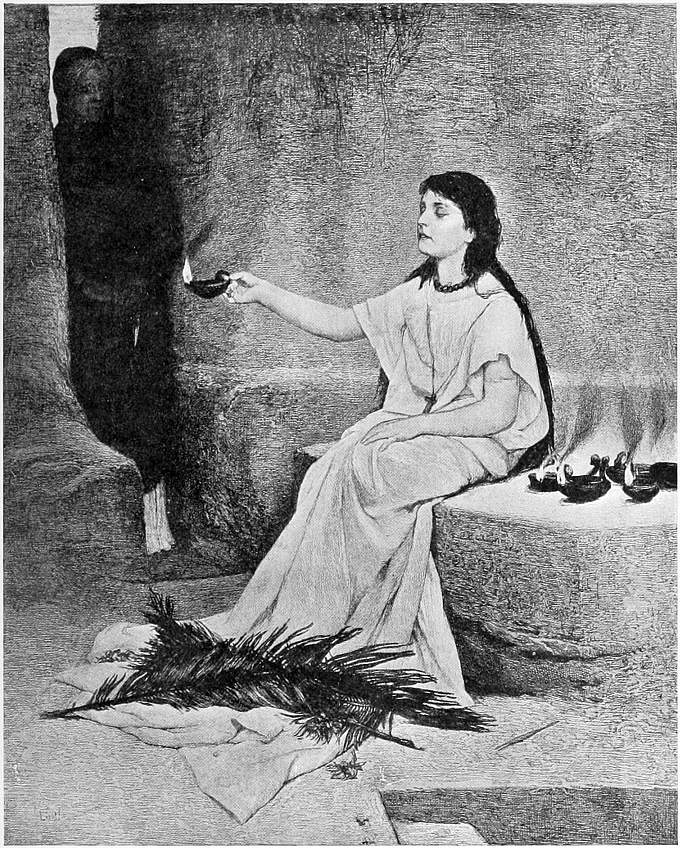 | |
| Graphische Kunst. | |
| MAX. | LIGHT. |
In such pictures, too, Max has a morbid inclination to a mystical delicacy of sentiment. He gives what is real an exquisite subtlety which transplants it into the world of dreams, and his tender sense of pain perhaps appeals only to spirits of an æsthetic temper. He is the antithesis of robust health; and yet there lies in the excess of nervous sensibility—in the pathological trait in his art—precisely the quality which inspires the characteristic delicacy of his earlier works. Here is no pupil of Piloty, but our contemporary. In their anæmic colour his pictures have the effect of a song of high, fine-drawn, and tremulous violin tones, at once dulcet and painful. With their refinement and polish, their subtle taste and intimate emotion, so wonderfully mingled, they reach the music of painting. They paint the invisible, they revel in dreams. In a period which played only fortissimo, and was at pains to drum on all the senses at once with a distorting passion, Max was, next to Feuerbach, the first who prescribed for his compositions dolce, adagio, and mezza voce; who sought for the refined, subdued emotions in place of the emotions fortes.
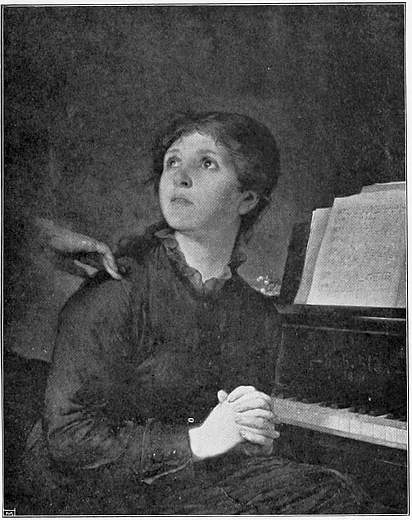 |
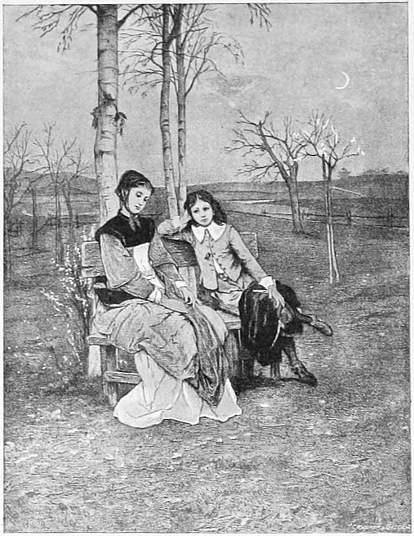 | ||
| Hanfstängl. | Gräphische Kunst. | ||
| MAX. | THE SPIRIT’S GREETING. | MAX. | ADAGIO. |
These pictures, the more subdued the better, make him the forerunner of the most modern artists, and assure his name immortality much more certainly than the great figure resting on an historical or literary basis. Their delicate black, green, and white simplicity has a nobleness of colouring which stands quite alone in the German painting of the century, and this, together with their refined musical sentiment, is probably to be set rather to the account of his Bohemian blood than of his Munich training. And whilst in the heads of his figures elsewhere a certain monotonous vacuity disturbs one’s pleasure, he appears here as a psychic painter of the highest mark; one who analysed with the most subtle delicacy all the fleeting nuances—so hard to catch—of melancholy, silent resignation, yearning, and hopelessness. Only the figures of the English new pre-Raphaelites have the same sad-looking, dove-like eyes, the same spiritual lips, tremulous as though from weeping. There must have been a divine moment in his existence when he first filled the loveliest form with the expression of the holiest suffering, the sweetest reverie, the deepest devotion, and the most rapt ecstasy. And if later, when people could not weary of this expression, he took to producing it without real feeling and by purely stereotyped means, that is, at any rate, a weakness of temperament which he shares with others.
Gabriel Max is an individuality, not of the first rank indeed, but he is one; and there are not many painters of the nineteenth century of whom that can 356 be said. He has often underlined too heavily, printed too much in italics, and done more homage to crude than to fine taste. But he has, in advance of his contemporaries, in whose works the good was so seldom new, the priceless virtue that he always gave something new, if not something good. His art was without ancestry, an entirely personal art; something which no one had before Max, and which after him few will produce again. A province which had not yet been trodden, the province of the enigmatic and ghostly, was opened up by him; he set foot in it because he is a philosophic brooder, fascinated by the magic of the uncanny. His studio is like a chapel in which a mysterious service for the dead is being held, or the chamber of an anatomist, rather than the workroom of a painter. The investigation of dead birds occupied him after his Prague days just as much as the sounding of the life of the human spirit. He lived at the time with his parents in an old, ghostly house, and roamed about a great deal in the picture gallery of the Strahow foundation; and here in lonely nights and mysterious picture-rooms there arose that grave and sombre spirit which runs through his work. As a child at the death of his father he had his first “vision.” His earliest picture, which he finished while at the Prague Academy, and sold afterwards to the Art Union there for ninety florins, showed that he had begun to move on his later course: “Richard the Lion-heart steps to the Corpse of his Father and it bleeds.” He was thus inwardly ripe when, in 1863, he came to Piloty in Munich, and, equipped with the technique of the latter, refined in so delicate a manner on the traditional painting of disasters. And if a conscious design on the nerves of the multitude frequently entered into his work, it was, as a rule, veiled by captivating beauty and excellence of painting. His older good pictures fascinate the most jaded eye by their remarkably tender sentiment, and the mystical spirituality of his soft and lovely girlish heads has been reached by few in his century. He 357 is at the same time a colourist of complete individuality, who made pigments the subtilised and ductile means of expression for his visionary moods of soul. He has brought into the world a numerous stock of works prepared for the market; and he has not disdained to paint glorified wonders of the fair, like the Christ’s head upon the handkerchief of Veronica, whose eyes seem to be closed by their lids and are looking out at the same time wide open. But much as he sinned, he always remained an artist. A curious, interesting, characteristic mind, one of the few who ventured even forty years ago to give themselves out as children of their time, in the firmament of German, and indeed of European art, he appears as a star shining by its own and not by borrowed light, as one whose incommensurable magnitude it is that his talent cannot be compared with any other. That is what gives him his artistic importance.
 |
| MAX. A WINTER’S TALE. |
All the less room can be claimed by the many who, likewise following in their subject-matter the lines of Piloty, get no further than the traditional catastrophe. Not Munich only, but all Germany, lay for more than a decade after the middle of the century under the shadow of historical painting, which here, as in other countries, came as the logical product of an unhappy time, dissatisfied with its own existence when Germany was merely a geographical expression, and in the pitiable misery of that age of state-confederations, dreamt of a better future at singing contests, athletic tournaments, and rifle meetings. The more poverty-stricken the time was in real action, the more vehement was the desire to read of action in books or to see it on canvas; and in this respect historical painting rendered at that time important political services, which are to be acknowledged with gratitude; just as the historical drama, the historical ballad and the historical novel were, all and several, means for the expression of the deep-seated longing of a backward people for political labours, for deeds and for fame.
But the artistic yield was not greater than elsewhere.
When the learned in the 358 thirties laid it down in doctrinaire fashion that, with the destruction of religious fervour begun by science, the old traditionary sacred painting would fall away of itself and the painting of profane history take its place, they overlooked from the very beginning the fact that, so long as the much discussed worship of genius had not actually become a reality the painting of history had to fight against insuperable obstacles. What constitutes the prime condition of all art—that its contents must be some fact vivid in consciousness—should, at any rate, determine its limitations, and ought to have confined the historical picture to the nearest universally known subjects. And what happened was just the contrary.
When Delaroche had skimmed the cream, his successors were forced to search in the great martyr book of history for events which were more and more unknown and indifferent. Piloty took from ancient history “The Death of Alexander the Great,” “The Death of Cæsar,” “Nero at the Burning of Rome,” and “The Triumphal Progress of Germanicus”; and from mediæval history, “Galileo in his Prison observing the Periodic Return of a Solar Ray,” and “Columbus sighting Land”; from the history of the Thirty Years’ War, “The Foundation of the Catholic League by Duke Maximilian of Bavaria,” “Seni before the Body of Wallenstein” (the morning before the battle at the White Mountain, Seni has come to carry away Wallenstein’s body), “Wallenstein on the way to Eger,” and “The News of the Battle at the White Mountain”; from English history, “The Death Sentence of Mary Stuart”; and from French history, “The Girondists on their Way to the Scaffold.”
After these pictures were painted and had had their success the turn came, in the years immediately following, for subjects growing steadily more and more dreary. And as Goethe held the historical to be “the most ungrateful and dangerous field,” so it now appeared as though laurels were to be gathered there only. From the political dismemberment of the present, German artists were glad to seek refuge as far back as possible in the past, and they flung themselves on the new province with such fiery zeal that, after a few decades, there was a really appalling number of historical pictures, illustrating every page of Schlosser’s great history of the world. Max Adamo painted “The Netherlandish Nobles before the Tribunal of Alva,” “The Fall of Robespierre in the National Convention,” “The Prince of Orange’s Last Conversation with Egmont,” “Charles I meeting Cromwell at Childerley,” “The Dissolution of the Long Parliament,” and “Charles I receiving the Visit of his Children at Maidenhead”; Julius Benczur: “The Departure of Ladislaus Hunyadi,” and “The Baptism of Vajk,” afterwards King Stephen the Holy of Hungary; Josef Fluggen: “The Flight of the Landgravine Elizabeth,” “Milton dictating Paradise Lost,” and “The Landgravine Margarethe taking leave of her Children”; by Carl Gustav Hellquist there were “The Death of the wounded Sten Sture after the Battle of Bogesund in the Mälarsee,” “The Embarkment of the Body of Gustavus Adolphus,” and the forced contribution of “Wisby and Huss going to the Stake.” Ernst Hildebrand had the Electress 359 of Brandenburg secretly taking the sacrament in both kinds, and Tullia driving over the corpse of her father; Frank Kirchbach displayed “Duke Christopher the Warrior”; Ludwig von Langenmantel: “The Arrest of the French Chemist Lavoisier under the Reign of Terror,” and “Savonarola’s Sermon against the Luxury of the Florentines”; Emanuel Leutze: a “Columbus before the Council of Salamanca,” “Raleigh’s Departure,” “Cromwell’s Visit to Milton,” “The Battle of Monmouth,” and “The Last Festival of Charles I”; Alexander Liezenmayer: “The Coronation of Charles Durazzo in Stuhlweissenburg,” and “The Canonisation of the Landgravine Elizabeth of Thüringen”; Wilhelm Lindenschmit: “Duke Alva at the Countess of Rudolstadt’s,” “Francis I at Pavia,” “The Death of Franz Von Sickingen,” “Knox and the Scottish Image-breakers,” “The Assassination of William of Orange,” “Walter Raleigh visited in his Cell by his Family,” “Luther before Cardinal Cajetan,” “Anne Boleyn giving her Child Elizabeth to the care of Matthew Parker,” and “The Entrance of Alaric into Rome”; Alexander Wagner: “The Departure of Isabella Zapolya from Siebenbürgen,” “The Entry into Aschaffenburg of Gustavus Adolphus,” “The Wedding of Otto of Bavaria,” “The Death of Titus Dugowich,” “Matthias Corvinus with his Hunting Train,” and many more of the same description.
 |
| Hanfstängl. |
| MAX. MADONNA. |
Was it at all possible to make works of art out of such material? Perhaps it was. The real artist can do anything. What he touches becomes gold, for he has the hand of Midas. But just as certain it is that the “historical painting,” carried on by a joint-stock company, almost never got any further than stage pathos, tailoring, and glittering splendour of material. Like many another thing which the nineteenth century brought to birth, it was an artistic error, which countless persons paid for by the waste of their lives. The older art knew nothing of such a reconstruction of the past. If historical subjects 360 were painted, the artists were almost throughout contemporaries of the subject that was to be treated; seldom did the materials belong to an epoch already past. But in both cases the work was done by immediate intuition, since even in the treatment of matters long gone by the painters never dreamed of painting them in the spirit of past times. They might depict Jews, or Greeks, or Romans, but they always represented their own countrymen in the surroundings and costume of their own time. The scientific nineteenth century made the first demand for historical accuracy. In dress and furniture this could be attained with the assistance of a cabinet of engravings and a work on costume. Whoever went to work in a very scientific spirit could even borrow from a museum the genuine costumes of Egmont and Wallenstein. But it was all the harder artistically to quicken into life the men themselves who had felt, lived, and suffered in the past. The painter could not proceed otherwise than by draping a modern, professional model, having consulted portraits, drawings, or busts, and having sought the aid of a peruke and false beard. An entirely realistic reproduction of this masquerade, however, made only too evident the contrast between the splendid old garment and the member of the proletariat who was dressed up in it. For, granted that men of the present have much in common with those of the past, every period has none the less its own type, even its own gestures, which no costume can make one forget. And speaking merely of general humanity, there is no question that a statesman at all times looked different from a professional model. In a very bad suit of clothes, but in one which, at any rate, fitted him, and in which he was able to behave himself naturally, the poor fellow came to the studio, to feel, for a few hours, in satin hose and a velvet doublet, like a carnival figure. Who was to give him the easy knightly bearing to play his part suitably to the occasion? It was not possible in this way ever to attain the naturalness and fulness of life of the old painters. In Terborg’s “Peace of Westphalia” everything is genuine and true and simple; here wig and woollen beard have got the upper hand. And if the painter proceeded not as a theatrical tailor, but as an historian of civilisation, the result was an archaic dryness. For then he was merely thrown back on the great masters of those periods in which the action took place, and, while he enlarged and coloured old busts or engraved portraits, his art was only second-hand.
And so the only way out of the difficulty was to use the model, but to idealise him by generalising and sinking the individual in the universally human, noble, and heroic. In this way the remarkable family likeness of all these heads becomes comprehensible, and it is still further heightened by that preference for a monotonous type of beauty which, from the period of Classicism, entered, as it were, into the blood of these painters. The human physiognomy, in reality so various, had then only one mask for the many characters which life creates. There was a fear of “ugliness,” as if it were a spot of dirt, and the personages portrayed received, one and all, an icy trait of “the Beautiful.” The various Egmonts, Wallensteins, and Charles the Firsts of Gallait and 361 Bièfve, Delaroche, and Piloty have not the blood of human beings, they have not the scars which are made by fate, but are all alike in their Byronic turn of the head. One knows the so-called character-heads—Luther gazing upwards with the look of one strong in faith, Columbus discovering America, and Milton in whose head are seething all the thoughts which dying men are wont to have in their last moments,—one knows them as thoroughly by heart as one knows all the opened folios and overturned settles, the picturesquely draped tapestry reserved for tragic funereal service, and that little box, covered with brass and catching the flashing lights, which constitutes in Belgium, France, and Germany the iron casket of all historical pieces. In the place of the inward Shakespearian truth of the figures, peculiar to the old masters, is the outward truth of costume; and the historical “property man,” whose highest aim is to “dress” the great moments of universal history in the prescribed manner, has stepped into the place of the artist. In the works of the old masters the historical figures stand out with sincerity as characters of flesh and blood, despite the want of “local colour,” whilst in the moderns the costumes certainly are correct, but the figures are so much the less credible and vital. “Beautiful may be the folds of the garment, but more beautiful must be that which they contain.”
Clothes do not make people, and costumes heighten no passions. Thus difficulties were heaped on difficulties, when impassioned situations and moments of dramatic intensity were to be painted. Whoever has reached that height of artistic power where the artist may with impunity put his model out of his head—like Delacroix, grand, volcanic, stormy, and excited to a fever heat by his inspiration,—that man will be capable of giving the effect of truth to such scenes, and of running through the whole gamut of emotion with a crushing power of conviction. But the joint-stock historical painter had to get his models to pull faces, and then no less laboriously to render with his oils those grimaces so laboriously produced. Hence the monotonous and petrified histrionic ecstasy of these pictures, the noble indignation put on for show, and that distressing gesticulation. As the actor gives emphasis to his words far more by gestures than is the case in ordinary life, so here also the artificially impassioned air of the heads was conventionally interpreted by corresponding motions of the arms. And thus the closing tableau was made ready: the dancers lay their hands on their hearts with tender and deep feeling; the tenor heroes sing that they are prepared to die; the tyrants let their deep basses vibrate, and the orchestra rages, to close with a shattering chord at the moment when the hero sets his foot upon the chest of the traitor; then come the Bengal lights, and then the curtain falls. What a spectacle!—but, alas, a spectacle and nothing more. All the emotions are artificial; they are opera emotions: the painters are only clever fellows, manufacturers of librettos and gay canvas; they show a great deal of knowledge and dexterity, but they have only a head and no heart. Stage requisites and professional models can never take the place of the free, creative force of imagination.
And if German pictures of this sort have an effect almost more insincere and theatrical than the French, the reason probably is that gesture—that external aid to the expression of feeling—is always more natural to the Latin than the Teutonic races, and has therefore, of itself, an effect of affectation in every German picture. We know that Bismarck, the Teuton incarnate, even in the most excited of parliamentary speeches, never made any other movement than to rap nervously with his pencil. “The German only becomes impassioned when he lies.” The most genuine masters of German blood have felt that right well, and they have been honest enough to say it out. A pervading trait of old German art is simplicity, the avoidance of everything impassioned even in the grandest conception, such as Dürer has. If in Leonardo’s “Last Supper” terror, indignation, curiosity, and sorrow are reflected by twelve heads and twenty-four hands in movements of agitation which are always new, in Dürer’s woodcut all the limbs and senses of the disciples are paralysed at the sorrowful revelation of the Saviour; it seemed to them desecration to break the solemn, oppressive stillness by noisy utterances of opinion and hasty gestures. And the same thing is to be remarked in every similar picture of Rembrandt’s; here too are only quiet and subdued movements, delicate suggestions and silence. The effect is great and sublime, the features of the Saviour earnest and expressive, but His mien is without any ecstatic emphasis such as a painter of Romance blood would have given Him. Only in the nineteenth century—partly through imitation of the Italians in Cornelius and Kaulbach, and then through imitation of the French in Piloty and his disciples—has this impassionedness, so opposed to German nature, entered into German art; and it has borrowed from the opera the distortions by which it has expressed the agitations of the spirit. No one works with impunity against the grain of his temperament. Exaggerated and violent movements, “ostentatious gestures of false dignity,” have replaced the natural expressions of life.
Less pose, parade, and theatricality, more ease, truth, and quietude; less insipid, generalised “beauty,” more forcible, characteristic “ugliness”: if art was not to be drowned in a surge of phrases, this was the path to be taken; and the transition was accomplished in “the historical picture of manners.”

CHAPTER XV
THE VICTORY OVER PSEUDO-IDEALISM
Immediately upon the epoch-making labours of the historians followed the first romances that were archæological and dealt with the history of civilisation; and hand in hand with these literary productions there was developed—by the side of historical painting proper, in France, Belgium, and Germany—a tendency to represent the life of the past, not in its grand dramatic action, but in its familiar concerns. In the one case there was history in its state uniform, in the other history in undress. And while the former class of painters saw the past only in a condition of unrest and violent movement, the latter began to enter into the details of daily life, and to represent it as it flowed by in times of peace. Those who had the romantic bias turned to the old artistic crafts. As yet that bias consisted only in an enthusiasm for the tasteful civilisation of a bygone age, with its polished charm of luxurious household appointments and pleasing costume. Rooms were filled with Gobelins and rich stuffs, handsome furniture and old pictures. By the rapid sale of their productions painters were placed in a position to acquire for themselves at the second-hand dealers all the beautiful things they painted. They placed their dressed-up models in front of their tapestries, and between their cabinets and tables. Stress was laid on historical accuracy in the representation of the usages and costumes of the past, not on dramatic action, and in this respect the historical picture of manners, as opposed to historical painting, marked an advance towards intimacy of feeling. The latter still worked from the abstract. The painter read a book and looked out for telling passages. He idealised models, to lend his picture the character of “great art.” It was always the illustration of underlying ideas.
In this new kind of picture, on the contrary, the conception of a work of art was given, by the perfected representation of any part of the visible world, were it only the corner of a studio elaborately and artificially arranged. The historical picture of manners no longer depicted “the meeting of hostile forces,” but either the heroes of history or the nameless men of the past in their daily act and deed, and so accustomed the public gradually to interest themselves in people who did not act with histrionic passion, but conducted themselves quietly and soberly like men of the present time. The place of the dramatic was taken by those phases of life which are pleasant and smooth. At the same time there was no need to be thrown back on conventional 364 idealisation, and it was possible to bring people dressed up for the occasion directly into the picture, just as they sat there, since the contrast between the professional model and the old-fashioned dress made itself less felt on this smaller scale of art. Thus was achieved the transition from the heroic historical art of the first half of the nineteenth century to that familiar and more human art of the second half, which no longer fled for help to the past, but sought a simpler ideal in reality.
First of all in France, from the side of the solemnly earnest group of Academicians, there stepped forward certain artists who moved in the old world quite at their ease, and began to paint simple little pictures from the daily life of antiquity, instead of the great ostentatious canvases of David and Ingres. In literature their parallels are Ponsard and Augier, who in their comedies brought antique life upon the stage, the one in Horace et Lydie, the other in La Ciguë and Le Joueur de Flûte.
Charles Gleyre approached nearest to the strict academical style of Ingres. Not even by a tour in the East did he allow himself to be led away from the Classical manner, and as head of a great and leading studio he recognised it as the task of his life to hand on to the present generation the traditions of the school of Ingres. Gleyre was a man of sound culture, who during a sojourn in Italy which lasted for years, had examined Etruscan vases and Greek statues with unintermittent zeal, studied the Italian classics, and copied all Raphael. Having come back to Paris, he never drew a line without having first assured himself how Raphael would have proceeded in the given case. And this striving after purity of form has robbed his works (“Nymph Echo,” “Hercules at the Feet of Omphale,” and the like) almost entirely of ease, freshness, and naturalness. Gleyre became, like Ary Scheffer, a victim to style. He had in him—his “Evening” of 1843 is sufficient to show it—a tender, dreamy, and contemplative spirit. The feelings to which he wished to give expression were his own, and the more fragrant, romantic, and vaporously indistinct they were, the more did they suffer from the stiff academical line in which he so mercilessly bound them. Only in his “Orpheus torn by the Bacchantes” has he raised himself to a certain neo-Greek elegance.
Louis Hamon stands at the end of this path, which led gradually from the strictness of form characteristic of the idealism of Ingres to incidents thought out in perfectly modern fashion and laid in a primitive era only because of the advantages of costume offered by the antique. The grace of his pictures is modern; their Classicism is a disguise. To robust natures his art can make but little appeal. He has deprived nature of her strength and marrow, and painting of its peculiar qualities, transforming them into a coloured dream, a tinted mist. In Hamon’s modelling there is an uncertainty, in his colour a sickly weakness and meagre effeminacy, which give to his figures and landscapes the appearance of being dissolved in vapour. Everything firm is taken from them; the stones look like wadding, the plants like soap, the figures like china dolls which would fly into the air at the least gust of 365 wind. Nevertheless there are times when his confectionery has a sympathetic grace. What distinguishes him is something simple, pure, youthful, fresh, and childlike. His colour is lighter and more delicate than Gleyre’s. None but blended colours such as light blue and light yellow mingle in the harmony of white tones. The severe antique style has been given a pretty rococo turn: his Greek girls, women, and children are like figures of Sèvres porcelain; the scenes in which he groups them are pleasing,—sports of fancy brought forward in a Grecian garb, of an affected sensuousness and a coquettish grace. His prettiest picture was probably “My Sister’s not at Home”—Greece seen through a gauze transparency in the theatre.
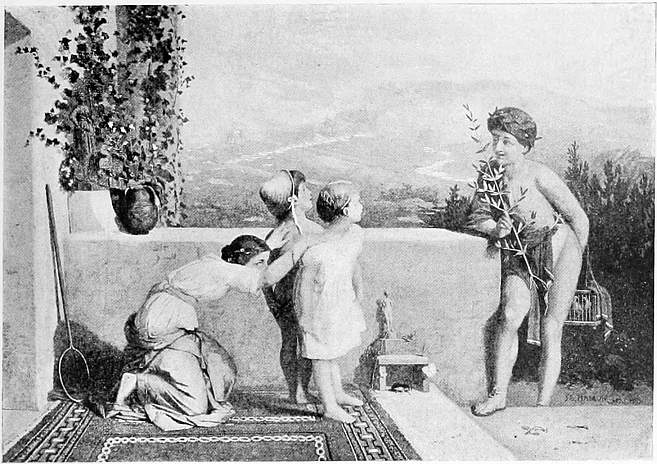 | |
| Gaz des Beaux-Arts. | |
| HAMON. | MY SISTER’S NOT AT HOME. |
| (By permission of Messrs. Boussod, Valadon & Co., the owners of the copyright.) | |
Léon Gérôme has also a taste for borrowing his subjects from the antique; being a pupil of Delaroche, however, he has treated not mythological but historical episodes of antiquity. His “Cock-fight,” “Phryne before the Areopagus,” “The Augurs,” “The Gladiators,” “Alcibiades at the House of Aspasia,” and “The Death of Cæsar,” together with pictures from Egypt, are his most characteristic works: Ingres and Delaroche upon a smaller scale. He shares with the one his learnedly pedantic composition, and with the other his taste for anecdote. It may be remarked that in these same years Emile Augier was active in literature, but that Augier, living in the same epoch of modern life, is far more powerful and animated in his Classical pieces. 366 Gérôme’s art is an intelligent, frigid, calculating art. In execution he does not rise above a petty study of form and an academic discipline. His drawing is accurate, and he has even succeeded in giving his figures a certain natural truth which is in advance of the generalisation of the classic ideal; yet from first to last he is wanting in every quality as a painter. His pictures of the East are hard landscapes, in which men or animals, harder still—unfortunate, eternally petrified beings—stand out abruptly. He draws and stipples, he works like an engraver in line, and goes over what he has painted again and again with a fine and feeble brush. He has an eye for form, but the effect of light upon the body escapes him. His pictures therefore give the impression of china, and his colour is hard and dead. What distinguishes him is a watchful observation, a chilling correctness, enclosing everything in characterless outlines. And this marble coldness remained with him later when, moving with the development of historical painting, he gradually took to working on more tragical subjects. Even the most violent subjects are depicted with a dainty grace, and with a smile he serves up decapitated heads, prepared with a painting à la maitre d’hôtel, upon a gold-rimmed porcelain plate as smooth as glass.
Another painter of archæological genre is Gustave Boulanger, who after extensive studies in Pompeii gave a vogue to those antique interiors and scenes of Pompeian street life now associated with the name of Alma-Tadema.
Direct descendants of Delaroche and Robert Fleury were those who threw themselves enthusiastically into treating the physiognomy of the sixteenth and seventeenth centuries, and devoted the most ardent study to the weapons, costumes, and furniture of those epochs. They never wearied in representing François I and Henri IV in the most varied situations of life, nor in searching the biographies of great artists and scholars for episodes worth painting. Especially popular subjects were those of celebrated painters at their meeting with contemporaries of high station: Raphael and Michael Angelo coming across each other in the Vatican, Murillo as a boy, the young Ribera found drawing in the street by a Cardinal, Bellini in his studio amid all manner of precious objects, Charles V and Titian, Michael Angelo tending his servant, and others of the same kind. The number of painters who were active in this province is as great as the number of anecdotes which are told of distinguished men. They spread themselves over various countries, like the swarms of insects hatched on a summer’s day amid luxuriant vegetation, and thereby they render the task of selection more difficult to the historian. In France there worked Alexander Hesse, Camille Roqueplan, and Charles Comte; in Belgium, Alexander Markelbach and Florent Willems. Markelbach, a pupil of Wappers, in addition to episodes from English history, specially devoted himself to painting the shooting festivals of the old Netherlandish city guards, in which enterprise the Doelen pieces of Frans Hals did him excellent service in the matter of costume. Florent Willems, who, as a restorer, saturated himself with the manner of the old masters, was particularly popular on account of 367 the smooth finish he gave to his modish ladies, cavaliers, soldiers, painters, soubrettes, and patrician matrons of the sixteenth and seventeenth centuries. All the richly coloured satin, brocade, and velvet costumes of these personages, together with the tapestry, the curtains, and the furniture of their dwellings, he had the secret of reproducing in such a fashion that he was long esteemed a modern Terborg. Amongst the Germans, L. von Hagn was the most delicate of these artists, and the graceful comedies of real life which he painted, transplanting them into the Italian Renaissance or the French rococo period, have often great distinction of colouring. Gustav Spangenberg, after the lucky but isolated success he had made with “The Track of Death,” devoted himself to the Reformation period; and Carl Becker to the Venetian Renaissance, from which he occasionally made an excursion into the German. These and many others could be discussed with more particularity if their pictures, smooth as coloured prints, and neatly finished in their own paltry way, were not so much below the standard of galleries. For them also the incident to be represented, with the personages concerned in it, was the principal matter, and not pure painting. These fetters upon true art were first shaken off by the hands of the following painters.
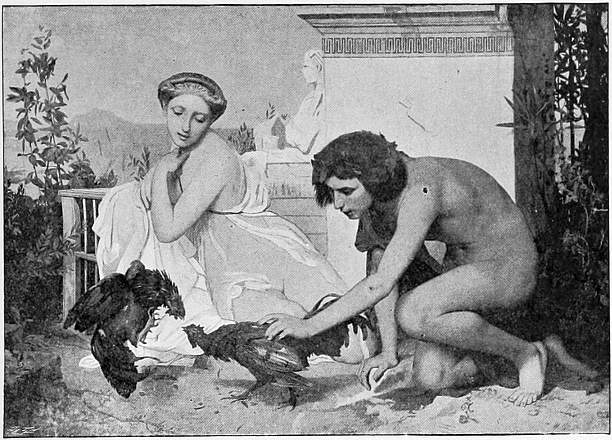 | |
| Cassell & Co. | |
| GÉRÔME. | THE COCK-FIGHT. |
Of the generation of the eminent Flemish artists of 1830 Hendrik Leys is the one whose fame has been most enduring. Born in Antwerp on 18th February 1815, at first destined for the priesthood, and then in 1829 admitted to the studio of Ferdinand de Braekeleers, he had made his début in the beginning 368 of the thirties with a pair of historical pictures. These indeed revealed little of the power which he evinced later, but they furnished some indication of what he was aiming at. Here were none of the skirmishes—so popular at the time—in which blood flows as from the pipes of a fountain; the combatants fought with decorum and moderation, and less from conviction than to justify the helmets and cuirasses which had been fetched from the wardrobe. In both of them, on the other hand, the background—a mediæval town with tortuous alleys, lanterns, and picturesque taverns—was most lovingly treated. Here was revealed a thoroughly German delight in minute detail. Instead of subordinating the accessories as others did, with the object of throwing the principal personages into relief, Leys represented an entire corner of the world at once, giving full distinctness to the smallest things, down to the implements of daily life, the grasses and flowers of the landscape, and the variegated corner-stones of the old house-fronts, whose picturesque porches and lattices bulge into the crooked lanes. His next picture, “The Massacre of the Löwen Magistrates,” was a still further departure from precedent, since—quite in Callot’s manner—it mingled with the principal drama a mass of grotesque episodes. The born genre painter was announced by these traits; and not less striking was the form of the art, which was a thorough departure from the manner of the “painters of the grand style.”
The resuscitation of a national art, which had been the life-long aim of Gustav Wappers, who was twelve years his senior, was what Leys also set up as the goal of his artistic endeavours. But their ways divided. Wappers was principally inspired by Rubens, while Leys attached himself at first to the Dutch painters. A visit made to Amsterdam in 1839 had helped him to an understanding of Rembrandt and Pieter de Hoogh. He followed them when, in 1845, he painted his “Wedding in the Seventeenth Century”—a rich display of gleaming hangings, golden plate, and red-plush furniture, amid which move handsomely dressed people, wedding guests, and violin players. The effort to approach Pieter de Hoogh or Jan van der Meer is apparent in the management of light; the treatment of drapery reminds one of Mieris and Metsu. Another pair of anecdotic pictures from the seventeenth century allow one to follow the progress by which Leys, under the influence of Dutch models, gradually developed that power and mastery of colouring, that completeness of pictorial effect, and that soft treatment of subdued light which were justly admired in his first works. In particular, certain works founded on the legends of painters and monarchs—Rubens, Rembrandt, or Frans Floris visited in their studio by some personage of high station—made him the lion of the Paris Salon. In 1852 he stood at the summit of his fame; he was recognised as one of the first of painters, both in Belgium and in other countries, and was everywhere loaded with honours. Then he cast his slough and entered on his “second manner.”
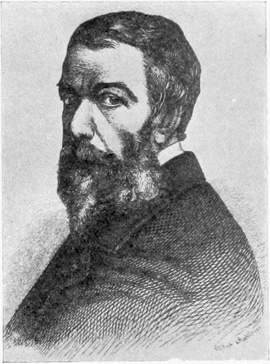 |
| Seemann, Leipzig. |
| HENDRIK LEYS. |
After he had followed Rembrandt for more than a decade he turned 369 from him to cast himself suddenly into the arms of the German masters of the sixteenth century, and, according to his own saying, “from that time forward to become an artist.” During a tour through Germany, in 1852, he had become familiar with Dürer and Cranach; in Dresden, Wittenberg, and Eisenach there hovered round him the great figures of the Reformation period. Half-effaced memories of his countrymen, the brothers Van Eyck and Quentin Matsys, became once more fresh, and drove him decisively forward on his new course. “The Festival at Otto Venius’s” and “Erasmus in his Study” were the first steps in this direction, and when soon afterwards he came forward with his costume pictures, “Luther as a Chorister in Eisenach” and “Luther in his Household at Wittenberg,” every one was enraptured with the exquisite truthfulness of his portrayal of archaic life. At the World’s Exhibition of 1855 he had another magnificent success with three pictures executed in old German style. These were “The Mass in Honour of the Antwerp Burgomaster Barthel de Haze,” “The Walk before the Gate,” and “New Year’s Day in Flanders.” His return from Paris, where he was the only foreigner except Cornelius who had received the great gold medal, took the form of a triumphal progress in Antwerp, where he was greeted with illuminations, torchlight processions, and laurel wreaths made in gold. He was held to be the most eminent master since Quentin Matsys, the Jan van Eyck of the nineteenth century. In the Brussels Salon he appeared as a prince of art, before whom criticism made obeisance, and for whose pictures special shrines were erected. He was striking, not merely as an artist, but as a man: his stately figure was known to every one in Antwerp, and was pointed out to strangers as one of the sights of the place. In 1867, when he again received the medal in Paris, the Antwerp Cercle Artistique had a medal struck to commemorate an event of such importance in Belgian art. His decease, on 25th August 1869, threw the whole town into mourning; the windows in the town hall, where he had painted his last pictures, were hung with black, and the announcement of his death pasted up on great placards at the street corners. “Leys is ons” ran the phrase in the speech made by the burgomaster over his open grave. To-day his statue stands on the Boulevard Leys, and his house is noted down in Baedecker, like those of Matsys and Floris, Rubens and Jordaens.
Leys was thus a favourite child of fortune. Enthusiastic applause showered 370 him with fame and laurels. But it is natural that posterity should find a good deal to cancel in these titles of honour.
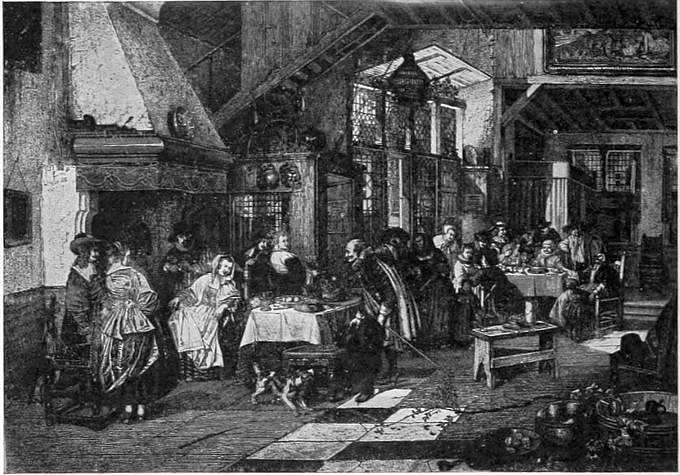 | |
| Seemann, Leipzig. | |
| LEYS. | A FAMILY FESTIVAL. |
Through Leys the history of art was not enriched with anything new. His delicate art—severe in outline—which goes back directly to the peculiar manner of the fifteenth century, is in itself not without merit. But how much of it belongs to the nineteenth century? To what extent has the painter stood independent and on his own peculiar ground? He could draw a Van Eyck which might be taken for an original. He seems like an old master gone astray by chance amongst the moderns. His knowledge of the sixteenth century is marvellous. In fact, he was a visionary who saw the past as clearly as though he had lived in the midst of it. The men he paints are his contemporaries. He has drawn them from life in the year of grace 1493, and they make no gesture nor grimace which might not be four hundred years old. Yet that means that he was not an original genius, but merely one who gave an adroit reproduction of a formula already in existence. And much as he affected to be the contemporary of Lucas Cranach and Quentin Matsys, he had not their simplicity: where they painted life he painted the shadow of their realism. Surrounded by old pictures, breviaries, and missals, he contented himself with copying the still forms of Gothic miniatures instead of living nature. He went so deeply into the pictures of the Antwerp town 371 hall that he followed the old masters in their very errors of perspective; and though even the most childish confusion between foreground and background does not disturb one’s pleasure in them, because they knew no better, it is an affectation in him, with his modern knowledge, intentionally to make the same mistakes. Instead of being an imitator of nature, he is an imitator of their imitation—a gourmet in pictorial archaism.
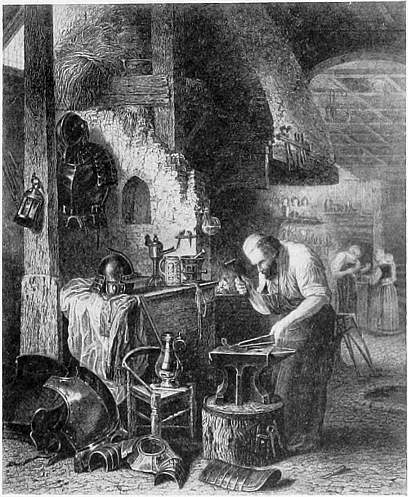 |
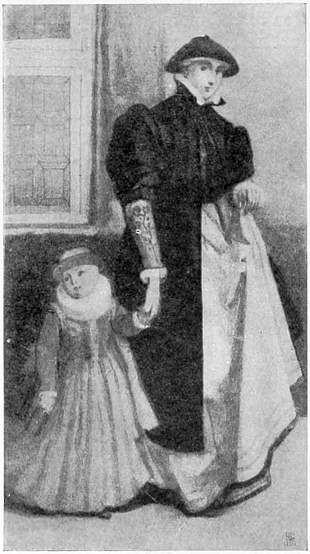 | ||
| LEYS. | THE ARMOURER. | LEYS. | MOTHER AND CHILD. |
Yet it was exactly this uncompromising archaism which was of importance for his time, and amongst his contemporaries it gives him significance as a reformer. He is the only one amongst them who really represents the Flemish race. Wappers was merely a Fleming from Paris, who shook off the yoke of the Greeks to bear that of the French. Delaroche lived again in Louis Gallait, the pupil of David. Their works had the sentiment of French tragedies, and an artificial neatness which completely departed from the truth of nature; the figures were combed and washed and brushed and polished, the gestures were histrionic, the colours toned in a stereotyped fashion to effect a pleasing ensemble. Leys endeavoured to be true. In his pictures he had no wish to express ideas, but merely to bring back a fragment of “the good old time” in all its brightness of life and colour. And whilst as a colourist he was bent upon avoiding uniformity of tone and giving everything its natural character, as a draughtsman, too, he set up, in opposition to the more patrician fluency of others, the citizen-like angularity of an art uninfluenced by the Cinquecento. As in Cranach, Dürer, and Holbein, one finds in his pictures profiles that are vividly true; harsh and often unwieldy heads, wrinkled faces, and heavy, massive shoulders resting on stunted bodies. The human form, with fat stomach and great horny hands, seems almost deformed. Everything which the struggle for existence has made of the image of God is expressed in the works of Leys for the first time since David. Even his “Massacre of the Löwen Magistrates” showed sharp, naturalistic physiognomies in the midst of its confused composition, and his “Barthel de Haze,” fifteen years after, fully exemplified this striving after 372 characteristic and truthful expression. None of his contemporaries has shown himself more cool and indifferent to conventional and graceful profile and “beauty” in the drawing of heads. Hatred of the academic model made Leys bring art back to its sources. The hideousness, so often childish, in primitive pictures was dearer to him than all Raphael. By this emphasising of the characteristic in attitude and the expression of the face he shows himself, although he painted historical subjects, the very antipode of the painter of the historical school, and, at the same time, one of those who effected the transition which led to the modern style. In setting up quaintness and far-fetched archaism against the mannerism of the idealists, Leys accustomed the eye again to recognise that there was something truer than nobility of line and aristocratic pose; and, as he appealed to the old masters as accomplices, it was impossible for æsthetic criticism to be offended.
In France the transition from the absolutely beautiful to the characteristic, from types to individuals, was brought about from various sides. On the one side Romanticism had opposed to the antique style that of the Flemish painters. On the other side, within Classicism itself, there had been a change from the antique and the Cinquecento to the early Italian renaissance. A new world was opened to sculpture by the “Florentine Singer” of Paul Dubois. The more artists buried themselves in the study of those early pioneers of realism, Donatello, Verrochio, della Robbia, and the other masters of the Quatrocento, the more they found themselves fascinated by the sparkling animation of these creations, and sought to transfer it freely into their own work. The fifteenth century, with the energetic force of its figures, its close grasp of nature, and its pithy characterisation, which did not even shrink from ugliness, induced painters to go back more than they had formerly done to the sources of real life and to bring something of its directness into their creations. Élie Delaunay began to look on nature with an eye less bent on making abstractions and regarding all things from the standpoint of style; he began to apprehend more clearly her individual peculiarities and to reproduce them more truly than had been done by the frigid school which cast everything into the mould of Classicism. But Ernest 373 Meissonier went a step further when by his rococo pictures he set the Dutch tradition on a level with the Flemish and Early Italian as a formative influence.
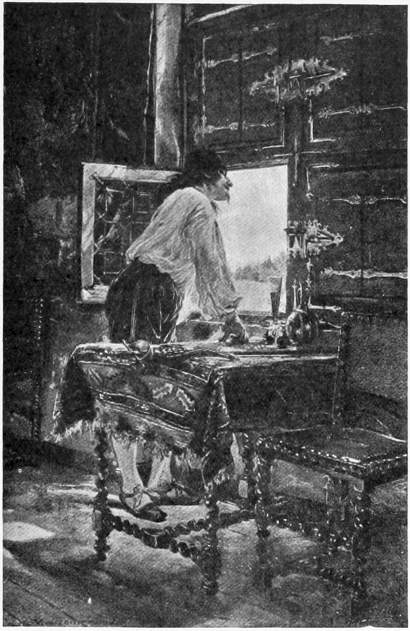 |
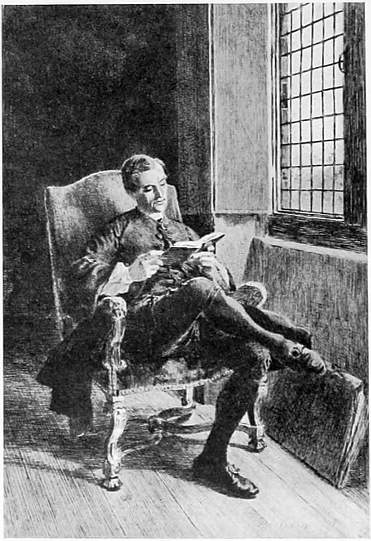 | ||
| Baschet. | Gaz. des Beaux-Arts. | ||
| MEISSONIER. | THE MAN AT THE WINDOW. | MEISSONIER. | A MAN READING. |
A picture must either be very big or very small if it is to attract attention amid the bustle of exhibitions. This was probably the consideration which led Meissonier to his peculiar class of subjects, and induced him to come forward with minute Netherlandish cabinet-pieces at the time when the Romanticists were issuing their huge manifestoes. He came of a family of petty tradespeople, and in his youth he is said to have taken over his father’s business, a trade in colonial produce. Every morning at eight o’clock punctual he was at the shop desk, and kept the books and copied business letters, and in this way accustomed himself to that painstaking and uniform carefulness which was characteristic of him to the end of his life. His teacher, Cogniet, was without influence on him. Even in his youth, when there went forth the battle-cry of “A Guelf, a Ghibelline! A Delacroix, an Ingres!” Meissonier sat quietly in the Louvre and copied Jan van Eyck’s Madonna from Autun. And a Netherlandish “little master” did he remain all his days. He first earned his bread as an illustrator, but after 1834 he began to exhibit all manner of pieces from the time of Louis XIV and Louis XV—the “Bourgeois hollandais rendant Visite au Bourgmestre” of 1834, the “Chess Players of Holbein’s Time,” 1835, the “Monk at the Sickbed,” 1838, the “English Doctor” and the “Man Reading,” 1840. The Salon of 1841 was for him what that of 1824 had been for Delacroix and Ingres, and that of 1831 for Delaroche: the cradle of his fame. “The Chess Party” (17 cm. high and 11 cm. broad) was the most celebrated picture of the exhibition. The great Netherlandish “little masters” of the seventeenth century, till then scarcely 374 known and little appreciated, were brought out for comparison. “Has Terborg or Mieris or Meissonier done the greater work?” was the question. People marvelled at the sharpness of this short-sighted eye which had a perception for the smallest details. “Good heavens! look at the way that’s been done,” said the Philistine, taking a magnifying glass; and felt himself a connoisseur if the curator at his elbow called out, “Not too near!” Even his first pictures had an accuracy and finish which defies description. It seemed as if a most admirable Netherlandish painter in miniature scale had arisen. The execution of his design in colours was as slow, careful, and laborious as were his preparatory studies for costume: every touch was altered and altered again; many a picture which was almost ready was thrown aside, scraped out, and completely recast. Not hot-headed enthusiasts, but “connoisseurs,” has Meissonier conquered in this fashion. Those readers, philosophers, card-players, drinkers, smokers, flute-players and violin-players, engravers, painters and amateurs, horsemen and farm-servants, brawlers and bravoes, from the seventeenth and eighteenth centuries, which he painted year after year, were soon the most coveted pictures in every superior private collection. In 1884 he was able to celebrate his jubilee as an artist with an exhibition of one hundred and fifty pictures of the kind. And as they would have gone dirt cheap if they had been bought for their weight in gold, the public accustomed itself to buy them for their weight in thousand-franc notes.
The present age no longer looks up to these exercises of patience with the same vast admiration, but it should not therefore be forgotten what Meissonier was for his time.
To begin with, though painted at a time when painting was regarded as an auxiliary, and an invaluable one, to history, his pictures tell no story. These personages of Meissonier’s take part in no comedy; they occupy themselves, some in smoking, some in drinking, others in playing cards, and others again in doing nothing whatever. Whether they made their entry as musketeer or philosophers, as lackeys or gallants, 375 as scholars or bonvivants, they did not pose and had no ambition to seem men of wit and spirit, they plunged into no adventurous deeds and related no anecdotes: they were content to be well painted. And so amongst all the French painters of the historical picture of manners Meissonier was the one who had the secret of giving his works an entirely peculiar cachet of striking and realistic truth to nature. His figures, marvellously painted, and at the same time animated and natural in expression, wear the costume of our ancestors with the utmost self-possession, and fit into their modish rococo surroundings as if they had been poured into a mould. Meissonier reached the truth of nature in the total effect of his pictures by first in reality arranging his interiors, and the still-life they contained, as a congruous whole. The rooms, window niches, and firesides which he reproduced in his pictures were in his own house and his studios, with every detail ready to hand. He bought bronzes, trinkets, and ornaments, genuine productions of the rococo period, by the hundred thousand, and kept them by him. His models were obliged, for weeks and often for months, actually to wear the velvet and silken costumes in which he made use of them; then he painted them with the greatest fidelity to nature, and without troubling himself about anecdotic incident. What he rendered was not a story invented and put together piecemeal, but a wholesome piece of reality, pictorially conceived. And if this was primarily composed of costumes and furniture belonging to the eighteenth century, the transition to the natural treatment of modern life was at the same time made possible, and was accomplished by Meissonier himself, at a later period, in his battle pieces.
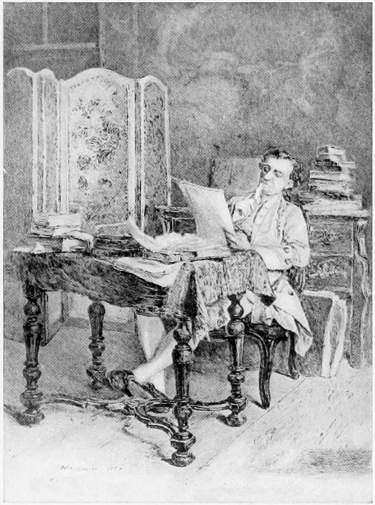 |
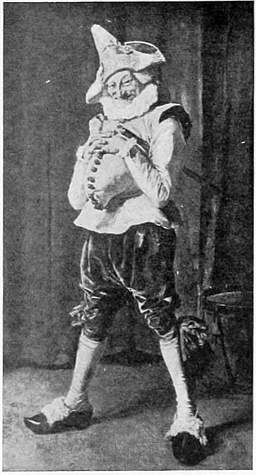 | ||
| Gaz. des Beaux-Arts. | Cassell & Co. | ||
| MEISSONIER. | READING THE MANUSCRIPT. | MEISSONIER. | POLCINELLO. |
But he had only painted men: the physiognomy of the feminine Sphinx remained for him an eternal riddle. A wide field was here offered to his followers. Fauvelet, Chavet, and Brillouin stepped into Meissonier’s shoes, and gave his rococo fine gentlemen their better halves. The first two made simple imitations. Brillouin devoted himself to the comic genre: he arranged his 376 pictures prettily, was a good observer, and painted tolerably well. The last of these Meissonierists is Vibert, chiefly known in the present day by his cardinals and other scarlet dignitaries, whom he represents in water-colours and oils with a certain touch of malice. He paints them gouty, gluttonising, or tipsy, in one or more cases in every picture—which does not contribute to make his works interesting. But originally he had a sympathetic superior talent, and will always claim a modest place in the group of the modern “little masters.” His “Gulliver Bound,” and also the Spanish and Turkish scenes which occupied him after a tour in the East, are extremely pleasing and delicately painted costume pieces, gleaming in sunlight; and in their sparkling, capricious workmanship they sometimes almost verge on Fortuny.
On the German side of the Rhine Adolf Menzel was the great pioneer of truth. The history of German art must do him honour as one who first had the genius and courage to break away from conventional forms of phrasing, and bring the truth of nature into art: at first, as in the case of Meissonier, it was nature in masquerade; but it was nature seen and rendered with all the sincerity of a man to whom the art of pose was wanting from the very first.
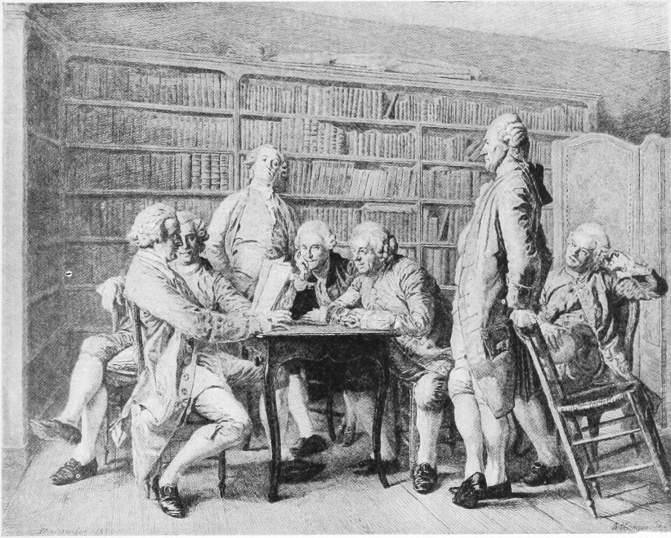 | |
| L’Art. | |
| MEISSONIER. | A READING AT DIDEROT’S. |
| (By permission of Baron Edmond de Rothschild, owner of the picture, and of M. Georges Petit, owner of the copyright.) | |
Even in the thirties, at a time when “The Sorrowing Royal Pair” and the “Leonora” by Lessing, “The Soldier and his Child,” “The Sick Councillor,” and “The Sons of Edward” by Hildebrandt, and “The Lament of the Jews” by Bendemann, together with the works of Cornelius, met with the enthusiastic applause of the million, Menzel looked into the world with a sharp glance, undisturbed by idealism; and what enabled him to do this was his unwavering and thoroughly Prussian healthiness, which knew no touch of sentimentalism—a certain coldness and hardness, that sensible, reflective North German trait, which often expresses itself in these days (when German art has become subtle and superior) by a crude naturalism in the Berlin painting. In the beginning of the century, however, it set the Berlin painting, as art of the healthy human understanding, in salutary contrast to the sickliness of Munich and Düsseldorf. Even eighty years ago the people of Berlin were too acute and practical to be Romanticists. The artists whom Menzel found active and honoured at his arrival were Schadow and Rauch, and beside them, as representatives of the grande peinture, Begas and Wach. But even these, who were most under the influence of the sentimental tendency, were justly recognised by the thorough-going 377 Romanticists on the Rhine as never having given an unqualified homage to their flag. A clear, realistic method was dominant in the art of Berlin. And in this respect it was as much a corrective—and one by no means to be undervalued—against the inflated sentiment of Munich as against the weak and sickly sentimentalism of Düsseldorf, with its knights and monks and noble maidens. Even Cornelius, who had been called to Berlin by Frederick William IV—that King of the Romanticists on the throne of the eminently unromantic Hohenzollerns—found himself helpless against the ruling taste. And here only, in the stronghold of sharply accentuated common sense, where the old Prussian sobriety set bounds to the twilight kingdom of Romanticism, could Adolf Menzel attain to greatness. His Berlinism kept him from lingering in empty space. To the taste of to-day, formed from Fontainebleau, he will seem too much a creature of the understanding and too little a creature of feeling. Boecklin hit him off admirably when, on being asked what he thought of Menzel, he answered: “He is a great scholar.” A comparison between him and Mommsen especially suggests itself—a great scholar, a mordant satirist, and a brilliant 378 journalist. But this sober scepticism, this cool spirit of investigation, this “heartlessness” observing all things with the eye of a judge in a court of judicial inquiry, were what cleared the ground for modern art. No one has done more than Menzel for those rulers in the kingdom of dreams who from pure dreaming have never been able to learn anything. He has helped to set them steadily on their feet, and to accustom their sight, vitiated by idealism, once more to truth and nature.
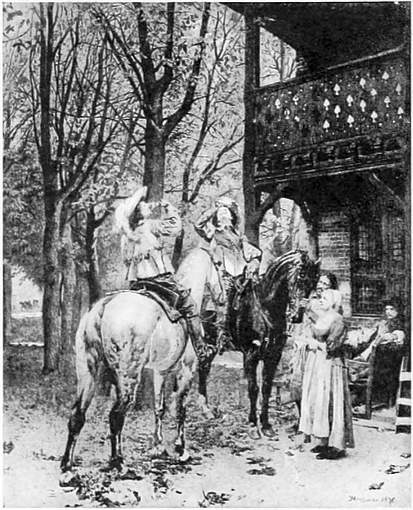 | |
| L’Art. | |
| MEISSONIER. | A HALT. |
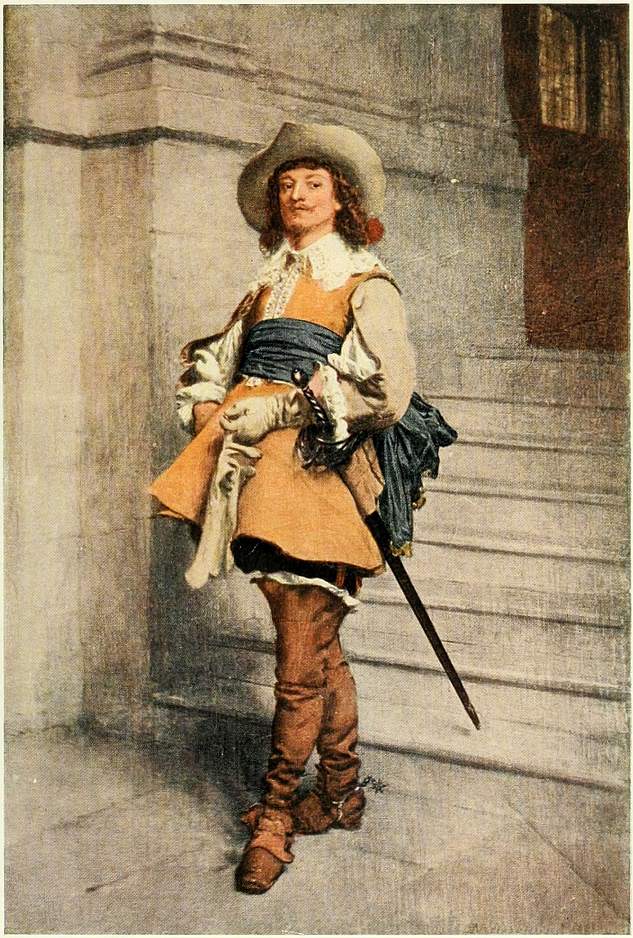 | |
| Mansell. | |
| MEISSONIER. | A CAVALIER. |
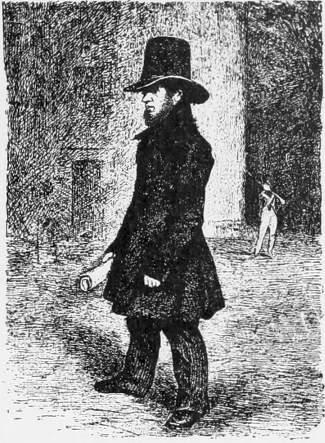 |
| Baschet. |
| ADOLF MENZEL, 1837. |
Menzel was almost the only one in Germany who could draw and paint in the time before the French influence had made itself felt. The struggle for existence had forced him to learn. In the year of Bismarck’s birth there was born in Breslau the man destined to glorify, first the greatness of the old kingdom of the Fredericks, and then that of new imperial Prussia. Cast out at an early age on the inhospitable wilderness of life, he came to Berlin, poor and lonely, and not so much for the sake of art as for gain. There he sat in his cheerless attic, without a servant; and wrapped up in his plaid, with a coffee-pot on one side and a pencil on the other, he looked out over the roofs of the vast town, the most brilliant epoch of which he was predestined to depict and to conquer by his art. Since it brought in profit sooner than anything else, he had made himself familiar with the technique of reproduction; and having devoted himself in particular to the newly discovered art of lithography, he turned out ménus, New Year cards, vignettes for occasional poems, etc., and in things of this sort displayed a genuine affinity of spirit with Chodowiecki and Gottfried Schadow. From his twelfth year onwards he had not only assured his own existence, but even supported his family by such work; and in the hours he spent over it he laid the groundwork for becoming the master of masters amongst the moderns. Menzel is not merely a man who owed to himself everything which he afterwards became, who learnt to draw by his own unassisted endeavours, who mastered oil-painting without a teacher, 379 and went further in it than any one of his generation—a man who found out entirely by himself new methods and combinations in water-colours and gouache; but if it is asked who was the greatest German illustrator, the man who did most in Germany to advance the art of woodcut engraving, the one German historical painter of the century who was entirely original, who really knew a bygone period so exactly that he could venture on painting it, the name of Menzel is invariably uttered.
Even in the twelve simple lithographs which appeared in 1837, “Memorable Events from Prussian History in the Brandenburg Era,” the “scholar” Menzel stands ready as the actual historian of the Prussian kingdom. In an age which took its pleasure in a vaporous, sentimental enthusiasm for the mediæval splendour of the empire, he was the one who as a youth of twenty pointed to the corner-stones of Prussian history in the Brandenburg times; he was the only man of his age who refused to blow the horn of the mawkish Romanticists, and still less that of the impassioned historical painters who came after them. For his were no theatrically tricked out scenes of tragedy, no touching situations; they had nothing poetical; and just as little were they tedious pictures of ceremonies or spectacular pieces. Striking characterisation and sparkling vividness were united here to the most painstaking study of nature and history, carried down to the peculiarities of costume and weapons. History was not arranged in accordance with academic formulæ, but delineated as if from life with absorbing truthfulness. Everything was expressed simply and sincerely, without exciting passages, and without conventional sentiment pumped out of models. Every epoch had its historical physiognomy, and costume was reduced to its proper subordinate place.
Franz Kugler was the first who understood this sincere and pithy art.
The Life of Napoleon had appeared, at that time, in Paris, with illustrations by Horace Vernet, and it had a considerable sale in Germany also. This gave a Berlin publisher the idea of a similar German work, and Kugler commissioned Menzel to illustrate his biography of Frederick the Great. It is almost impossible to pay sufficient honour to the influence which this book on Frederick has had on German art. It made an epoch in the history of wood engraving. The technique of this craft had been completely forgotten 380 in Germany ever since the beginning of the century, or used only for the production of rough trade-marks for tobacco; Menzel had to invent it afresh and teach an engraving school of his own before the four hundred masterly plates of the book were made possible.
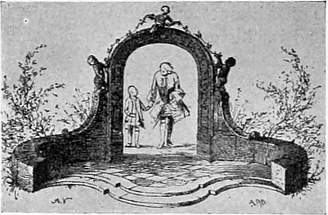 |
| MENZEL. FREDERICK THE GREAT AND HIS TUTOR. |
But it became more revolutionary still for the æsthetic ideas of the time. Menzel had not set himself to produce a sequence of pictures, displaying events and heroes in the most ideal situations possible, but made it his business to sift the entire life of Frederick the Great to its minutest particulars. And here began that philological study of records which Menzel has carried on with the strenuous labour of an archivist down to the present day. Old Fritz had been caught by Chodowiecki in the way in which he has since lived in the popular imagination: as the old man on horseback, with his bent shoulders and his crutch-stick, holding a review, and as the philosopher, the statesman, the warrior and hero in the most manifold situations. Menzel, in whom the spirit of Chodowiecki lived again, only needed to begin where the latter left off. Stepping on the antiquarian material of Chodowiecki, he worked his way into the great period on which Frederick and Voltaire have set the stamp of their spirit, as Mommsen worked his way into Roman history. He read through whole libraries; he copied all attainable portraits. With scientific pedantry he did not forget to study the buttons and the cut of the trousers in the uniforms, and did not rest until he knew the old grenadiers as a corporal knows his men. Using these labours as preparation, he proceeded to call up old Fritz and his time with the objectivity of an historian, just as they were, and not as they had better have been. Sureness of treatment even in the finest details, accurate mastery of the surroundings, and everything which had made Meissonier’s appearance so important for France, was attained at one stroke for Germany. But the very simplicity of what was offered—both in style and technique—prevented Menzel from being at the beginning accepted in his own country as an “historical painter.” He was blamed for disregarding “beauty,” and it was said that a “higher” artistic perception was sealed from him. On the other hand, the book laid the foundation of Menzel’s position in France, and was, moreover, the work on which, for a long time, the appreciation of modern German art in foreign countries was based.
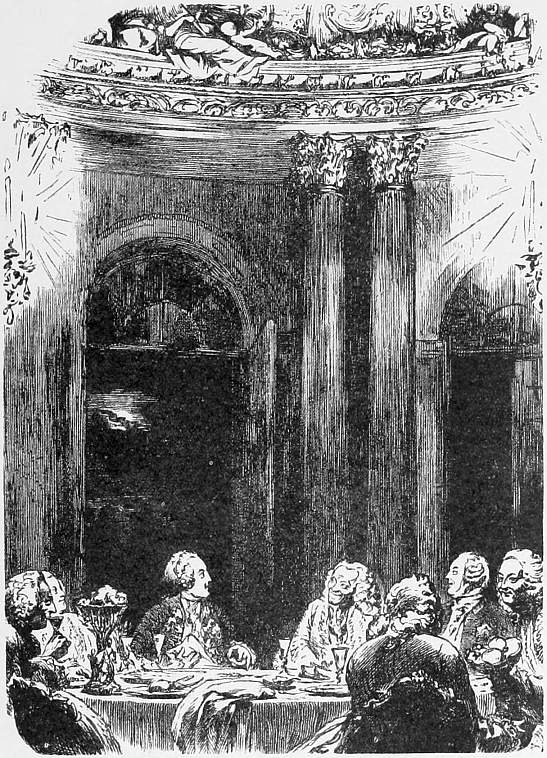 | |
| MENZEL. | THE ROUND TABLE AT SANS-SOUCI. |
Thenceforth Menzel had a kind of monopoly in this subject, and when in 1840 Frederick William IV had the works of the great king published in an édition de luxe, Menzel, amongst others, was entrusted with the illustration. Every one of the thirty volumes contains portraits of Frederick’s contemporaries which were engraved by 381 Mandel and others after original pictures of the period. Menzel had an apparently subordinate task. He was commissioned to make two hundred drawings for wood engraving; these, however, do not appear on separate pages, but were destined to be incorporated in the text as tail-pieces, vignettes, and the like. This was the great work which occupied him during the forties; and in these headings and tail-pieces to the works of Frederick the Great he showed, for the first time, that he was not merely a learned investigator of sources, but was full of brilliant aperçus. 382 One has to read Frederick the Great before one can do full justice to the acuteness and ready resource, the subtlety and pungency of the artist’s pencil. All æsthetic categories of realistic and idealistic art are scattered like dust before these creations, in which the most fantastic ideas are embodied with the whole force of the realistic power of our days.
When he had done honour to the military comrades of the great ruler in his work of wood engraving, “Heroes of War and Peace in the Time of King Frederick,” and thus made the epoch his own through a decade of busy labour, Menzel, draughtsman though he was, turned round and became the painter of Frederick the Great. In the history of art there have never been two names more intimately connected with each other. Menzel was a strenuous worker, who never knew the passion for woman, either because he had no time for it, or because he despised women after being despised by them as a poor, hard-featured student of art; a man whose great bald head appeared at Berlin subscription-balls amid groups of brilliant cavaliers and queens of beauty, fashion, and grace, surrounded by the rustle of their silks and in the whirlpool of a dancing throng, gleaming with colour and sparkling with gold and jewels; and appeared there simply because this world interested him as something to be painted. He was a recluse who went into society solely to make observations for his art, and when there was chary of speech and much feared. He was always a busy experimentalist, so that his two hands gradually became equally dexterous; at the age of eighty he could still sketch with firm and accurate strokes while travelling in a railway carriage.
Though he had hitherto devoted himself to drawing, he had also by his own independent study made himself familiar with the technique of oils; and he now became such a master of colour as few were at that time. In the middle of the century were painted those two masterpieces which now hang in the Berlin National Gallery, “The Round Table at Sans-Souci” and “The Concert of Frederick the Great.” These are historical pictures, the authority and importance of which cannot be shaken by even the most modern of critics. If what is called the spirit of an age has ever been embodied in pictures, it is embodied here, where the master-minds of the eighteenth century are assembled at their genial round table. The scene is the oval dining-room of the castle. The meal is over, and there reigns a genial after-dinner mood, champagne sparkles in the glasses and a smart rivalry of wit is in progress. Afternoon has crept on, and a cold, subdued daylight floods the room, in which every fragment of the architecture, from the inlaid floor to the gilded capitals of the pillars and the stucco of the arched ceiling, every piece of furniture and every chandelier, bears the wayward grace of the high-rococo period; all is comprehended with the most intimate knowledge. In the second picture a fine candlelight is glimmering over the scene. Frederick is just beginning to play the flute, and the musicians of the string quartet pause, to strike in again after the solo. The Court is grouped to the left: the ladies in gilded easy-chairs, and their cavaliers behind them. The tapers of the chandelier and the sconces branching 383 from the wall shed over everything their prismatic, broken light reflected by the mirrors, and fill the fantastic, capricious, graceful, comfortable apartment, here with streaming brightness, there with a finely modulated twilight. Only Menzel could have conjured up in so convincing a manner the brilliancy of this Court festival of the past.
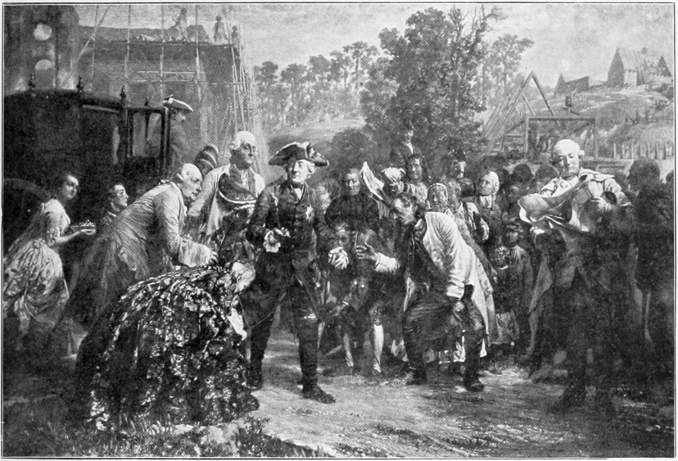 | |
| Hanfstängl. | |
| MENZEL. | FREDERICK THE GREAT ON A JOURNEY. |
Here is that exactness which an historical picture must have if it makes any claim to intrinsic worth. Whilst the ordinary historical painters were content to transmute dressed-up models into types of the universally human, and to put historical labels on their frames, Menzel succeeded in really penetrating a bygone age in an artistic spirit, and in making it live again for the present generation. He did not burrow to discover another dim historical personage every year, but confined himself to one hero—to the figure of the Prussian hero-king, familiar to every child, and still living in the popular imagination; and he learnt to master the time of this favourite hero as if he had been old Fritz himself. Menzel had never heard him blowing on his flute, and never sat at table with him in Sans-Souci, but the painting of these scenes comes out true and life-like in the artist’s work, because the past history of his country had become as vivid to him as his own age. His “Battle of Hochkirch” rises to tragical grandeur, precisely because everything that is outwardly impassioned is far from him. His “Frederick the Great on a Journey,” where the king is inspecting territories alter the war and ordering the rebuilding 384 of demolished houses, his “Frederick’s Meeting with Joseph II in Niesse,” and all the other pictures of the sequence, by their marvellous naturalness and intense vividness, and by their freedom from pompous phrasing, stand alone in an age dominated by empty sentiment. Menzel, who never laid his sketch-book down from the time he was twelve years old, found a subject of pictorial interest in everything that he saw around him, until finally he acquired the power of moving with natural self-possession in a period that was not his own. By the roundabout way through the rococo period he has taught us to understand ourselves. In his pictures an apparently paradoxical problem has been solved. An intense feeling for modern reality waked to new life the past, that same past which no one had approached with success by the way of idealism.
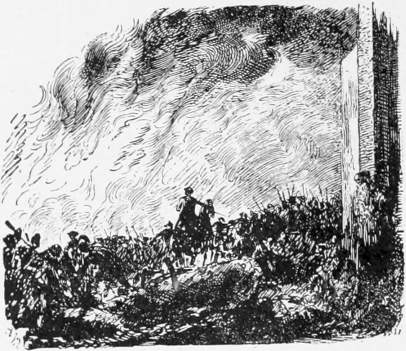 |
| MENZEL. ILLUSTRATION TO KUGLER’S HISTORY OF FREDERICK THE GREAT. |
And if we look over the whole development of modern art it strikes us as a remarkable fact that the most concrete spirits, the most thorough masters of technique, like Meissonier and Menzel, were precisely those who ventured to advance into the present. When they had crossed the province of the rococo period, avoided by all scholastic art, they had arrived again at the epoch when Mengs and David had interrupted the natural course of the history of art, one hundred years before. About 1750 the fateful movement towards the antique had been accomplished; in 1820 the Middle Ages had the upper hand; in 1830 the Cinquecento was in the ascendant with Cornelius and Ingres; in 1840 the seventeenth century was awakened through Delacroix and Wappers; and in 1850, after “the courses of the centuries were sphered”—to use the phrase of Cornelius—Meissonier and Menzel painted things which had not appeared worth representing to the painters of 1750, blinded, as they were, by the glory of the antique. Not less striking is it that the nearer the historical subject came to the present the truer to nature did the picture become, and the more did it outwardly change in its features. It has shrivelled from the huge scale of David and Cornelius to the miniature scale of Meissonier and Menzel, and to some extent it thus leaves its further development to be guessed. At no distant time the historical picture will be overthrown, and the picture from modern life, hitherto but shyly handled and on the smallest scale, will swell to life size. History itself, serious history, clings merely to the rock-bed of old costume. One generation had used it with an abstract purpose as a substratum for philosophical ideas; others had made scenical pieces with its aid; a third generation turned it over for piquant traits and anecdotes. The last and greatest generation had finally come to handle it quite familiarly and humanly and without affected dignity. Their works protested against all idealism; and this expressed itself, in drawing, by their making use of the true instead of the “beautiful” line; in colour, by a fresher tint corresponding with nature rather than with the conventional ideal of beauty.
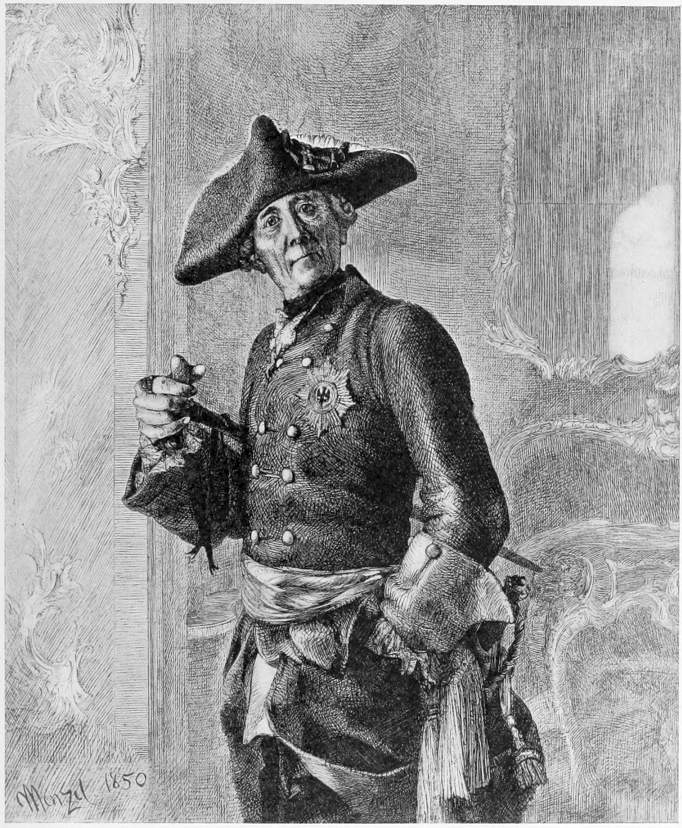 | |
| MENZEL. | PORTRAIT OF FREDERICK THE GREAT. |
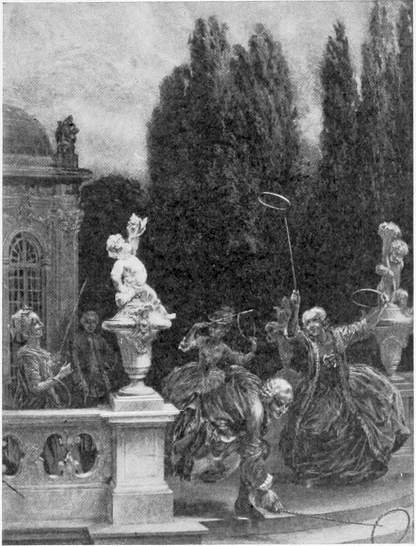 |
| MENZEL. REIFSPIEL. |
Nobility of line was paramount in Gallait and Piloty, movement with grand, kingly gestures, lofty dignity, aristocratic bearing, knightliness, and a conventional piling up of rich stuffs, alluring to the eye. Leys, Menzel, and Meissonier were the first who sacrificed beauty to truth, or, more properly, who perceived that a beauty without truth is not really beautiful. They came gradually and by an indirect way to this knowledge as they studied German and Netherlandish masters instead of the Italians, and set up the angular, natural outlines of the Germans against the grace of the Latin masters, which had become banal through a lengthy course of imitation. And thus a return was made to the manner of our true ancestors, which had been forgotten during half a century. The place of the Antinous heads of Gallait was taken by physiognomies of vigorous characterisation; gesticulating heroes made way for peaceful, quiet persons, who did not consider themselves under an obligation to acquire artistic citizenship by a parade of attitude, but appeared in their picture as they were in reality. Impassioned movement yielded quietly to arms hanging downwards and natural postures. Even the traditional rules of concave and convex composition were broken so that the free play of life might more easily come to its rights. Not less did all three show themselves true painters by preferring 388 rightness of observation and truth and delicacy of reproduction to anecdote and richness of invention, and by feeling the need of painting figures in their real surroundings. Instead of the conventional velvet and brocade stuffs, and the folios everywhere and nowhere in place, the settles and the brass caskets, there was a naturally painted fragment of reality, authentically reflecting the whole atmosphere of the period. The treatment of nature, hitherto idealistic and arbitrary, became synthetic and naturalistic. There was no more abstraction, but direct observation of the man and his milieu. And if, for the time being, this milieu was a rococo milieu, artificially reconstructed so that it could be realistically transferred to the picture, Menzel and Meissonier, even on account of this realism, would have to be reckoned as outposts of the modern tendency, and as having very decided points of contact with it; and this, even if they had not themselves actually become the pioneers of modernity, forcing their way through against the literary and historical movement. It is owing to their works in the past that the preference of the public turned less and less to compositions of fine sentiment, even though grounded on more attentive observation, and that artists began to regard reality as the most important element, the point of departure for every picture. Thus life itself came to be painted, and preparation was made for the coming demand of a new generation, who wished no more to see old heroes, but themselves, in the mirror of art.
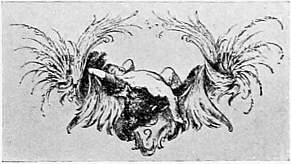 |
| WHEN WILL GENIUS AWAKE? MENZEL. |

BIBLIOGRAPHY
BIBLIOGRAPHY
CHAPTER I
General:
Rouquet: L’état des Arts en Angleterre Paris, 1755.
H. Walpole: Anecdotes of Painting in England. With Illustrations. 5 vols. London, Strawberry Hill, 1762-71. New Edition, London, Ward, Lock & Co., 1879.
James Dalloway: Les Beaux-Arts en Angleterre. Paris, 1807.
Edward Edwards: Anecdotes of Painters who have resided or been born in England. London, 1808.
J. D. Fiorillo, Geschichte der Malerei in Grossbritannien, vol. v. Göttingen, 1808.
W. Carey: Progress of the Fine Arts in England and Ireland during the Reigns of George II, III, IV. London, 1826.
William Fletcher: History of Painting in England. London, 1838.
G. Hamilton: Gallery of English Artists. London and Paris, 1839.
Edward Edwards: The Fine Arts in England. London, 1840.
W. B. Taylor: The Origin, Progress, and Present Condition of the Fine Arts in Great Britain and Ireland. 2 vols. London, 1841.
G. Lombardi: Saggio dell’ Istoria Pittorica d’Inghilterra. Firenze, 1843.
J. Dalloway: Anecdotes of Painting in England, with some Account of the Principal Artists. 3 vols. London, 1849.
John Ruskin: Modern Painters. 5 vols. London, 1851-60.
G. F. Waagen: Treasures of Art in Great Britain. London, 1854.
Prosper Mérimée: Les Beaux-Arts en Angleterre, “Revue des Deux Mondes,” 1857.
T. Silvestre: L’Art, Les Artistes, etc., en Angleterre. London, 1857.
C. de Pesquidoux: L’École Anglaise, 1672-1851. Études biographiques et critiques. Paris, 1858.
Our Living Painters: their Lives and Works. London, 1859.
T. Silvestre: Les Artistes Anglais, “L’Artiste,” vol. vi, p. 81. Paris, 1859.
W. Thornbury: British Artists from Hogarth to Turner. 2 vols. London, 1860-61.
J. Milsand: L’esthétique anglaise. Étude sur M. John Ruskin. Trad. franç. Paris, 1864.
R. and S. Redgrave: A Century of Painters of the English School. 2 vols. London, 1866. New Edition, 1890.
W. F. Rae: The History of Painting in England, “The Fine Arts Quarterly Review,” vol. i, p. 241; vol. ii, p. 64. 1866-67.
W. C. Monkhouse: Masterpieces of English Art, with Sketches of some Deceased Painters of the English School. London, 1869.
F. T. Palgrave: Gems of English Art. Plates. London, 1869.
Sarah Tytler: Modern Painters and their Paintings. London, 1873.
Frederick William Fairholt: Homes, Works, and Shrines of English Artists. London, Virtue & Co., 1873.
Frederick Wedmore: The Rise of Naturalism in English Art, “Macmillan’s Magazine,” March and June 1876.
John Ruskin: Lectures on Art, delivered before the University of Oxford, 1870. London, Macmillan, 1876.
English Painters of the Georgian Era: Hogarth to Turner. Biographical Notices of the Artists. With 48 permanent photographs of their most celebrated pictures. London, Low, 1876.
Frederick Wedmore: Studies on English Art. London, Richard Bentley & Son, 1876.
English Painters of the Victorian Era: Mulready to Landseer. Illustrated with 48 photographs of their most popular works. With biographical notices. London, Low, 1877.
James Dafforne: Modern Art. A series of line engravings from the works of distinguished painters of the English and Foreign Schools, selected from galleries and private collections in Great Britain. 60 plates, with descriptive text by J. D. London, 1877.
Samuel Redgrave: A Dictionary of Artists of the English School. New Edition. London, 1878.
The Reflection of English Character in English Art, “The Quarterly Review,” January 1879.
Allan Cunningham: The Lives of the Most Eminent British Painters. Revised edition, annotated and continued to the Present Time by Mrs. Charles Heaton. 3 vols. London, Bell, 1879.
Frederick Wedmore: Studies on English Art. Second Series. (Romney, David Cox, G. Cruikshank, W. Hunt, Prout, B. Jones, A. Moore.) London, Bentley, 1880.
George H. Shepherd: A Short History of the British School of Painting. London, Sampson Low, 1881.
Living Painters of France and England. Plates. London, 1882.
E. Chesneau: La peinture anglaise. Paris, 1882.
J. Faber: La peinture anglaise. “Fédération artistique,” 1883. 11-15.
N. D’Anvers: An Elementary History of Modern Painting. New Edition. London, Sampson Low, 1883.
Wilfrid Meynell: Some Modern Artists and their Work. (Leighton, Boughton, Tadema, Watts, etc.) With portraits and illustrations. London, Cassell & Co., 1883.
Modern Artists. Illustrated Biographies of Modern Artists, published under the direction of F. G. Dumas. (Leighton, Millais, Herkomer, Hook, etc.) 2 vols. London and Paris, 1882-84.
Feuillet de Conches: Histoire de l’école anglaise de peinture jusqu’à Sir Thomas Lawrence et ses émules. Paris, Leroux, 1883.
H. J. Wilmot-Buxton and S. R. Köhler: English and American Painters. Plates. London, 1883.
John Ruskin: The Art of England. Lectures given in Oxford. Orpington, Kent, 1883-84.
Artists at Home. Photographed by J. R. Mayall. With Biographical Notices by F. G. Stephens. London, 1884.
Lord Ronald Gower; Great Historic Galleries of England. London, Sampson Low.
J. Comyns Carr: Papers on Art. London, Macmillan & Co., 1885. (Contains studies of Reynolds, Gainsborough, Rossetti, etc.)
Allan Cunningham: Great English Painters. Selected Biographies from Allan Cunningham’s Lives of Eminent British Painters. Edited by William Sharp. London, 1886.
J. E. Hodgson: Fifty Years of British Art. (Manchester Exhibition, 1887.) Manchester and London, John Heywood, 1887.
Charles Heaton: A Concise History of Painting. London, Bell & Daldy, 1873. Second Edition, 1888.
The Pictorial Record of the Royal Jubilee Exhibition at Manchester, 1887. By Walter Tomlinson. With special articles by Thomas W. Harris, Charles Estcourt, and Joseph Nodal. Edited by John H. Nodal. With Illustrations. Manchester, 1888.
Walter Armstrong: The Nineteenth Century School in Art, “Nineteenth Century,” April, 1887.
Walter Armstrong: Fine Art at the Royal Jubilee Exhibition at Manchester, 1887. 1888.
William Hoe: English Artists of the Day. A Technical Directory. London, 1888.
William Tirebuck: Great Minds in Art. (Studies of Wilson, Wilkie, Landseer, and others.) London, 1888.
Harry Quilter: French and English Art, “Universal Review,” 1888 and 1890.
W. E. Henley: A Century of Artists. A Memorial of the Glasgow International Exhibition, 1888. With Illustrations. Glasgow, 1889.
Hermann Helferich: Ueber die Kunst in England, “Kunst für Alle,” iv, 1888, pp. 161, 177.
Paul Meyerheim: Die englische Malerie in den letzten 50 Jahren, “Nord und Süd,” 1889, p. 17.
J. A. Crowe, Continental and English Painting, “Nineteenth Century,” April 1890.
T. de Wyzewa: Les grands peintres de l’Espagne et de l’Angleterre. Histoire sommaire de la peinture japonaise. Illustrations. Paris, 1891.
T. H. Shepherd: Short History of the British School of Painting. London, 1891.
Robert de la Sizeranne: La peinture anglaise contemporaine. Paris, 1895.
G. Temple: The Art of Painting in the Queen’s Reign. London, 1898.
Richard Muther: Die englische Malerei im 19 Jahrhundert. Berlin, 1902.
See also H. Thomas Buckle: History of Civilisation in England.
H. Taine: Notes sur l’Angleterre. Paris, 1872.
H. Taine: Histoire de la Littérature Anglaise.
Periodicals: “Art Journal,” “Portfolio,” and “Magazine of Art,” passim.
Hogarth:
W. Hogarth: Analyse de la beauté. 2 vols. Paris, 1805.
John Nichols: Biographical Anecdotes of W. Hogarth. London, 1781. Second Edition, 1785.
G. C. Lichtenberg: Erklärung der Hogarth’schen Kupferstiche, mit verkleinerten Copien derselben v. Riepenhausen. Göttingen, 1794-1831.
W. Hogarth: Complete Works, Including the Analysis of Beauty. London, 1837.
Francis Wey: W. Hogarth. Londres il y a cent ans. Paris, 1859.
J. Hannay: Complete Works of Hogarth. Plates. London, 1860.
G. A. Sala: W. Hogarth, Painter, Engraver, and Philosopher. Illustrations. London, 1866.
C. Justi: W. Hogarth, “Zeitschrift für bildende Kunst,” vii, 1872.
A. Dobson: Hogarth. London, Low, New and Enlarged Edition, 1903. (Illustrated Biographies of Great Artists.)
Th. Gautier: Guide de l’amateur, 1882.
Hogarth’s Shrimp Girl, “Portfolio,” 1886, p. 105.
F. Rabbe in the compilation, “Les artistes célèbres.”
Reproductions:
The Original and Genuine Works of W. Hogarth. Atlas fol. London, 1790.
Graphic Illustrations of Hogarth: from Pictures, Drawings, etc. 2 vols. Royal 8vo. London, 1794-99.
The Works of W. Hogarth: from the original plates, restored by James Heath, R.A. Atlas fol. London, 1822.
The Works of W. Hogarth: reproduced from the original engravings in permanent photographs. With an Essay on Hogarth by Charles Lamb. 2 vols. Royal 8vo. London, 1872.
J. Ireland and J. Nichols: Hogarth’s Works, with Life and Anecdotal Descriptions of his Pictures. 3 vols. London. No date.
Reynolds:
J. Northcote: The Life of Sir Joshua Reynolds. London. 1818.
Joseph Farrington: Memoirs of Sir Joshua Reynolds, with some Observations on his Talent and Character. London, 1839.
Edm. Wheatley: A Descriptive Catalogue of all the Prints, etc., from Original Portraits and Pictures by Sir Joshua Reynolds. London, 1825. New Edition, 1850.
Th. Reynolds: Life of Joshua Reynolds, by his Son. London, 1839.
Joshua Reynolds: Discourses on the Fine Arts. Edinburgh, 1840.
Joshua Reynolds: Discourses, illustrated by Explanatory Notes and Plates by J. Burnet. London, 1842.
Edm. Malone: The Literary Works of Sir Joshua Reynolds. Seven Editions. London, 1794-1824. New Editions by H. W. Beechey. London, 1846 and 1851.
W. Cotton: Sir Joshua Reynolds and his Works, edited by John Burnet. London, 1856. New Edition, 1859.
J. Timbs: Anecdotal Biography. (Hogarth, Reynolds, etc.) 1860.
Ch. Rob. Leslie and Tom Taylor: Life and Times of Sir Joshua Reynolds. London, 1865.
Reynolds and the Portrait Painters of the Last Century: “Blackwood’s Magazine,” November 1867.
Sidney Colvin: Joshua Reynolds, “Portfolio,” 1873, pp. 66-82.
J. C. Collins: Sir Joshua Reynolds as a Portrait Painter. An Essay, with 20 Portraits. London, 1874.
Edw. Hamilton: A Catalogue Raisonné of the Engraved Works of Joshua Reynolds, 1755-1820. London, 1874.
Frederick Wedmore: Sir Joshua Reynolds, “Temple Bar,” July 1876.
F. S. Pulling; Sir Joshua Reynolds. London, Sampson Low, 1880.
Th. Gautier; Guide de l’amateur, 1882.
F. G. Stephens: English Children as painted by Sir Joshua Reynolds. London, 1884.
Th. Duret: Sir Joshua Reynolds et Gainsborough aux expositions de la Royal Academy et de la Grosvenor Gallerie, “Gazette des Beaux Arts,” 1884, i 327. (The same reprinted and enlarged. Paris, 1885.)
Various articles in the “Athenæum,” 1883 and 1884.
Helen Zimmern: Sir Joshua Reynolds, in “Westermanns Monatsheften,” May 1884.
William Martin Conway: The Artistic Development of Reynolds and Gainsborough. London, Seeley & Co., 1886.
Ernest Chesneau: Joshua Reynolds. With 18 Illustrations. Paris, 1887 (in the compilation “Les artistes célèbres”).
Lady Blennerhasset: Joshua Reynolds’ Discourses, “Allgemeine Zeitung,” 1889.
Ed. Leisching: Zur Aesthetik u. Technik der bildenden Künste. Akademische Reden von Sir J. R., Uebersetzt u. mit Einleitung, Anmerkungen, Register u. Textvergleichung versehen von Dr. E. L. Leipzig, 1893.
C. Phillips: Sir Joshua Reynolds. With 9 Illustrations from Pictures by the Master. London, 1894.
W. Armstrong: Sir Joshua Reynolds. With 78 Photogravures and 6 Lithographic Facsimiles in colour, 1900; Popular edition, with 52 Plates. London, 1905.
Lord Ronald Gower: Sir Joshua Reynolds. His Life and Art (with Illustrations). British Artists’ Series, 1902.
J. Sime: Reynolds. London, 1904.
F. Benoit: Reynolds. Paris, 1904.
Gainsborough:
Rob. Pratt: Sketch of the Life and Paintings of Thomas Gainsborough. London, 1788.
George William Fulcher: Life of Thomas Gainsborough. London, 1856.
Sidney Colvin: Thomas Gainsborough, “Portfolio,” 1872, pp. 169, 178.
J. Comyns Carr: Thomas Gainsborough, “The English Illustrated Magazine,” December 1884.
George M. Brock-Arnold: Gainsborough. London, Sampson Low, 1889.
Walter Armstrong in the compilation, “Les artistes célèbres.”
Mrs. Bell: Thomas Gainsborough: a Record of his Life and Works, with Illustrations, etc. London, 1897.
W. Armstrong: Gainsborough and his Place in English Art. With 62 Photogravures and 10 Lithographic Facsimiles in colour. London, 1898. Popular edition (with 48 Plates), 1904.
Lord Ronald Gower: Thomas Gainsborough (with Illustrations). British Artists’ Series, 1903.
Reproductions:
Studies of Landscapes by Thomas Gainsborough. Engraved from the Originals by L. Francia. London, 1810.
Studies of Figures by Gainsborough, in exact imitation of the originals, by Richard Lane. London, 1825.
Selected Works of Thomas Gainsborough. One hundred engravings in mezzotint. Fol. London, 1876.
Wilson:
The Works of Richard Wilson, R.A., Landscape Painter. A volume of engravings. Fol. No date.
T. Wright: Some Account of the Life of Richard Wilson. London, 1824.
CHAPTER II
General:
Georg Brandes: Hauptströmungen der Literatur des 19 Jahrhunderts, Bd. i, 2 Aufl. Leipzig, 1887.
Wilhelm Weigand: Essays. (Voltaire, Rousseau, zur Psychologie des 19 Jahrhunderts, etc.) München, 1892.
Goya:
Théophile Gautier: Cabinet de l’amateur, 1842.
Laurent Matheron: Biographie de Fr. Goya. Paris, 1858.
Carderera: “Gazette des Beaux Arts,” 1860 and 1863.
P. Lefort: “Gazette des Beaux Arts,” 1867.
Charles Yriarte: Goya, sa biographie, etc. Paris, 1867.
D. F. Zapater y Gomez: Goya, noticias biograficas. Zaragoza, 1868.
Paul Lefort: “Gazette des Beaux Arts,” 1875, ii 506; 1876, i 336; ii 500. Reprinted and enlarged under the title of Francisco Goya, Étude biographique et critique, suivie de l’essai d’un catalogue raisonné de son œuvre gravé et lithographié. Paris, 1877.
Charles Yriarte: Goya, Aquafortiste, “L’Art,” 1877, ii 3, 33, 56, 78.
P. G. Hamerton: Fr. Goya, “Portfolio.” 1879, 67-99.
Muñoz y Manzano: Francesco de Goya y Lucientes, “Revista contemporanea,” September 1883.
Lucien Solvay: L’Art Espagnol. Paris, 1887. (Bibliothèque internationale de l’Art.)
Con. de la Viñaza: Goya, su tiempo, su vida, sus obras. Madrid, 1887.
P. Lafond: Goya. Paris, 1902.
W. Rothenstein: Goya (with Illustrations). London, 1900.
Valerian von Loga: Francisco de Goya. Berlin, 1903.
Richard Muther in der Sammlung der Kunst, 1904, Berlin.
More Recent Reproductions:
Los Desastres de la Guerra. Colleccion de 80 laminos. Madrid, 1863.
Los Proverbios. Colleccion de 18 laminos. Madrid, 1864.
Los Caprichos. Gravures fac-similé de M. Segui y Riera. Notice biographique et étude critique par Ant. de Nait. Barcelone, 1887.
French Art in the Eighteenth Century:
Edmond et Jules de Goncourt: L’Art du XVIII siècle. Paris, 1850. 3rd Edition, Paris, 1880.
Edmond et Jules de Goncourt: La femme au XVIII siècle. Paris, 1889.
Charles Blanc: Les Peintres des Fêtes galantes. (Watteau, Lancret, Pater, Boucher.) Paris, 1854.
Arsène Houssaye: Histoire de l’Art Français du XVIII siècle. Portraits. Paris, 1860.
E. B. de la Chavignerie: Les Artistes Français du XVIII siècle oubliés ou dédaignés. Paris, 1865.
A. v. Wurzbach: Die französischen Maler des 18 Jahrh. Stuttgart, 1879.
Auguste Nicaise: L’école française au XVIII siècle. Chalons-sur-Marne, 1883.
Paul Seidel: Friedrich d. Gr. u. die französische Kunst seiner Zeit. Berlin, 1892.
Watteau:
Figures de différents caractères de paysage et d’études dessinées d’après nature par A. Watteau. 2 vols., 350 pl. Paris. No date.
D’Argenville: Abrégé de la vie des plus fameux peintres. Paris, 1762.
Mariette: Abecedario. Published in the archives of French Art by Chennevières. 1852, etc.
Caylus: La vie d’Antoine Watteau. Read on 3rd February 1748 before the Paris Academy. Cited by Goncourt, L’Art du XVIII siècle, 1850.
Julienne in the preface to his book of plates, 1755.
Cellier: Antoine Watteau, son enfance, ses contemporains. Valenciennes, 1867.
Edmond de Goncourt: A. Watteau. Paris, 1860. By the same author, Catalogue raisonné de l’œuvre peint, dessiné et gravé d’A. Watteau. Paris, 1875.
Theodor Volbehr: Antoine Watteau, ein Beitrag zur Kunstgeschichte des 18 Jahrh. München, 1885.
Emil Hannover: A. Watteau. Kopenhagen, 1887. Deutsch von Alice Hannover. Berlin, 1889.
G. Dargenty in “Les artistes célèbres.” Paris, 1889.
Paul Mantz: “Gazette des Beaux Arts,” 1889, i 5, 177, 455; ii 5, 129, 222. Reprinted 1892.
Boucher:
P. Mantz: François Boucher, Lemoyne et Natoire (with engravings from their works). Paris, 1880.
André Michel in “Les artistes célèbres.” Paris, 1889.
Lancret:
G. Dargenty in “Les artistes célèbres.”
Pater:
G. Dargenty in “Les artistes célèbres.”
Fragonard:
Baron Roger Portalis: Honoré Fragonard, sa vie et ses œuvres. Paris, 1887.
Felix Naquet in “Les artistes célèbres.” 1893.
C. Mauclair: Fragonard, Biographie critique illustrée de vingt-quatre reproductions hors texte (Les Grands Artistes, etc.), 1904.
Baudouin:
Ch. Normand in “Les artistes célèbres.” Paris, 1892.
Greuze:
Edmond et Jules de Goncourt: L’Art du XVIII siècle.
Charles Blanc: Histoire de peintres des toutes les écoles, ii.
Jules Renouvier: Histoire de l’Art pendant la Révolution, p. 517.
Charles Normand in “Les artistes célèbres.” Paris, 1892.
Quentin La Tour:
Clement de Ris: L’œuvre de Maurice Quentin de Latour, “Gazette des Beaux Arts,” 1882, ii 251.
Champfleury in “Les artistes célèbres.” Paris, 1886.
H. Lapauze. With 87 Plates. Paris, 1885. La Tour et son œuvre au Musée de Saint-Quentin, 1905.
Liotard:
F. Guye: Jean Étienne Liotard, 1702-91. Zofingen, 1890.
Chardin:
Edmond et Jules de Goncourt: L’Art du XVIII siècle.
G. Dargenty: “L’Art,” 1883, ii 3.
H. de Chennevières: Chardin au Musée du Louvre, “Gazette des Beaux Arts,” 1889, i 121.
Charles Normand in “Les artistes célèbres.” Paris, 1892.
G. Schéfer: Chardin ... Biographie critique illustrée de vingt-quatre reproductions hors texte (Les Grands Artistes, etc.), 1904.
Cornelis Troost:
A Ver Huell: Cornelis Troost en zÿn Werken. Arnhem, 1873.
Changes of Taste in Germany:
Hermann Hettner: Literaturgeschichte des 18 Jahrhunderts, Bd. iii. Braunschweig, 1879.
Chodowiecki:
W. Engelmann: Daniel Chodowieckis sämmtliche Kupferstiche. Leipzig, 1857.
Alfred Woltmann: Hogarth und Chodowiecki. From Vier Jahrhunderte niederländisch-deutscher Kunstgeschichte. Berlin, 1878.
Ferdinand Meyer: Daniel Chodowiecki der Peintre-graveur. Berlin, 1888.
W. von Oettingen. Berlin, 1895.
L Kämmerer: Bd. 21 der Künstlermonographien von Knackfuss. Bielefeld, 1897.
See Selection from the artist’s finest engravings, in photography, by A. Frisch. Berlin, 1885.
D. Chodowiecki: Von Berlin nach Danzig, eine Künstlerfahrt im Jahre 1783. 108 Facsimiledrucke nach Ch.’s Zeichnungen. Berlin, 1883.
Tischbein:
Aus meinem Leben. An Autobiography, published by G. G. W. Schiller. Leipzig, 1861.
Fr. v. Alten: Ans Tischbeins Leben und Briefwechsel. Leipzig, 1872.
Edmond Michel: Étude biographique sur les Tischbein. Lyon, 1881.
Pesne:
Paul Seidel: “Gazette des Beaux Arts,” 1891.
Paul Seidel: Die Berliner Kunst unter Friedrich Wilhelm I. “Zeitschrift für bildende Kunst,” 1888, p. 185.
Anton Graft:
R. Muther: Anton Graff, ein Beitrag zur Kunstgeschichte des 18 Jahrhunderts. Leipzig, 1881.
Julius Vogel: A. G., mit 60 Tafeln. Leipzig, 1898.
Joseph Vernet:
Amedée Durande: Joseph, Carl, et Horace Vernet, Correspondence et biographie. Paris, 1863.
L. Lagrange: J. Vernet et la peinture au XVIII siècle. Paris, 1864.
A. Genevay: “L’Art,” 1876, iii 254, 307; iv 61.
Albert Maire: Les Vernet in “Les artistes célèbres.”
Hubert Robert:
C. Gabillot in “Les artistes célèbres.”
Canaletto:
Rudolph Meyer: Die beiden Canaletti. Dresden, 1878.
Francesco Guardi:
Paul Leroi: “L’Art,” 1878, i 103.
Gessner:
Heinrich Wölfflin: Salomon Gessner. Frauenfeld. 1889.
Oudry und Desportes:
Charles Normand in “Les artistes célèbres.”
Riedinger:
Georg Aug. Wilh. Thienemann: Leben und Wirken J. El. Riedingers. Leipzig, 1856.
CHAPTER III
German Art in General:
Raczynski: Geschichte der neueren deutschen Kunst, übersetzt von K. Hagen. 3 Bde. Text, 1 Bd. Tafeln. Berlin, 1836.
Anton Hallmann: Kunstbestrebungen der Gegenwart. Berlin, 1842.
Théophile Gautier: Les Beaux Arts en Europe, 1855. Paris, 1855.
A. Hagen: Die deutsche Kunst in unserm Jahrhundert. Berlin, 1857.
E. Förster: Geschichte der neueren deutschen Kunst. Leipzig, 1863.
Anton Springer: Die bildende Kunst des 19 Jahrhunderts. Leipzig, 1858.
J. Gérard: Considérations sur l’art allemand, ses principes et tendances à propos de l’exposition de Munich. Bruxelles, 1859.
Hermann Riegel: Geschichte des Wiederauflebens der deutschen Kunst seit Carstens. Hannover, 1876.
Friedr. Pecht: Deutsche Künstler des 19 Jahrhunderts, Studien und Erinnerungen. Nördlingen, Beck, 1877-81.
J. Beavington-Atkinson: The Schools of Modern Art in Germany. With numerous Illustrations. London, Seeley, 1880.
A. F. Graf v. Schack: Meine Gemäldesammlung. Stuttgart, Cotta, 1881. Neue Ausgabe als Einleitung zu den Albertschen Heliogravuren der Galerie Schack. München, 1889.
Kunst und Künstler des 19 Jahrhunderts, unter Mitwirkung von Fachgenossen, herausgegeben von R. Dohme. Leipzig, Seemann, 1881 ff.
D. Duncker, Moderne Meister. Charakteristiken aus Kunst und Leben. Berlin, 1883.
Franz Reber: Geschichte der neueren deutschen Kunst, mit Excursen über die parallele Kunstentwicklung der übrigen Länder. 3 Bde. 3 Aufl. Leipzig, 1884.
Anton Springer: Die Wege und Ziele der gegenwärtigen Kunst, in seinen Bildern aus der neueren Kunstgeschichte. 2 Aufl. Bonn, 1886.
Adolf Rosenberg: Die Münchener Malerschule seit 1871. Leipzig, 1887.
Adolf Rosenberg: Geschichte der modernen Malerei. Bd. 2 und 3, Deutschland. Leipzig, 1888 ff.
Hermann Becker: Deutsche Maler von Carstens bis auf die neuere Zeit. Leipzig, 1888.
L. Pfau in “Kunst und Kritik,” Bd. 1. Stuttgart, 1888, pp. 445-535.
Friedrich Pecht: Geschichte der Münchener Kunst. München, 1889.
Hubert Janitscheks, final chapter in his Geschichte der Deutschen Malerei. Berlin, Grote, 1890.
M. de la Mazelière: La peinture allemande au XIX siècle. Paris, 1900.
Cornelius Gurlitt: Die deutsche Kunst des 19 Jahrhunderts. Berlin, 1899.
Max Schmid: Kunstgeschichte des 19 Jahrhunderts. Leipzig, 1904.
Friedrich Haack: Die Kunst des 19 Jahrhunderts. Stuttgart, 1905.
Periodicals chiefly: “Zeitschrift für bildende Kunst,” Leipzig, 1866. “Die Kunst für Alle,” München, 1886. “Die Kunst unserer Zeit” (specially the work of H. E. v. Berlepsch and Corn. Gurlitt), München, 1890. “Der Kunstwart,” Dresden, 1887. “Die Gegenwart” (articles by Floerke, Lichtwark, Gurlitt, etc.), Berlin, 1872 ff. “Die Nation” (articles by Helferich, Elias, etc.), Berlin, 1883 ff. “Die Freie Bühne” (articles by Helferich, B. Becker, etc.), Berlin, 1888 ff. “Die preussischen Jahrbücher” (articles by Carl Neumann, etc.). All cited in particular in the appropriate place.
The Classical Reaction:
Hermann Helferich: Classicität, “Freie Bühne,” 1890.
Carl Neumann: Christian Rauch, Betrachtungen über Ursprung und Anfänge der modernen deutschen Plastik, “Preuss. Jahrbücher,” Bd. 64, 1889.
Heinr. v. Stein: Die Entstehung der neueren Aesthetik. Stuttgart, 1886.
The Theories of Gérard de Lairesse:
Carl Lemcke in his Study of Adriean van der Werff in “Kunst and Künstler Deutschlands und der Niederlande,” vol. ii. Leipzig, 1878.
Winckelmann:
Carl Justi: Winckelmann, sein Leben, seine Werke, seine Zeitgenossen. Bd. 1, Leipzig, 1866; Bd. 2, Leipzig, 1872.
The Influence of Archæological Studies upon Art:
K. Bernh. Stark: Handbuch der Archaeologie, Bd. 1. Leipzig, 1879.
Lessing:
Danzel-Guhrauer: Lessings Leben und Werke. Leipzig. No date.
Heinr. Fischer: Lessings Laokoon und die Gesetze der bildenden Kunst. Berlin, 1887.
Goethe’s Relations to the Plastic Arts:
H. Hettner: Goethes Stellung zur bildenden Kunst seiner Zeit, “Westermanns Monatshefte,” 20, 83.
H. Hettner in his “Deutsche Literaturgeschichte,” ii 457.
R. v. Eithelberger: Goethe als Kunstschriftsteller, in seinen gesammelten kunsthistorischen Schriften. Wien, 1884. Bd. 3, pp. 221-261.
Gustav Ebe: Goethes Beziehungen zur bildenden Kunst, “Gegenwart,” xxvii. Heft 16 und 18.
C. Urlichs: Ueber Goethes Verhältniss zur alten Kunst. “Goethe-Jahrbuch,” iii.
Hermann Uhde: Goethe, J. G. Quandt und der sächsische Kunstverein. Stuttgart, Cotta, 1877.
A. Heusler: Goethe und die italienische Kunst. Basel, Reich, 1891.
E. Dobbert: Goethe und die Berliner Kunst, “Nationalzeitung,” 1891, 1 und 3 Febr.
Bode: Goethes Asthetik. Berlin, 1901.
Julius Vogel: Aus Goethes römischen Tagen. Leipzig, 1906.
Mengs:
Bianconi: Elogio storico del Cavaliere Anton R. Mengs. Pavia, 1759.
Mengs: Gedanken über die Schönheit und über den Geschmack in der Malerei. Zürich, 1765. Seine sämmtlichen hinterlassenen Schriften. Bonn, 1843-44.
Franz Reber in “Kunst und Künstler Deutschl. u. der Niederlande,” 1878.
Friedrich Pecht: “Zeitschrift für bildende Kunst,” xiv, 1879, pp. 33 u. 72.
Woermann: “Zeitschrift für bildende Kunst,” 1894.
Angelica Kauffmann:
Giov. Gher. de Rossi: Vita di Angelica Kauffmann. Firenze, 1810. German by A. Weinhart, Bregenz, 1814.
J. E. Wessely in “Kunst und Künstler Deutschlands und der Niederlande,” 1878.
A. W. Grube: Angelika Kauffmann. Bregenz, 1889.
Wilh. Schram: Die Malerin Angelika Kauffmann. Brünn, 1890.
Fr. A. Gérard: Angelica Kauffmann. London, 1892.
See also F. Guhl: Die Frauen in der Kunstgeschichte. Berlin, 1858.
Oeser:
Alphons Dürr: A. F. Oeser, Ein Beitrag zur Kunstgeschichte des 18 Jahrh. Leipzig, Dürr, 1879.
Carstens:
Karl Ludwig Fernow: Leben des Künstlers J. A. Carstens. Leipzig, 1806. Neuherausgegeben von Hermann Riegel. Hannover, 1867.
Hermann Grimm: Ausgewählte Essays zur Einführung in das Studium der neueren Kunst. 2 Aufl. Berlin, 1883, p. 216.
F. v. Alten: A. F. Carstens. Schleswig, 1865.
H. Grimm: Ueber Künstler und Kunstwerke, i. Berlin, 1865, pp. 73-95.
Schöne: Beiträge zur Lebensgeschichte des Malers Carstens. Leipzig, 1866.
Fr. Eggers: Vier Vorträge aus der neueren Kunstgeschichte. Berlin, 1867, p. 1.
Carstens’ Werke, in Kupferstichen von W. Müller, herausgegeben von Hermann Riegel. Leipzig, Bd. 1, 1869; Bd. 2, 1874; Bd. 3, 1884.
Jul. Lange: Nutids Kunst. Kopenhagen, 1873, pp. 1-15.
Fr. Pauli: A. Carstens. Berlin, 1876.
Hermann Riegel: Kunstgeschichtliche Vorträge und Aufsätze, p. 200, “Carstensiana.” Braunschweig, 1877.
Alfr. Woltmann, from Vier Jahrhunderte niederländisch-deutscher Kunstgeschichte. Berlin, 1878, p. 169.
Fr. Pecht: Deutsche Künstler des 19 Jahrhunderts. III Reihe. Nördlingen, 1881, p. 31 ff.
August Sach: Asmus Jacob Carstens’ Jugend und Lehrjahre nach urkundliche Quellen. Halle, 1881.
D. Schnittgen: A. J. Carstens, “Christliches Kunstblatt,” 1882, 12.
Hermann Lücke in “Kunst und Künstler des 19 Jahrh.” Leipzig, 1886.
The Painter Müller:
C. Seuffert: Maler Müller. Berlin, 1877.
Sauer in “Deutscher Nationallitteratur,” Bd. 81.
Müller’s article against Carstens is in Schiller’s Horen, 1797, iii 21, iv 4.
Luise Seidler:
Hermann Uhde: Erinnerungen aus dem Leben der Malerin Luise Seidler, aus handschriftliche Nachlass zusammengestellt und bearbeitet, 2 Auflage. Berlin, Hertz, 1876.
Wächter:
Dav. Friedr. Strauss: Kleine Schriften. Leipzig, 1862, pp. 333-360.
A. Haakh: Beiträge aus Württemberg zur neueren deutschen Kunstgeschichte. Stuttgart, 1863, pp. vii ff., 10 ff., 133 ff.
Schick:
Dav. Friedr. Strauss: Kleine Schriften, pp. 361-396.
Fr. Eggers: “Deutsches Kunstblatt,” 1858, pp. 129-137.
A. Haakh: Beiträge aus Württernberg zur neueren deutschen Kunstgeschichte, pp. xiv ff., 23-31, 59-312.
H. Kindt: Zu Gottlieb Schicks 100 jährigem Geburtstag. Gegenwart, 1879, 31.
Winterlin: Württenbergische Künstler. Stuttgart, 1895.
Genelli:
H. Riegel: Deutsche Kunststudien. Hannover, 1868, pp. 291 ff.
M. Jordan: Bonaventura Genelli, “Zeitschrift für bildende Kunst,” v pp. 1-19.
H. Riegel: Kunstgeschichtliche Vorträge und Aufsätze. Braunschweig, 1877, pp. 148-170.
L. v. Donop: Briefe von Bonaventura Genelli und Karl Rahl, “Zeitschrift für bildende Kunst,” xii pp. 25 ii.; xiii pp. 115 ff. Letters from Schwind to Genelli, do. xi p. 11.
Fr. Pecht: Deutsche Künstler des 19 Jahrhunderts, II Reihe. Nördlingen, 1879, pp. 271-304.
A. F. Graf v. Schack: Meine Gemäldesammlung. Stuttgart, 1881, pp. 9-40.
O. Berggruen: Die Gallerie Schack in München. Wien, 1883. Also in “Die graph. Künste,” iv, 1881, 1.
O. Baisch: Einzelheiten aus Genellis Leben und Briefwechsel, “Zeitschrift für bildende Kunst,” xviii pp. 257-262.
CHAPTER IV
French Art in General:
Charles Blanc: Histoire des peintres français au XIX siècle. Paris, 1845.
Gustave Planché; Portraits d’artistes. Paris, 1853.
Gustave Planché: Études sur l’école française, 1831-52. Paris, 1855.
A. de la Forge: La Peinture contemporaine en France. Paris, 1856.
T Silvestre: Histoire des Artistes vivants français et étrangers. Paris, 1857.
Théodore Pelloquet: Dictionnaire de poche des Artistes contemporains. Paris, 1858.
L. Laurent-Pichat: L’Art et les Artistes en France. Paris, 1859.
Moritz Hartmann; Bilder und Büsten. Frankfurt-am-Main, 1860.
Ch. Lenormant: Beaux Arts et Voyages. Paris, 1861.
Olivier Merson: La Peinture en France. Paris, 1861.
E. Chesneau: La Peinture Française au XIX siècle. Les Chefs d’École, L. David Gros, Géricault, Decamps, Meissonier, Ingres, H. Flandrin, E. Delacroix. Paris, 1862. New Edition, Paris, 1883.
Charles Blanc: Histoire des peintres de toutes les écoles. Paris, 1861-76.
L. Pfau: Französische Maler und Bilder, in “Freie Studien.” Stuttgart, 1866. Enlarged in “Kunst und Kritik,” Bd. 1, pp. 115-444. Stuttgart, 1888.
Charles Clement: Études sur les Beaux Arts en France. Paris, 1865. Second Edition, 1867.
Julius Meyer: Geschichte der modernen französischen Malerei seit 1789. Leipzig, 1867.
Julius Meyer: Die französische Malerei seit 1848, “Zeitschrift für bildende Kunst,” ii pp. 13, 32, 56, 119. Leipzig, 1867.
A. Bonnin: Études sur l’art contemporain. Les Écoles françaises et étrangères en 1867. Paris, 1868.
P. G. Hamerton: Contemporary French Painters. London, 1868.
H. O’Neil: Modern Art in England and France. London, 1869.
P. G. Hamerton: Painting in France. London, 1869.
W. B. Scott: Gems of French Art, with an Essay on the French School. Plates. London, 1871.
M. Chaumelin: L’Art contemporain. La Peinture à l’Exposition universelle de 1867. Salon de 1868, 1869, 1870. Paris, 1873.
Th. Gautier: Portraits contemporains. Paris, 1874.
Pierre Petroz: L’Art et la critique en France depuis 1822. Paris, 1875.
L. Dussieux: Les Artistes français à l’étranger. Paris, Lecoffre fils et Cie, 1876.
R. Ménard: French Artists of the Present Day. Notices of some Contemporary Painters. 12 engravings. London, 1876.
Charles Blanc: Les Artistes de mon temps. Paris, 1876.
Jules Claretie: L’Art et les Artistes Français contemporains, avec un avant-propos sur le Salon de 1876. Paris, 1876. Deuxième série, Paris, 1881.
Philippe Burty: Maîtres et petits maîtres. Paris, 1877.
Marquet de Vasselot: Recherches sur l’art français. Architecture, Peinture, Sculpture. Paris, 1878.
Lucien Double: Promenade à travers deux siècles et quatorze salons. Paris, 1878.
G. Berger: L’école Française de Peinture. Paris, 1879.
Victor Champier: Les Beaux Arts en France et à l’Étranger. Paris, 1879.
E. Bellier de la Chavignerie et L. Auvray; Dictionnaire générale des Artistes de l’École Française. Paris, 1880.
Ernest Chesneau: Peintres et Statuaires Romantiques. Paris, 1880.
Maurice du Seigneur: L’Art et les artistes au Salon de 1880. Paris, 1880.
Marquet de Vasselot: Histoire du Portrait en France. Paris, 1880.
George Lafenestre: L’Art vivant, la Peinture et la Sculpture aux Salons de 1868 à 1877. Paris, 1881.
E. Leclerq: Caractères de l’École française moderne de Peinture. Paris, 1881.
F. Gosselin: Histoire anecdotique des Salons de peinture depuis 1673. Paris, Dentu, 1881.
L. de Pesquidoux: L’Art au XIX siècle. L’Art dans les deux mondes, Peinture et Sculpture. 2 vols. Paris, 1881.
Eugène Montrasier. Les artistes modernes: 1. Les peintres de genre; 2. Les peintres militaires et les peintres de nu. 40 Biogr., 40 Tables. 2 vols. Paris, 1881.
Adolf Rosenberg: Geschichte der modernen Kunst. 1 Abtheilung. Die franz. Kunst Leipzig, 1882.
H. Houssaye: L’Art français depuis dix ans. Paris, 1882.
Henri de Clenzion: L’Art national en France. Paris, 1882-83.
F. Henriet: Peintres contemporains. Paris, A. Levy, 1883.
Raf. Sinset et Jules d’Auriac: Histoire du Portrait en France. Paris, 1884.
V. Fournal: Les artistes contemporains français, peintres, sculpteurs. With 176 Illustrations. Tours, Mame et fils, 1884.
Jean Gigoux: Causeries sur les artistes de mon temps. Paris, 1885.
Albert Wolff: La capitale de l’Art. Second Edition. Paris, 1886.
Victor d’Halle: Histoire de la peinture en France. Paris, 1886.
Paul Marmottan: L’école française de peinture (1789-1830). Paris, 1886.
J. Comyns Carr: Art in Provincial France. 1883.
Henri Jouin: Maîtres contemporains. Paris, 1887.
Charles Bigot: Peintres français contemporains. Paris, 1888.
C. H. Stranahan: A History of French Painting. New York, 1888.
La peinture française à l’exposition centennaire de 1889. Ouvrage publié sous la direction de Antonin Proust. Paris, 1890.
Les Chefs d’œuvres de l’Art au XIX siècle. 5 vols. Paris, 1890 ff.
| 1. L’école française de David à Delacroix, par André Michel. 2. L’école française de Delacroix à H. Regnault, par Alfred de Lostalot. 3. La peinture française actuelle, par Paul Lefort. 4. Les écoles étrangères aux XIX siècle, par Th. de Wyzewa. 5. La Sculpture et la Gravure en France au XIX siècle, par Louis Gonse. |
Richard Muther, Ein Jahrhundert französischer Malerei. Berlin, 1901.
A. Julius Meier-Gräfe: Der Entwichlungsgeschichte der modernen Kunst. (With Illustrations and a volume of Plates.) Stuttgart, 1904.
Periodicals specially to be noted: “Gazette des Beaux Arts,” Paris, 1865. “L’Art,” Paris, 1875.
The Art of the Revolution Period:
Jules Renouvier: Histoire de l’art pendant la revolution. Paris, 1863.
Edmond et Jules de Goncourt: Histoire de la société française pendant la révolution. Paris, 1854. New Edition, 1889.
Edmond et Jules de Goncourt: Histoire de la société française pendant le Directoire. Paris, 1855.
Anton Springer: Die Kunst während der französischen Revolution, Bilder aus der neueren Kuntsgeschichte. Bonn, 1886.
Paul Marmottan: L’école française de peinture 1789-1850. Paris, 1886.
Carl v. Lützow: Die französische Kunst vor 100 Jahren, “Zeitschrift für bildende Kunst,” xxiv, 1889, p. 181.
Madame Vigée-Lebrun:
Her Autobiography: Souvenirs de ma vie. Paris, 1835-37.
Sophia Beale: Elisabeth Louise Vigée-Lebrun, “Portfolio,” 1891, 89.
Charles Pillet in “Les artistes célèbres.” Paris, 1892.
Vien:
H. Cozik: Vien, sa vie et ses œuvres. Paris. No date.
Elie Roy: Vien et son temps. Paris. No date.
David:
P. A. Coupin: Essai sur J. L. David. Paris, 1827.
E. J. Delécluze: Louis David. Paris, 1855.
Jules David: Le peintre Louis David (1748-1825), souvenirs et documents inédits. Paris, Havard, 1879.
C. A. Regnet in “Kunst und Künstler Spaniens, Frankreichs, und Englands.” Leipzig, 1880.
G. Nieter: Le peintre David, “Revue générale,” March 1881.
“L’Art,” 1889, ii p. 46.
C. Brun: Louis David und die französische Revolution. Zürich, 1886.
Charles Normand in “Les artistes célèbres.”
L. Rosenthal: David. Paris, 1904.
CHAPTER V
The Parallel Movement in Literature:
Georg Brandes, Haupströmungen der Literatur des 19 Jahrhunderts. Vol. ii, Die deutsche romantische Schule. Leipzig, 1887.
Georg Haim: Die romantische Schule. Berlin, 1871.
Hermann Hettner: Die romantische Schule in ihrem Zusammenhang mit Goethe und Schiller. Braunschweig, 1850.
On the Nazarenes in General:
Veit Valentin in “Kunst und Künstler des 19 Jahrh.” Leipzig, 1886.
Alfred Woltmann: Cornelius und seine Genossen in Rom. Aus Vier Jahrhunderte, etc. Berlin, 1878, pp. 208 ff.
Fr. Haack: Die deutschen Romantiker in der bildenden Kunst des 19 Jahrhunderts. Erlangen, 1901.
Overbeck:
A. v. Zahn: “Zeitschrift für bildende Kunst,” vi, 1871, pp. 217-235.
J. R. Beavington-Atkinson, Overbeck (Great Artists). London, Low, 1882.
Margaret Howitt: Friedrich Overbeck. Sein Leben u. Schaffen, etc. 1886.
Amongst minor works: J. N. Sepp: Friedrich Overbeck, Gedächtnissrede. Augsburg, 1869.—Franz Binder: Zur Erinnerung an Friedrich Overbeck. München, 1870.—H. Holland: Zu Friedrich Overbeck’s Heimgang, 1870.—G. Fr. v. Hertling: Zur Erinnerung an Friedrich Overbeck. Köln, 1875.
Führich:
Autobiography in the “Libussa.” Prag, 1844. New Edition, Vienna, Sartori, 1876.
R. Zimmermann: “Zeitschrift für bildende Kunst,” vii, 1868, pp. 189, 209.
F. Pecht: Deutsche Künstler des 19 Jahrh., iii. Nördlingen, 1881, pp. 64-108.
Lucas v. Führich: “Graphische Künste,” viii pp. 1-16, 25-64. Also separate.
C. v. Lützow, from Führichs Nachlass, “Zeitschrift für bildende Kunst,” xvii, 1882, p. 33.
Die Führich-Ausstellung in Frankfurt: “Zeitschrift für bildende Kunst,” 1885, xx, Beiblatt, 32.
L. R. von Kurz: T. von Führich. Graz, 1902.
Veit:
Veit Valentin: Kunst, Künstler, und Kunstwerke; also in “Zeitschrift für bildende Kunst,” xv 2.
Martin Spahn: Philipp Veit. (With 92 Illustrations.) Bielefeld, 1901.
The Frescoes in the Casa Bartholdy:
L. v. Donop: Die Wandgemälde der Casa Bartholdy in der Nationalgalerie. Berlin, 1888.
Steinle:
O. Berggruen: Die Galerie Schack, “Graph. Künste,” iv. 3 and 4.
Constantin v. Wurzbach: Ed. Steinle, ein Madonnenmaler unserer Zeit. Biographische Studie. Wien, 1879.
Veit Valentin: “Zeitschrift für bildende Kunst,” 1888, xxiii 1 and 33.
L. Christiani: Plaudereien über Kunstinteressen der Gegenwart. Berlin, 1871.
A. Reichensperger: Erinnerungen an Steinle. Frankfurt, 1887.
A. M. von Steinle: E. von Steinle und August Reichensperger. Köln, 1890.
Reproductions:
Ausgewählte Werke E. v. Steinles. Frankfurt, 1888.
Ed. Steinles Bilder zu Parcival. Frankfurt, 1884.
Schnorr:
M. Jordan: Aus Julius Schnorrs Lehr-und Wanderjahren, “Zeitschrift für bildende Kunst,” 1867, pp. 1 ff.
H. Riegel, “Kunstgeschichtliche Vorträge und Aufsätze.” Braunschweig, 1877, pp. 210-248.
M. Jordan: Ausstellung von Werken Julius Schnorrs in der Berliner Nationalgalerie, 1878.
Veit Valentin in “Kunst und Künstler des 19 Jahrhunderts.”
Friedrich Haack in “Das 19 Jahrhundert in Bildnissen.” Berlin. Photographische Gesellschaft, 1901.
Briefe aus Italien von Julius Schnorr v. Carolsfeld, geschrieben in den Jahren 1817-1827.
Ein Beitrag zur Gesch. seines Lebens und der Kunstbestrebungen seiner Zeit, herausgegeben von Franz Schnorr v. Carolsfeld. Gotha, 1886.
Compare “Bibel in Bildern.” Leipzig, 1852-62.
Zeichnungen von Jul. Schnorr v. Carolsfeld, mit Einleitung von Jordan. Leipzig, Dürr, 1878.
CHAPTER VI
The Art of Munich under King Ludwig I.:
Alfred Woltmann, from “Vier Jahrhunderte niederländisch-deutscher Kunstgeschichte.” Berlin, 1878, pp. 260 ff.
Hans Reidelbach: König Ludwig I und seine Kunstschöpfungen. München, 1888.
Cornelius:
Herm. Riegel: Cornelius, der Meister der deutschen Malerei. Hannover, 1866.
M. Carrière: Denkrede auf Cornelius. Leipzig, 1867.
A. Teichlein: Betrachtungen über Riegels Buch, “Cornelius, der Meister der deutschen Malerei,” “Zeitschrift für bildende Kunst,” ii. 1867, pp. 128 ff., 189 ff.
Alfred Frhr. v. Wolzogen: Peter v. Cornelius. Berlin, 1867.
Max Lohde: Gespräche mit Cornelius, “Zeitschrift für bildende Kunst,” III 1, 30, 84. 1868.
W. Lübke: Kunsthistorische Studien. Stuttgart, 1869.
Ernst Förster: Peter Cornelius, ein Gedenkbuch aus seinem Leben und Wirken. 2 vols. Berlin, 1874.
Herm. Grimm: Berlin und P. v. Cornelius (Die Cartons von P. v. Cornelius, Cornelius und die ersten 50 Jahre nach 1800), in “15 Essays.” Berlin, 1875.
V. Kaiser: Cornelius und Kaulbach in ihren Lieblingswerken. Basel, 1876.
Fr. Pecht: Deutsche Künstler des 19 Jahrh., Bd. 1. Nördlingen, 1877.
A. Woltmann, from “Vier Jahrhunderte niederländisch-deutscher Kunst.” Berlin, 1878, pp. 208-259.
Fr. Pecht: P. v. Cornelius. “Gartenlaube,” 1879, 29.
M. Carrière in “Deutscher Plutarch,” Bd. vii. Leipzig, 1880, pp. 1-56.
A. Rosenberg: Cornelius im Lichte der Gegenwart. Grenzboten, 1881, I.
A. Berggruen: Die Galerie Schack, P. v. Cornelius, “Die graph. Künste,” 1881, 4, 2.
Rossmann: Briefe von Peter Cornelius. Grenzboten, 1882, 16.
G. Portig: Die sixtinische Madonna und die Camposanto Cartons von Cornelius. Leipzig, 1882.
V. Valentin in “Kunst und Künstler des 19 Jahrh.” Leipzig, 1883-85.
Herm. Riegel: Peter Cornelius, Festschrift zu des grossen Künstlers 100 Geburtstage. Berlin, 1883.
Carl v. Lützow: Zur Erinnerung an P. v. Cornelius, “Zeitschrift für bildende Kunst,” 19, 1.
Der 100 Geburtstag von Cornelius, “Allegemeine Zeitung,” 1883, B. 130.
Cornelius, ein Maler von Gottes Gnaden. Hamburg, 1884.
H. Grimm: Cornelius betreffend, “Deutsche Rundschau,” March 1884.
L. v. Urlichs: Beiträge zur Kunstgeschichte. Leipzig, 1885, p. 119. Cornelius in München und Rom.
A. Frantz in “Kunst und Literatur.” Berlin, 1888, pp. 1-60.
Kaulbach:
Guido Görres: Das Narrenhaus von W. Kaulbach. München. No date.
Max Schasler: Die Wandgemälde Wilhelm von Kaulbachs im Treppenhause des Neuen Museums zu Berlin. Berlin, 1854.
W. v. Kaulbachs Shakespeare-Galerie, by M. Carrière. Berlin, 1856.
V. Kaiser: Kaulbachs Bilderkreis der Weltgeschichte. Berlin, 1879.
Ed. Dobbert: Die monumentale Darstellung der Reformation durch Rietschel und Kaulbach. “Sammlung gemeinverständlicher wissenschaftlicher Vorträge,” No. 74. Berlin, 1869.
A. Teichlein: Zur Charakteristik W. v. Kaulbachs, “Zeitschrift für bildende Kunst,” xi, 1876, pp. 257-264.
V. Kaiser: Macbeth und Lady Macbeth in Shakespeare’s Dichtungen und in Kunstwerken von Cornelius und Kaulbach. Basel, Schweighauser, 1876.
A. Woltmann, from “Vier Jahrhunderte niederländisch-deutscher Kunstgeschichte.” Berlin, 1878, pp. 288-316.
Fr. Pecht: “Deutsche Künstler des 19 Jahrhunderts,” ii. Nördlin gen, 1879, pp. 54-109.
Kaulbachs Wandgemälde im Treppenhause des Neuen Museums zu Berlin, in Kupfer gestochen von G. Eilers, H. Merz, J. L. Raab, A. Schultheiss. Mit erläuterndem Text herausgegeben unter den Auspicien des Meisters. Neue Ausgabe. Berlin, A. Duncker, 1879.
Hans Müller: W. Kaulbach. Berlin, 1893.
CHAPTER VII
The Düsseldorfers:
W. Schadow: Gedanken über folgerichtige Ausbildung des Malers, “Berliner Kunstblatt,” 1828, pp. 264-273.
A. Fahne: Die Düsseldorfer Malerschule, 1835-36. Düsseldorf, 1837.
H. Püttmann: Die Düsseldorfer Malerschule und ihre Leistungen seit der Errichtung des Kunstvereins in Jahre 1829. Leipzig, 1839.
Fr. v. Uechtritz: Blicke in das Düsseldorfer Künst- und Künstlerleben. Düsseldorf, 1839.
Wolfg. Müller v. Königswinter: Düsseldorfer Künstler ans den letzten 25 Jahren. Leipzig, 1854.
W. v. Schadow: Der moderne Vasari, Erinnerungen aus dem Künstlerleben. Berlin, 1854.
R. Wiegmann: Die königliche Kunstakademie zu Düsseldorf, ihre Geschichte, Einrichtung und Wirksamkeit und die Düsseldorfer Künstler. Düsseldorf, 1854.
J. Hübner: Schadow und seine Schule, Festrede bei Enthüllung des Schadowdenkmals zu Düsseldorf, 1869. Bonn, 1869.
M. Blanckarts: Düsseldorfer Künstler, Nekrologe aus den letzten zehn Jahren. Stuttgart, 1877.
K. Woermann: Zur Geschichte der Düsseldorfer Kunstakademie. Düsseldorf, 1880.
A. Rosenberg: Die Düsseldorfer Schule. Grenzboten, 1881, 1 1 ff.
Mor. Blanckarts: Der Künstlerverein Malkasten in Düsseldorf, “Allgemeine Kunstchronik,” 1883, 47.
A. Rosenberg: Die Düsseldorfer Schule. Leipzig, Seemann, 1886.
Schaarschmidt: Geschichte der Düsseldorfer Kunst, 1902.
Bendemann:
Die Ausstellung der Werke von E. Bendemann in der königliche Nationalgalerie v. 3 Nov. bis 15 Dez. 1890. Berlin, 1890.
L. Bund: Ed. Bendemann, “Illustrirte Zeitung,” 1881, 2014.
Hübner:
M. Blanckarts: “Zeitschrift für bildende Kunst,” 1883, 13.
Reumont, “Archiv. storico italiano,” xi 2.
A. Ehrhardt, “Z. f. Museologie,” 1883, 23, “Allg. Kunstchronik,” 1883, 46.
Mintrop:
Ferd. Laufer: Th. Mintrop, der Ackersknecht und Maler, “Allg. Kunstchronik,” 1883, 32.
CHAPTER VIII
Rethel:
Wolfgang Müller v. Königswinter: Alfred Rethel. Blätter der Erinnerung. Leipzig, 1861.
Friedr. Theodor Vischer: Altes und Neues. Drittes Heft. Stuttgart, 1882, pp. 1-24.
Kaulen: Der Historienmaler A. Rethel, “Deutsches Kunstblatt,” 1883, ii 21.
Veit Valentin: A. Rethel, eine Charakteristik, “Aesthet. Schriften I.” Berlin, 1892.
Max Schmid: Bd. 32 der Künstlermonographien von Knackfuss. Bielefeld, 1898.
Schwind:
L. v. Führich: Moriz v. Schwind, Eine Lebensskizze. Leipzig, 1871.
Ed. Ille: Dem Andenken M. Schwinds. München, 1871.
A. W. Müller: M. v. Schwind. Eisenach, 1871.
Hermann Dalton: “Sechs Vorträge.” St. Petersburg, 1872.
Ludwig Hevesi: M. Schwind. “Gegenwart,” 1872.
H. Holland: M. v. Schwind. Stuttgart, 1873.
A. v. Zahn: Zur Charakteristik M. v. Schwinds, “Zeitschrift für bildende Kunst,” vii 1873, p. 287.
F. Pecht: Deutsche Künstler des 19 Jahrh. Nördlingen, 1877, i 195-231.
Bauernfeld: Moriz Schwind zum Gedächtniss, “Nord und Süd,” iii, 1877, p. 353.
Bernh. Schädel: Briefe von Moriz Schwind, “Nord und Süd,” xiv, 1880, p. 23; xv, 1881, p. 357.
Graf v. Schack: Meine Gemäldesammlung. Stuttgart, 1881, pp. 41-73.
O. Berggruen: Die Galerie Schack. Wien, 1883. Mit Radirungen.
Alph. Dürr: Ein halbvergessenes Werk von Schwind (Wandmalereien in Hohenschwangau) in der Festschrift zu Ehren Anton Springers. Leipzig, 1885, pp. 231-239.
Veit Valentin: Kunst, Künstler, und Kunstwerke. Leipzig, 1888.
Briefwechsel zwischen Schwind u. Ed. Mörike, mitgeth. v. J. Baechtold. Leipzig, 1890.
H. W. Riehl: Studien und Charakteristiken. Stuttgart, 1891.
Friedrich Haack: Bd. 31 der Künstlermonographien von Knackfuss. Bielefeld, 1898.
Otto Grantoff, in “Muthers Sammlung Die Kunst.” Berlin, 1903.
Julius Naue: Worte u. Wirken v. M. von Schwind. (With a Portrait and 3 Illustrations.) München, 1904.
Reproductions:
Aschenbrödel, Bildercyclus von M. v. Schwind. Holzschnittausgabe nach den Theaterschen Stichen, mit Text von H. Lücke. 1873.
Die sieben Raben u. die schöne Melusine, zuletzt unter dem Titel “Deutsche Märchen” bei Neff in Stuttgart erschienen.
Operncyclus im Foyer des k. k. Opernhauses in Wien. 14 Compositionen von Moritz Schwind. Mit Text von Ed. Hanslick. München, 1880.
Almanach von Radirungen mit Erklärungen. Text von Feuchtersleben. Zürich, 1844.
Schwinds Wandgemälde in Hohenschwangau. 46 Compositionen nach den Aquarellentwürfen gestochen von J. Naue und K. Walde. Leipzig.
Schwind-Album. München, 1880.
CHAPTER IX
Gérard:
Charles Lenormant: François Gérard, peintre d’histoire. Essai de biographie et de critique. Paris, 1847.
Adam: L’œuvre du Baron Gérard. Paris, 1852-57.
Correspondance de François Gérard, peintre d’histoire. Publiée par Henri Gérard, son neveu, et précédée d’une Notice sur la vie de Gérard par Adolphe Viollet le Duc. Paris, 1867.
Charles Ephrussi: François Gérard d’après les lettres publiées par M. le baron Gérard, “Gazette des Beaux Arts,” 1890, ii 449. 1891, i 57, 201.
Prudhon (besides Jul. Meyer, Renouvier, and Rosenberg):
Voiart: Notice historique sur la vie et les œuvres de P. P. Prudhon, peintre. Paris, 1824. Quatremère de Quincy: Notice lue à l’Institut, 2 Octobre 1824.
Eug. Delacroix: “Revue des Deux Mondes,” 1857.
Charles Clement (chief work): Prudhon, sa vie, ses œuvres, et sa correspondance, first in 1867-68, then in “Gazette des Beaux Arts,” 1872, with 30 Illustrations. Paris, Didier & Co., 3rd Edition, 1880.
Edm. et J. de Goncourt: L’Art au XVIII siècle. Paris, 1875. New Edition, 1882, vol. ii, p. 385.
Edm. de Goncourt: Catalogue raisonné de l’œuvre peint, dessiné et gravé de Prudhon. Paris, 1876.
Ph. Burty: L’œuvre de P. P. Prudhon, “L’Art,” 1877, i p. 33.
Alfred Sensier: Le Roman de Prudhon, “Revue internationale de l’Art et de la Curiosité,” 15 Dec. 1869.
Arséne Houssaye: Artiste, Janvier-Juin 1877. Article in “L’Art,” 1877, i p. 33.
Charles Gueullette: Mlle. Constance Mayer et Prudhon, “Gazette des Beaux Arts,” 1878, p. 476. 1879, p. 268.
Charles Blanc: Histoire des peintres, vol. iii.
Aug. Schmarsow in “Kunst und Künstler der ersten Hälfte des 19 Jahrhunderts,” published by Robert Dohme, vol. ii. Leipzig, Seemann, 1886.
Pierre Gauthiez: Prudhon in “Les artistes célèbres.” Paris, 1891.
Almost all the works of Prudhon are photographed by Braun of Dornach.
Gros (besides Charles Blanc, Jul. Meyer, and Rosenberg):
Jean Baptiste Delestre (pupil of Gros): Gros, sa vie et ses ouvrages. With Illustrations. 2nd Edition. Paris, 1867.
J. Tripier le Franc: Histoire de la vie et de la mort du baron Gros, le grand peintre. Paris, 1880.
Eugène Delacroix: “Revue des Deux Mondes,” 1848. Also in a separate reprint.
Ernest Chesneau: Les chefs d’école. 3rd Edition, 1883, pp. 58-126.
On Gros’ paintings in the Pantheon: Ph. de Chennevières in the “Gazette des Beaux Arts,” xxiii pp. 168-174.
G. Dargenty: Les Chefs-d’œuvre de Gros, “L’Art,” 1886, ii p. 121, and 1889, ii p. 100.
Richard Graul in “Kunst und Künstler der ersten Hälfte des 19 Jahrhunderts,” vol. 2. Leipzig, Seemann, 1886.
G. Dargenty: Le baron Gros. Paris, 1887, in “Les artistes célèbres.”
The chief pictures of Gros are photographed by Braun of Dornach.
CHAPTER X
On the Parallel Movement in Literature:
Georg Brandes: Die Literatur des 19 Jahrhunderts in ihren Hauptströmungen, 2 Auflage Bd. 5. Leipzig, 1883.
On the Romantic Movement in General:
E. Chesneau: Peintres et statuaires romantiques (Huet, Boulanger, Préault, Delacroix, Th. Rousseau, Millet, etc.). Paris, Charavay frères, 1879.
Géricault:
Charles Blanc: Th. Géricault, 1845.
Charles Clement: Th. Géricault, Étude biographique et critique, avec le catalogue raisonné. Paris, 1868. New Edition, 1879.
Delacroix:
E. Galichon: Les Peintures de M. E. Delacroix à Saint-Sulpice, “Gazette des Beaux Arts,” xi, 1861, p. 511.
Amédée Cantaloube: Eugène Delacroix, l’homme et l’artiste. Paris, 1864.
Henri de Cleurion: L’œuvre de Delacroix. Paris, 1865.
Piron: E. Delacroix, sa vie et ses œuvres. Paris, 1865.
Adolphe Moreau: E. Delacroix et son œuvre. Paris, 1873.
Lettres de E. Delacroix (1815-1863), recueillies et publiées par Phil. Burty. Paris, Quantin, 1879.
Alfred Robaut: Peintures décoratives de E. Delacroix. Le Salon du roi au Palais legislatif. Paris, A. Levy, 1879.
Alfred Robaut: Peintures décoratives de E. Delacroix, “L’Art,” 1880, 279.
M. Vachon: E. Delacroix à l’école des Beaux Arts. Paris, 1885.
Ph. Burty: Eugène Delacroix à Alger, “L’Art,” 1880, 422.
Ernest Chesneau: Eugène Delacroix, “L’Art,” 1882, 382.
Ernest Chesneau: L’œuvre complet de E. Delacroix, commenté par E. Chesneau. Paris, 1885.
G. Dargenty: Eug. Delacroix par lui-même. Paris, 1885.
Henri Guet: L’œuvre de E. Delacroix, “Le Salon” de 1885, etc. Paris, 1885.
Maurice Tourneux: Eug. Delacroix, devant ses contemporains, ses écrits, ses biographes, ses critiques. Paris, 1886. (Bibliothèque internationale de l’Art, Sér. II, vol. vi.)
Véron: Eugène Delacroix. Paris, 1887.
See Eugène Delacroix: Journal de E. D. (With Introductory Study, etc., by M. Paul Flat and René Piot, etc.) 3 vols., 1893-1895. Berlin, 1903.
Ingres:
A. Magimel: Œuvres de J. A. I., gravées par A. Réveil. [102 Copperplates.] Paris, 1851.
Charles Lenormant: Beaux Arts et Voyages. Paris, 1861.
Ernest Chesneau: Les chefs d’école. Paris, 1868, p. 253.
Henri Delaborde: Ingres, sa vie et ses travaux. Paris, 1870.
Charles Blanc: Ingres, sa vie et ses ouvrages. Paris, 1870.
Amaury Duval: L’atelier d’Ingres. Souvenirs. Paris, 1878.
Th. Silvestre: Les artistes français. Paris, 1878, p. 139.
R. Balze: Ingres, son école, son enseignement du dessin: avec des notes recueillies par P. et A. Flandrin, Lehman, Delaborde, etc. Paris, Pillet et Dumoulin, 1880.
Ernest Chesneau: Peintres et statuaires romantiques. Paris, 1880, p. 259.
Eugène Montrosier; Peintres modernes: Ingres, H. Flandrin, Robert Fleury. Paris, Baschet, 1883.
August Schmarsow in “Kunst und Künstler des 19 Jahrhunderts.” Leipzig, 1886.
Jules Mommeja in “Les artistes célèbres.”
CHAPTER XI
Ary Scheffer:
Blanche de Saffray: Ary Scheffer. Paris, 1859.
Antoine Etex: Ary Scheffer, étude sur sa vie et ses ouvrages. Paris, 1859.
Miss Grote: Memoir of the Life of A. Scheffer. 2nd Edition. London, 1860.
L. Vitet: L’œuvre de Ary Scheffer reproduit en Photographie par Bingham. Paris, 1860.
Charles Lenormant: Beaux Arts et Voyages, vol. i. Paris, 1861.
Hofstede de Groot: Ary Scheffer, ein Charakterbild. Berlin, 1870.
M. E. Im-Thurn; Scheffer et Decamps. Nîmes, 1876.
Johannot:
Charles Lenormant: Les Johannot, Beaux Arts et Voyages, vol. i. Paris, 1861.
Flandrin:
F. A. Gruyer: Les Conditions de la Peinture en France et les Peintures Murales de H. Flandrin. Paris, 1862.
J. B. Poucet: Hippolyte Flandrin. Paris, 1864.
A. Galimard: Examen des Peintures de l’Eglise de St. Germain des Prés. Paris, 1864.
Charles Clement: Études sur les Beaux Arts en France. Paris, 1865, p. 191.
Anon.: Hippolyte Flandrin, A Christian Painter of the Nineteenth Century. London, 1875.
M. de Montrond: H. Flandrin, Étude biographique et historique. 3rd Edition, with plates. Paris, Lefort, 1876.
Ernest Chesneau: Les chefs d’école, p. 297.
Charles Blanc: Les artistes de mon temps, p. 263.
Henri Delaborde: Lettres et pensées d’Hippolyte Flandrin. Paris, 1877.
Eng. Montrosier: Peintres modernes; Ingres, Flandrin, Robert-Fleury. Paris, 1882.
Hermann Helferich: Etwas über französische Neuidealisten, “Kunst für Alle,” 1892.
Louis Flandrin: Hippolyte Flandrin, sa vie et son œuvre, etc. Paris, 1902.
Chenavard:
Abel Peyrouton: Paul Chenavard et son œuvre. Paris, 1887.
L. Riesener: Les cartons de M. Chenavard, “L’Art,” 1878, i 179.
Charles Blanc: Les artistes de mon temps, p. 191.
Th. Silvestre: Les artistes français, p. 299.
Th. Chassériau:
Arthur Baignières: “Gazette des Beaux Arts,” 1886, i 209.
Cogniet:
“Chronique des Arts,” 1880, 37.
Paul Mantz: “Gazette des Beaux Arts,” 1881, i 33.
Léon Bonnat: “Chronique des Arts,” 1883, 8. Also separate.
Ernest Vinet: Léon Cogniet. Paris. Without date.
H. Delaborde: Notice sur la vie de L. Cogniet. Paris, 1881.
Devéria:
J. Guiffrey: Achille et Eugène Devéria, “L’Art,” 1883, p. 422.
Delaroche:
Œuvre de Paul Delaroche: reproduit en photographie par Bingham, accompagné d’une Notice par H. Delaborde et Jules Goddé. Paris, 1858.
Henri Delaborde: Études sur les Beaux Arts, vol. ii. Paris, 1857.
Charles Blanc: P. Delaroche in “Histoire des peintres.”
Charles Lenormant in “Beaux Arts et Voyages.” Paris, 1861.
J. Runtz-Rees: P. Delaroche. London, 1880.
Adolf Rosenberg in “Kunst und Künstler des 19 Jahrhunderts.”
Couture:
Méthodes et Entretiens d’atelier, par Thomas Couture. Paris, 1868.
Jules Claretie: Peintres et sculpteurs contemporains. Paris, 1873, p. 163.
H. Billung: “Kunst-Chronik,” 1879, 30.
“L’Art,” xvii p. 24. 1879.
Paul Leroy: “L’Art,” 1880, 298. Also separate.
Clara Biller: Zur Erinnerung an Thomas Couture, “Zeitschrift für bildende Kunst,” xvi, 1881, p. 101.
H. C. Angel: Th. Couture, “American Art Review,” 1881, 24.
CHAPTER XII
Cabanel:
Georges Lafenestre: “Gazette des Beaux Arts,” 1889, i 265.
Bouguereau:
Artistes modernes. “Dictionnaire illustré des Beaux Arts.” Paris, 1885. Parts I-V.
Baudry:
Emile Bergerat: Peintures décoratives de Paul Baudry au grand foyer de l’Opéra. Avec preface de Th. Gautier. Paris, 1875.
Edmond About: Paul Baudry, “L’Art,” 1876, iv 169.
Jules Claretie: L’art et les artistes contemporains. Paris, 1876, p. 49.
Edmond About: Peintures décoratives de Paul Baudry. Photogr. Goupil. Paris, 1876.
G. Berger: Les peintures de Paul Baudry dans le Foyer de l’Opéra, “Chronique des Arts,” 1879.
Charles Ephrussi: L’exposition des œuvres de M. P. Baudry, “Gazette des Beaux Arts,” 1882, ii 132.
G. Dargenty: Paul Baudry à propos de l’exposition de ses œuvres à l’orangerie des Tuileries, “Courrier de l’Art,” 28, 1883.
Dubufe: Paul Baudry, “La nouvelle Revue,” 15 Juli 1883.
Henri Delaborde: Notice sur la vie et les ouvrages de M. P. Baudry. Paris, 1886.
Ernest Toudouze: P. Baudry, Notes intimes. Bordeaux, 1886.
Charles Ephrussi: Paul Baudry, sa vie et son œuvre. Paris, 1887.
Richard Graul: Paul Baudry, “Zeitschrift für bildende Kunst,” xxii, 1887, pp. 1 and 65.
A. Bonnin: Paul Baudry. Vannes, 1889.
Benjamin Constant:
Victor Champier: Benjamin Constant, “Art Journal,” August 1883.
F. Naquet: “L’Art,” XLVIII, 237. 1890.
Laurens:
Ferdinand Fabre: Le roman d’un peintre. Paris, 1878.
Regnault:
H. Cazalis: Henri Regnault, sa vie et son œuvre. Paris, 1871.
H. Baillière: H. Regnault. Paris, 1871.
Arthur Duparc: Correspondence de Henri Regnault. Paris, 1873.
Charles Blanc: Les artistes de mon temps. Paris, 1876, p. 347.
Roger-Ballu: Le monument de Henri Regnault à l’école des Beaux Arts. “L’Art,” 1876, iii 176.
Philip G. Hamerton: Modern Frenchmen, 5 biographies. London, 1878, p. 334.
A. Angelier: Étude sur Henri Regnault. Paris, Boulanger, 1879.
Hermann Billung: Henri Regnault, “Zeitschrift für bildende Kunst,” 1880, xv 93. “L’Art,” 1886, ii 48.
Roger Marx: Henri Regnault, in “Les artistes célèbres.” Paris, 1886.
Gustave Larroumet: Henri Regnault, 1848-1871. Paris, 1889.
CHAPTER XIII
The Historical School in Belgium:
Principal work: Camille Lemonnier: Histoire des beaux-arts en Belgique. Cinquante ans de liberté. Bruxelles, 1881, vol. iii. Neue Ausgabe. 1906.
Likewise: Von Hasselt: La Belgique, in “L’Art moderne en Allemagne,” iii. Paris, 1841.
Felix Bogaerts: Esquisse d’une histoire des Arts en Belgique depuis 1640 jusqu’à 1830. Anvers, 1841.
L. Pfau: Die zeitgenössische Kunst in Belgien, “Freie Studien.” Stuttgart, 1866.
F. Reber: Die belgische Malerei, “Deutsche Revue,” vii, 1882, p. 219. “Patria Belgica,” tome iii, Les Expositions de tableaux depuis 1830. Bruxelles, 1875.
Annuaire de l’Académie royale des Sciences, Lettres, et Beaux Arts, passim.
J. A. Wauters: La peinture flamande, 3 éd. Paris, Quantin, 1891.
Compare also the final chapter in Max Rooses’ “Geschichte der Malerschule Antwerpens,” deutsch von Reber. 2 Ausgabe. München, 1889.
M. J. van Bree:
L. Gerrits: Levensbeschrijving van M. J. van Bree. Antwerp, 1852.
Wappers:
Hermann Billung: Gustav Wappers, historisches Taschenbuch, 5 Folge, x. 1880, p. 111.
De Keyzer:
Henri Hymans: Nicaise de Keyzer. Bruxelles, 1891.
Guffens and Swerts:
Hermann Riegel: Geschichte der Wandmalerei in Belgien seit 1856. Nebst Briefen von Cornelius, Kaulbach, Overbeck, Schnorr, Schwind, u. A. an Gottfried Guffens und Jan Swerts. Berlin, Wasmuth, 1883.
Gallait:
A. Teichlein: L. Gallait und die Malerei in Deutschland. München, 1853.
Henne, Louis Gallait: Annales de l’Académie d’arch. de Belgique, 1890, 4.
Nekrolog in “Zeitschrift für bildende Kunst,” 1890.
Bièfve:
Obituary in “L’Art moderne,” 7, 1881.
“Journal des Beaux Arts,” 1881, 4.
CHAPTER XIV
The Germans in Paris:
Edmond About: Voyage à travers l’exposition des Beaux Arts, 1855, p. 56.
Feuerbach:
Ein Vermächtniss von Anselm Feuerbach. 2 Auflage. Wien, 1885. 4 Aufl, 1897.
Fr. Pecht: “Zeitschrift für bildende Kunst,” viii, 1873, p. 161.
Fr. Pecht: Deutsche Künstler des 19 Jahrhunderts. Nördlingen, 1877, pp. 238-268.
Katalog der Ausstellung des Künstlerischen Nachlasses in der Berliner Nationalgalerie, mit Biographie von Max Jordan. Berlin, 1880.
Graf v. Schack: Meine Gemäldesammlung. Stuttgart, 1881, pp. 93-116.
O. Berggruen: Die Galerie Schack in München. Wien, 1883. Mit Radirungen. (Also in “Graphische Künste,” 1880, iii 1.)
A. Wolf: “Zeitschrift für bildende Kunst,” xv Beiblatt, 15.
W. v. Seidlitz: A. Feuerbach, im 4 Heft der “Stichausgabe moderner Meister der Dresdener Galerie.”
Marc Schüssler: Zum Gedächtniss an A. Feuerbach. Nürnberg, 1880.
H. Grimm in “15 Essays,” 3 Folge. Berlin, 1882, p. 337.
Feuerbachs Handzeichnungen. München, Hanfstängl, 1888.
Carl Neumann: A. Feuerbach, “Preussische Jahrbücher,” Bd. 62, 1888.
C. Allgeyer: A. Feuerbach, “Nord und Süd,” 1888.
Emil Hannover: A. Feuerbach, “Tilskueren.” Copenhagen, 1890.
Hauptwerk: Karl Allgeyer, Anselm Feuerbach, sein Leben und seine Kunst. 2 Aufl. besorgt von Karl Neumann. Berlin, 1902.
The Berlin School since 1850:
A. Rosenberg: Die Berliner Malerschule 1819-1879, “Studien und Kritiken.” Berlin, 1879.
R. Henneberg:
H. Riegel: Kunstgeschichtliche Vorträge und Aufsätze. Braunschweig, 1877, p. 367.
Gustav Richter:
Ludwig Pietsch: G. Richter, “Westermanns Monatshefte,” 1883, Oct. and Nov.
Steffeck:
Nekrolog in “Kunstchronik,” 1890, 31.
L. v. Donop: Ausstellung der Werke Karl Steffecks in der Berliner Nationalgalerie. Berlin, Mittler, 1890.
Historical painting in General:
Ernst Guhl: Die neuere geschichtliche Malerei und die Akademien. Stuttgart, 1848.
R. v. Eitelberger: Geschichte und Geschichtsmalerei, Mittheilungen des österreichischen Museums, 1883, 208.
Lessing:
R. Redtenbacher: Erinnerungen an Carl Fr. Lessing, “Zeitschrift für bildende Kunst,” xvi, 1881, p. 33.
Piloty:
F. Pecht: “Westermanns Monatshefte,” 1882, April.
Karl Stieler: Die Pilotyschule. Berlin, 1881.
F. Pecht: “Künstler des 19 Jahrhunderts.” III Reihe. Nördlingen, 1881.
C. A. Regnet: Münchener Künstlerbiographien, Bd. 2.
A. Rosenberg: Die Hauptströmungen in der bildenden Kunst der Gegenwart. Grenzboten, 1880.
H. Helferich, Neue Kunst. Berlin, 1887.
Peter Jessen: Piloty und die deutsche Kunst, “Gegenwart,” xxxi 1.
Makart:
C. Landsteiner: H. Makart und Robert Hamerling. Wien, 1873.
C. v. Lützow; Makarts Entwürfe für den Wiener Festzug, “Zeitschrift für bildende Kunst,” 1879, 7.
S. Feldmann: Hans Makarts neuestes Bild, “Die Gegenwart,” 1881, 24.
B. Worth: Hans Makart and his Studio, “Art Journal,” 1881, 7.
Makart-Album, in 10 Lieferungen, Holzschnitte, und Lichtdrucke, mit Text. Wien, Bondy, 1883.
H. Makart als Architekt. “Wochenblatt für Architekten,” 1884, 89, 90.
Mrs. Schuyler van Rensselaer: Hans Makart, “Portfolio,” 1886, pp. 36-49.
Carl v. Lützow: “Zeitschrift fir bildende Kunst,” xxi, 1886, pp. 181, 214.
Robert Stiassny: H. Makart und seine bleibende Bedeutung, “Sammlung kunstgewerblicher und kunsthistorischer Vorträge,” Nr. 12. Leipzig, 1886.
Max:
Friedrich Pecht: “Zeitschrift für bildende Kunst,” 1879, xiv 225, 375.
Agathon Klemt: “Graphische Künste,” ix 1-12, 25-36.
J. Beavington-Atkinson: Gabriel Max, “Art Journal,” 1881, 6.
Adolf Kohut: Gabriel Max, “Westermanns Monatshefte,” 1883, Mai.
Nic. Mann: Gabriel Max, Eine Kunsthistorische Skizze. 2 Aufl. Leipzig, 1891.
CHAPTER XV
Gleyre:
Charles Clement: Gleyre; Étude biographique. Paris, 1878.
Paul Mantz: “Gazette des Beaux Arts,” 1875, i 233.
Fr. Berthoud: Ch. Gleyre. Genève, 1874 (“Bibliothèque universelle,” vol. 50).
E. Montégut: Ch. Gleyre, “Revue des Deux Mondes,” 1878.
Hofmeister: Das Leben des Kunstmalers Karl Gleyre. Zürich, 1879.
Ch. Berthoud: Ch. Gleyre. Lausanne, 1880.
Hamon:
Walther Fol: Jean Louis Hamon, “Gazette des Beaux Arts,” 1875, i 119.
Georges Lafenestre, “L’Art,” 1875, i 394.
Gérôme:
Charles Timbal: “Gazette des Beaux Arts,” 1876, ii 228, 334.
Leys:
Hermann Billung: “Zeitschrift für bildende Kunst,” xv 333, 370. 1880.
Ludwig Pfau: “Freie Studien,” p. 262.
Meissonier:
Ernest Chesneau: Les chefs d’école, p. 241.
Otto Mündler: “Zeitschrift für bildende Kunst,” 1866.
Charles Clement: Études sur les Beaux Arts en France. Paris, 1869, p. 237.
Jules Claretie: Peintres et sculpteurs contemporains. Paris, 1873, pp. 23, 120.
Roger-Ballu: “1807,” le Meissonier de M. Alexander T. Stewart. “L’Art,” 1875, i 14.
Charles Blanc: Les artistes de mon temps. Paris, 1876, p. 420.
J. Claretie: E. Meissonier. Paris, 1881.
John W. Mollet: Meissonier, in “The Great Artists.” London, 1882.
H. Heinecke: E. Meissonier, “Westermanns Monatshefte,” January 1885.
Lionel Robinson: J. L. E. Meissonier, his Life and Work. “Art Annual” for 1887.
Ch. Bigot: Peintres français contemporains. Paris, 1888.
L. Gonse: Meissonier, “Gazette des Beaux Arts,” 1891, i 177.
G. Larroumet: Meissonier. (Study followed by a Biography by Philippe Burty.) Paris, 1893.
Gréard: Jean-Louis-Ernest Meissonier, Ses souvenirs—Ses entretiens. (With a study of his life and work by M. O. Gréard; with Plates and a Catalogue of the artist’s work.) Paris, 1897.
E. Hubbard: Meissonier. New York, 1899.
Formentin: C. Meissonier: sa vie, son œuvre. Paris, 1901.
Menzel:
Bruno Meyer: Adolf Menzel, “Zeitschrift für bildende Kunst,” xi, 1, 41. 1876.
Alfred Woltmann: Das Preussenthum in der neueren Kunst, “Nord und Süd,” 1877, p. 109.
Ludwig Pietsch: A. Menzel, “Nord und Süd,” 1879, p. 439.
Duranty: Adolphe Menzel, “Gazette des Beaux Arts,” 1880, ii 105.
J. Beavington-Atkinson: Adolph Menzel, “Art Journal,” May 1882, ff.
J. Beavington-Atkinson: Menzel’s Illustrations to the Works of Frederick the Great, “Art Journal,” November 1883.
L. Gonse: Illustrations d’Adolphe Menzel pour les œuvres de Frédéric le Grand, “Gazette des Beaux Arts,” 1882, i 596.
Das Werk A. Menzels. Text by Jordan and Dohme. München, 1885, ff.
Cornelius Gurlitt: A. Menzel, “Die Kunst unserer Zeit,” 1892.
Sondermann: Adolph Menzel, Monographie. Magdeburg, 1896.
Knackfuss: Menzel. (With 141 Illustrations), Künstler Monographien, vii. Bielefeld, 1895.
H. von Tschudi: Das Werk Adolf Menzels. Berlin, 1905.
Julius Meyer-Gräfe: Der junge Menzel. Stuttgart, 1906.

Printed by Morrison & Gibb Limited, Edinburgh
End of the Project Gutenberg EBook of The History of Modern Painting, Volume
1 (of 4), by Richard Muther
*** END OF THIS PROJECT GUTENBERG EBOOK HISTORY OF MODERN PAINTING, VOL I ***
***** This file should be named 43792-h.htm or 43792-h.zip *****
This and all associated files of various formats will be found in:
http://www.gutenberg.org/4/3/7/9/43792/
Produced by Marius Masi, Albert László and the Online
Distributed Proofreading Team at http://www.pgdp.net (This
file was produced from images generously made available
by The Internet Archive)
Updated editions will replace the previous one--the old editions
will be renamed.
Creating the works from public domain print editions means that no
one owns a United States copyright in these works, so the Foundation
(and you!) can copy and distribute it in the United States without
permission and without paying copyright royalties. Special rules,
set forth in the General Terms of Use part of this license, apply to
copying and distributing Project Gutenberg-tm electronic works to
protect the PROJECT GUTENBERG-tm concept and trademark. Project
Gutenberg is a registered trademark, and may not be used if you
charge for the eBooks, unless you receive specific permission. If you
do not charge anything for copies of this eBook, complying with the
rules is very easy. You may use this eBook for nearly any purpose
such as creation of derivative works, reports, performances and
research. They may be modified and printed and given away--you may do
practically ANYTHING with public domain eBooks. Redistribution is
subject to the trademark license, especially commercial
redistribution.
*** START: FULL LICENSE ***
THE FULL PROJECT GUTENBERG LICENSE
PLEASE READ THIS BEFORE YOU DISTRIBUTE OR USE THIS WORK
To protect the Project Gutenberg-tm mission of promoting the free
distribution of electronic works, by using or distributing this work
(or any other work associated in any way with the phrase "Project
Gutenberg"), you agree to comply with all the terms of the Full Project
Gutenberg-tm License available with this file or online at
www.gutenberg.org/license.
Section 1. General Terms of Use and Redistributing Project Gutenberg-tm
electronic works
1.A. By reading or using any part of this Project Gutenberg-tm
electronic work, you indicate that you have read, understand, agree to
and accept all the terms of this license and intellectual property
(trademark/copyright) agreement. If you do not agree to abide by all
the terms of this agreement, you must cease using and return or destroy
all copies of Project Gutenberg-tm electronic works in your possession.
If you paid a fee for obtaining a copy of or access to a Project
Gutenberg-tm electronic work and you do not agree to be bound by the
terms of this agreement, you may obtain a refund from the person or
entity to whom you paid the fee as set forth in paragraph 1.E.8.
1.B. "Project Gutenberg" is a registered trademark. It may only be
used on or associated in any way with an electronic work by people who
agree to be bound by the terms of this agreement. There are a few
things that you can do with most Project Gutenberg-tm electronic works
even without complying with the full terms of this agreement. See
paragraph 1.C below. There are a lot of things you can do with Project
Gutenberg-tm electronic works if you follow the terms of this agreement
and help preserve free future access to Project Gutenberg-tm electronic
works. See paragraph 1.E below.
1.C. The Project Gutenberg Literary Archive Foundation ("the Foundation"
or PGLAF), owns a compilation copyright in the collection of Project
Gutenberg-tm electronic works. Nearly all the individual works in the
collection are in the public domain in the United States. If an
individual work is in the public domain in the United States and you are
located in the United States, we do not claim a right to prevent you from
copying, distributing, performing, displaying or creating derivative
works based on the work as long as all references to Project Gutenberg
are removed. Of course, we hope that you will support the Project
Gutenberg-tm mission of promoting free access to electronic works by
freely sharing Project Gutenberg-tm works in compliance with the terms of
this agreement for keeping the Project Gutenberg-tm name associated with
the work. You can easily comply with the terms of this agreement by
keeping this work in the same format with its attached full Project
Gutenberg-tm License when you share it without charge with others.
1.D. The copyright laws of the place where you are located also govern
what you can do with this work. Copyright laws in most countries are in
a constant state of change. If you are outside the United States, check
the laws of your country in addition to the terms of this agreement
before downloading, copying, displaying, performing, distributing or
creating derivative works based on this work or any other Project
Gutenberg-tm work. The Foundation makes no representations concerning
the copyright status of any work in any country outside the United
States.
1.E. Unless you have removed all references to Project Gutenberg:
1.E.1. The following sentence, with active links to, or other immediate
access to, the full Project Gutenberg-tm License must appear prominently
whenever any copy of a Project Gutenberg-tm work (any work on which the
phrase "Project Gutenberg" appears, or with which the phrase "Project
Gutenberg" is associated) is accessed, displayed, performed, viewed,
copied or distributed:
This eBook is for the use of anyone anywhere at no cost and with
almost no restrictions whatsoever. You may copy it, give it away or
re-use it under the terms of the Project Gutenberg License included
with this eBook or online at www.gutenberg.org
1.E.2. If an individual Project Gutenberg-tm electronic work is derived
from the public domain (does not contain a notice indicating that it is
posted with permission of the copyright holder), the work can be copied
and distributed to anyone in the United States without paying any fees
or charges. If you are redistributing or providing access to a work
with the phrase "Project Gutenberg" associated with or appearing on the
work, you must comply either with the requirements of paragraphs 1.E.1
through 1.E.7 or obtain permission for the use of the work and the
Project Gutenberg-tm trademark as set forth in paragraphs 1.E.8 or
1.E.9.
1.E.3. If an individual Project Gutenberg-tm electronic work is posted
with the permission of the copyright holder, your use and distribution
must comply with both paragraphs 1.E.1 through 1.E.7 and any additional
terms imposed by the copyright holder. Additional terms will be linked
to the Project Gutenberg-tm License for all works posted with the
permission of the copyright holder found at the beginning of this work.
1.E.4. Do not unlink or detach or remove the full Project Gutenberg-tm
License terms from this work, or any files containing a part of this
work or any other work associated with Project Gutenberg-tm.
1.E.5. Do not copy, display, perform, distribute or redistribute this
electronic work, or any part of this electronic work, without
prominently displaying the sentence set forth in paragraph 1.E.1 with
active links or immediate access to the full terms of the Project
Gutenberg-tm License.
1.E.6. You may convert to and distribute this work in any binary,
compressed, marked up, nonproprietary or proprietary form, including any
word processing or hypertext form. However, if you provide access to or
distribute copies of a Project Gutenberg-tm work in a format other than
"Plain Vanilla ASCII" or other format used in the official version
posted on the official Project Gutenberg-tm web site (www.gutenberg.org),
you must, at no additional cost, fee or expense to the user, provide a
copy, a means of exporting a copy, or a means of obtaining a copy upon
request, of the work in its original "Plain Vanilla ASCII" or other
form. Any alternate format must include the full Project Gutenberg-tm
License as specified in paragraph 1.E.1.
1.E.7. Do not charge a fee for access to, viewing, displaying,
performing, copying or distributing any Project Gutenberg-tm works
unless you comply with paragraph 1.E.8 or 1.E.9.
1.E.8. You may charge a reasonable fee for copies of or providing
access to or distributing Project Gutenberg-tm electronic works provided
that
- You pay a royalty fee of 20% of the gross profits you derive from
the use of Project Gutenberg-tm works calculated using the method
you already use to calculate your applicable taxes. The fee is
owed to the owner of the Project Gutenberg-tm trademark, but he
has agreed to donate royalties under this paragraph to the
Project Gutenberg Literary Archive Foundation. Royalty payments
must be paid within 60 days following each date on which you
prepare (or are legally required to prepare) your periodic tax
returns. Royalty payments should be clearly marked as such and
sent to the Project Gutenberg Literary Archive Foundation at the
address specified in Section 4, "Information about donations to
the Project Gutenberg Literary Archive Foundation."
- You provide a full refund of any money paid by a user who notifies
you in writing (or by e-mail) within 30 days of receipt that s/he
does not agree to the terms of the full Project Gutenberg-tm
License. You must require such a user to return or
destroy all copies of the works possessed in a physical medium
and discontinue all use of and all access to other copies of
Project Gutenberg-tm works.
- You provide, in accordance with paragraph 1.F.3, a full refund of any
money paid for a work or a replacement copy, if a defect in the
electronic work is discovered and reported to you within 90 days
of receipt of the work.
- You comply with all other terms of this agreement for free
distribution of Project Gutenberg-tm works.
1.E.9. If you wish to charge a fee or distribute a Project Gutenberg-tm
electronic work or group of works on different terms than are set
forth in this agreement, you must obtain permission in writing from
both the Project Gutenberg Literary Archive Foundation and Michael
Hart, the owner of the Project Gutenberg-tm trademark. Contact the
Foundation as set forth in Section 3 below.
1.F.
1.F.1. Project Gutenberg volunteers and employees expend considerable
effort to identify, do copyright research on, transcribe and proofread
public domain works in creating the Project Gutenberg-tm
collection. Despite these efforts, Project Gutenberg-tm electronic
works, and the medium on which they may be stored, may contain
"Defects," such as, but not limited to, incomplete, inaccurate or
corrupt data, transcription errors, a copyright or other intellectual
property infringement, a defective or damaged disk or other medium, a
computer virus, or computer codes that damage or cannot be read by
your equipment.
1.F.2. LIMITED WARRANTY, DISCLAIMER OF DAMAGES - Except for the "Right
of Replacement or Refund" described in paragraph 1.F.3, the Project
Gutenberg Literary Archive Foundation, the owner of the Project
Gutenberg-tm trademark, and any other party distributing a Project
Gutenberg-tm electronic work under this agreement, disclaim all
liability to you for damages, costs and expenses, including legal
fees. YOU AGREE THAT YOU HAVE NO REMEDIES FOR NEGLIGENCE, STRICT
LIABILITY, BREACH OF WARRANTY OR BREACH OF CONTRACT EXCEPT THOSE
PROVIDED IN PARAGRAPH 1.F.3. YOU AGREE THAT THE FOUNDATION, THE
TRADEMARK OWNER, AND ANY DISTRIBUTOR UNDER THIS AGREEMENT WILL NOT BE
LIABLE TO YOU FOR ACTUAL, DIRECT, INDIRECT, CONSEQUENTIAL, PUNITIVE OR
INCIDENTAL DAMAGES EVEN IF YOU GIVE NOTICE OF THE POSSIBILITY OF SUCH
DAMAGE.
1.F.3. LIMITED RIGHT OF REPLACEMENT OR REFUND - If you discover a
defect in this electronic work within 90 days of receiving it, you can
receive a refund of the money (if any) you paid for it by sending a
written explanation to the person you received the work from. If you
received the work on a physical medium, you must return the medium with
your written explanation. The person or entity that provided you with
the defective work may elect to provide a replacement copy in lieu of a
refund. If you received the work electronically, the person or entity
providing it to you may choose to give you a second opportunity to
receive the work electronically in lieu of a refund. If the second copy
is also defective, you may demand a refund in writing without further
opportunities to fix the problem.
1.F.4. Except for the limited right of replacement or refund set forth
in paragraph 1.F.3, this work is provided to you 'AS-IS', WITH NO OTHER
WARRANTIES OF ANY KIND, EXPRESS OR IMPLIED, INCLUDING BUT NOT LIMITED TO
WARRANTIES OF MERCHANTABILITY OR FITNESS FOR ANY PURPOSE.
1.F.5. Some states do not allow disclaimers of certain implied
warranties or the exclusion or limitation of certain types of damages.
If any disclaimer or limitation set forth in this agreement violates the
law of the state applicable to this agreement, the agreement shall be
interpreted to make the maximum disclaimer or limitation permitted by
the applicable state law. The invalidity or unenforceability of any
provision of this agreement shall not void the remaining provisions.
1.F.6. INDEMNITY - You agree to indemnify and hold the Foundation, the
trademark owner, any agent or employee of the Foundation, anyone
providing copies of Project Gutenberg-tm electronic works in accordance
with this agreement, and any volunteers associated with the production,
promotion and distribution of Project Gutenberg-tm electronic works,
harmless from all liability, costs and expenses, including legal fees,
that arise directly or indirectly from any of the following which you do
or cause to occur: (a) distribution of this or any Project Gutenberg-tm
work, (b) alteration, modification, or additions or deletions to any
Project Gutenberg-tm work, and (c) any Defect you cause.
Section 2. Information about the Mission of Project Gutenberg-tm
Project Gutenberg-tm is synonymous with the free distribution of
electronic works in formats readable by the widest variety of computers
including obsolete, old, middle-aged and new computers. It exists
because of the efforts of hundreds of volunteers and donations from
people in all walks of life.
Volunteers and financial support to provide volunteers with the
assistance they need are critical to reaching Project Gutenberg-tm's
goals and ensuring that the Project Gutenberg-tm collection will
remain freely available for generations to come. In 2001, the Project
Gutenberg Literary Archive Foundation was created to provide a secure
and permanent future for Project Gutenberg-tm and future generations.
To learn more about the Project Gutenberg Literary Archive Foundation
and how your efforts and donations can help, see Sections 3 and 4
and the Foundation information page at www.gutenberg.org
Section 3. Information about the Project Gutenberg Literary Archive
Foundation
The Project Gutenberg Literary Archive Foundation is a non profit
501(c)(3) educational corporation organized under the laws of the
state of Mississippi and granted tax exempt status by the Internal
Revenue Service. The Foundation's EIN or federal tax identification
number is 64-6221541. Contributions to the Project Gutenberg
Literary Archive Foundation are tax deductible to the full extent
permitted by U.S. federal laws and your state's laws.
The Foundation's principal office is located at 4557 Melan Dr. S.
Fairbanks, AK, 99712., but its volunteers and employees are scattered
throughout numerous locations. Its business office is located at 809
North 1500 West, Salt Lake City, UT 84116, (801) 596-1887. Email
contact links and up to date contact information can be found at the
Foundation's web site and official page at www.gutenberg.org/contact
For additional contact information:
Dr. Gregory B. Newby
Chief Executive and Director
[email protected]
Section 4. Information about Donations to the Project Gutenberg
Literary Archive Foundation
Project Gutenberg-tm depends upon and cannot survive without wide
spread public support and donations to carry out its mission of
increasing the number of public domain and licensed works that can be
freely distributed in machine readable form accessible by the widest
array of equipment including outdated equipment. Many small donations
($1 to $5,000) are particularly important to maintaining tax exempt
status with the IRS.
The Foundation is committed to complying with the laws regulating
charities and charitable donations in all 50 states of the United
States. Compliance requirements are not uniform and it takes a
considerable effort, much paperwork and many fees to meet and keep up
with these requirements. We do not solicit donations in locations
where we have not received written confirmation of compliance. To
SEND DONATIONS or determine the status of compliance for any
particular state visit www.gutenberg.org/donate
While we cannot and do not solicit contributions from states where we
have not met the solicitation requirements, we know of no prohibition
against accepting unsolicited donations from donors in such states who
approach us with offers to donate.
International donations are gratefully accepted, but we cannot make
any statements concerning tax treatment of donations received from
outside the United States. U.S. laws alone swamp our small staff.
Please check the Project Gutenberg Web pages for current donation
methods and addresses. Donations are accepted in a number of other
ways including checks, online payments and credit card donations.
To donate, please visit: www.gutenberg.org/donate
Section 5. General Information About Project Gutenberg-tm electronic
works.
Professor Michael S. Hart was the originator of the Project Gutenberg-tm
concept of a library of electronic works that could be freely shared
with anyone. For forty years, he produced and distributed Project
Gutenberg-tm eBooks with only a loose network of volunteer support.
Project Gutenberg-tm eBooks are often created from several printed
editions, all of which are confirmed as Public Domain in the U.S.
unless a copyright notice is included. Thus, we do not necessarily
keep eBooks in compliance with any particular paper edition.
Most people start at our Web site which has the main PG search facility:
www.gutenberg.org
This Web site includes information about Project Gutenberg-tm,
including how to make donations to the Project Gutenberg Literary
Archive Foundation, how to help produce our new eBooks, and how to
subscribe to our email newsletter to hear about new eBooks.